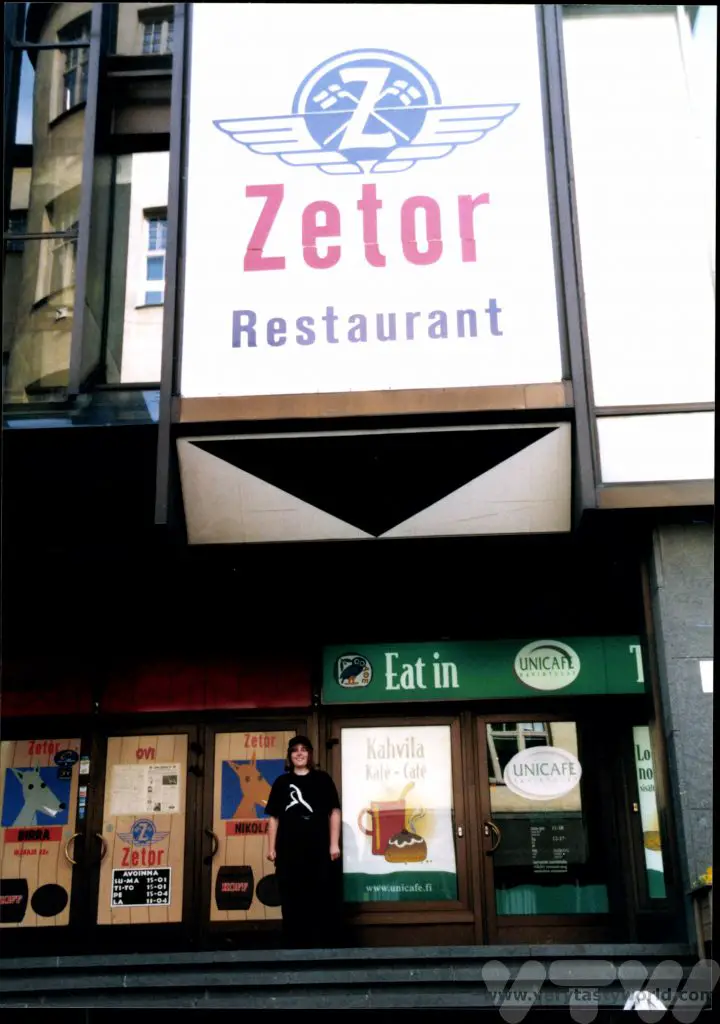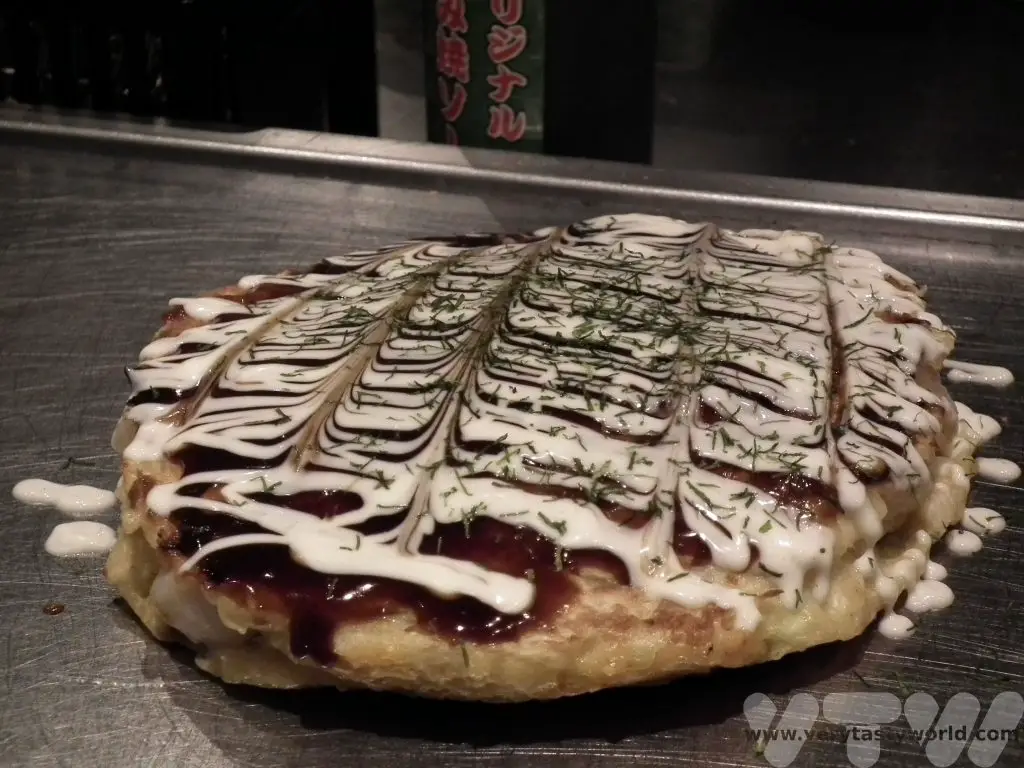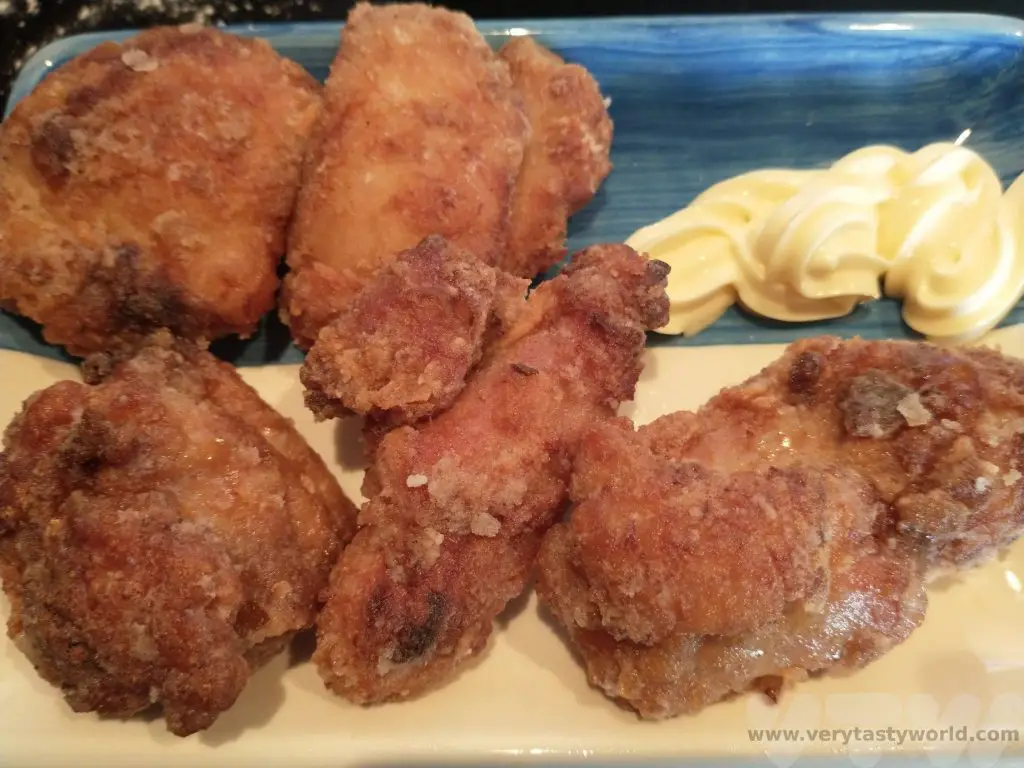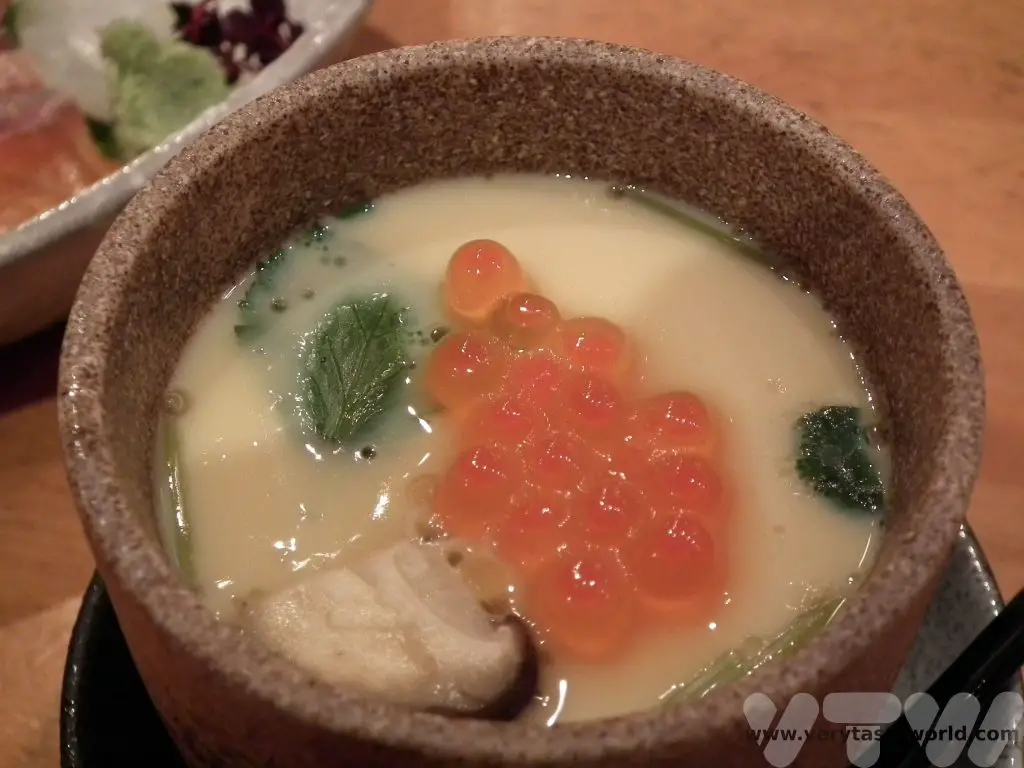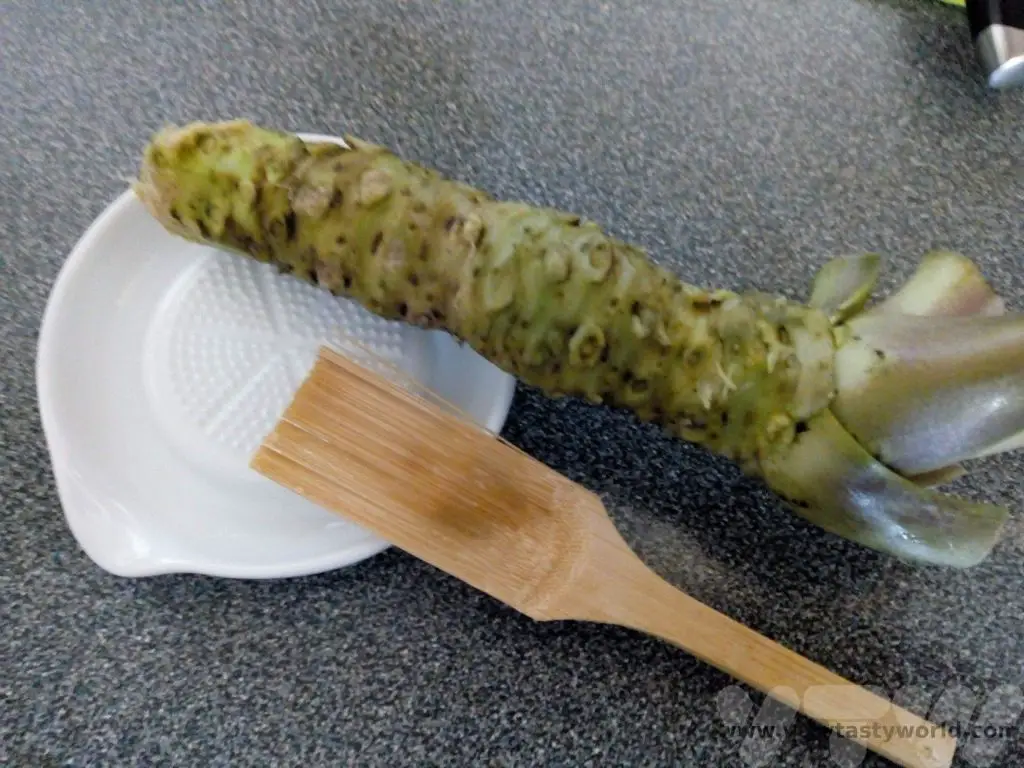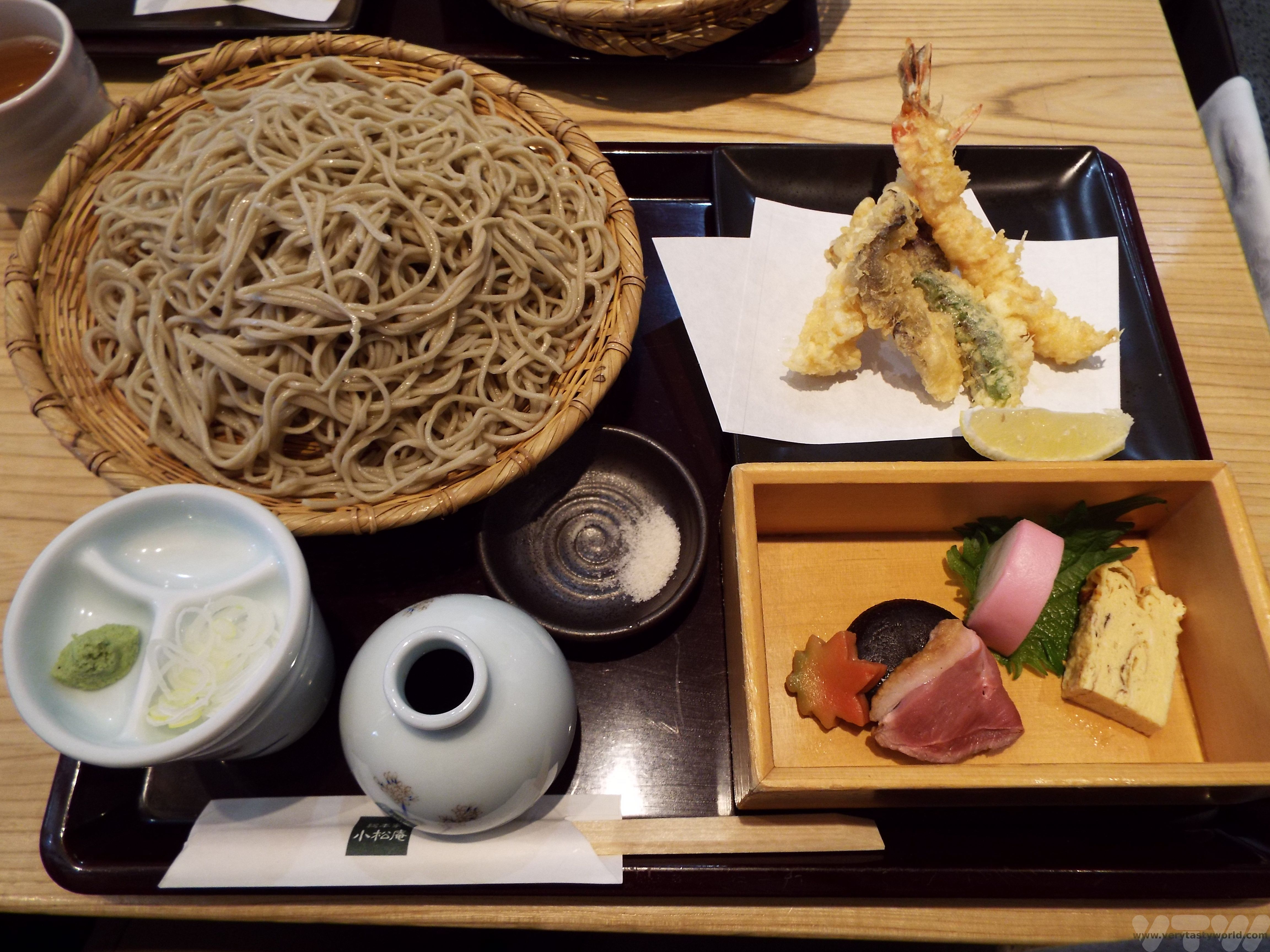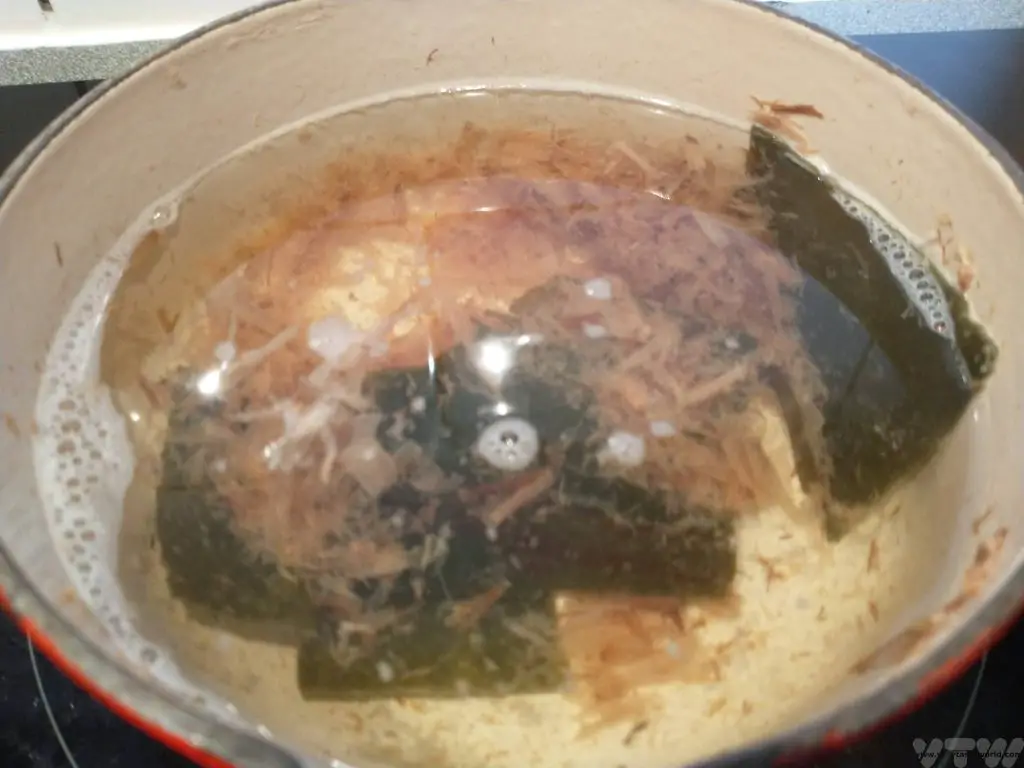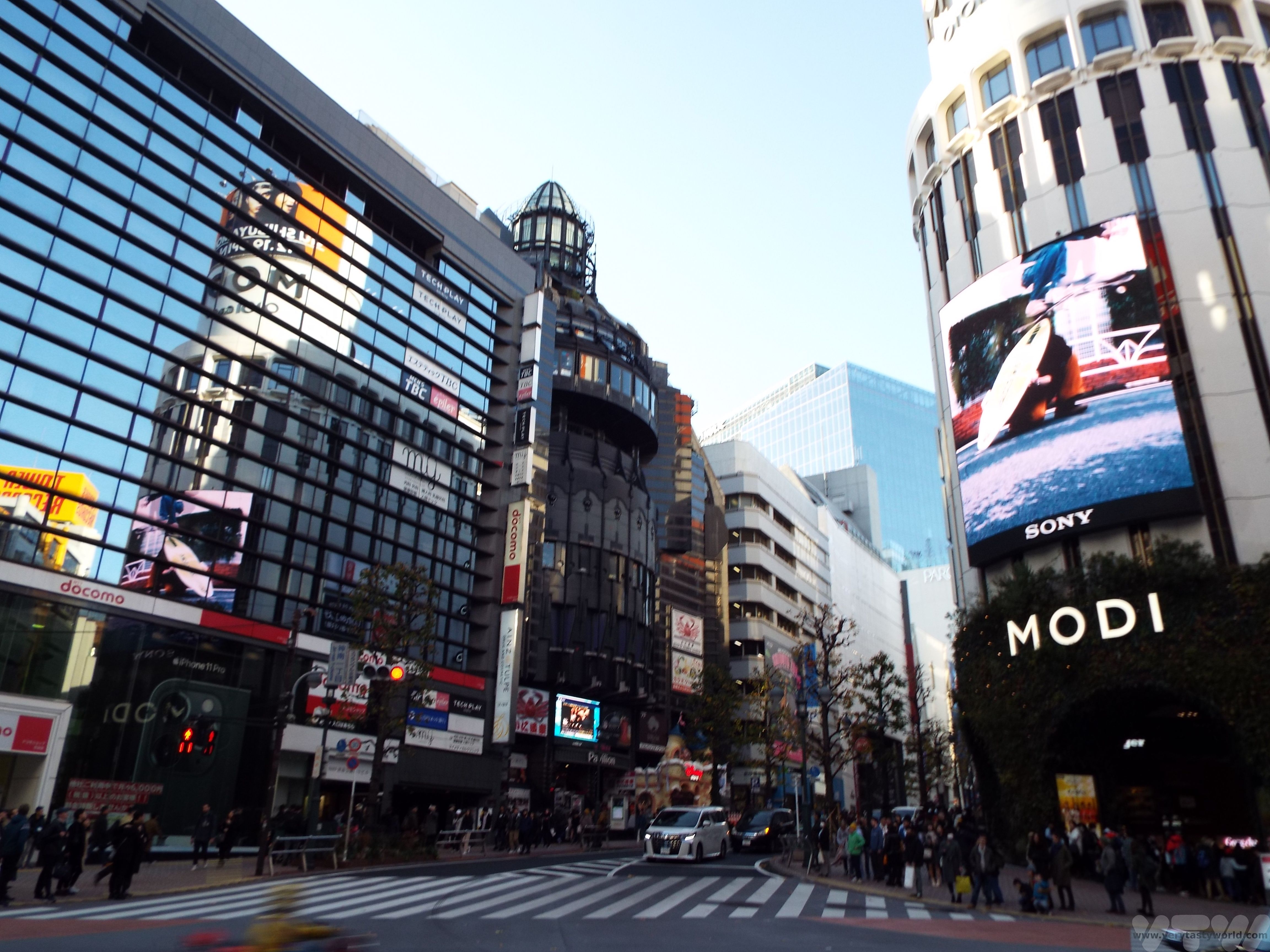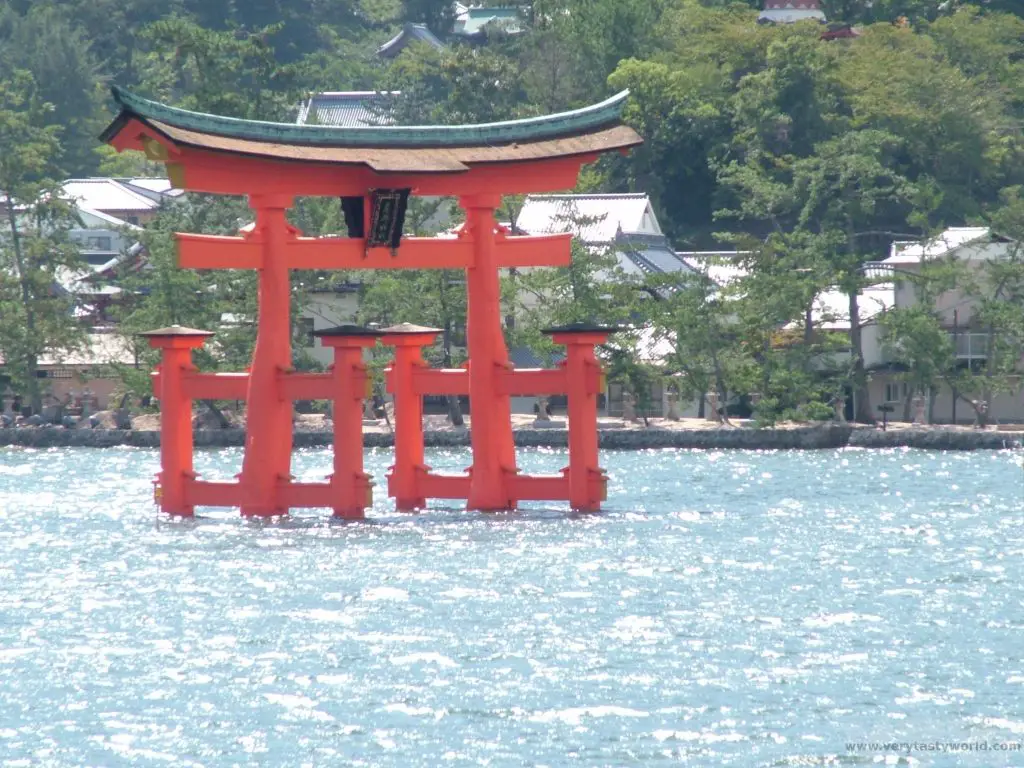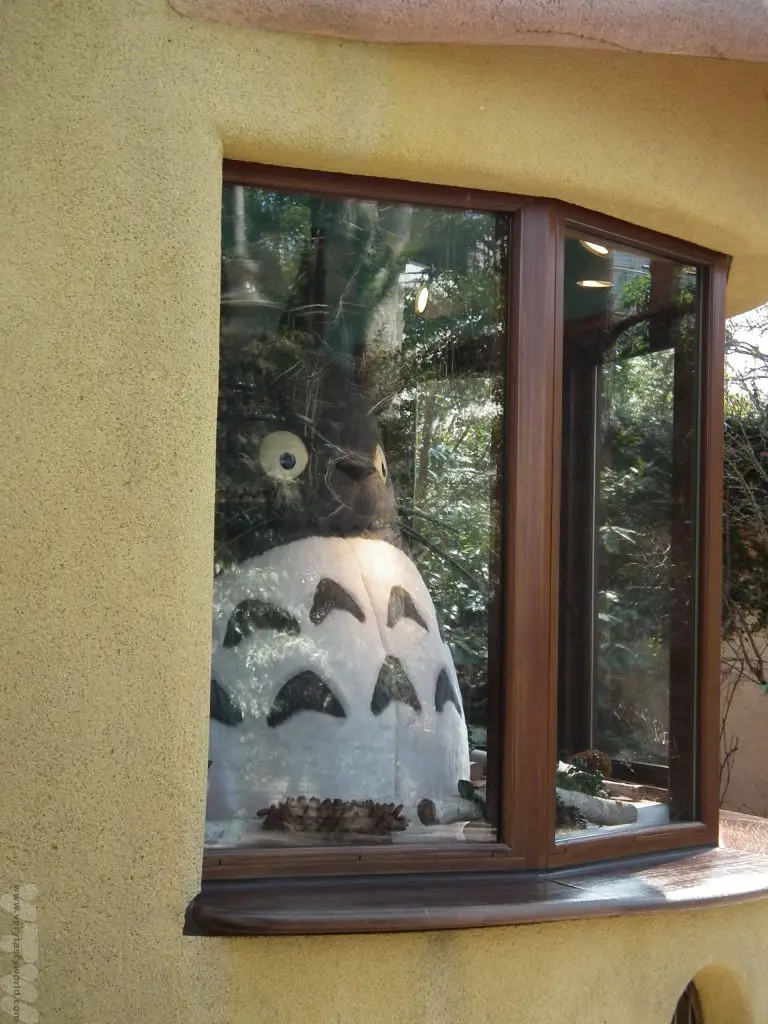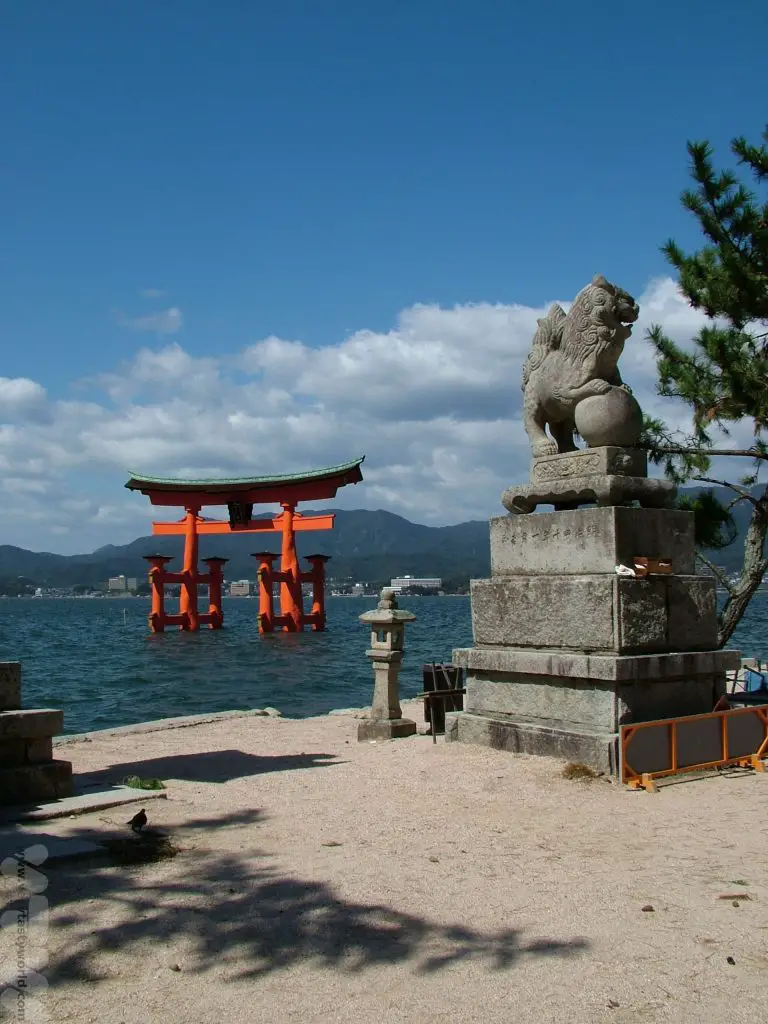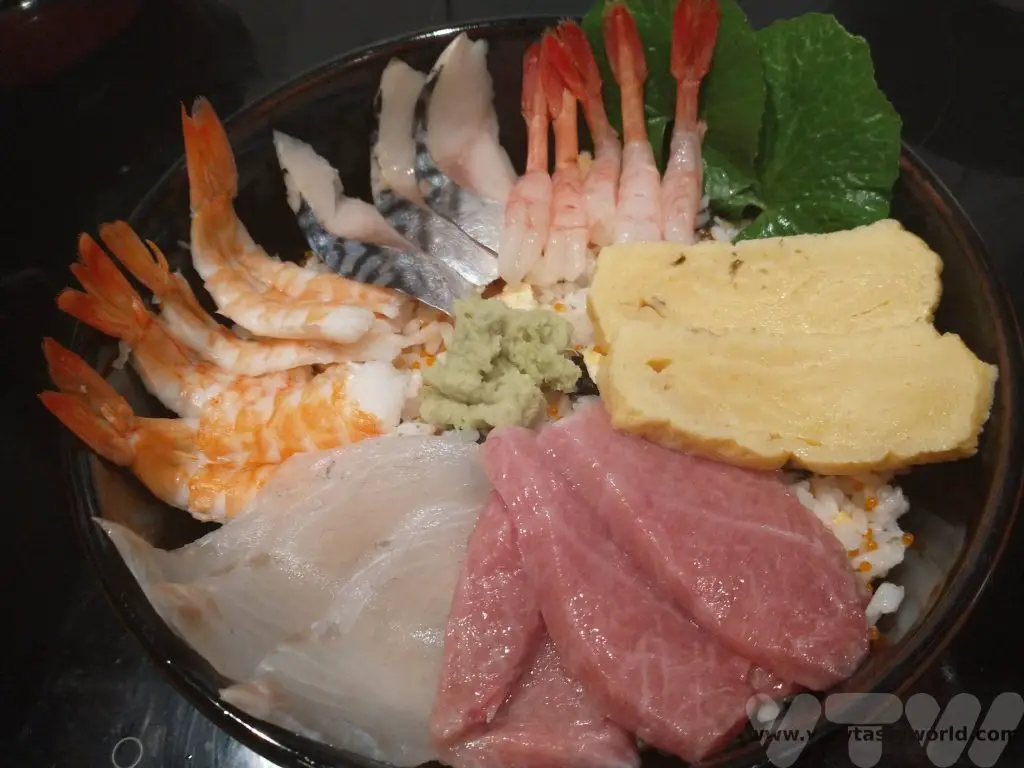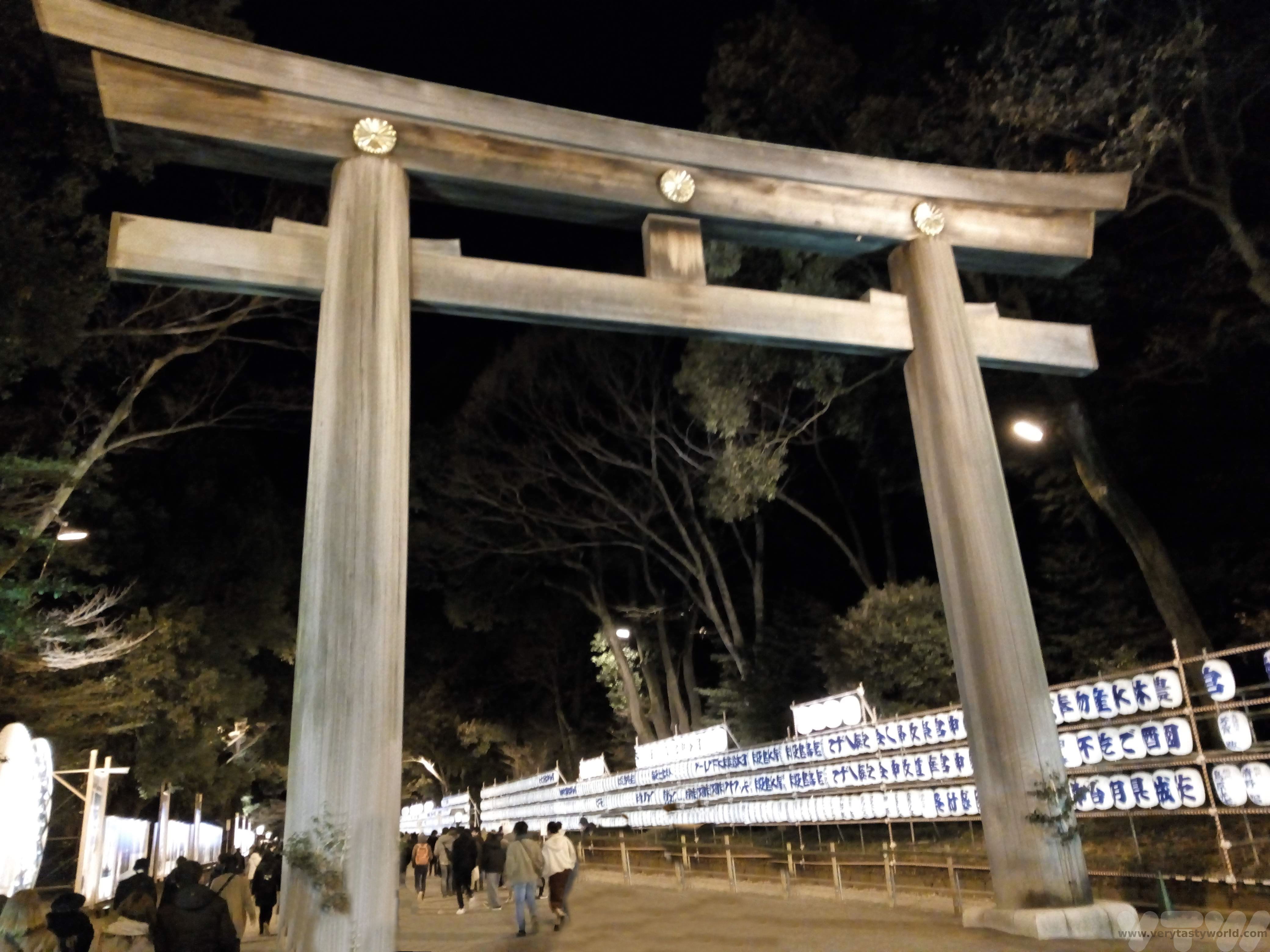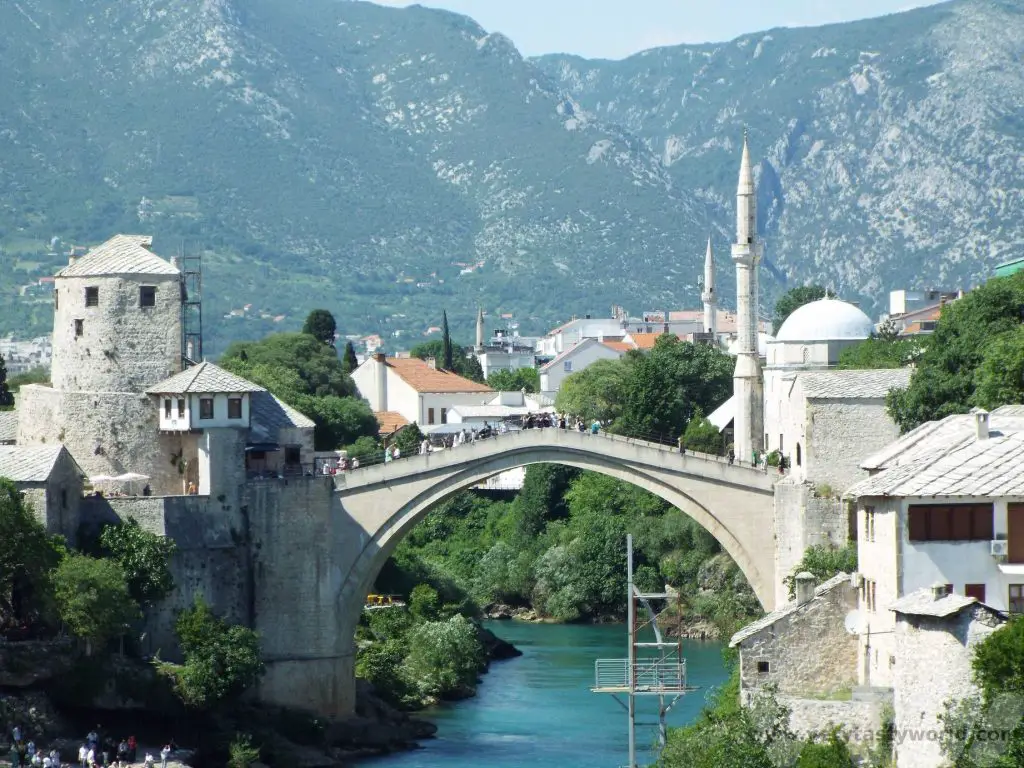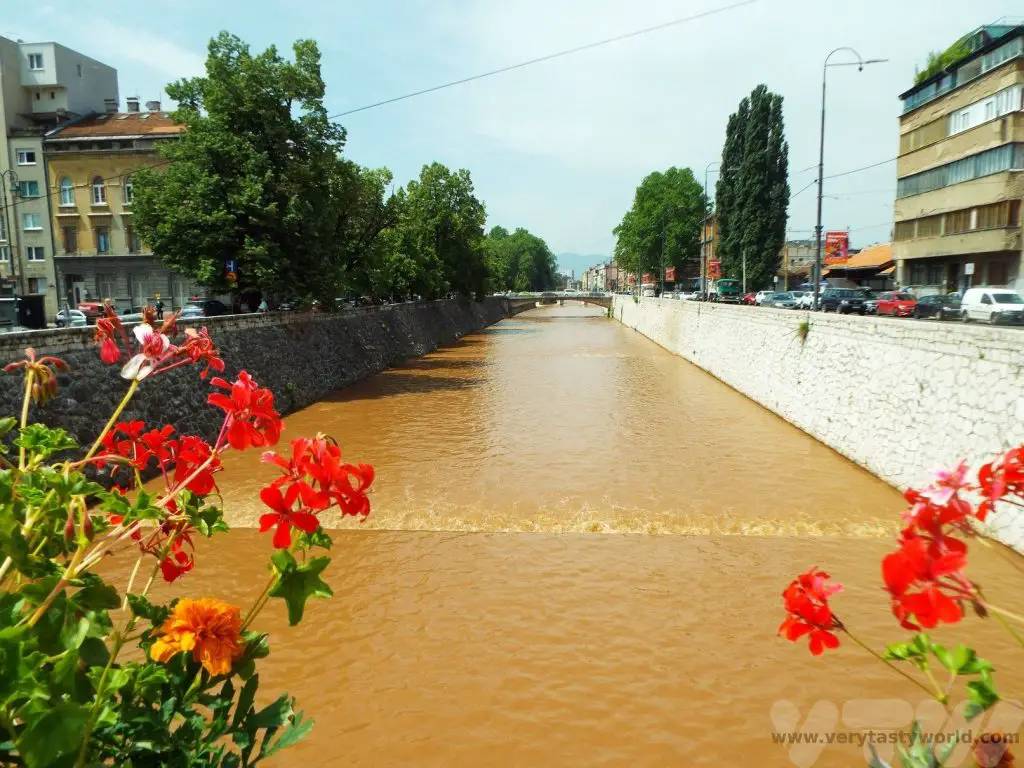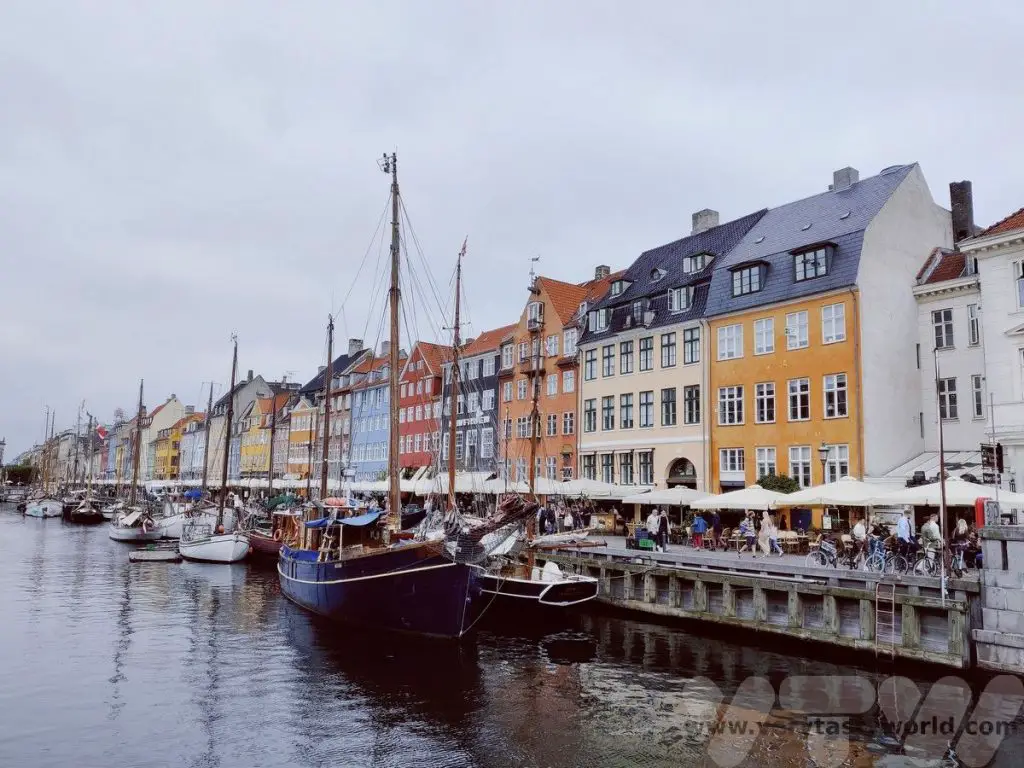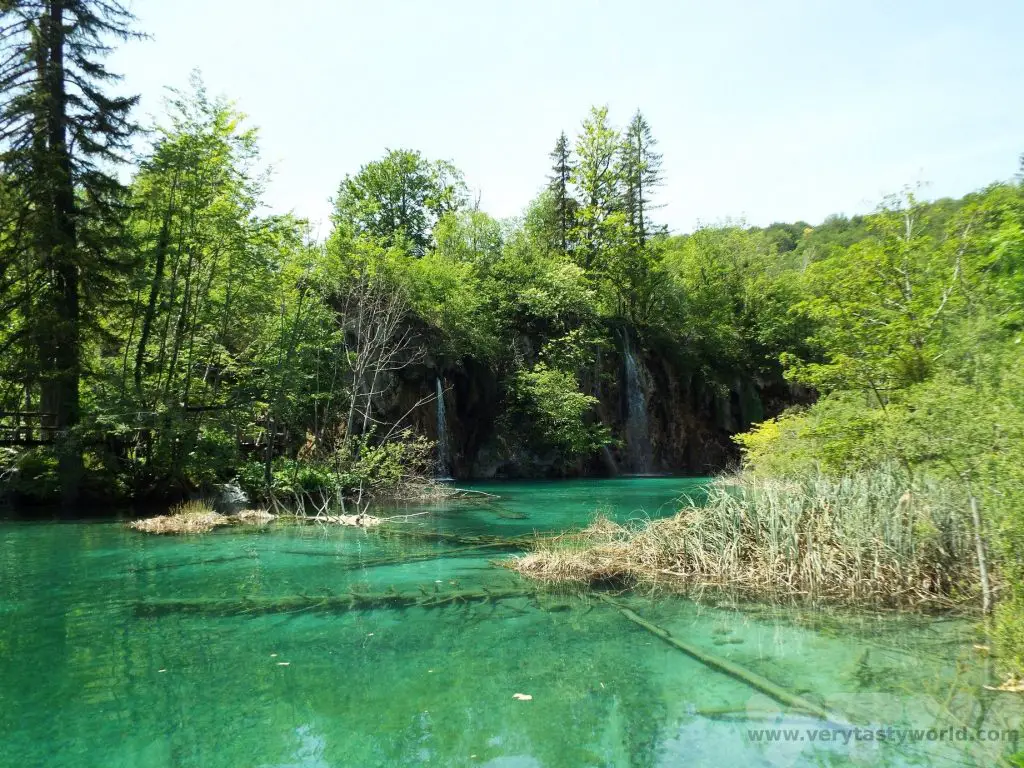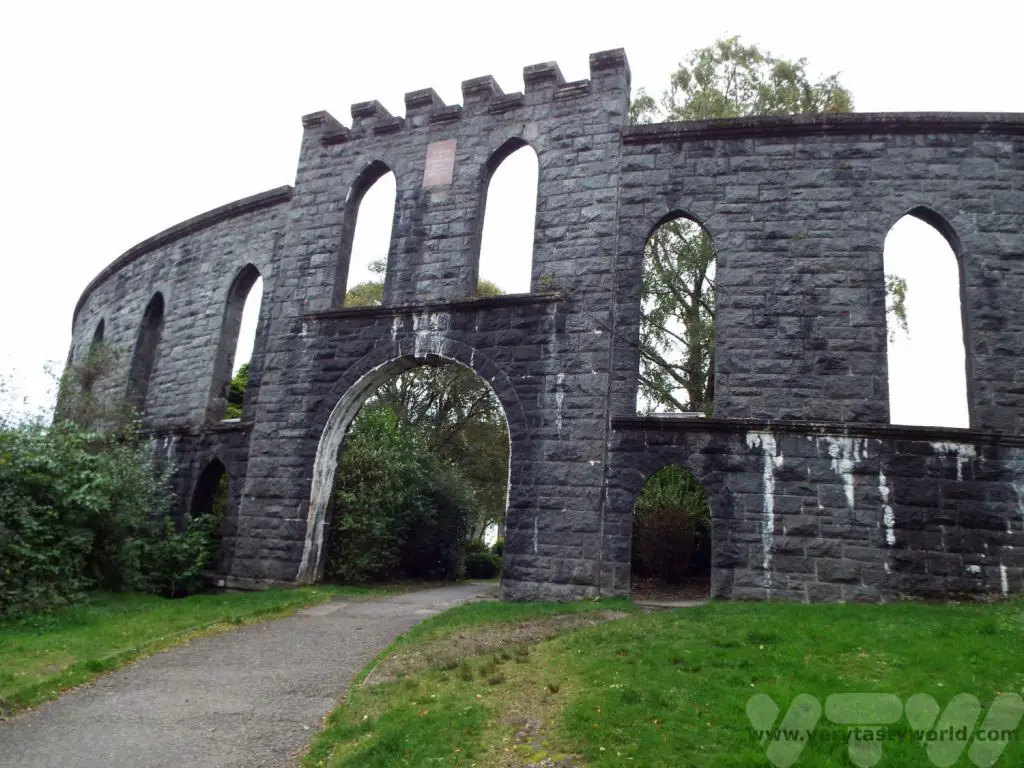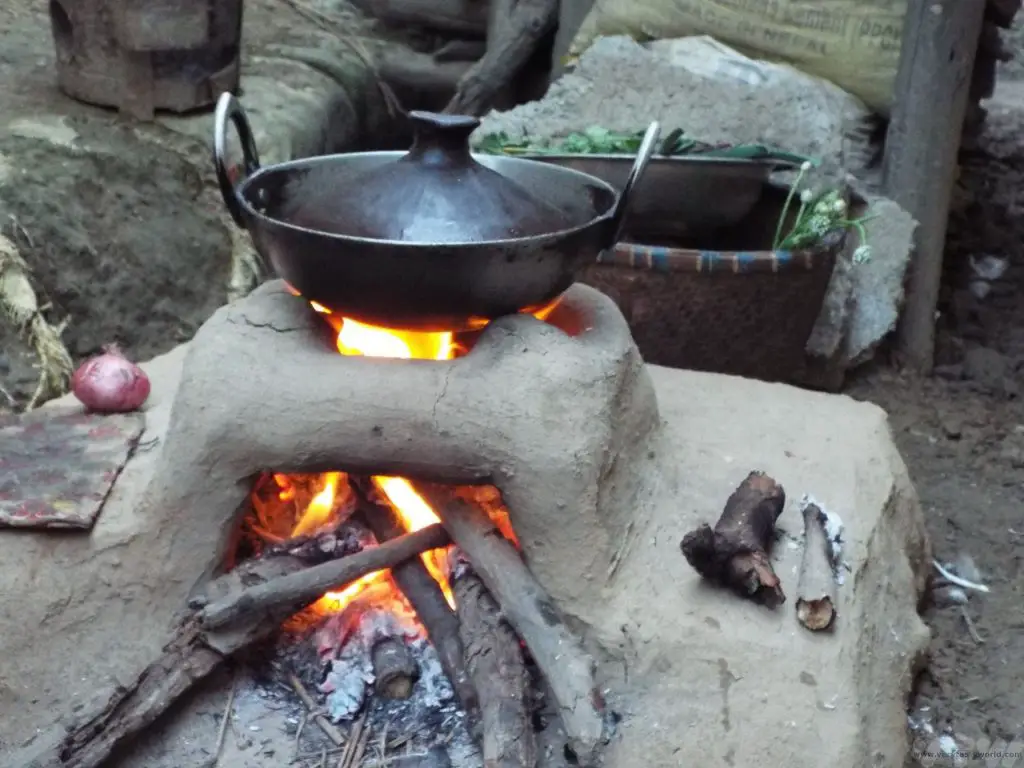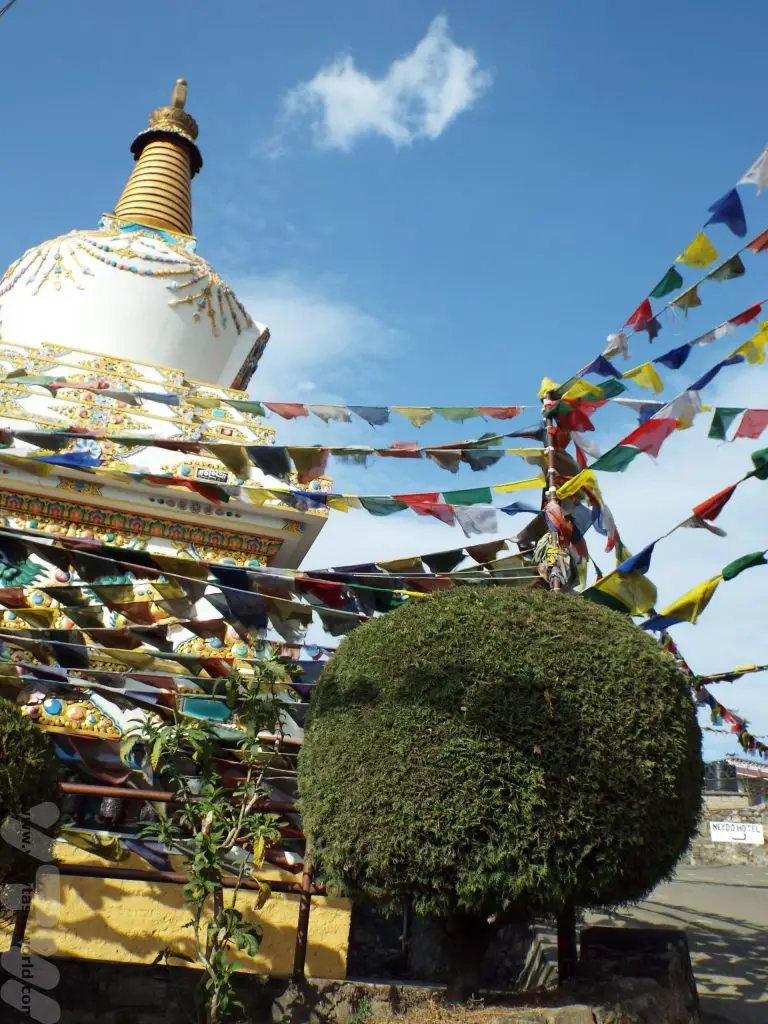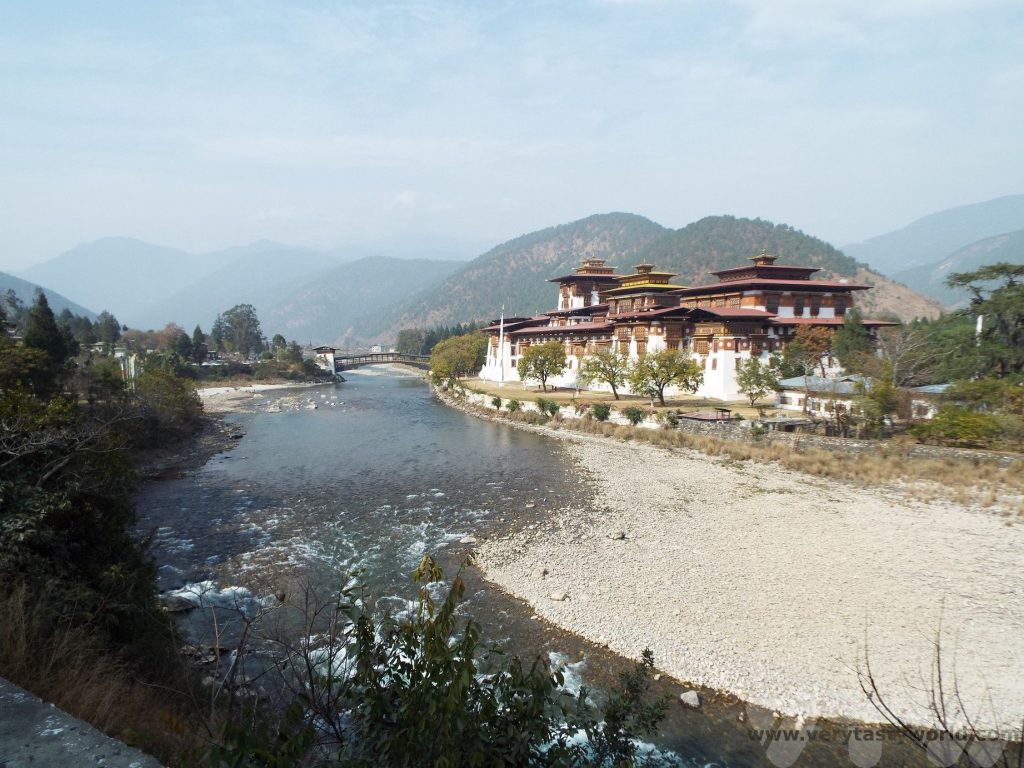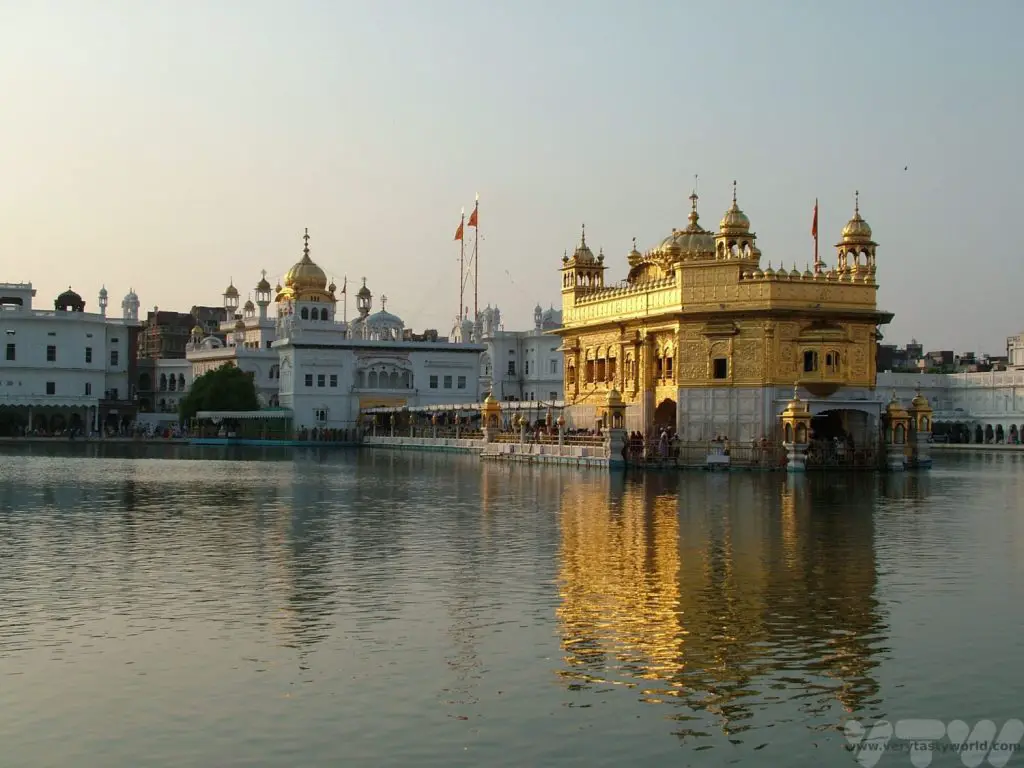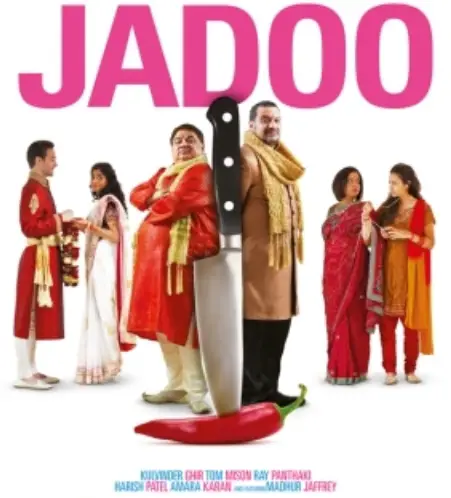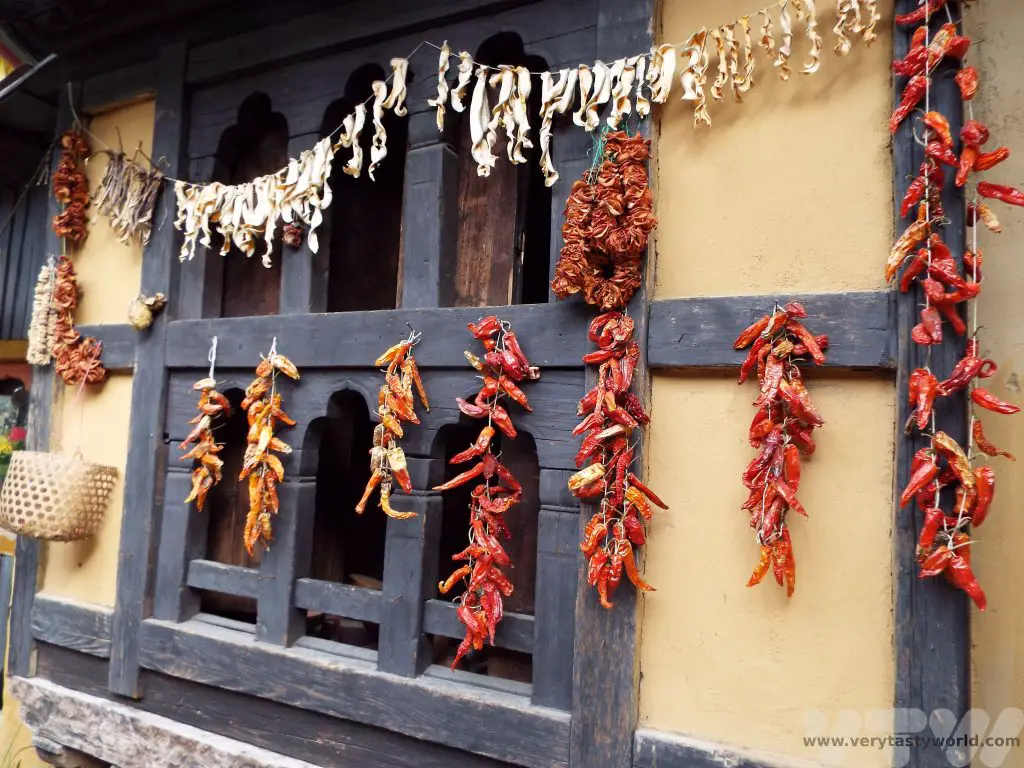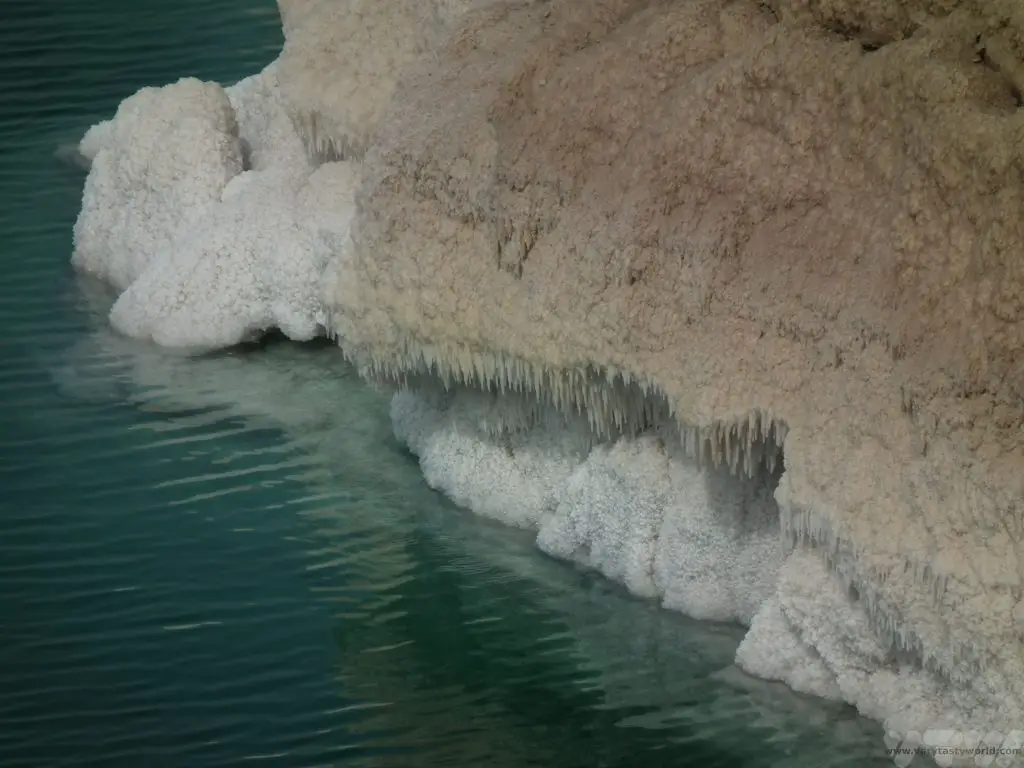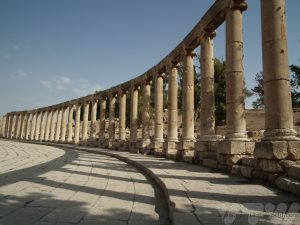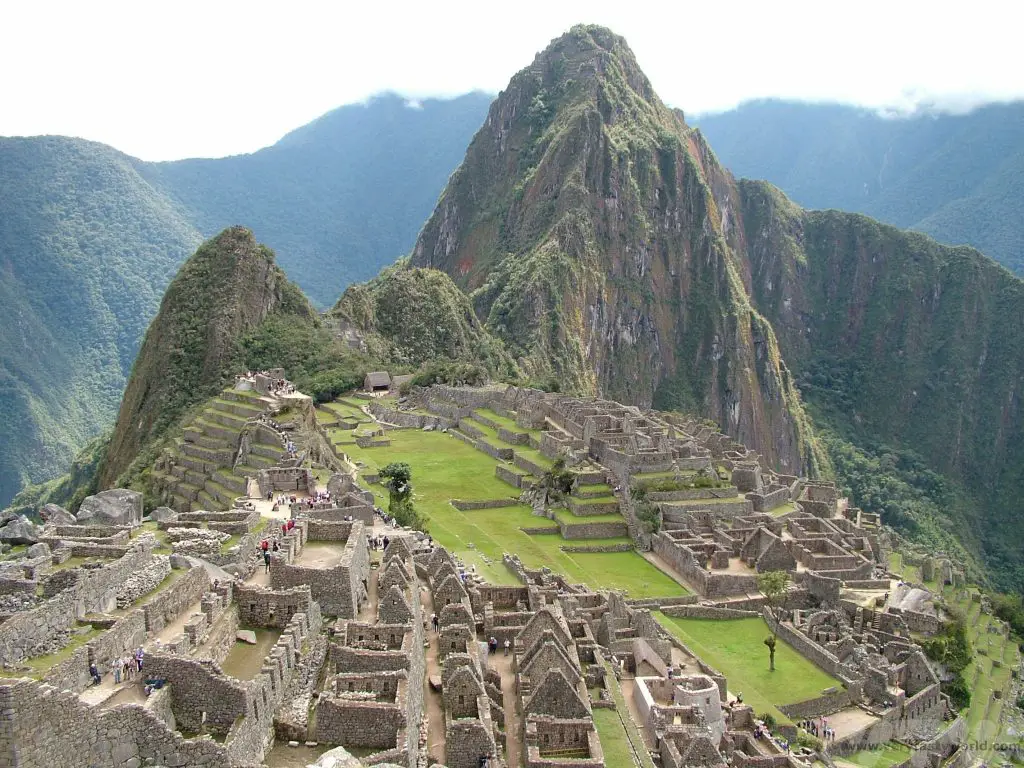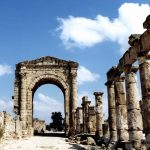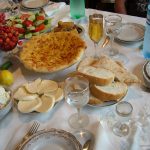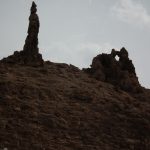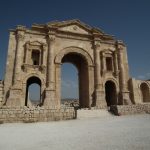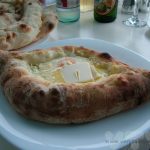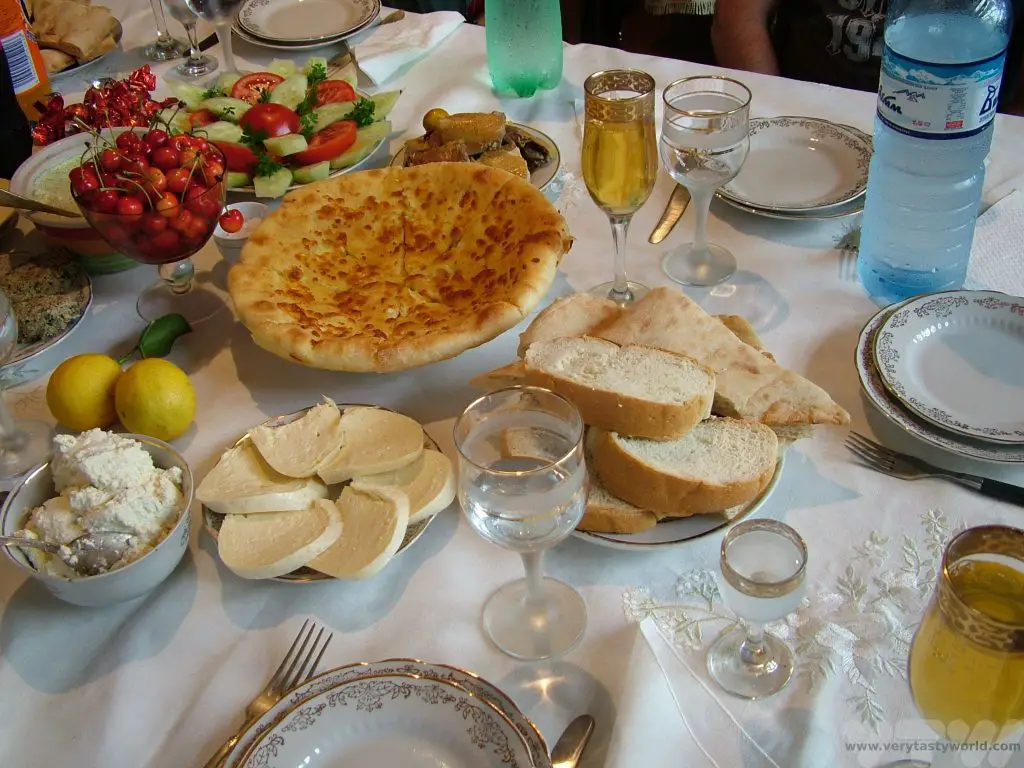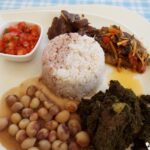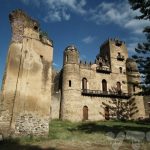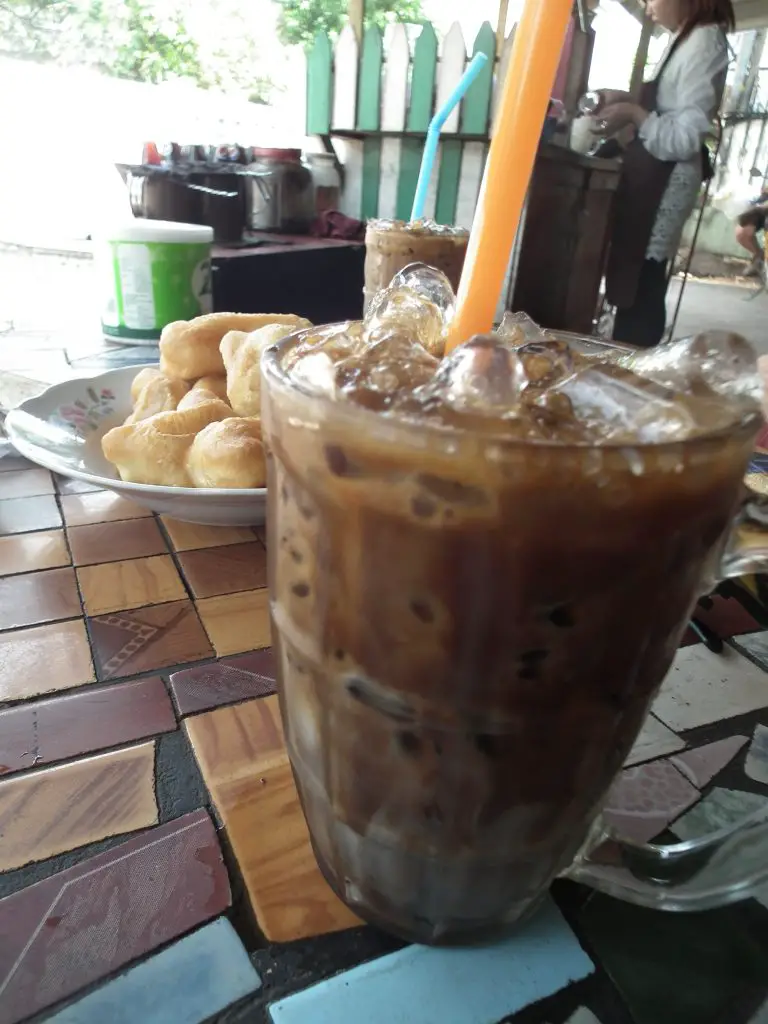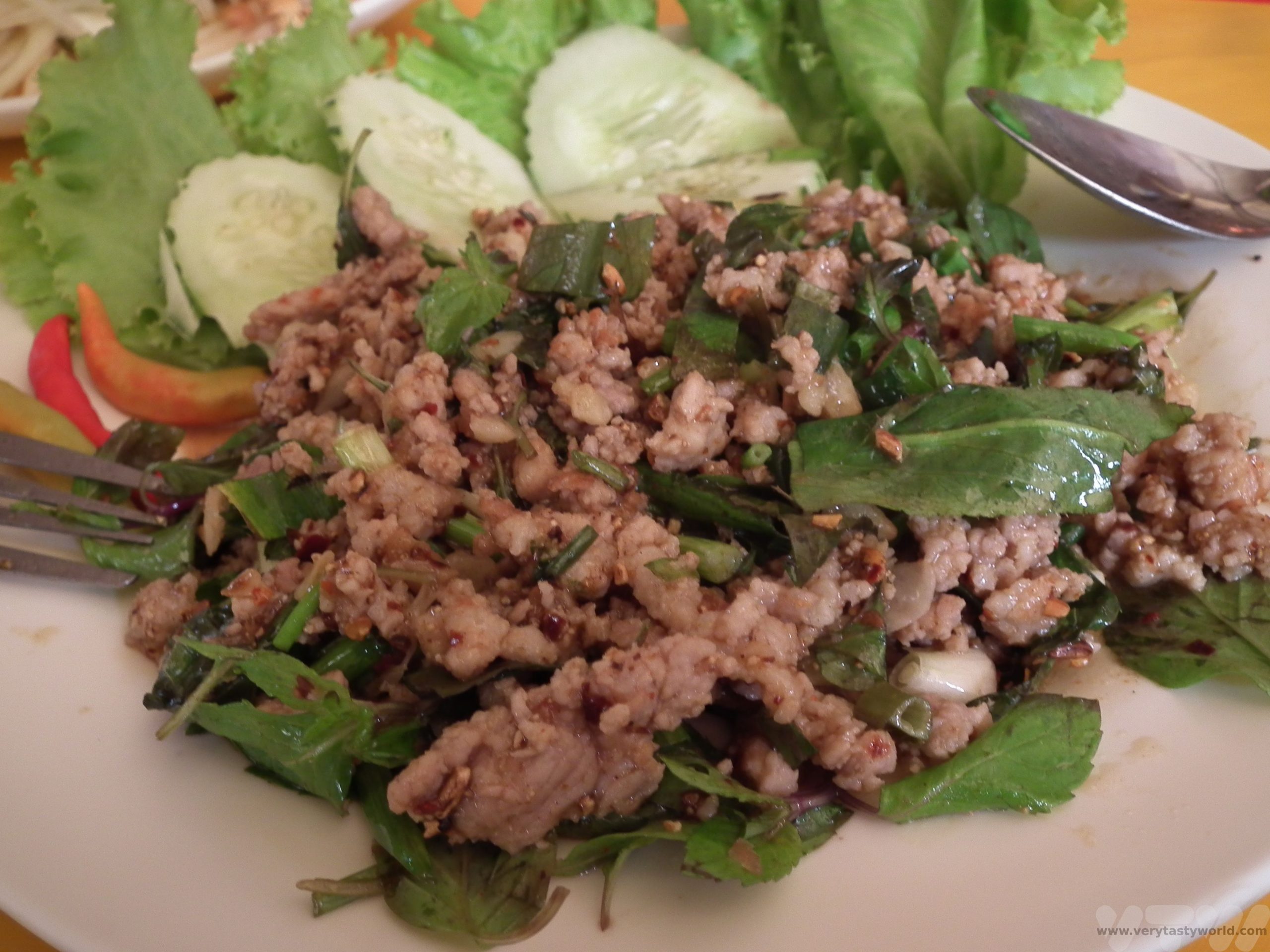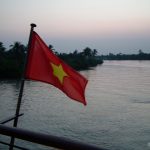Osaka Restaurants Japan – Kuidaore on Dotonbori
We visited Osaka (pronounced O-saka rather than o-SAR-ka) on our very first trip to Japan many years ago. We had already spent time exploring Tokyo, Hakone and Kamakura and it was following an afternoon and evening in Osaka, exploring the neon arcades and playing video games, taking silly photos in the print club booths, riding the Hep 5 big wheel and singing our socks off in a karaoke bar (where you get a private booth rather than have to sing in front of complete strangers), that we realised that we had fallen in love with Japan. The following day we visited the Dotonbori area in the Namba district and discovered Osaka’s restaurants. We decided that Osaka was our favourite place in the world.
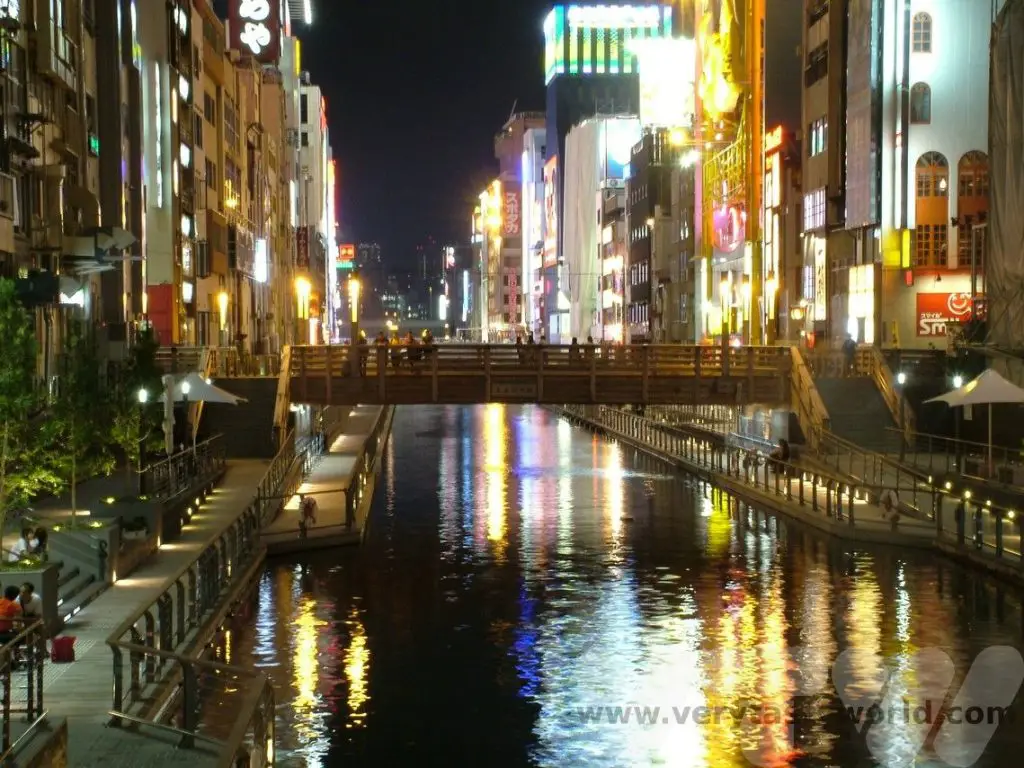
We’ve returned to Osaka many times over the years and we always make a beeline for Dotonbori. We’ve often stayed in business hotels close by. It’s a short walk away from the JR Namba Station Exit 14 (Yamatoji line), which is especially useful if you are using your JR Pass. Be aware that Namba is a big station. If you are arriving on the shinkansen (bullet train) you can get there from Shin-Osaka using the subway Midosuji line to Shinsaibashi Exit 4-B. (N.B. you can’t use your JR Pass on the subway.)

Osaka is known for being one of Japan’s centres of commerce, indeed there’s a phrase that many salarymen use as a greeting: ‘mokari makka’ which means ‘are you making money?’ The residents of Osaka speak Kansai Ben, the dialect of the region. It’s quite different to the Japanese we’ve learned in classes. For example, Osaka residents will say, ‘okini’ as thanks instead of ‘arigato’; although arigato will absolutely be understood you may well receive a big smile if you use ‘okini.’
Dotonbori History
Dotonbori means ‘Doton Canal’ and the history of the area goes back several hundred years to 1612 when Yasui Doton, a local merchant, started constructing a canal system in the area to link the Kizugawa river to the Umezu river. However, he was killed in 1615 during the Siege of Osaka and his cousins completed the canal project, naming it after Doton. Following completion, the area thrived, trade increased due to the better transportation along the canal and Dotonburi became an entertainment district, with theatres, teahouses and restaurants. It’s a fantastic place to visit, especially for foodies!
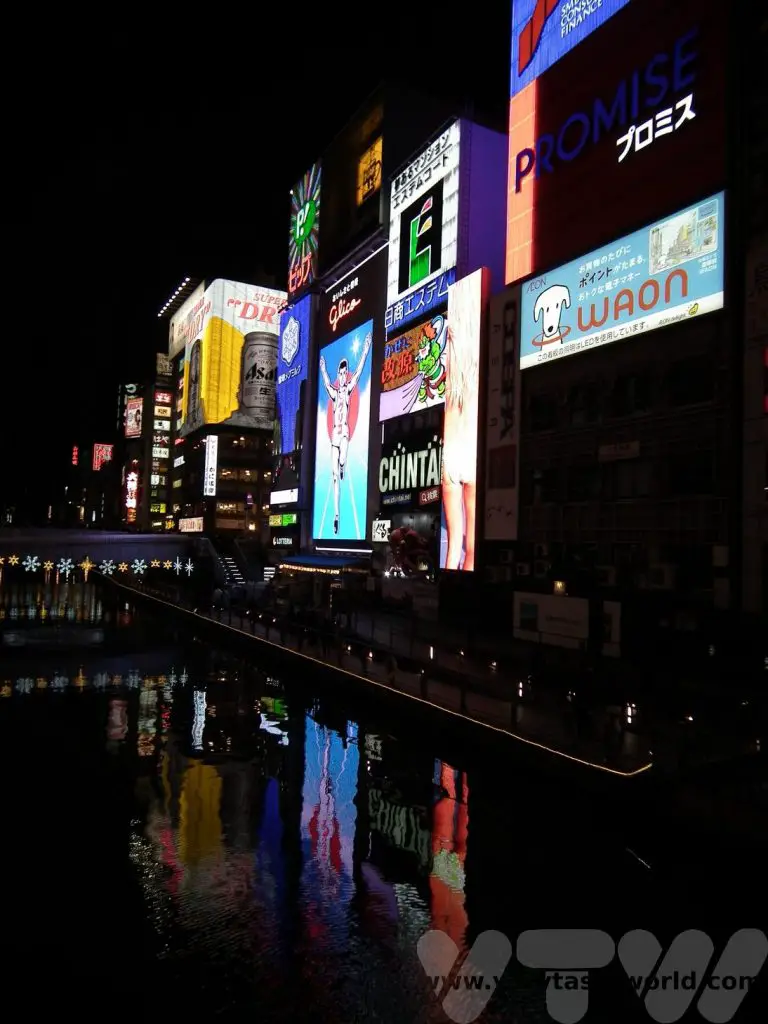
The district is defined by street between the Dotonboribashi Bridge to Nipponbashi Bridge. Probably the most iconic image of the area is that of the Glico running man – and it’s essential to see him at night, brightly lit in neon. Glico is a sweet manufacturer established in 1922 and famous across Japan. They are probably best know for those delicious Pocky coated biscuit sticks.
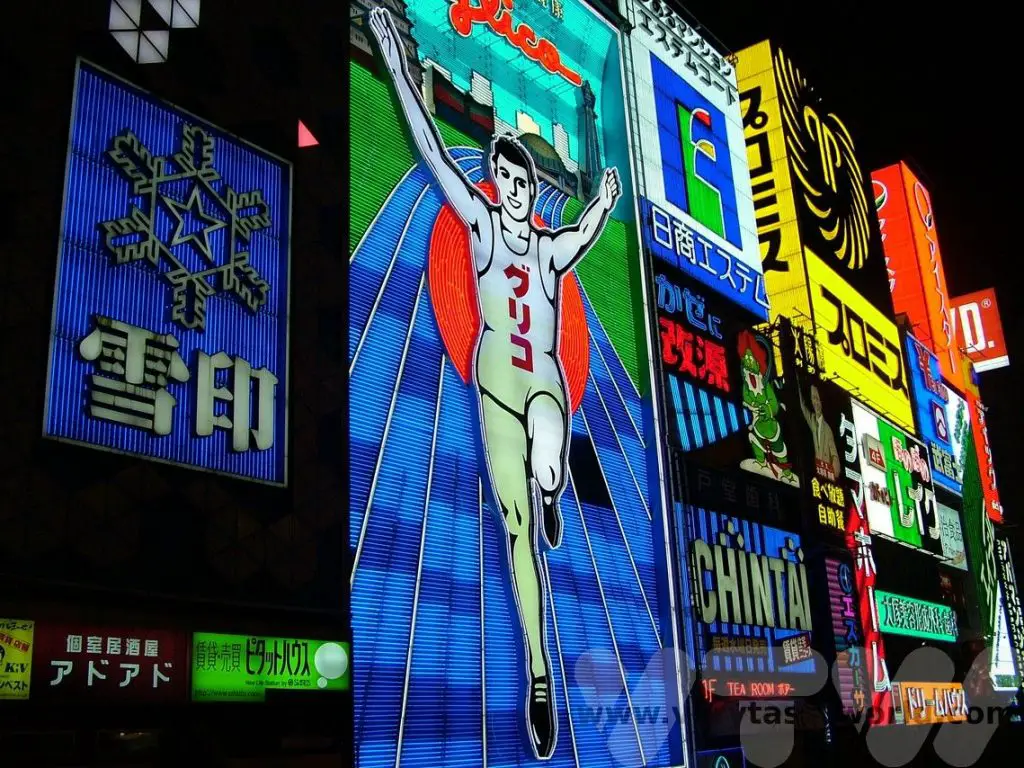
Dotonbori is one street, but actually the surrounding streets are also full of excellent bars and restaurants. We’ve had some of our best nights out in Osaka by wandering into random bars in the area. Locals and tourists alike are very friendly and we’ve often just started chatting with people. There was one particularly memorable night when a pair of airline pilots decided to buy Jagermeister bombs (a Jagermeister shot inside a glass of Red Bull) for the denizens of the entire bar which resulted in a highly caffeinated boozy evening and us sleeping in so late that we missed much of a planned excursion to Kobe the following day!
Kuidaore
The word ‘kuidaore’ means to go bankrupt by extravagant spending on food and Dotonbori would be a place where you could have a really good attempt at achieving this as it is chock full of excellent restaurants.
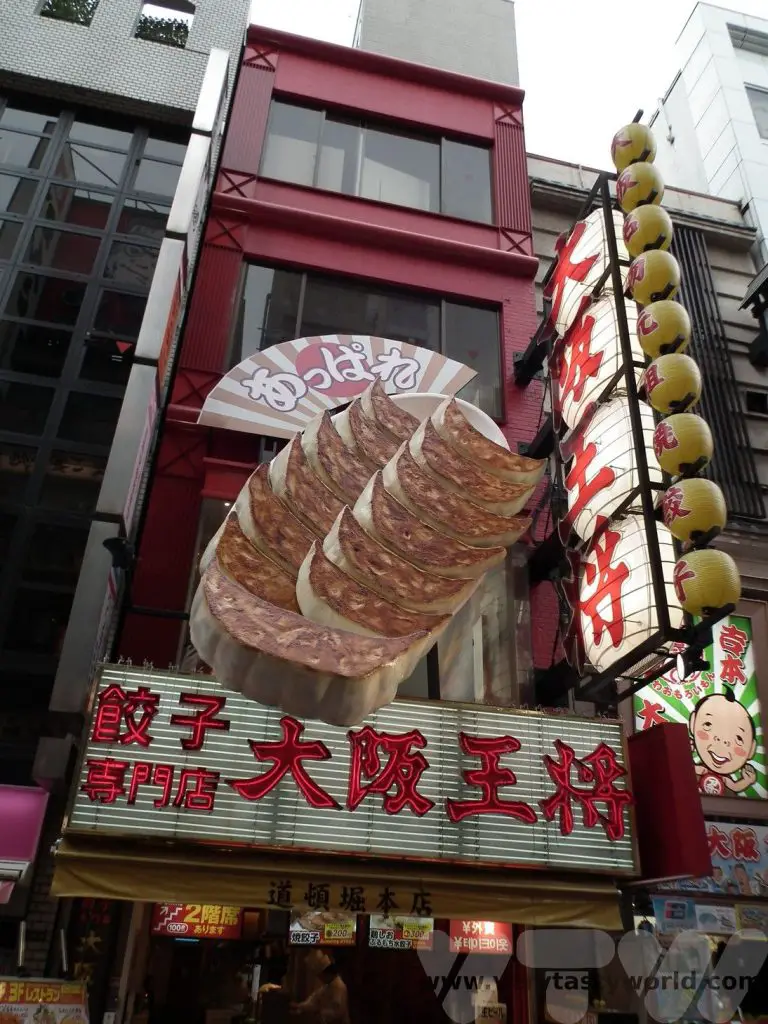
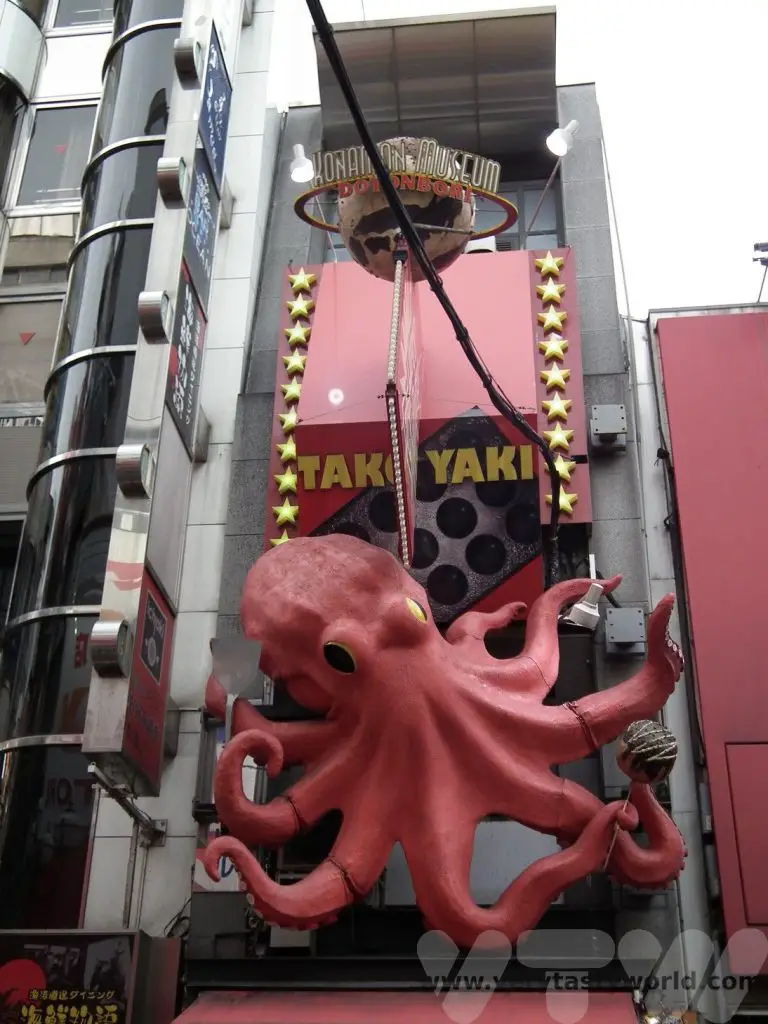
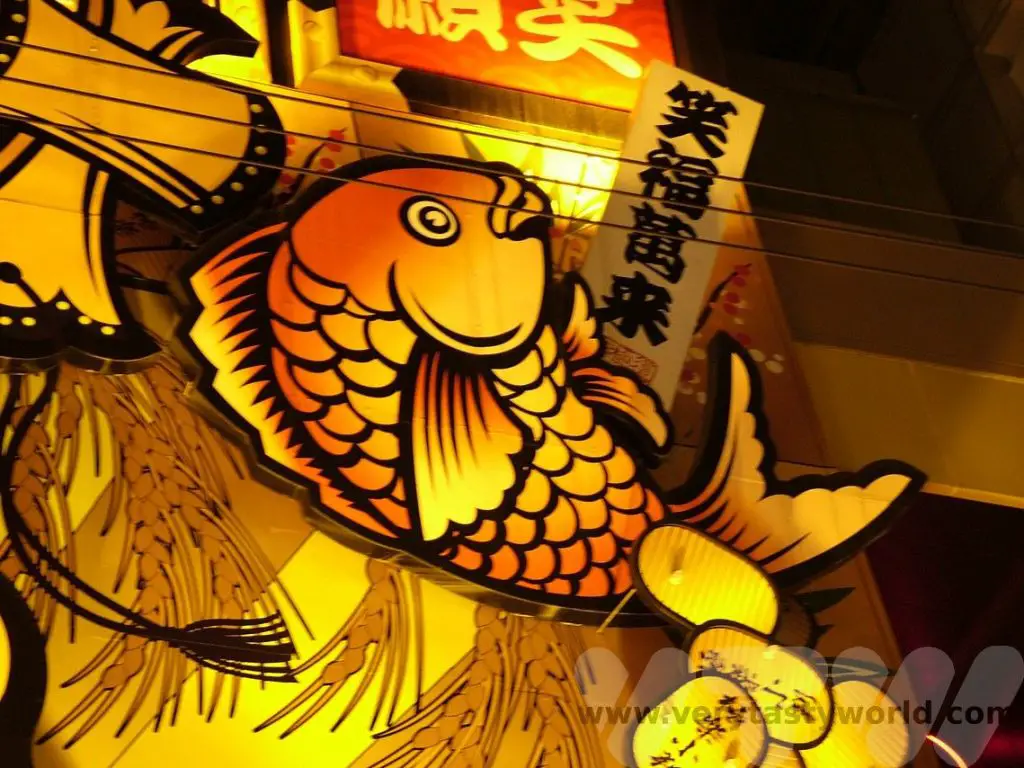
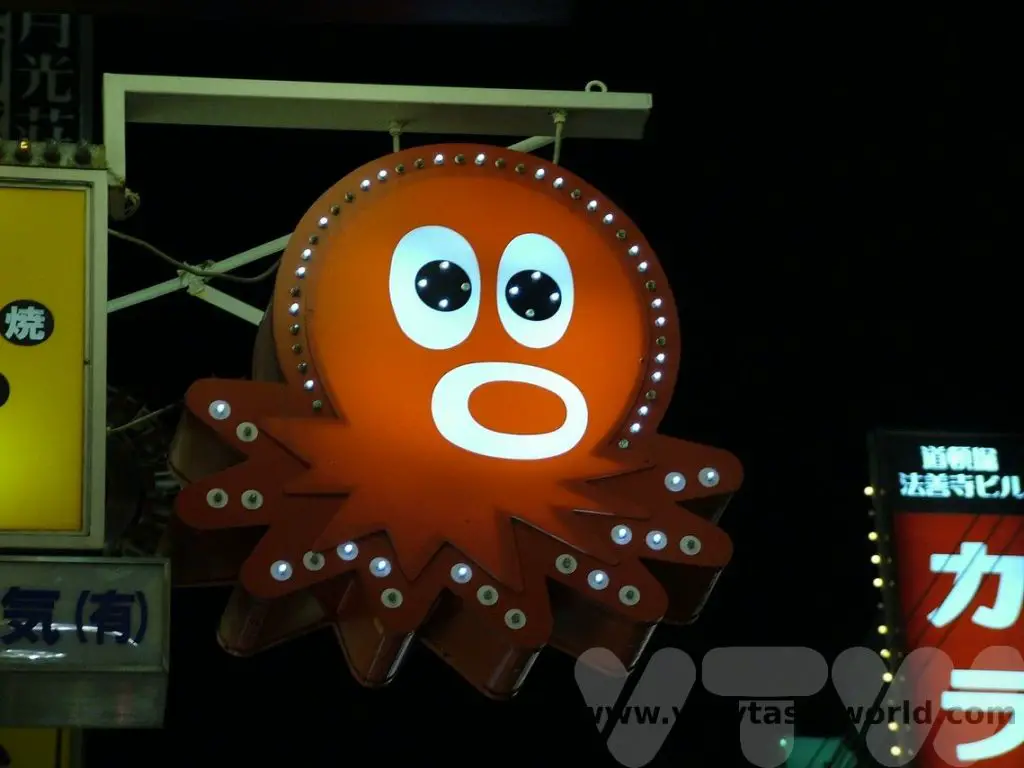
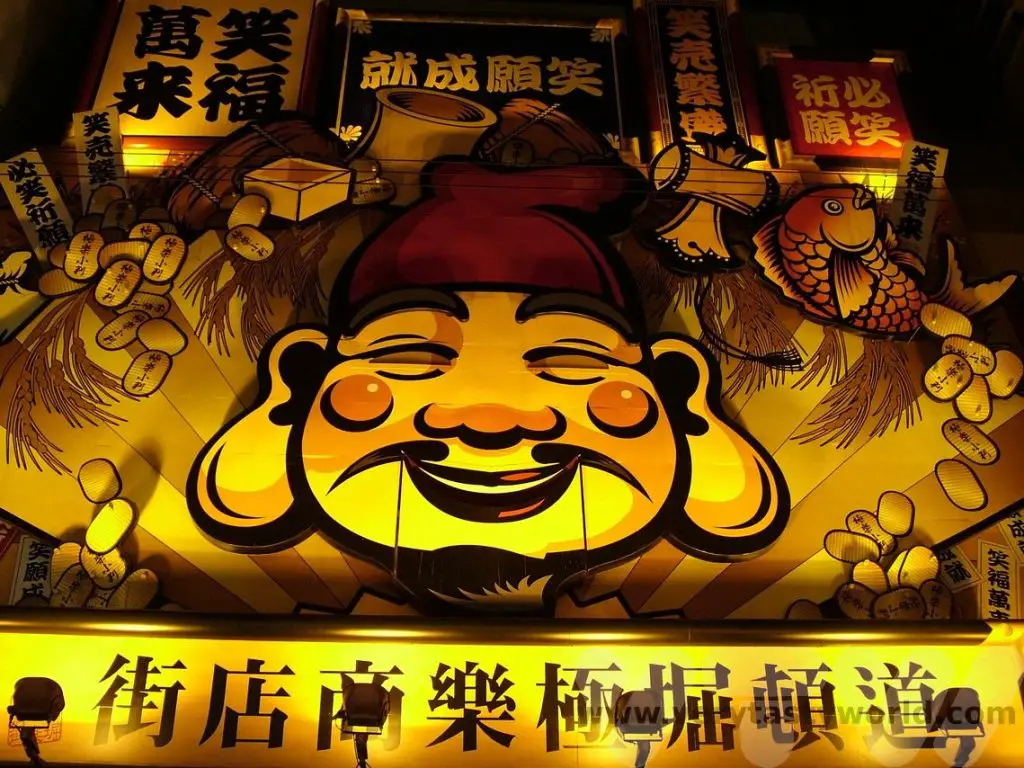
One thing to remember when visiting cities in Japan is to look up! In the UK most shops and restaurants are located at ground level but Japan is a country with high rise buildings. Very often shops and restaurants will be located on multiple levels within the same building. You will often see boards outside the building advertising various emporia: F1, F2 etc to go up, B1, B2 etc to go down. (N.B. floor levels in Japan match the American model where the ground floor is called the first floor, unlike in the UK where the ‘ground floor’ is at street level and the next floor up is the ‘first floor’.)
Essential Osaka Restaurants
Takoyaki – The Best Street Food
Takoyaki is quintessential Osaka street food. It comprises spherical octopus pieces in a batter which are cooked en masse in a griddle.
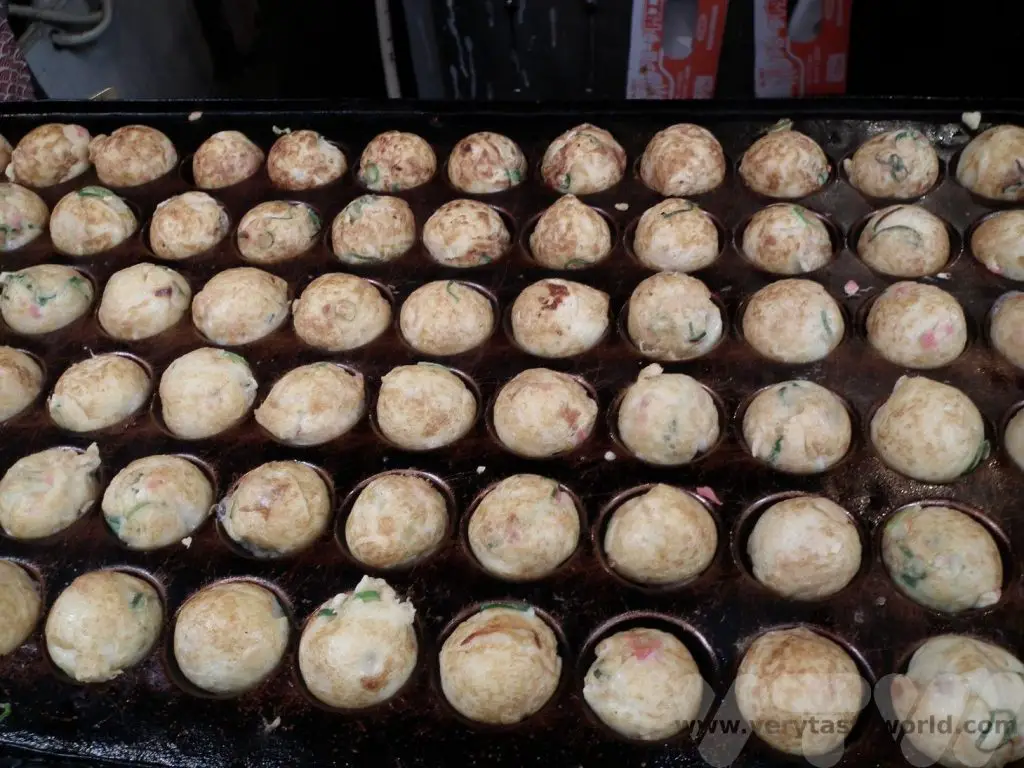
The takoyaki maker expertly and deftly turns each octopus ball by hand so that they are cooked evenly.
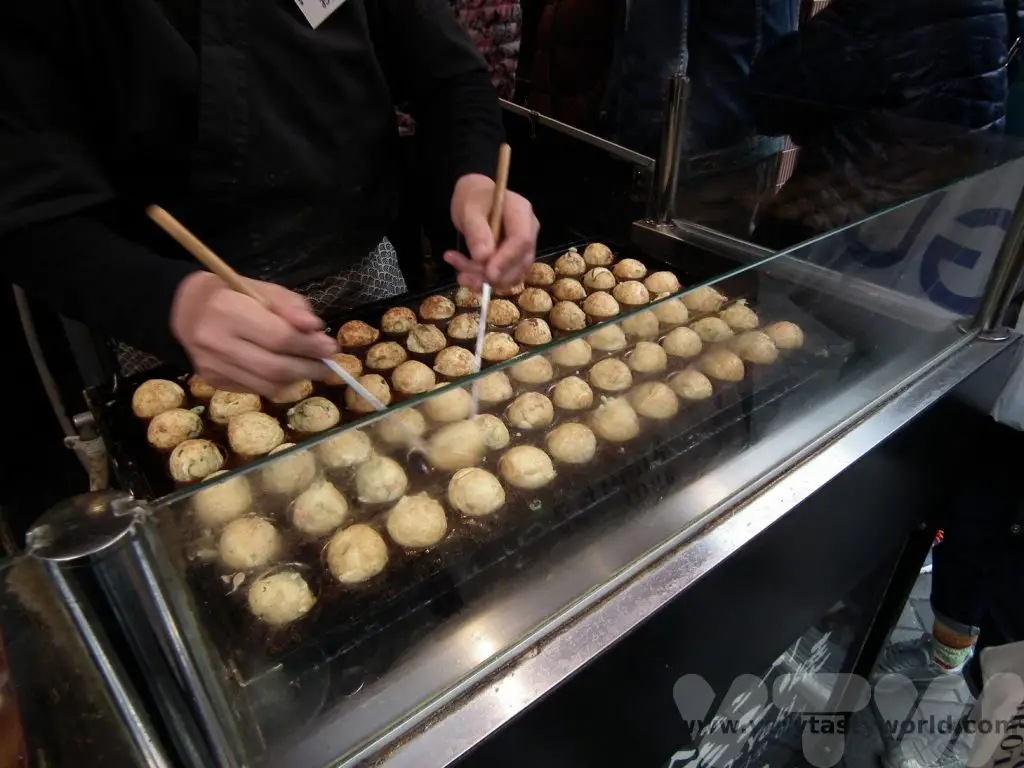
Served with mayonnaise, takoyaki sauce (which is similar to brown sauce) and bonito flakes (skipjack tuna flakes shaved to wafer thin slices – which are rich in umami and are often used to make Japanese dashi stock), which undulate gently in the heat of the takoyaki. You just have to wait a little while before scoffing because they will be extremely hot as soon as they come out of the griddle.
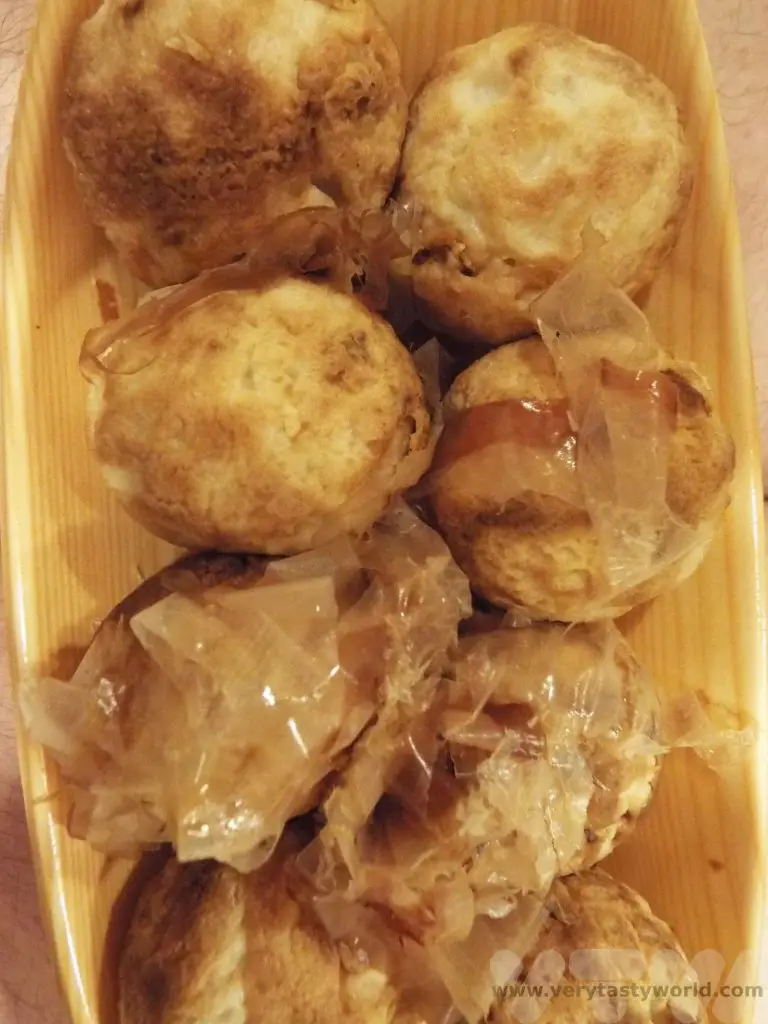
Okonomiyaki – As You Like It
Okonomiyaki, which translates as ‘as you like it’, is often described as a cross between a pancake and a pizza. It’s a cabbage based batter (but don’t let that put you off – it’s really delicious) with multiple fillings and toppings. Some establishments have a chef prepare the okonomiyaki, others will let you sit at the griddle and you can cook it yourself.
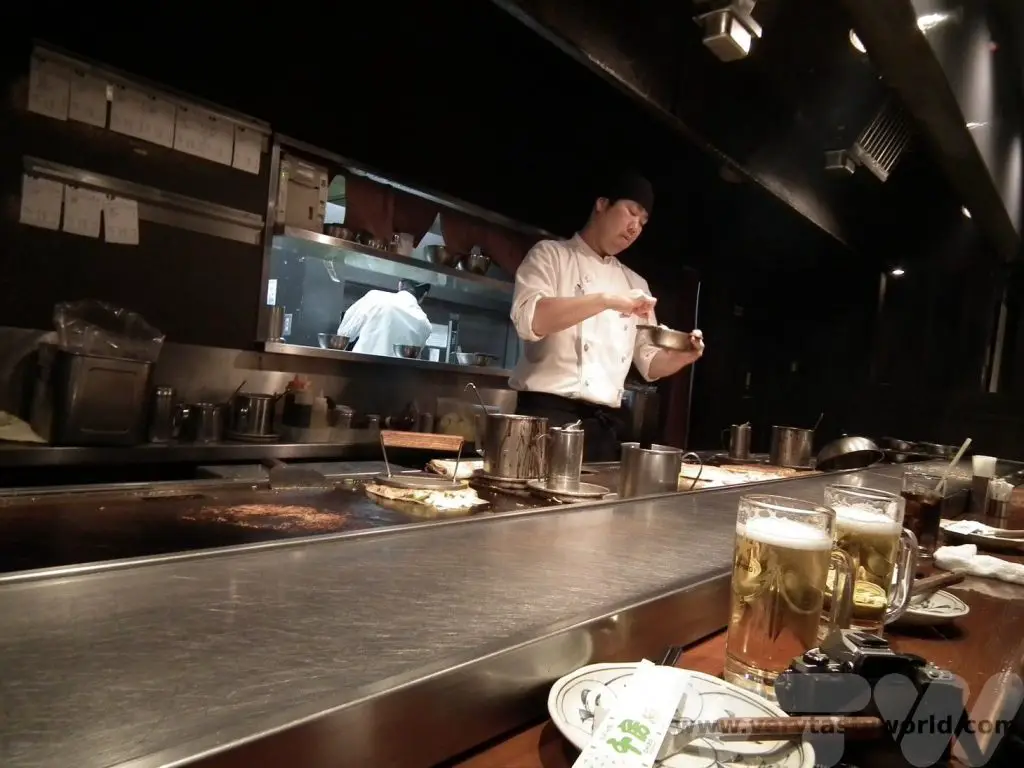
The basic batter mixture is prepared and cooked on the griddle.
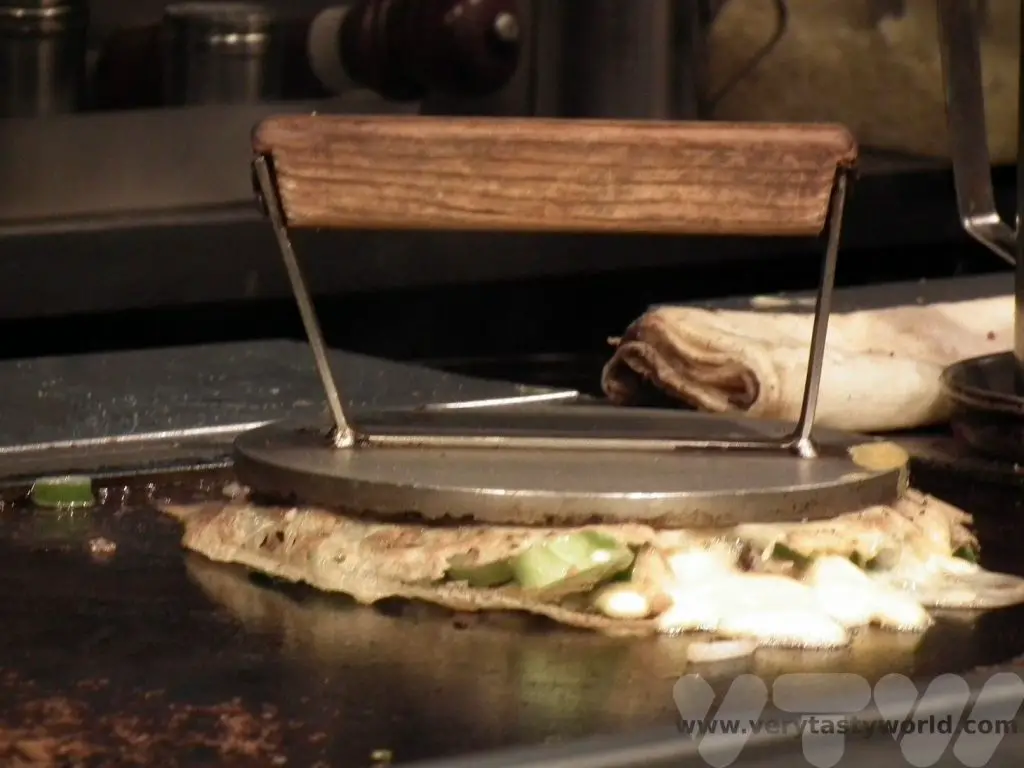
Then you have a choice of toppings – meat and prawns are popular choices and veggie options, such as kimchi are also available.
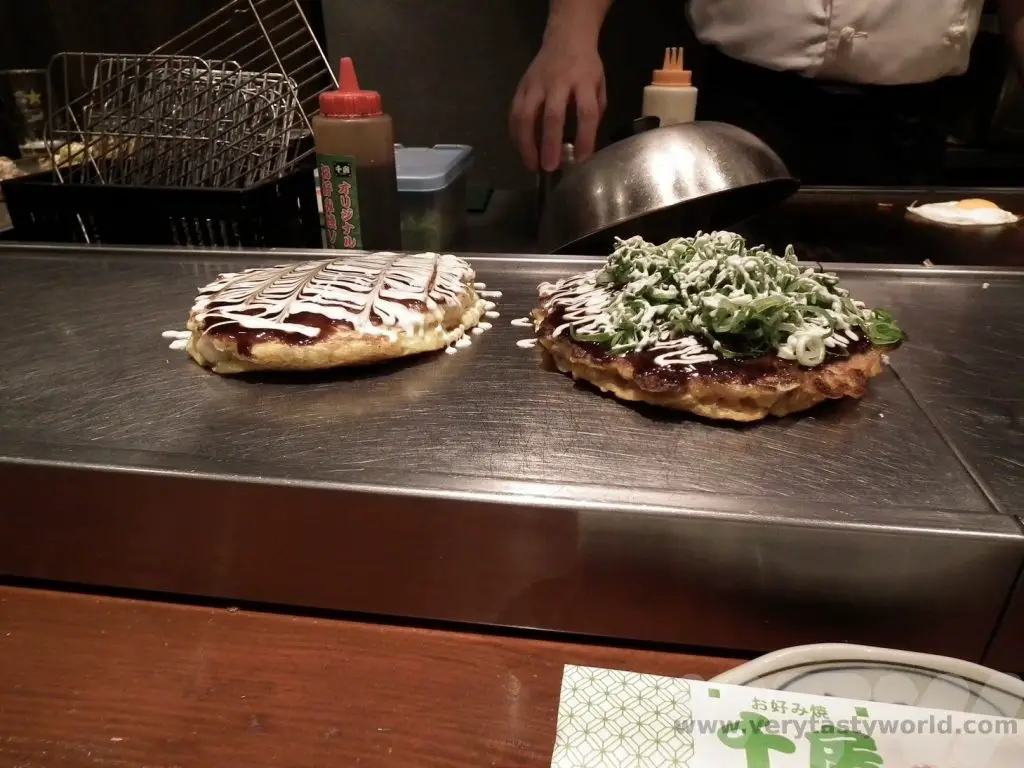
The okonomiyaki will be garnished with a variety of yummy things, including mayo, okonomiyaki sauce (similar to takoyaki sauce/brown sauce), flakes of nori seaweed and those delightful undulating bonito flakes. Chilli sauce may also be available. The chef will embellish your okonomiyaki in the most delightful way. And of course, when the chef asks you what garnish you would like, the correct answer is EVERYTHING!
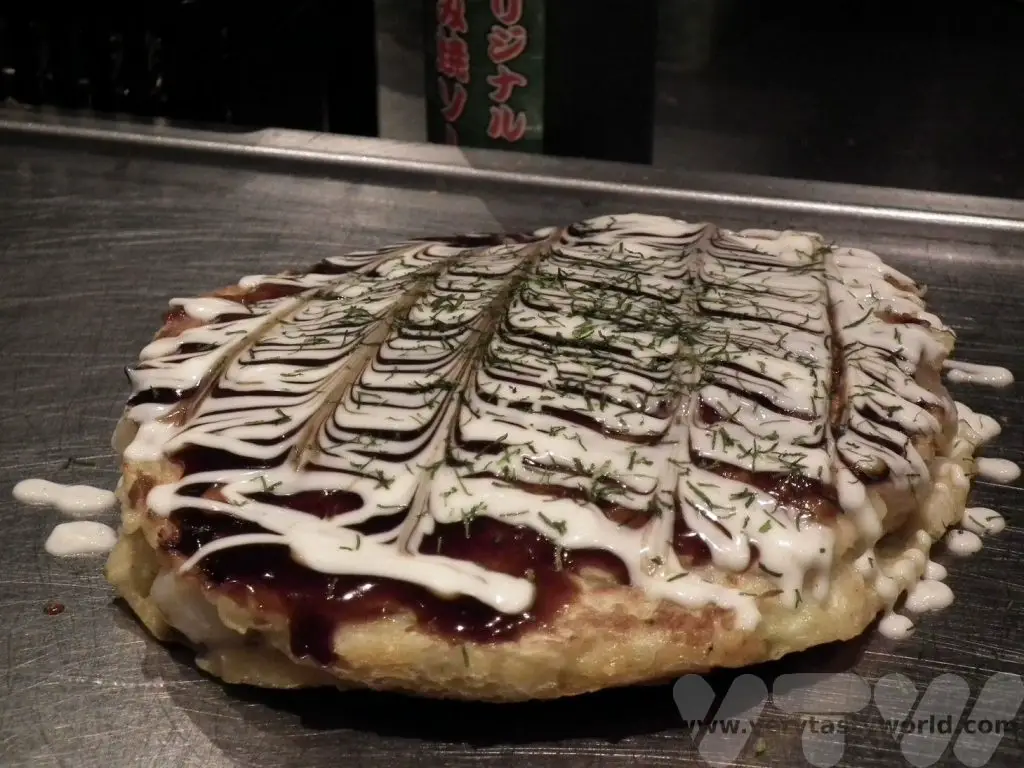
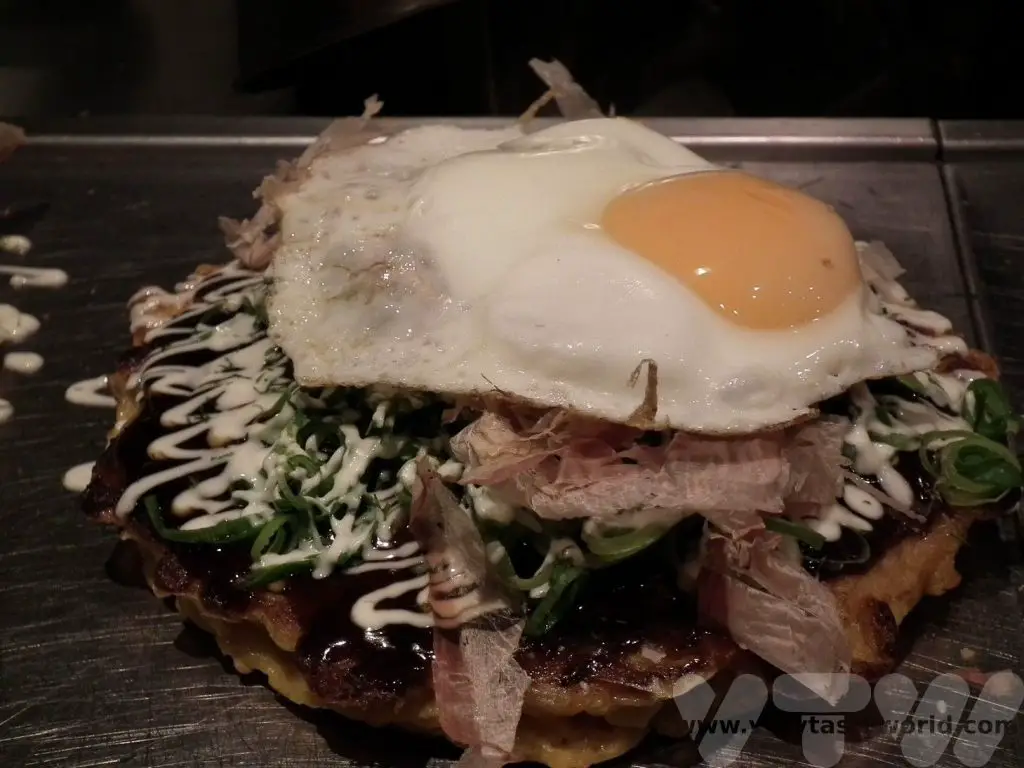
Fugu – Dare You Try Puffer Fish?
Fugu is the fish that has a formidable reputation – it’s the puffer fish, parts of which are deadly poison particularly the liver, the ovaries, eyes, and skin. The toxin basically paralyses you and you asphyxiate while still conscious. Not very nice at all.
But fugu is also a prized delicacy. The non-poisonous bits are fine to eat but absolutely can only be prepared by a licenced chef who has trained for several years. You can eat fugu all over Japan but it was at Zubora-ya, with its highly distinctive sign comprising a giant pufferfish lantern outside the restaurant, that we first tasted this fearsome fish.
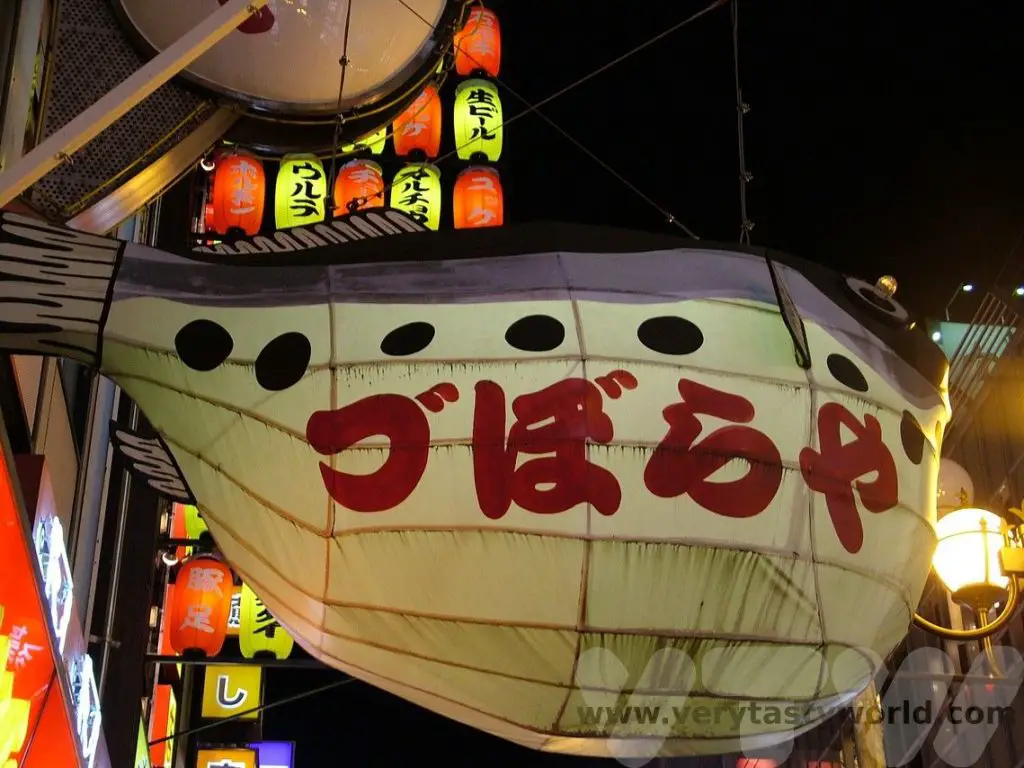
We thoroughly enjoyed a set menu at Zubora-ya – sushi and sashimi is the conventional way to enjoy fugu. It has a mild flavour and a firm texture that is something like a cross between squid and monkfish. It was delicious. And we survived!
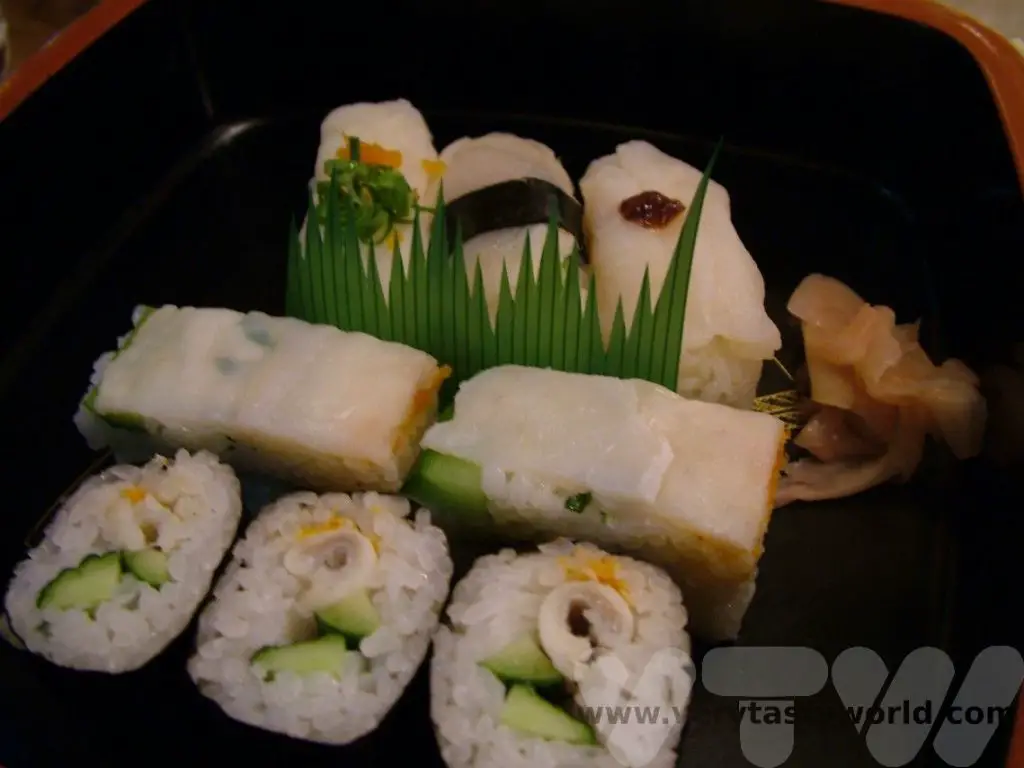
Sadly, Zubora-ya had to close during the pandemic and has not reopened.
Kani – Crab Heaven
Kani Doraku is another distinctive restaurant which has a model of a giant crab waving its pincers on the outside wall, beckoning you inside (well, that’s our interpretation!).

We have eaten here several times and always had a hugely enjoyable meal. Again, it’s a multi-storey building and, depending on how busy it is you may eat within the restaurant or be taken to a private room with tatami mat flooring and a telephone. The telephone was a bit daunting first time around but we picked up the phone and said, ‘kite kudasai,’ (please come here) and someone came along to take our order – which largely involved pointing at a picture menu. Even though it’s a large restaurant it’s very popular these days so it’s worth booking. There are actually multiple restaurants of this chain along Dotonbori, so check out the others if the first one you try is full. (The most popular is closest to the Glico Man.) The set menus aren’t cheap but they are good value and the food is utterly delicious.
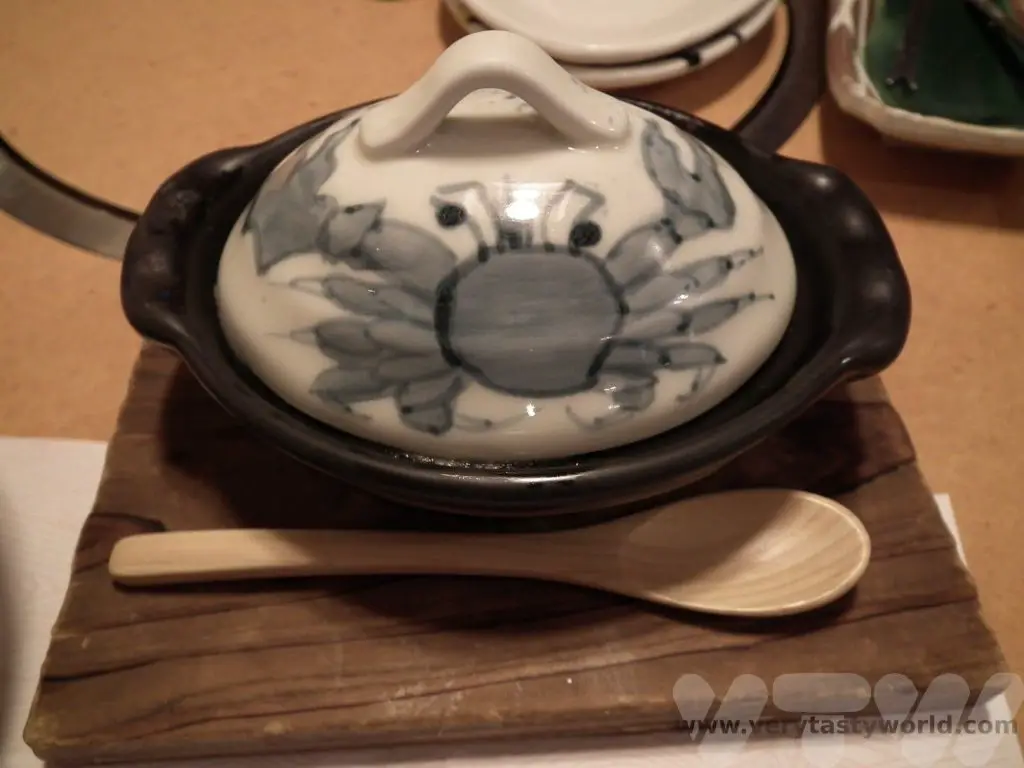
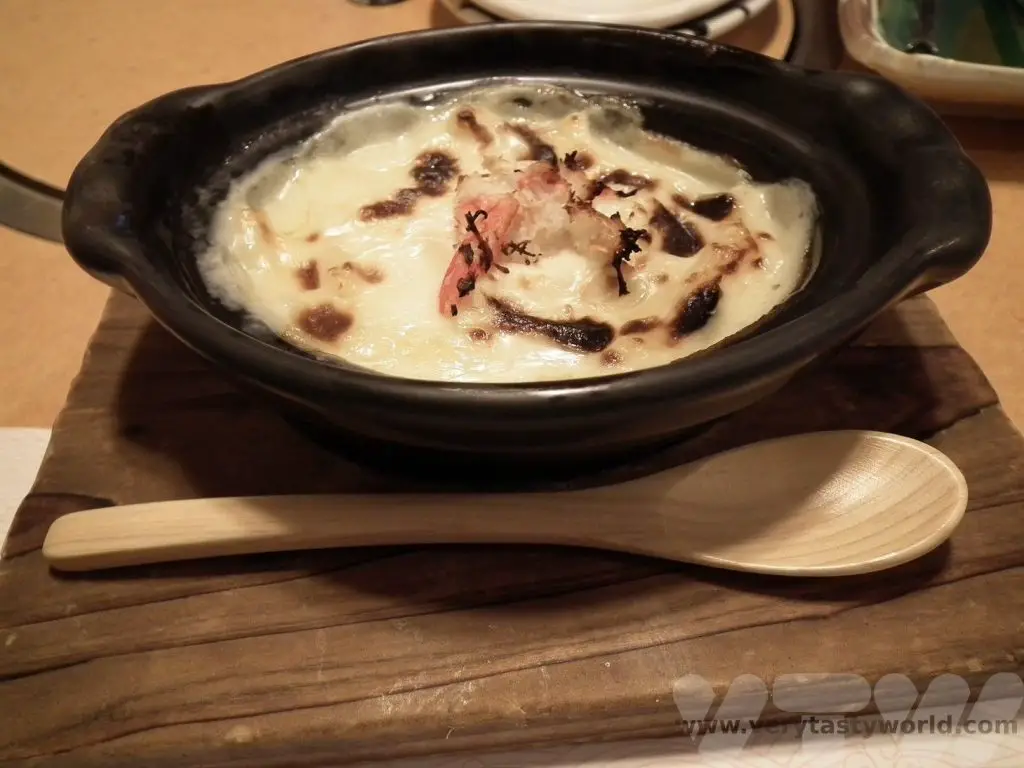
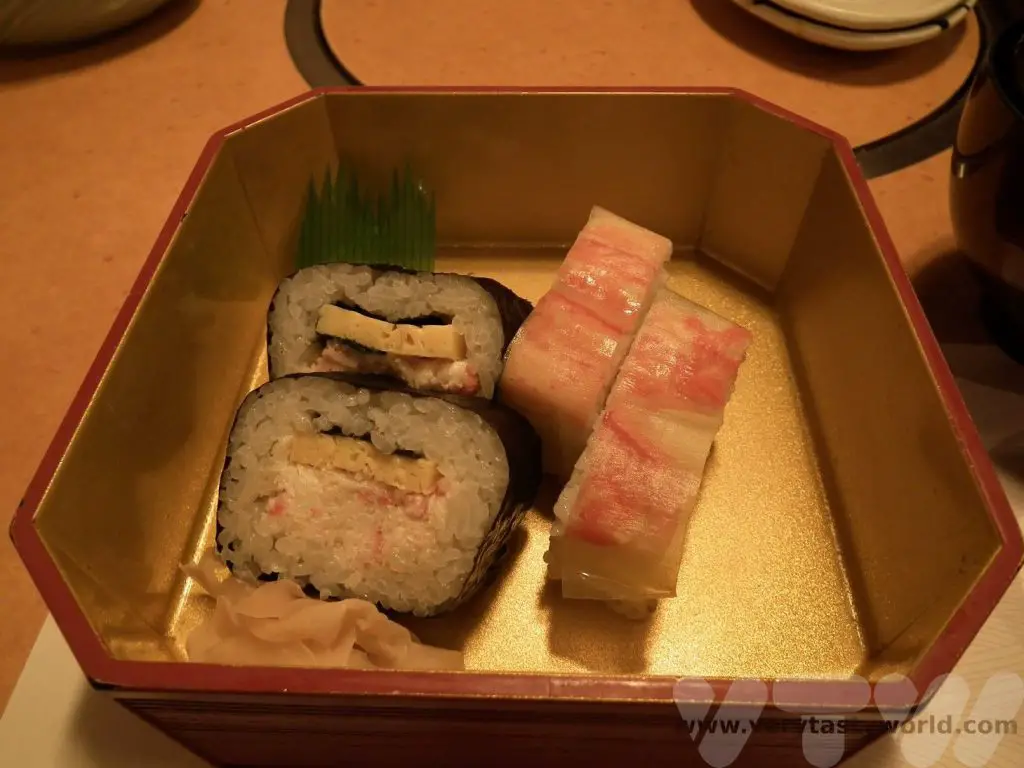
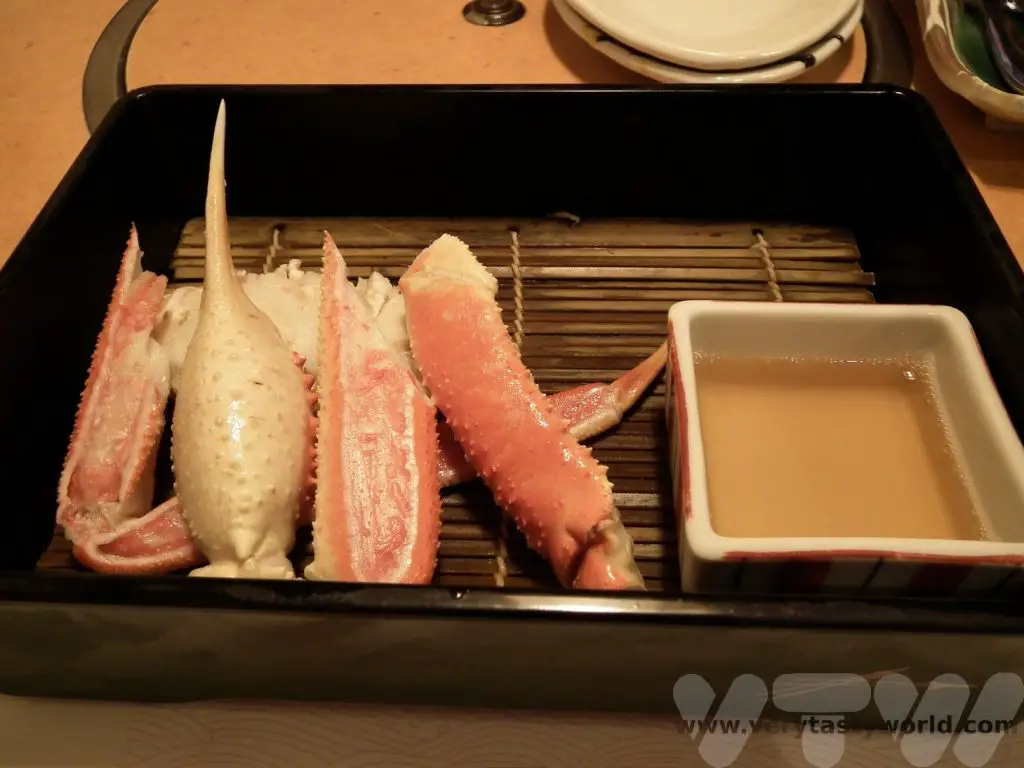
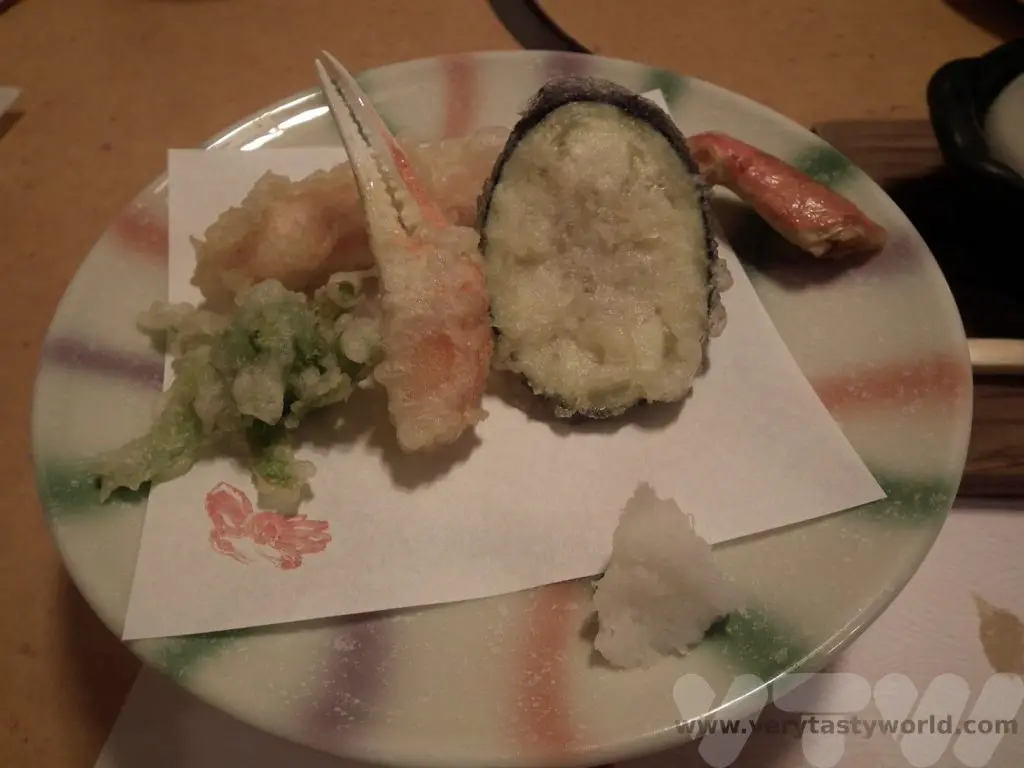
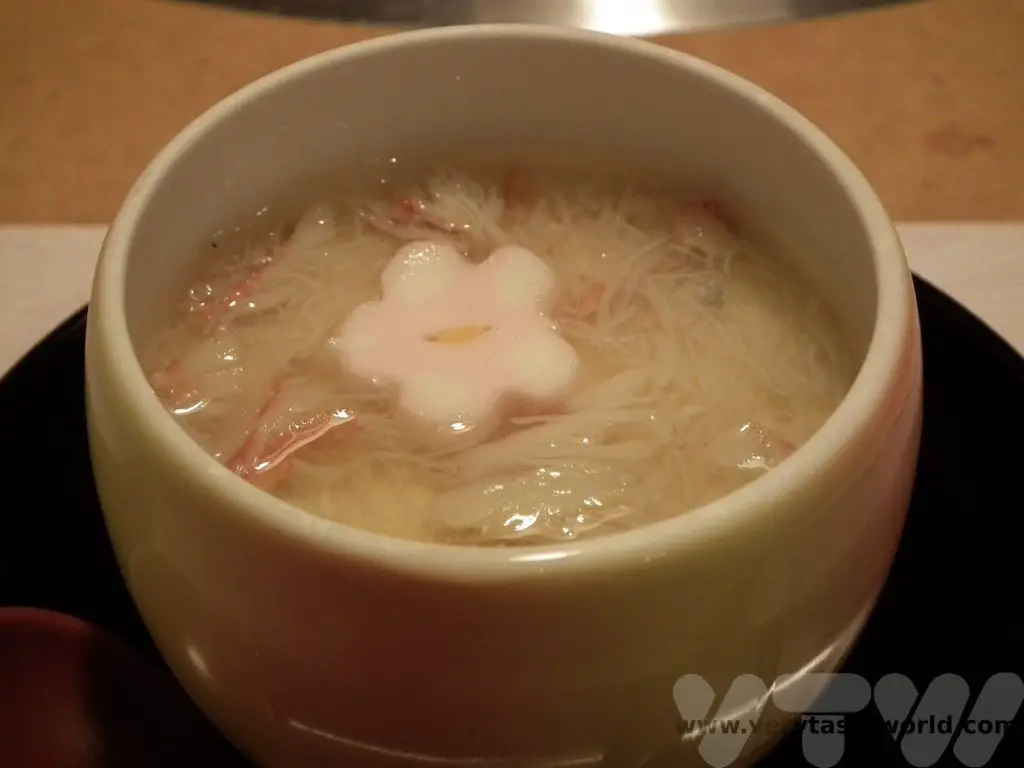
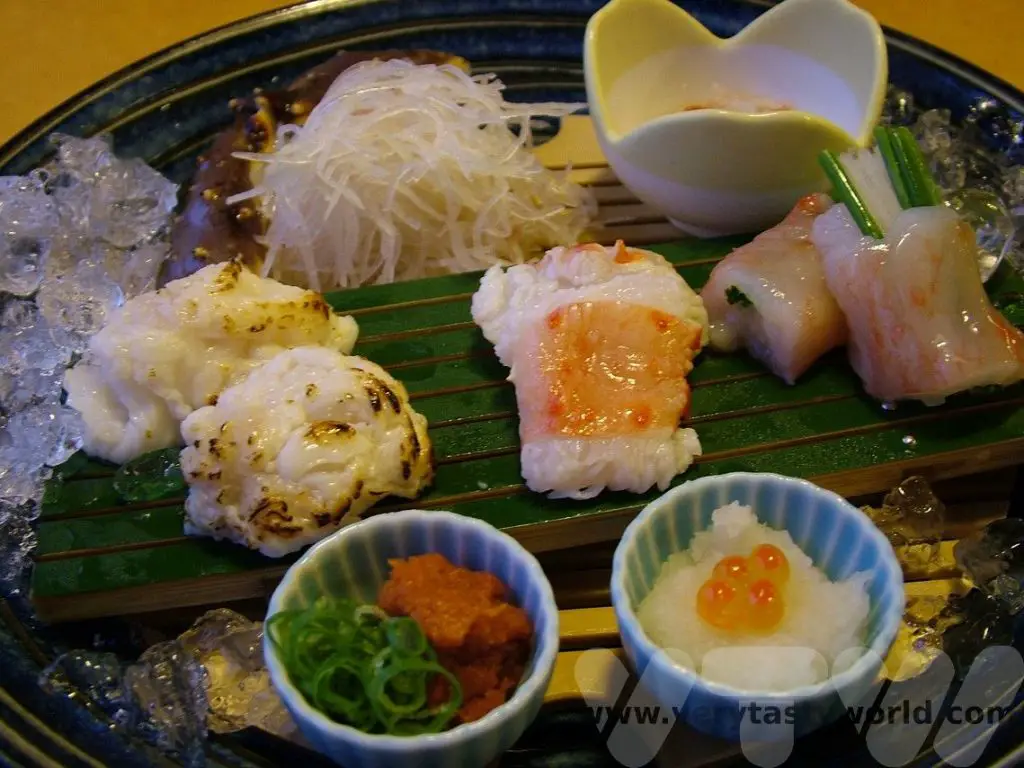
We’ve enjoyed crab sushi and sashimi, crab chawan mushi (steamed egg custard), crab tempura and crab gratin with a clear soup and matcha ice cream for dessert. Utterly delicious.
Other Dotonbori Establishments
There are loads of other restaurants along Dotonbori and the surrounding area. Kuidaore was an enormous eight storey restaurant founded in 1949. It was recognisable by its iconic Kuidaore Taro Clown, a vaguely creepy mechanical drumming puppet at the entrance. Sadly it closed some years ago but the building was populated by different shops and restaurants in what’s now known as the Nakaza Cui-daore Building.
If you like ramen noodles (and who doesn’t?) there are three Kinryu restaurants along the street. Kinryu translates as ‘golden dragon’ and the restaurants can easily be found by their distinctive dragons on the hoardings above the shopfront.
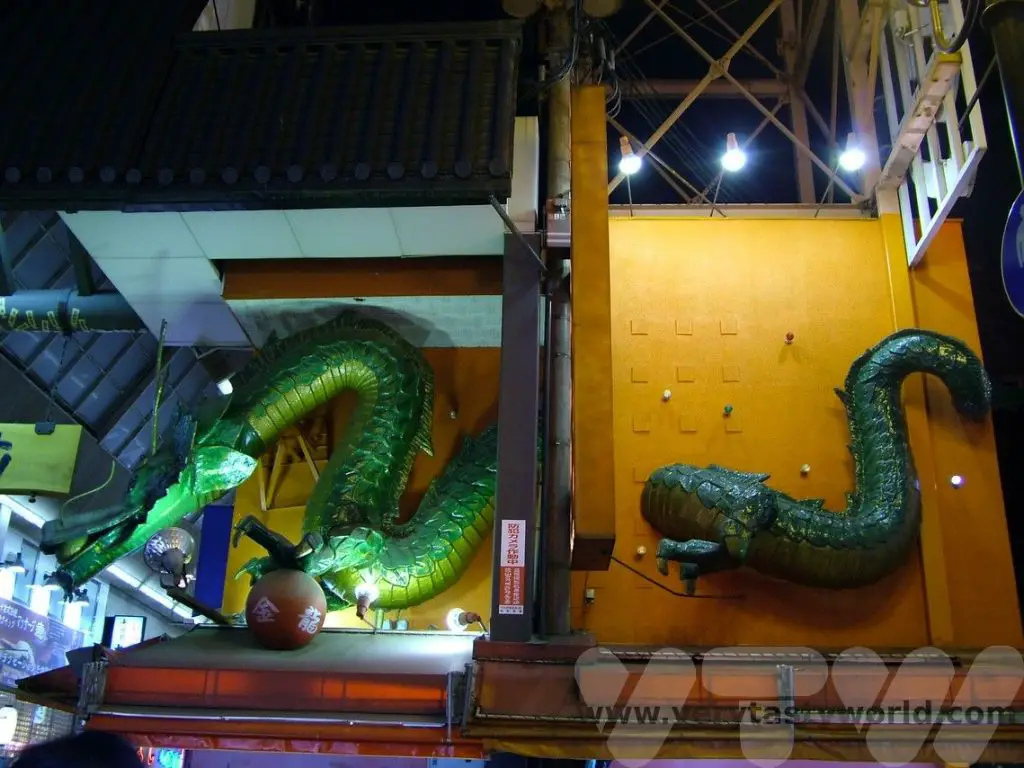
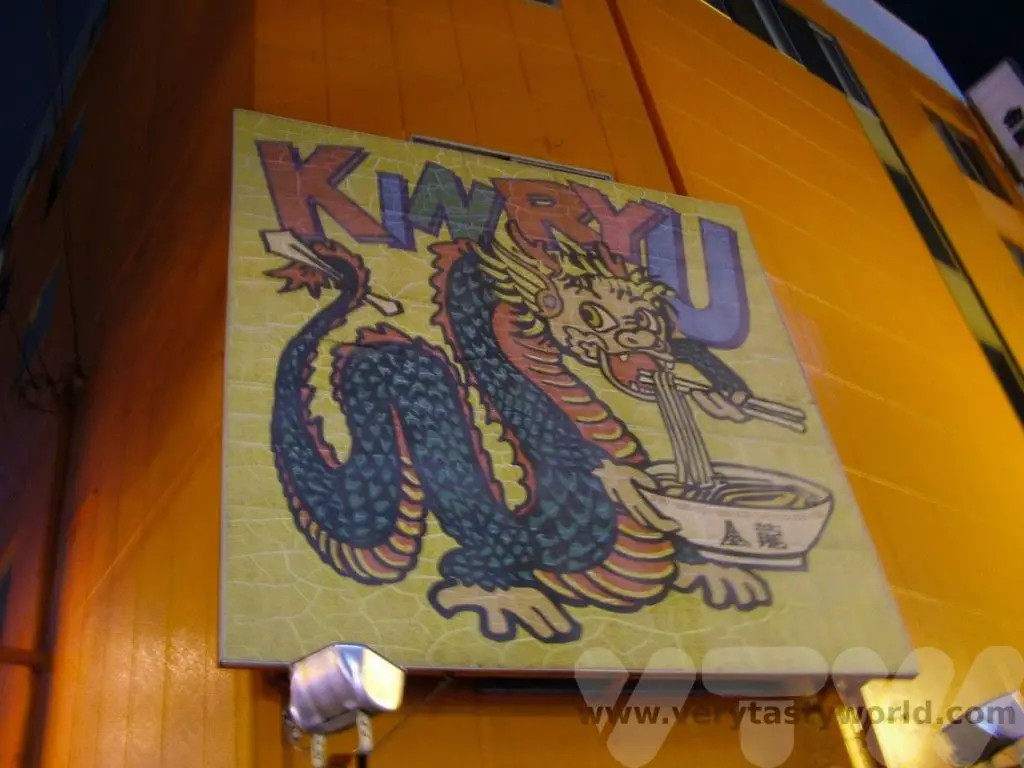
And even the standard restaurants on Dotonbori, those without the amazing neon signs, are worth checking out. One of the great things about dining in Osaka – and indeed throughout Japan – is that you don’t need to speak or read Japanese. Many restaurants will have an English, Chinese or Korean menu and those that don’t will often have a picture menu or, better, realistic models of the food in the window, usually with prices. You can take a photo of your desired dish or even take your food server outside and point to the dish you want.
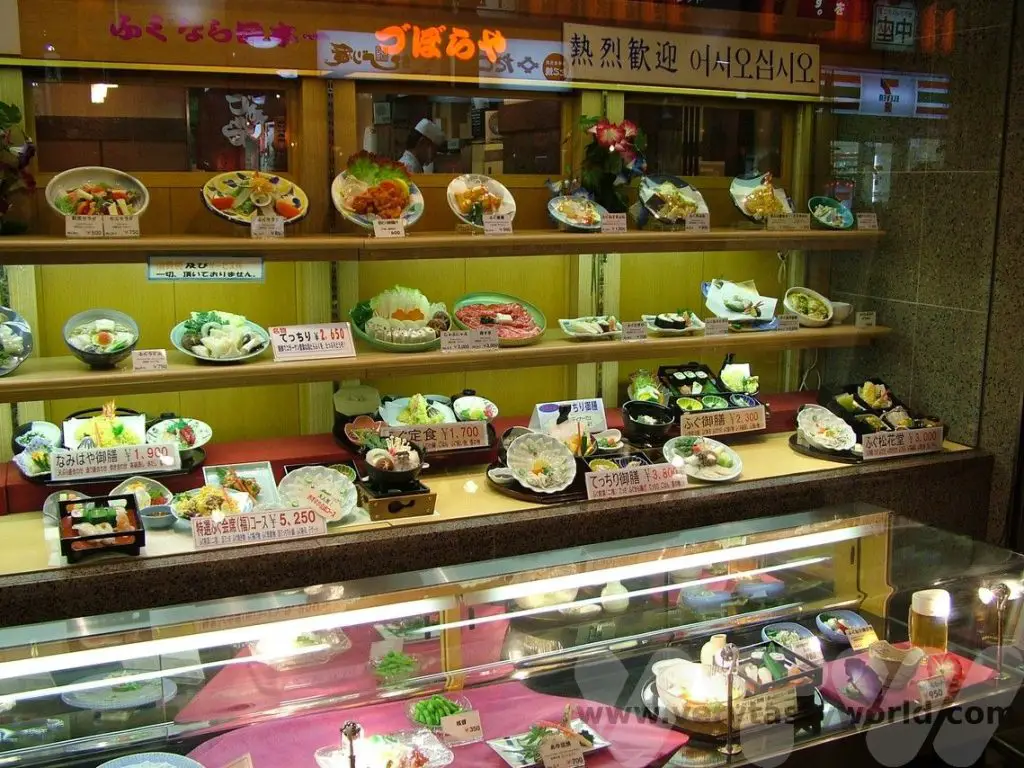
The models of the food are surprisingly realistic and many are made in Osaka. We managed to find a shop that sold them but they are hideously expensive, so we treated ourselves to a couple of sushi fridge magnets as a souvenir.
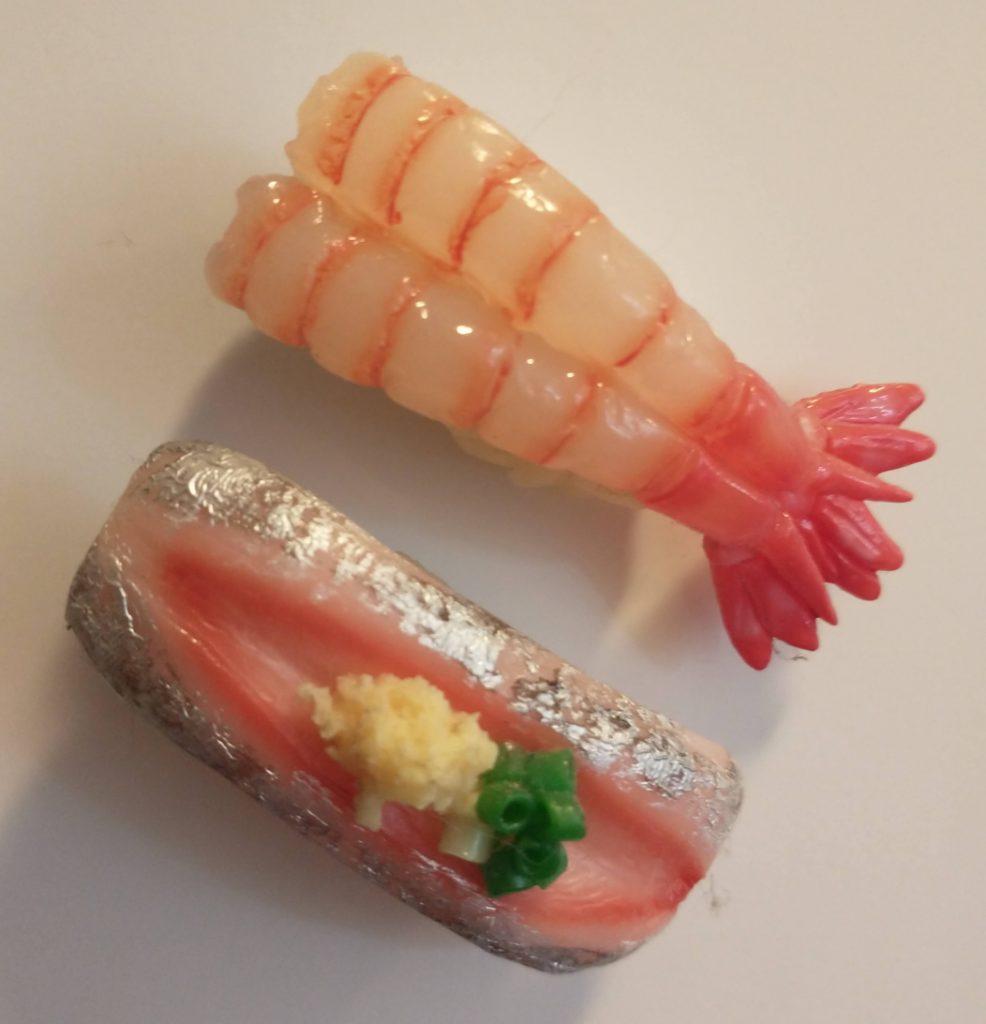
Related Posts You May Enjoy

- Recipe: Simmered Shiitake Mushrooms
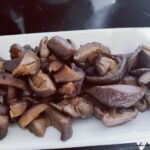
- How to Use Public Transport in Japan

- RECIPE Oyakodon Donburi

- Planning a Trip to Japan
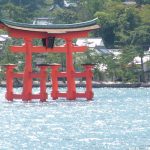
- The Makanai: Cooking for the Maiko House
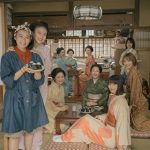
- Setsubun Food – Bean Throwing Day

- The Gassho Farmhouses of Rural Japan
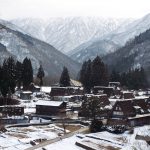
- Recipe: Japanese Simmered Pork Belly – Buta no Kakuni

- RECIPE: How to Make Umeboshi

Visit Yakushima Island in Japan
The Island That Inspired The Setting of Studio Ghibli’s Princess Mononoke
Anyone who is familiar with the delightful animations of Japan’s Studio Ghibli will that know that its founders, Hayao Miyazaki and Isao Takahata, created very distinctive locations for the settings of their films. Princess Mononoke was one of the first Ghibli films really to break into public consciousness, albeit largely with animation fans, in western countries in 1998 (the smash hit Oscar winning Spirited Away in 2001 ensured that the studio’s fame was assured). Princess Mononoke’s setting was inspired by the island of Yakushima, located around 60km from the southernmost point of Kyushu, Japan’s third largest island, which is part of the Osumi chain of islands. The island is almost perfectly round and mountainous. It’s also very beautiful indeed. And even if you aren’t familiar with the films of Studio Ghibli there are all sorts of things to do if you visit Yakushima.
Getting To Yakushima
Being big fans of Studio Ghibli and, having visited the fabulous Studio Ghibli museum on previous visits to Japan, we decided that we definitely wanted to visit Yakushima for a couple of days. On this trip we had decided explore Kyushu. We flew into Osaka and then caught the shinkansen (bullet train) to Nagasaki and then across to the southern city of Kagoshima. Kagoshima is a lovely laid-back city set in the shadow of the active volcano Sakurajima, which regularly emits rumblings of ash and smoke. It’s possible to visit the volcano by crossing the picturesque bay on a ferry.
In Kagoshima we chose a business hotel that was close to the port. The staff were happy to look after our luggage for a couple of days, so we just packed a small bag, which meant that we could travel light. The excellent YesYakushima company helped us to visit Yakushima – they booked ferry tickets, car hire and accommodation for us. (This isn’t an affiliate link but we’ll happily recommend their free booking service which was absolutely excellent.) We were happy to explore for the island for ourselves but YesYakushima do offer guided tours if desired.
We caught the mid-morning Toppy/Rocket hydro-foil from Kagoshima port. It’s a picturesque journey as you sail across the bay. There are other options, such as a car ferry, but this was the quickest means of transport and it took around 2.5 hours.
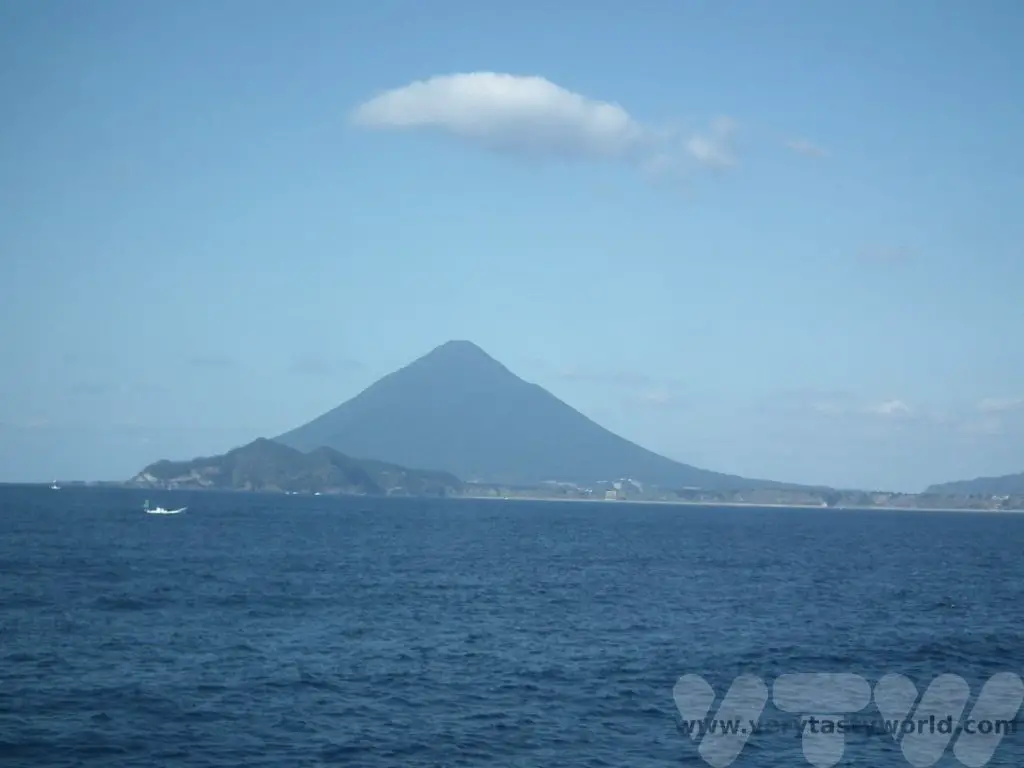
Our boat stopped off at Tanegashima island before arriving at Yakushima. (Some boats go direct, so check the timetable.) When we arrived at Anbo port our hire car was waiting for us, so we picked it up and were on our way. Driving was mainly very easy but if you don’t fancy getting behind the wheel buses are available.
Visit Yakushima – Staying On The Island
We treated ourselves to a stay at a ryokan, a traditional Japanese inn. Usually when we plan our trips to Japan we use a combination of cheap business hotels and then splash out on a few nights at a ryokan or two, which is more expensive but definitely worth the extra cost. The traditional inns usually have tatami (reed mat) flooring and you sleep on a futon, which is usually laid out for you while you eat dinner. We stayed at Tashiro Bekkan at Miyanoura.
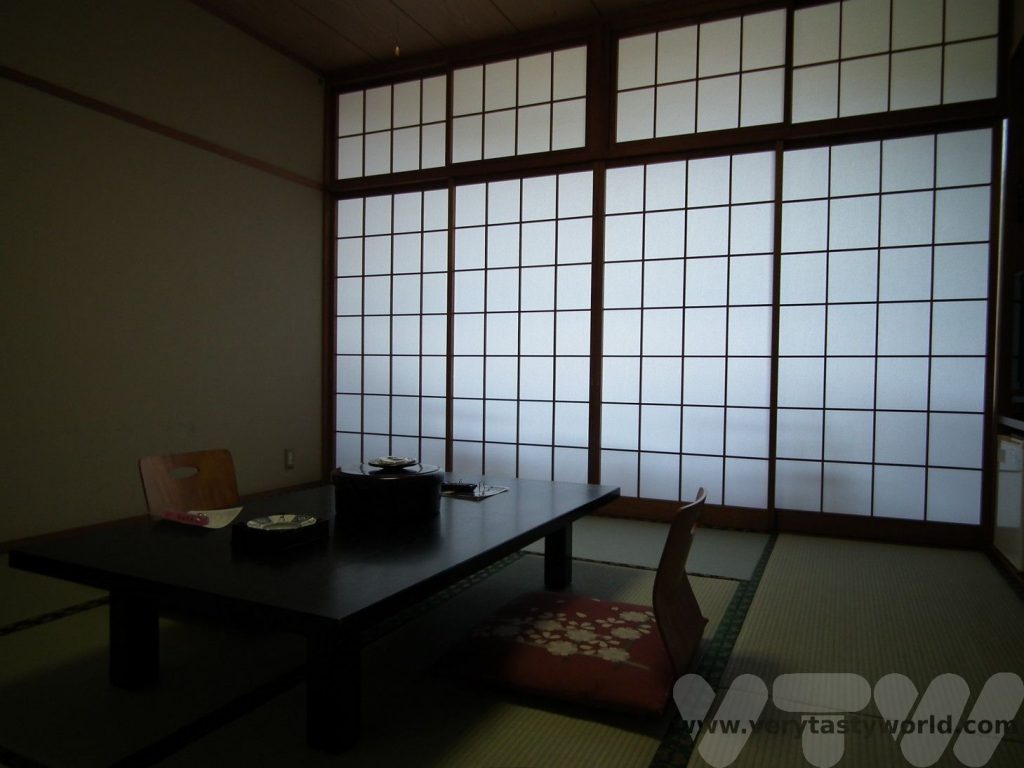
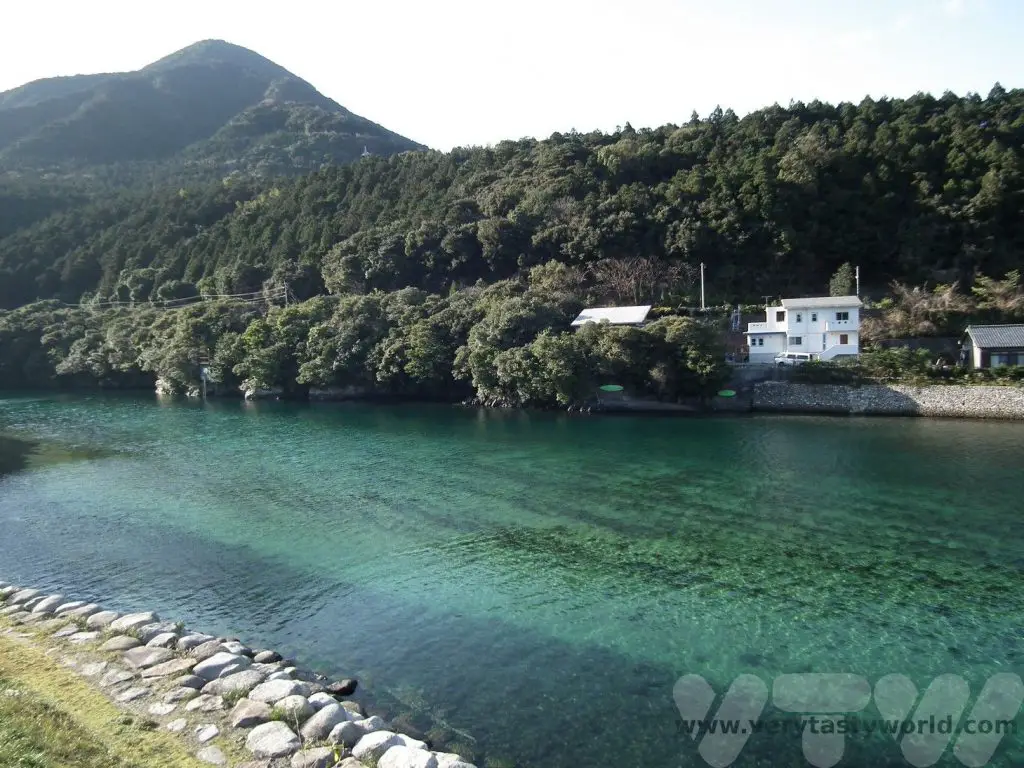
The ryokan had a large tatami room, private bathroom and balcony with a view across the crystal clear Miyanoura river.
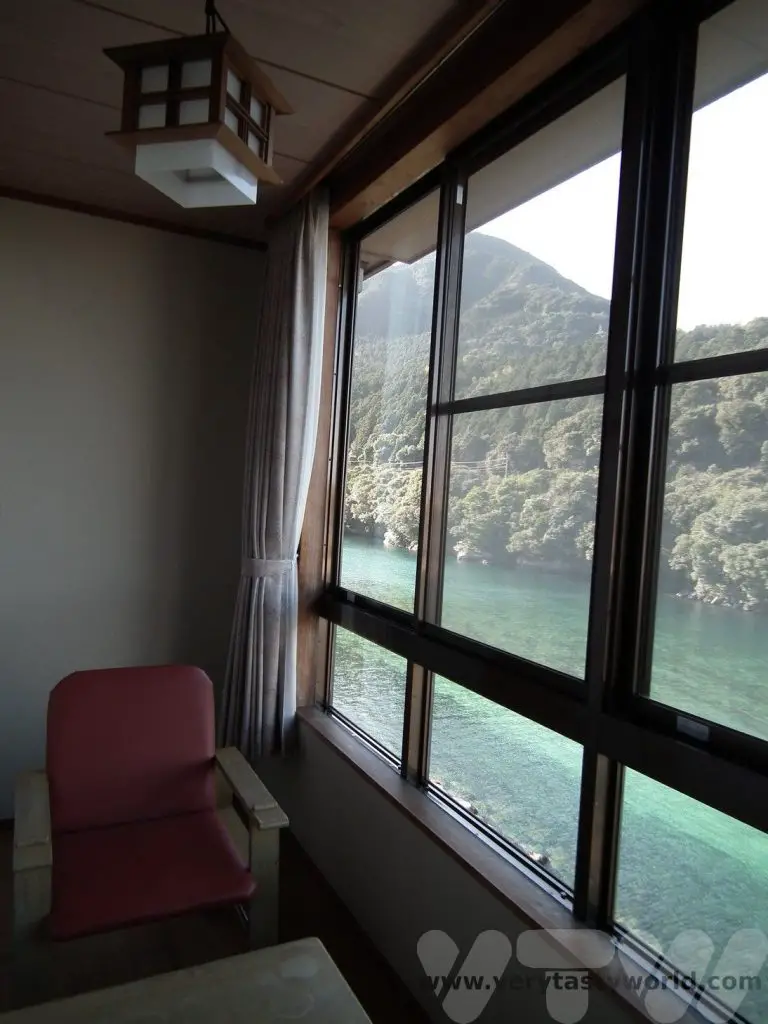
We chose to stay on a half-board basis, so ate the most exquisite food which included local ingredients such as seafood, mountain vegetables and, of course, kuro buta (black/Berkshire pork), a speciality of the region. The staff were delightful and we managed to have a few conversations with them in bad Japanese (our Japanese was bad, theirs was fine!)
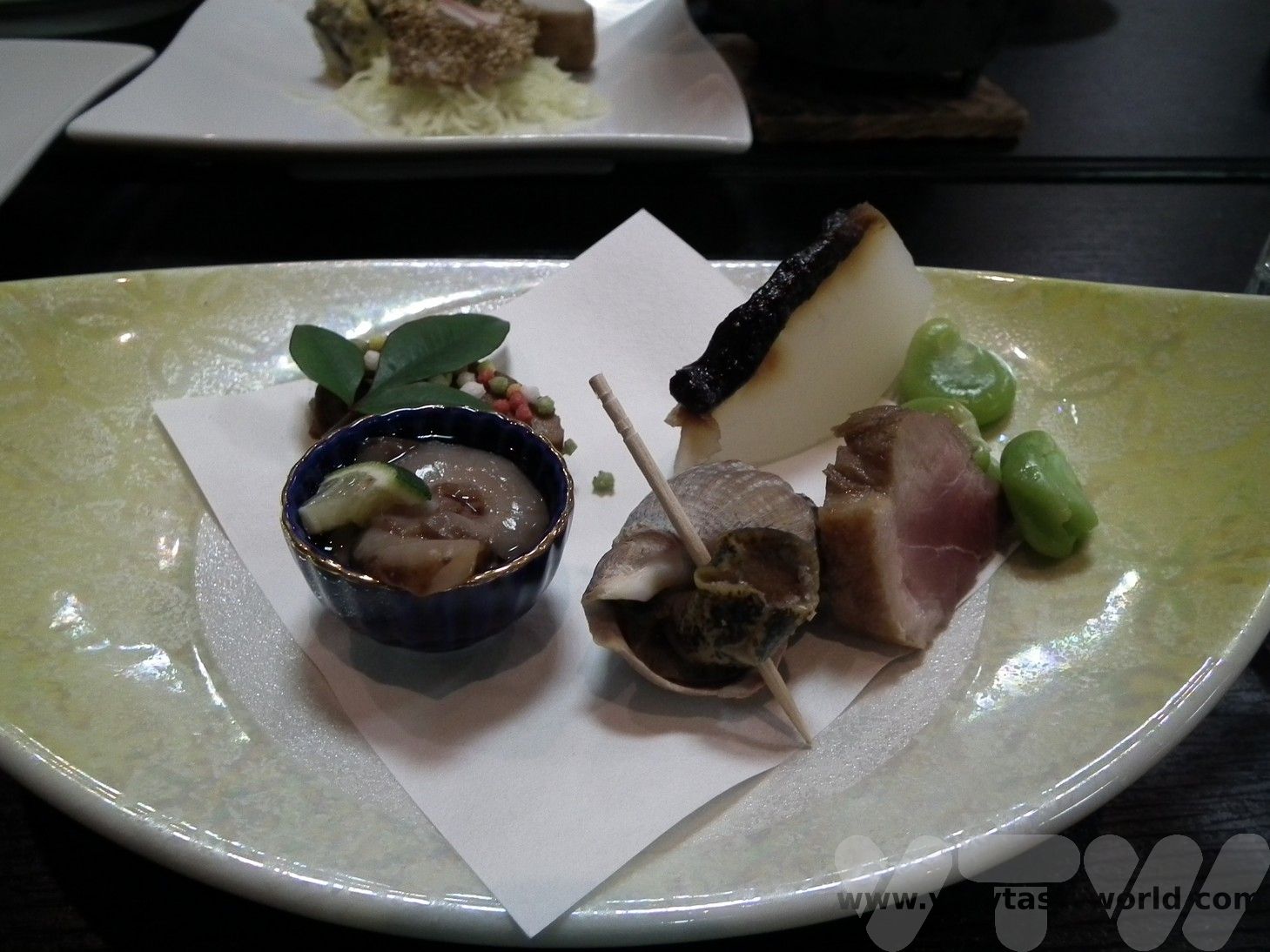
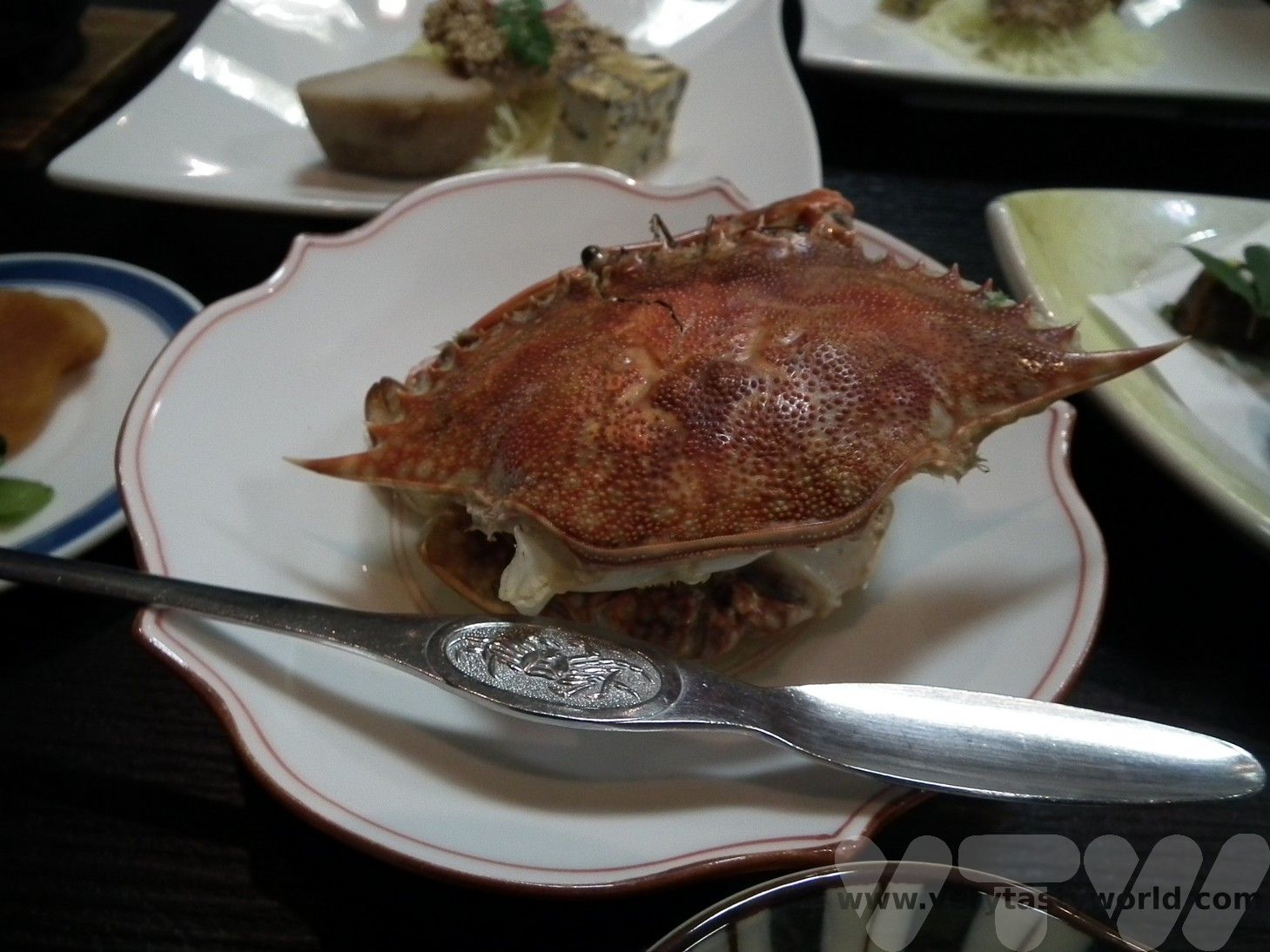
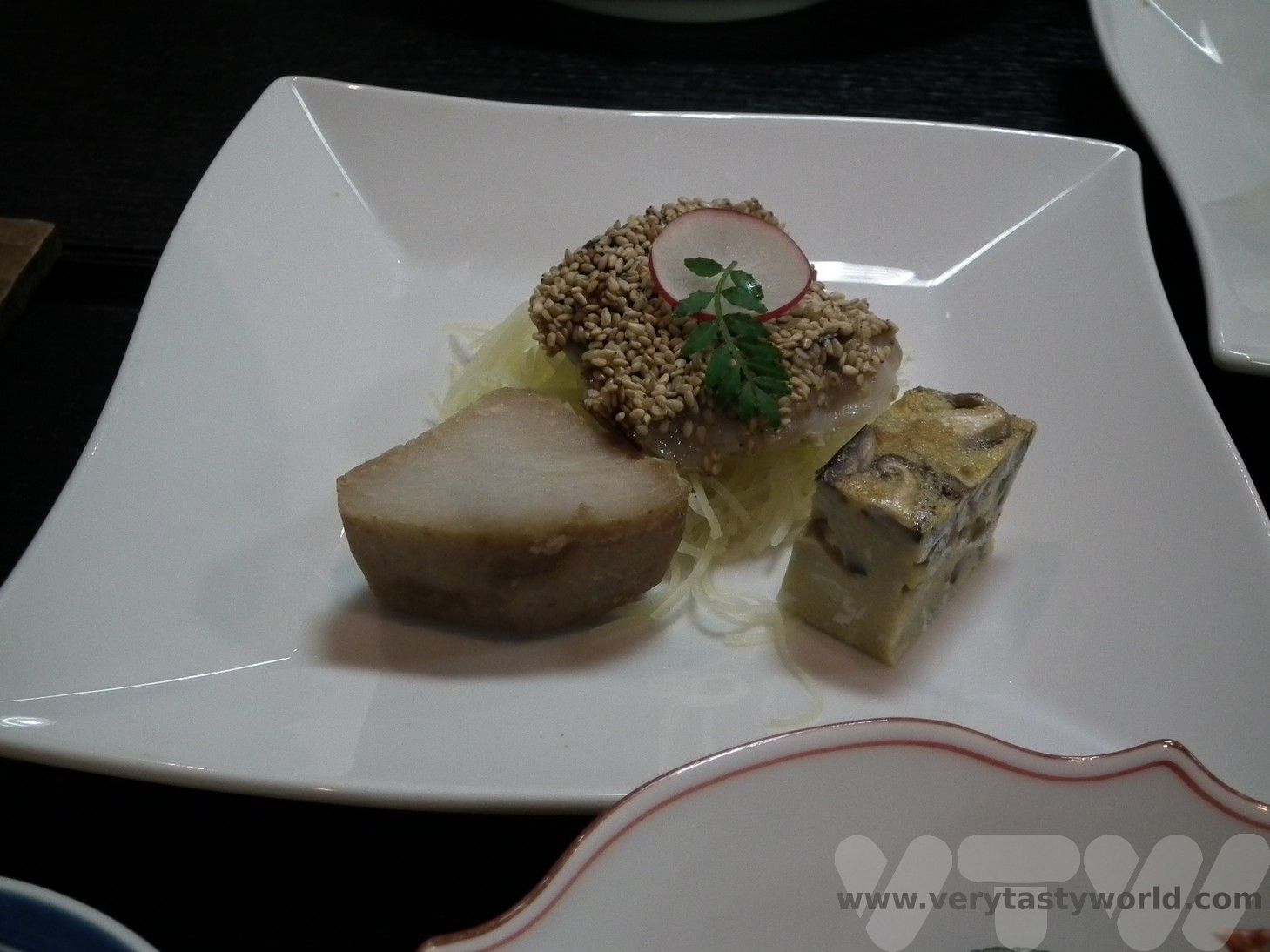
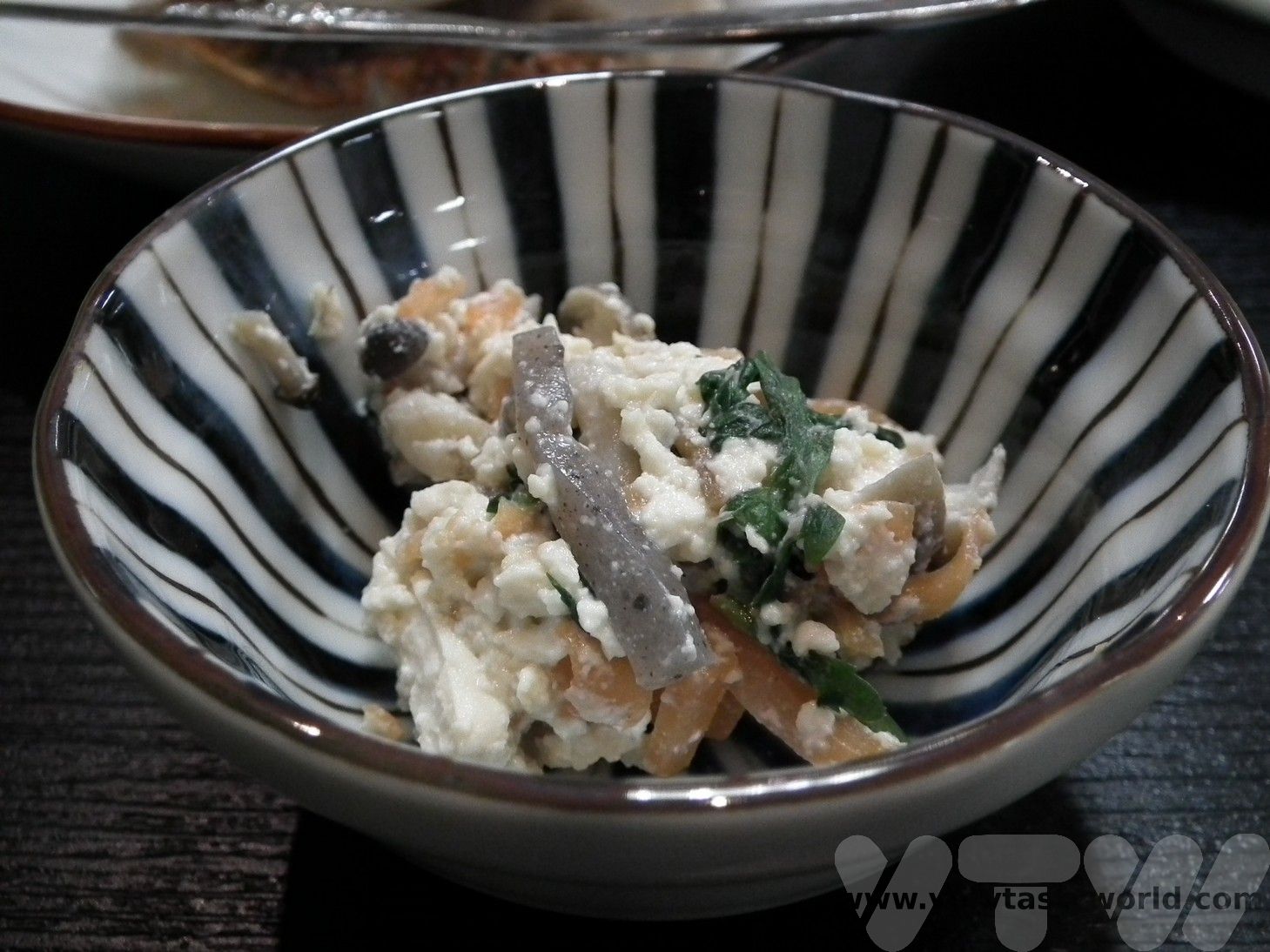
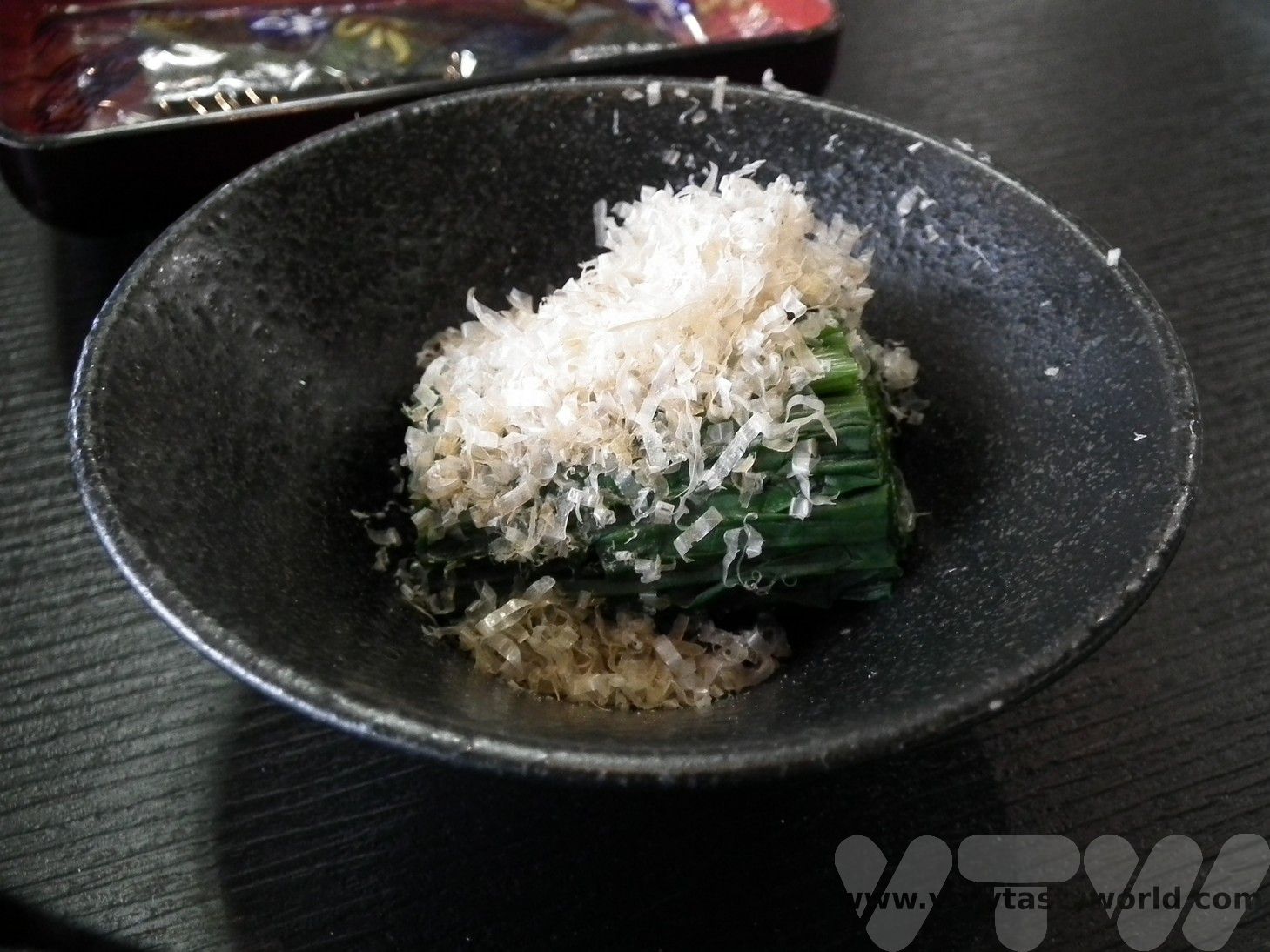
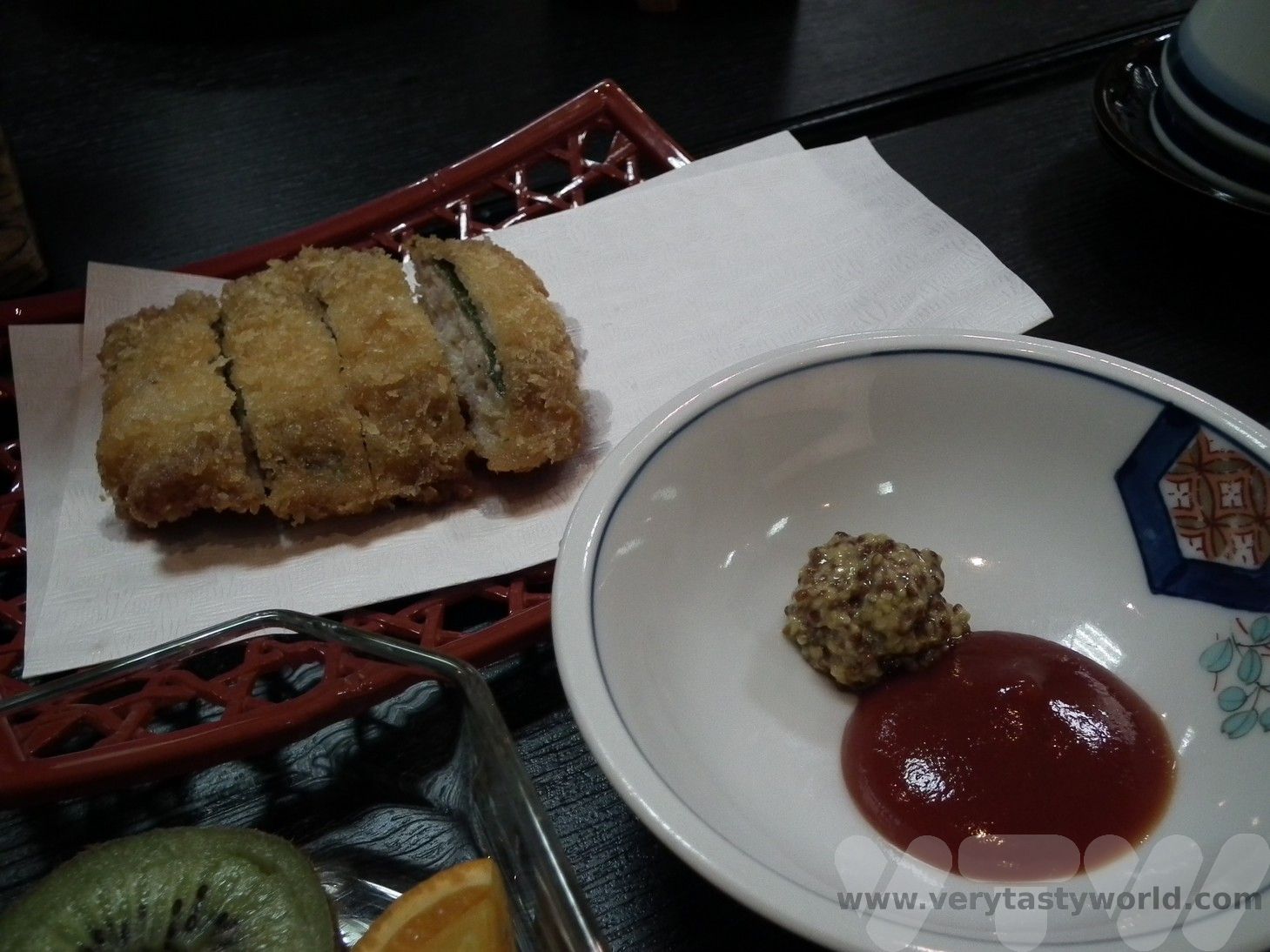
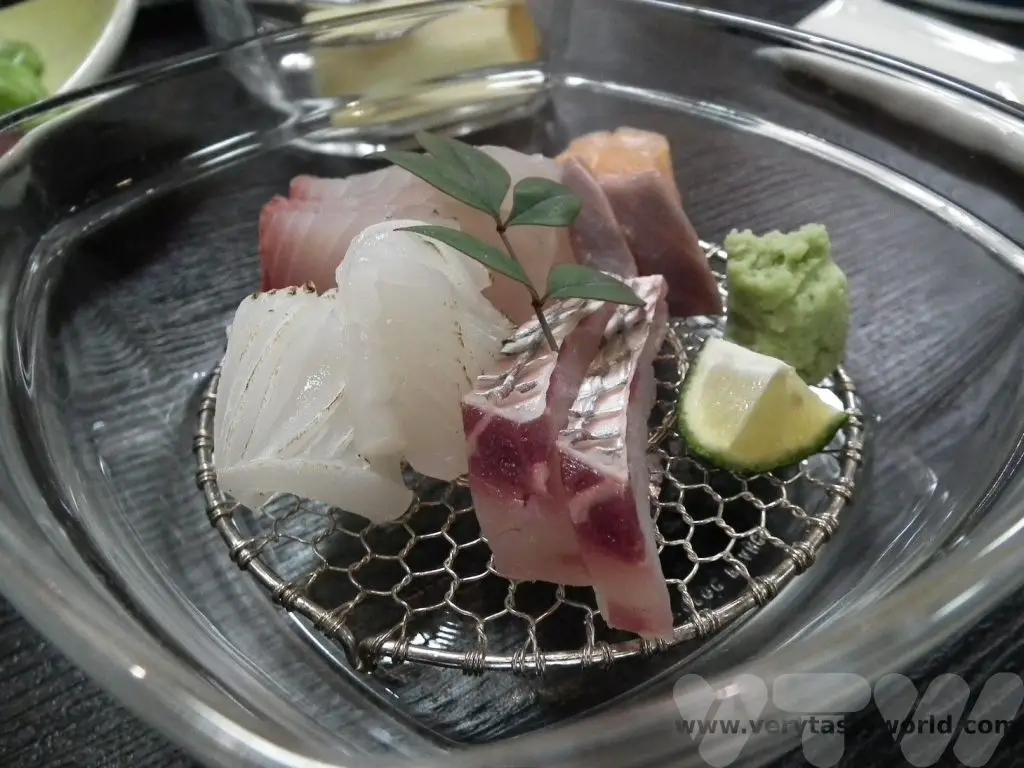
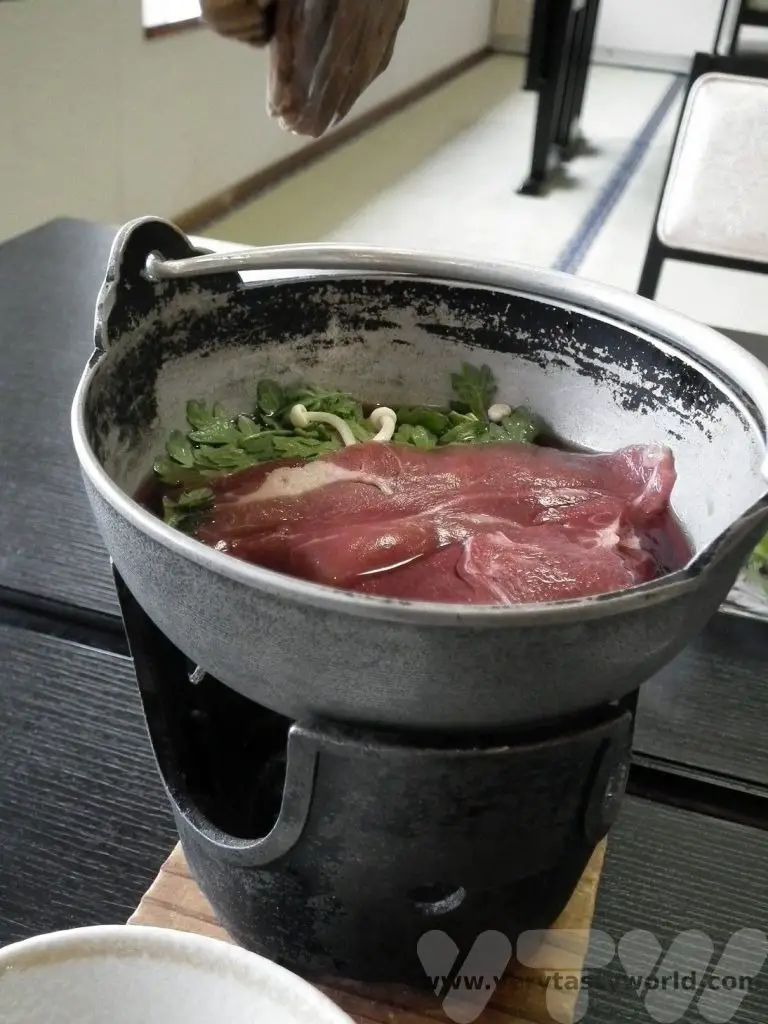
The ryokan was also able to offer us a bento lunch box – we simply placed an order the night before – and then picked it up before we went hiking the following morning.
Hiking In The Shiratani Unsuikyo Park
This park was the inspiration for the forest in Princess Mononoke and it is very clear to see how the artist Oga Kazuo used the stunningly beautiful landscape for the setting of the animation. It has ancient cedar trees and mossy paths as well as streams and waterfalls running through it. There are multiple trails from the car park and the walking is generally easy, although you need to take care of large tree roots that have grown across the path.
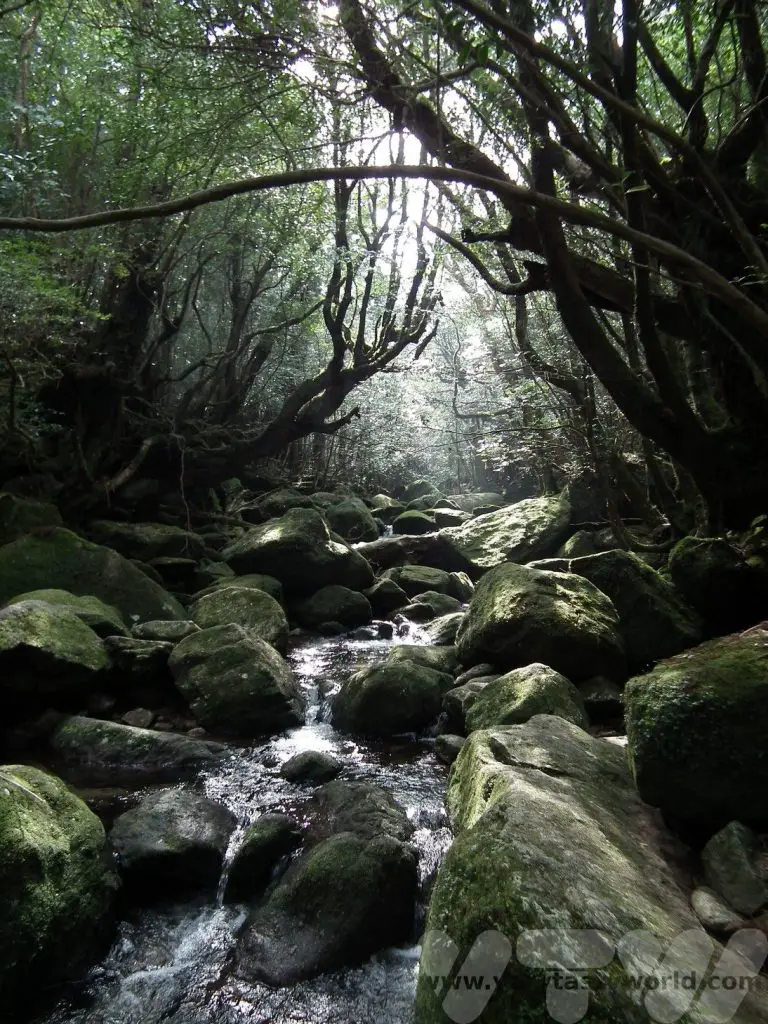
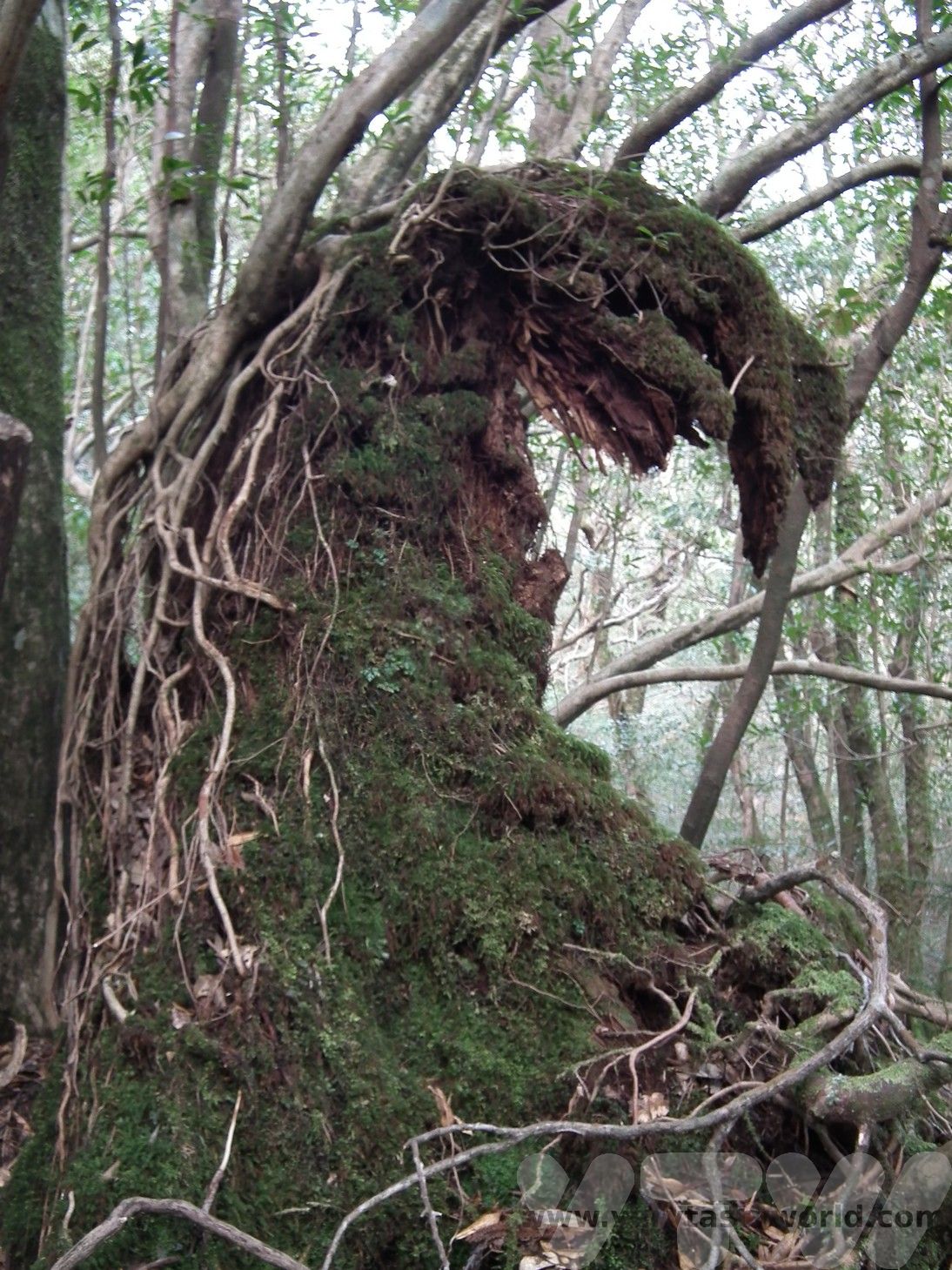
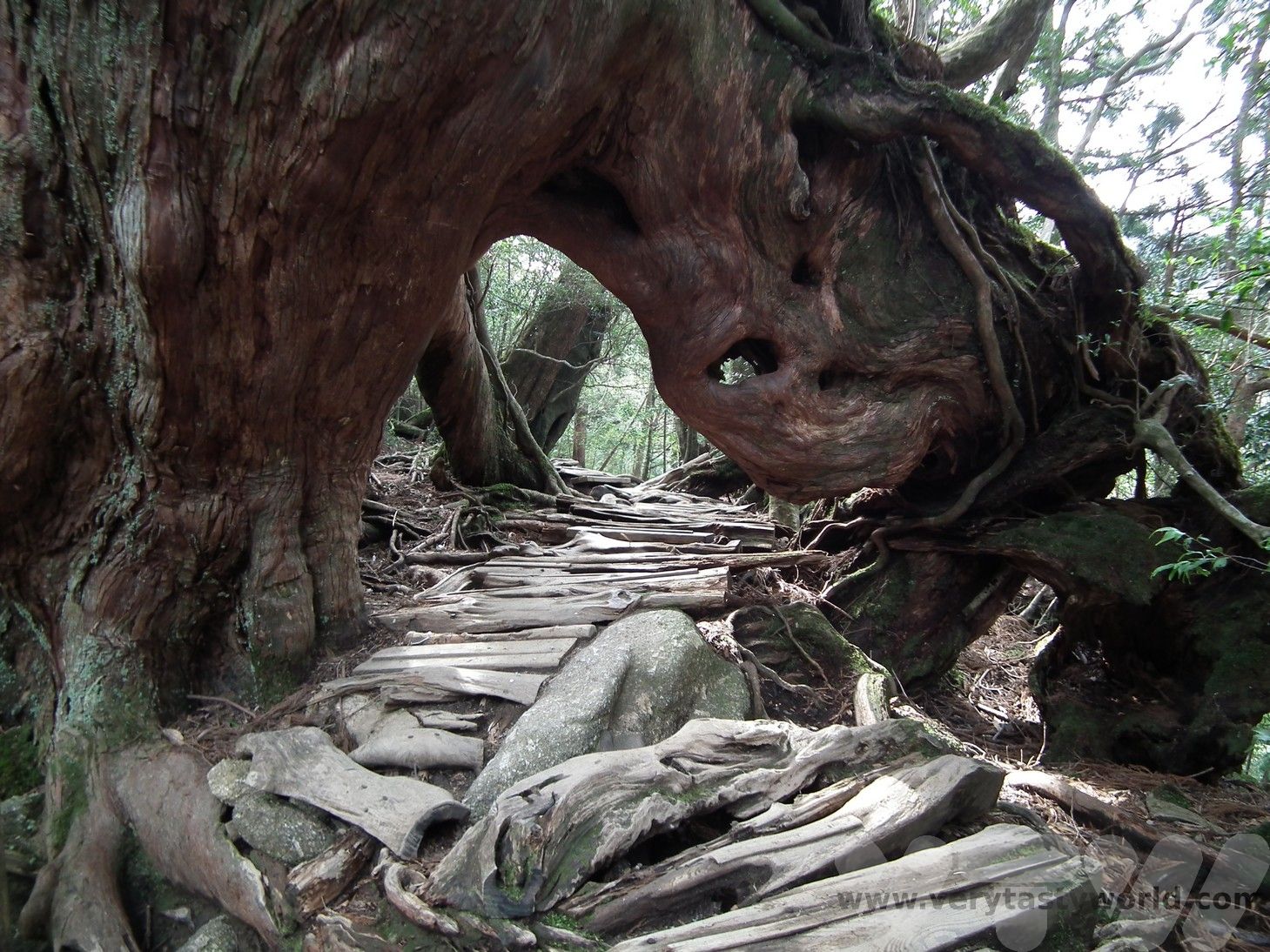
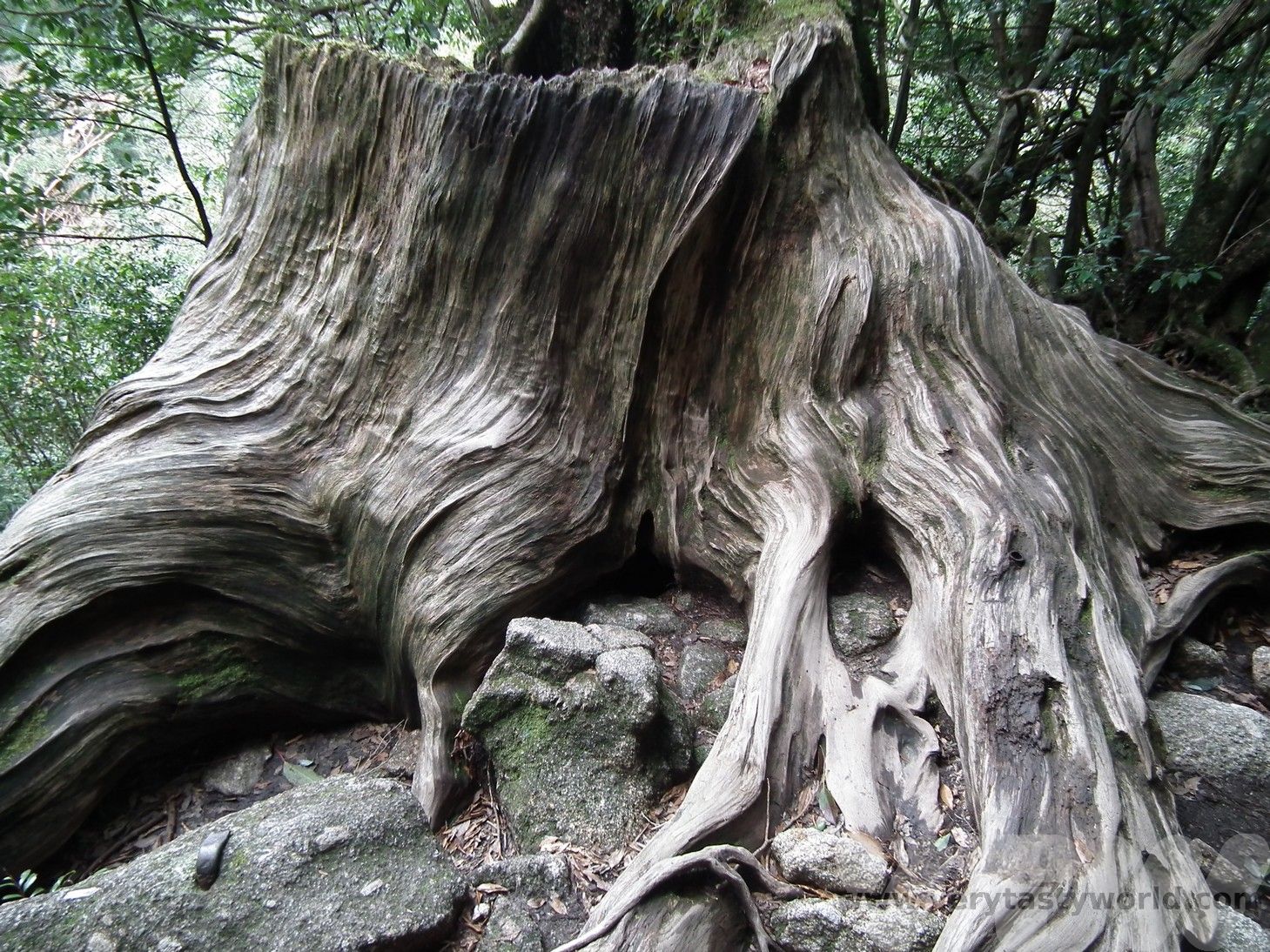
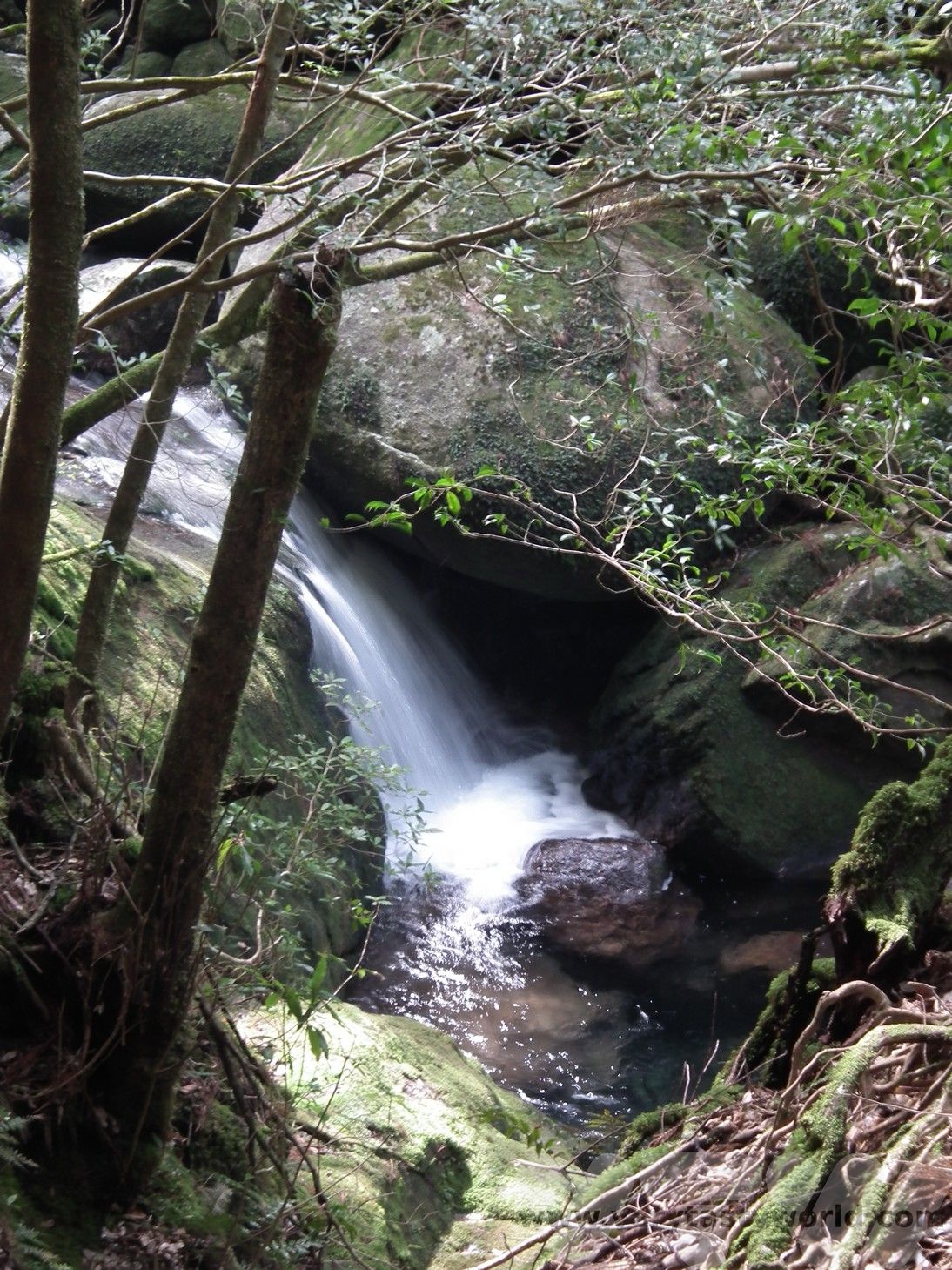
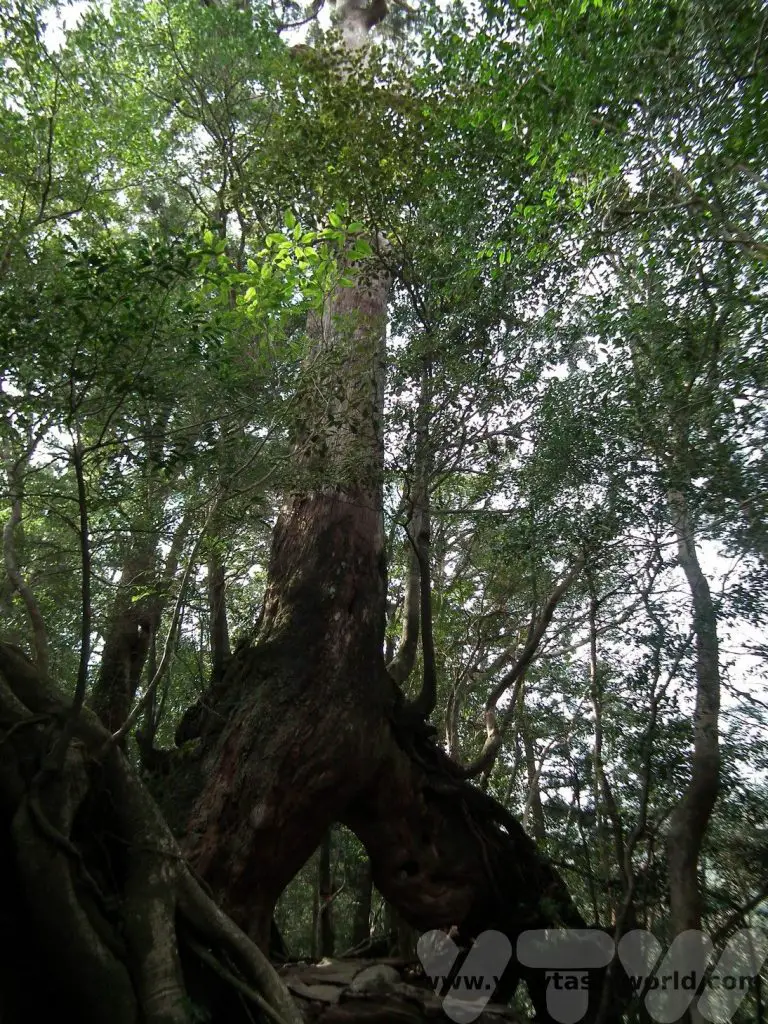
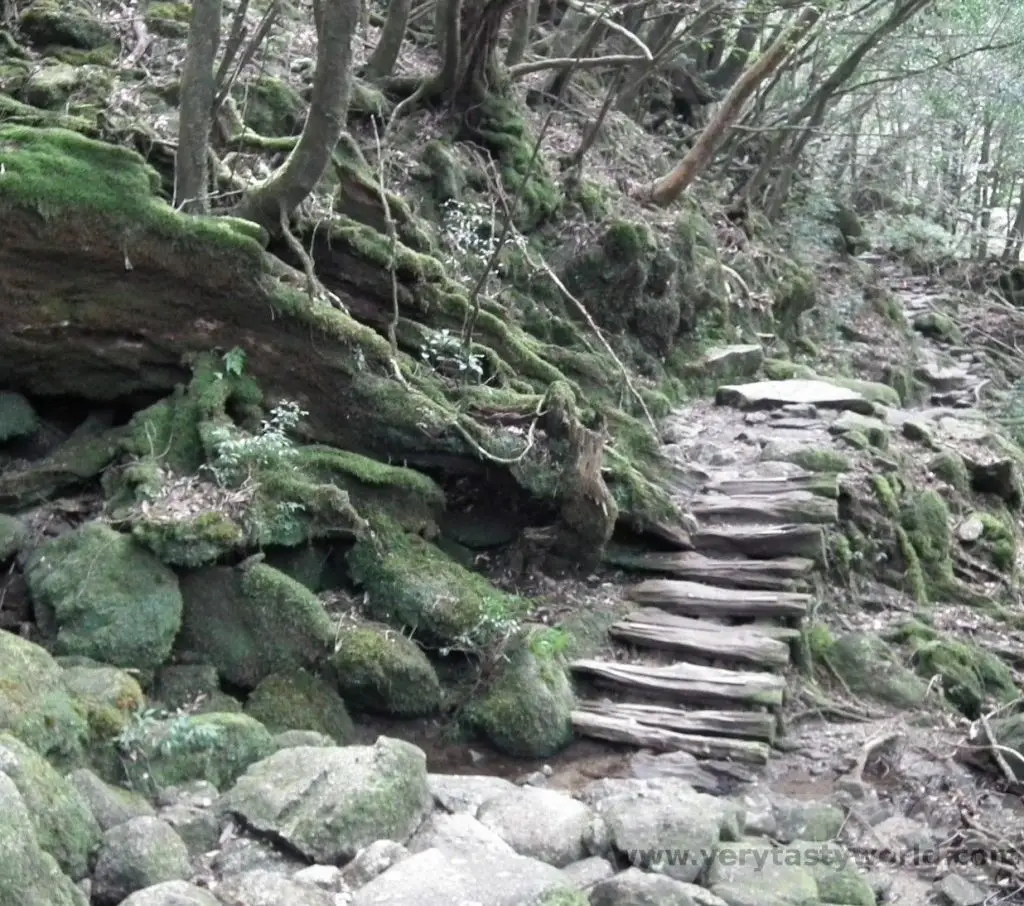
Visit Yakushima – Circumnavigate The Island
On our final day we decided to circumnavigate the island in the car before heading back to the hydrofoil. It’s largely a very easy drive but on the Seibu Rindo Forest path on the western part of the island the road narrows through the forest and becomes single track in some places, so you have to take care. We narrowly avoided a minor collision with a coach coming the other way.
From Miyanoura we drove north, stopping at the Shitoko Banyan Tree Park. Banyan trees are a complete contrast to the cedars of Shiratani Unsuikyo. These trees grow by dropping roots from the branches which eventually reach the ground and embed themselves in the soil creating additional roots to support the tree. They can also form around other types of tree and can eventually kill them as they choke the existing root system.
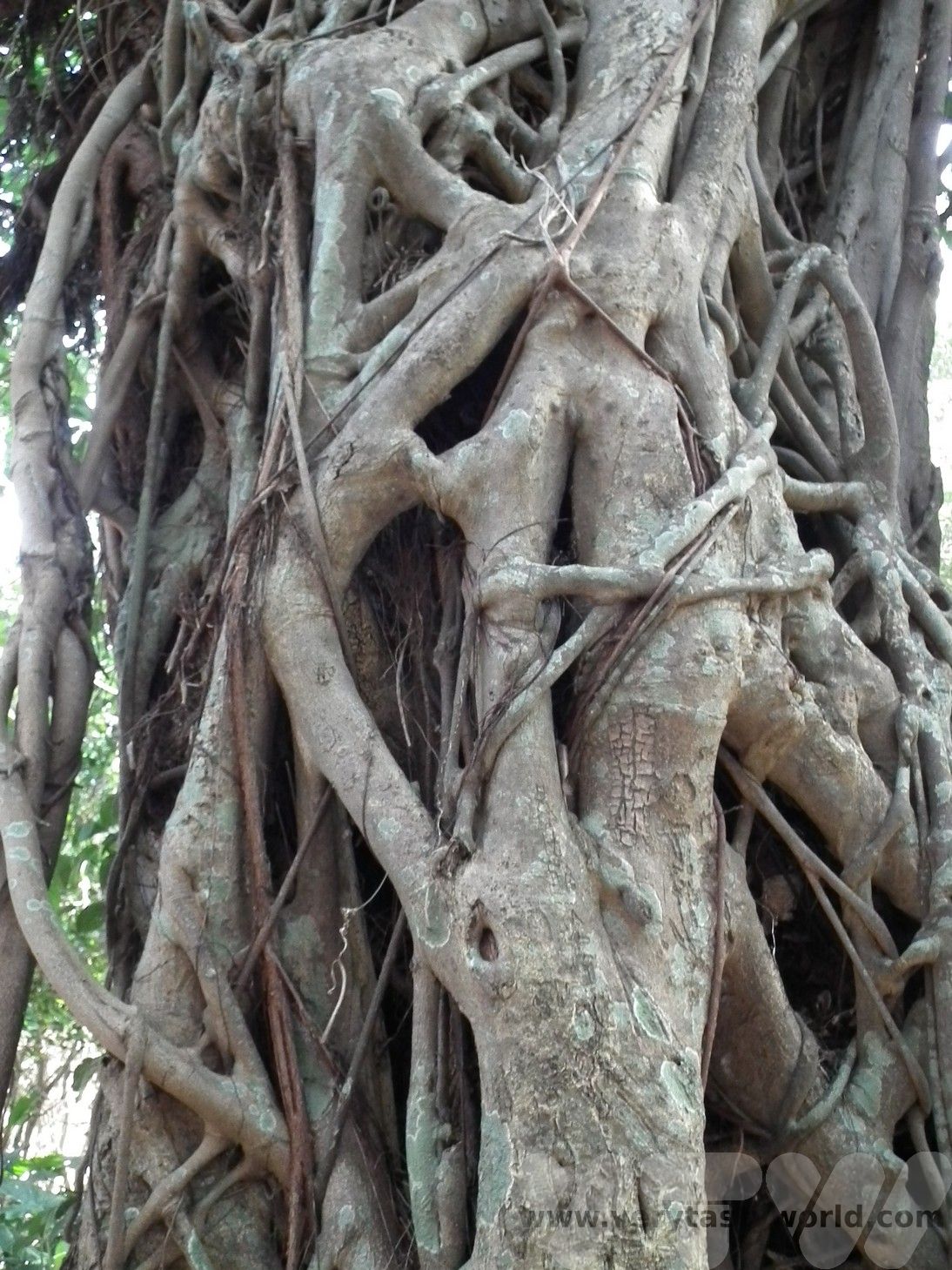
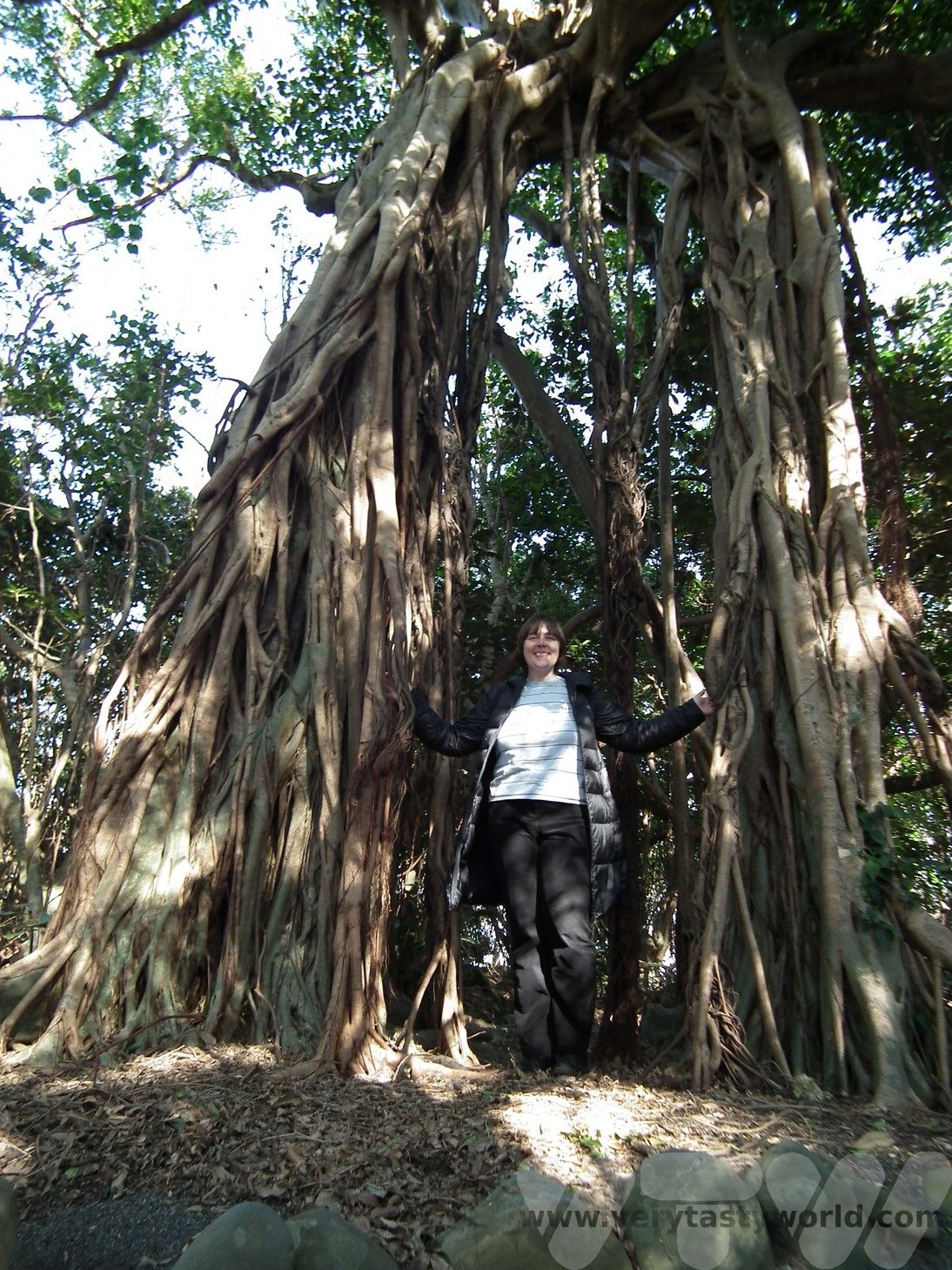
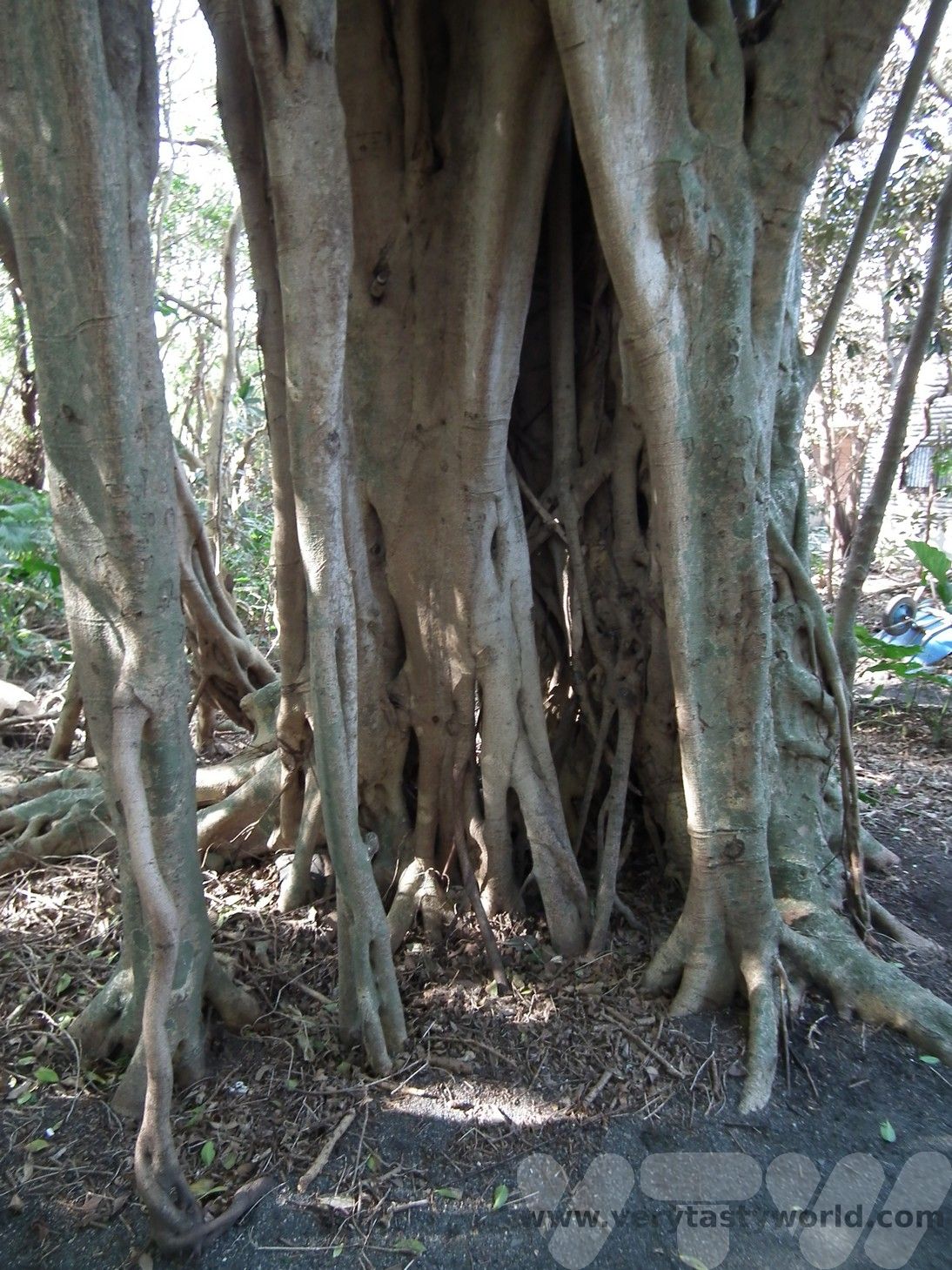
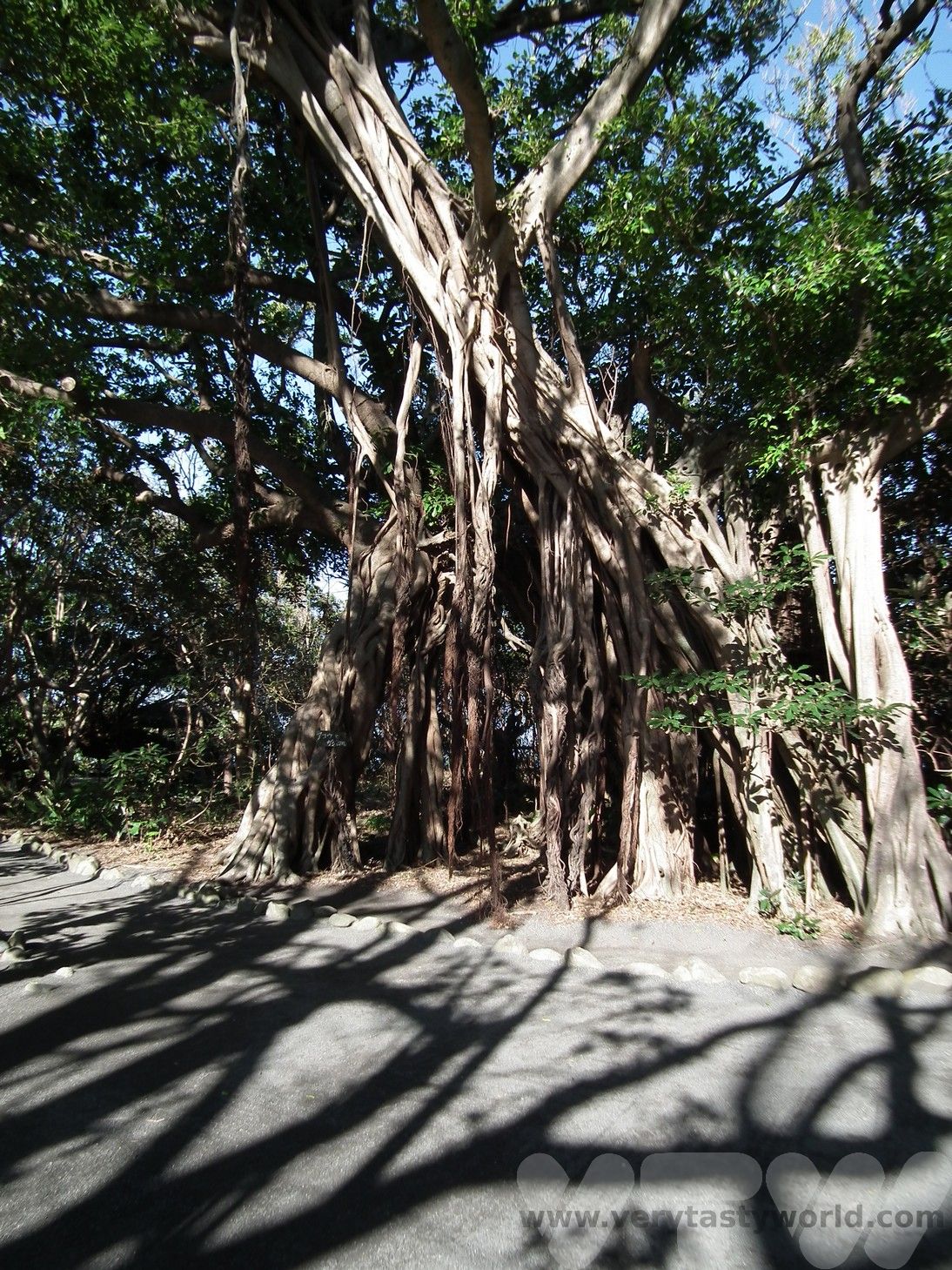
Isso Beach and Isso lighthouse on the peninsular.
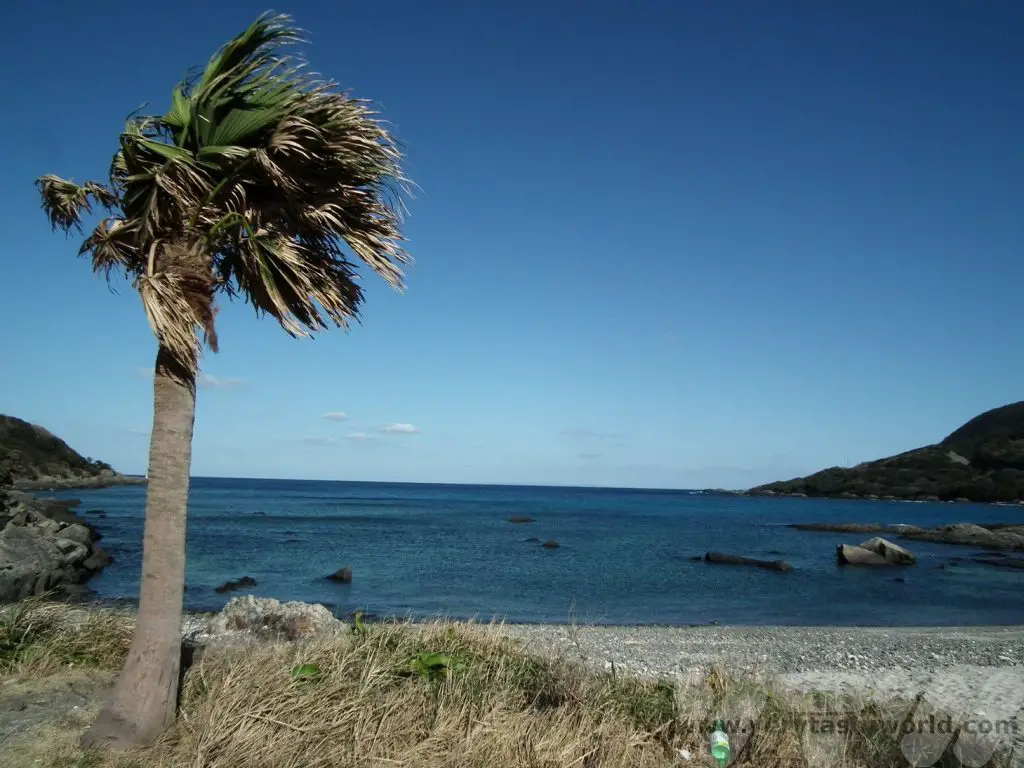
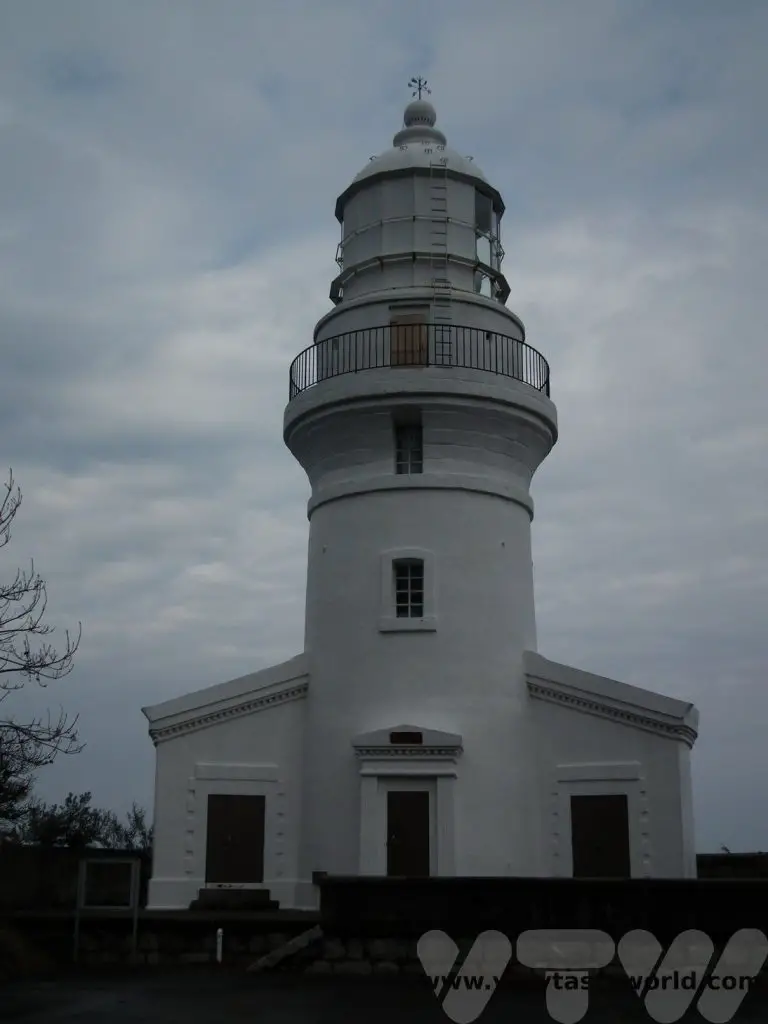
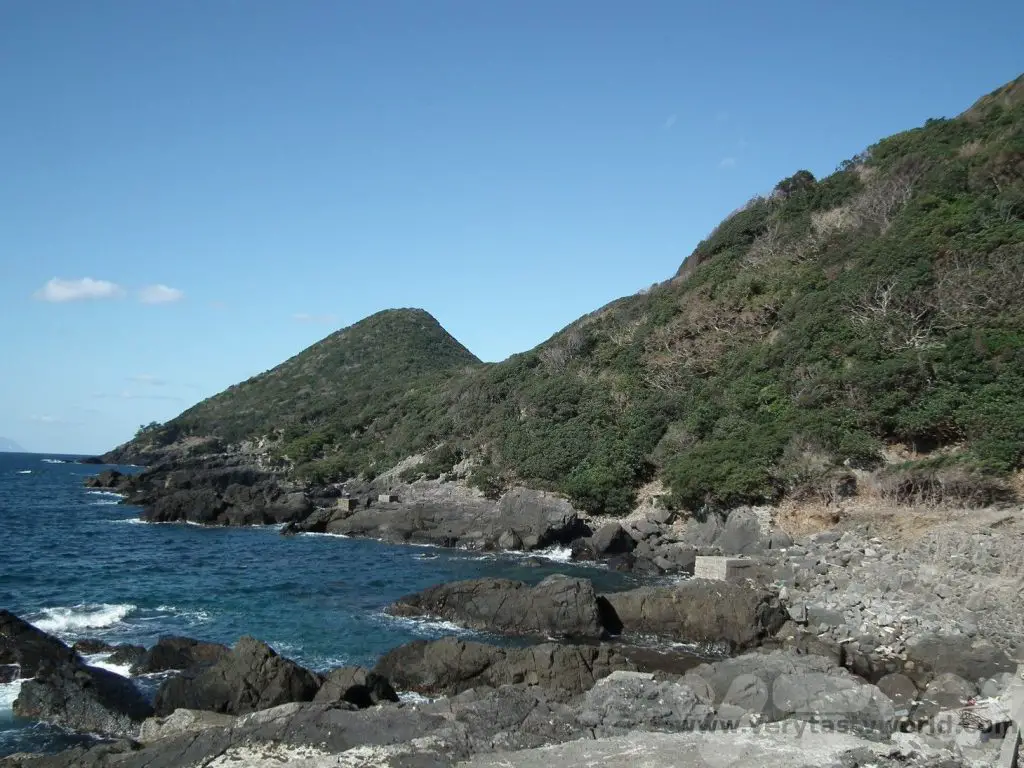
Swimming is only possible on the beach in the summer months when lifeguards are available. Also, turtles nest here during May and June, so care must be taken so as not to disturb them.
Then it’s a beautiful drive through the Seibu Rindo Forest. The road can be narrow and very winding as it wends its way through the mountain forest.
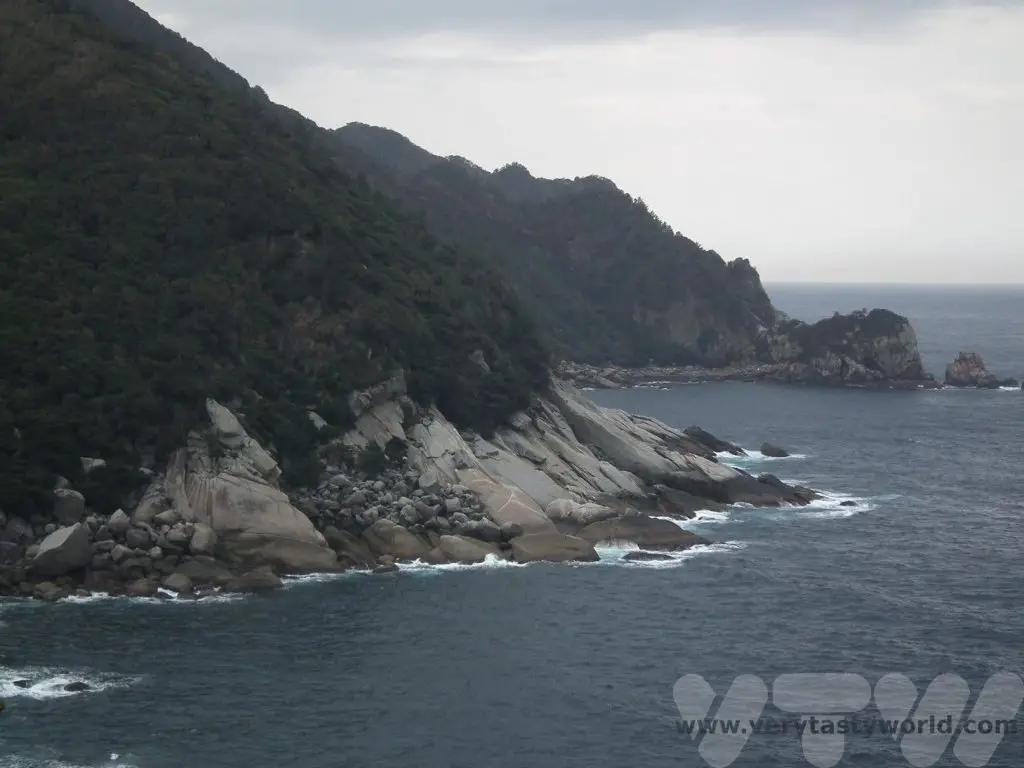
There’s an excellent chance of seeing Yakushika (native deer) and Yakuzaru (the Yakushima macaque) – and indeed we did.
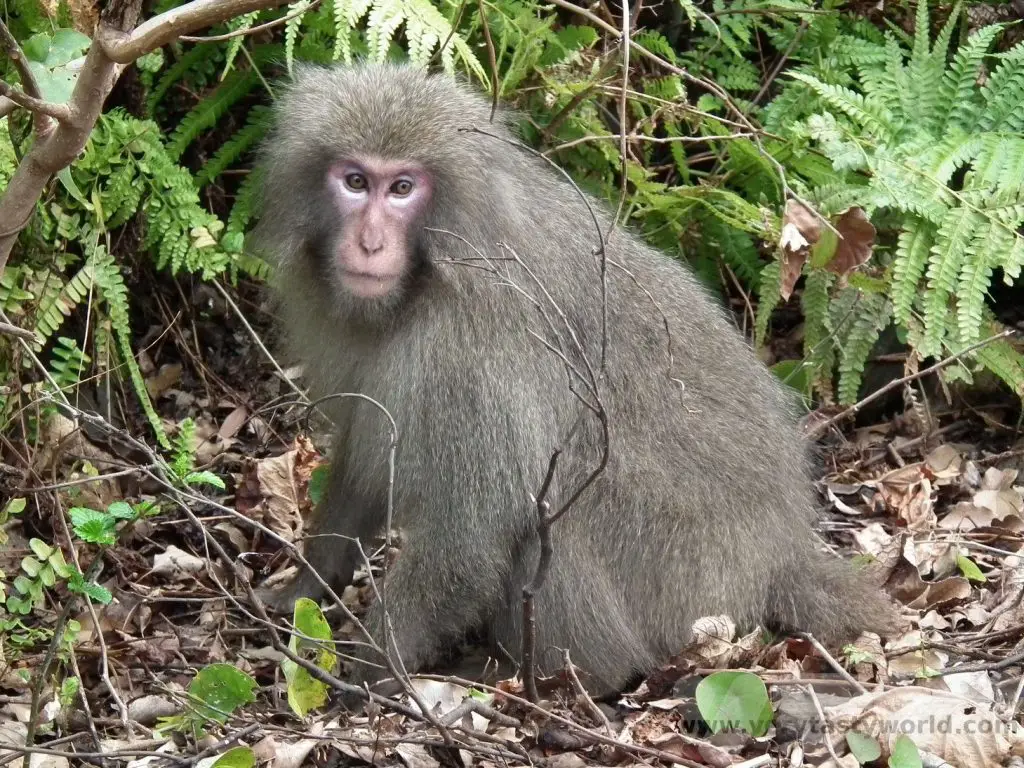
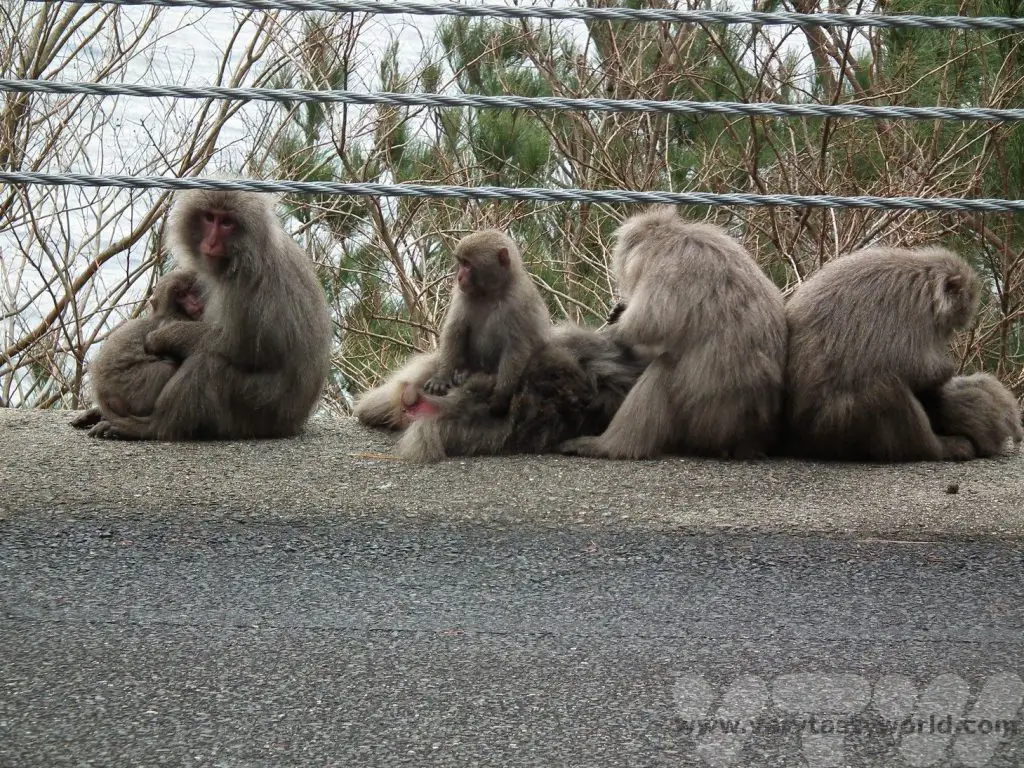
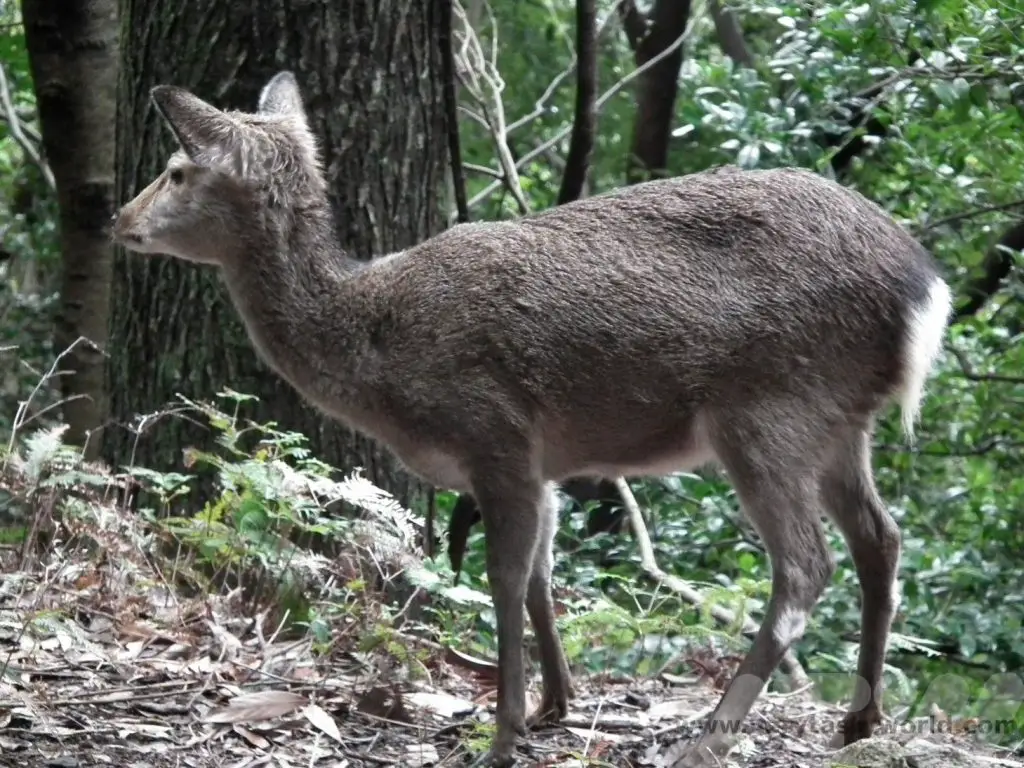
Yakushima has a number of waterfalls to explore. The falls are usually well signposted from the main road and there is usually a car park close by.
At 88m high, Ohko no Taki waterfall in the south west corner of Yakushima is one of Japan’s top 100 waterfalls. Sadly we didn’t have time to hike to the falls but even from a distance, it’s an impressive drop.
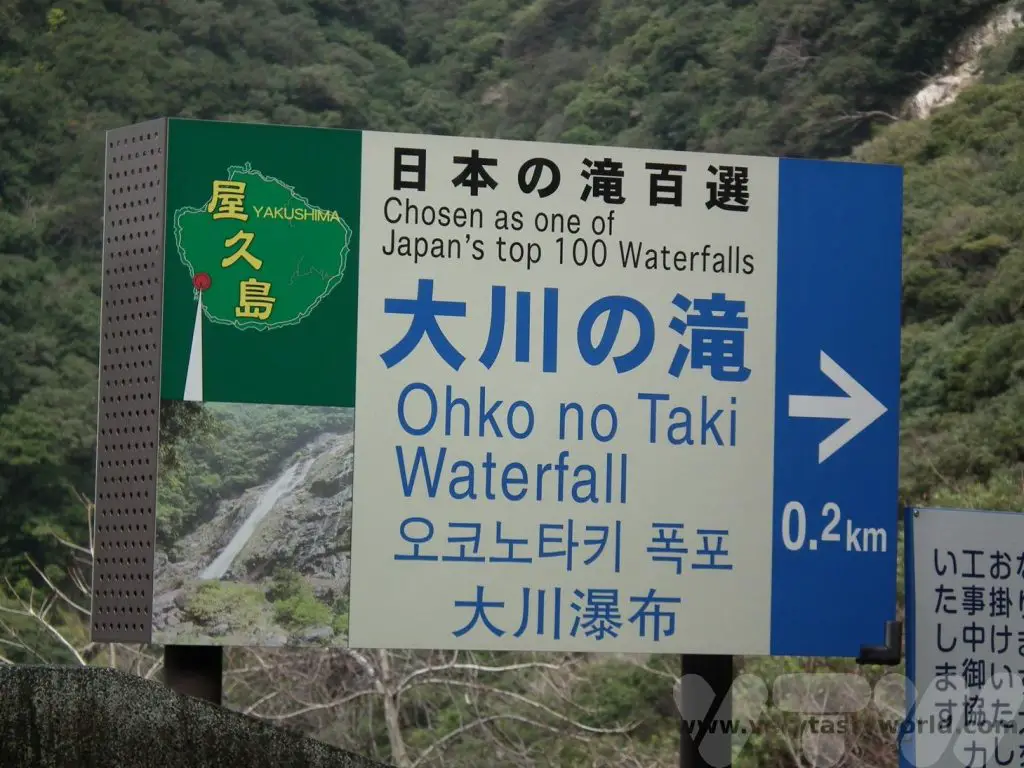
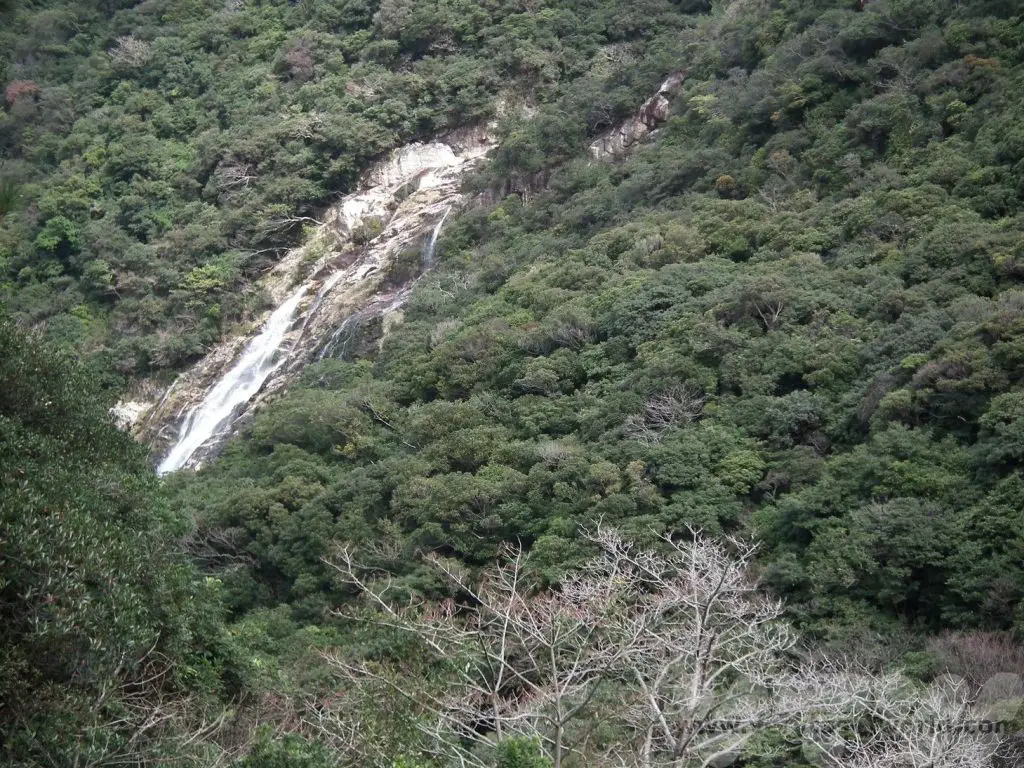
There are a number of outdoor onsen (hot springs) by the coast, which are worth a visit. Some of these are tidal, so are only accessible at low tide. There are a couple of neighbouring villages on the south cosast, Yudomari and Hirauchi, accessible by single track roads off the main circular route on Yakushima. It’s important to note that tattoos are something of a taboo in Japan as they are associated with gangsters, so is it worth covering any with sticking plaster. We enjoyed a warm footbath whilst looking out across the sea. (There are other onsen resorts at some hotels on the island if hot spring bathing is your thing.)
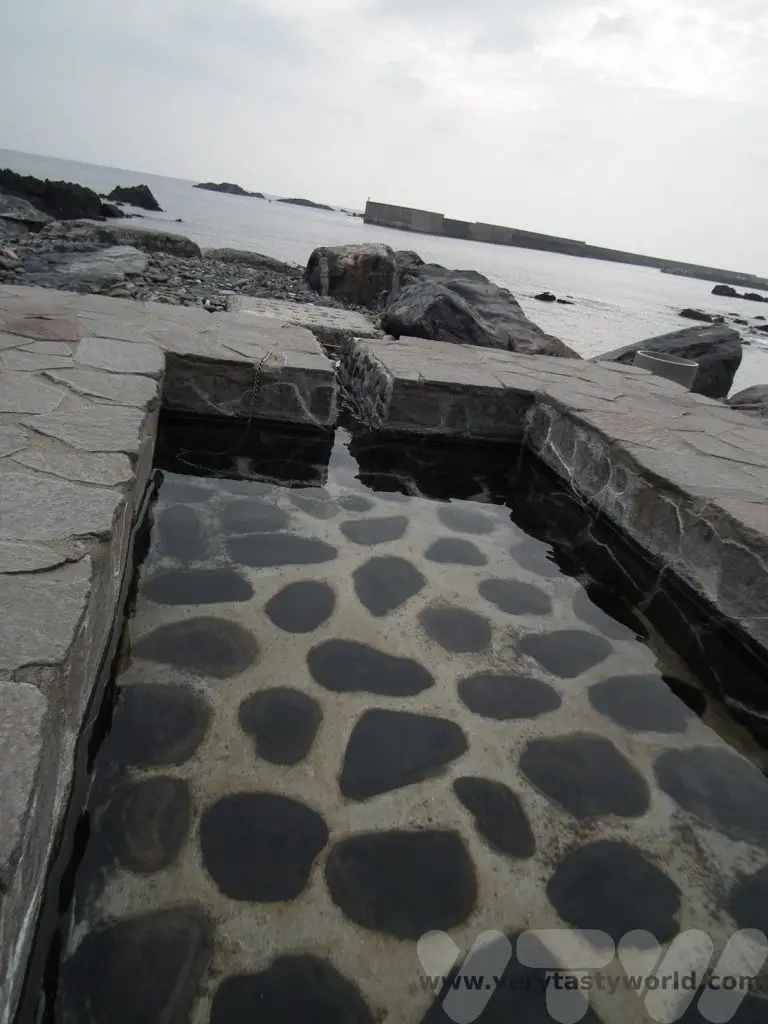
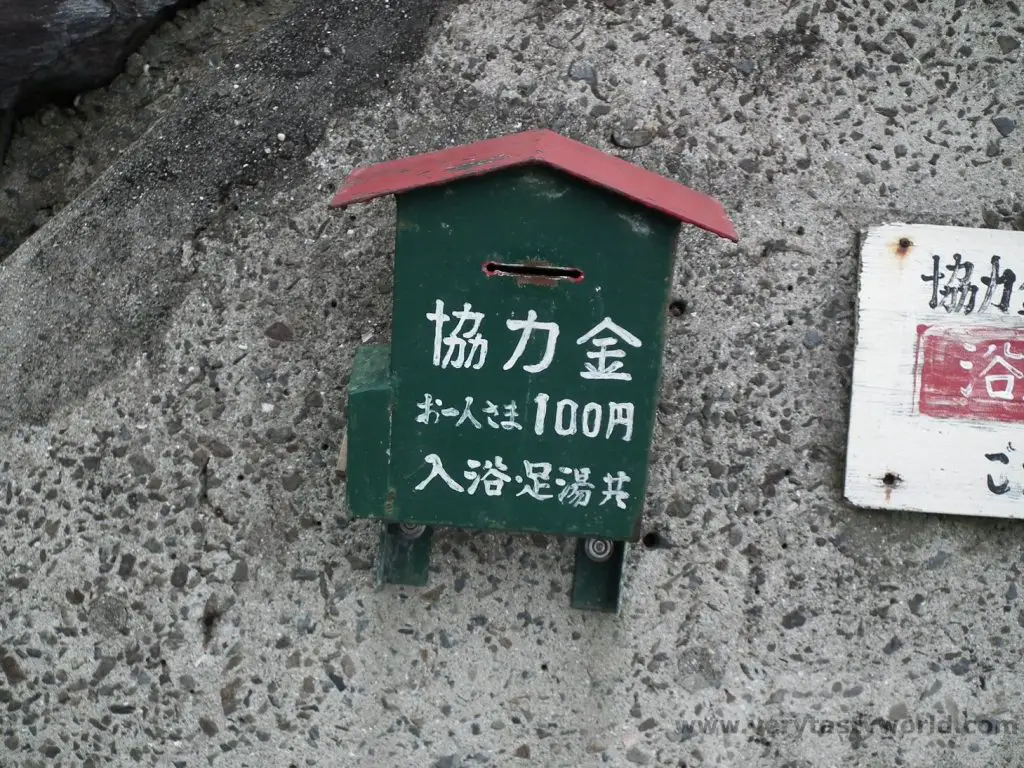
There’s an honesty box for payment (N.B. the price has increased to 200 yen since we visited).
Sempiro-no-taki is another impressive waterfall which falls across an extensive granite gorge.
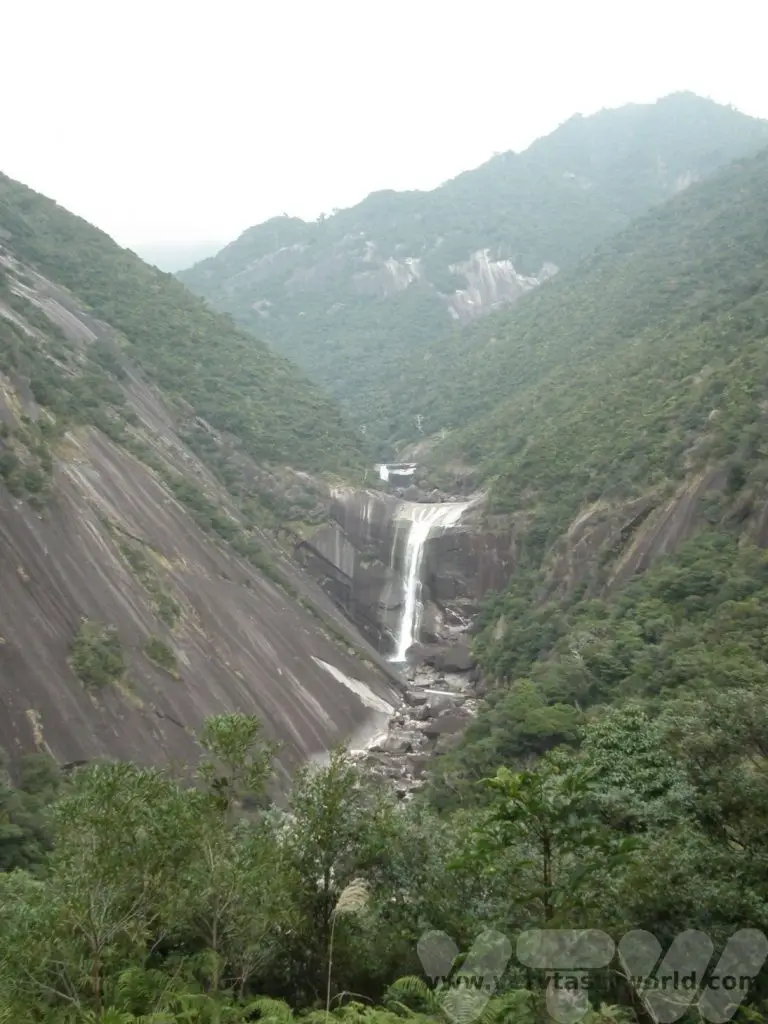
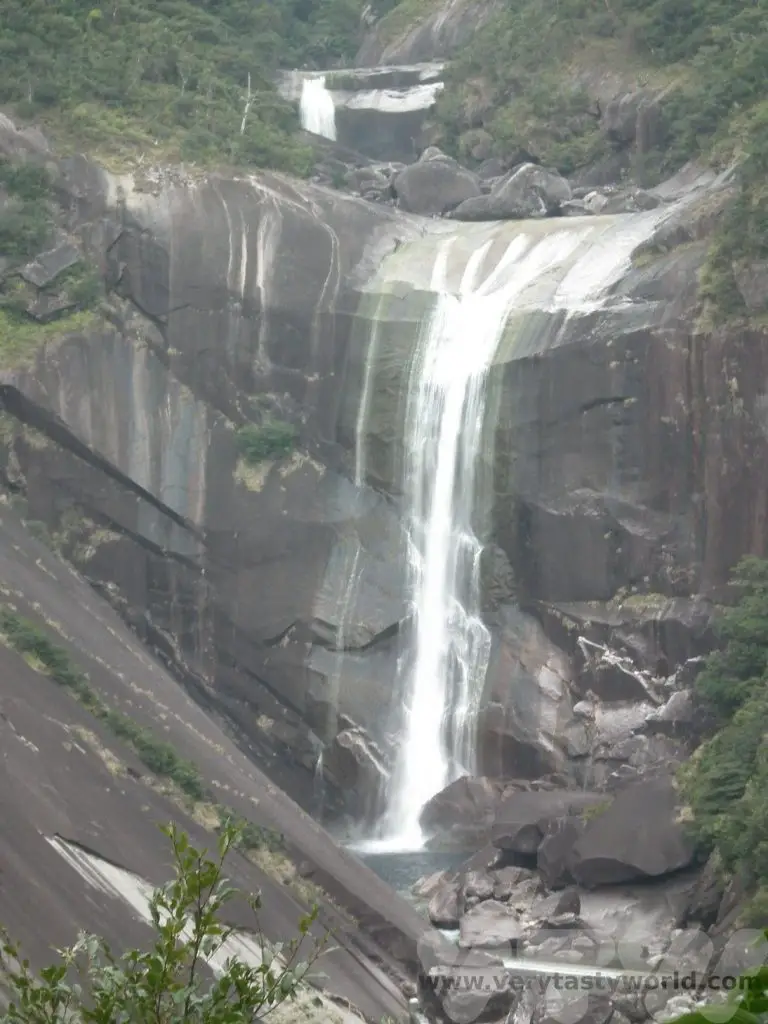
Toroki falls are just downriver from Sempiro and can be seen after walking a short distance from the road. You can see the vermillion bridge in the background.
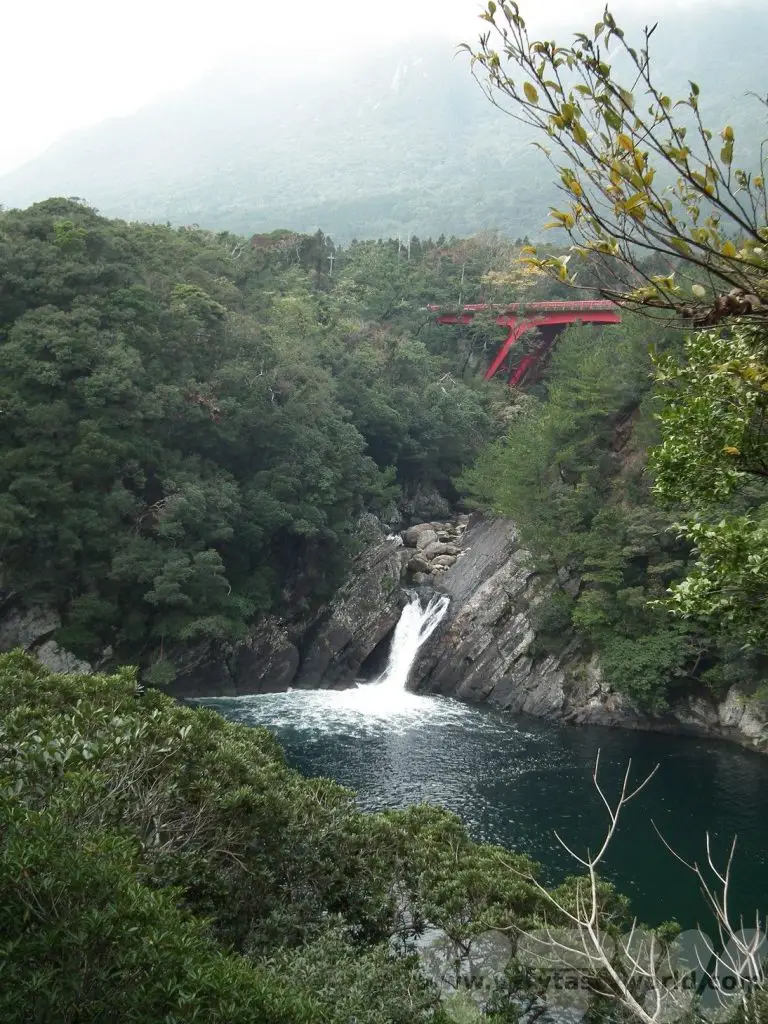
Then it was time to head north towards Anbo port. There was a convenient petrol station right by the turn off to the port’s car park so we filled up the car and experienced the best in Japanese service – a full tank of fuel, windscreen cleaned and, best of all, the attendants running out to the road to stop the traffic so that we could exit the petrol station. Then it was a hop onto the boat to return to Kagoshima.
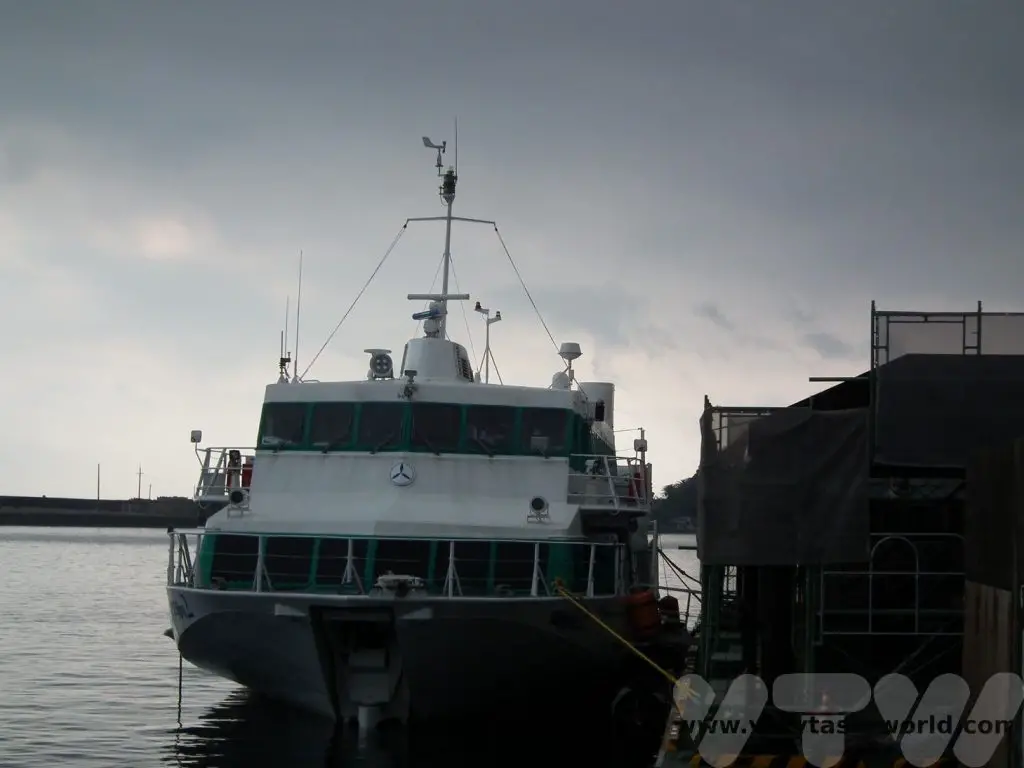
Yakushima is a destination that is off the beaten track but it is a beautiful island with plenty of walking, terrific food and delightful people. It’s a bit of a journey to get there but if you manage to visit you will not be disappointed.
Related Posts You May Enjoy

- Recipe: Simmered Shiitake Mushrooms

- How to Use Public Transport in Japan

- RECIPE Oyakodon Donburi

- Planning a Trip to Japan

- The Makanai: Cooking for the Maiko House

- Setsubun Food – Bean Throwing Day

- The Gassho Farmhouses of Rural Japan

- Recipe: Japanese Simmered Pork Belly – Buta no Kakuni

- RECIPE: How to Make Umeboshi

Best Of Budapest in 2 Days
Budapest is a lively and cosmopolitan city with a fascinating history and loads of interesting sights to see. A city split in two, Budapest straddles the broad and serene Danube river – hilly Buda lies to the west and the flatter Pest is on the eastern side of the water. It’s a very beautiful city and its centre is ideal for walking around. Here’s how to enjoy the best of Budapest in 2 days.
Two Days in Budapest
A little bit of preparation: If you wish to visit the Hungarian Parliament building it is worth considering booking in advance. Check the official website to make sure that tours are available on the day you plan to visit. On the door tickets are available but may require some queuing.
And, a slightly unusual packing suggestion for a city break – don’t forget to bring a swimsuit if you want to bathe in the thermal baths.
Please note that this post contains affiliate links. If you decide to click and book a tour we will get a small commission, at no cost to you, which helps towards running this site.
Day 1 – Morning Historic Walking Tour
Budapest is an eminently walkable city, perfect for a walking tour. There are all sorts of options, from a general historic tour to a communism tour and even street art. Some are ostensibly free (although it is appropriate to tip the guide at the end) and others are pre-paid. All will propose a meeting place, usually a central square in the city.
From Pest to Buda
Our walk started at St. Stephen’s Basilica in Pest, which served as a meeting point. The basilica is named for St Stephen, the first king of Hungary. Apparently his right hand has been mummified is retained within the church. One of the tallest buildings in Budapest (along with the Parliament building), it has two bell towers. The southern tower houses the biggest bell in Hungary, a monster weighing 9 tonnes.
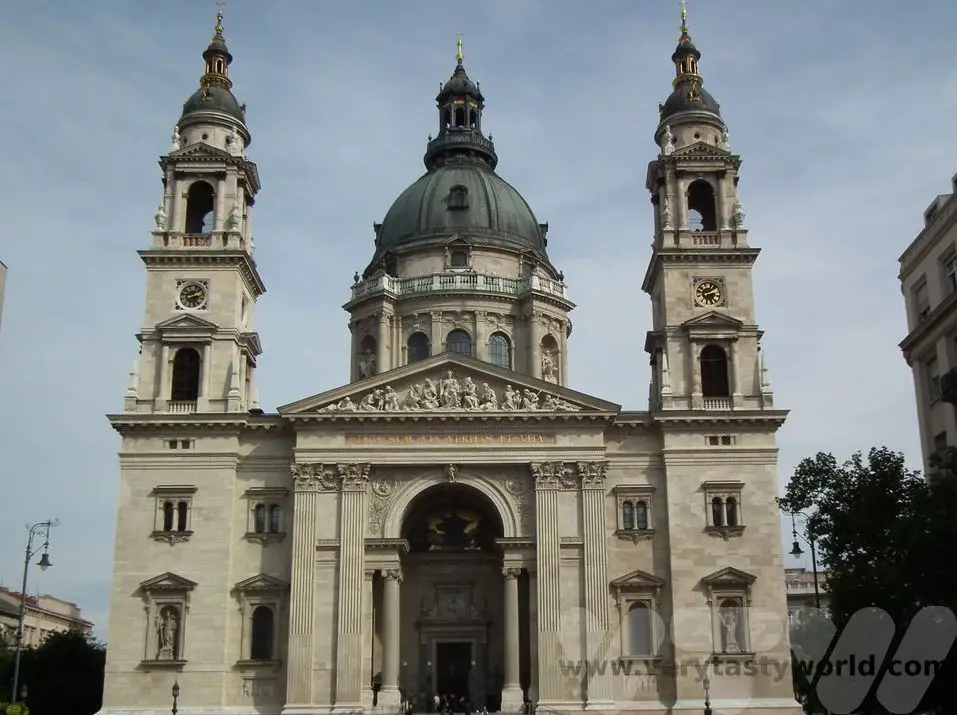
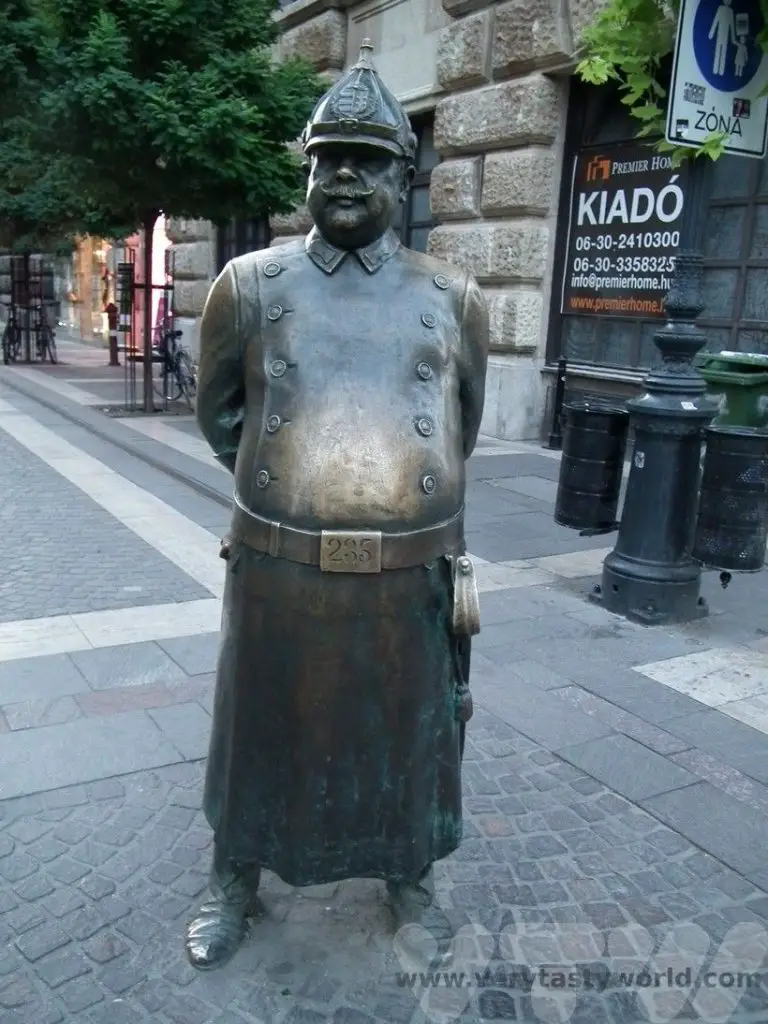
The walk took us towards the river and we passed the tubby policeman statue. Also known as Uncle Karl, there’s a legend that if you rub his portly belly you won’t get fat and can eat as much delicious Hungarian cuisine as you wish. Of course we didn’t believe it as we had already decided that we were going to enjoy as much food as possible anyway!
Although the walking tour starts in flat Pest, the majority of the time was spent in hilly Buda. We crossed the Chain Bridge, which spans the river Danube. Its formal name is the Széchenyi Chain Bridge and it was constructed in 1849, the first permanent bridge in the city and, at the time, considered to be an engineering marvel. Actually, it still is an engineering marvel.
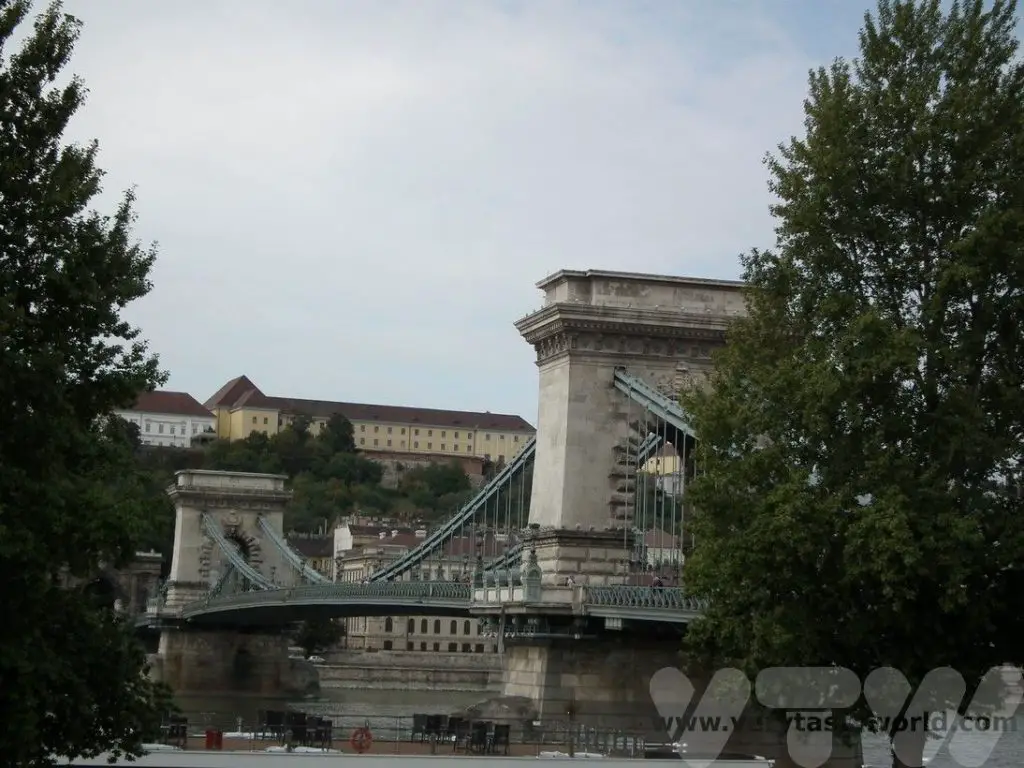
Then it’s a climb up the hill to visit some of the historic buildings located in Buda.
Royal Palace
King Bela IV decided to build his residence on Castle Hill in 1247 and completed it in 1265.Over the centuries subsequent kings expanded and developed the site, notably King Sigismund, a Holy Roman Emperor, who constructed it to become the largest palace of its time. King Matthias Corvinus also added a number of buildings.
However, like many of the city’s great buildings, the palace was badly damaged during the Ottoman era. It was reconstructed and added to over the centuries only to be destroyed during World War 2. It was rebuilt and modernised during the 1950s, with help from Polish architects, who had overseen the reconstruction of Warsaw. Some of the mediaeval parts of the castle were found and reconstructed to the best knowledge of the architects. It is a magnificent and extensive building.
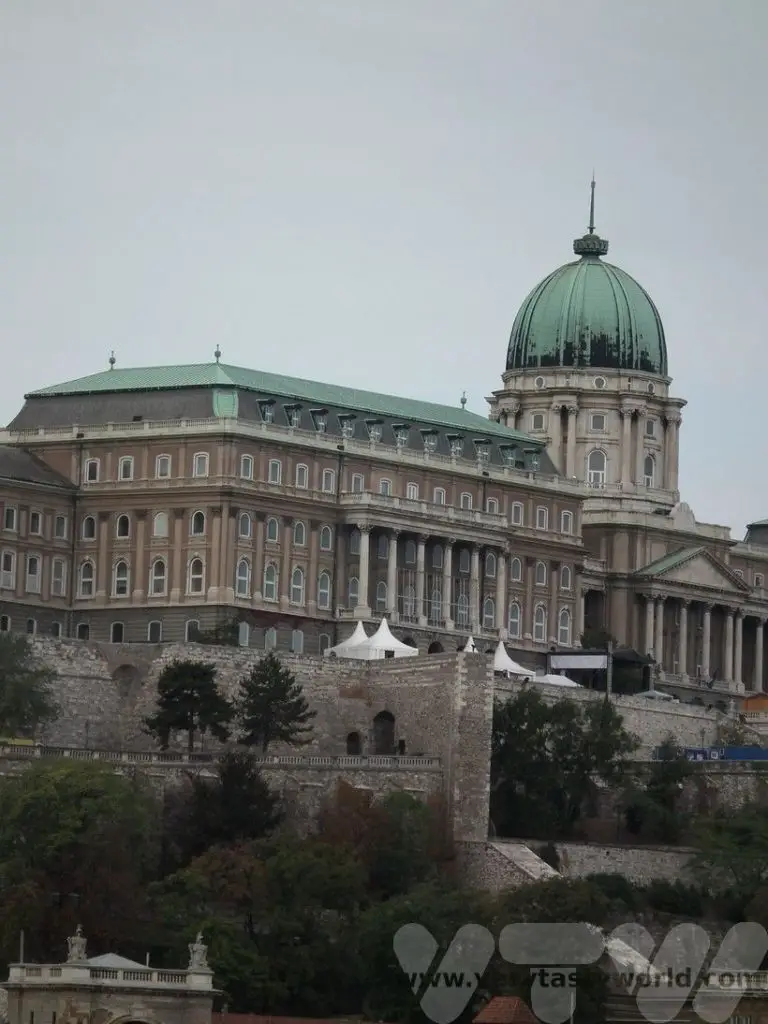
Matthias Church and Fisherman Bastion
A church with a long history that has reflected the fortunes of the city, Matthias church was founded as the Church of Mary in 1015 by Saint Stephen, the first Hungarian king. Of course, it was a much more basic structure then. It became a Roman Catholic church when King Bela IV moved the Hungarian royal residence to the hills of Buda in the 13th century and was further adapted in the 15th century by King Matthias Corvinus, who notably added the bell tower, named after him.
However in 1526 the city was invaded by the Ottomans who converted the building into a mosque and took many of its artefacts. The church was restored after liberation from the Turks, and redesigned to its present form in the 19th century. It is a truly beautiful building, a living church that has a central place in the community which offers many events throughout the year, including concerts featuring the Hungarian Virtuosi Chamber Orchestra.
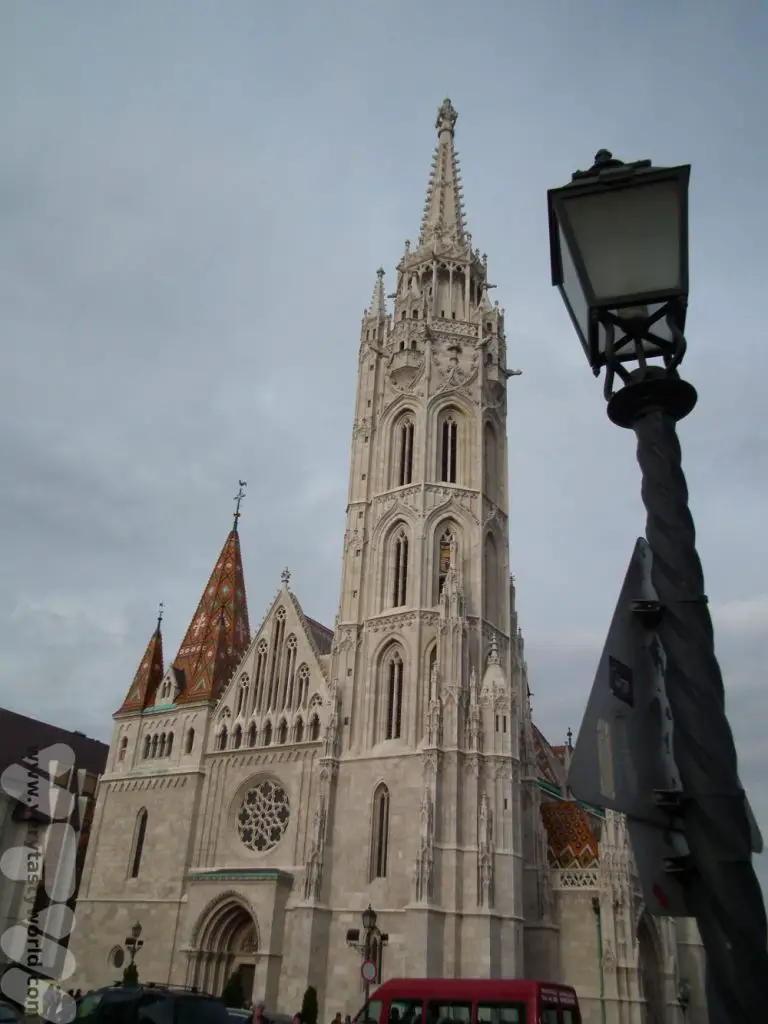
The origin of Fisherman Bastion’s name is that the guild of fishermen protected that section of the castle walls in the area known as Fishtown. Its main structure was built between 1895 and 1902 by Frigyes Schulek (who restored the Matthias church as well), another very beautiful building.
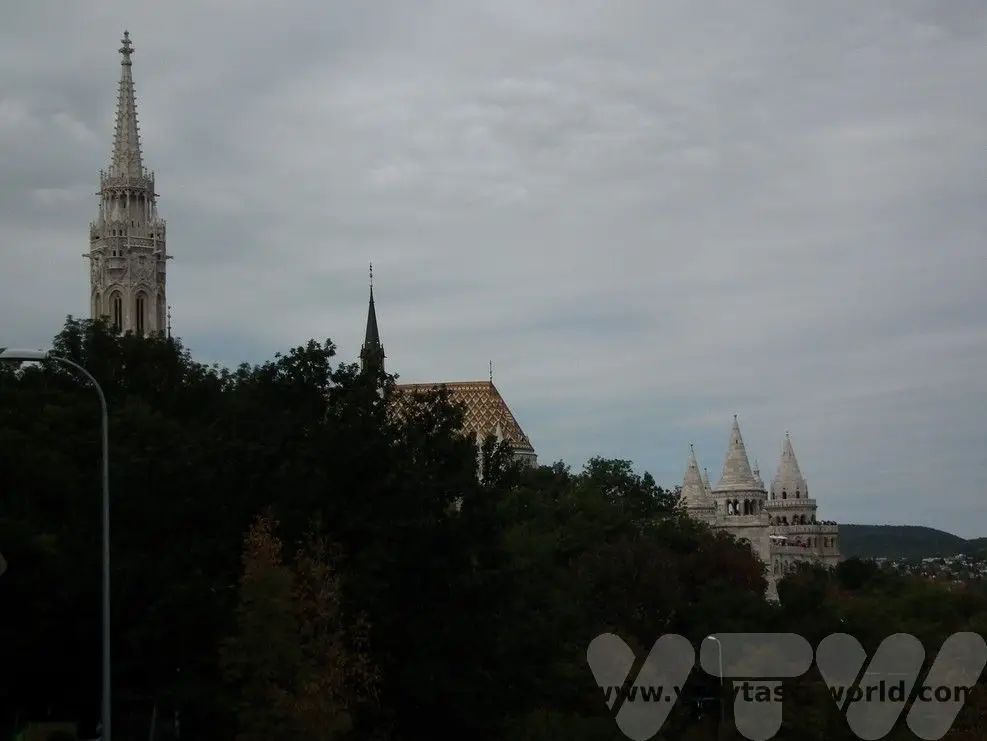
Fisherman’s Bastion affords some fantastic views over the Danube, especially to the Hungarian parliament building.
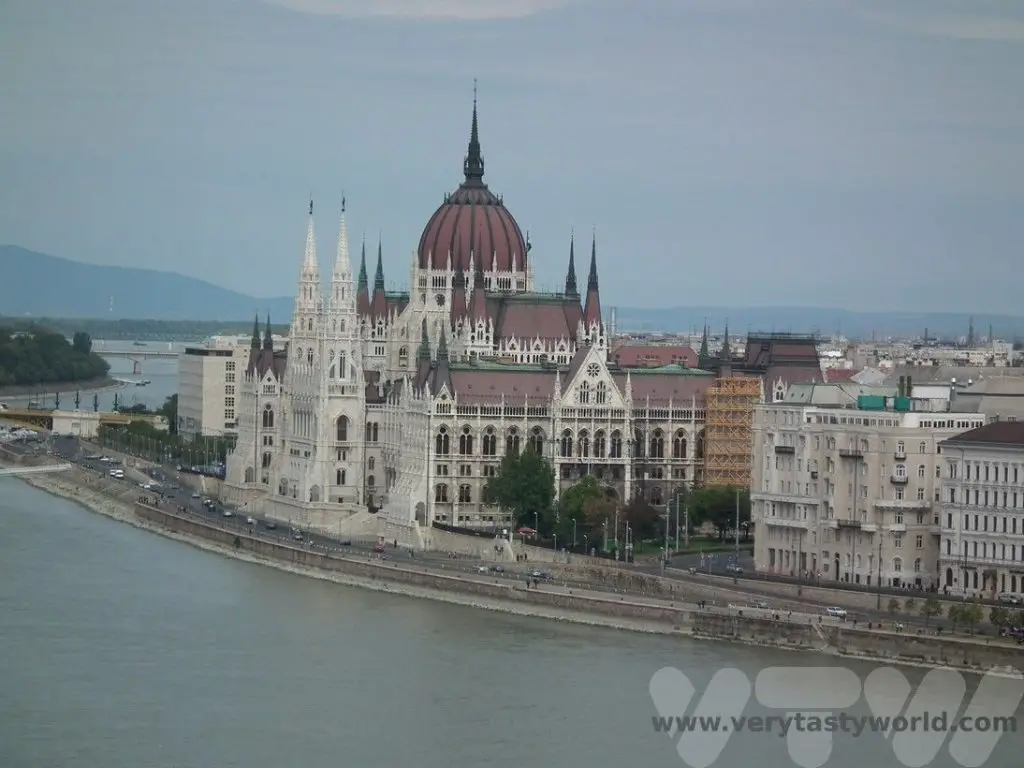
Day 1 – Afternoon
The walking tour introduces you to the key buildings but doesn’t take you inside, so you might want to hang around the area in the afternoon to explore Buda in more depth. The winding streets on Castle Hill are lovely to walk through. You can visit the castle building. Although you have to pay to visit the castle itself, the grounds are free to enter.
Sometimes there are food markets in the area. One of the essential street foods to try when visiting Hungary is Kürtoskalács. These spirals of delight, the name referencing a chimney due to its elongated shape, are a sweet dough wound around a cone, rolled in sugar and roasted over a spit. The sugar caramelises and you have a sweet, twisted pastry to eat. They are sometimes rolled in nuts or cinnamon for delicious variations.
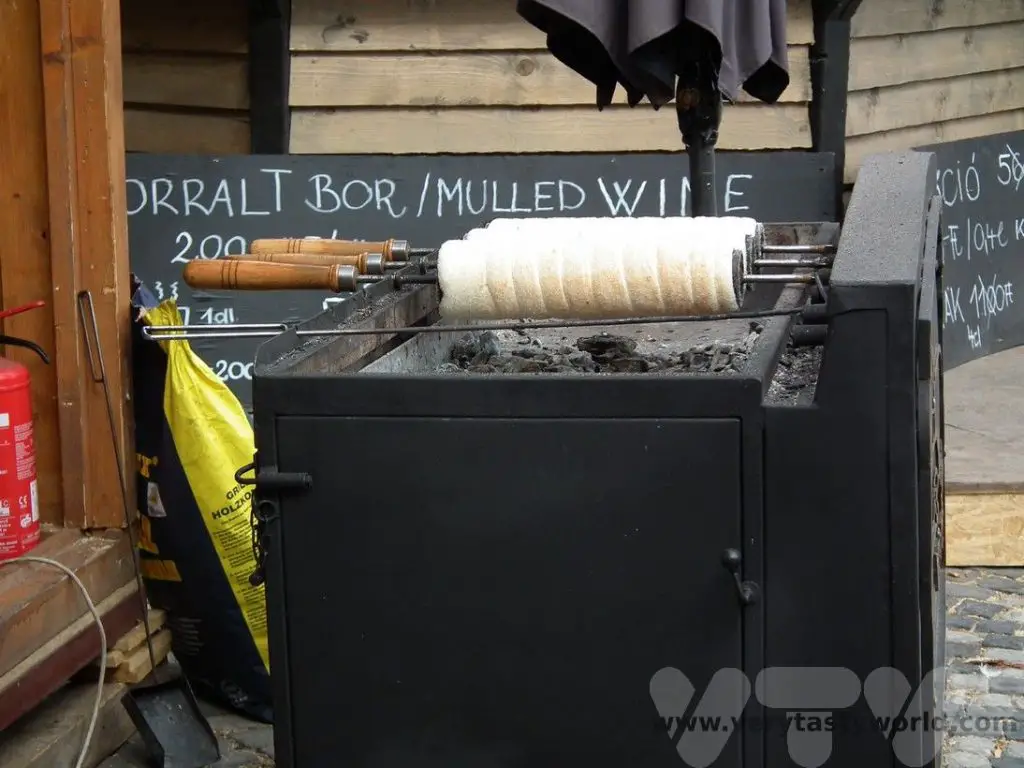
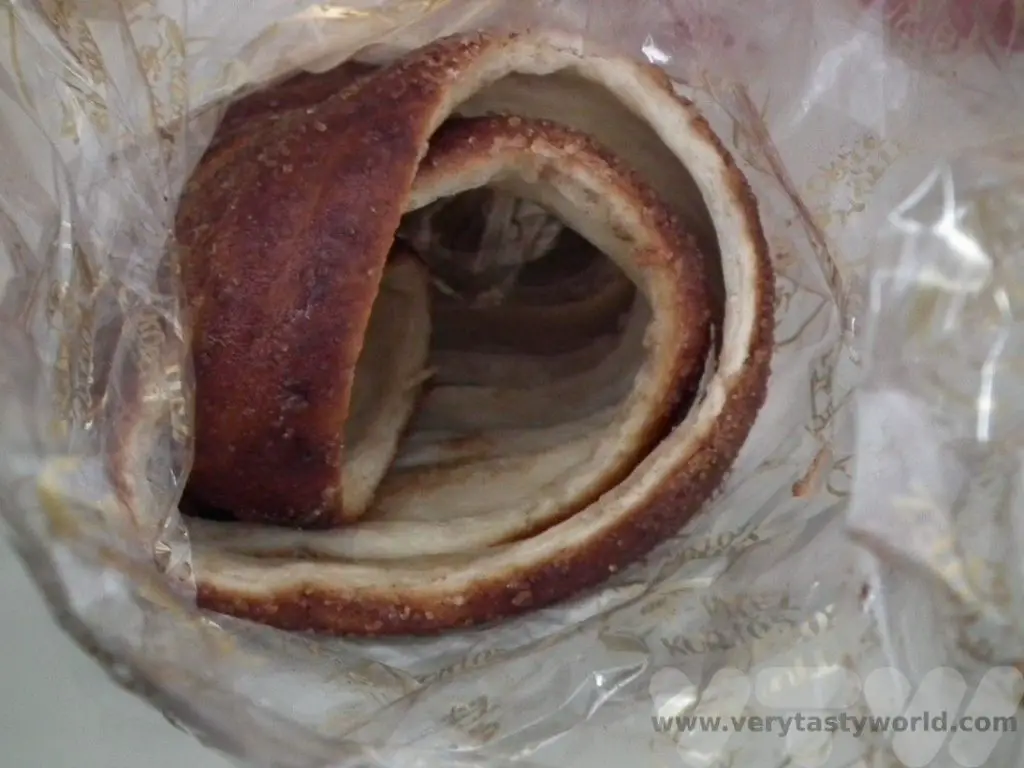
Visit Parliament Building
An alternative to spending time on Castle Hill is to visit the Hungarian Parliament. It’ll take around half an hour to walk there from the palace area. To British people this magnificent building looks very familiar. Hungary’s neo-Gothic parliament building was designed by Imre Steindl, who won a competition to design a building that represented the unity of the three cities – Buda, Pest and Obuda (now District III-Óbuda-Békásmegyer) – which joined together in 1873.
The architecture bears a strong resemblance to the British Houses of Parliament, London’s Palace of Westminster, because the Hungarian politicians of the time wanted to demonstrate a commitment to Western European political role models, notably Britain. (How times have changed!)
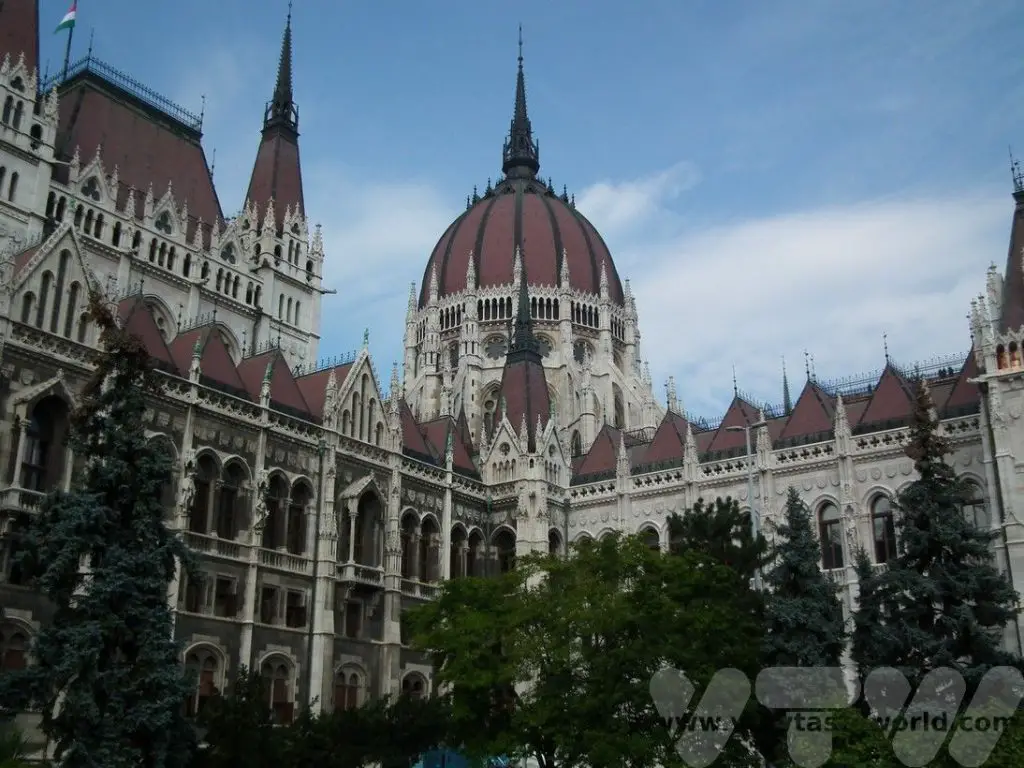
Guided tours are available but not on all days, so it’s worth checking – and booking – in advance.
Day 1 – Evening Boat Cruise on the Danube
It’s a very touristy thing to do but a boat trip along the Danube at night, with the bridges and buildings lit up, is a delightful way to spend the evening. There are lots of options from a simple boat trip to a full dinner service. We chose a drinks cruise because we wanted to enjoy the cityscape whilst enjoying a tipple and figured we might miss the best views if we were scoffing our dinner at the same time. It was perfect for us but there are all sorts of options to suit different budgets.
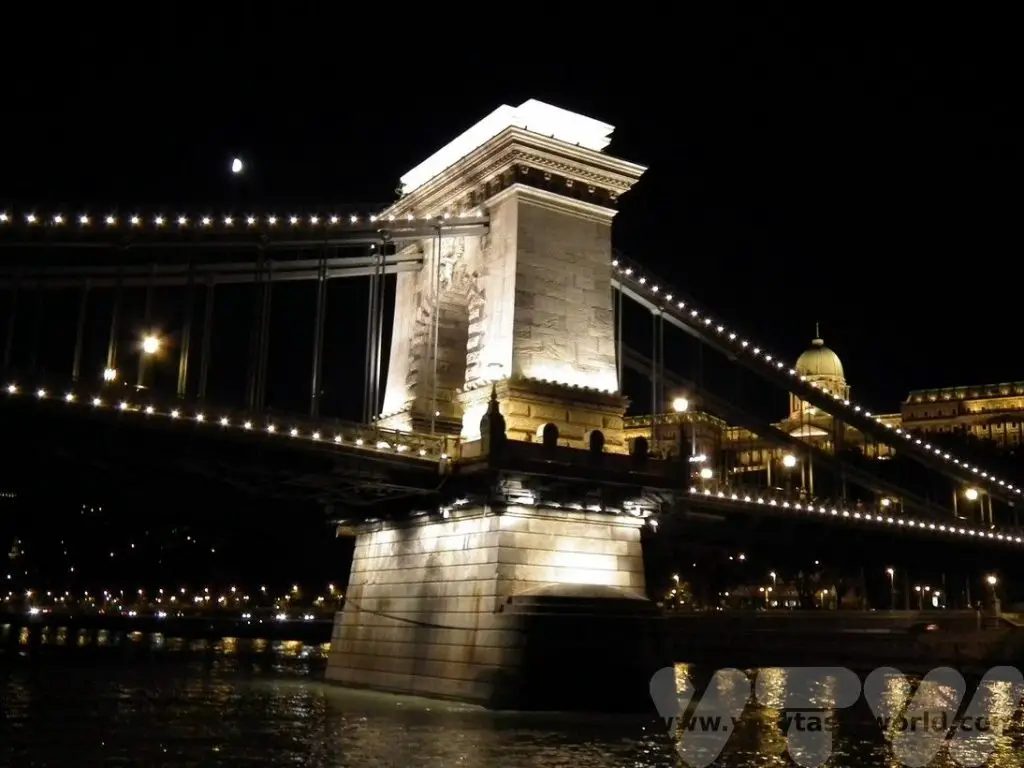
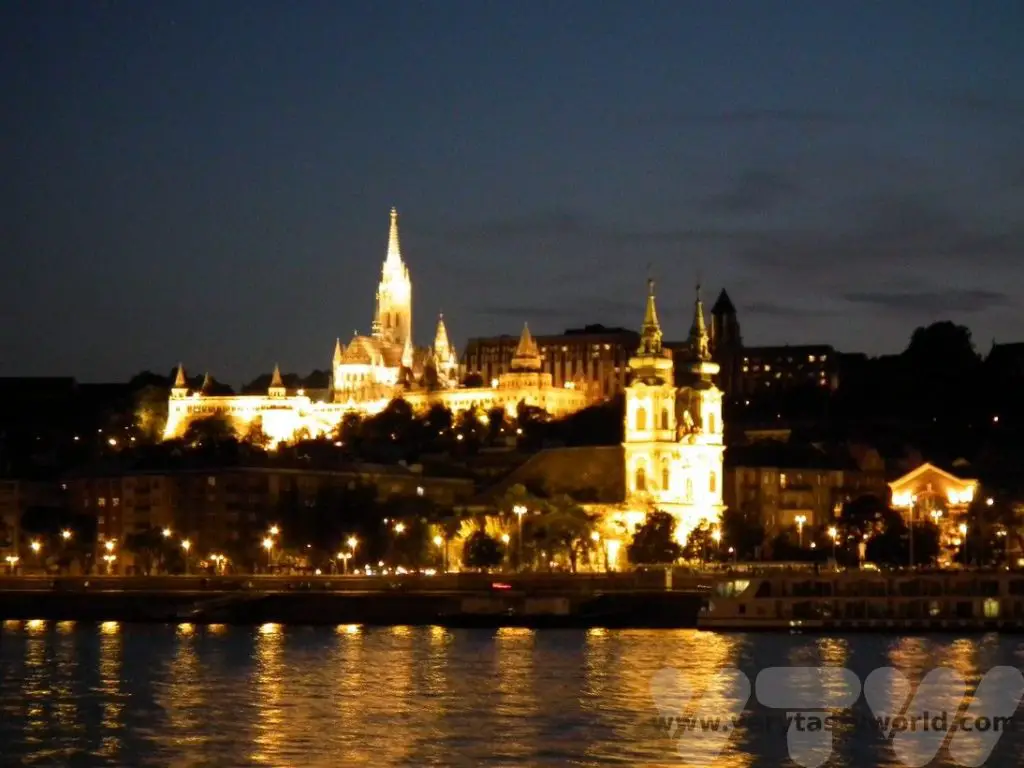
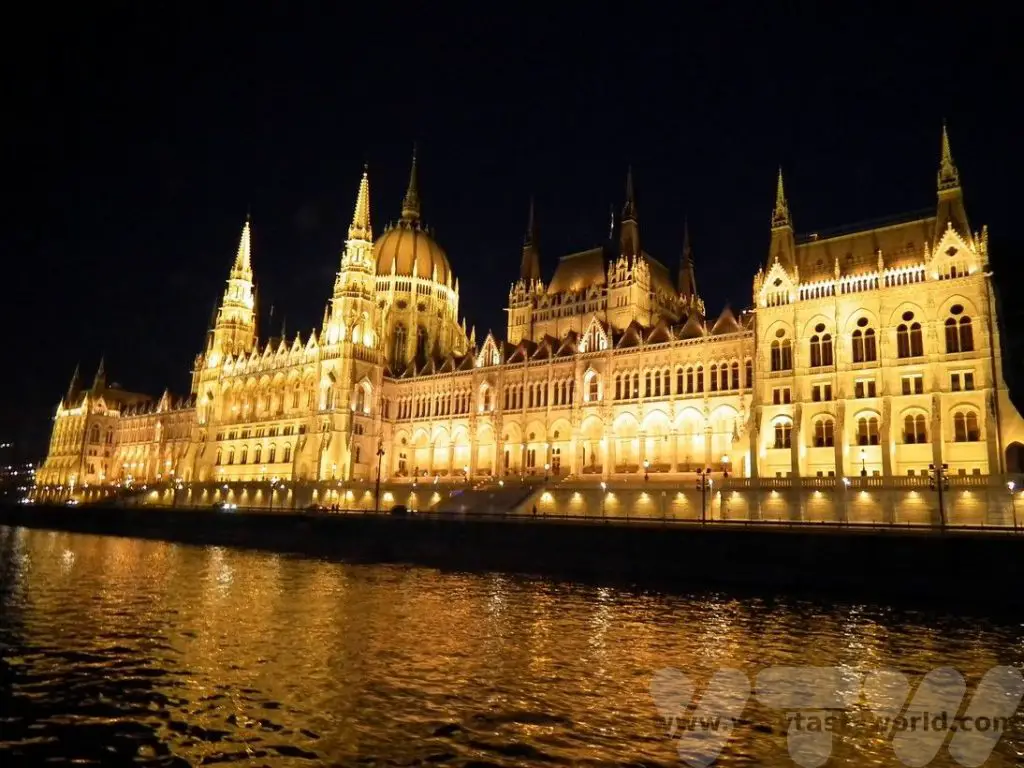
Day 2 – Morning
Explore Pest – A Communism Walking Tour
To complement the general city tour this was a genuinely fascinating insight into life under communism. Led by people who recalled their experiences, it was a good way to understand Budapest’s modern history through their personal stories as well learning as how communism influenced the city throughout its 20th Century history.
The country’s history of communism started in World War 2 when Hungary joined forces with Germany in 1940 and was involved with the invasion of the Soviet Union. By 1945 the Soviet army had defeated the invading armies and established themselves in Hungary, marking the start of communist rule. In 1956, a student demonstration escalated into a wider protest which was violently quashed by the communist leaders.
But it didn’t stop the protests and eventually the Soviet troops backed down, which led the people to believe that this might just be the start of a democratic process. However a few months later, the country was suddenly and unexpectedly invaded by a huge Soviet force who entered the city in tanks, killing many Hungarian people and destroying multiple buildings. Many of the people involved in the uprising were imprisoned and killed.
The main revolutionary leader was Imre Nagy, widely regarded as a hero who, although a communist politician himself, stood for a reformed form of communism. He was captured and executed in 1958. A memorial statue was erected in his honour. It was initially located near the Parliament building and depicted him standing on a bridge, looking to the building, a symbol of democracy. The picture below shows Imre Nagy’s statue in his original location but, due to political changes in recent times, it was removed in 2018 to a different location in the city – Jaszai Mari Square.
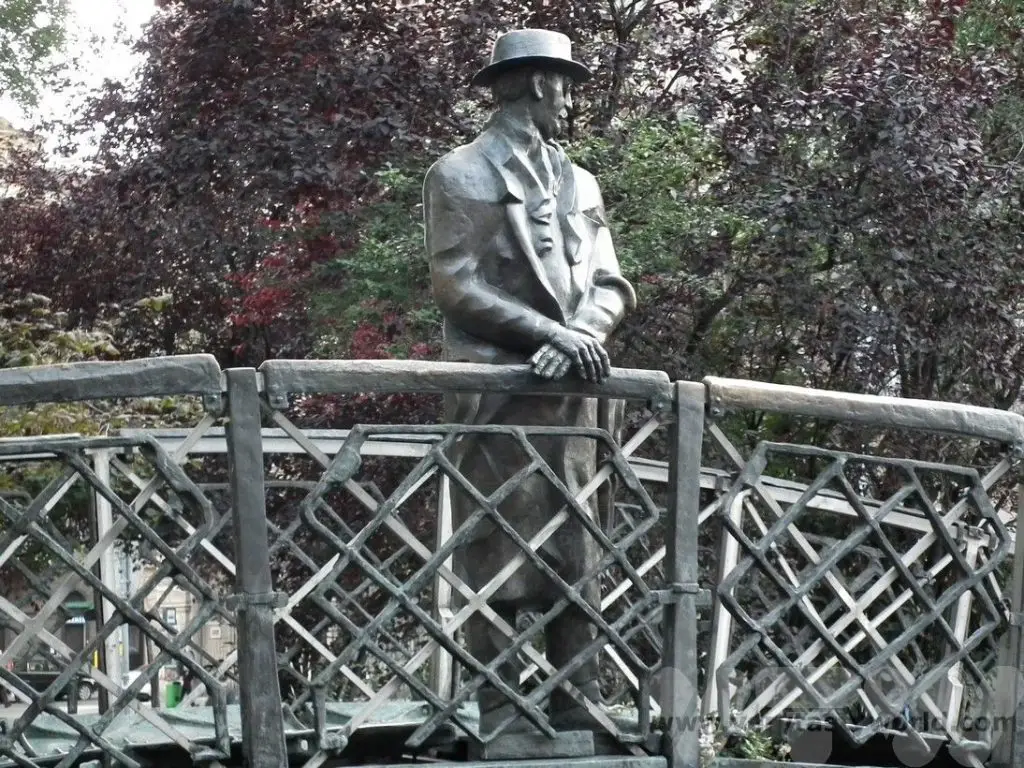
The tour was also really interesting from an architectural perspective. For example, take a look at the adjacent buildings in the photo below. The one on the left was built during the communist era – it is plain and functional, but importantly has seven stories of – somewhat cramped – building space compared with highly decorated and generous four stories of its neighbour, which was constructed over a century earlier.
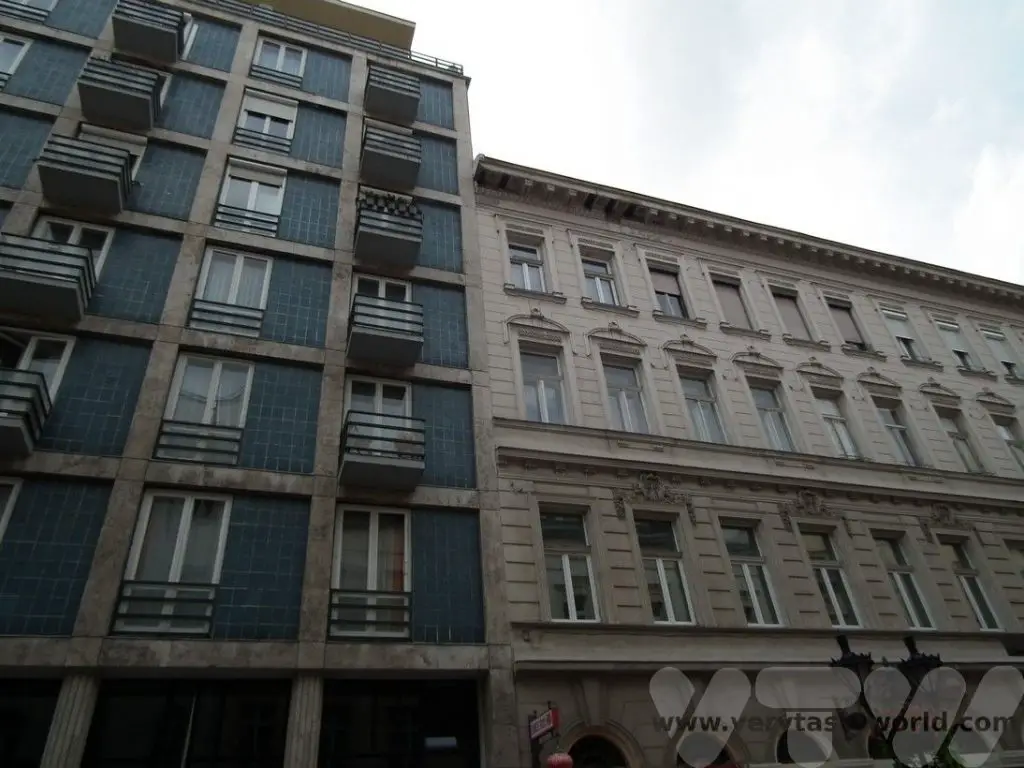
The Communist TV station, perfect for broadcasting all sorts of propaganda at the time, is housed in a magnificent building.
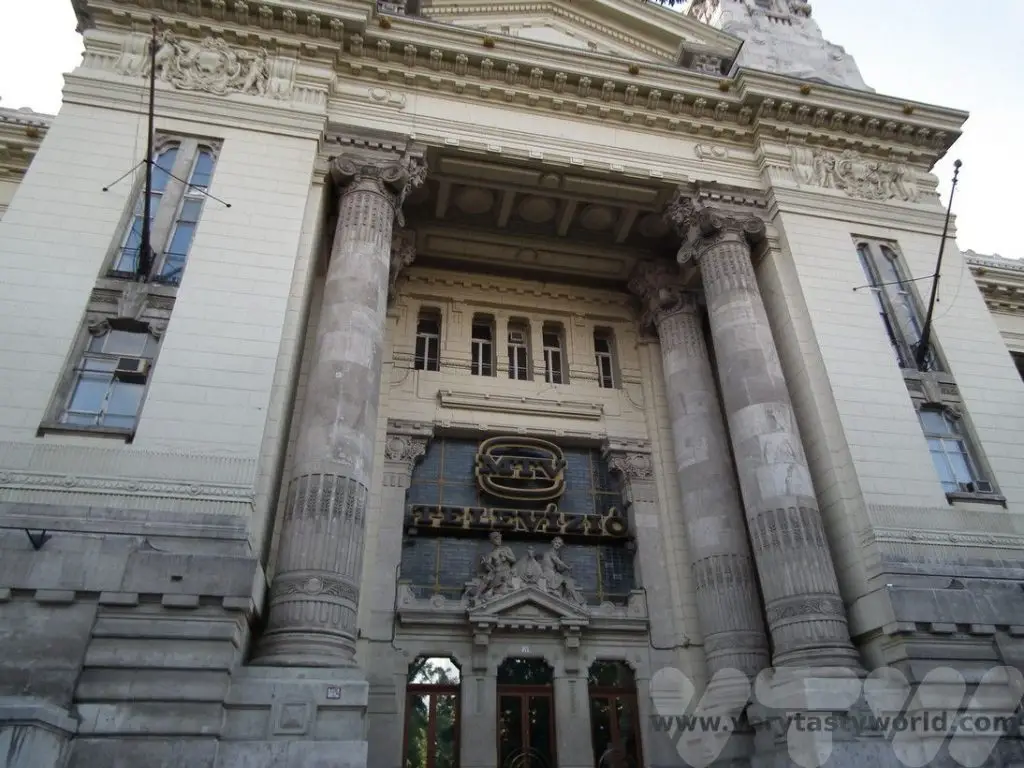
And if you need to see evidence of the number of conflicts, a large number of buildings still bear scars from multiple bullet holes.
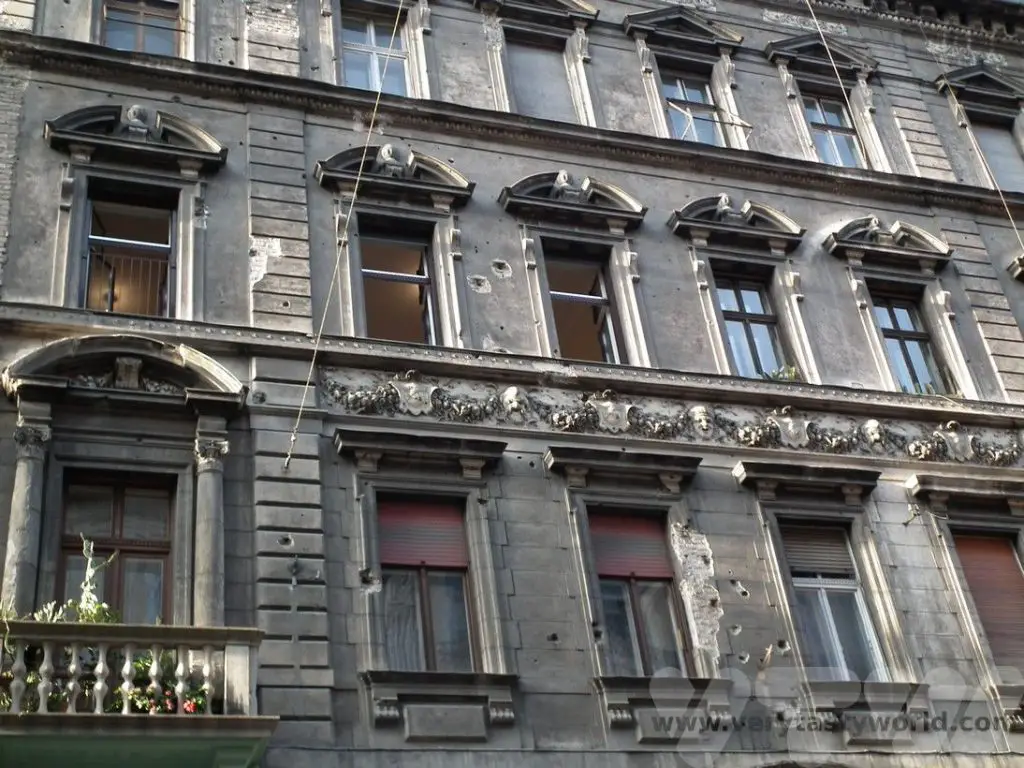
The whole tour was fascinating and particularly interesting because our guides could tell us about their personal lives under the regime.
Day 2 Afternoon
Franz Liszt Museum
Franz Liszt was Hungary’s most famous composer and a huge celebrity in his day – the phrase Lisztomania was coined to reflect the sheer frenzy of his adoring fans at his concerts. Housed in the building where he once lived, the compact Liszt Museum displays some of his music and personal possessions, as well as his piano. If you are interested in Liszt and classical music, it is worth stopping by.
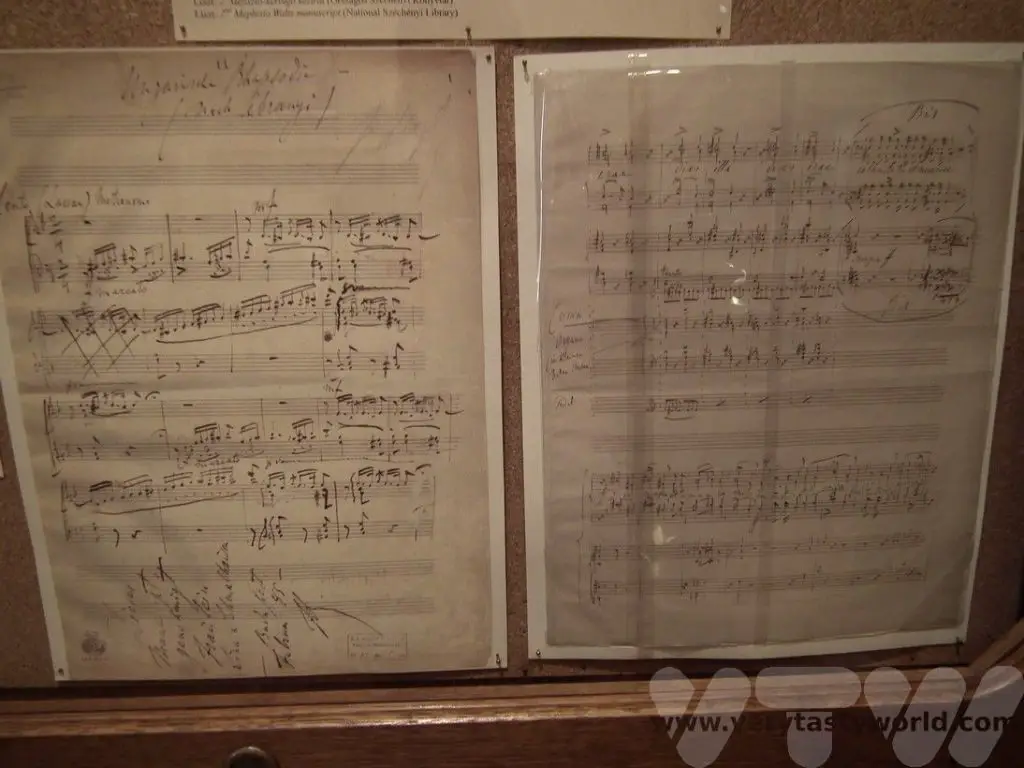
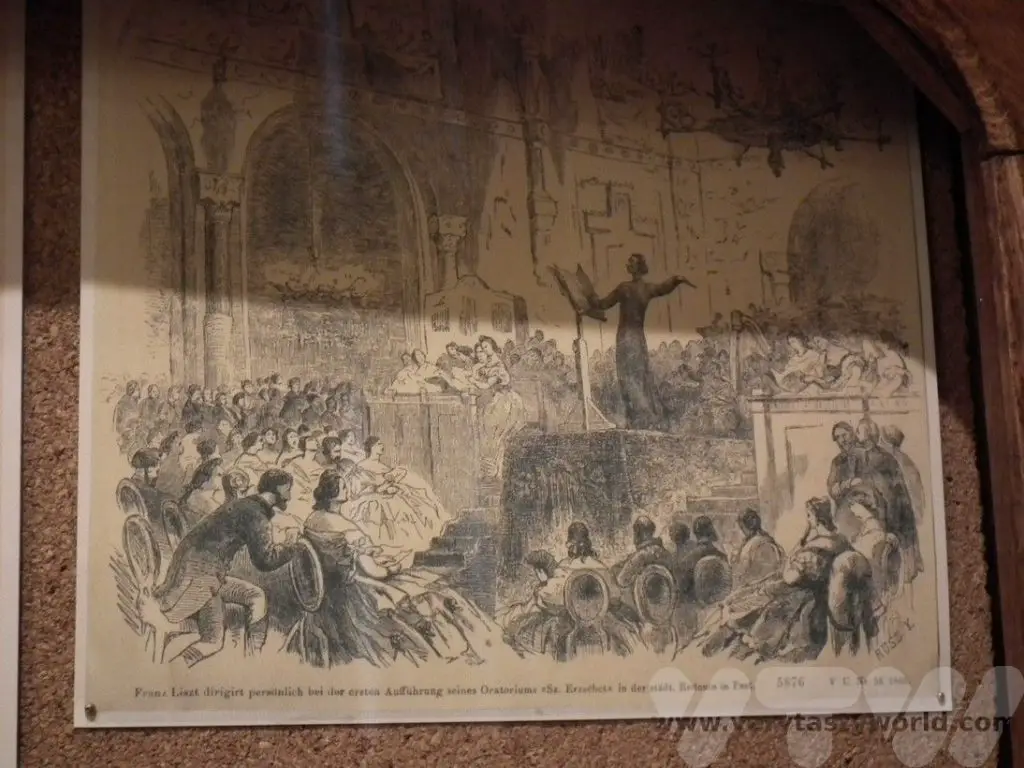
Heroes’ Square
Located on Andrássy Avenue, this is one of the city’s largest and most important squares, and features the Millennium Monument, which dates from 1896 and celebrates 1000 years of Hungarian conquest of the Carpathian Basin. It also has commemorative statues of the seven Magyar chieftains who led the Hungarian tribes when they arrived in the area in 895 CE.
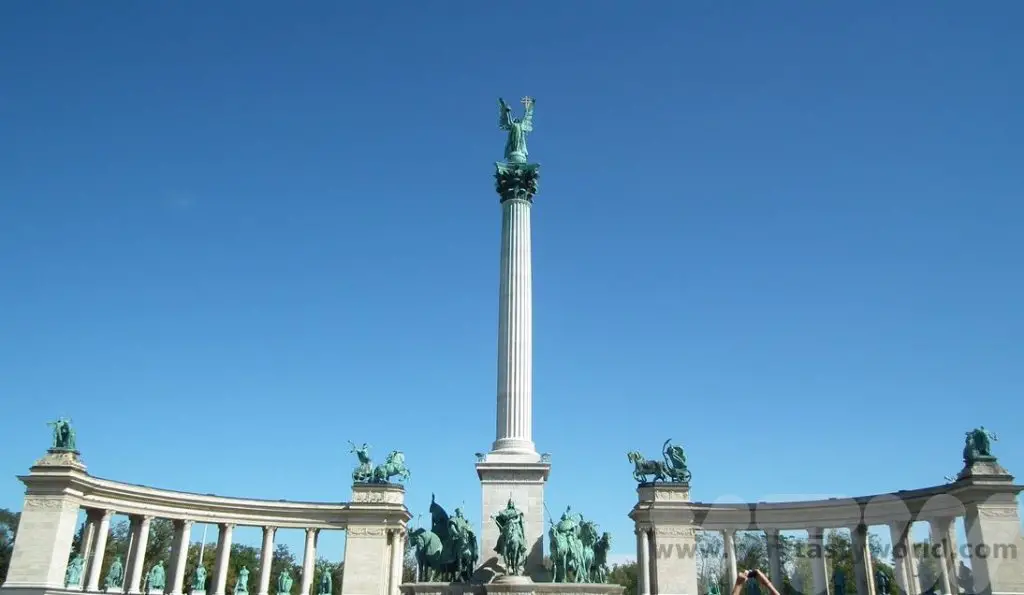
The Archangel Gabriel stands tall atop the central column, carrying the crown of St Stephen. Legend tells that Gabriel appeared to Stephen in a dream and bestowed the kingdom of Hungary upon him. The actual crown is kept in the Houses of Parliament.
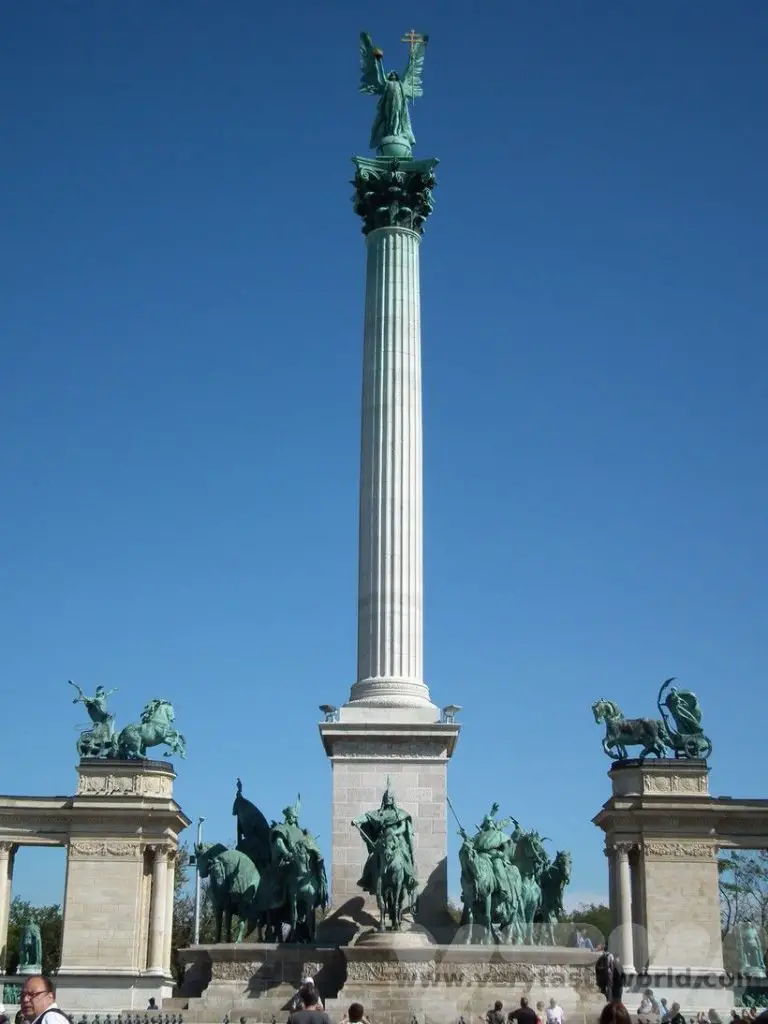
City park is located beyond the square and is one of the most popular green spaces in the area. It features some interesting architecture, including Vajdahunyad Castle, and is a nice place to relax.
The Museum of Fine Arts and the Palace of Art
Definitely worth a visit, these art galleries are located opposite each other on either side of Heroes’ square. The Museum of Fine Arts showcases permanent exhibitions from artists throughout the ages and includes works by some famous names. The Palace of Art, on the other hand, is a contemporary art gallery which doesn’t have a permanent collection but offers a variety of exhibitions of modern art.
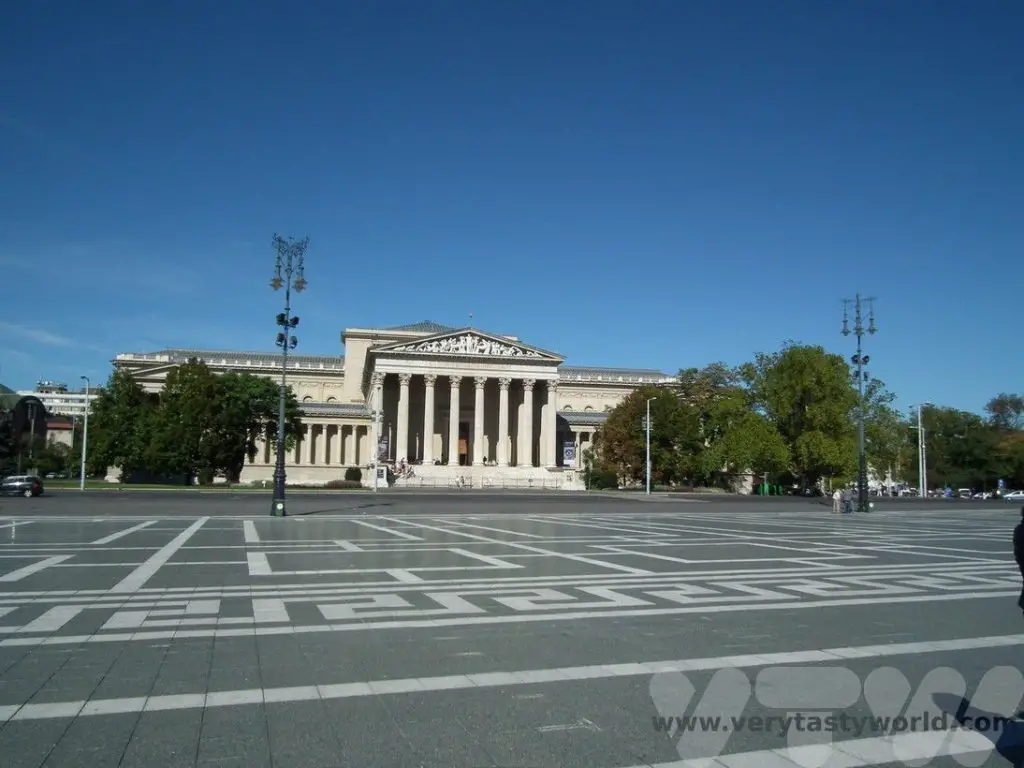
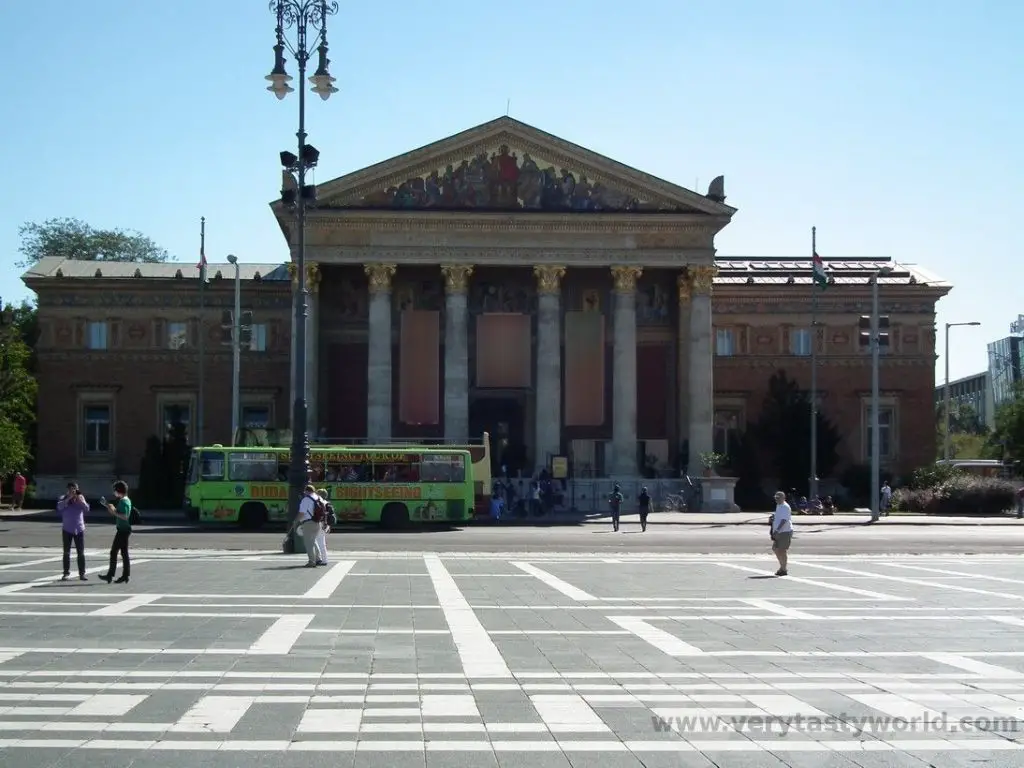
Visit Thermal Baths
Alternatively, if art isn’t your thing, the nearby Szechenyi Baths are one of the grandest thermal baths in Europe. Boasting fifteen indoor and three outdoor pools fed by two thermal springs, this is the perfect place to visit if you wish to enjoy some relaxing spa time.
Eating and Drinking in Budapest – From Grandiose to Grunge
Budapest has a huge variety of eating and drinking establishments.
We enjoyed a traditional Hungarian meal Paprika Vendeglo, a charming place with wooden décor and, as the name suggests, paprika hanging from the walls.
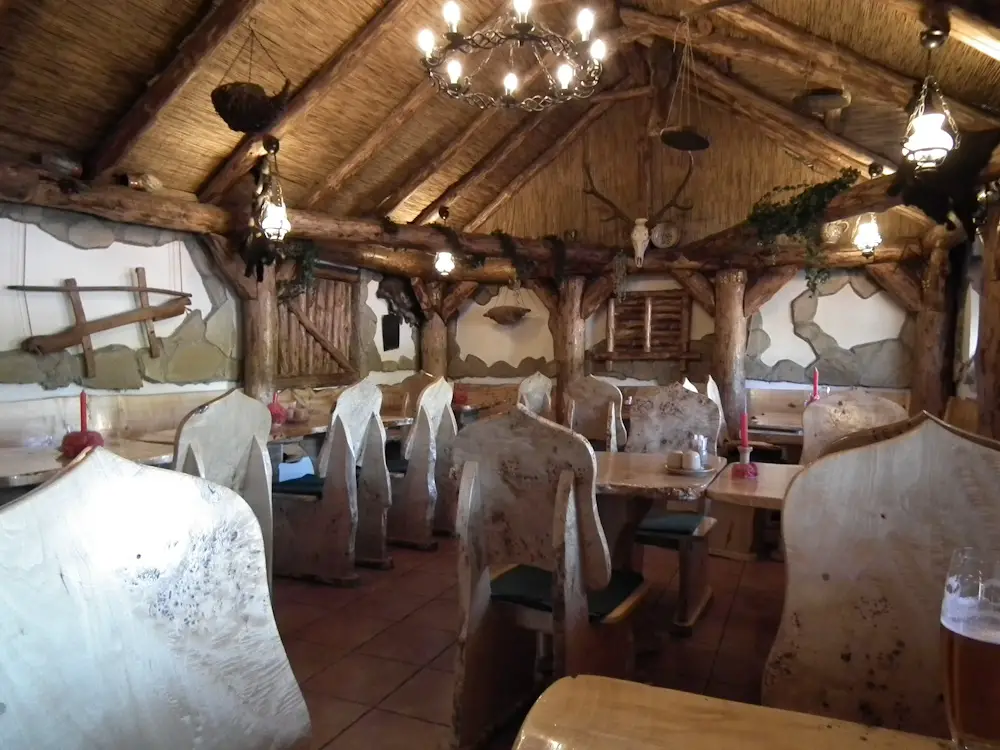
Goulash is one of Hungary’s most popular dishes. However, while we think of it as a stew in the UK, it is more likely to be served as a soup in Budapest. Other dishes involve lots of meat, cheeses and fresh vegetables, although veggie options are available. One thing that is particularly great about visiting Eastern Europe is the quality of fresh fruit and vegetables. Paprika is the traditional spice most associated with Hungary – it can be sweet or hot, powdered to use as a flavouring or as a vegetable. It guarantees a lovely gentle spiciness to many dishes.
If you’re after a bit of opulence (with the price tag to match), the New York Café describes itself as the most beautiful café in the world. It started out as a coffee house in 1894 and was hugely popular in the early 20th century. Its fortunes waxed and waned and it was left for derelict after World War 2 and became a sports shop. However, it was revitalised as a café in the 1950s and was completely renovated to its former glory in 2006.
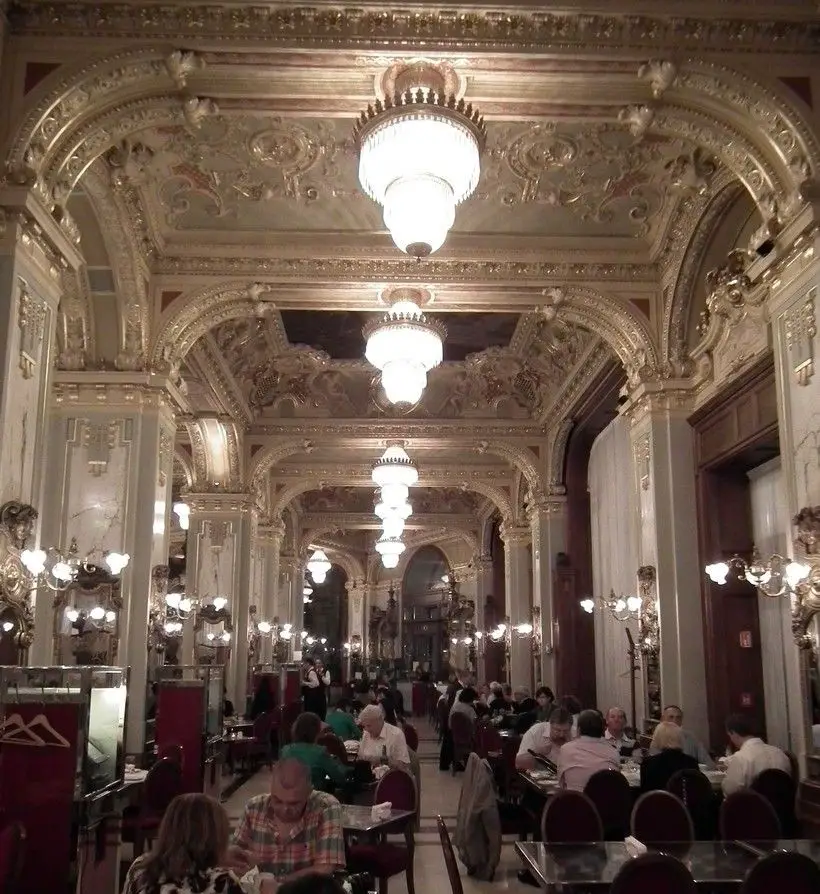
It offers coffee house fare as well as fine dining. You can only make a reservation for dinner in the evening so be prepared for a queue at busy times during the day. We enjoyed a lovely dinner there but check out the reviews as they can be somewhat mixed.
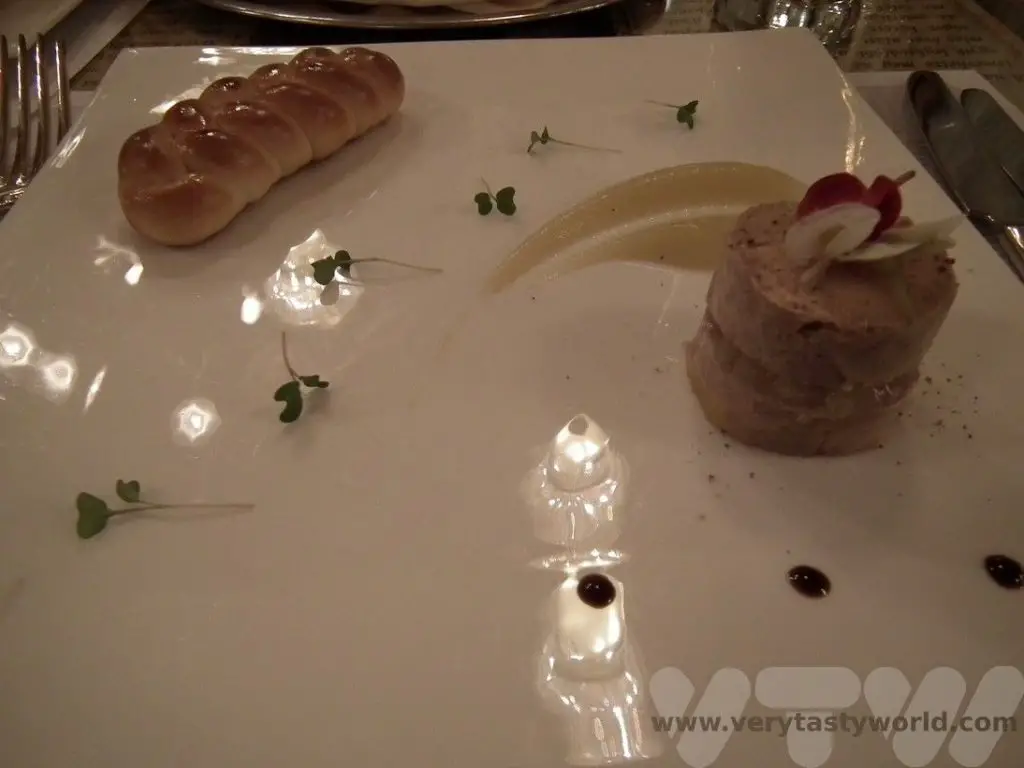
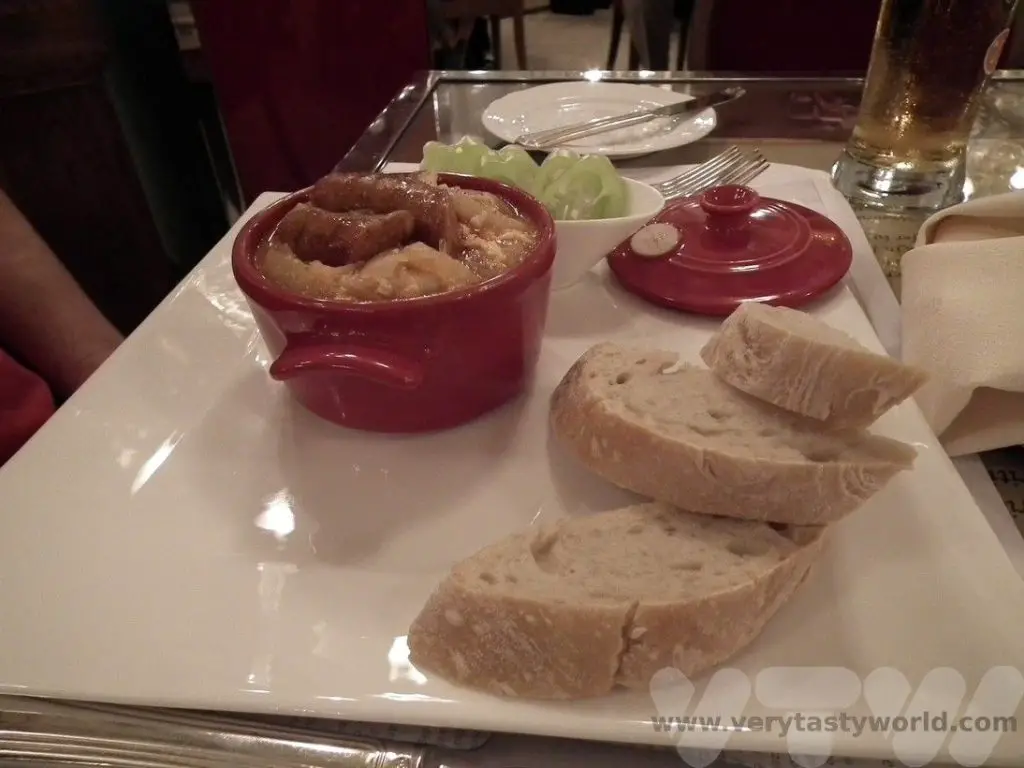
And at the opposite end of the spectrum you may well be in need of a beverage to quench your thirst at the end of a busy day’s exploring. And if you want a drink you can do a lot worse than to visit a ruin bar.
These are grungy bars that were originally set up in abandoned buildings in the city’s VII district in the early 2000s, providing cheap drinks and a lively sociable atmosphere. They are characterised by quirky décor and random bits of furniture that fill every nook and cranny within the building. Some have been established for years, others pop up for just one summer then vanish into obscurity. Some have projections of films on the walls, others play music.
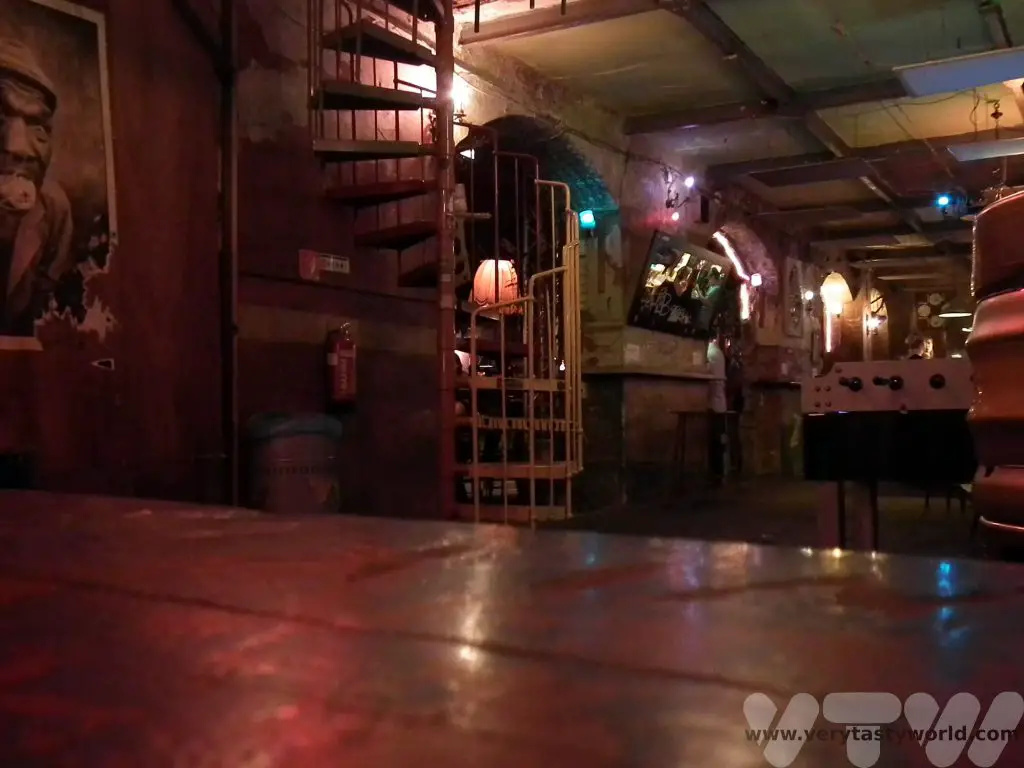
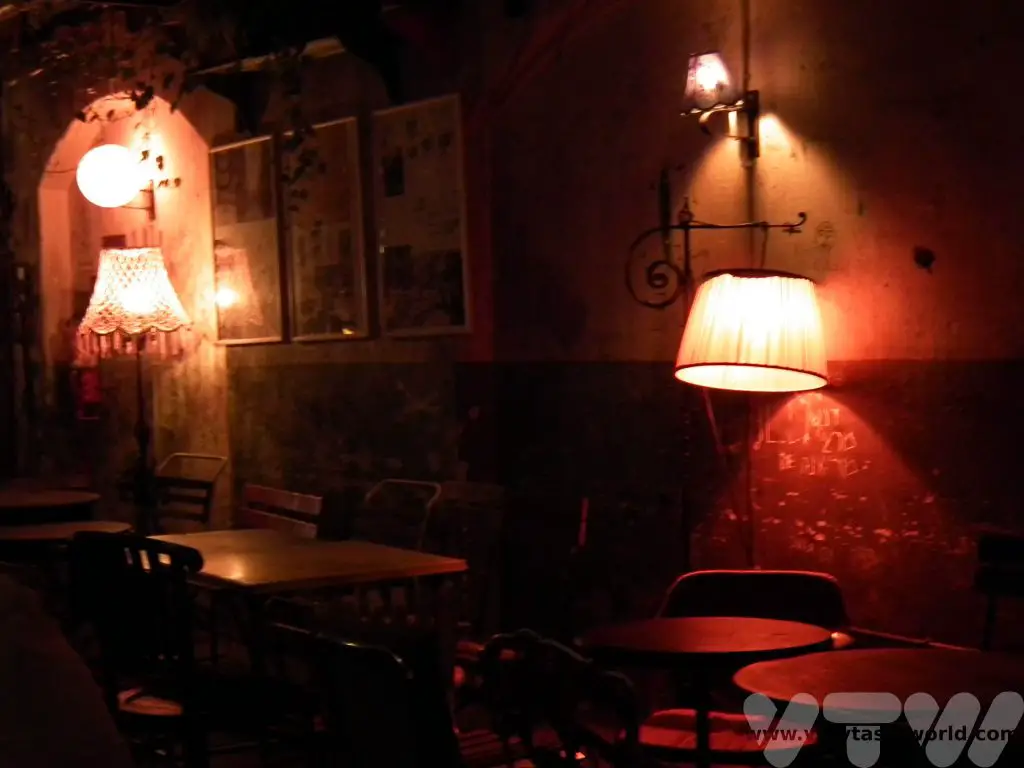
Our walking tour guides recommended Szimpla Kert on Kazinczy Utca – a great choice.
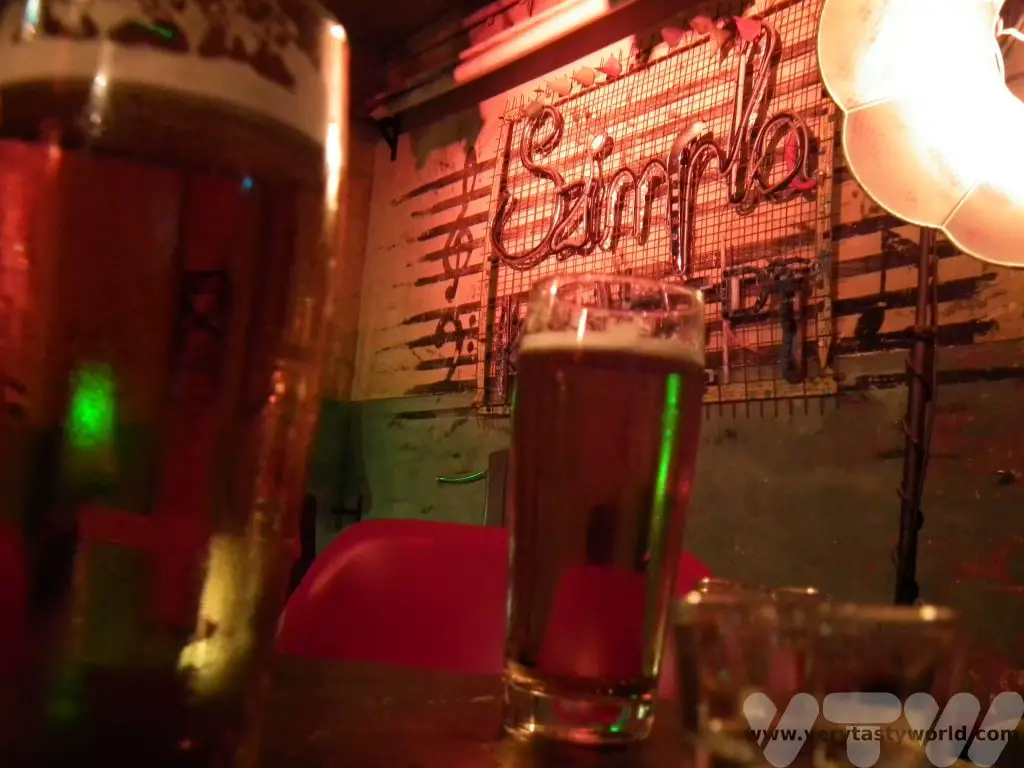
Ruin bars are perfectly convivial places to enjoy a cool beer or a shot (or more) of the local brew palinka, a fruit brandy, which is both sweet and strong.
Essential Foodie Souvenirs – we recommend bringing home as much paprika as you can fit into your bags. Hungary is one of the world’s biggest producers of paprika. This spice is synonymous with Hungarian cuisine and can be used in a huge range of dishes. There are many varieties on offer and they have different levels of sweetness and heat. Paprika not only adds the most glorious red colour to a dish but importantly, has bags of flavour! It should last well for up to a year.
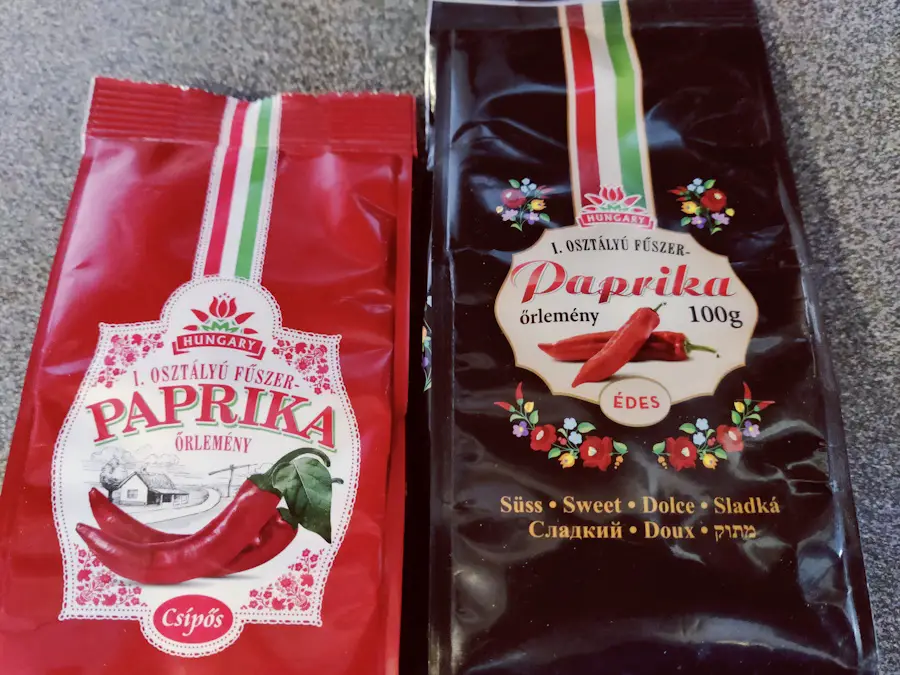
Budapest is a lovely city with so much history. Because it is so walkable, it really is possible to cram a huge amount of sightseeing – as well as some very enjoyable dining and drinking – into just a couple of days. Although it is almost certain to leave you wanting more…
Related Posts You May Enjoy

Happy, Happy Holi in Nepal
Originating from the Indian subcontinent and celebrating the arrival of spring, Holi is known as the Festival of Colour, Festival of Spring or the Festival of Love. And it really is all three of those things. Like many festivals across the world its date is based on a lunar calendar and it falls on the last full moon of winter. It is celebrated by Hindus, Sikhs and Jains and has become an increasingly popular event all over the world. In the countries that celebrate, Holi is a national holiday when everyone comes together to celebrate spring and love. We were lucky to spend Holi in Nepal a few years ago.
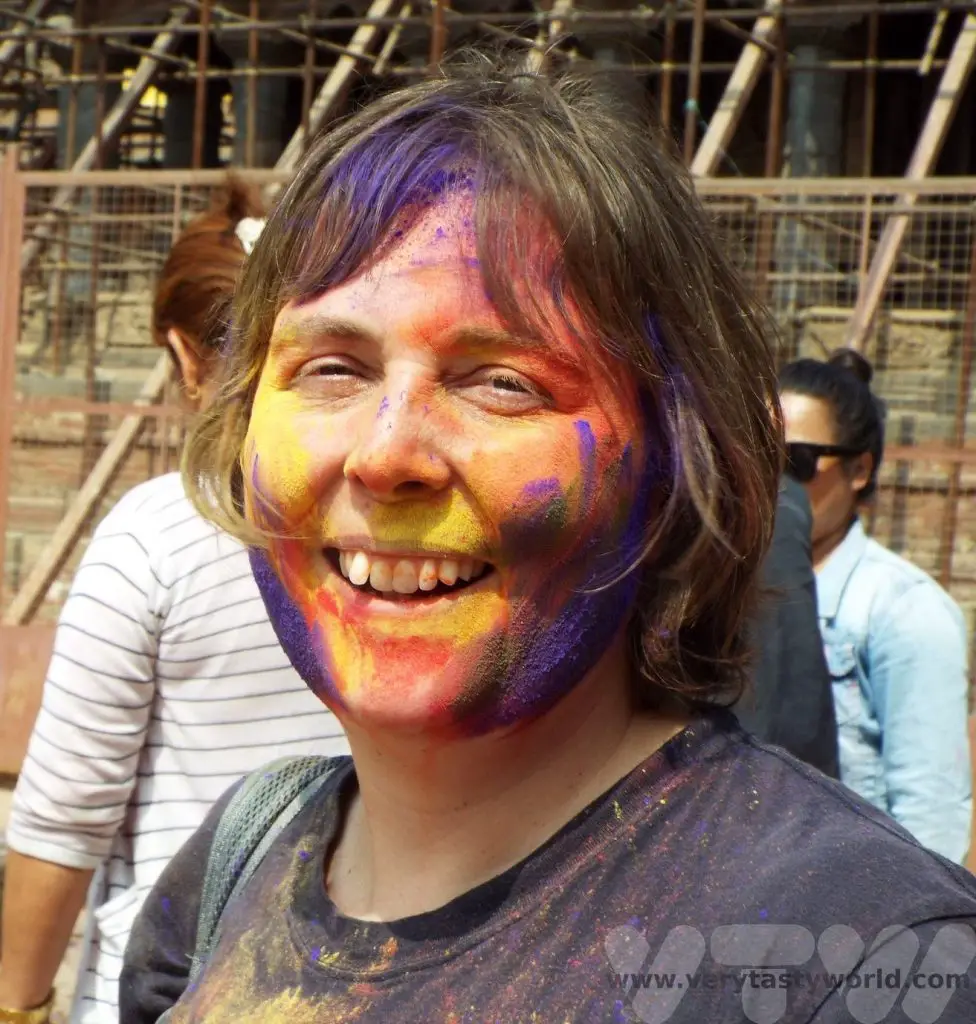
There are a number of rituals associated with the festival and these can vary between different regions. The celebrations start in the evening before Holi with a Holika Dahan where communities gather and light a fire, burning a symbolic effigy of a demoness who attempted to kill her nephew, Prahlad, a worshipper of the God Vishnu. This represents the triumph of good over evil. Traditionally participants contribute wood for the fire and dance and sing together. It’s important to remember that Holi is also about love and repairing broken relationships.
The following morning is Rangwali Holi (Dhuleti), the festival of colour. And it doesn’t matter who you are or where you are from, you are welcome to join in the fun. Everyone takes part and those serious about ‘Playing Holi’ will be armed with all sorts of devices to make the day as colourful as possible – there will be powdered paints, water pistols containing ordinary or coloured water, water balloons (you have to watch out for those as they can be quite a surprise). People often wear white clothes in order to show off all the colours. You can buy paint powder from street vendors everywhere.
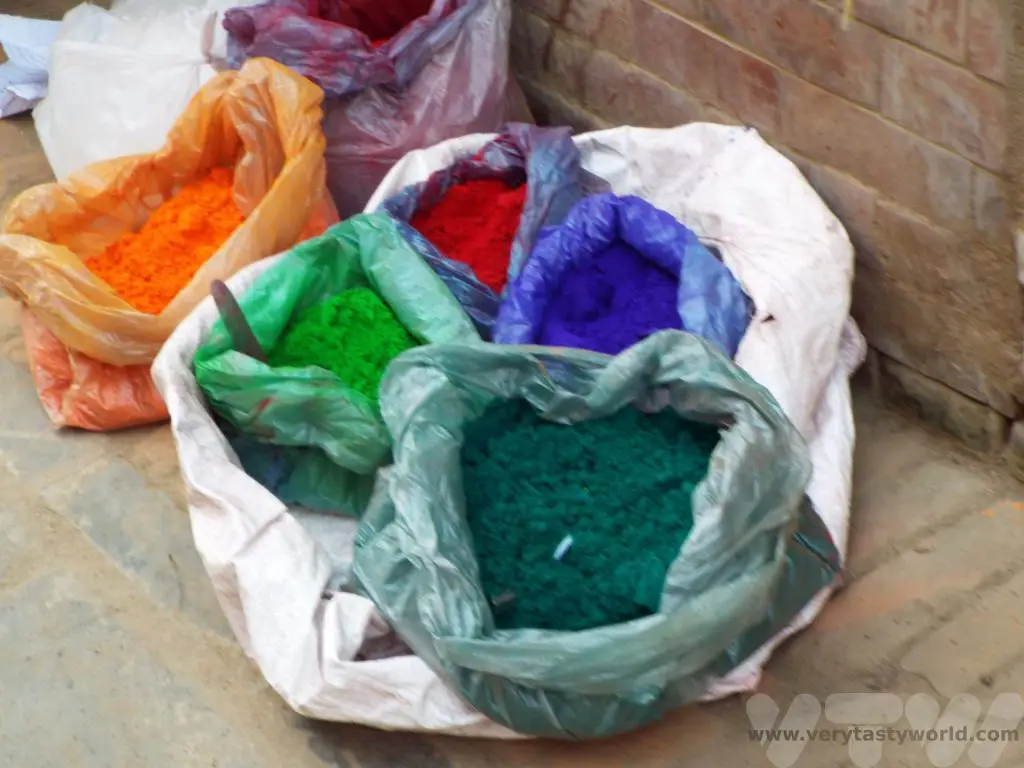
Holi In Nepal
In Nepal Holi celebrations begin eight days before the full moon, starting off with the raising of a chir – a long bamboo pole embellished with brightly coloured strips of cloth in three circular layers. This chir will be burned on the night before the full moon, again symbolising the burning of Holika and the victory of good over evil.
We were in Nepal during Holi a few years ago and it was one of the most fun days we have ever had when travelling. After a fantastic journey travelling through Bhutan and Southern Nepal, including a stay at the Neydo monastery and a couple of days in the Chitwan National Park where we undertook a walking safari and learned to cook with the local Tharu people. We had travelled back to Kathmandu to explore the capital as well as nearby Bhaktapur and Patan, all cities with an incredibly rich cultural heritage. (We will post about these in detail another time.)
Bhaktapur, also known as Khwopa, is a UNESCO world heritage site, a city located some 13km from Kathmandu. It has some of the most remarkable architecture, with squares that contain beautiful temples and statues.
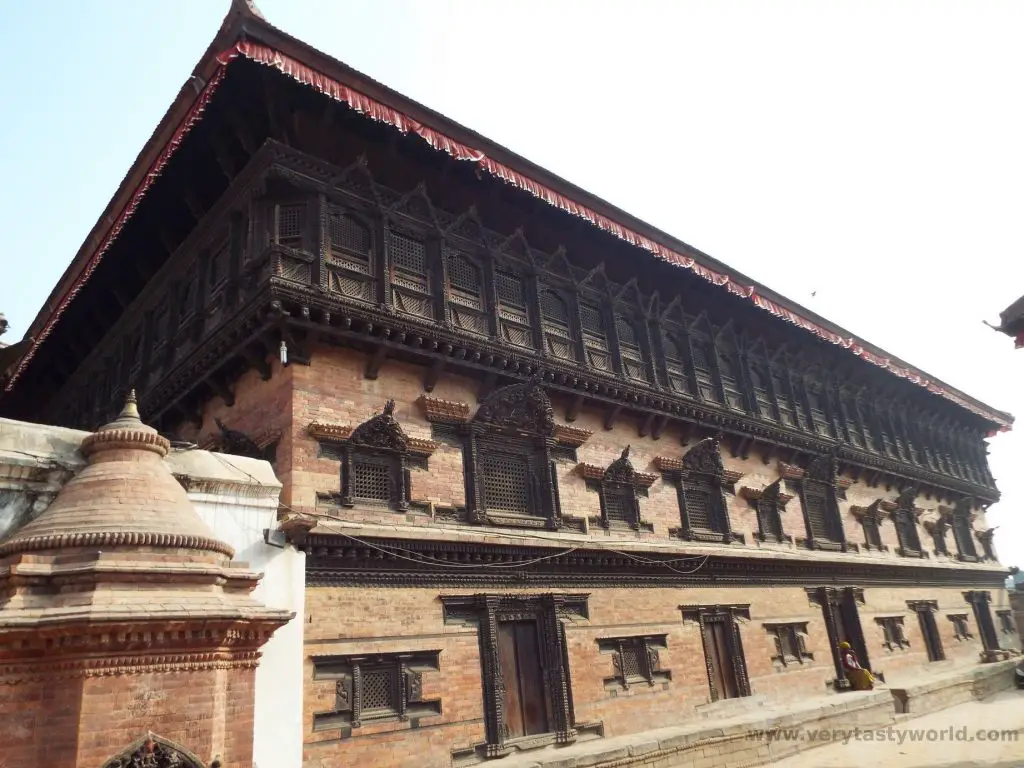
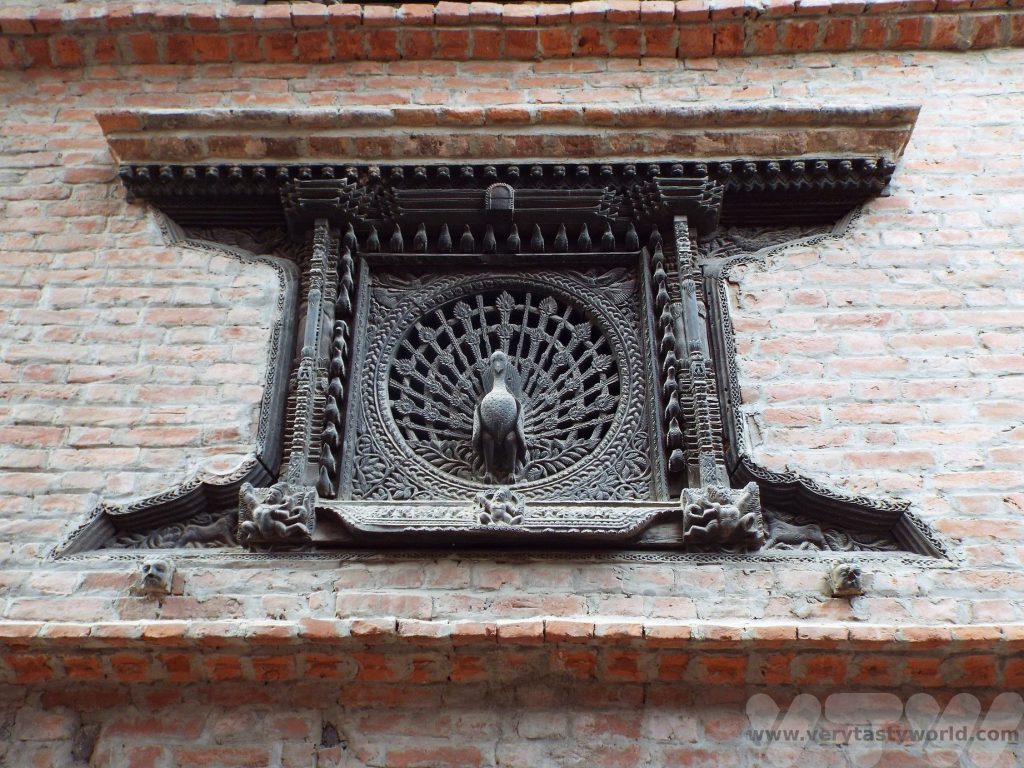
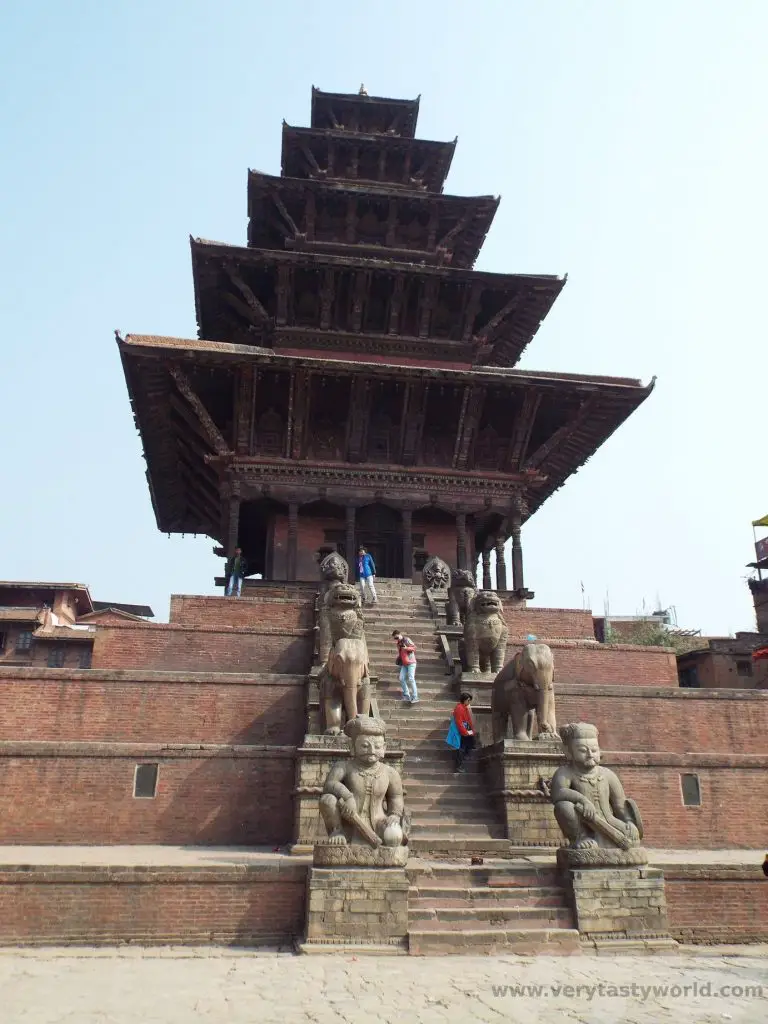
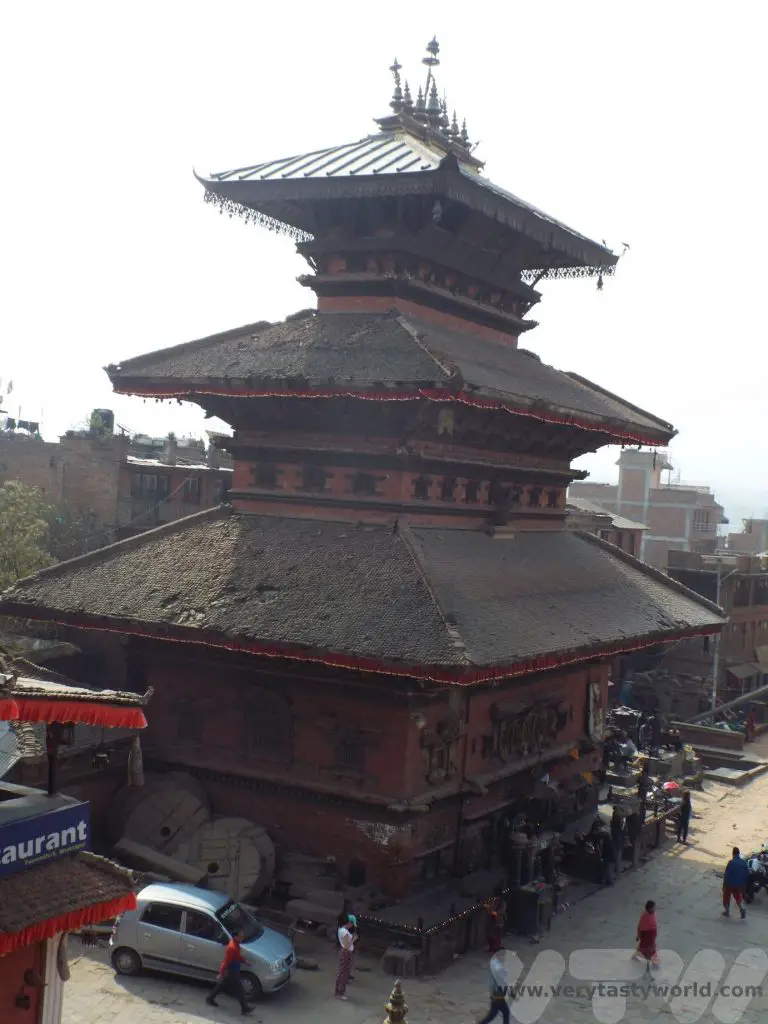
Patan is another UNESCO site. Around 5km from Kathmandu, it is so close to the capital that even though it is Nepal’s third largest city, it almost feels like a suburb of Kathmandu these days. Along with the capital and Bhaktapur it is one of Nepal’s three royal cities. It is also known as Lalitpur – City of Beauty – a title that is hugely apt.
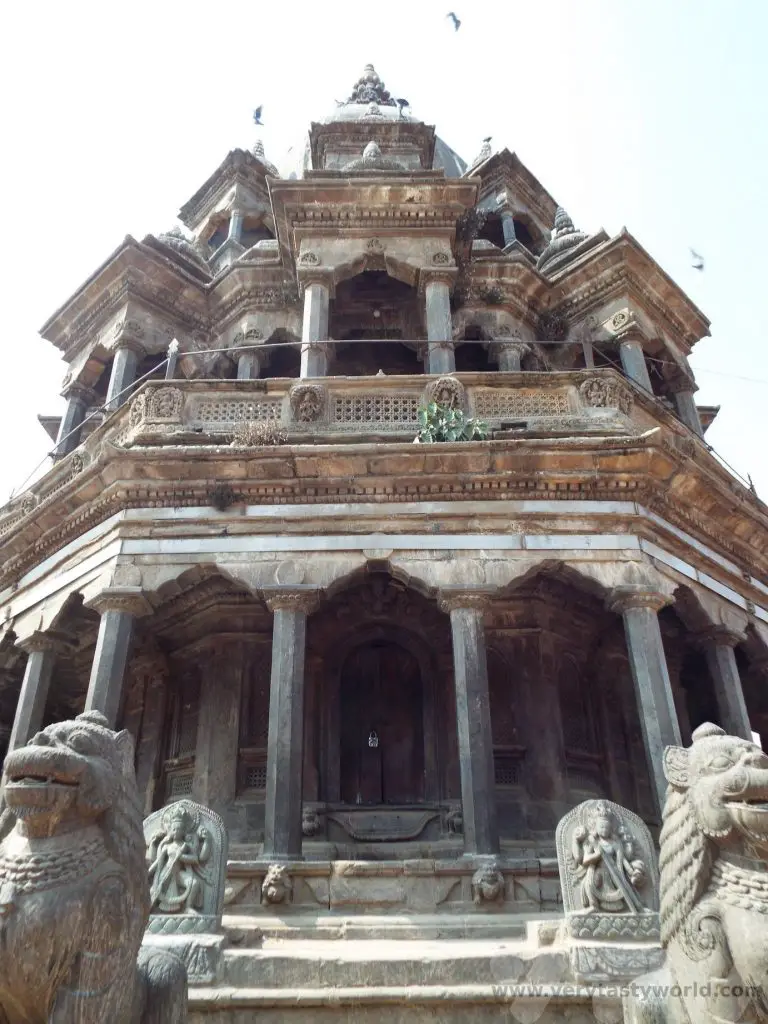
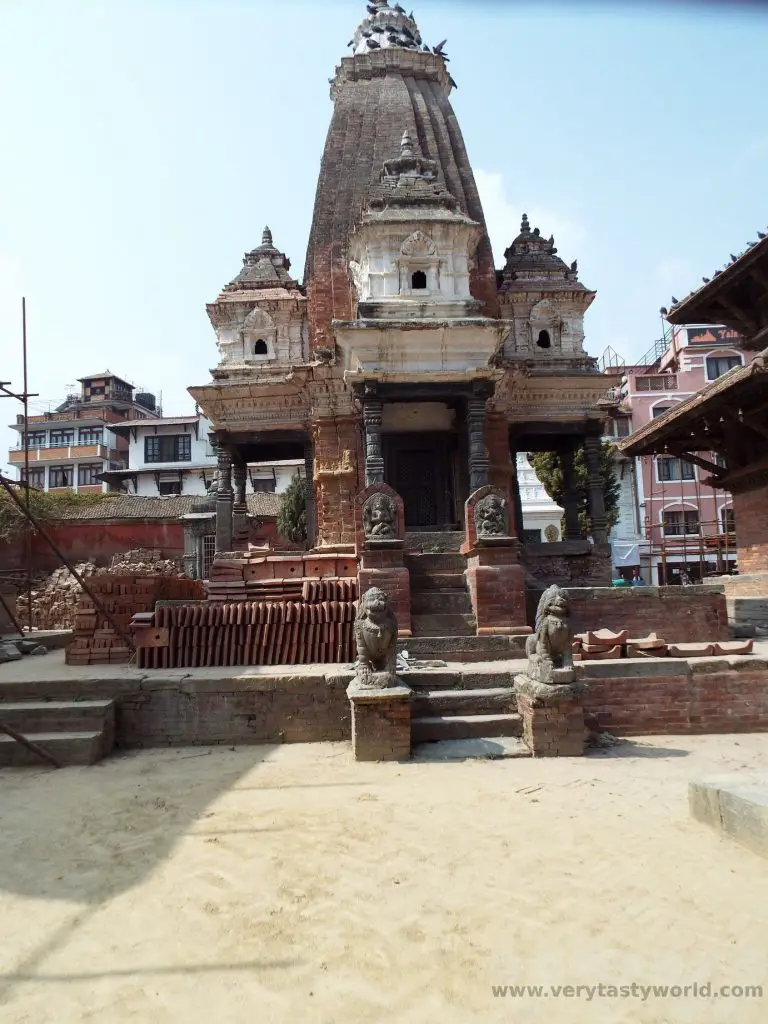
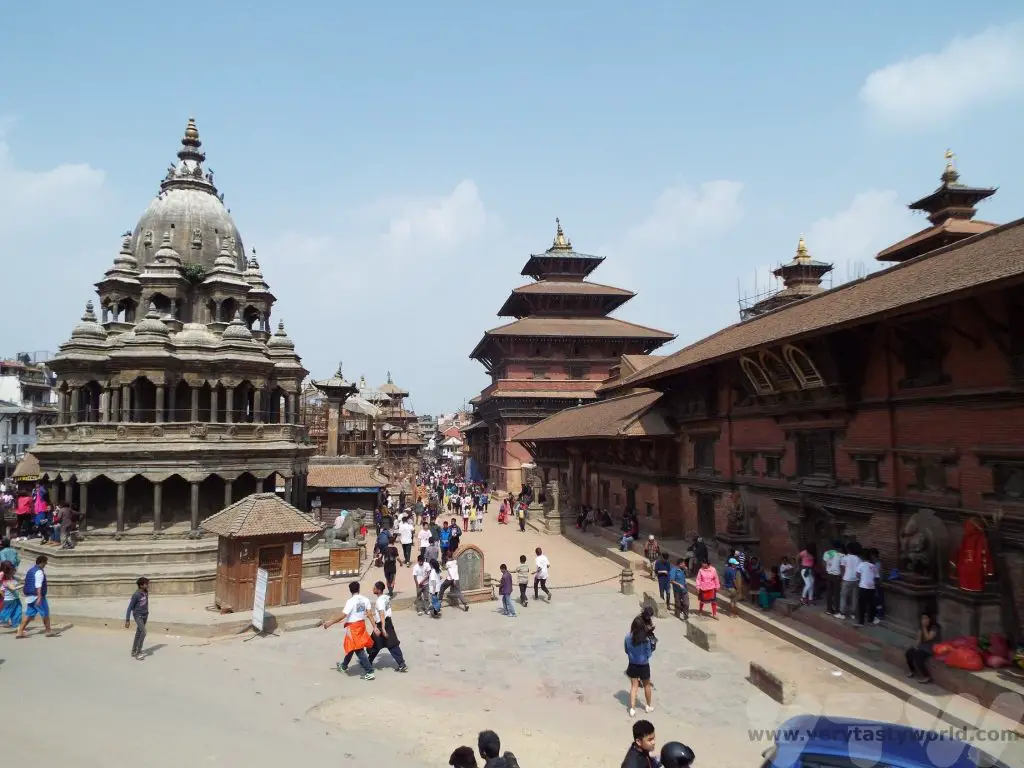
Sadly, both cities and their remarkable historic buildings were badly damaged during an earthquake in 2015 and repairs have been ongoing for some years.
Happy, Happy Holi
Holi began tentatively for us. We were doing a walking tour in the early morning in Bhaktapur when a smiling young man approached us as we were strolling down a side street, smeared a little red powder paint on our cheeks, and declared “Happy Holi!”. We wished him the same.
As soon as we had paint on our faces we quickly discovered that we were fair game. People would come up to us and anoint us with paint powder. Children bearing water pistols would quietly approach us then squirt us before running away, shouting joyously as we gave chase, their families looking on smiling and laughing. And we loved every moment.
Moving on to Patan, by mid-afternoon the town squares were filled with crowds as music played loudly and colours filled the air.
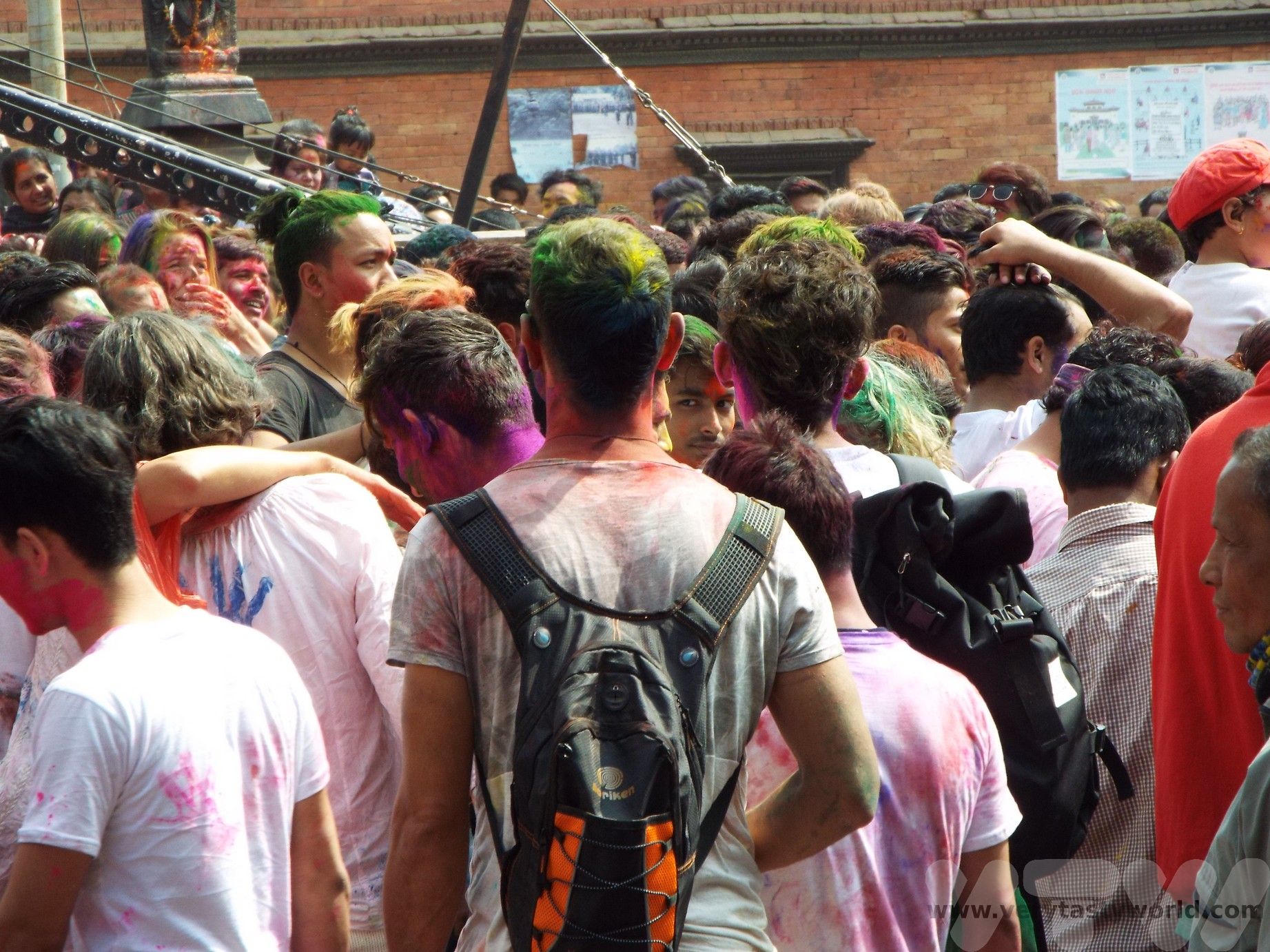
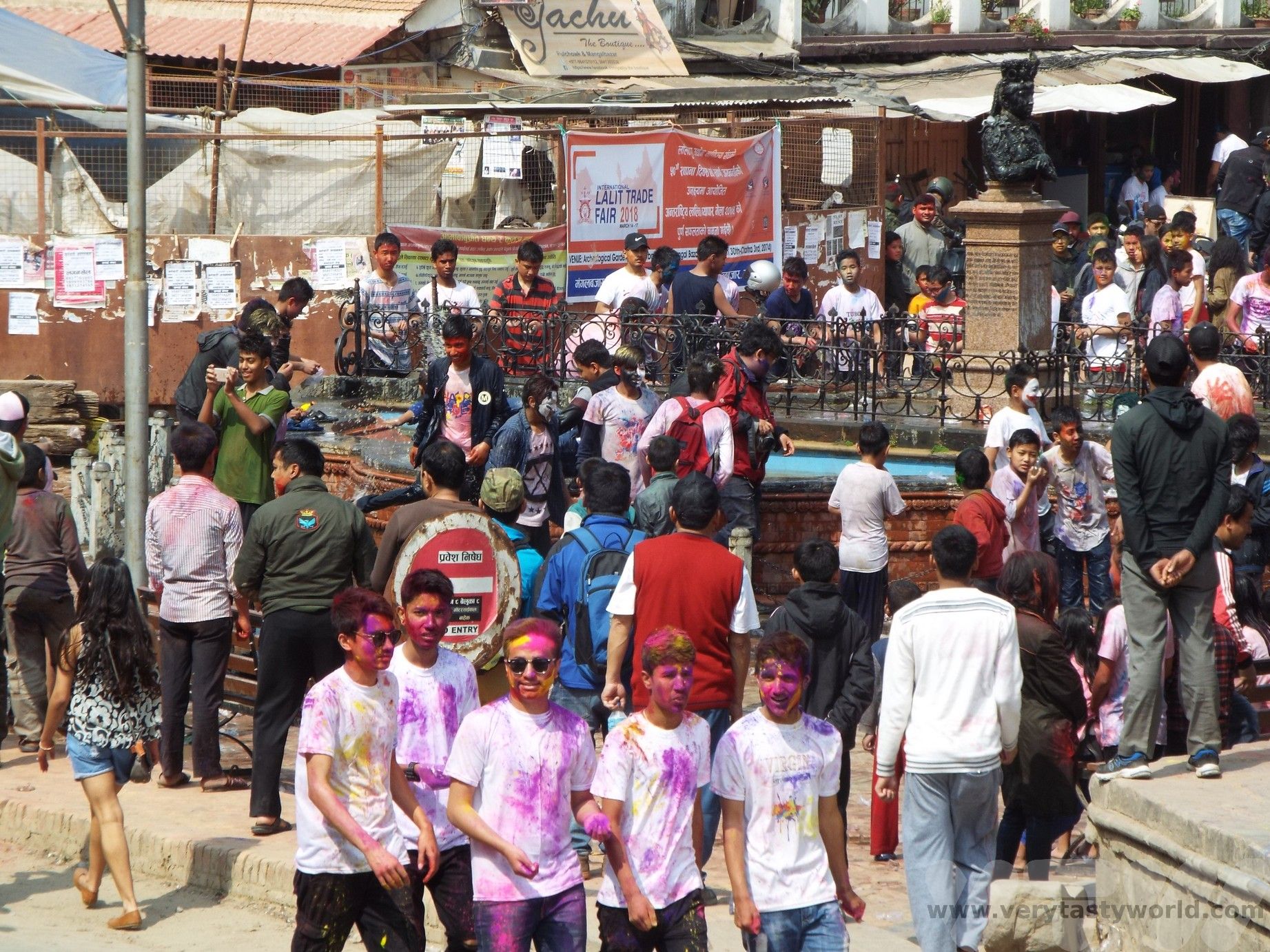
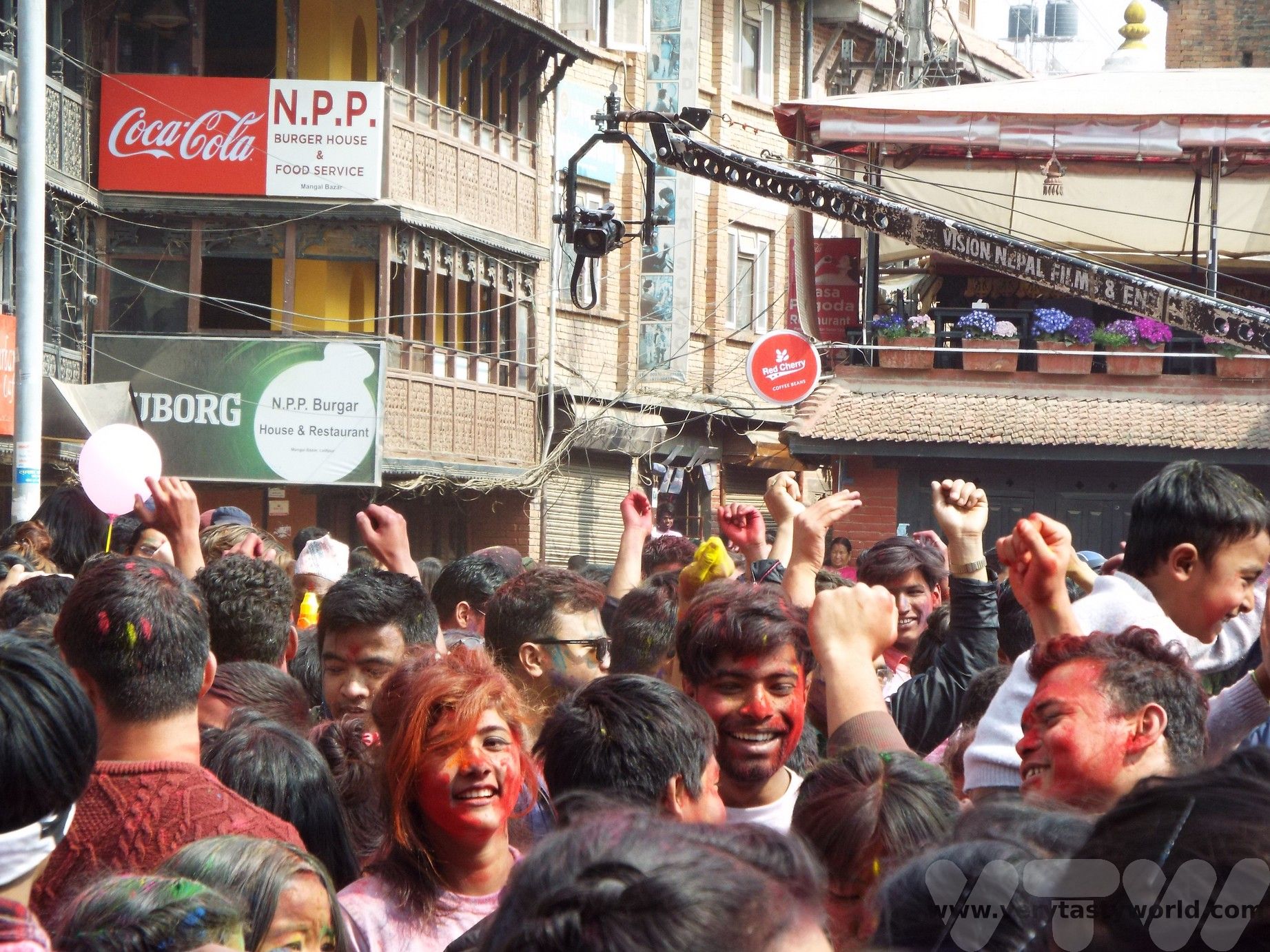

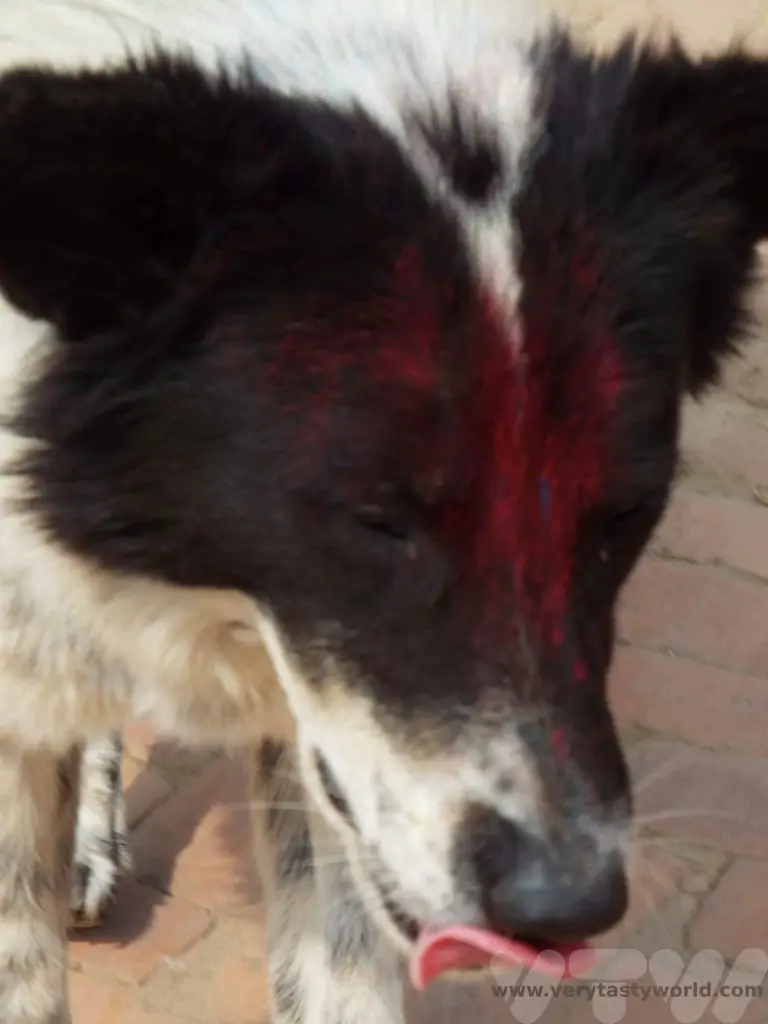
Even one of the local dogs took part.
Walking through the town people were singing and dancing in the streets, “Happy, Happy, Holi!”
It was lovely looking out at the celebrations over Durbar Square.
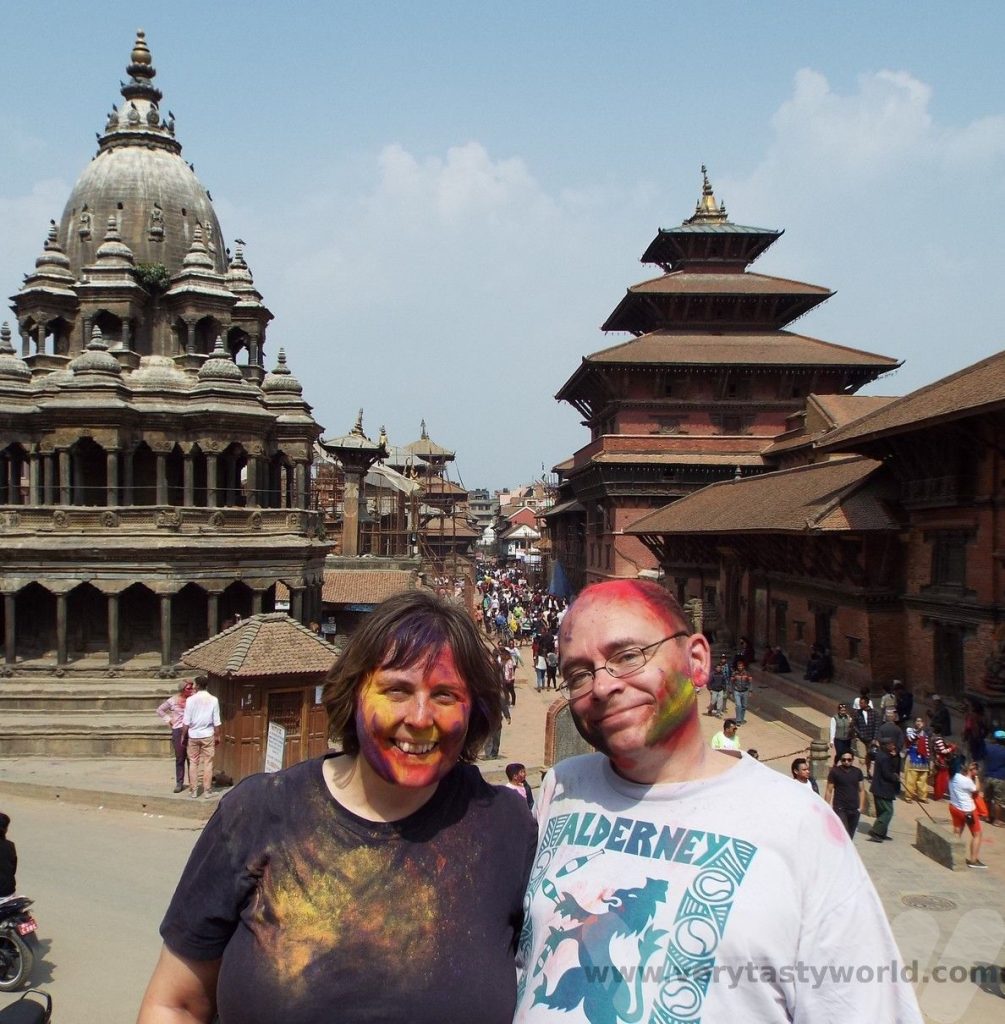
Holi In Nepal – Celebratory Food
Of course we wanted to try some of the local food. At a tiny restaurant off one of the side-streets near Durbar Square in Patan, we joined local people sitting on benches in front of low tables, and discovered chatamari. We sat down on a bench and watched the cook expertly make this lovely dish. It’s a celebratory food and it seemed entirely appropriate for the day.
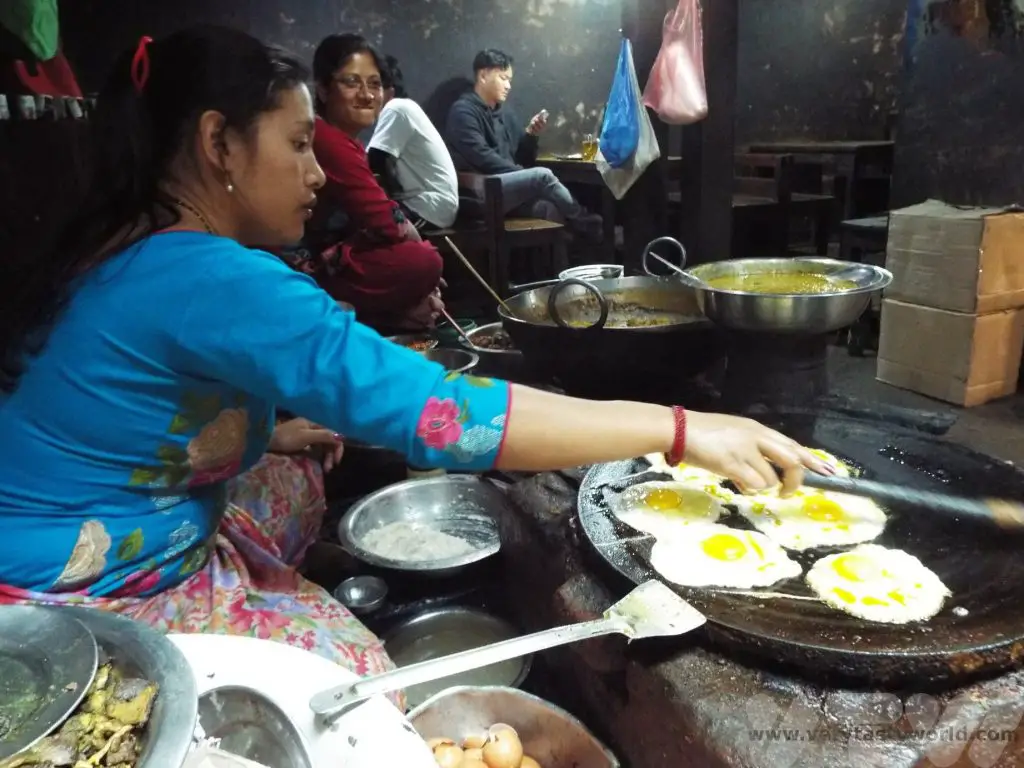
Chatamari is a specialty of the Newar community of the Kathmandu valley. It is like a pancake with toppings. The batter is made from rice flour, spices and eggs. It is then fried on top of a circular flat grill and various toppings are added as it cooks – ours comprised minced meat, onions and a fried egg – but fully veggie options are available.
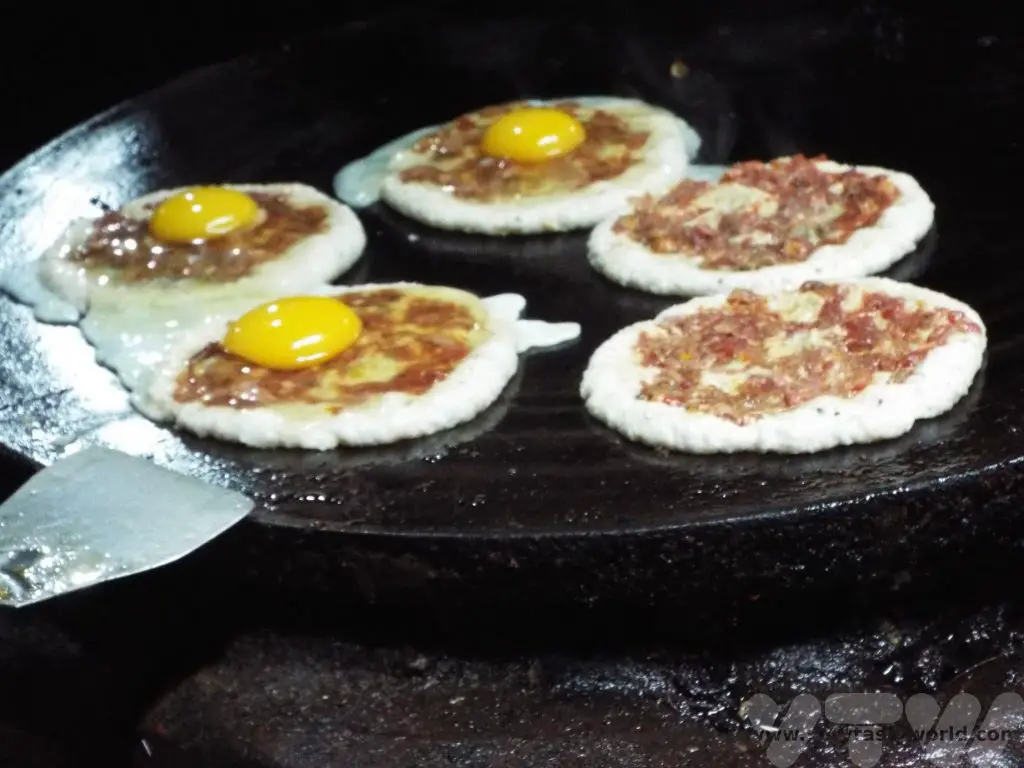
These were the star dish but were accompanied with some roasted lamb, a potato curry and bhuteko bhatmas, soybeans roasted in Nepali spices, which were spicy, crunchy and absolutely delicious. (And perfectly complemented a nice, cool beer.)
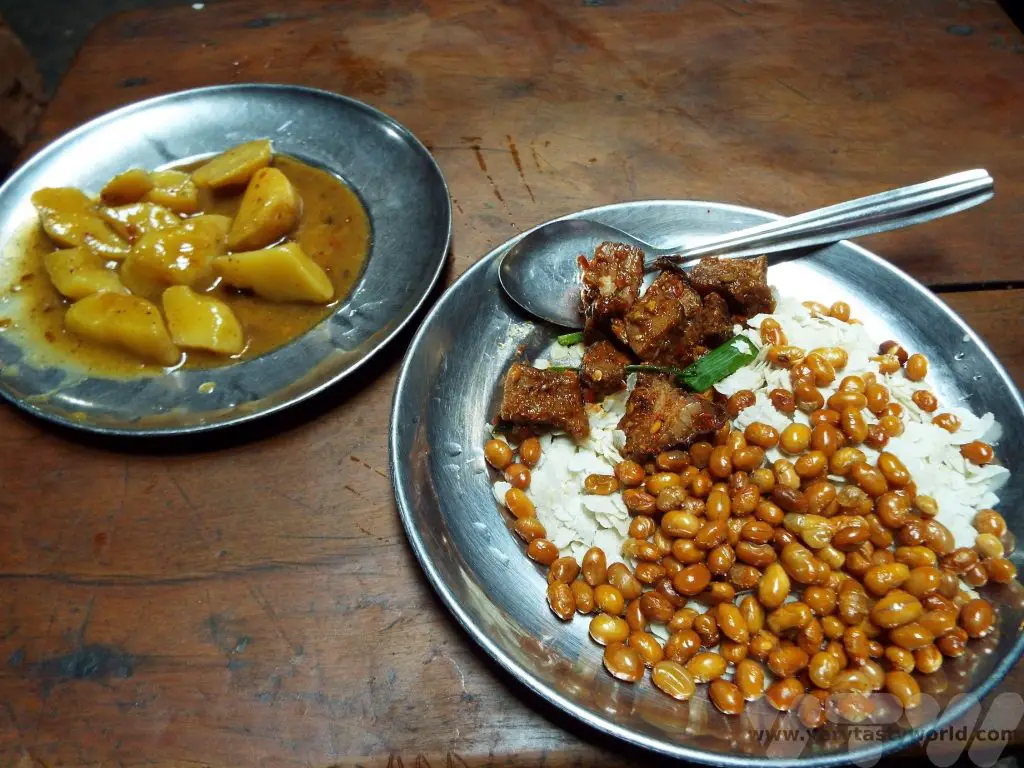
After lunch it was time to head back into the happy mayhem and explore further. The local children were particularly interested in playing Holi with us. Just as we were about to leave Patan we asked a passer-by to take a photo of colourful us – by the time he had figured out the camera setting… PHOTOBOMB! The kids were very happy to show us their pre-prepared waterbombs.
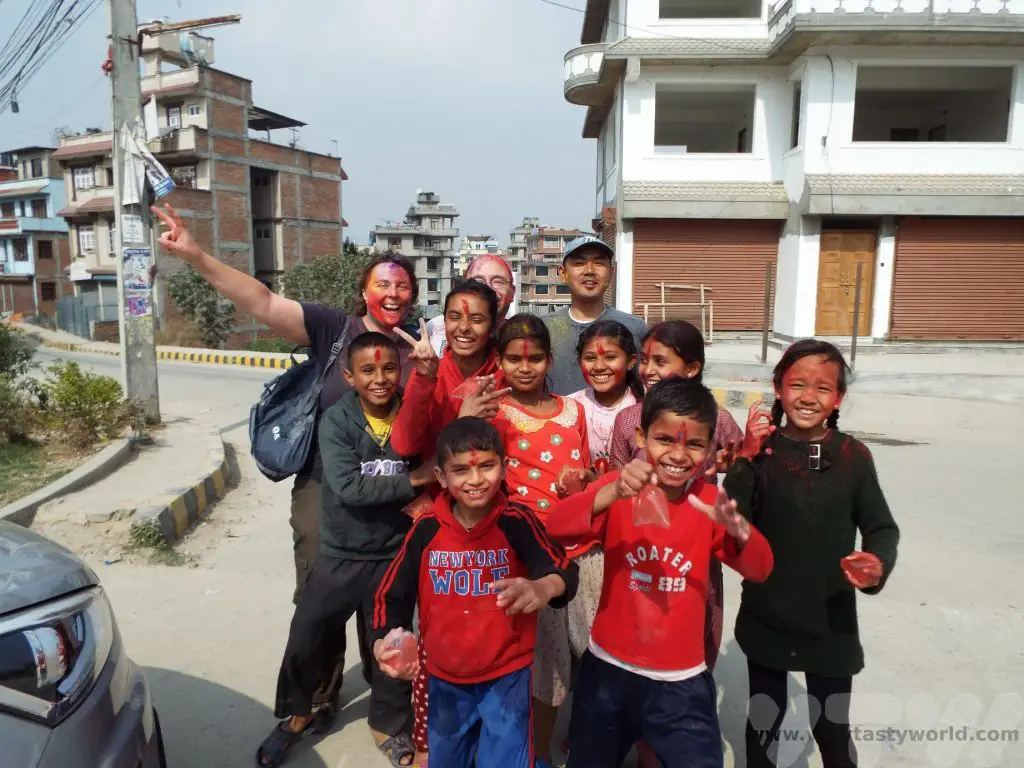
Arriving back at our (relatively posh) hotel in Kathmandu, absolutely covered in paint, we were a little unsure about how we would be received. Nobody minded, they knew it was Holi, and the local people were delighted that we had taken part and we were greeted with smiles. We showered very carefully, doing our utmost not to get paint on the hotel’s towels. We were largely successful.
Holi in Nepal was one of the most colourful, delightful and – above all else – happy festivals we have ever attended. It was truly a day of joy.
Related Posts You May Enjoy
Inside Petra in Jordan
The Rose Red City
There are many magnificent archaeological sites in the world and the Rose Red City of Petra is undoubtedly one of the greatest. It had long been an ambition to visit and it was top of our list when exploring Jordan. Here is our guide to visiting this vast and amazing historic site, including what you can see inside Petra.
The most famous image of Petra that of Al-Khazneh, The Treasury (the one you see in the film Indiana Jones and the Last Crusade) and we knew that we would walk through a dramatic canyon, known as As-Siq, to reach it. What we didn’t realise was quite how extensive the site is.
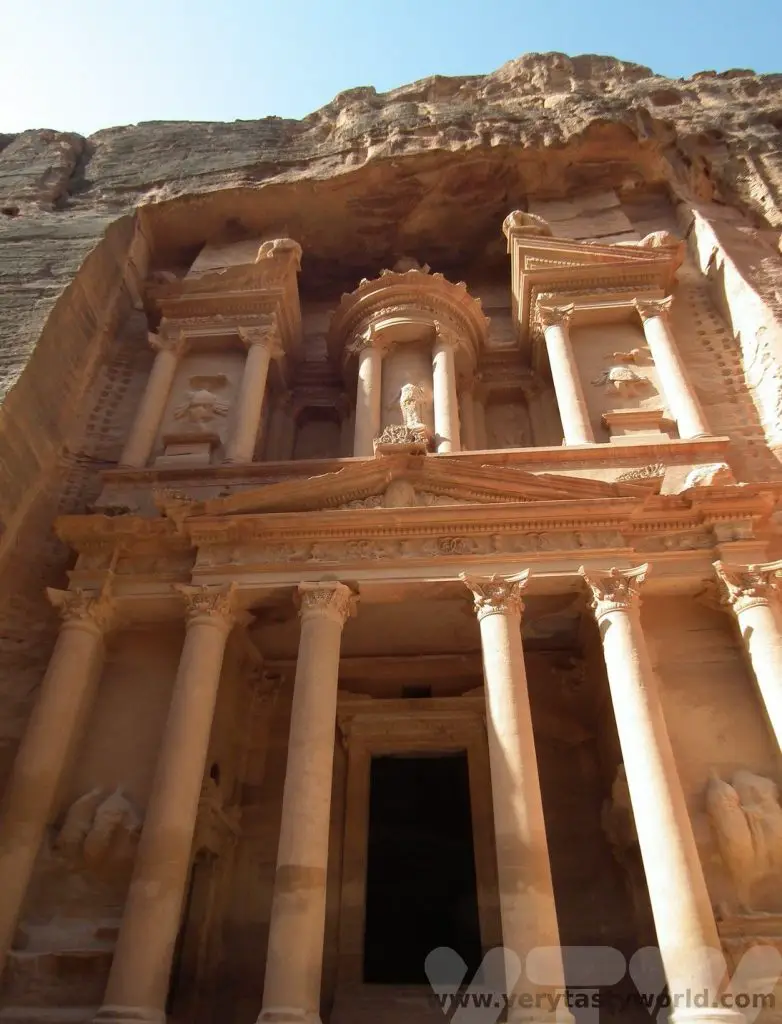
The History Of Petra
Petra was built by the Nabateans, an ancient Arab tribe, around the 1st Century BCE. The Nabateans were involved with caravaneering, trading in goods from all over the Middle East and Far East, and they became very wealthy protecting the region’s trade routes. Goods came from as far as China and India. What was fascinating about the Nabateans was that they were a clever, enlightened people. They believed in cultural inclusivity and appropriated technology from all over the world, absorbing influences from the places they traded with. You can see many different architectural styles throughout Petra.
In 106 CE the city was overtaken by the Romans who renamed it Arabia Petraea. The city did thrive under Roman rule for many years but its importance as a trade route declined as sea trading routes developed and became more important for transporting goods. It was significantly damaged by an earthquake in the 4th Century CE. It declined further during the Byzantine era and the city eventually was abandoned became ‘lost’ for centuries. It was re-discovered by explorer Johann Ludwig Burckhardt in 1812.
Visiting Petra – Practicalities
The site is located around 240km from Jordan’s capital city, Amman. The time it takes to reach the area does vary depending on the traffic, especially in Amman, which can be quite congested, but also the route you take. It’s around three hours by car on the modern desert highway or five hours on the King’s Highway. It is possible to do a day trip to Petra from Amman by bus, leaving early in the morning and returning in the evening, but the visit would be very rushed. It is also possible to reach the site using a hire car (the driving would be easy except in Amman where the roads are quite chaotic) or via a private tour – there are many options available.
We had travelled to Petra via Mount Nebo and the Dead Sea having spent some time in Amman, and after visiting the Roman city of Jerash.
You can’t stay in Petra itself (edit – that is, there are no hotels in Petra), but there is a town called Wadi Musa nearby. Our hotel was about a ten minute walk from the site entrance at Wadi Musa, which was a further kilometre away from the start of the Siq. Included in the ticket price is a horse ride to the Siq, which we declined. We don’t feel comfortable using animals when we are travelling as we can never be sure how they are treated, so avoided these. We prefer to walk anyway. Since we visited, an initiative has been established to use electric vehicles that will replace the horse-drawn carriages.
We had two full days to explore inside Petra. We needed them. You cannot enter the site without purchasing a ticket at the visitor’s centre at Wadi Musa and we recommend finding a guide for at least part of your visit. We found the most delightful guide at the visitor’s centre who was with us the first morning; he showed us Petra’s main features and explained a lot of the history. We spent the rest of the time there exploring the site for ourselves. (This link will take you to current entrance fees and costs for guides.)
The Siq
Just before the entrance to the Siq you can see the Obelisk Tomb and the Bab as-Siq Triclinium.
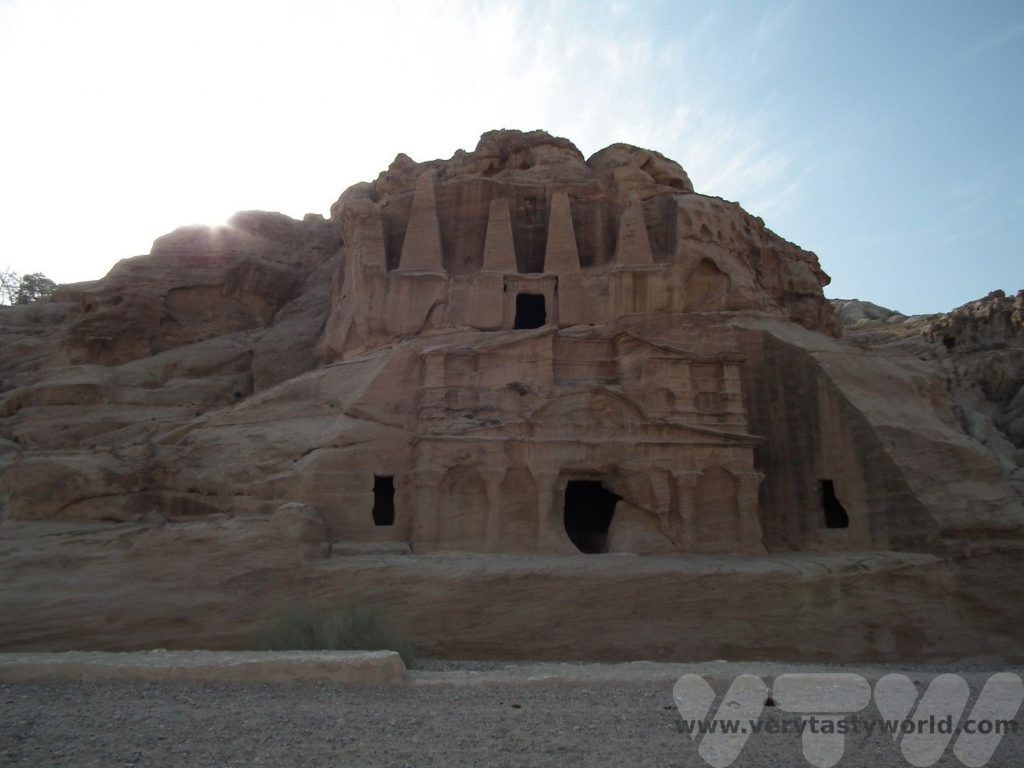
Then you enter the gorge itself. The Siq is about 1200 m long. It is deep (up to 80m in places), at times narrow, and stunningly beautiful. You can see all sorts of natural features, rock formations and fossils, as well as the remains of carvings showing caravans and camels.
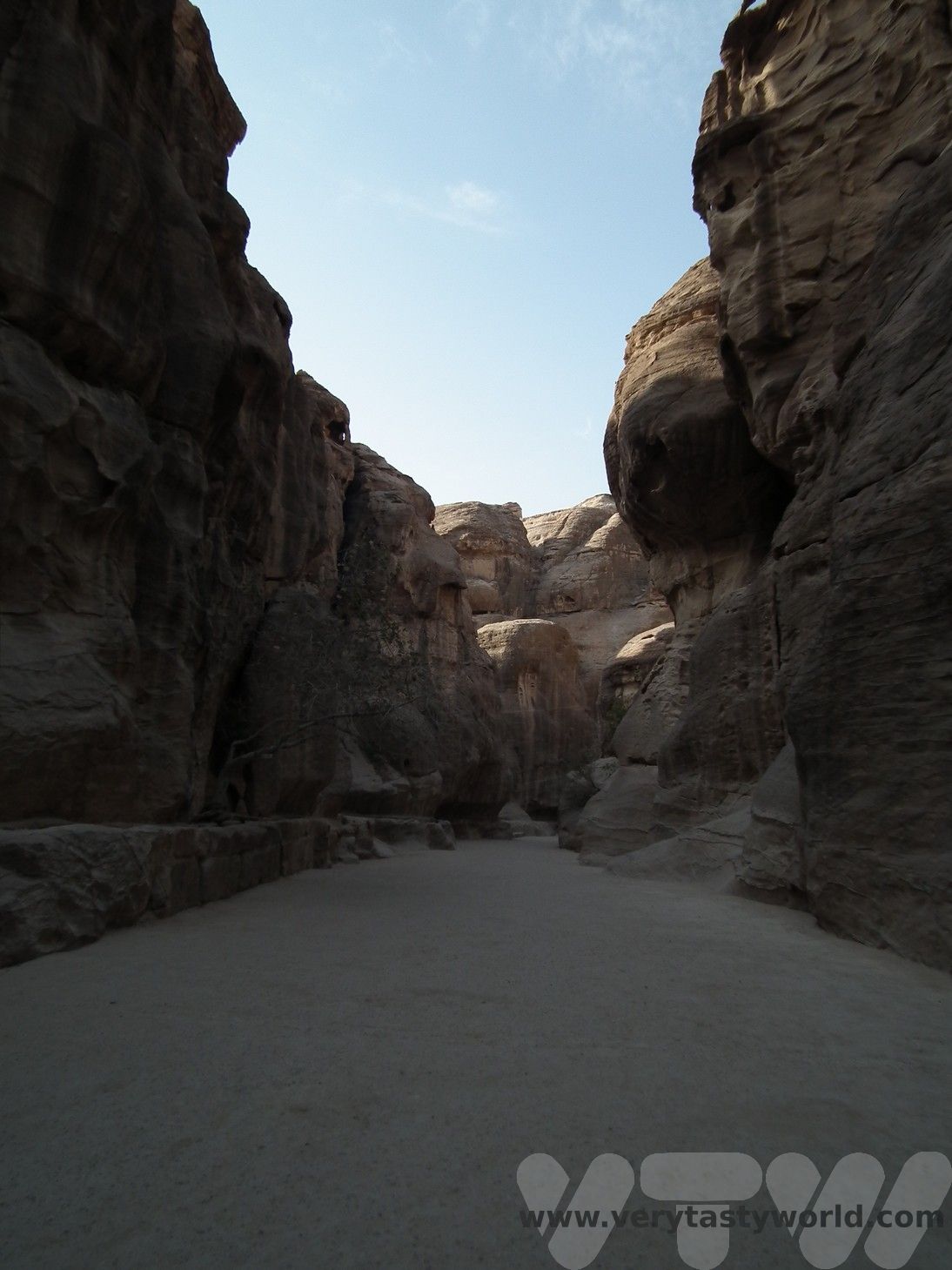
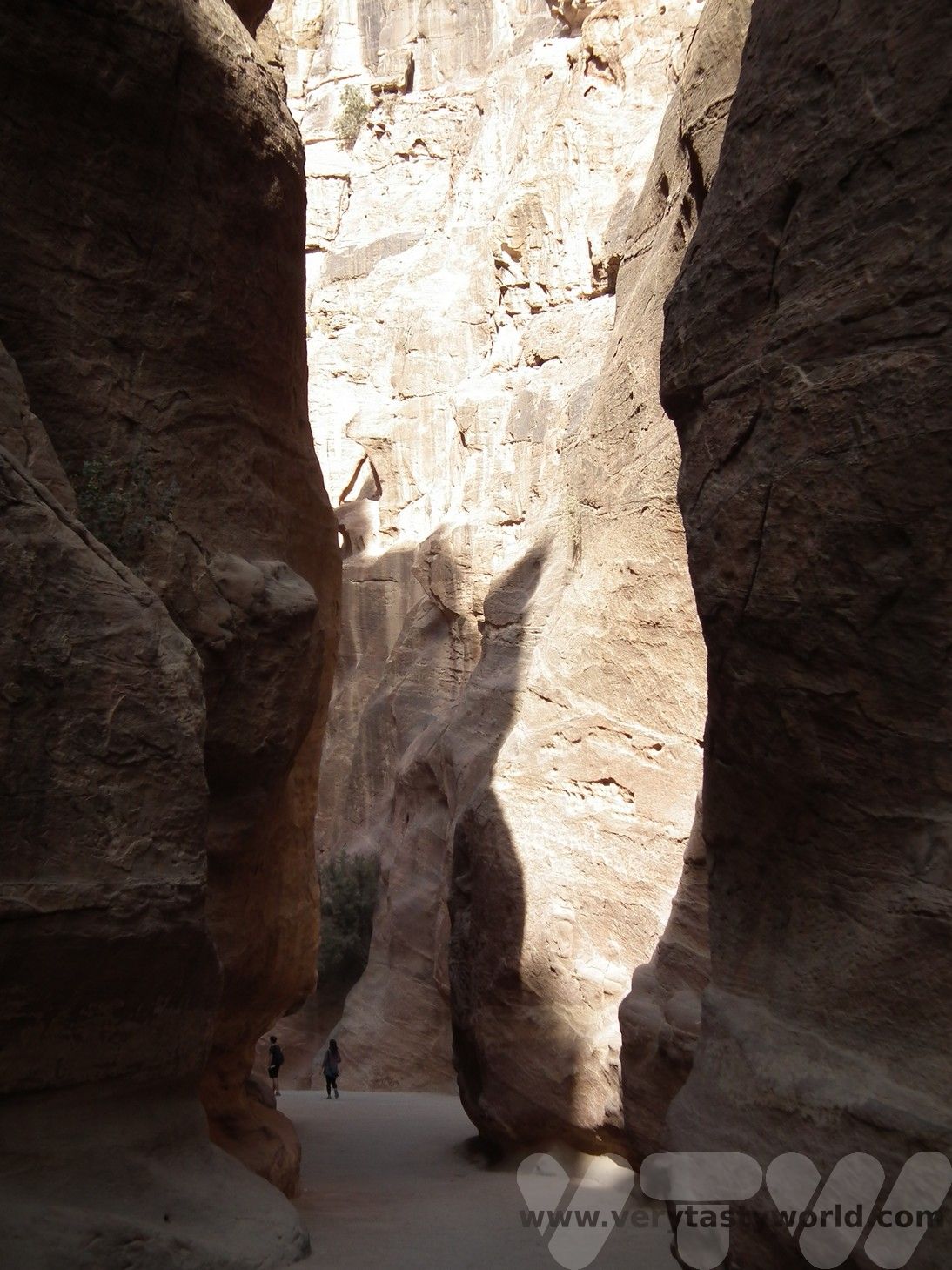
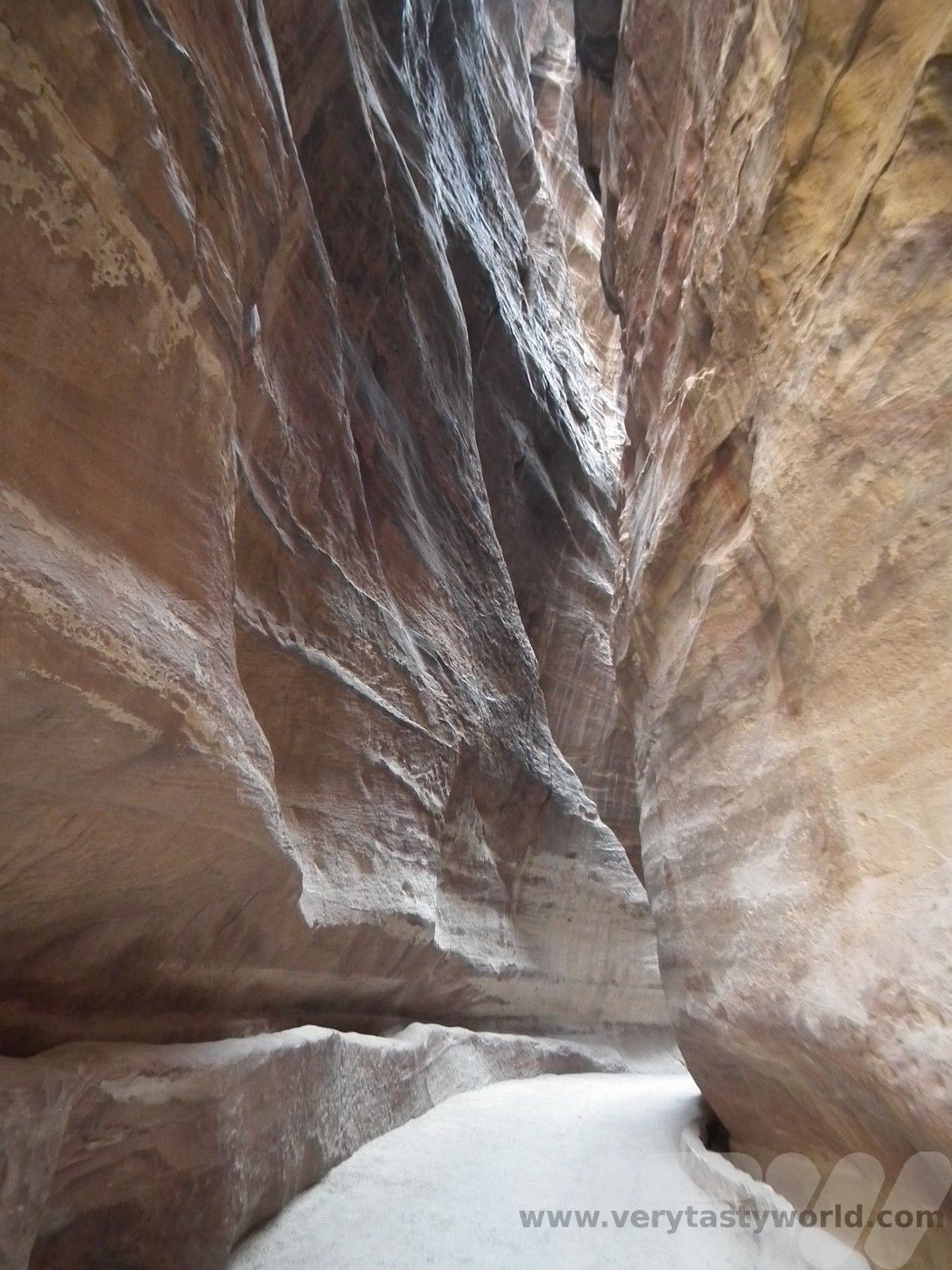
The photo shows drainage channels carved into the rock, inspired by Chinese bamboo irrigation channels, which carried water to Petra.
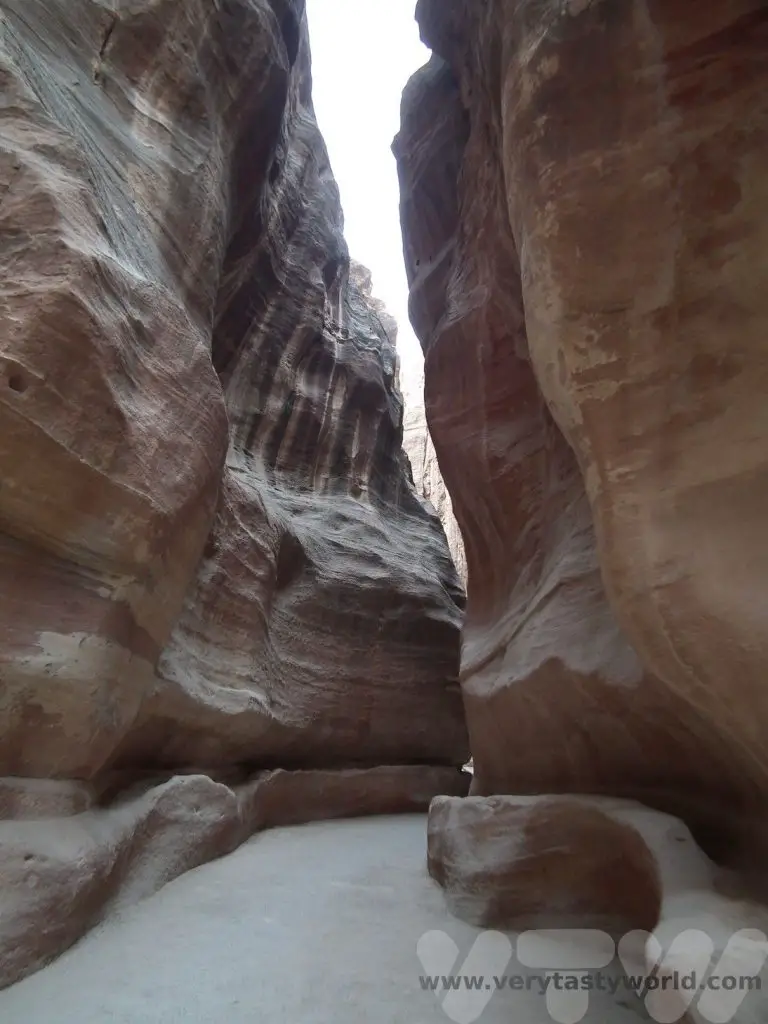
Then, at the end of the walk, you get a tantalising glimpse…
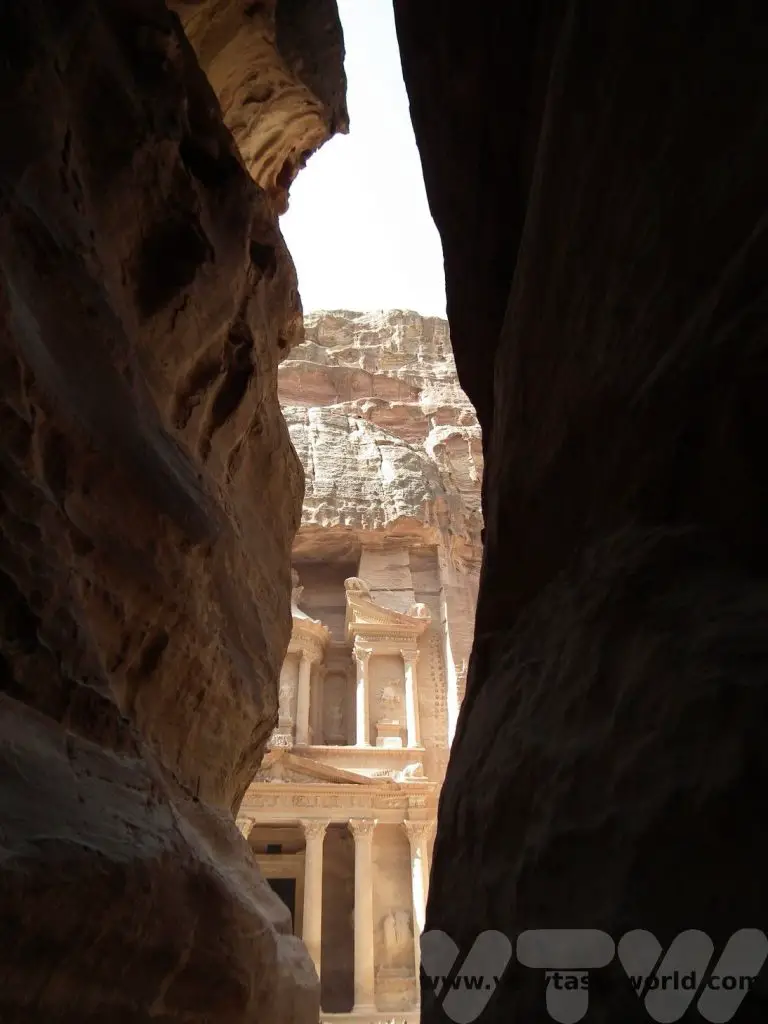
…of the Treasury, Al Khazneh. It’s actually a tomb of a 1st century Nabatean king. It’s about 30m wide and over 40m high. As with all the tombs at Petra, it was carved from the top down. (This process is similar to the amazing underground churches of Lalibela in Ethiopia.) You can see lots of indentations in the sandstone at the side of the structure. No-one is really sure about what they were for, but they could have been used by the craftsmen and masons for climbing to the top.
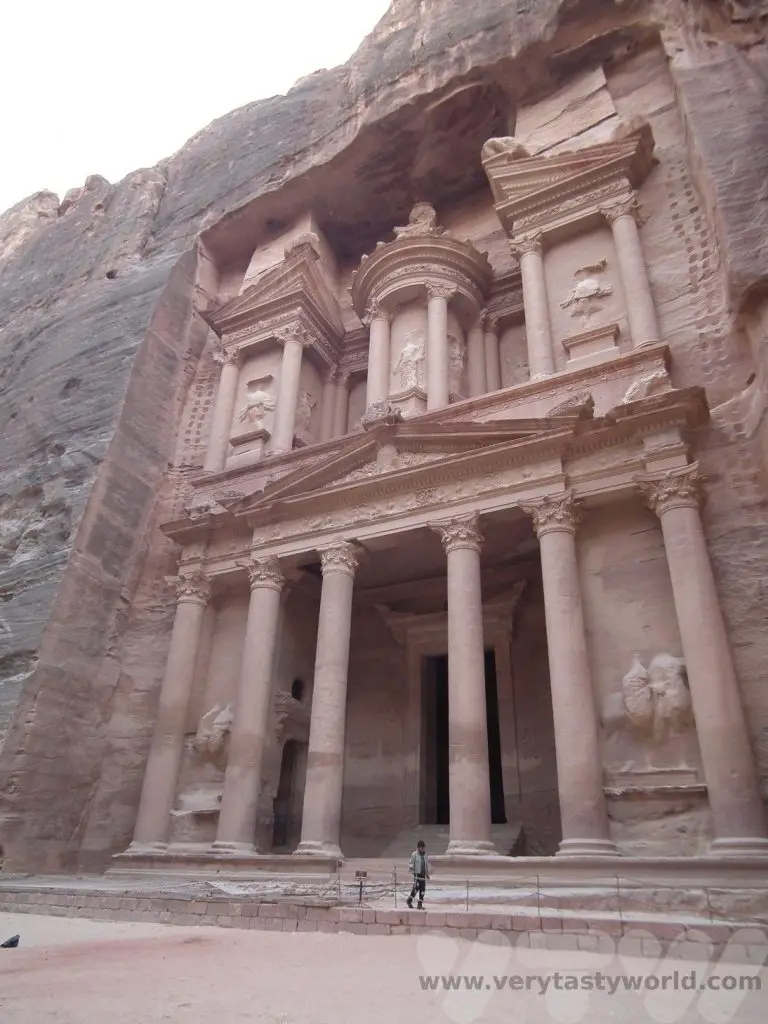
Inside Petra – Exploring The Site
The Treasury is just the start. It’s the only place you are not allowed to go inside. Everywhere else is open for exploration. There are no restrictions and no barriers so you need to take care.
From the Treasury you follow the Street of Facades, which has rows of tombs, all intricately carved from the rock.
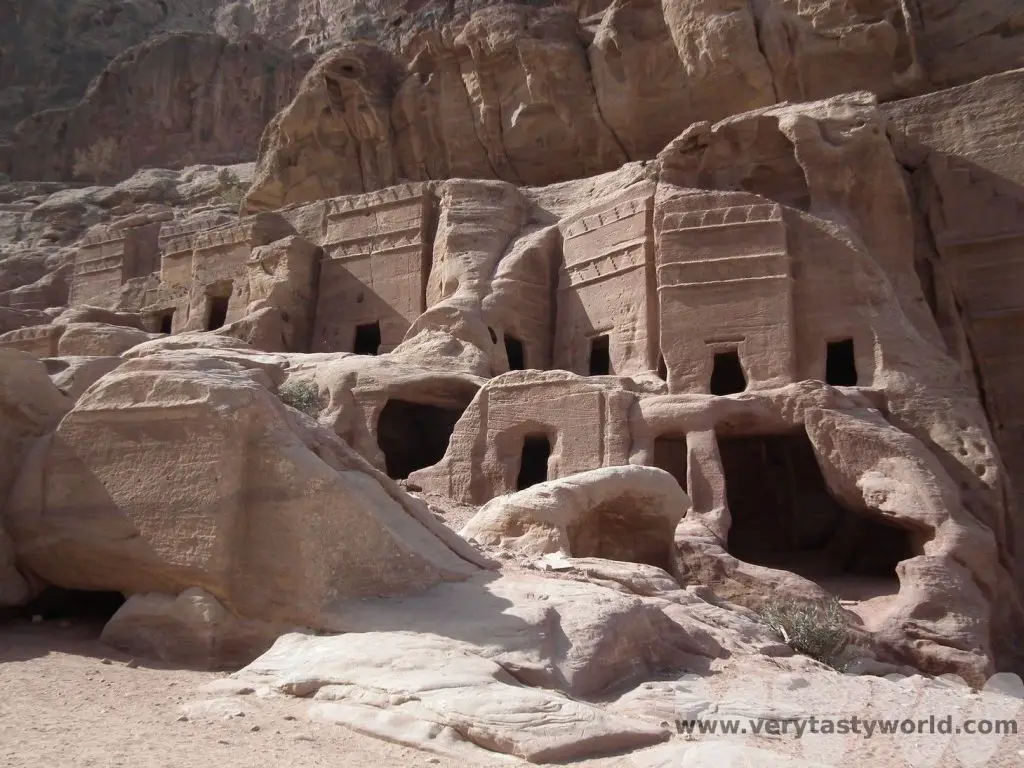
At the end of this street is the amphitheatre, carved into the rock, which appears to have a Roman influence. Its maximum capacity was around 7000 people.
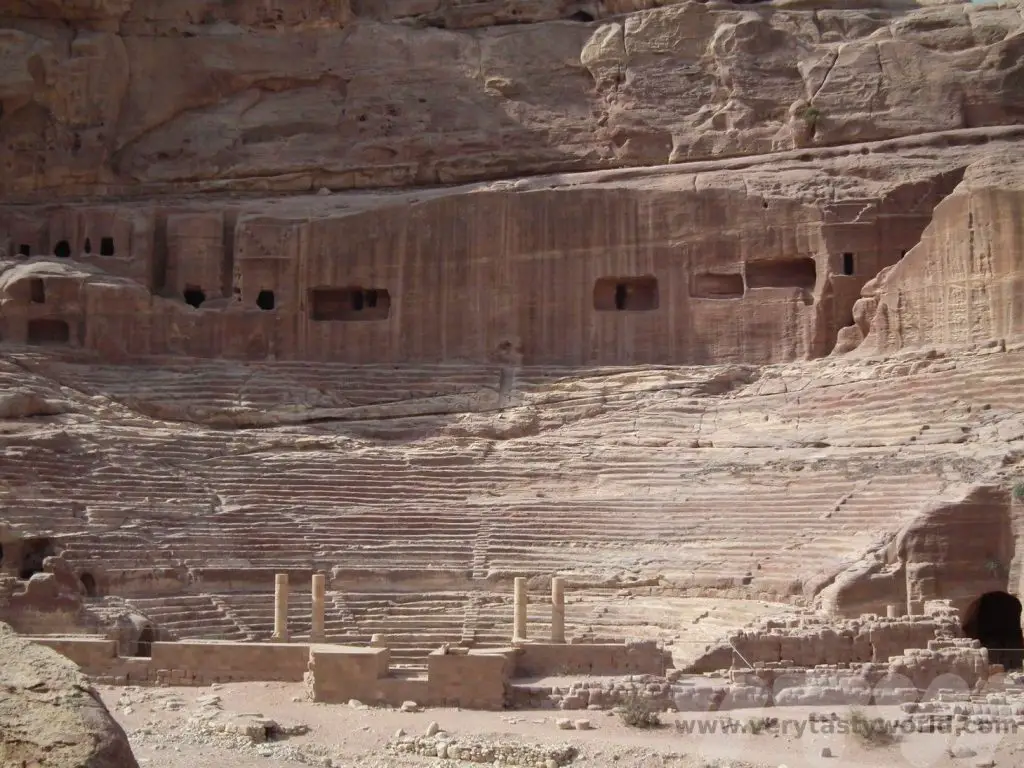
At the end of the street you can see further Nabotean tombs to the right…
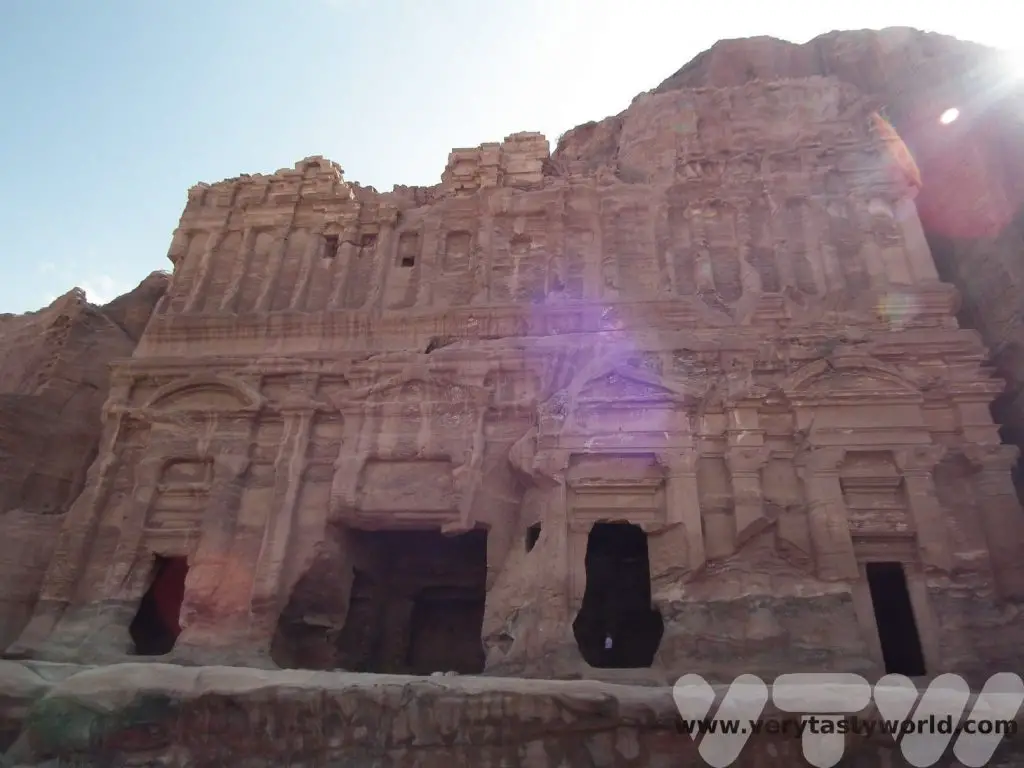
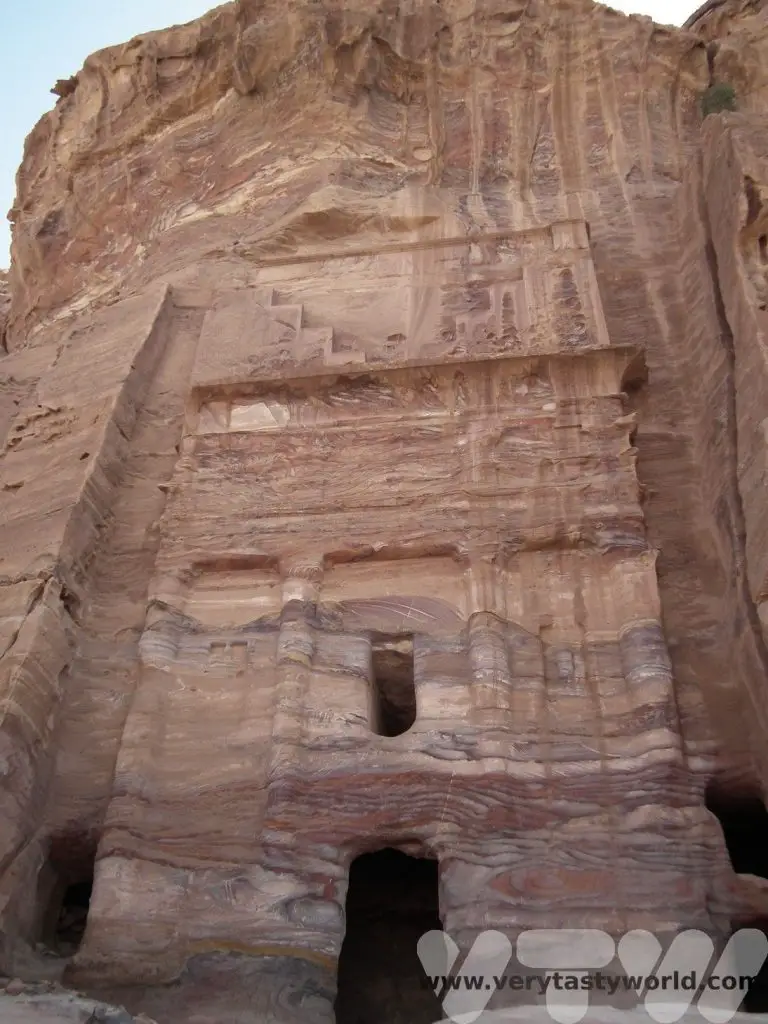
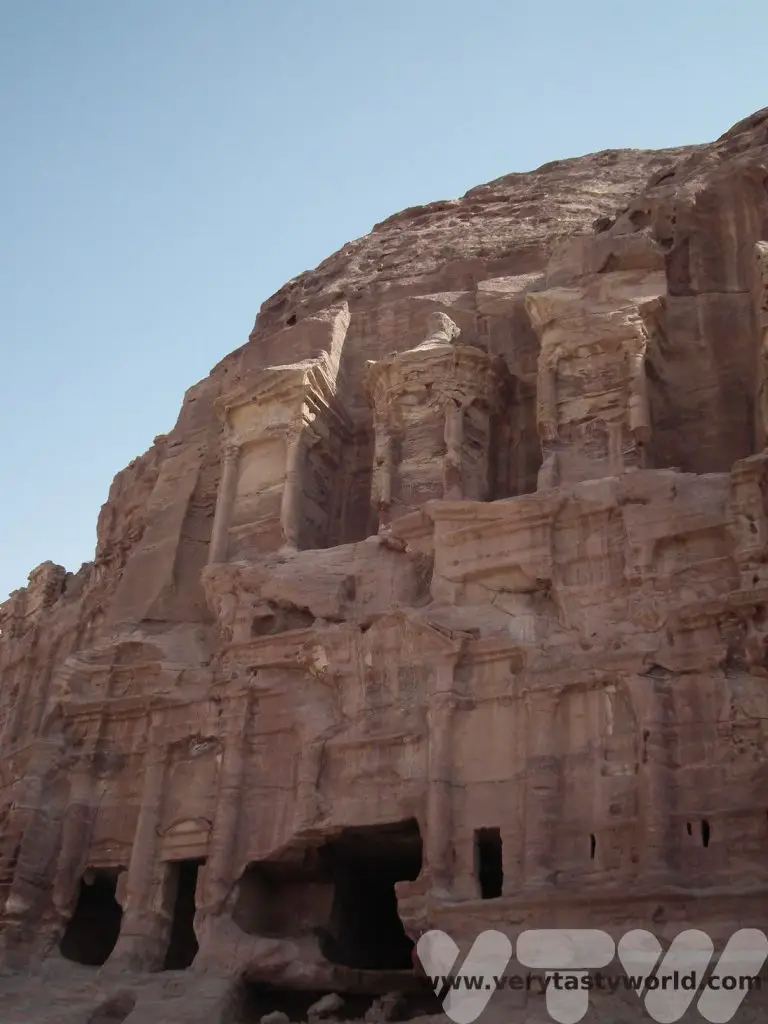
It is possible to wander inside these tombs.
If you make a left turn you will walk along a colonnaded street, with marble pavement much of which is still preserved, which was effectively the city centre. It would have been lined with temples and public buildings.
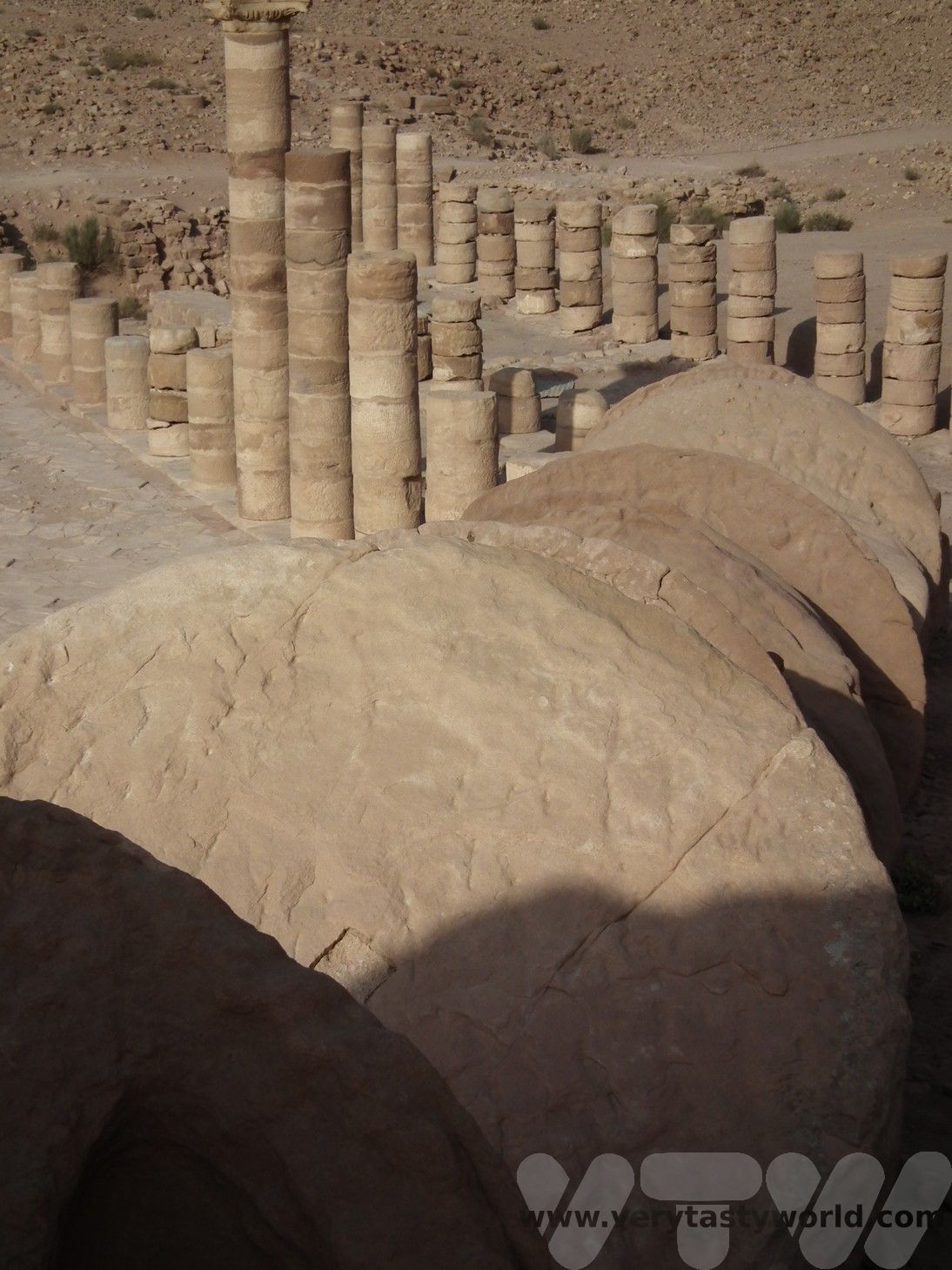
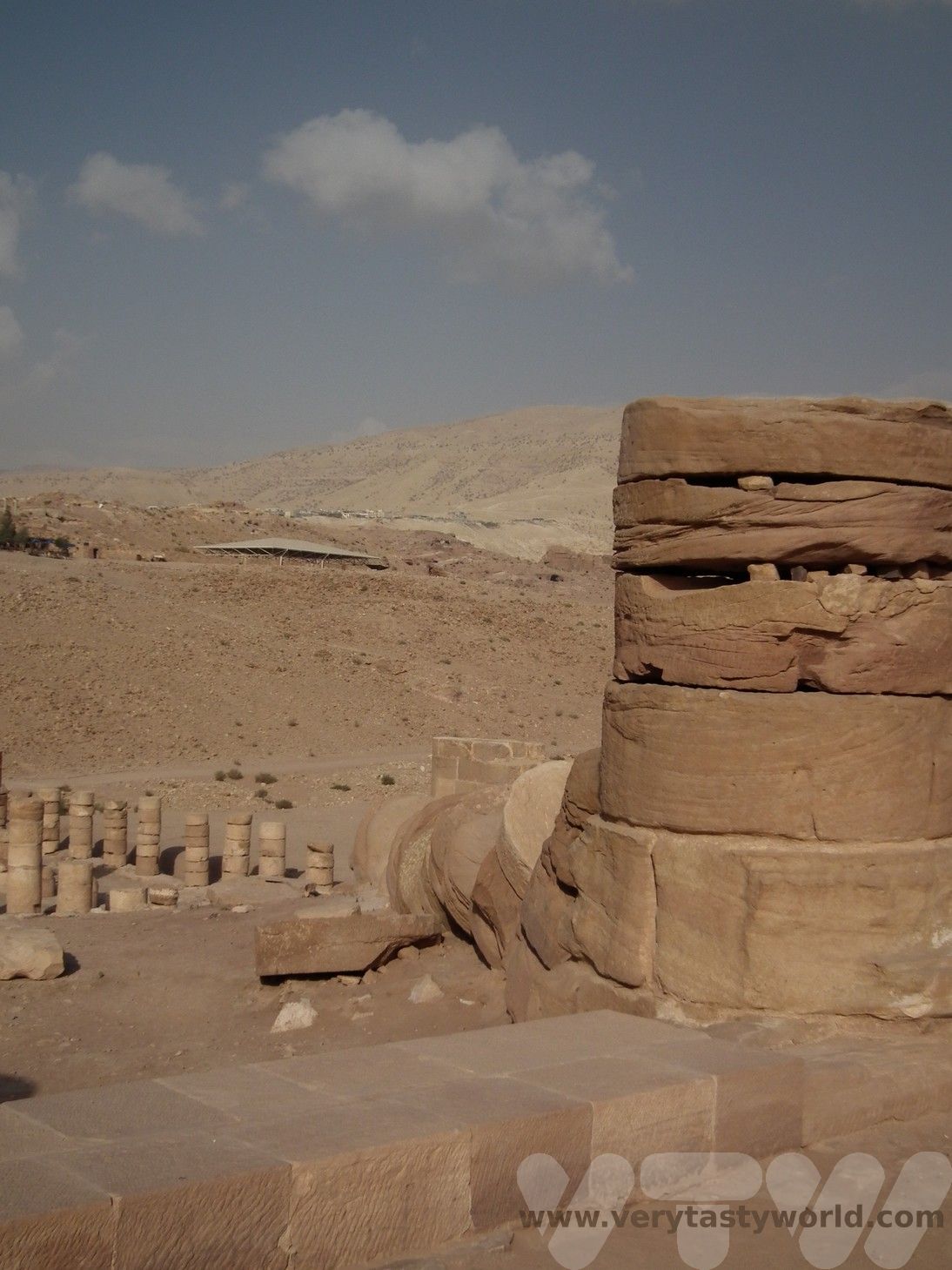
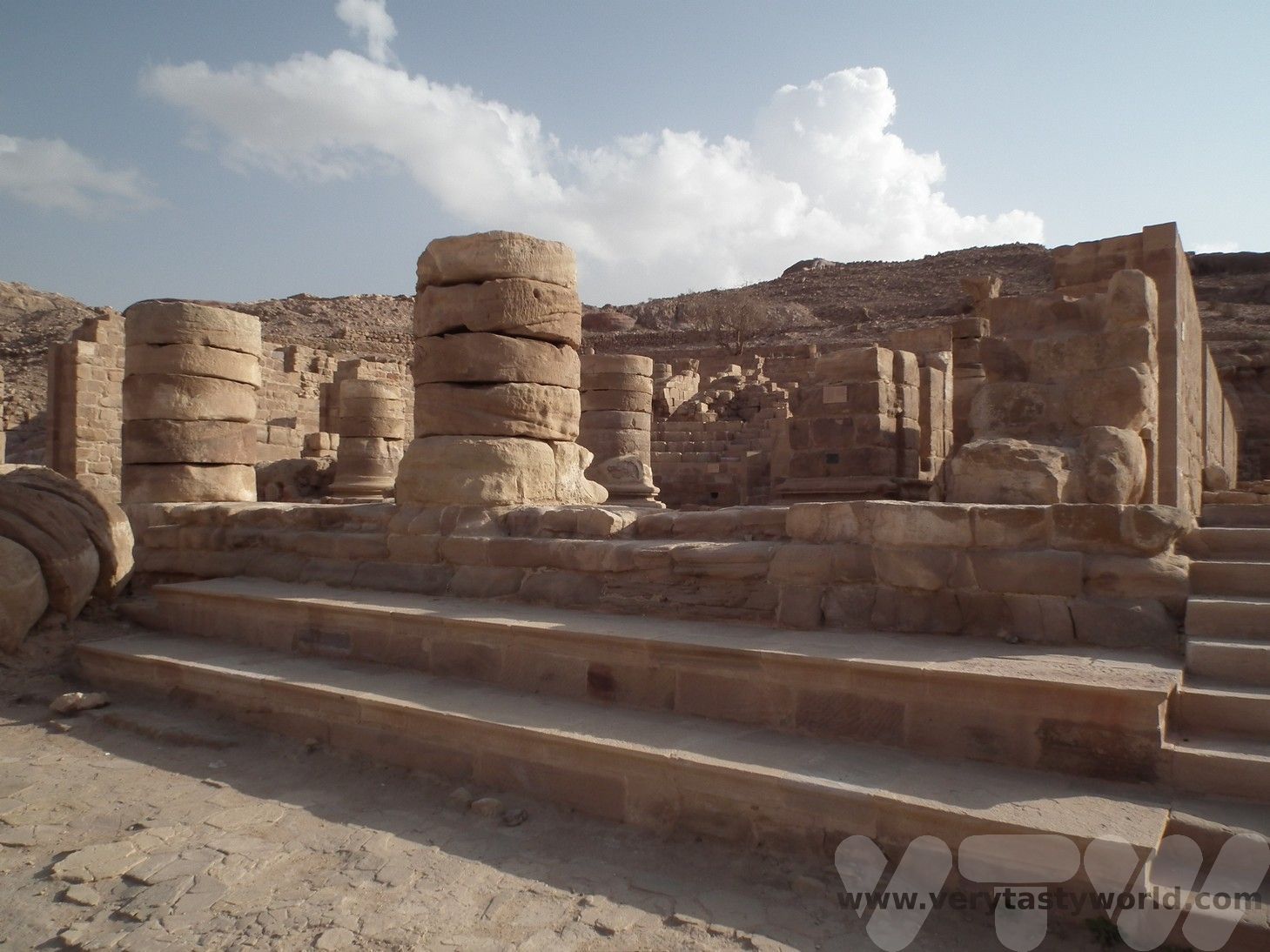
At the end of the street is the route to the Monastery.
The Monastery
We climbed 800 steps to Ad-Deir, The Monastery, which we found to be a moderate walk. It is classed as difficult on the trail guide because some of the steps have worn over the years. We needed to scramble a little on some sections.
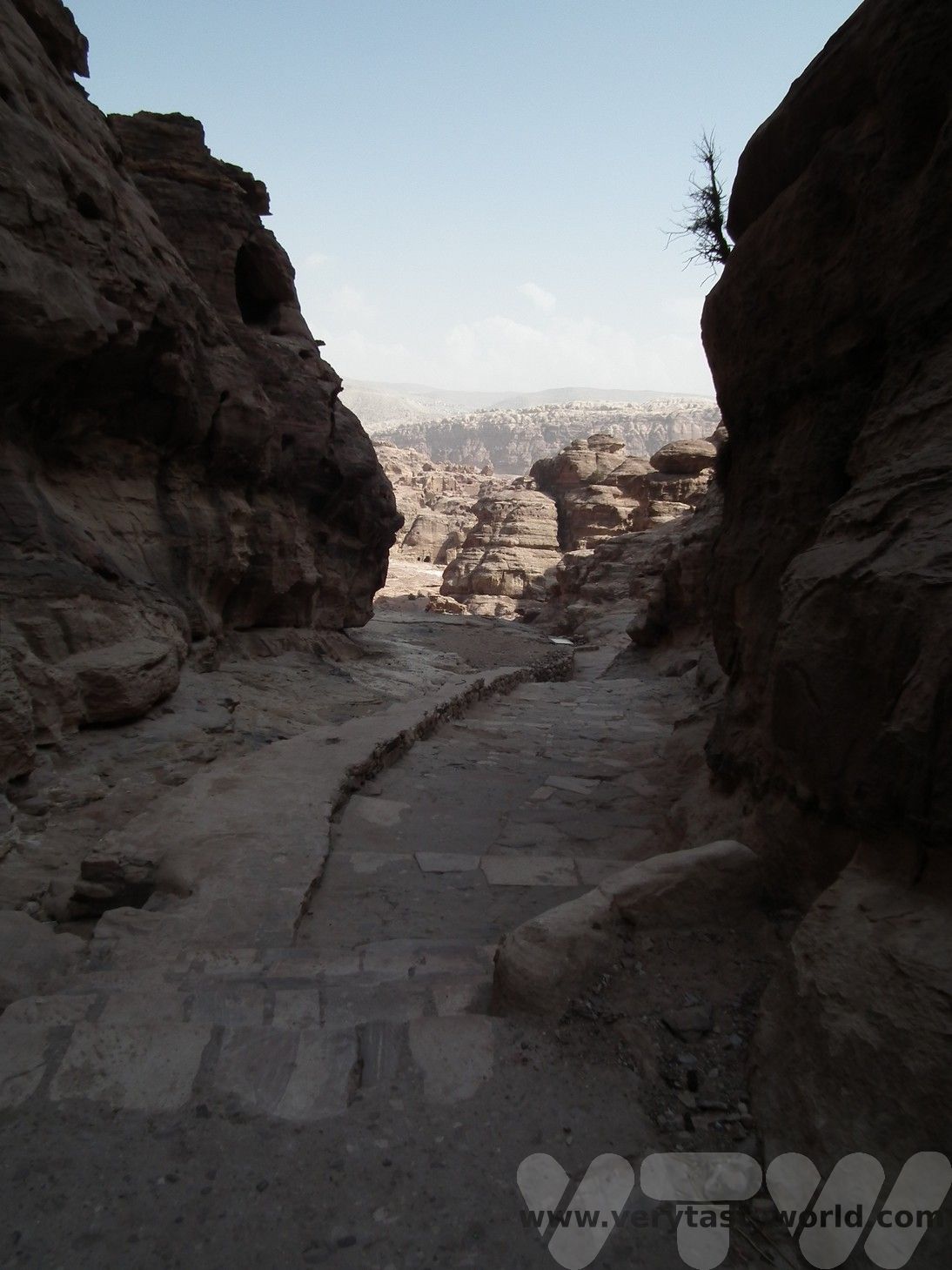
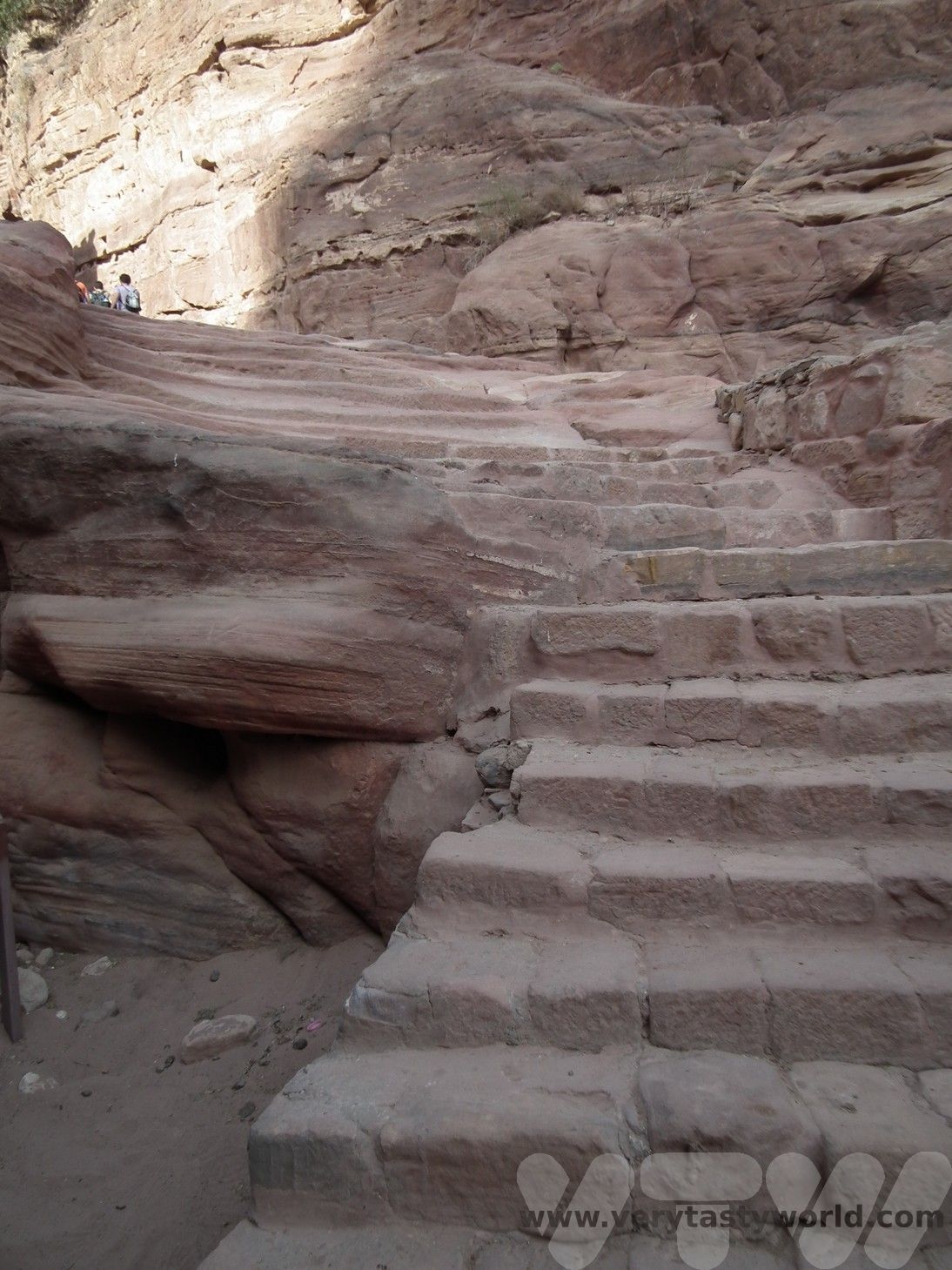
When we arrived we were delighted to discover that the Monastery was as spectacular at the Treasury.
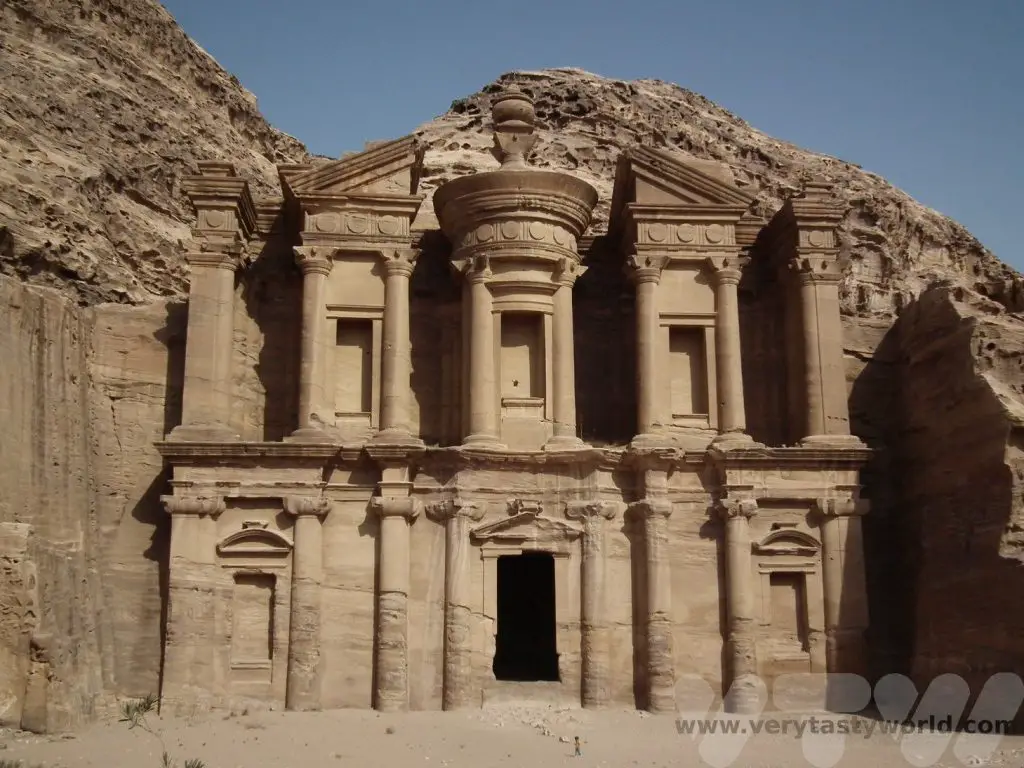
If you look closely at the photo below you can see a man sitting on the building, high up on the central colonnade. We had watched him climb all the way up the adjacent cliff face and then onto the building itself, leaping across the colonnades with absolute confidence – an amazing form of parkour. It was utterly terrifying watching him.
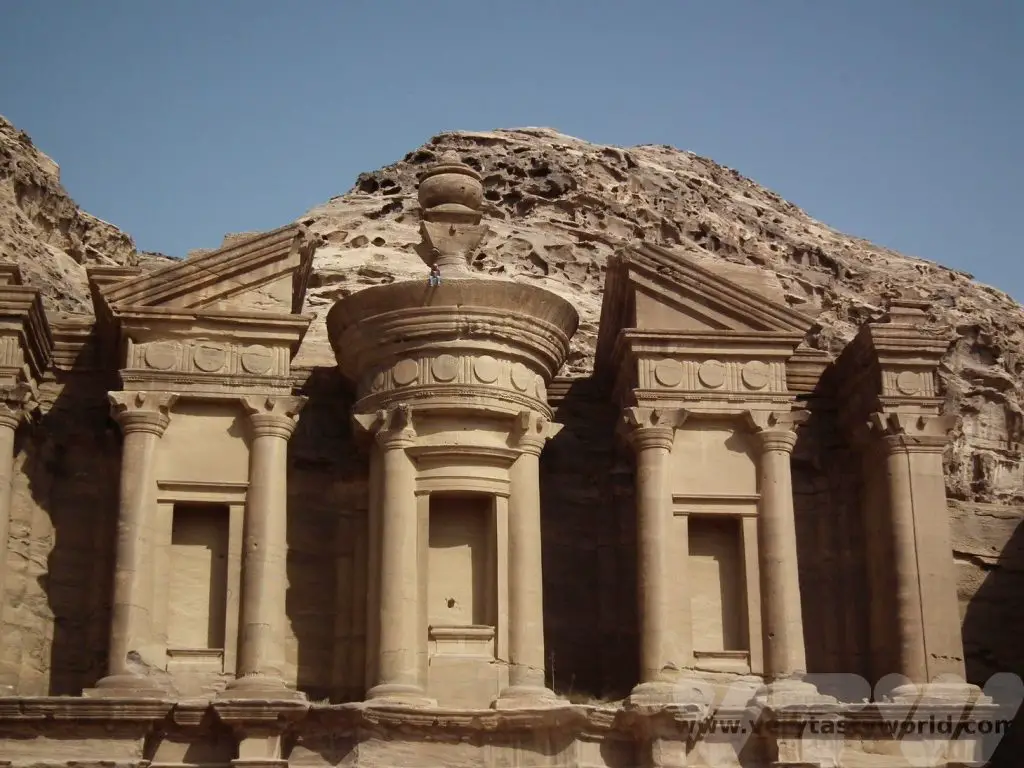
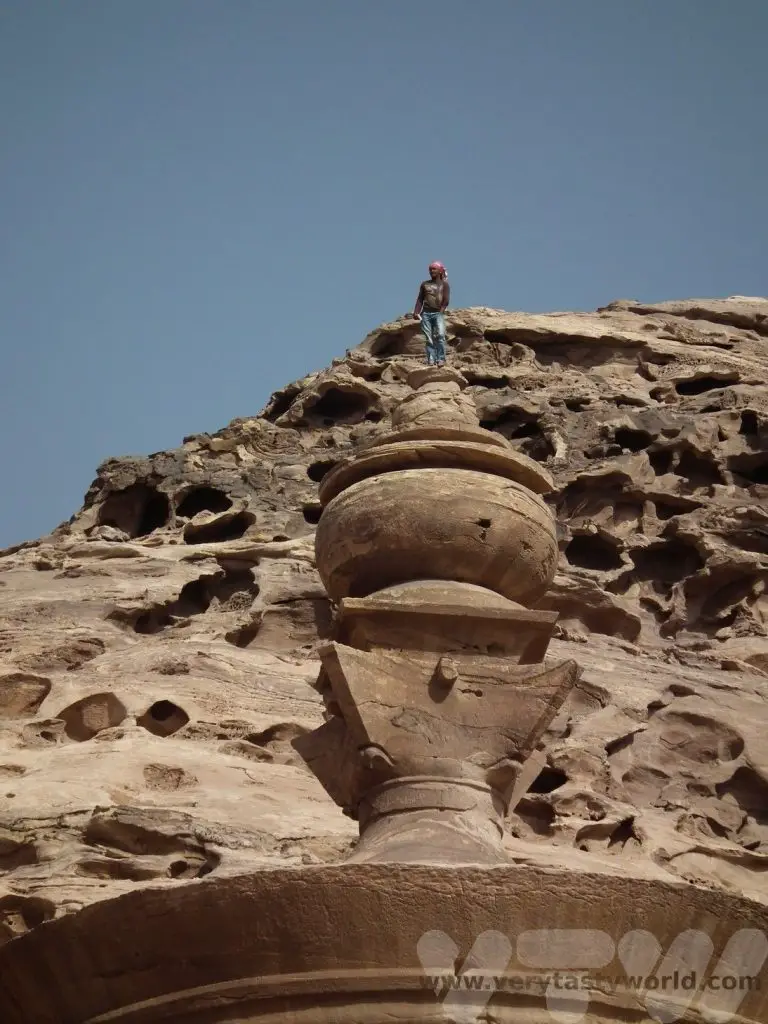
You can enter the Monastery although there is not much to see inside – a cavernous space.
Exploring The Trails At Petra
There are numerous trails you can follow, some of which involve pretty tough climbs where the stairs have been eroded. The guide indicates the options available and the trails are well marked with brown signs.
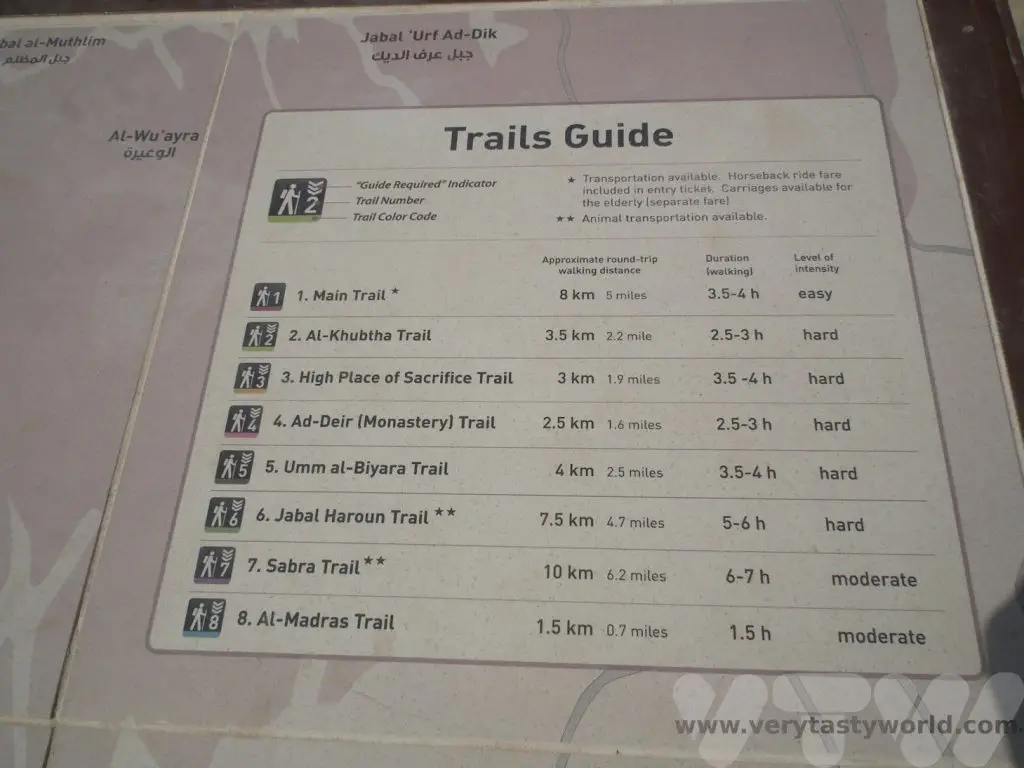
The other walk we enjoyed was the Al Khubtha trail, a climb to view the Treasury from above. The path is a little uneven and there are several hundred steps to climb. But the view was fantastic when we reached the summit.
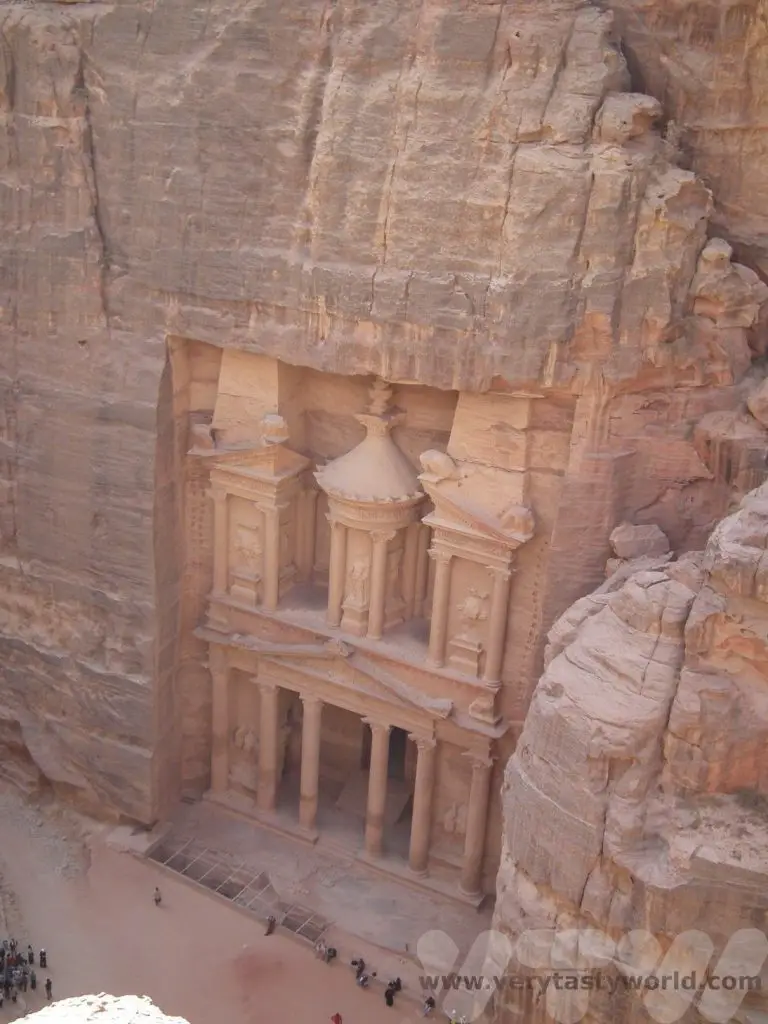
Inside Petra – The Colours Of The Tombs
We also really loved the colours of the rock as we explored the various tombs. The white is silica, the red is iron oxide and the yellow, sandstone.
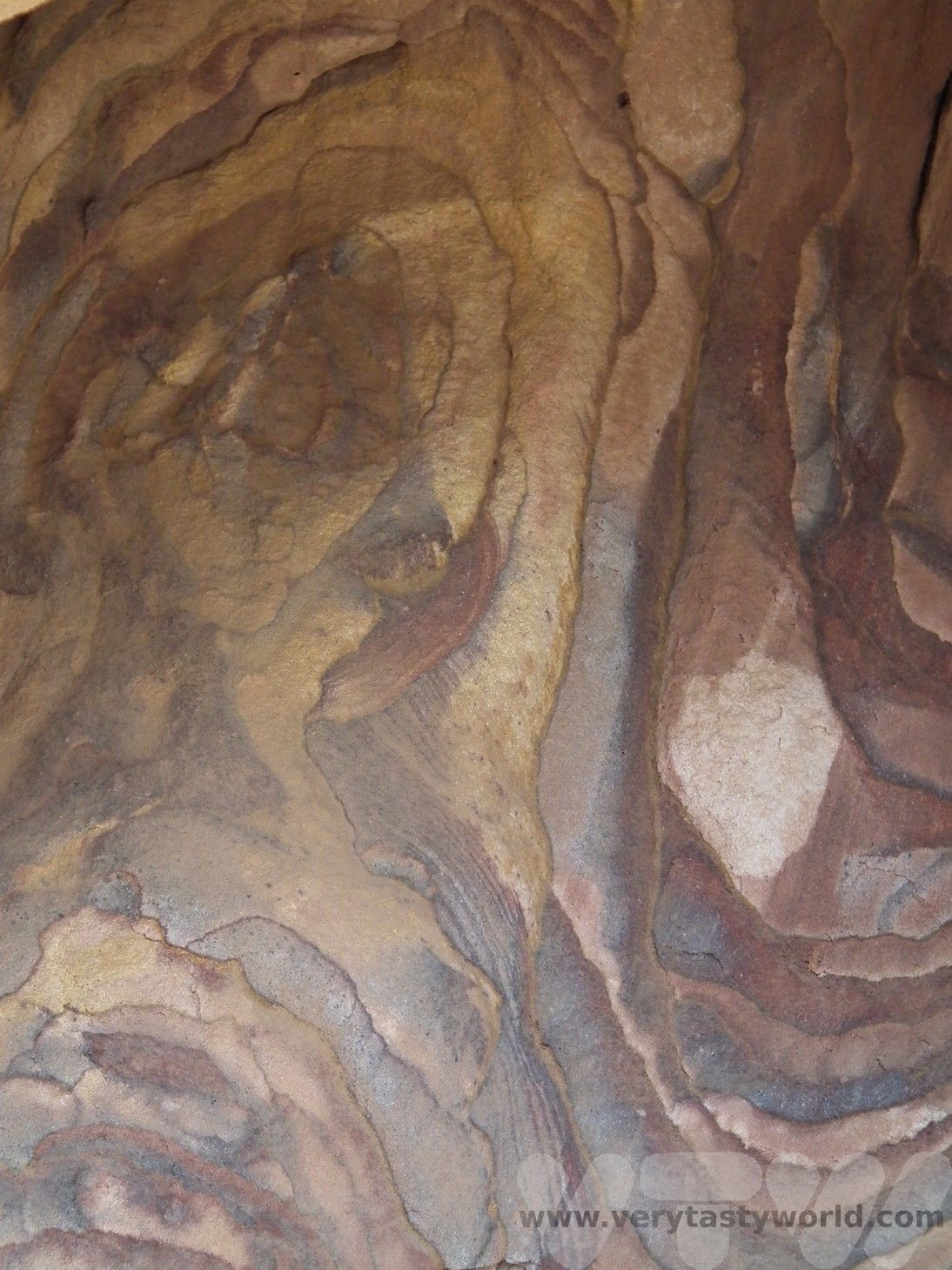
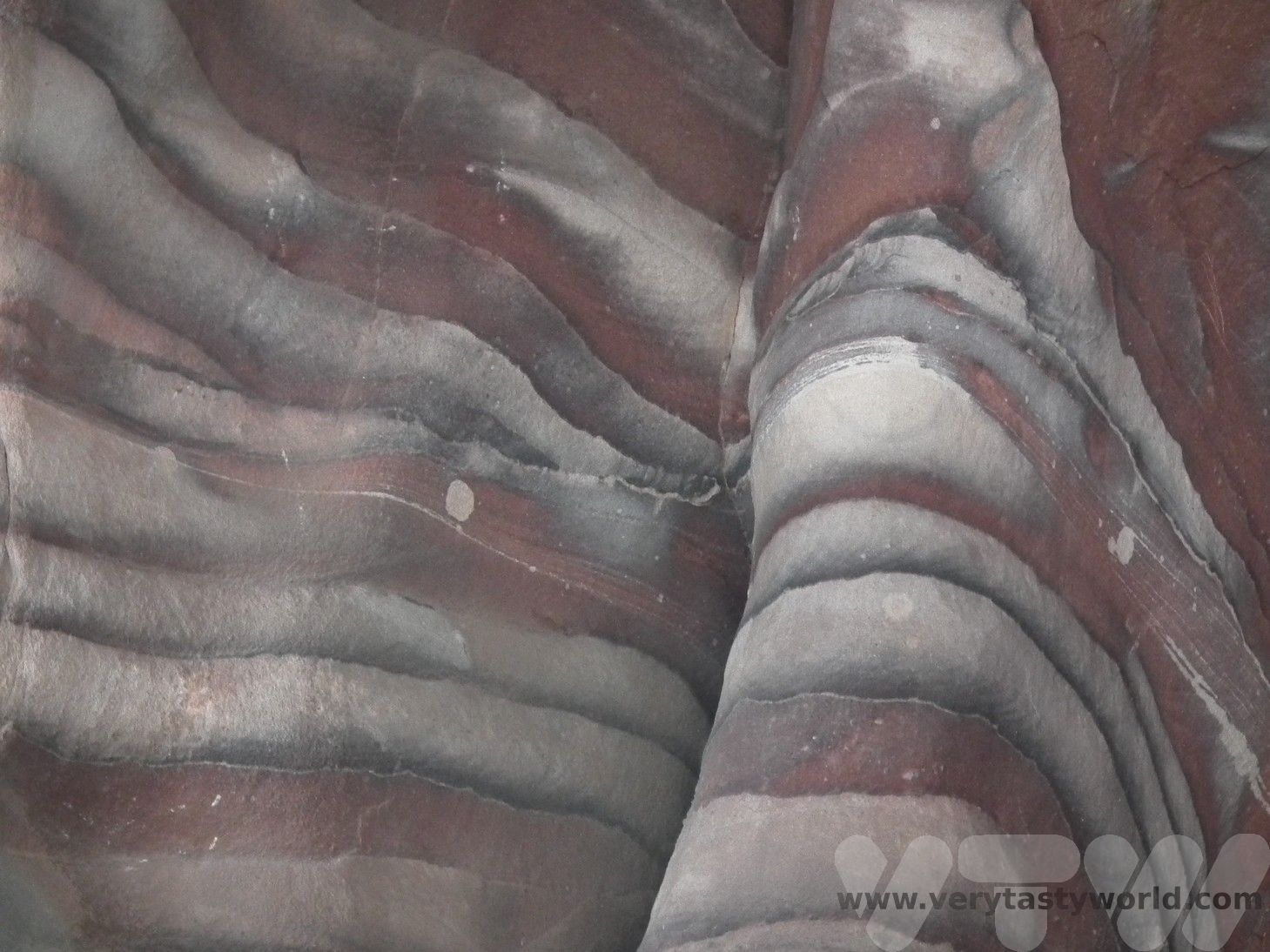
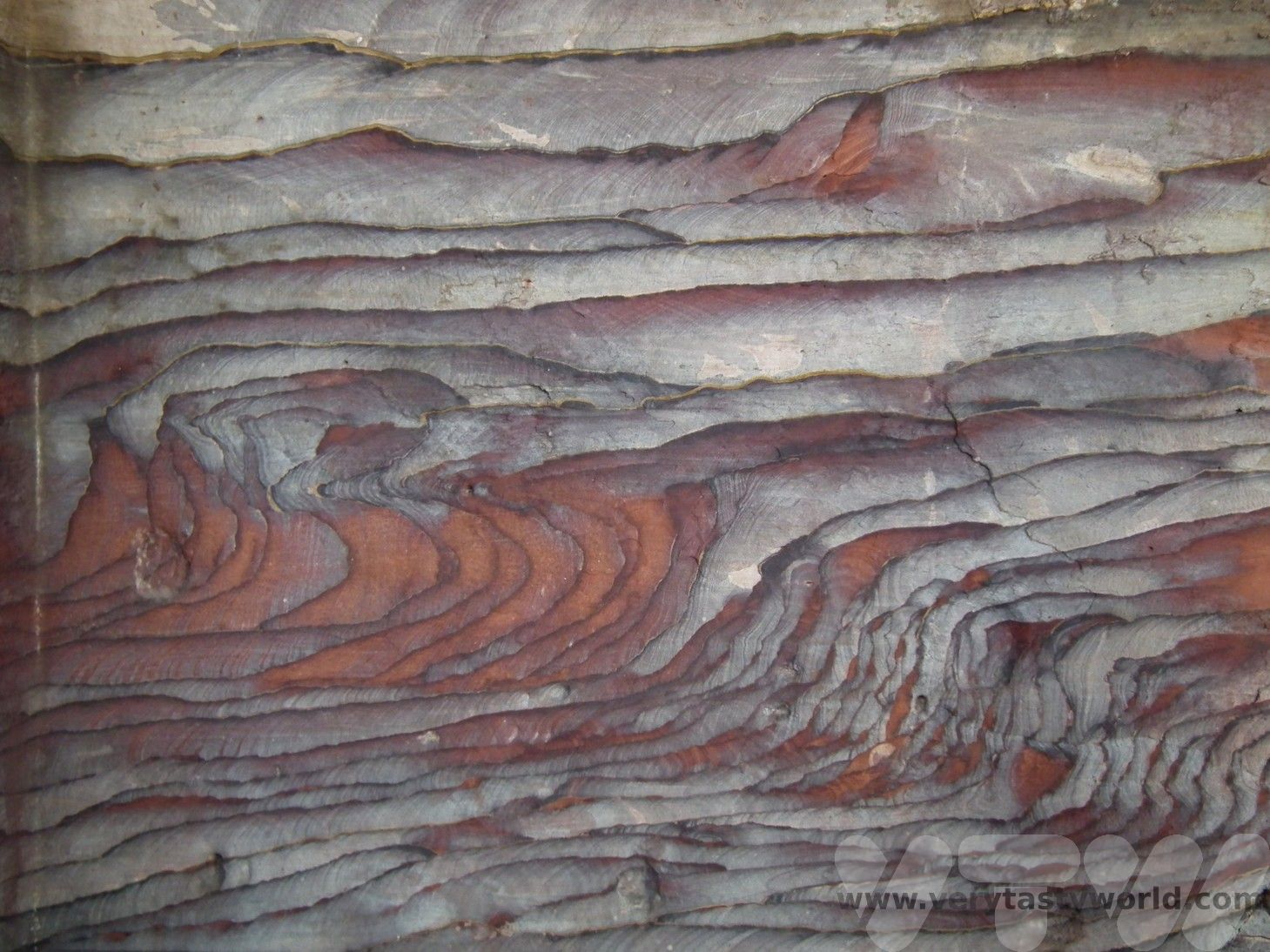
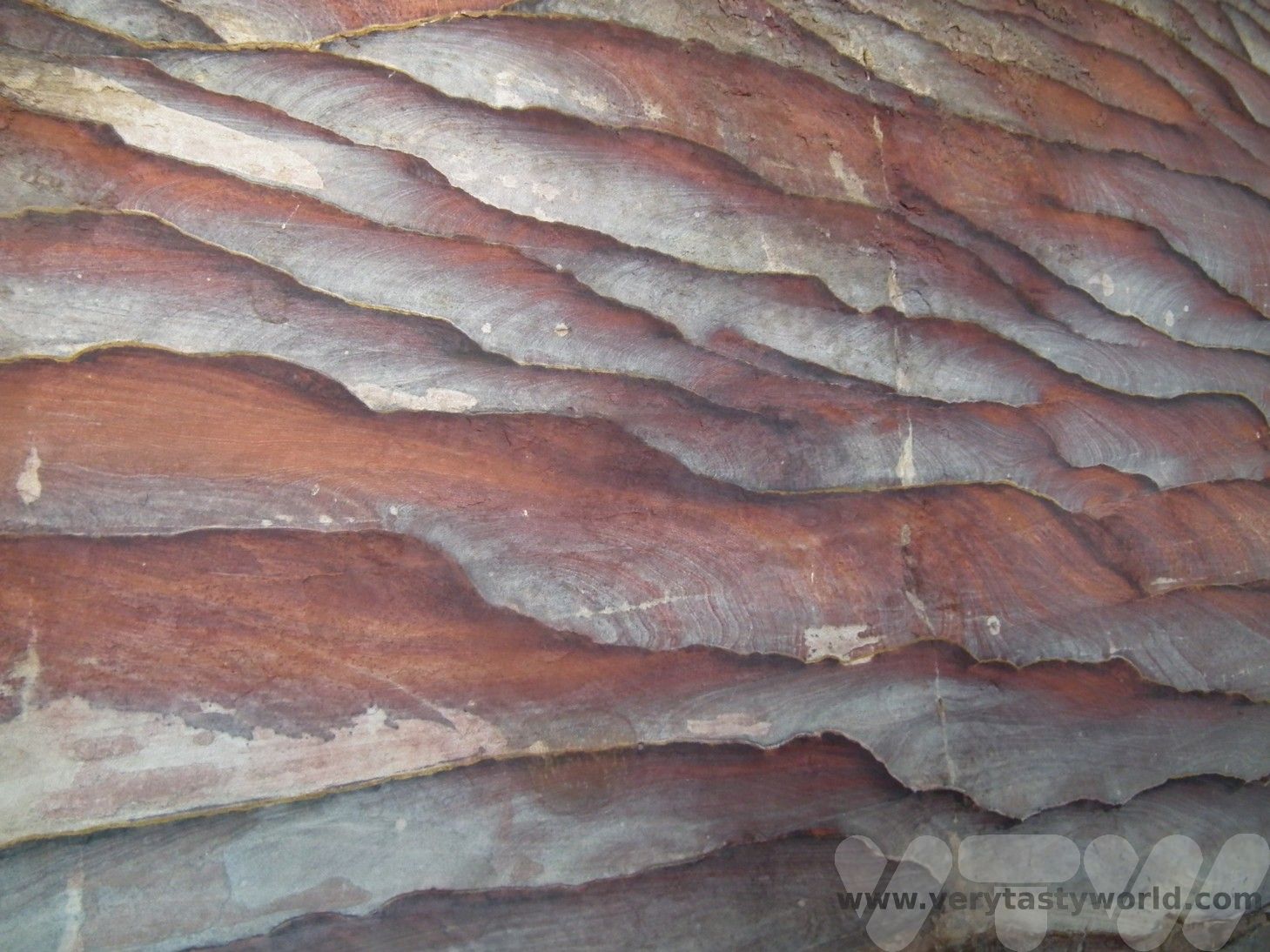
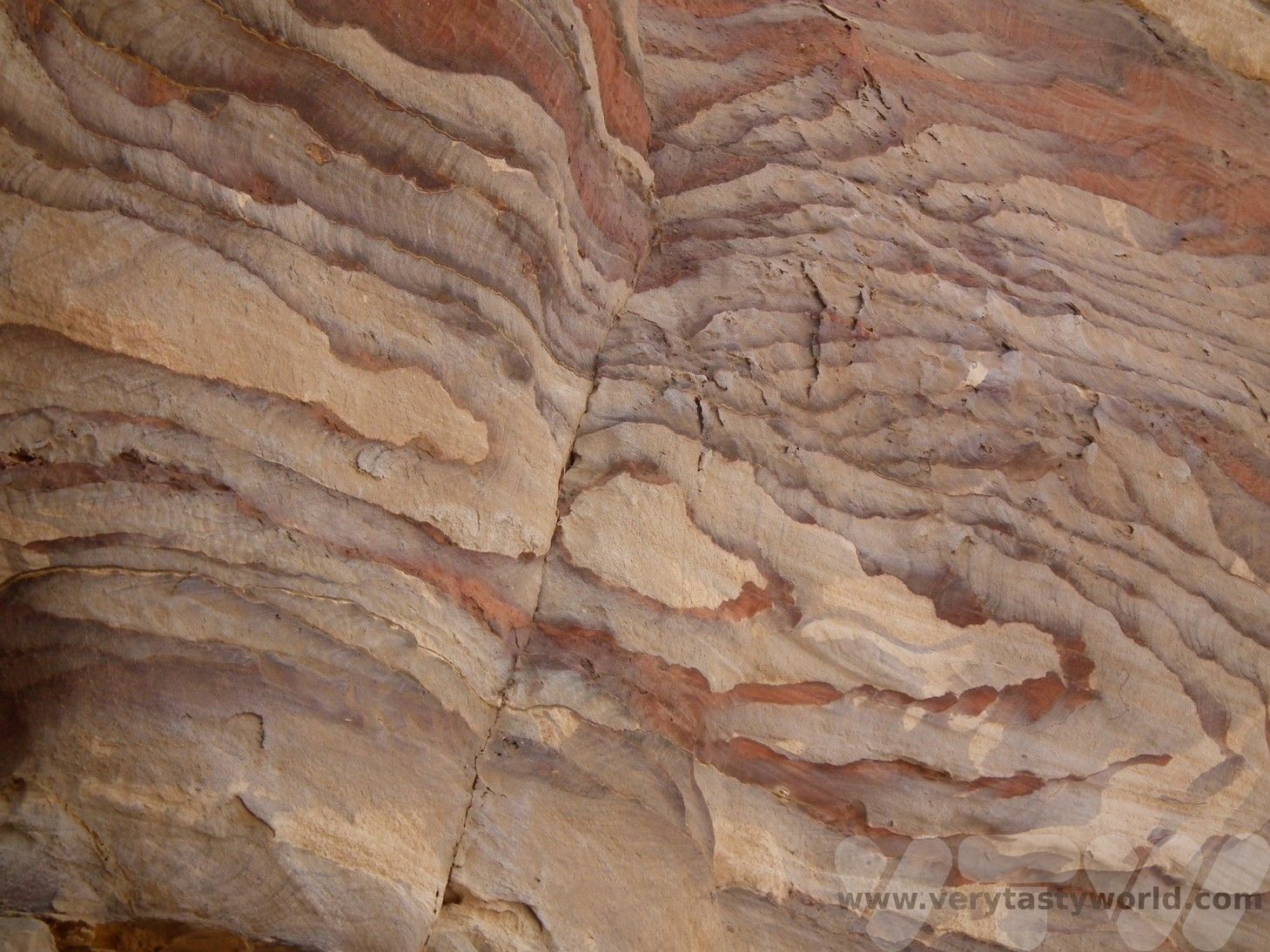
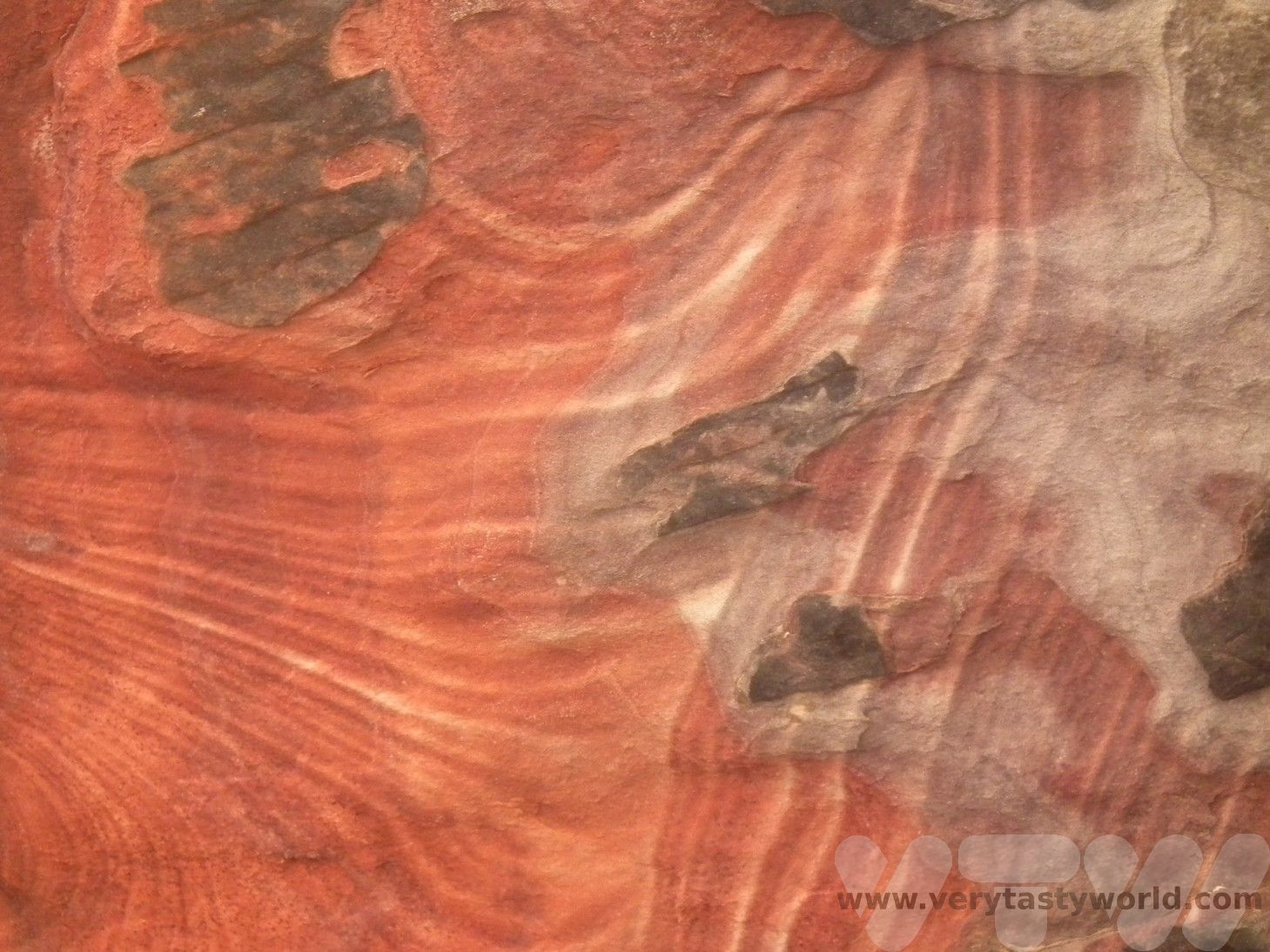
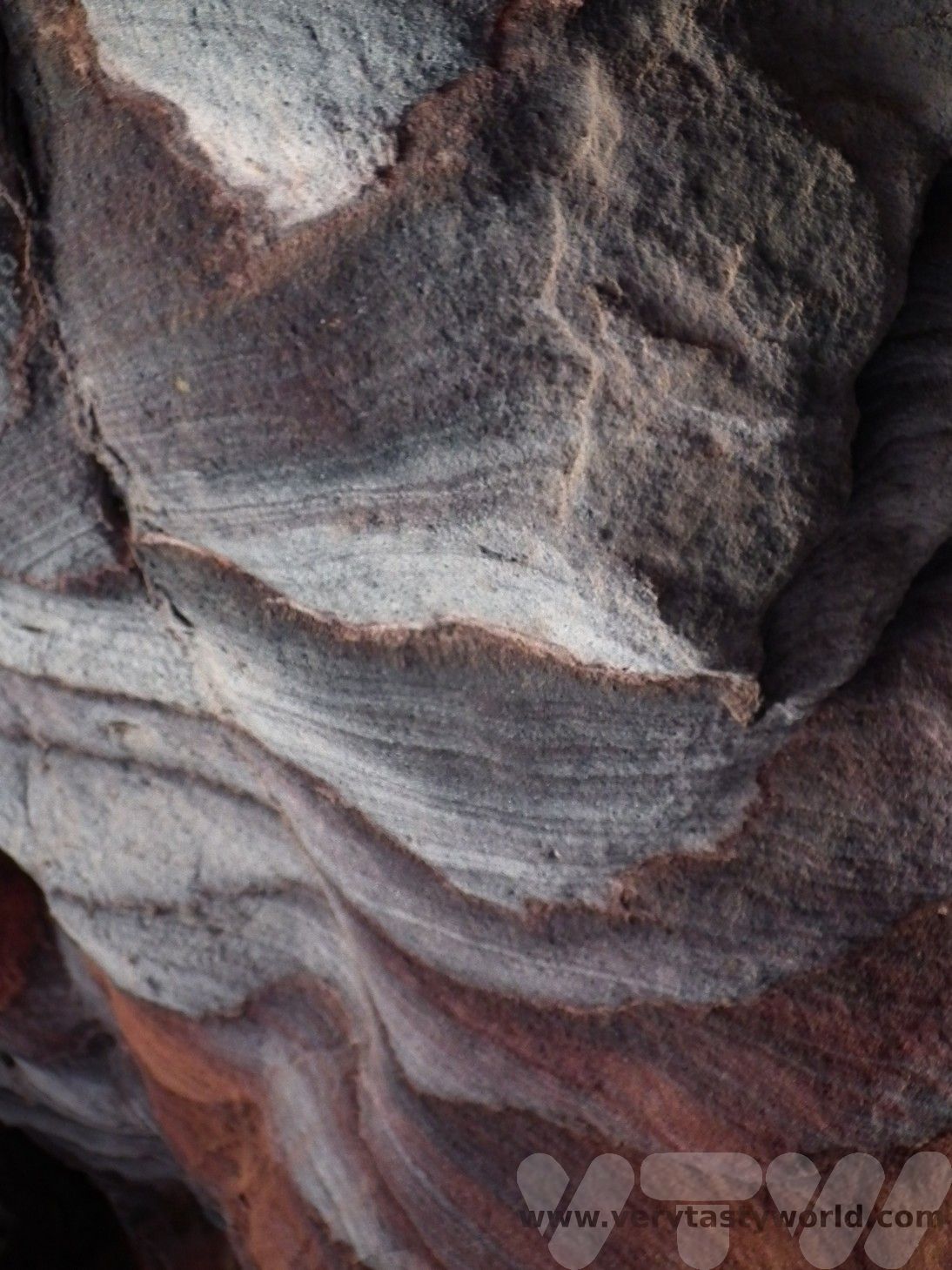
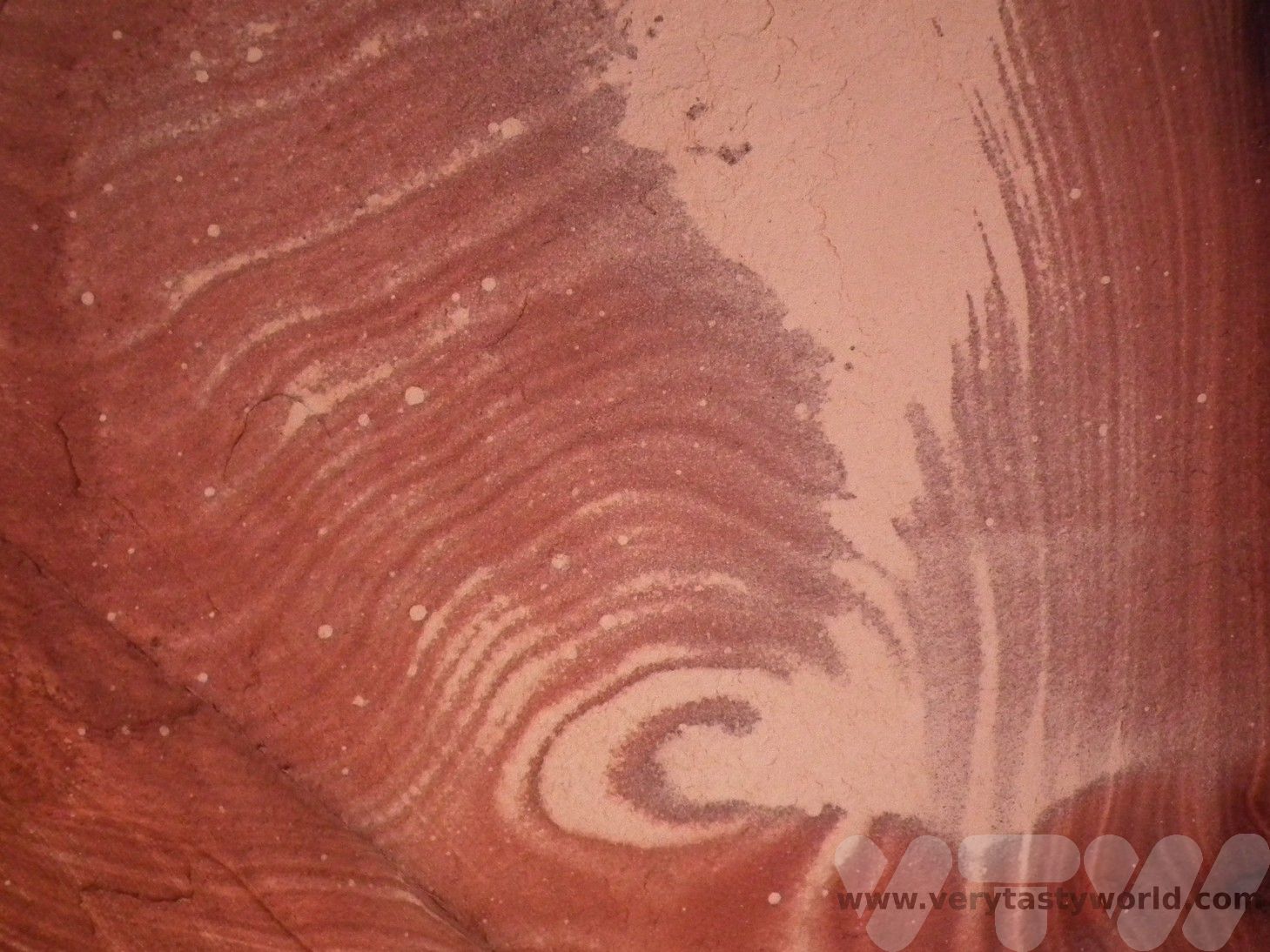
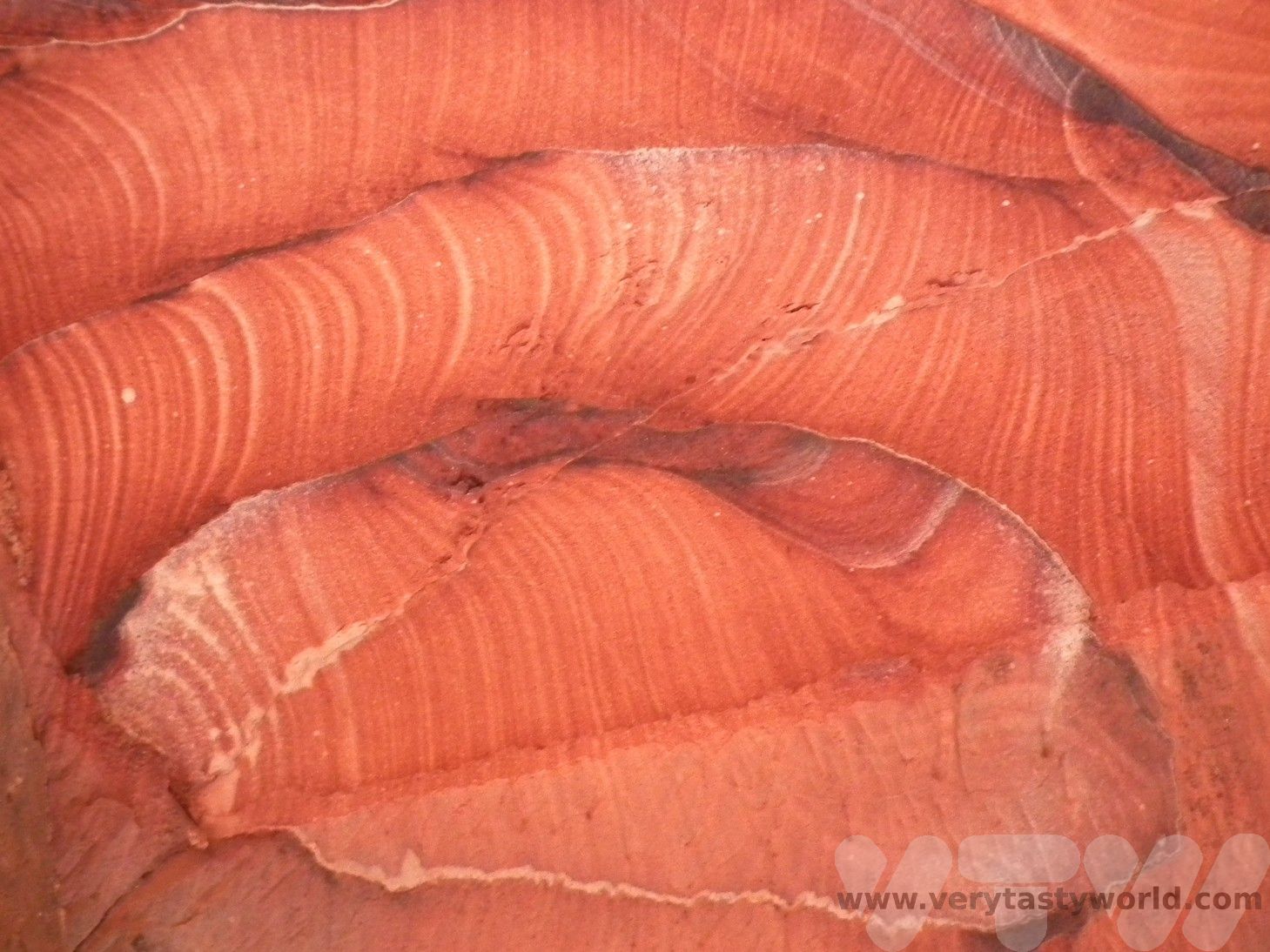
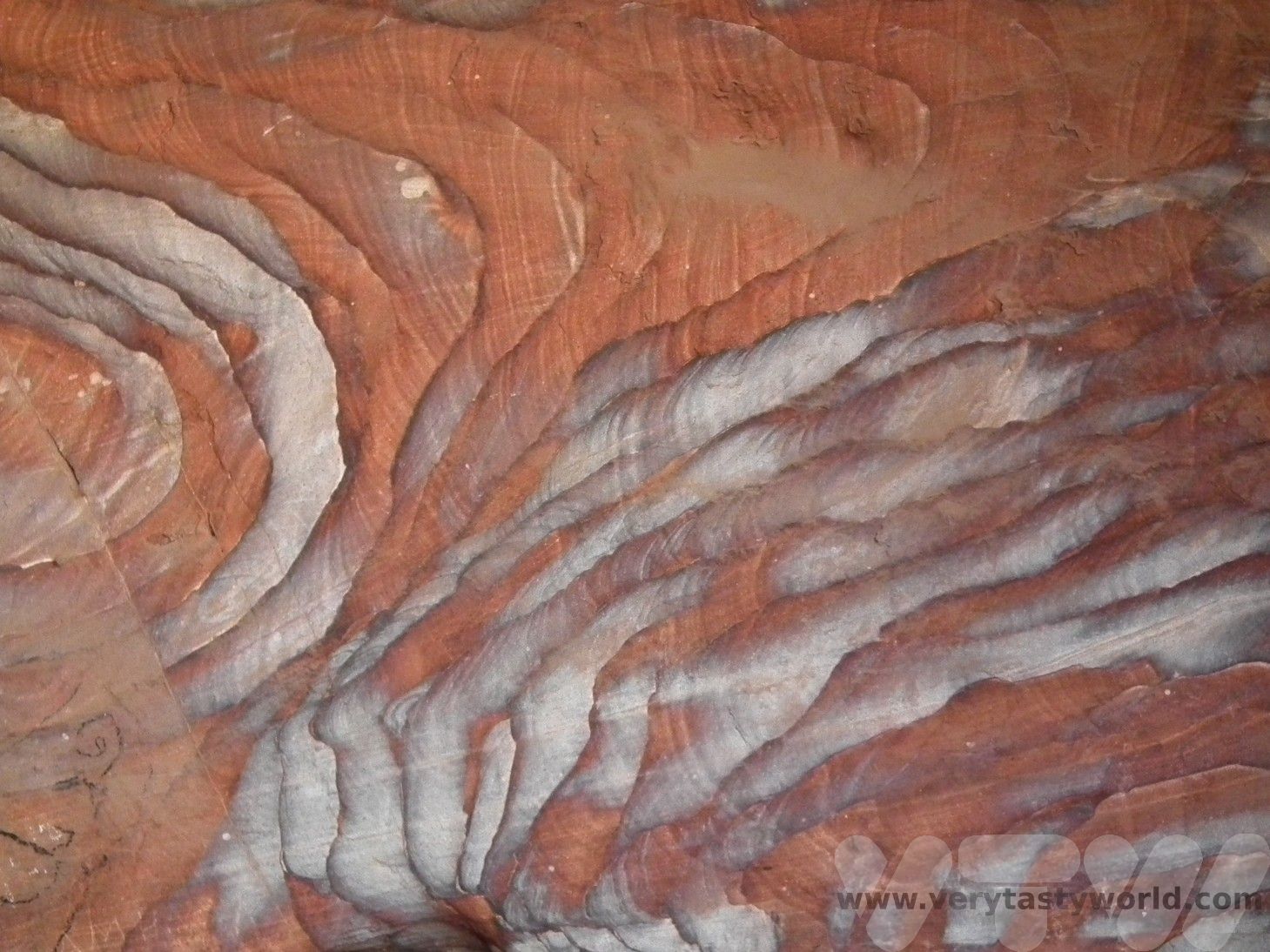
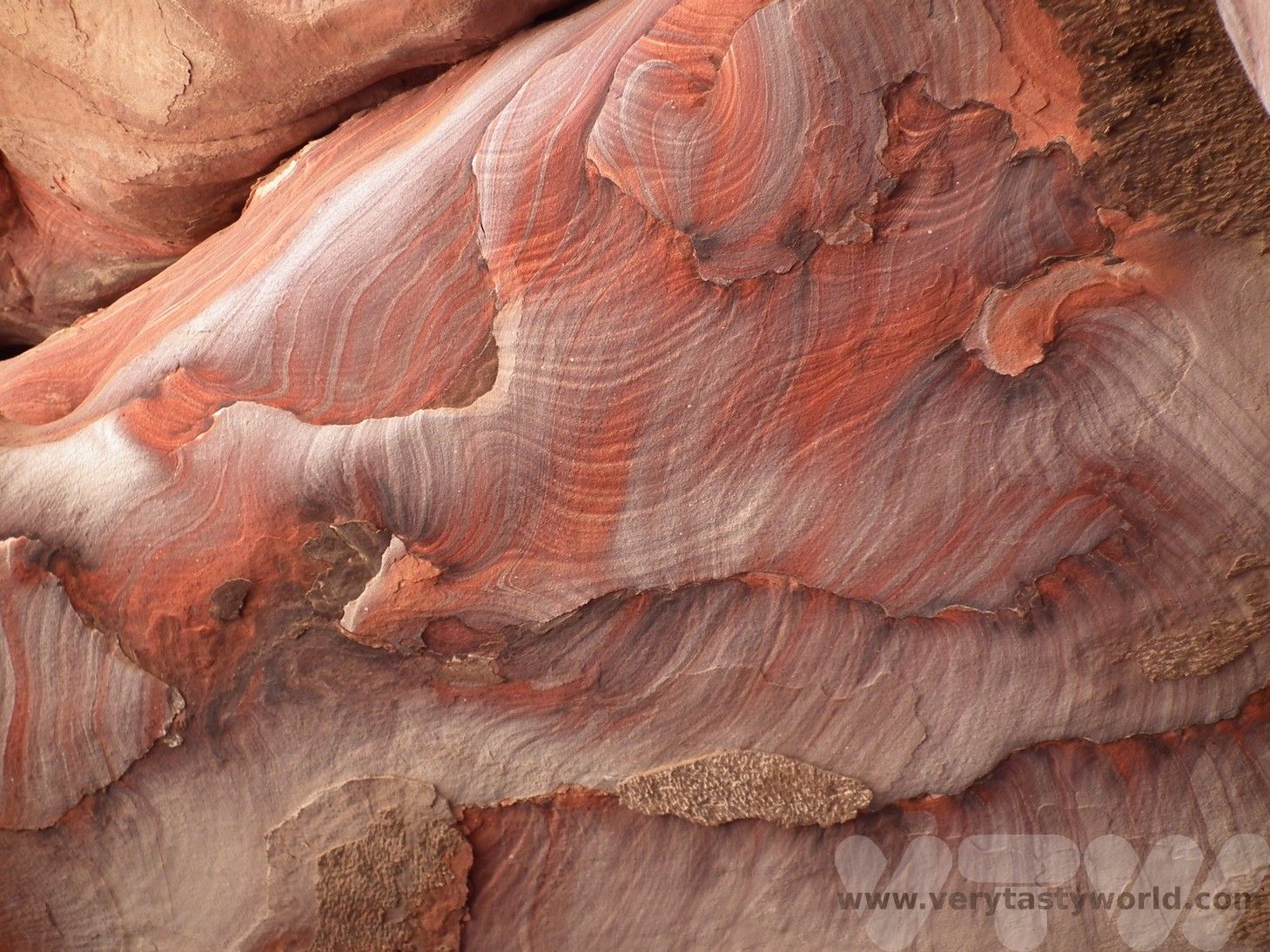
It is possible to see a night-time sound and light show at the Treasury. Walking through the Siq in the dark to see the Treasury lit up by lanterns is an ethereal sight.
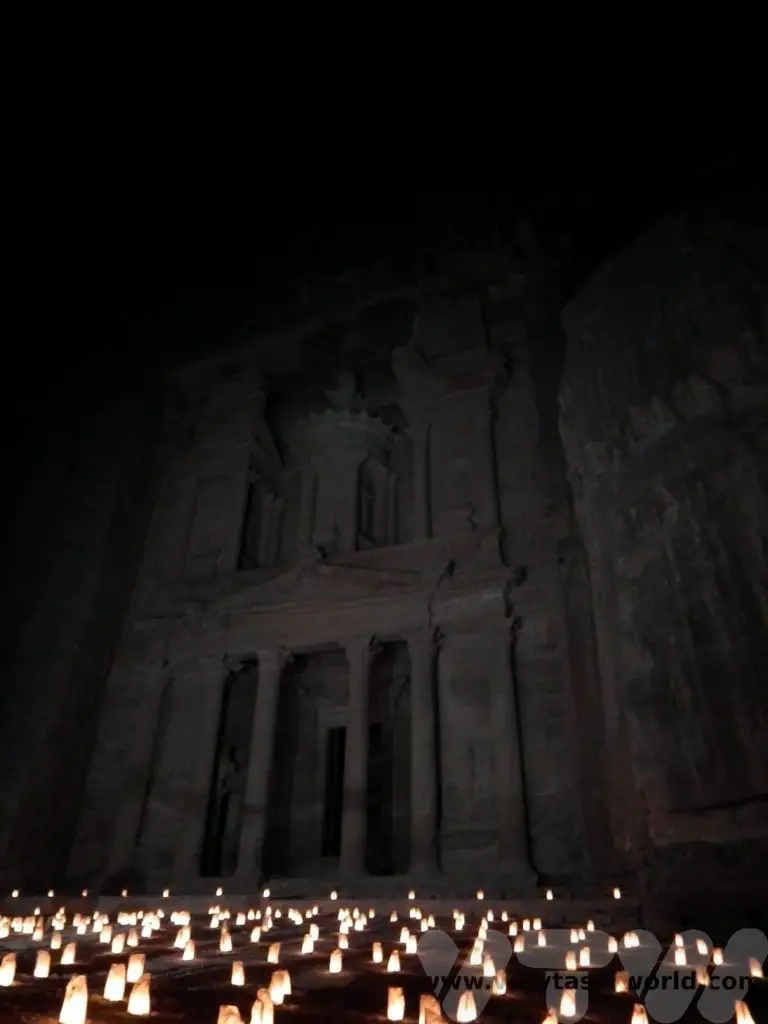
What To Bring Inside The Petra Site
There are restrooms on site at either end of the colonnaded street and nearby cafes which offer refreshments. We recommend the lemon juice with mint – it’s refreshing and delicious.
It’s advisable to wear a sunhat and use sun protection if you are exploring the walking trails as there is no shelter from the sun. Good walking shoes are advisable. Make sure you carry water with you. Use the bins provided to dispose of rubbish.
Keep on the trails. You may meet local people as you walk – we ended up chatting with some people on the Al Khubtha trail and were invited to enjoy a cup of tea with them. (We weren’t asked for money but we did offer a contribution towards the tea.)
After Your Visit – A Foodie Evening At The Petra Kitchen
After a full day’s exploring we were pretty tired and there’s not a lot to do at Wadi Musa. But we did manage to join a cookery course at the Petra Kitchen on one of the evenings. One of the chefs was the uncle of the guide who showed us around the site. We learned to make Jordanian food and then eat it – a fine way to spend an evening. We made Shourbat Adas (lentil soup), Baba Ganoush, Fatoush, Tabbouleh, Tahina salad, Galayet Bandora, Araies Iahma (Bedouin pizza – pittas stuffed with minced meat and covered with Galayet Bandora) as a mezza. The main course was Maqluba, an upside-down hotpot, which was scrummy. Sadly, we were too busy cooking – and eating – to take photos! But we do plan to cook the recipes at home and will no doubt blog about them in the future.
Related Posts You May Enjoy

Things to Do in Coventry
When you see travel guides to the UK Midlands they often mention the buzzing metropolis of Birmingham or the country towns of Warwickshire such as leafy Leamington Spa, historic Warwick with its castle, and Shakespeare’s Stratford-Upon-Avon. But the city of Coventry is often ignored, which is a shame because it has a lot of history. There are plenty of things to do in Coventry.
Sent To Coventry
Coventry has great transport connections and is easy to reach from all parts of the UK. It’s just an hour away from London on the train.
History of Coventry – From Capital of England to Ghost Town
Coventry has a long and rich history but little is known about its origins. It is thought that a settlement was established around a nunnery to St Osburga in Saxon times. The name is thought to have originated from the phrase ‘cofa tree’ although no one really know what a cofa is.
Coventry’s most famous legend is that of Lady Godiva who was the wife of the Leofric, Earl of Mercia, who had founded a Benedictine monastery in Coventry in 1043. Leofric was one of the most important people in the country and imposed crippling taxes on the citizens of Coventry. Lady Godiva took pity on them and asked her husband to reduce the burden but he refused… unless she agreed to ride through the city naked. Which she did. And, in gratitude, the people of Coventry averted their eyes… except for one person: the Peeping Tom.
There is a statue to Godiva in Broadgate and Peeping Tom can also be found in the vicinity if you look carefully.
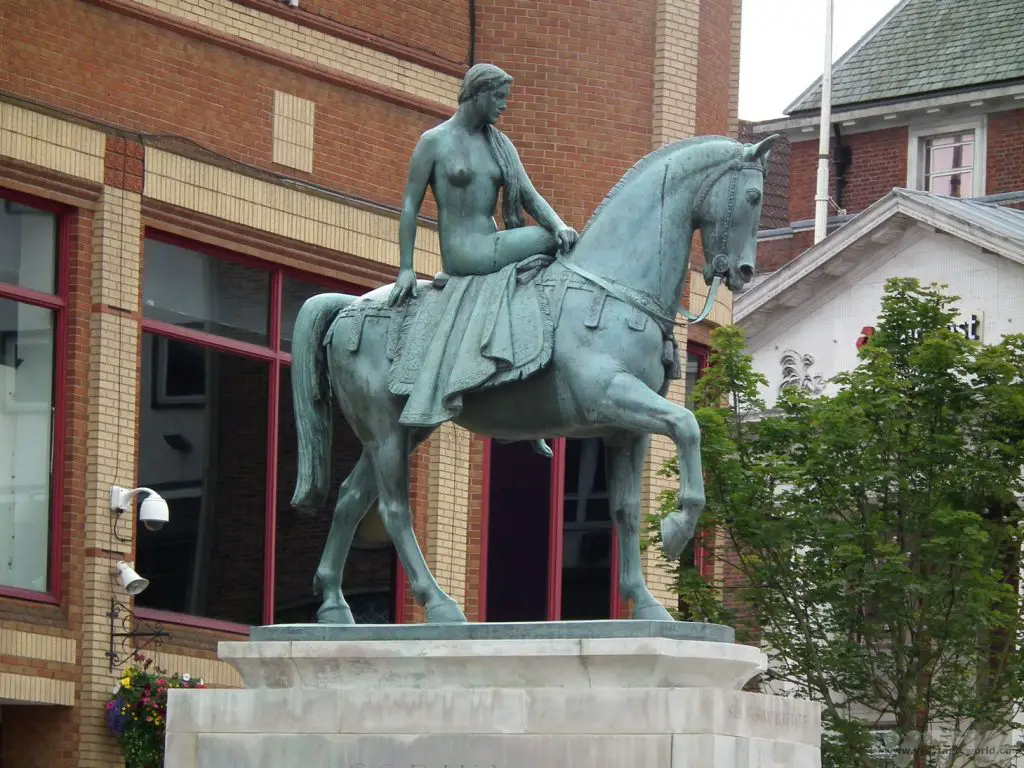
Coventry became an important trading location between 1150 and 1200 when merchants were allowed to visit the city and trade freely. The agricultural land surrounding the city was perfect for sheep grazing and wool production became an important industry. Textiles, weaving and dying in particular were very important and the Coventry’s blue coloured cloth (blue dye being a difficult colour to develop) was considered to be highly prized because of its ability to stay fast, coining the term ‘True Blue.’
Due to its importance as a centre of commerce a wall began to be constructed in the mid-14th century. Sandstone was quarried from the local district of Cheylesmore and a 3.5 km, 3.7m high wall was built around the city centre. It had twelve gatehouses located on the main routes into the city.
By the 15th century Coventry’s main churches had been constructed. St Michael’s Church, Holy Trinity and Greyfriars (Christ Church) all had magnificent spires which could be seen from miles away. The city actually became the capital of England, temporarily, on a few occasions. It was a wealthy city and considered to be hugely important by successive kings and queens of England.
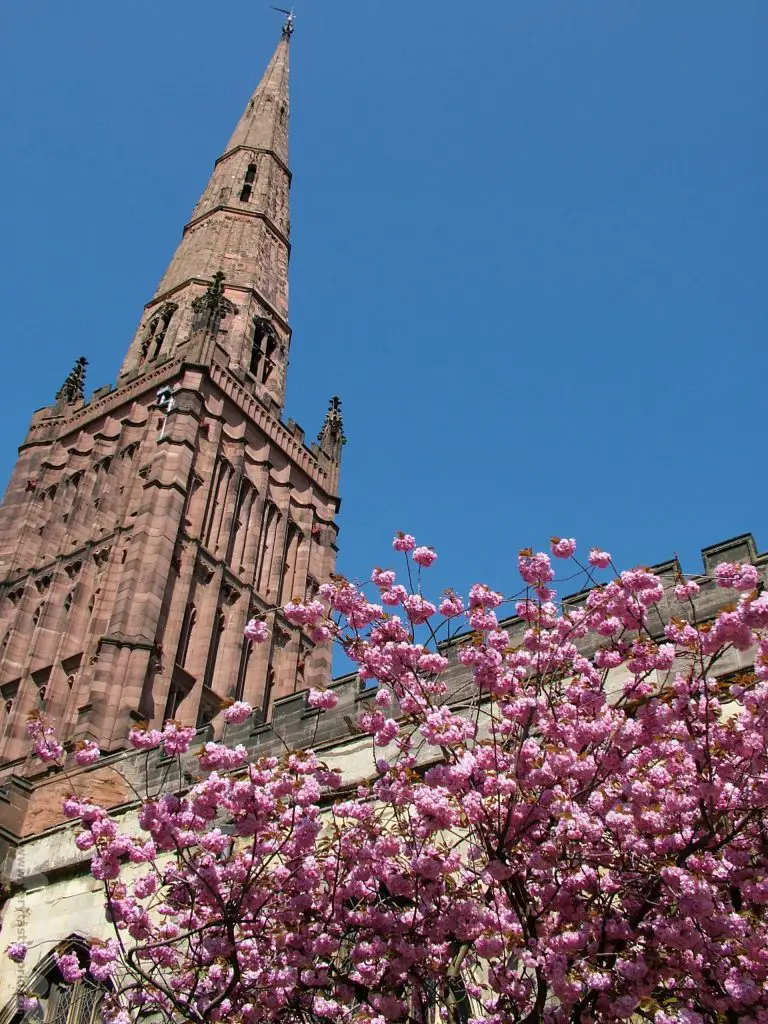
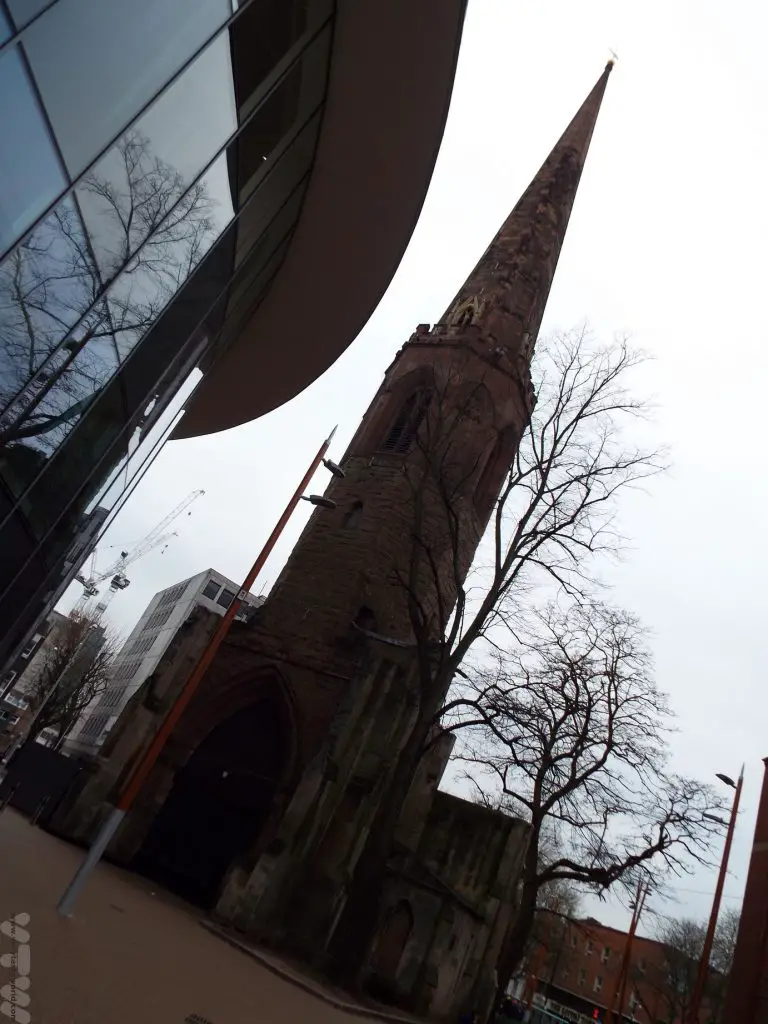
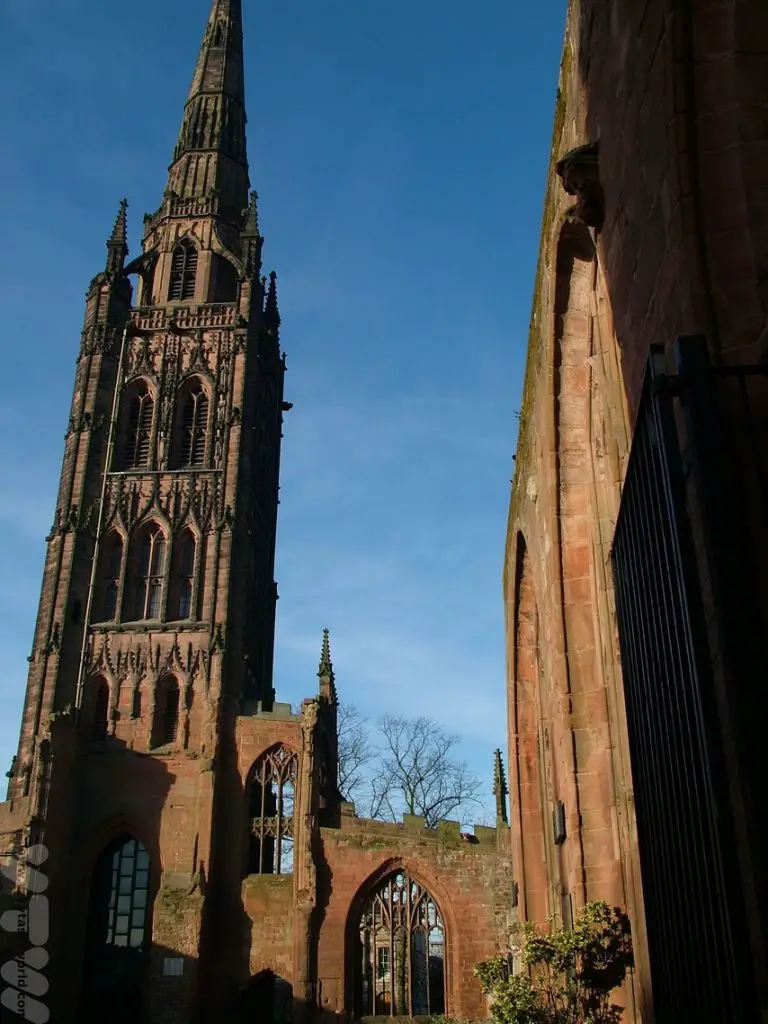
During the English Civil War, Coventry was a stronghold of Parliamentarians and was attacked by Royalists on several occasions but the king’s soldiers failed to conquer the city walls. The city was used as a prison for captured Royalists and those incarcerated were not just treated with disdain – they were ignored completely. It is thought that this is the origin of the term, ‘being sent to Coventry.’
As the industrial revolution started Coventry, with its central location, became an important city of industrialisation. It was renowned for manufacturing textiles and ribbons, watches (many of watchmakers lived in the Chapelfields area of the city), bicycles and cars. The first British series production motor car was made in Coventry, by Daimler, in 1897.
Despite the industrialisation, the city centre retained a lot of its mediaeval buildings. However, because of the industrialisation, the city was a target during World War 2. On the night of 14/15 November 1940 Hitler ordered a bombing raid on the city. Most of the city centre was destroyed, including the interior of St Michael’s cathedral, and over 500 people lost their lives. Coventry has since become a city of peace and reconciliation and has twinned with some 23 cities across the world, including Dresden and Volvograd (formerly Stalingrad), both cities which also suffered devastating attacks during World War 2.
Following the war the city was rebuilt and was designed to be a modern city – it included one of Europe’s first ever pedestrianised precincts. It has recently been refurbished.
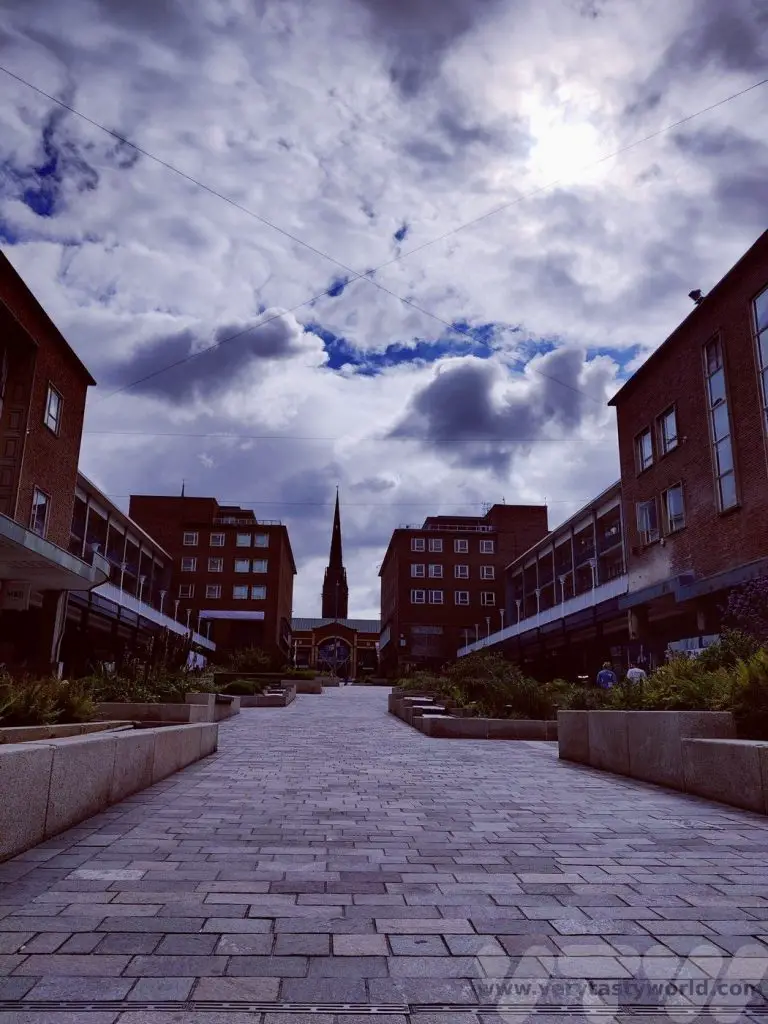
The city thrived thanks to the car manufacturing industries during the 50s and 60s. Famous names include Jaguar, Standard-Triumph, Talbot, Peugot, and Alvis. London taxis – the iconic black cabs – were constructed in the city from the 1950s until 1994. However the industry – and consequently the city – suffered serious decline in the mid-1970s and 1980s due to industrial disputes and competition from other countries.
One by one the car factories closed down. In the early 1980s Coventry band The Specials wrote the song Ghost Town about the decline of the city. Bands such as The Specials, The Selecter and The Beat were part of the 2Tone movement which developed in Coventry and was defined by their members being multi-racial and a musical style that combined punk/new wave music with Jamaican ska.
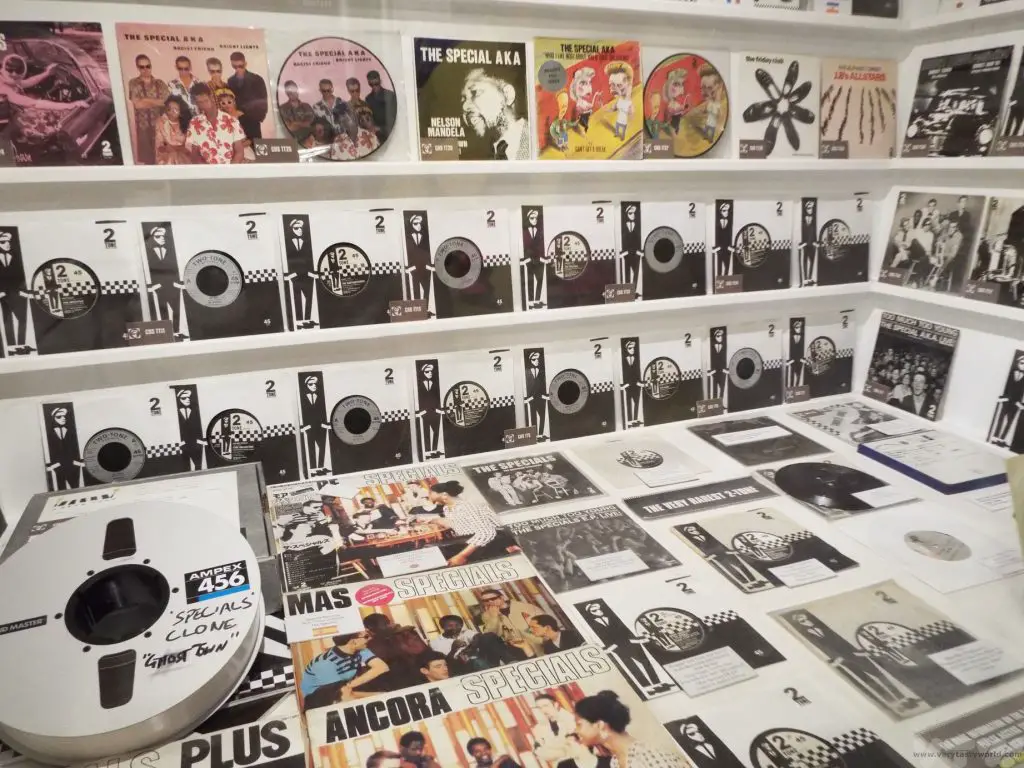
These days, Coventry is a lively city. With two universities, it’s also a young city with a diverse population which has an average age of 33 years. It was also the 2021 UK City of Culture, the start of which was slightly delayed due to the pandemic.
Things to Do In Coventry – Places to Visit
Although much of mediaeval Coventry was destroyed it is possible to see some older buildings in the city. Mediaeval Spon Street is largely comprised of old buildings although not all of these were originally built on the site but were relocated from other parts of the city.
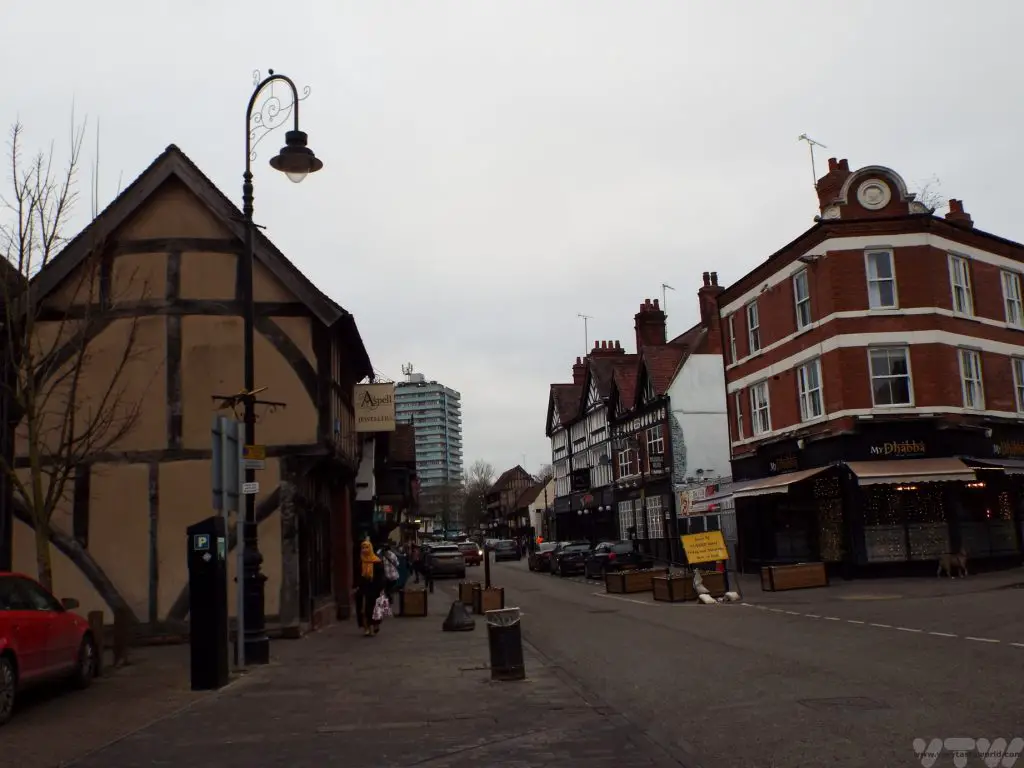
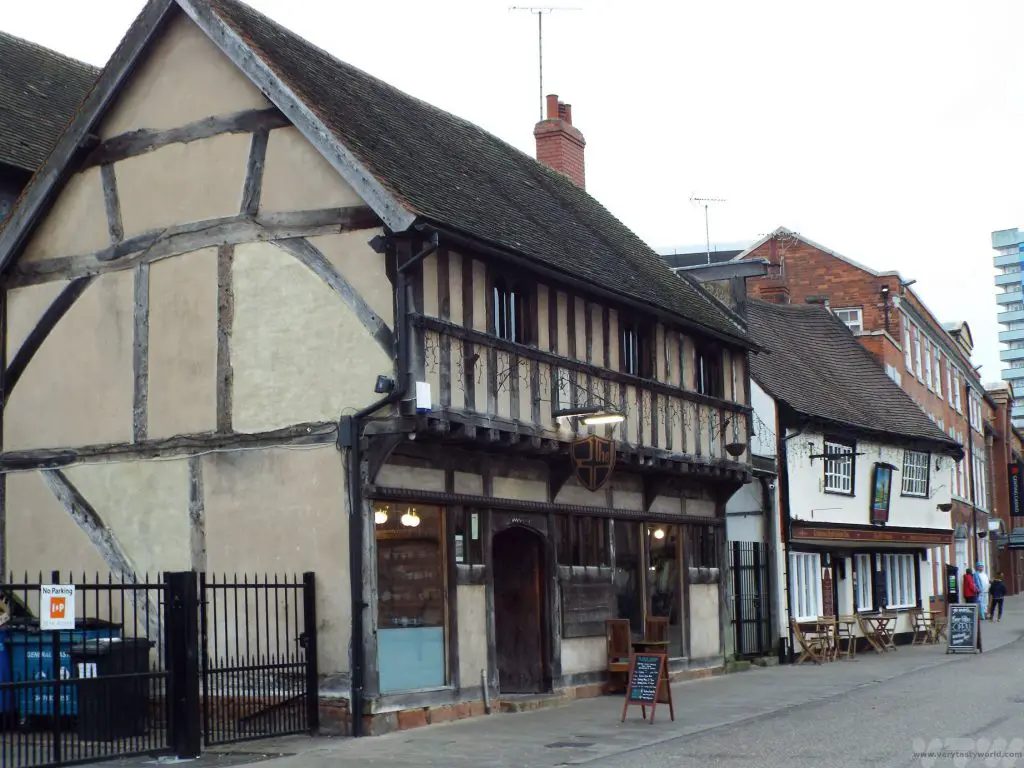
Ford’s Hospital was constructed in 1509, as an almshouse.
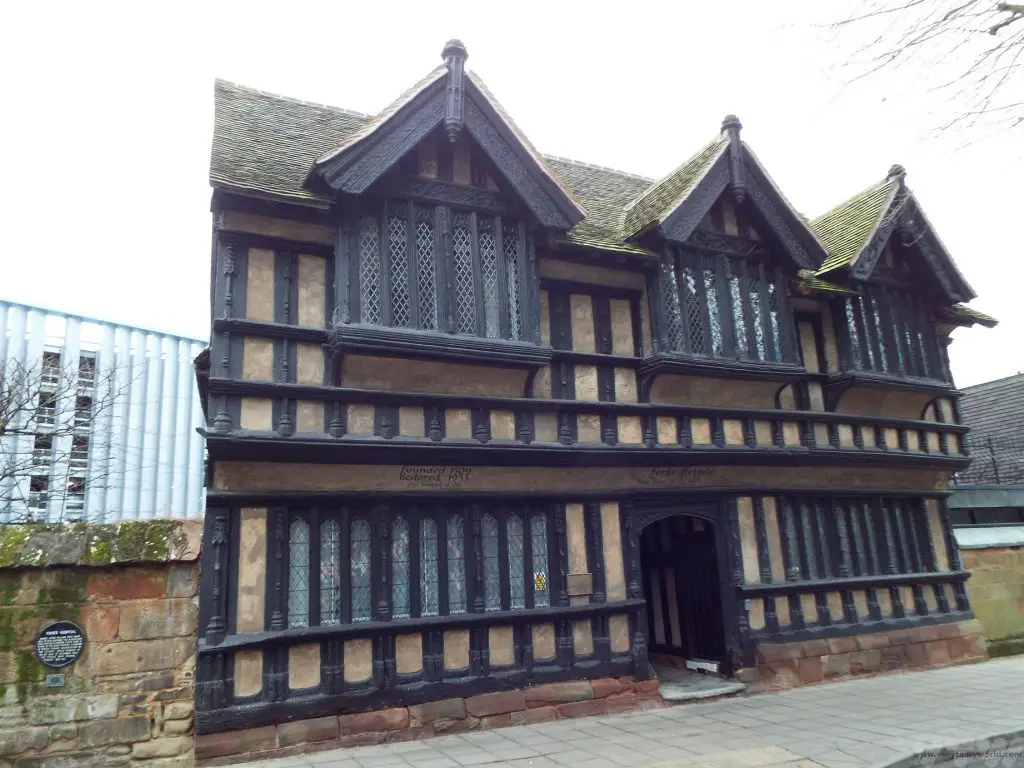
Some parts of the original city wall can still be seen. Swanswell Gate is the best preserved of the city’s gates. It has now been converted into a boutique hotel and it is possible to book it for a stay in the city.
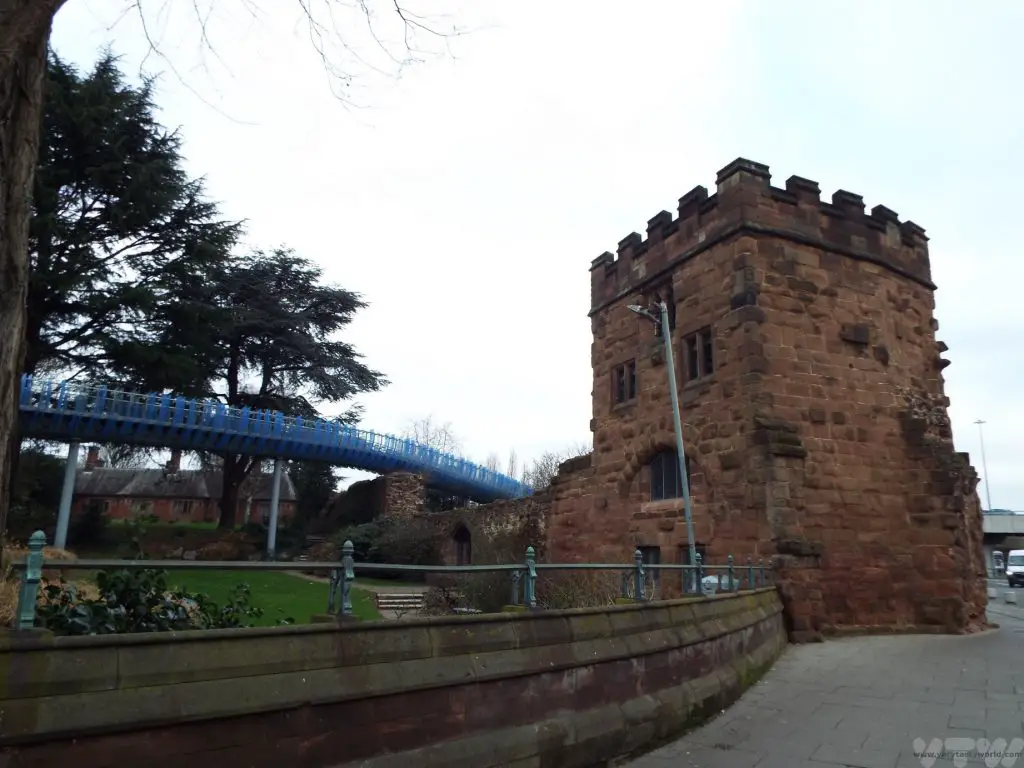
Dating from the 12th century, the old grammar school is now a conference or wedding venue which occasionally opens up for pop-up art events. You can see the original school chairs, carved by their previous occupants centuries ago.
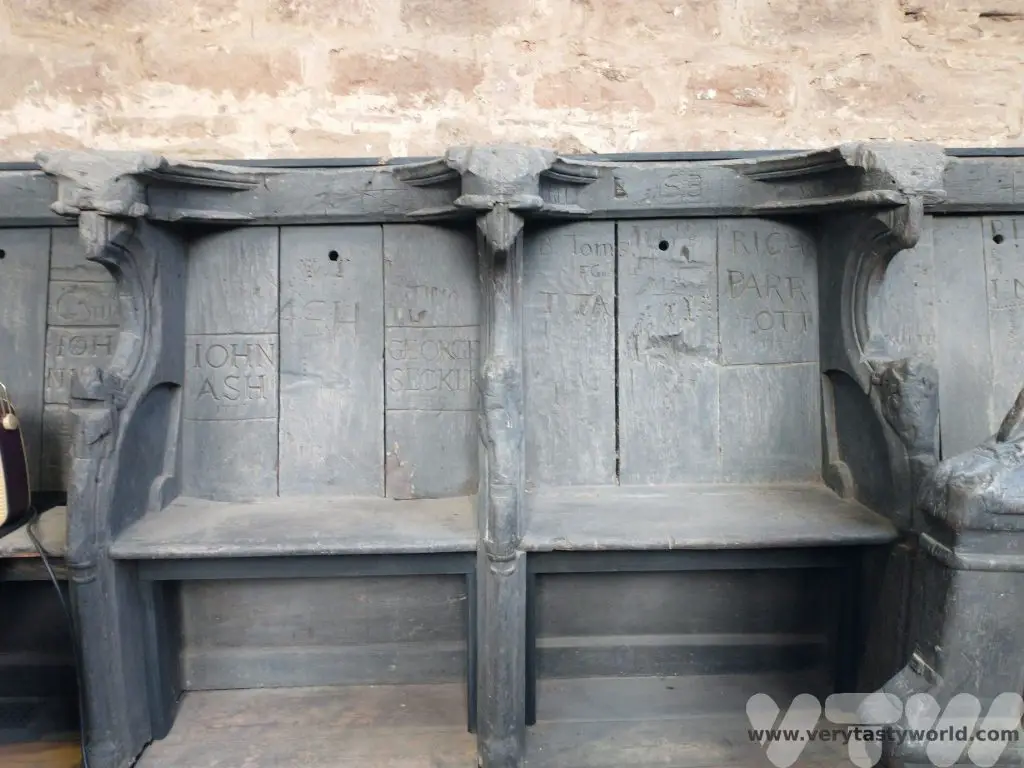
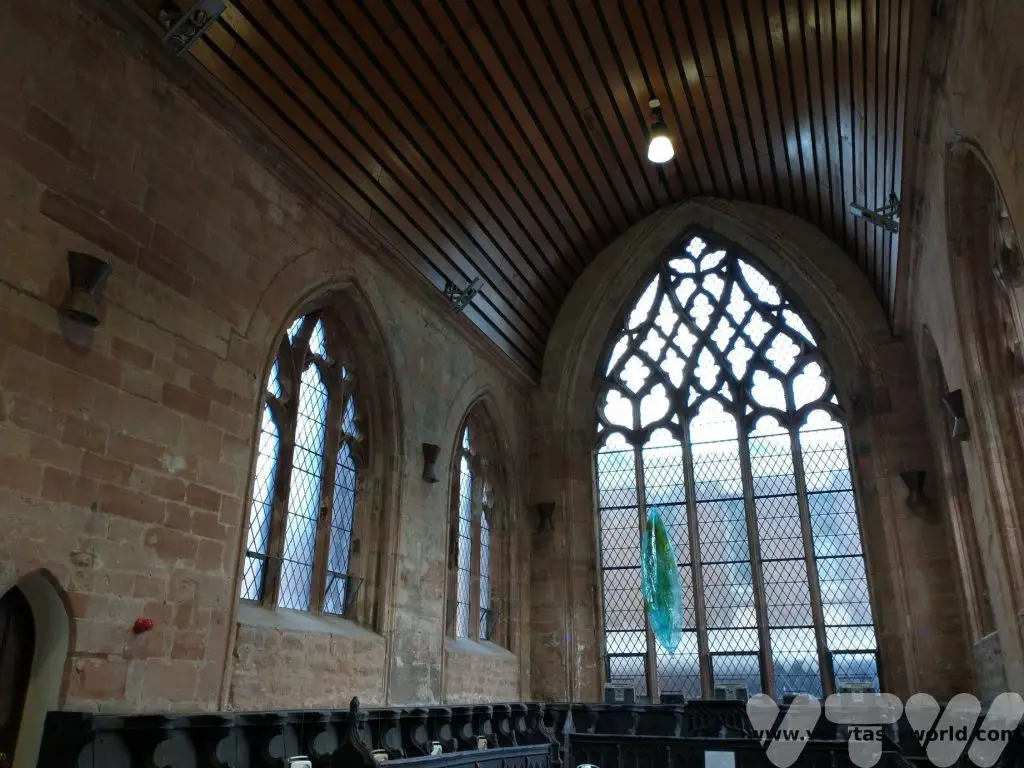
Coventry Cathedral – old and new
St Michael’s Cathedral was largely destroyed during the Blitz raid but its outer walls and spire remain. It was decided that it should remain in situ. It contains a number of symbols of reconciliation, including a charred cross which was constructed from two fallen wooden beams.
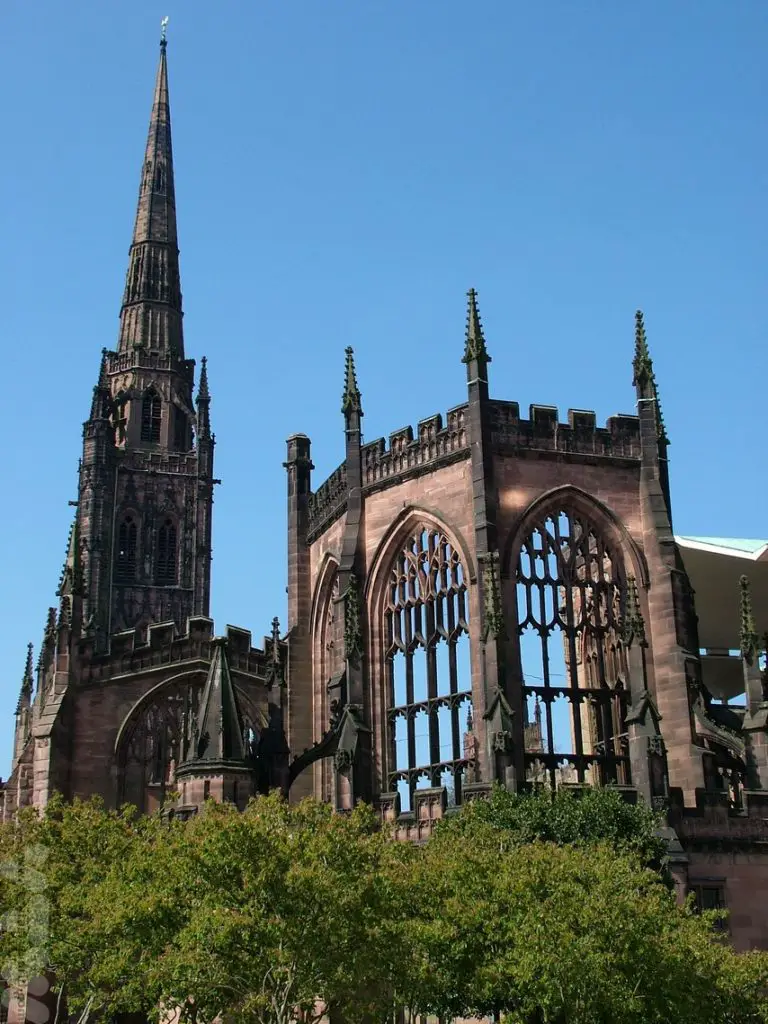
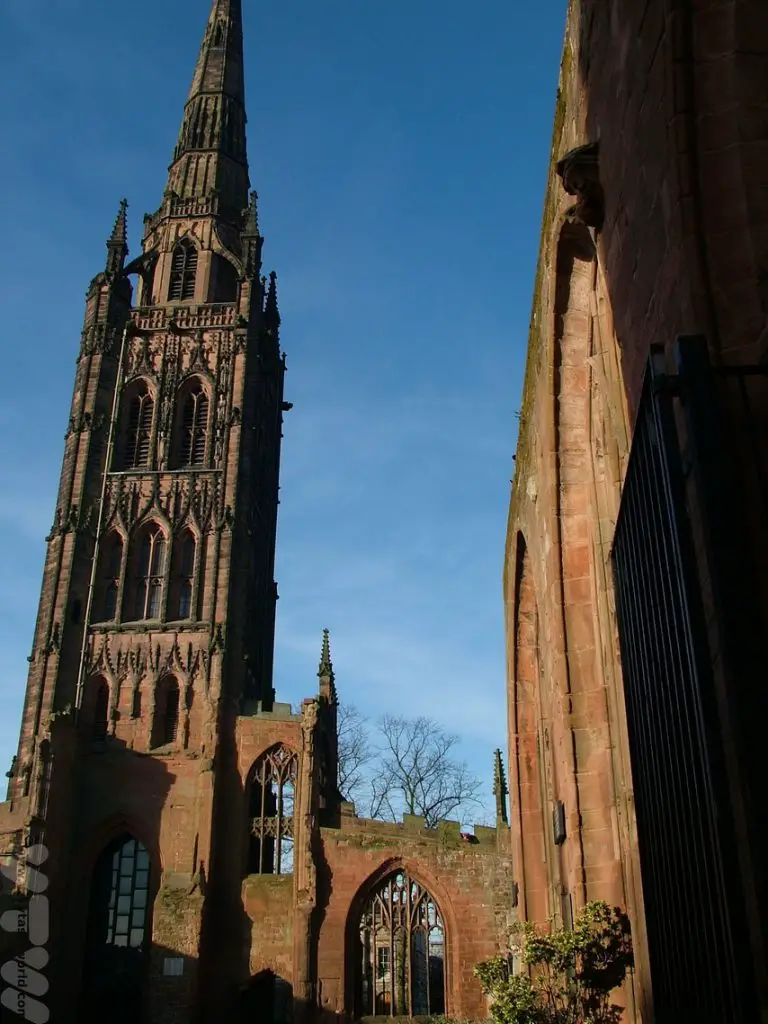
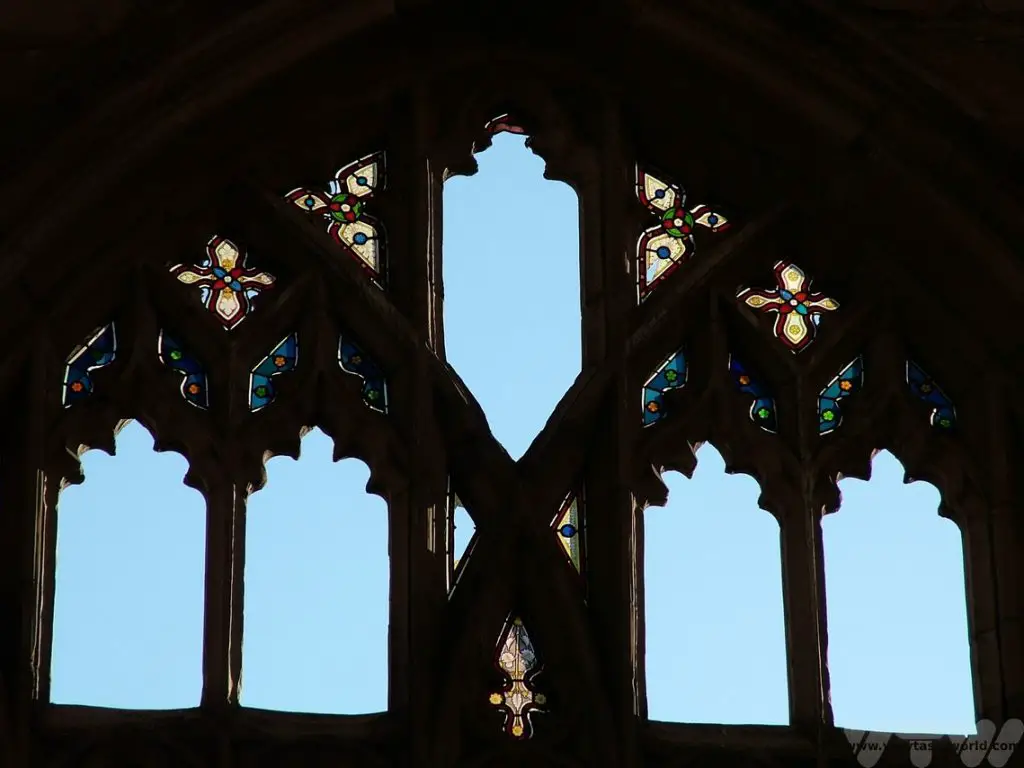
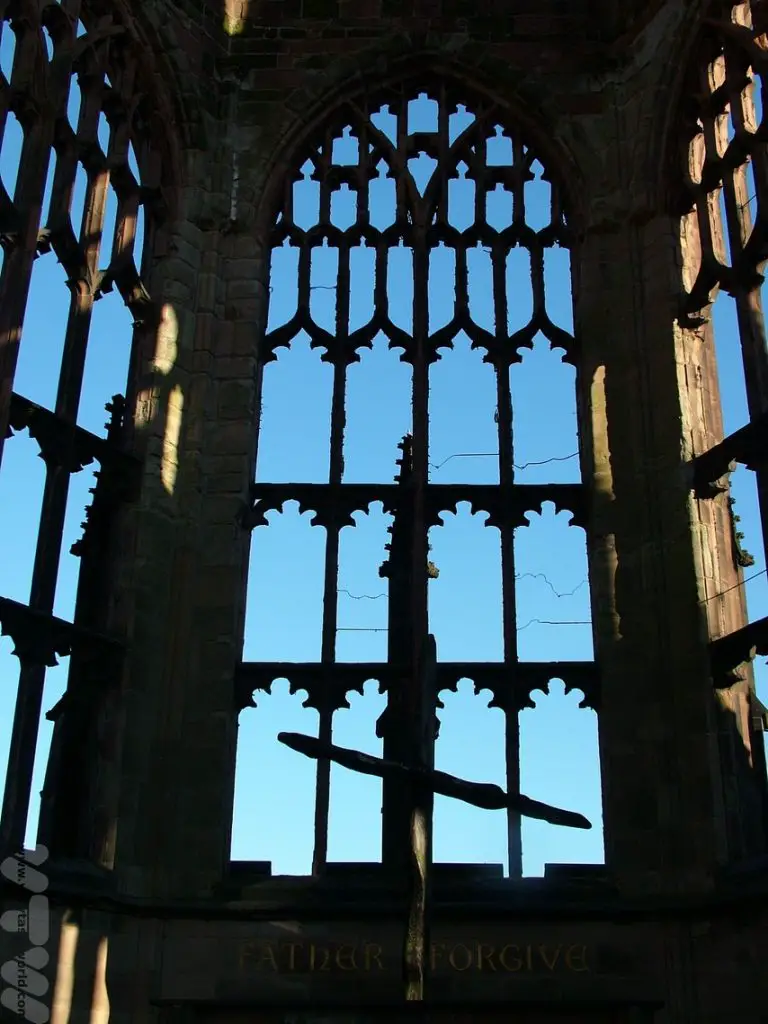
A new cathedral, constructed alongside the ruins of the old, was consecrated in 1962 as a place of worship. Both cathedrals are very much part of the community. They often hold concerts, plays and other events, both indoors and outdoors. The old cathedral even became an ice rink during the winter Christmas season.
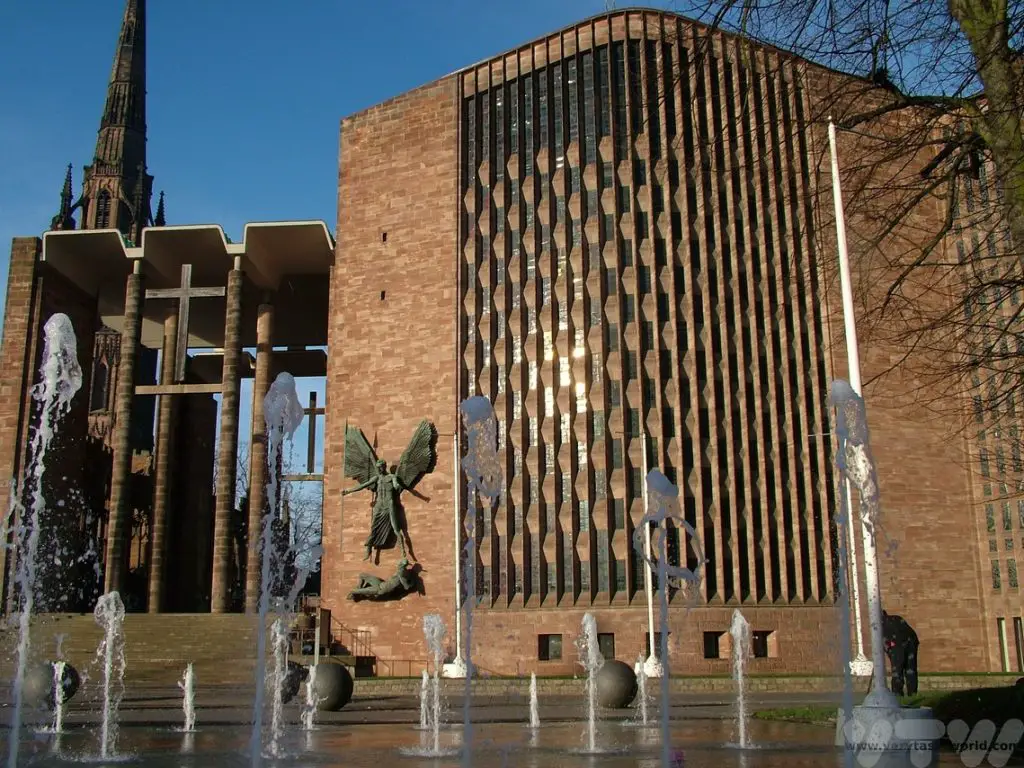
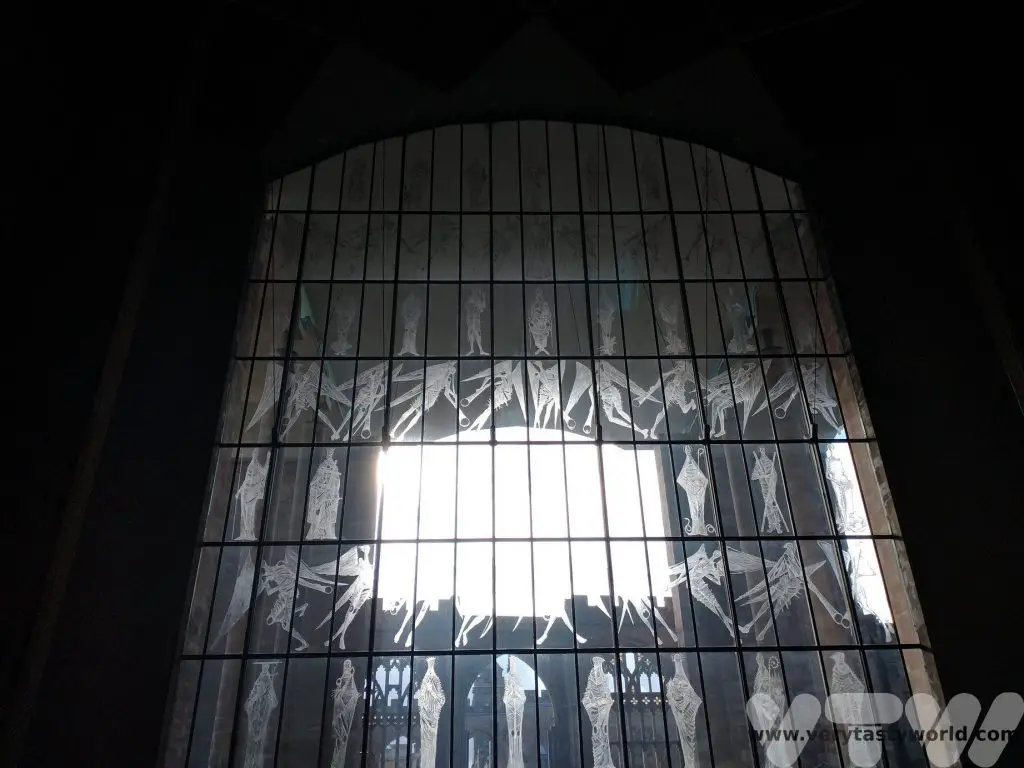
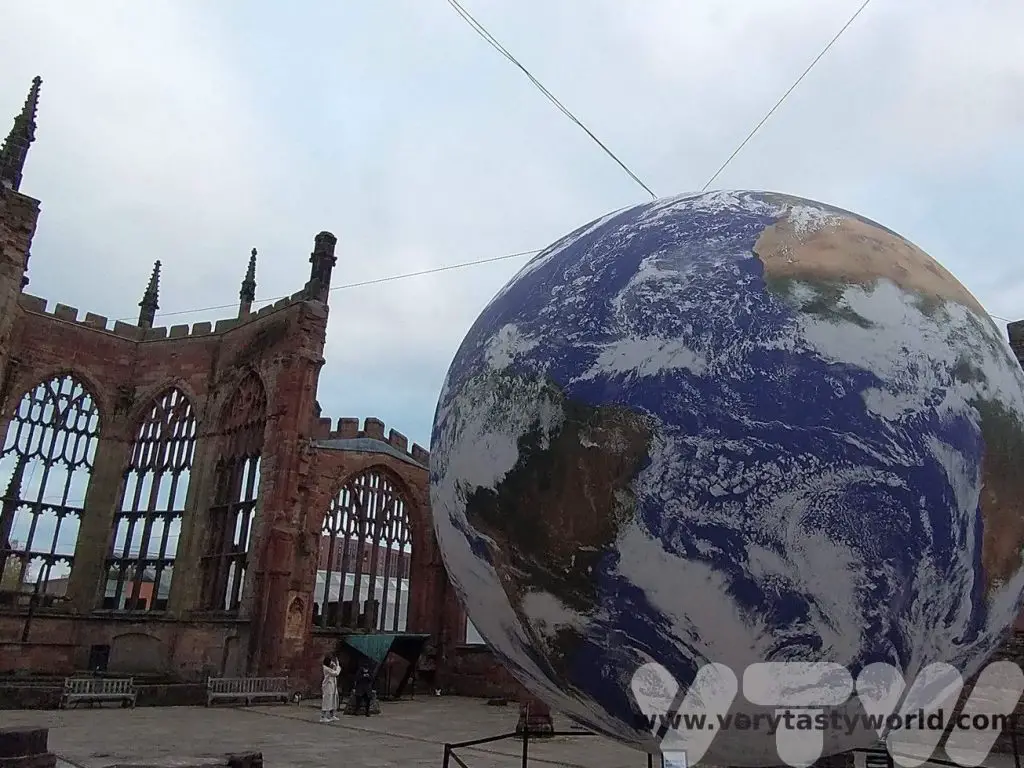
St Mary’s Guildhall
This is one of Coventry’s original mediaeval buildings, a guildhall built in 1342 but then reconstructed in the 15th century.
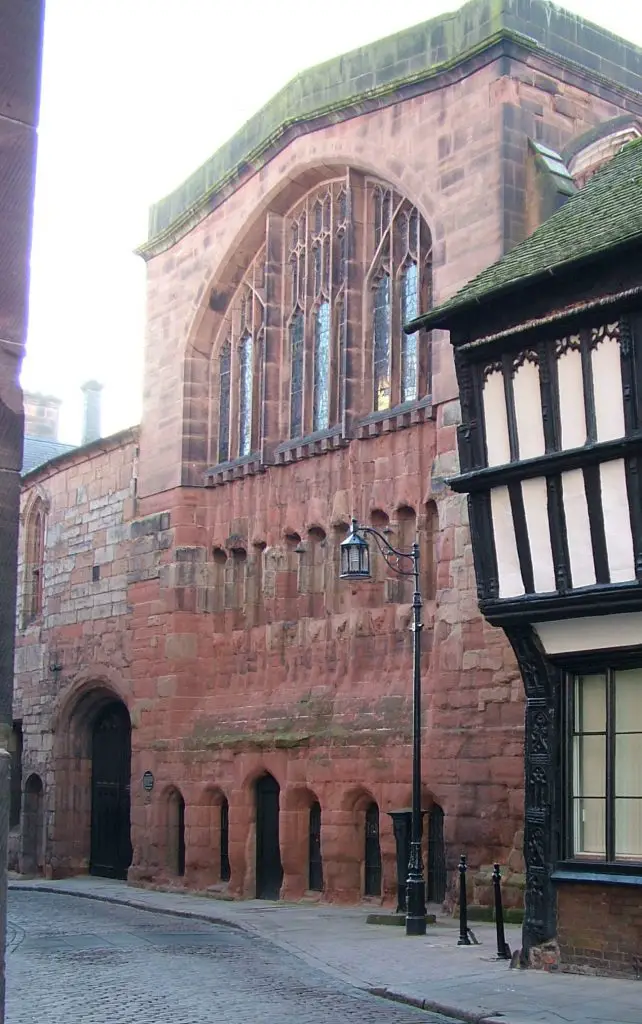
It contains one of the oldest tapestries in the country, almost certainly the oldest that remains in its original setting, known to have been made for the hall itself. The central figure is the Virgin Mary, to whom the hall is dedicated.
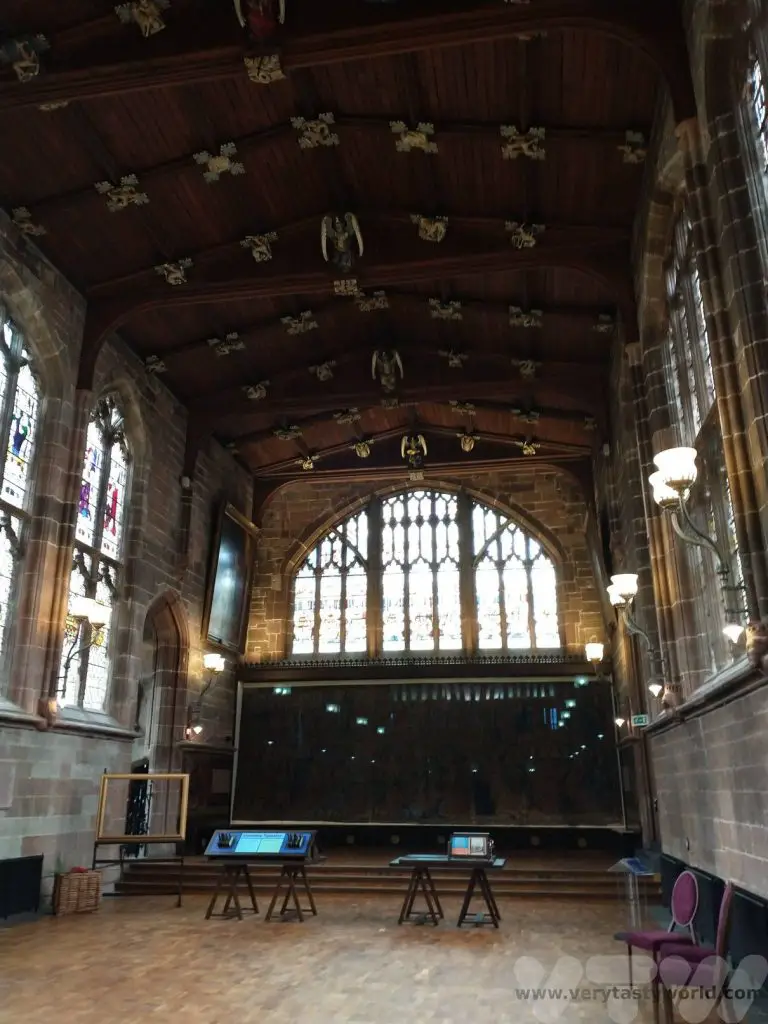
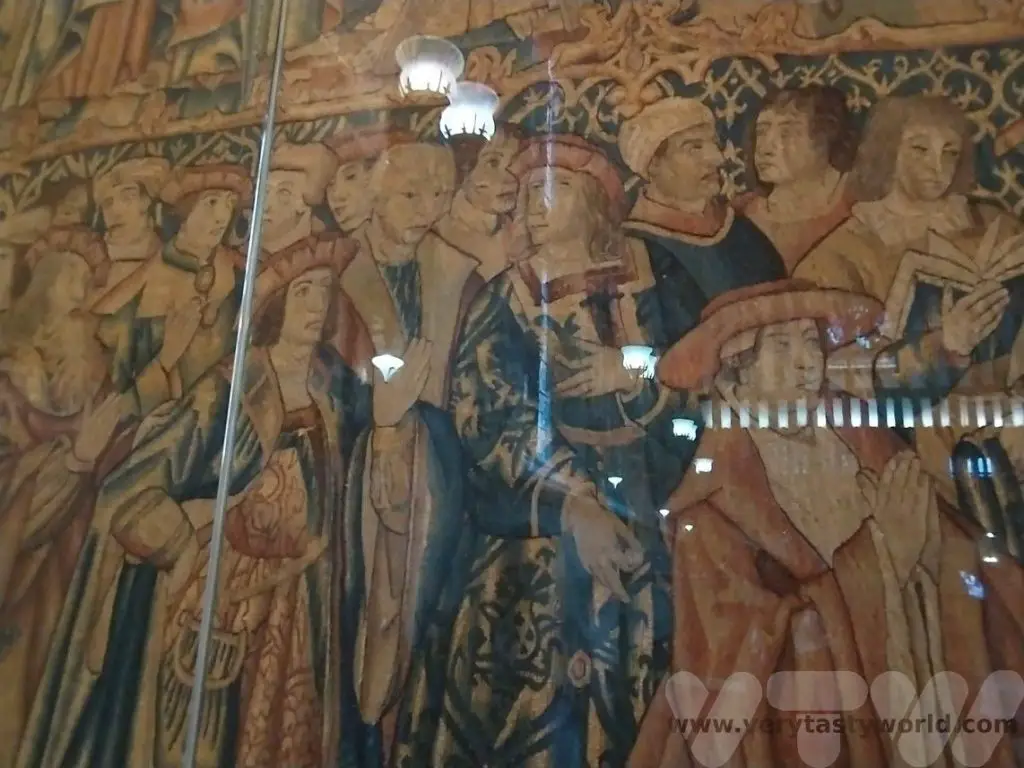
Amazingly, the guildhall, which is located right next door to St Michael’s cathedral which was largely destroyed during the firebombing of Coventry, survived the Blitz.
A recent refurbishment has revealed mediaeval kitchens which have been restored. There are exhibits showing the sort of food that might have been prepared there in centuries gone by. A splendid afternoon tea can be enjoyed in the undercroft.
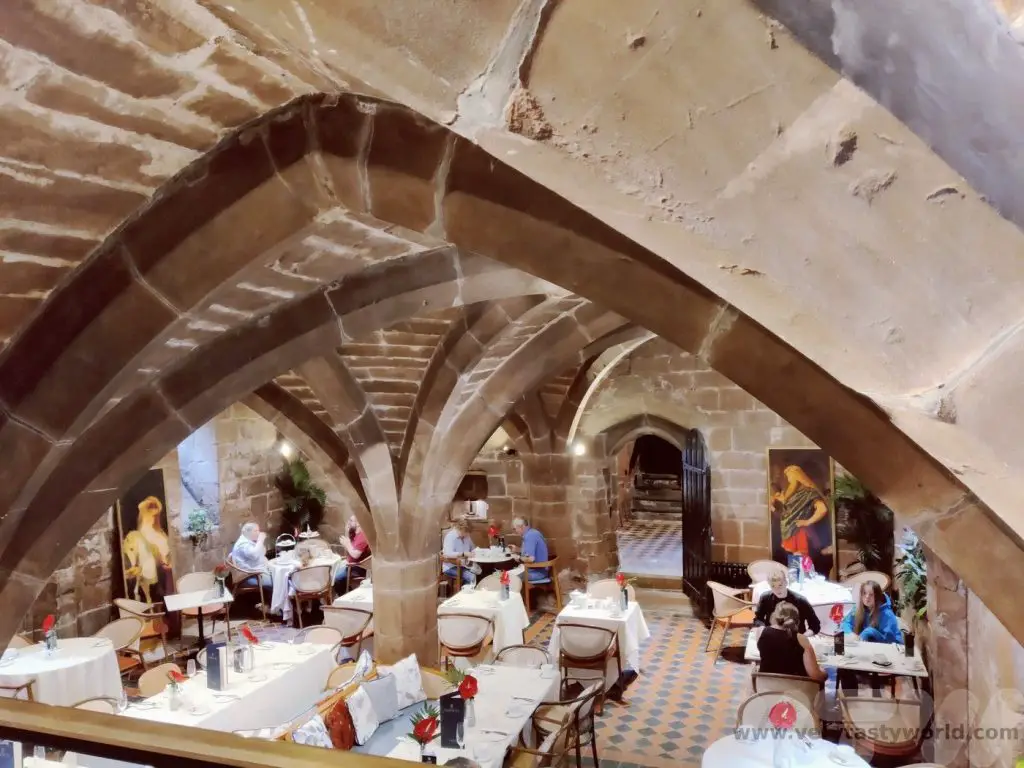
Coventry Music Museum
Located just outside the city in the Ball Hill district, the Coventry Music Museum is a small but perfectly formed museum dedicated to the musical history of the city.
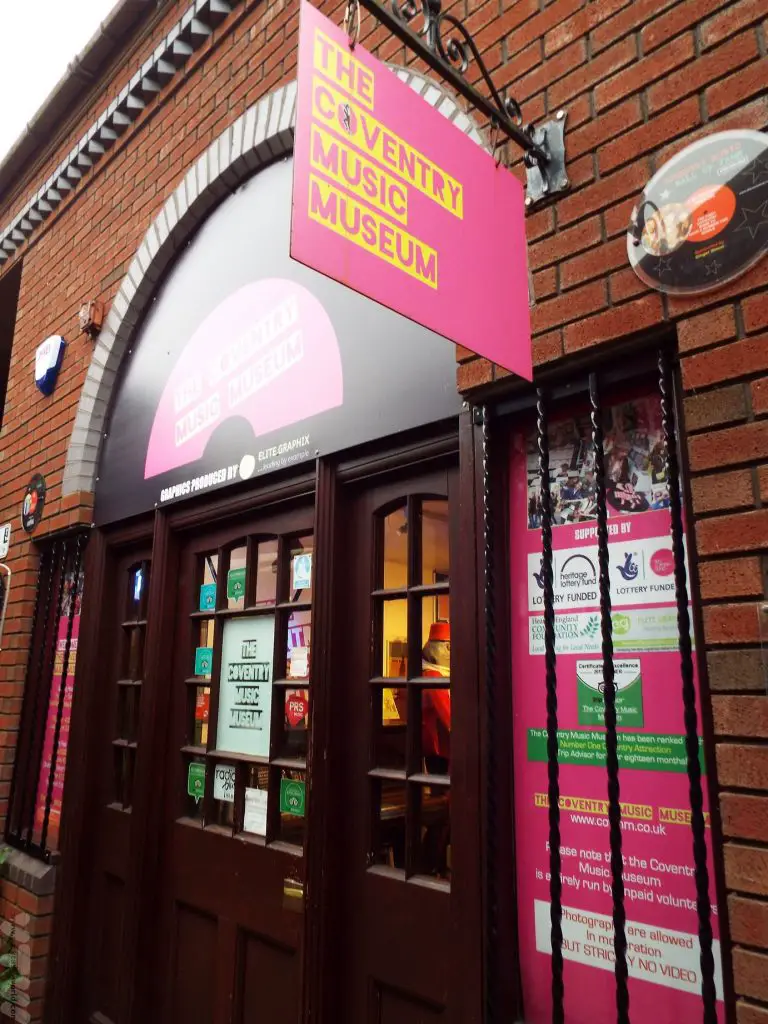
You always receive a friendly welcome. With a plethora of exhibits and memorabilia, including the original Ghost Town organ and a reproduction of a Two-Tone bedroom, it also looks to Coventry’s earlier music history including an exhibit looking at the work of Coventry born Delia Derbyshire, the pioneering electronic musician (who arranged the Dr Who theme tune). Deliaphonic is an annual celebration of her life and work which takes place in venues around the city.
You can also use the music room there – just pick up an instrument and play. Opposite the museum is the Two-Tone café and the excellent Simmer Down Caribbean restaurant.
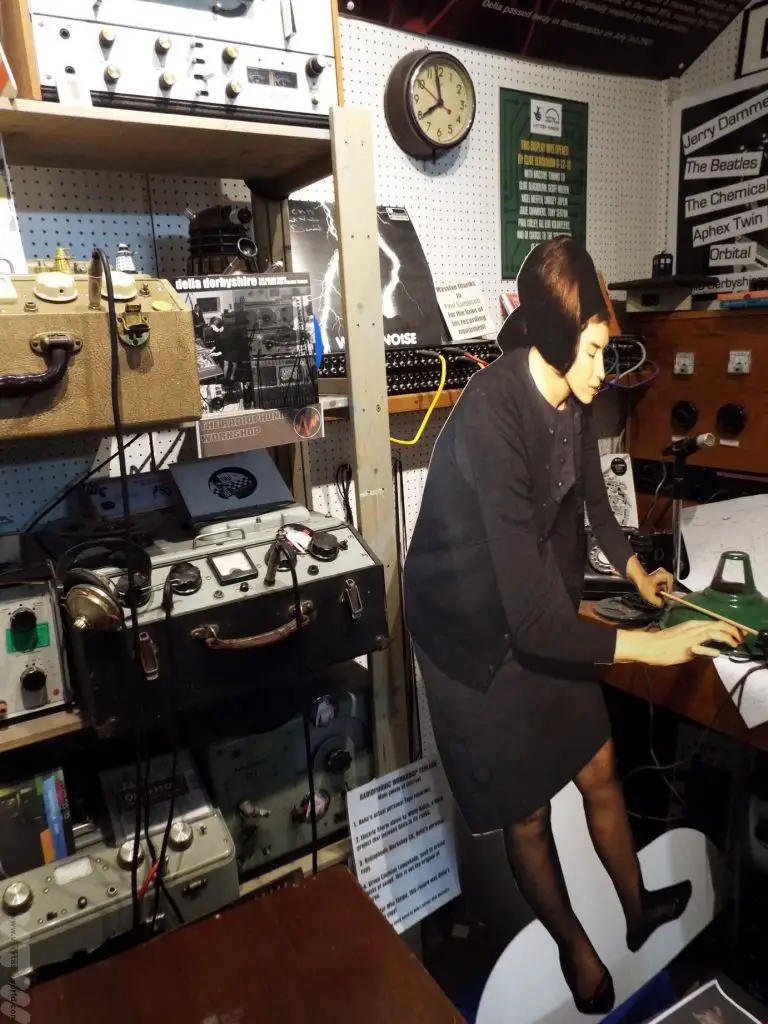
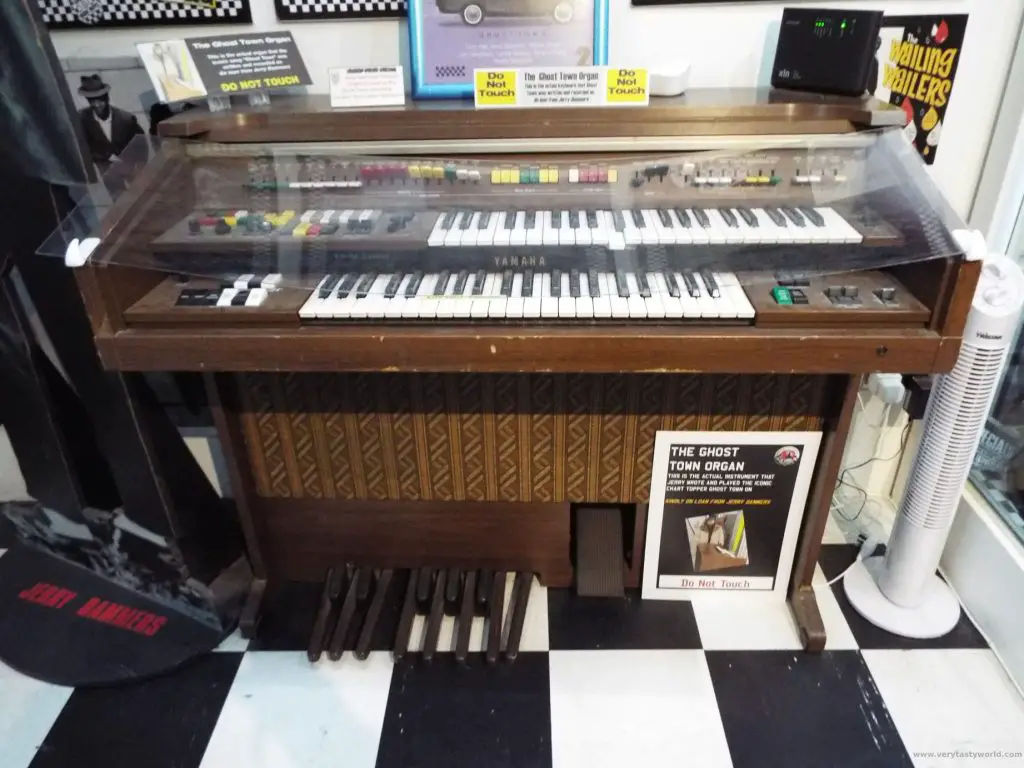

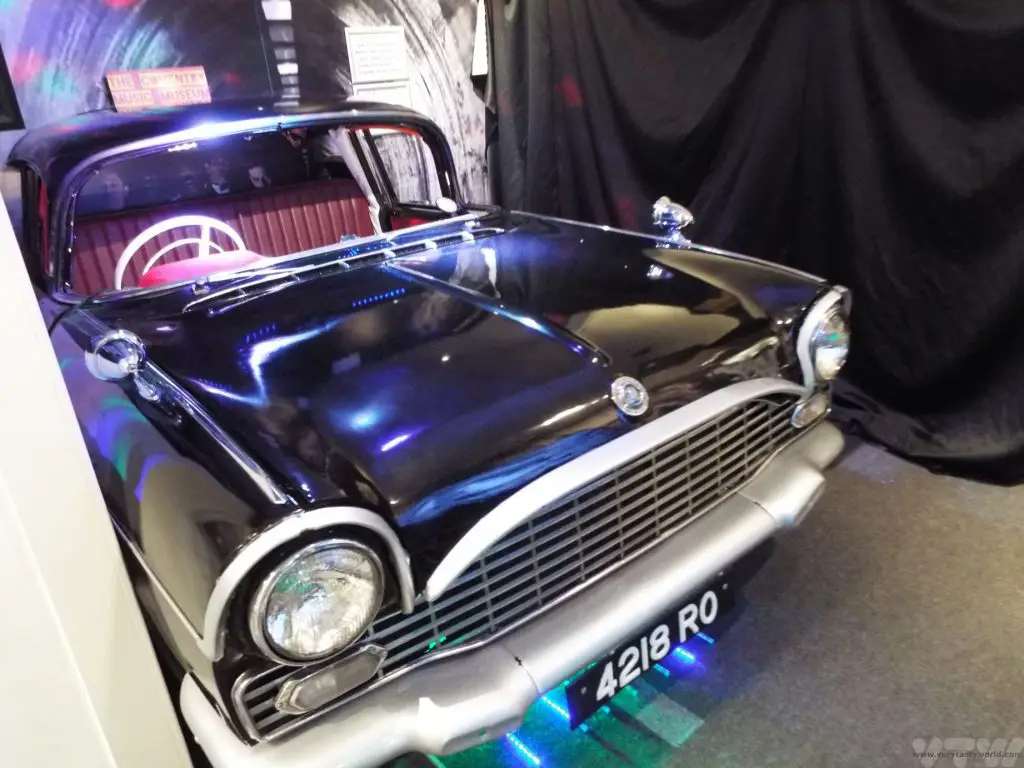
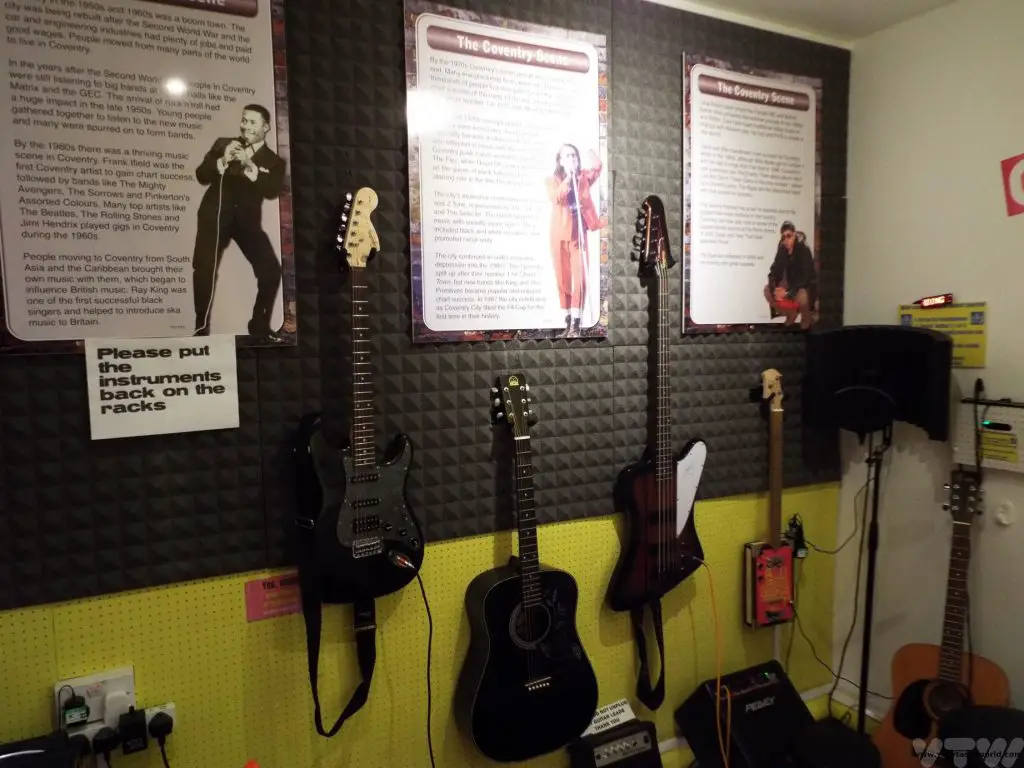
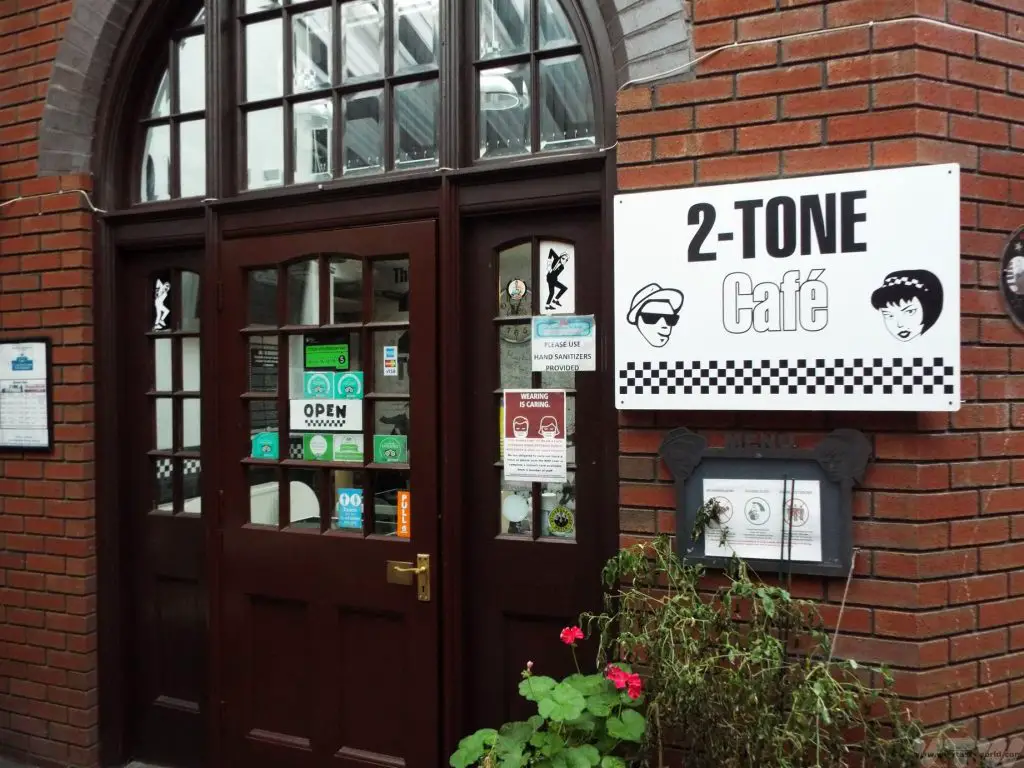
Coventry Transport Museum
Located on Millennium Place, Hales Street and celebrating Coventry’s motor history, this is a fascinating museum which has the largest publicly owned collection of British cars in the world.
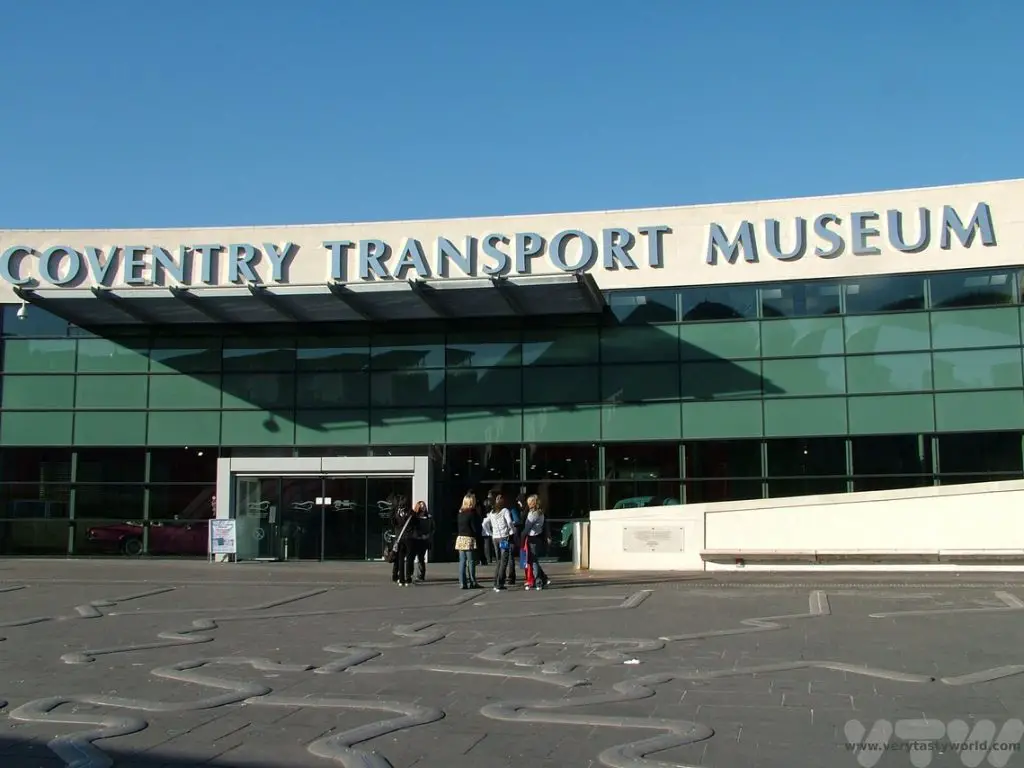
The museum offers a brilliant history of transportation and also of the city. It has lots of interactive exhibits and you can see an extensive variety of vintage vehicles as well as two of the fastest cars in the world: Thrust SSC and Thrust 2. Fun fact: part of the famous car chase from the film The Italian Job was filmed in Coventry. While the Mini Coopers enter and leave the tunnel in Turin, the actual tunnels were Coventry sewers which were being constructed at the time.
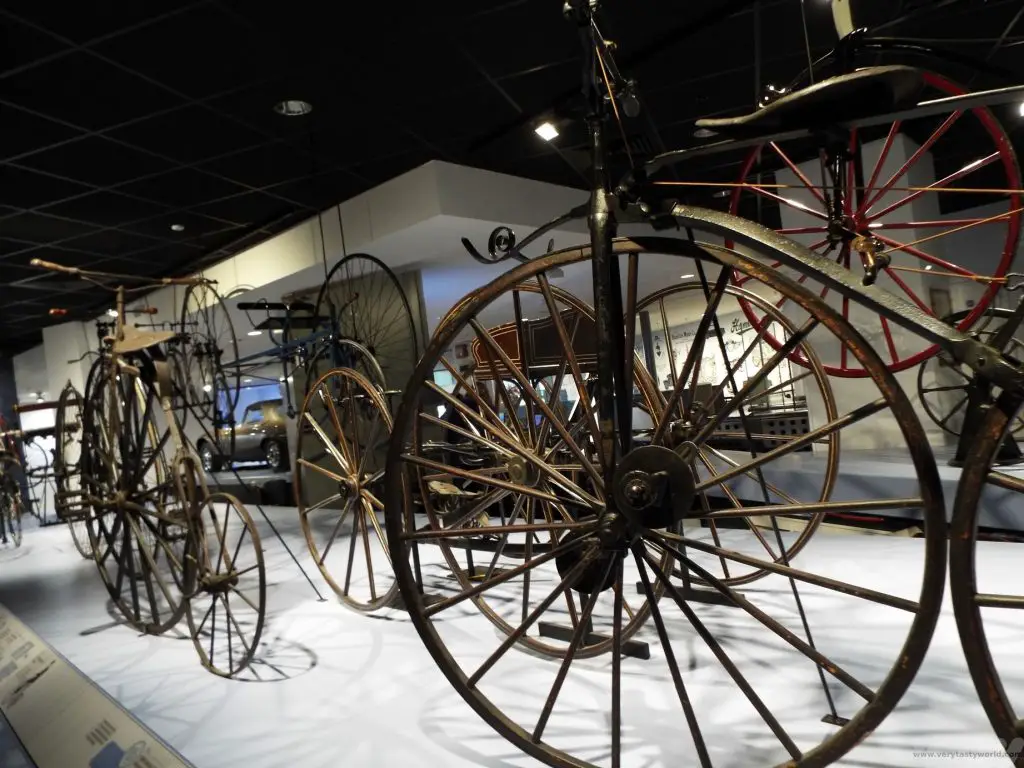
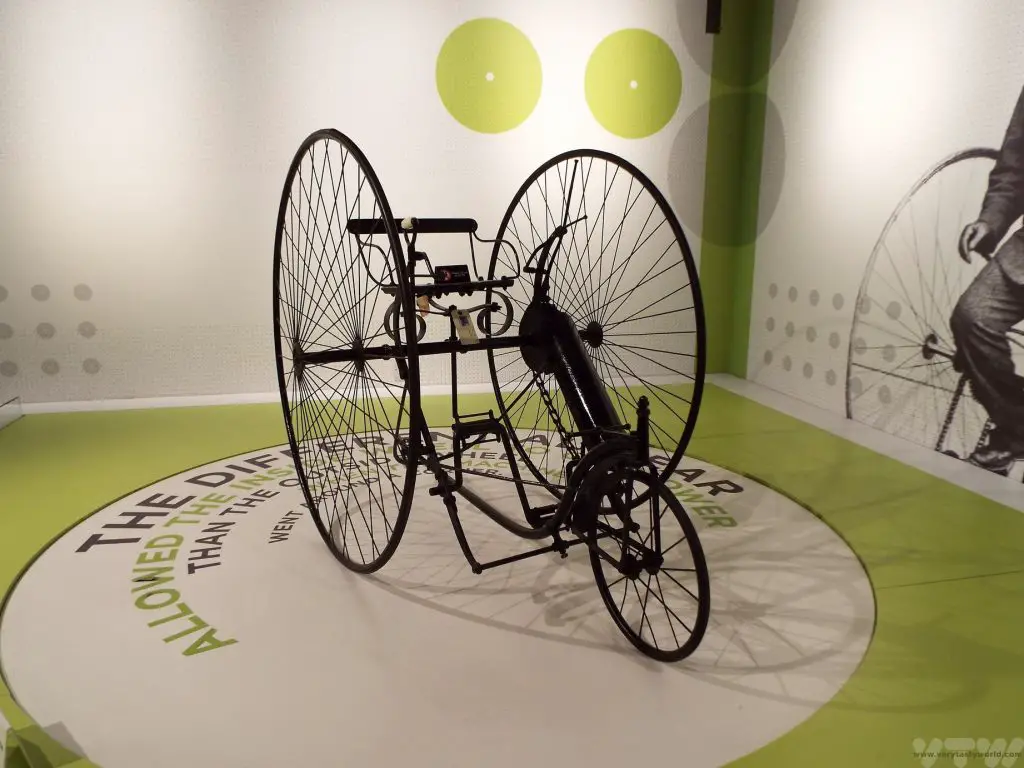
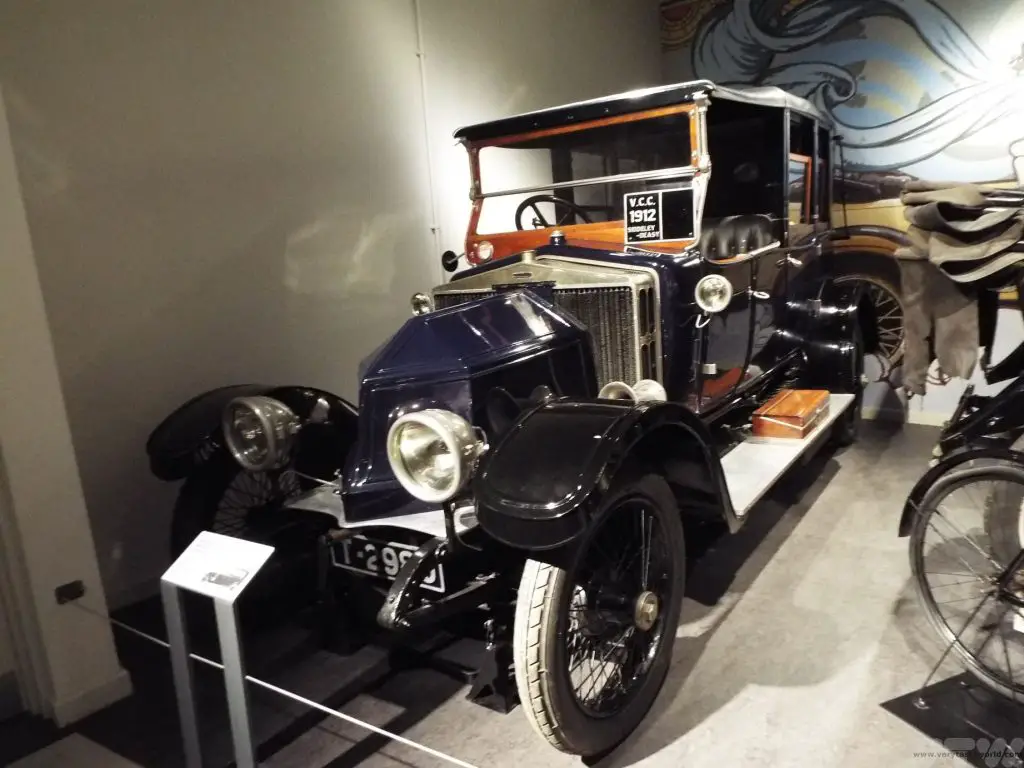
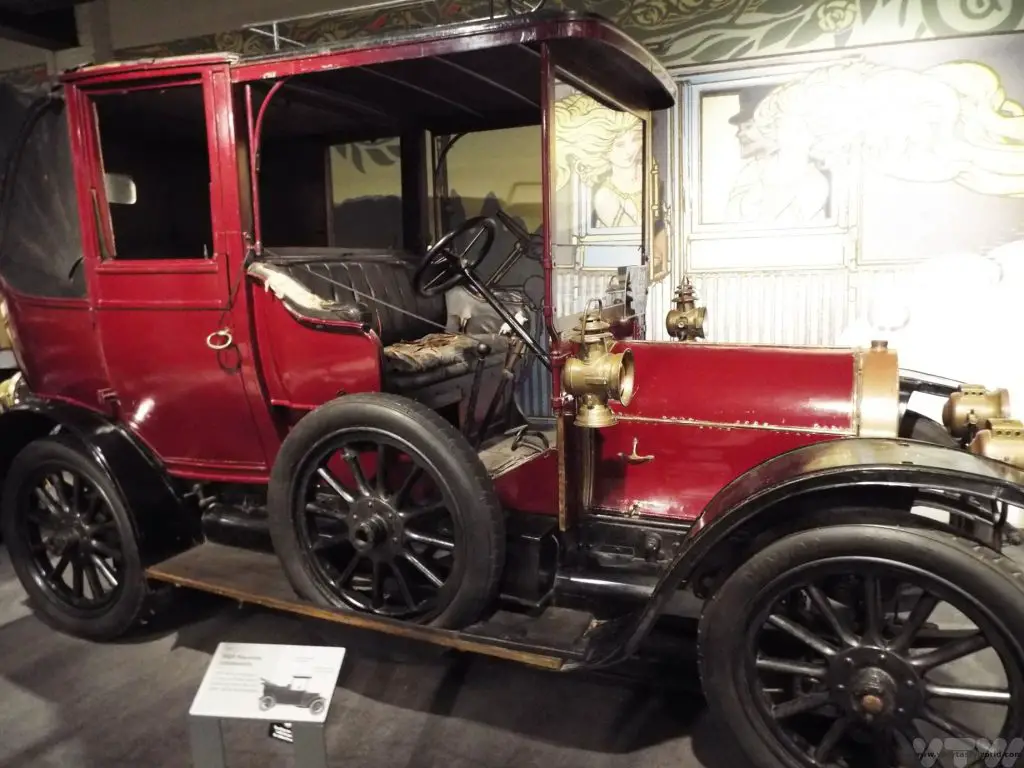
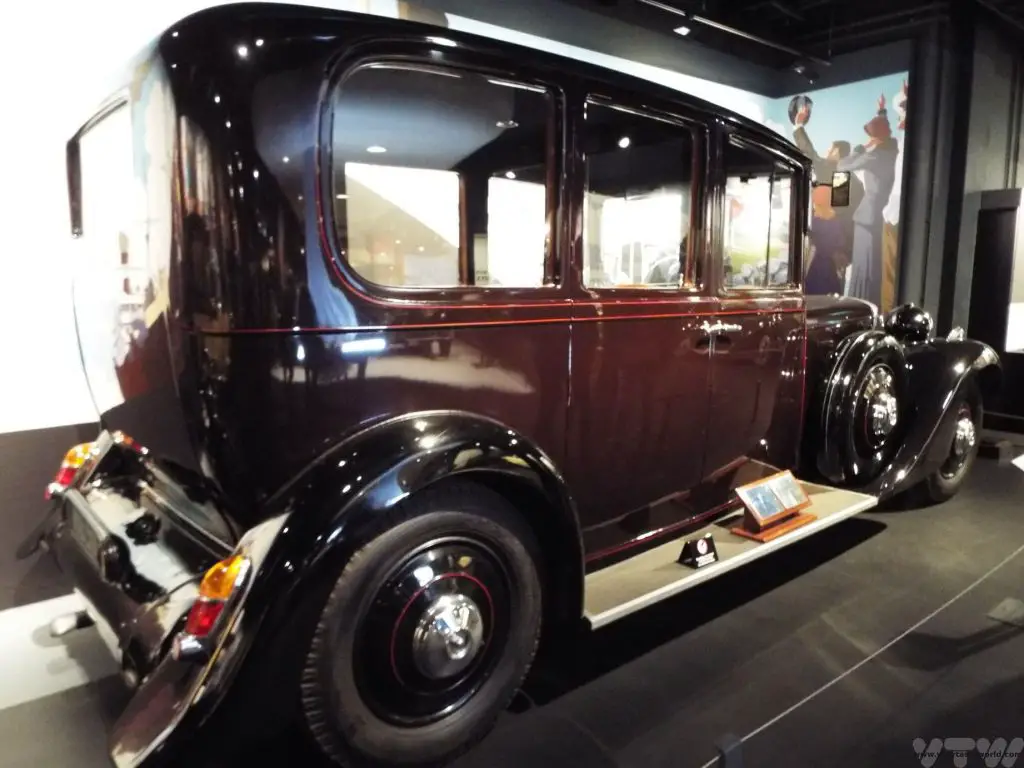
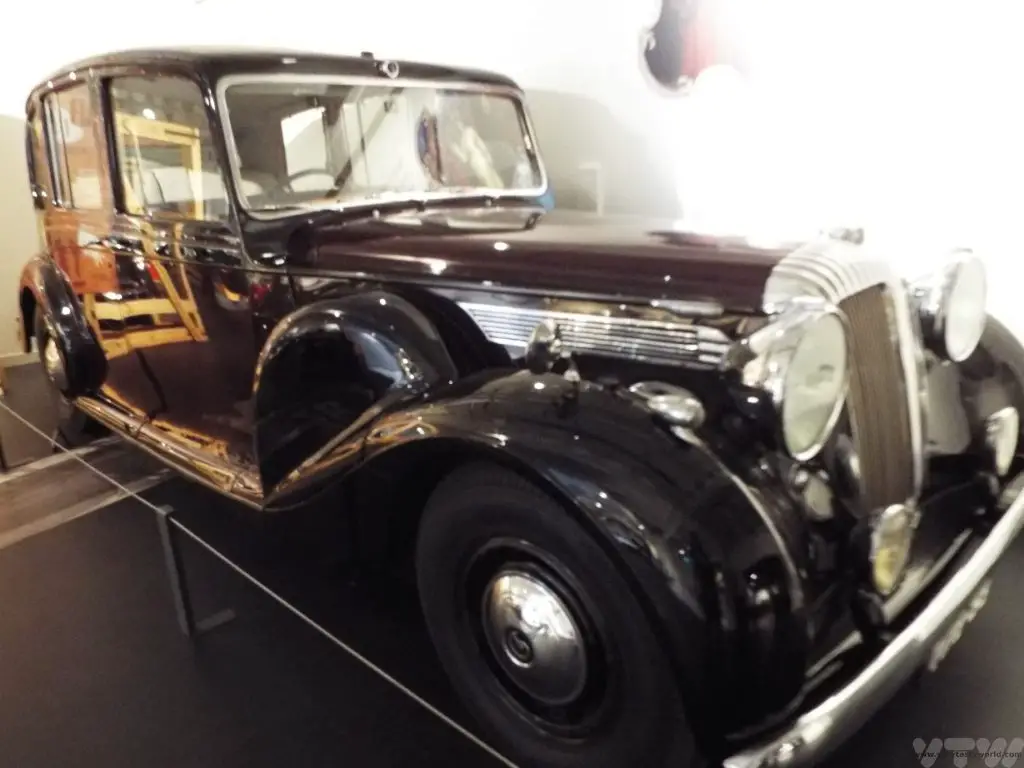
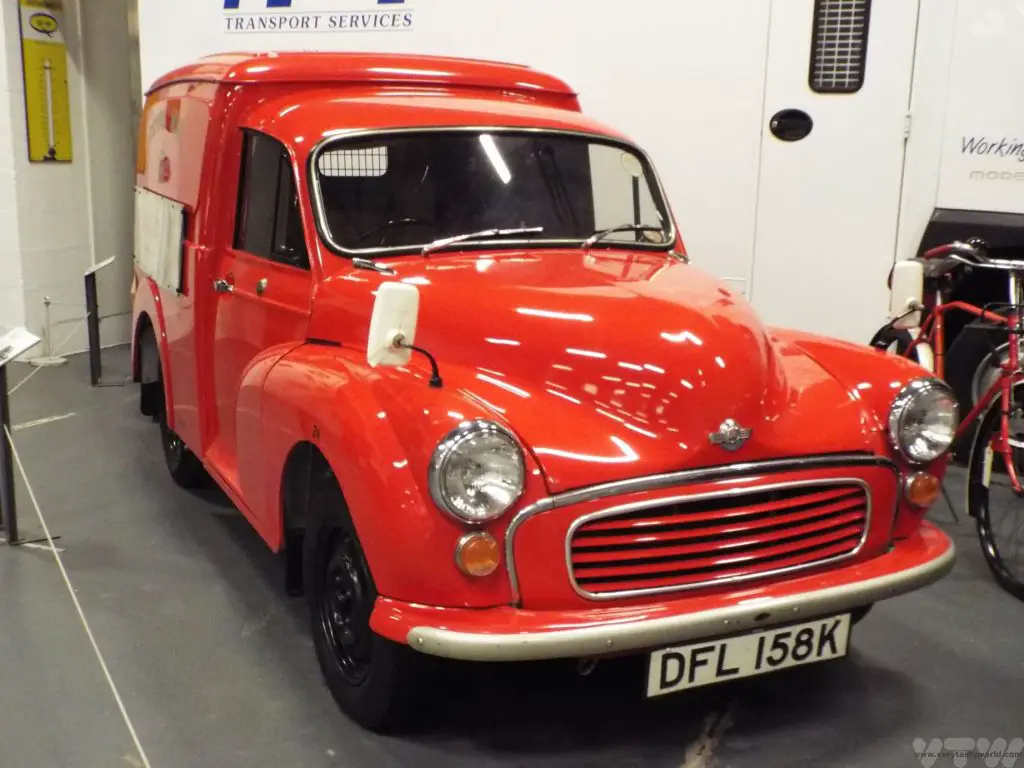
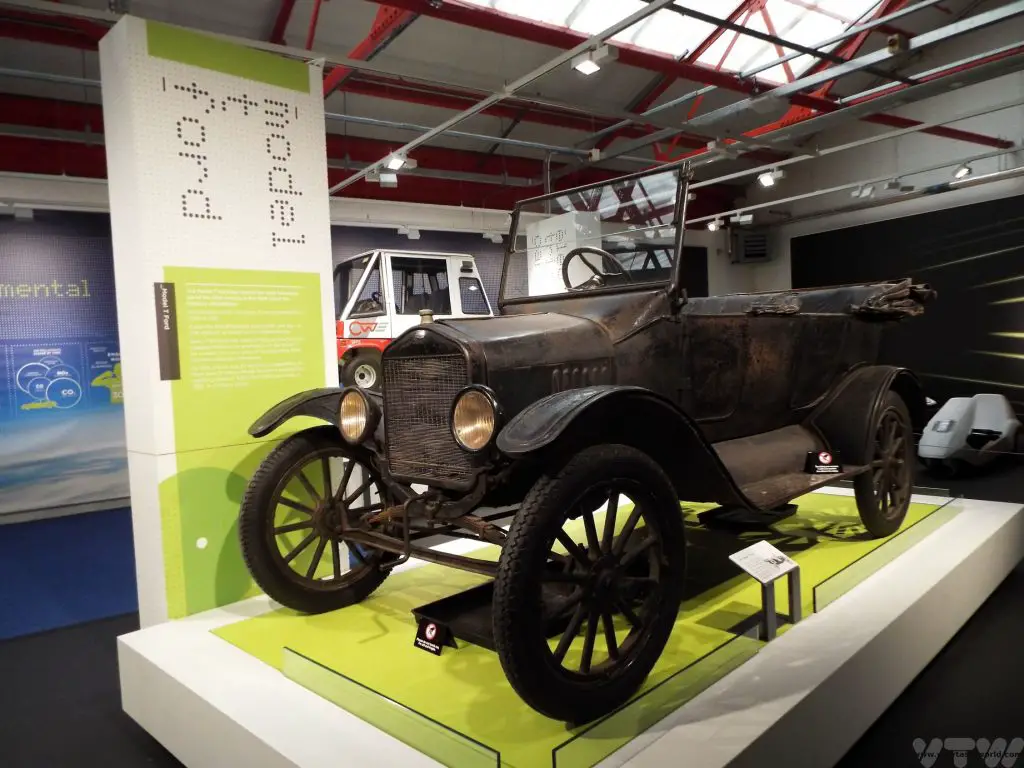
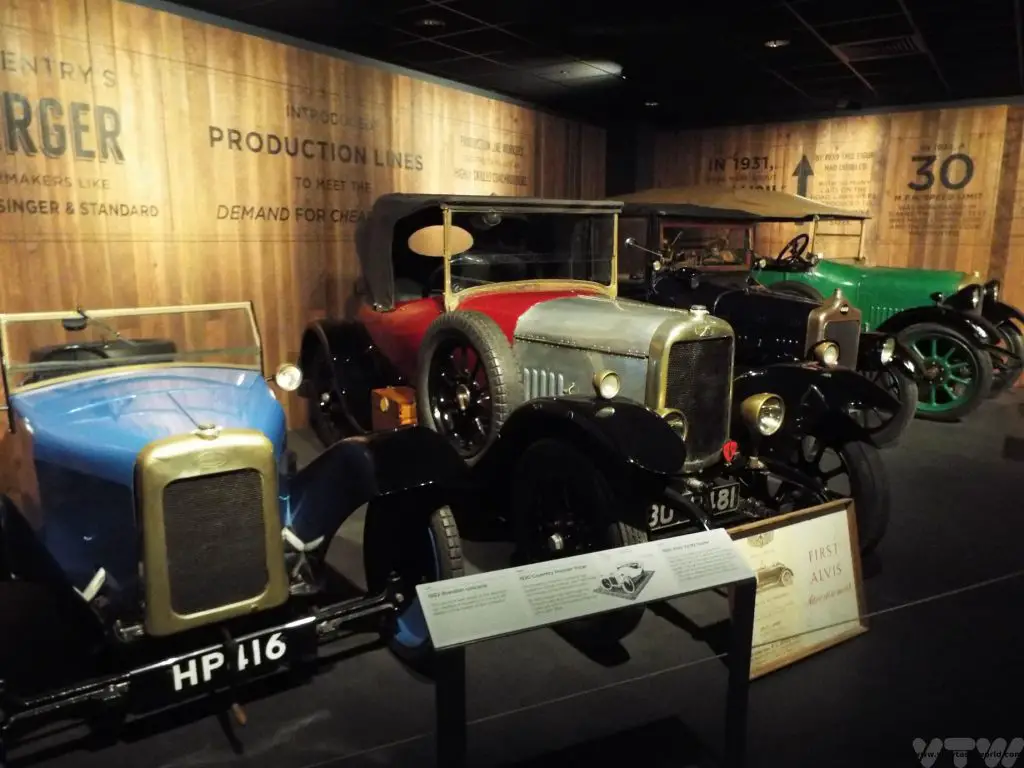
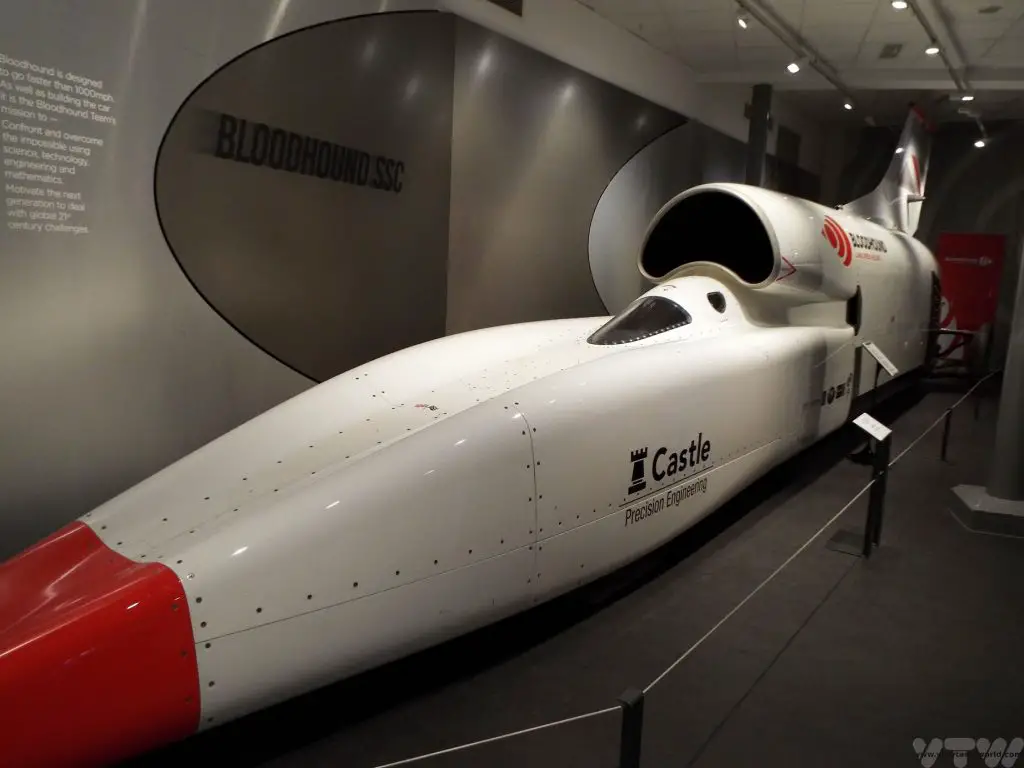
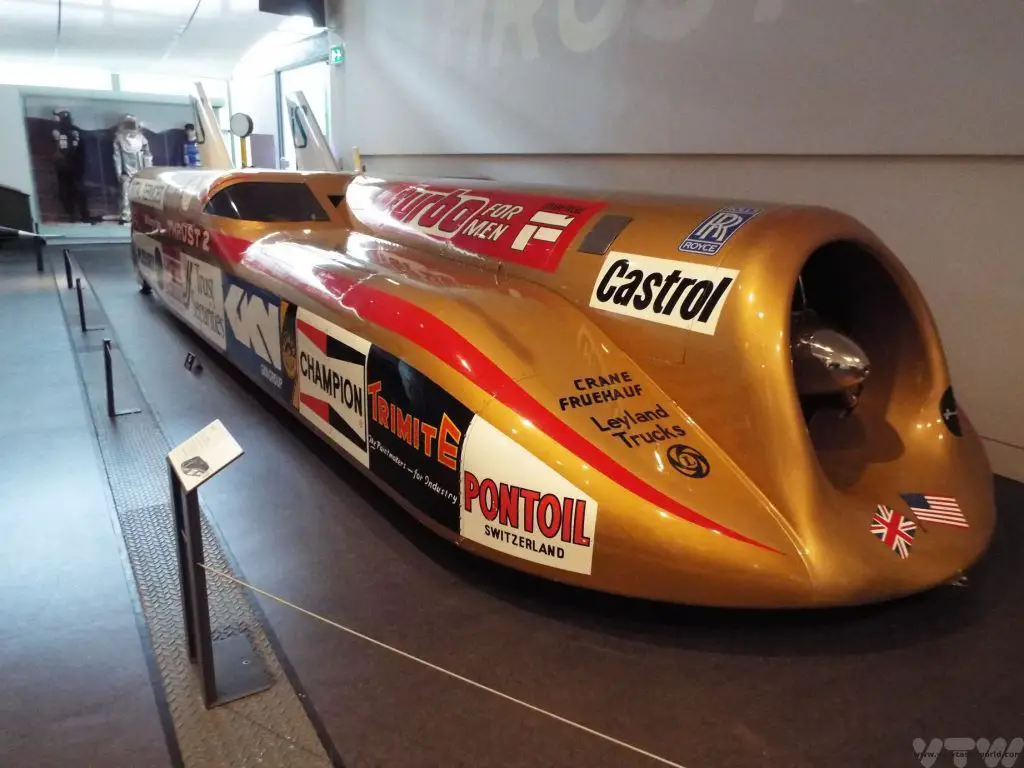
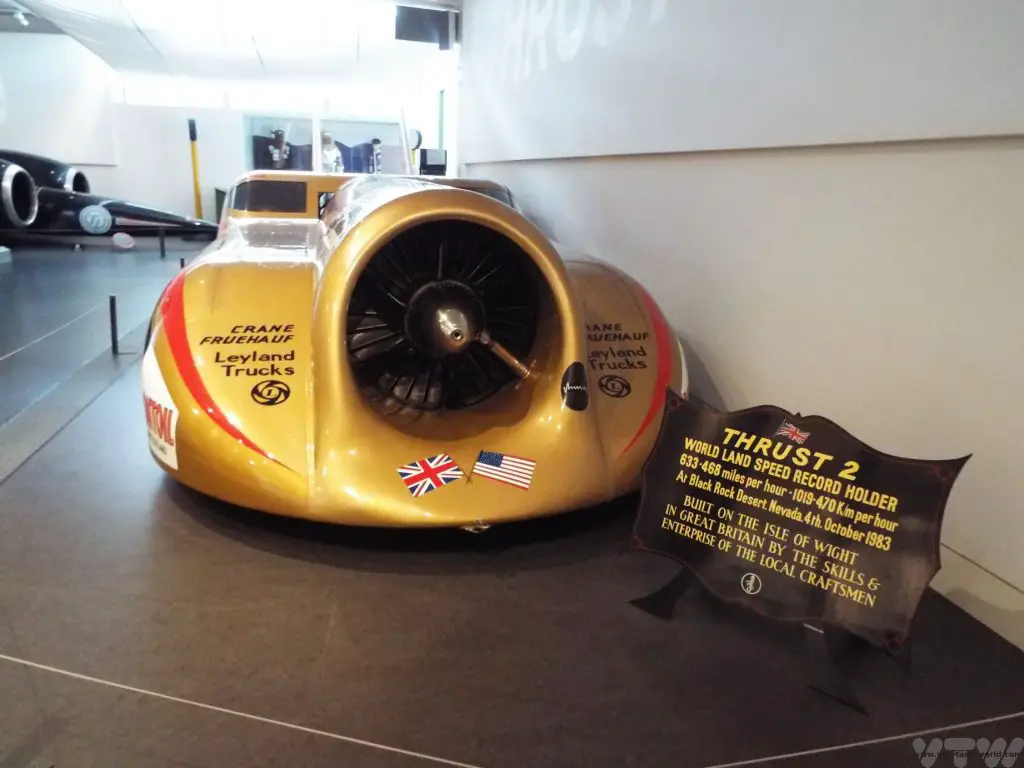
The Weaver’s House (Spon End) is a fascinating listed building which is quite unusual because it was the home of a poor person. Historic buildings are normally preserved because they are great big stately homes owned by important people.
The weaver’s house is a remarkable construction because it has an internal jetty for the weaver’s loom, which is very rare. The weaver’s house is located close to the river Sherbourne before it enters the city, so the water would have been clean for washing and dyeing the cloth. The house doesn’t have regular opening hours, but check the website for the next open day when you can learn about its history and also visit its mediaeval garden.
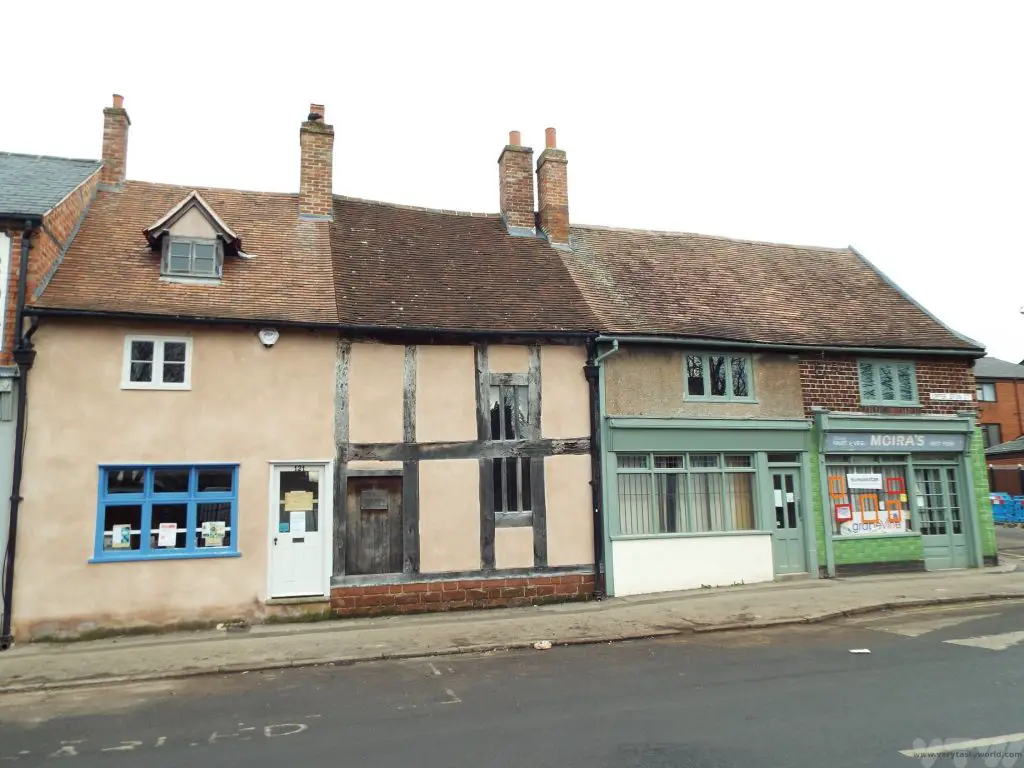
Watch Museum A small but interesting museum dedicated to Coventry’s watchmaking heritage.
Charterhouse
Located on the London Road, just over a kilometre outside the city centre, this former monastery was founded in 1381. It was a Carthusian monastery, home to a silent order of monks who each had their own cells (actually like small houses with walled gardens) in which they would meditate, pray, read and copy books. They would meet in church or at mealtimes – and meals were eaten in the refectory which is the main surviving building.
After Henry VIII’s dissolution of the monasteries the building became a private home and was modified over the years. The adjoining church and monks’ cells were lost. Its most famous resident was Robert Dudley, first Earl of Leicester who was a close friend and suitor to Queen Elizabeth I.
Eventually the building was passed to the people of Coventry and the Coventry Historic Trust set about ensuring its survival and restoring the building. It is now open to visitors.
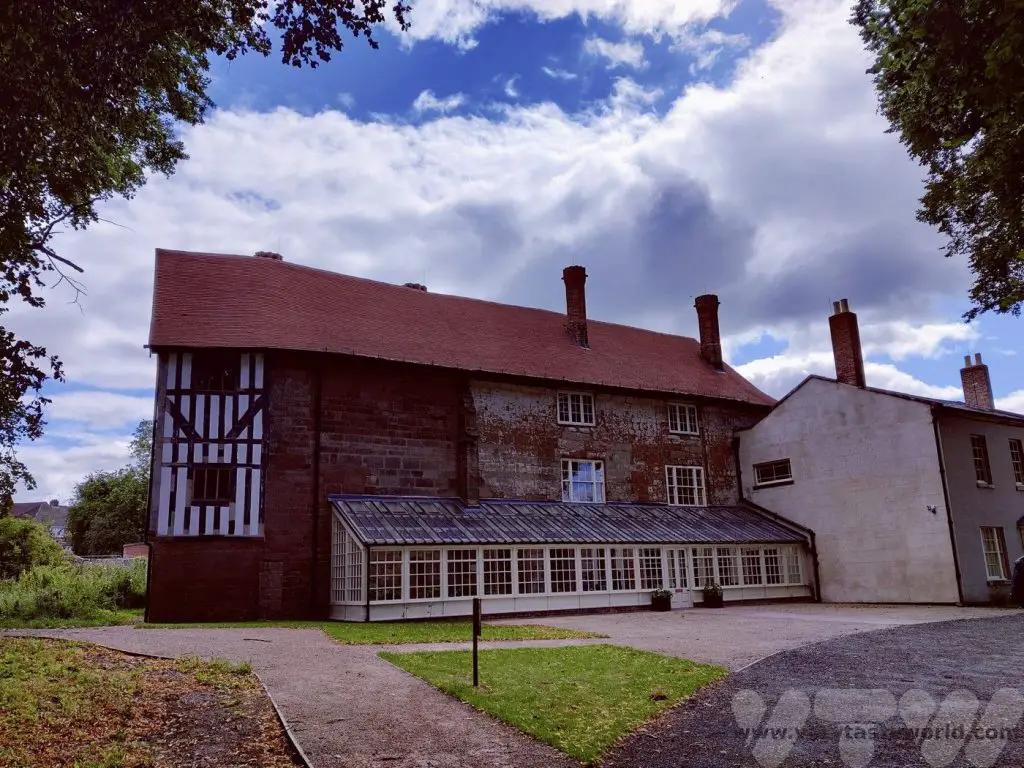
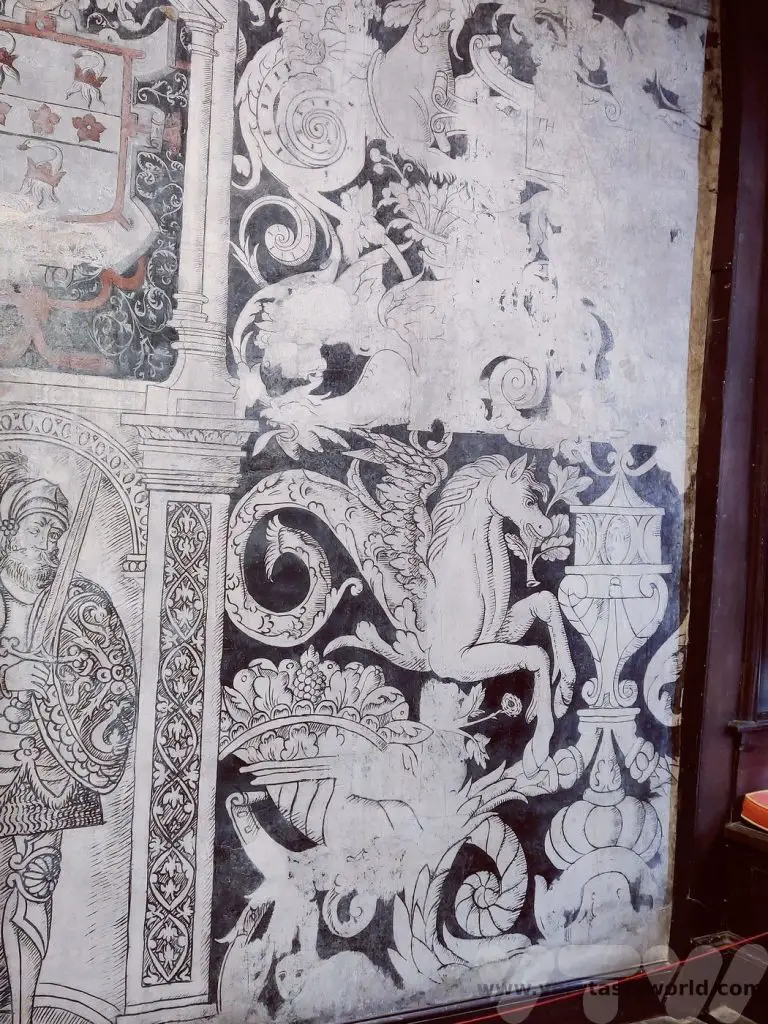
Of particular interest are the mediaeval paintings – a black and white painting dating back to the 15th century, likely to have been commissioned by Dudley.
Sadly when the monastery was converted from a two-floor to a three-floor building the top part of a crucifixion painting was lost. What remains is fascinating.
The grounds also house a kitchen garden. A bistro/café is located on site for light snacks. If you buy a ticket to visit the site, it is valid for a year from issue.
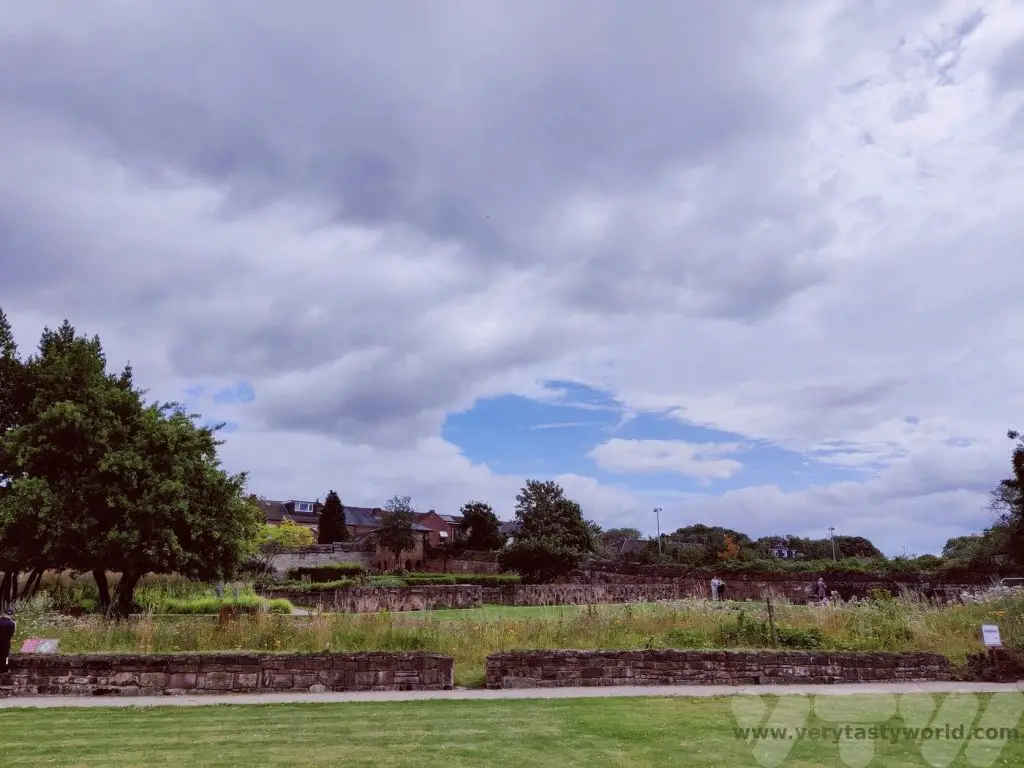
Coventry Culture
Herbert Art Gallery
A fantastic space, the Herbert has a permanent collection and regular temporary exhibitions. It’s located next to the cathedrals. With free entry to most exhibitions, it also hosted the 2021 Turner Prize.
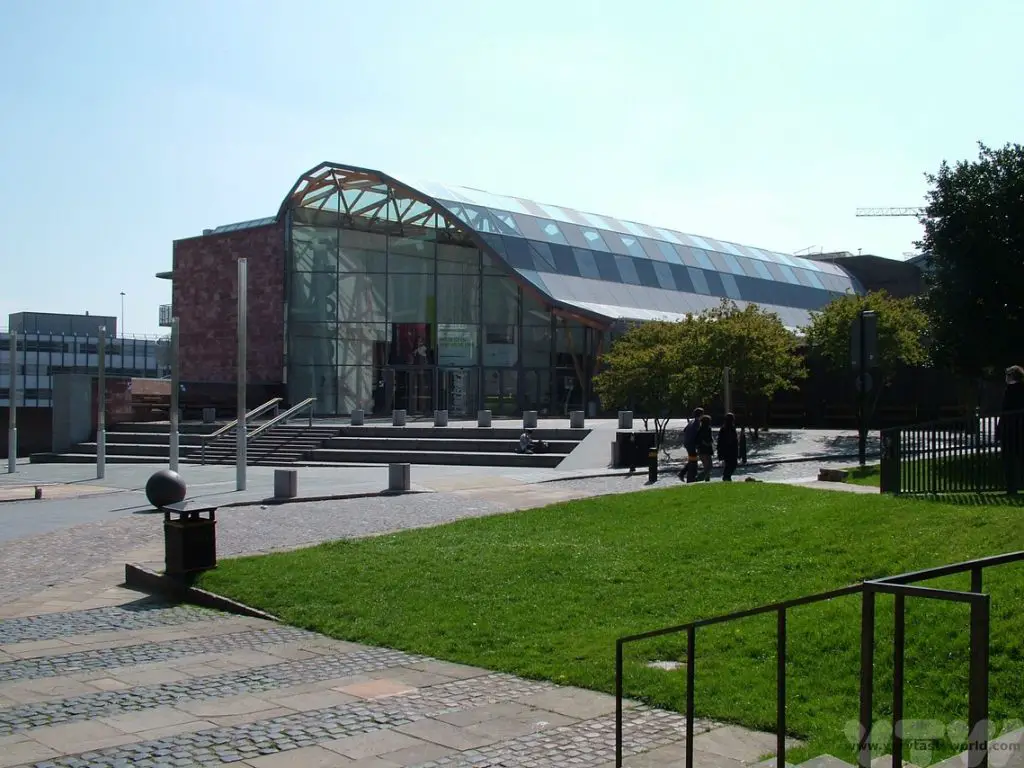
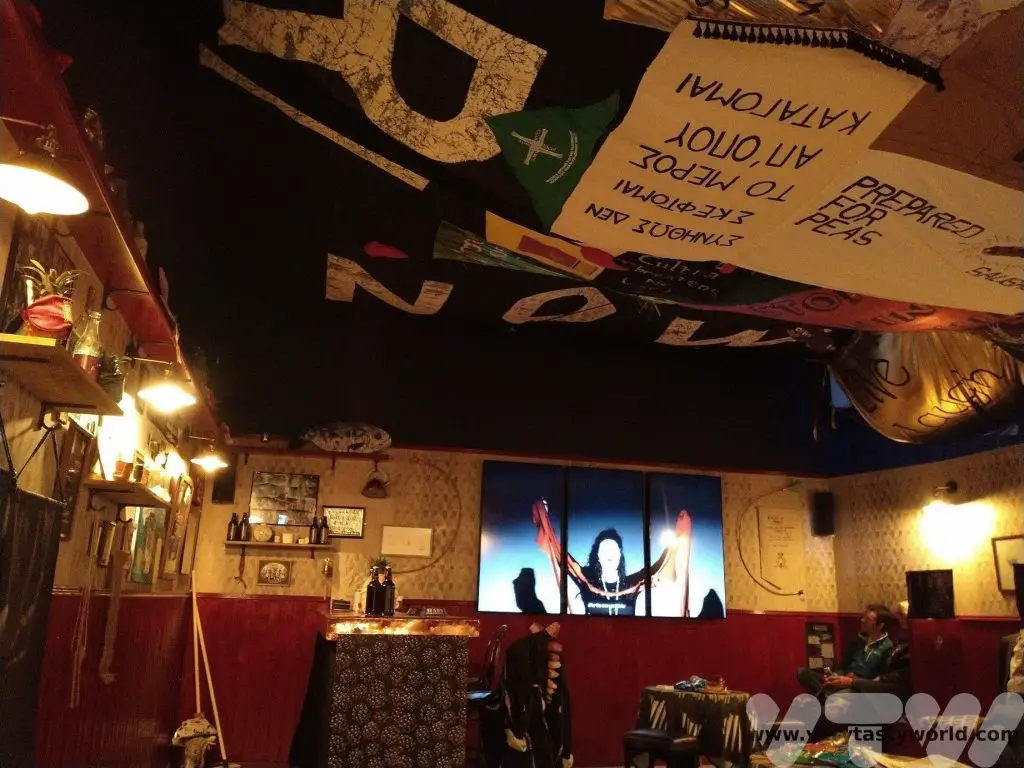
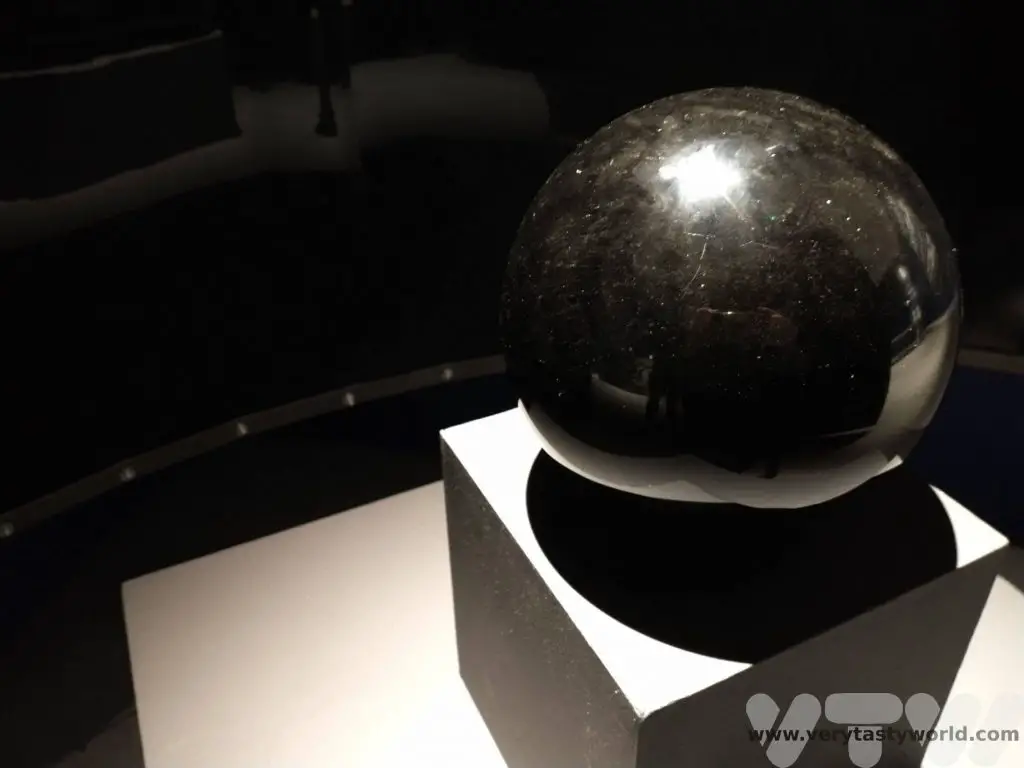
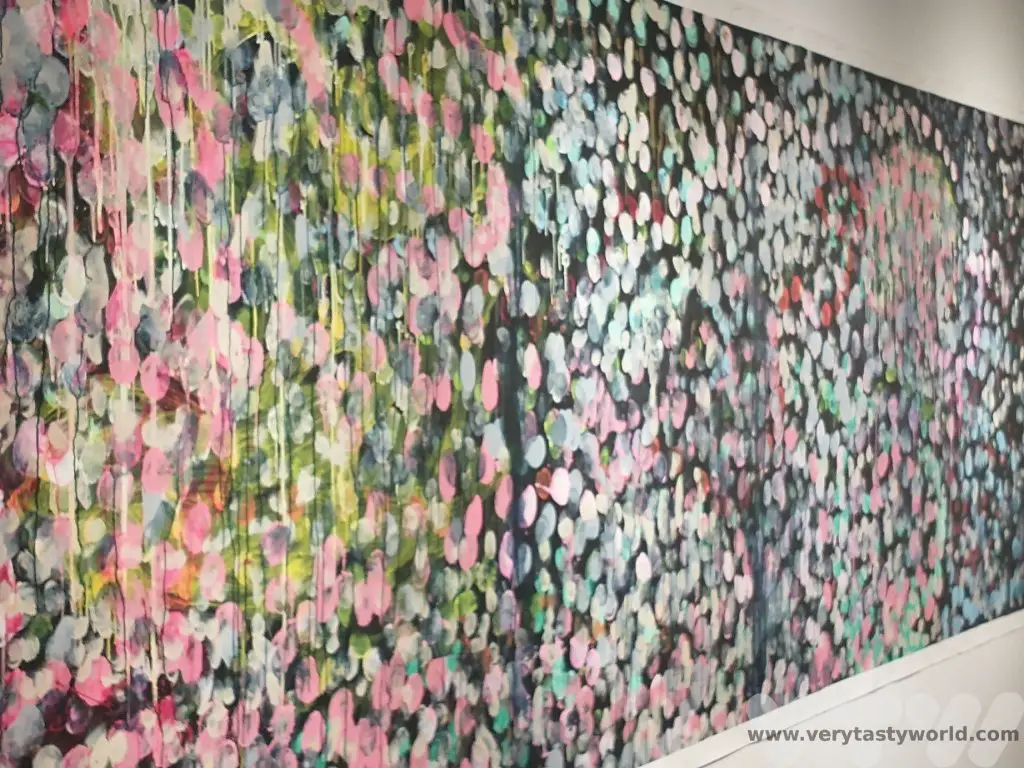
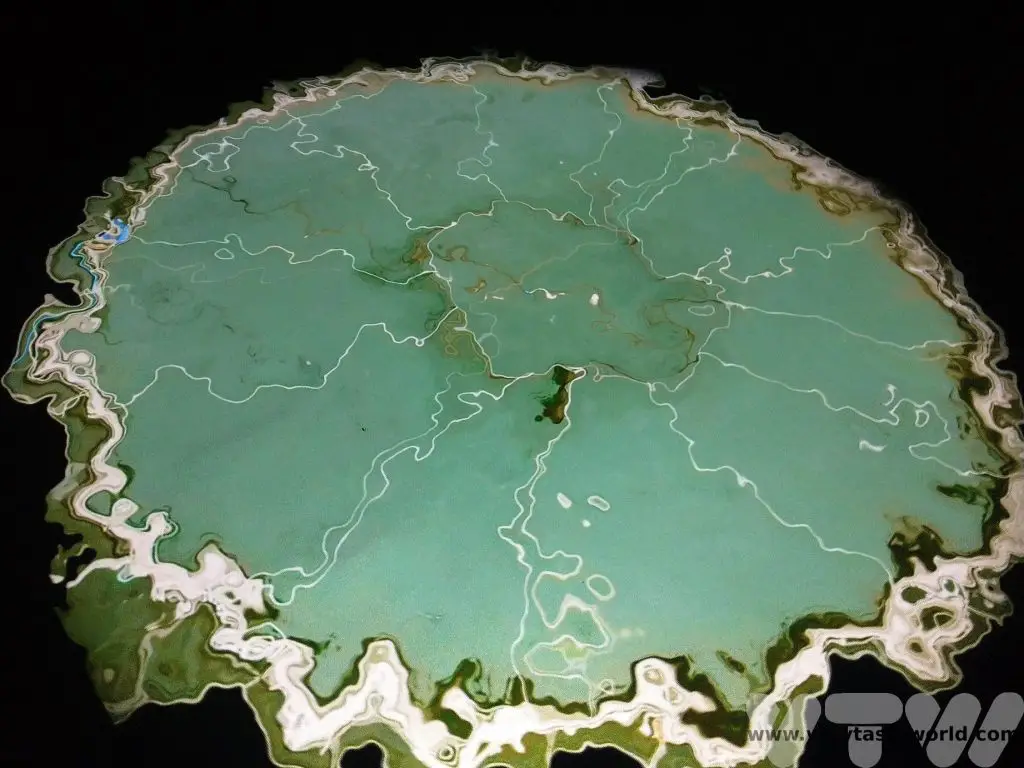
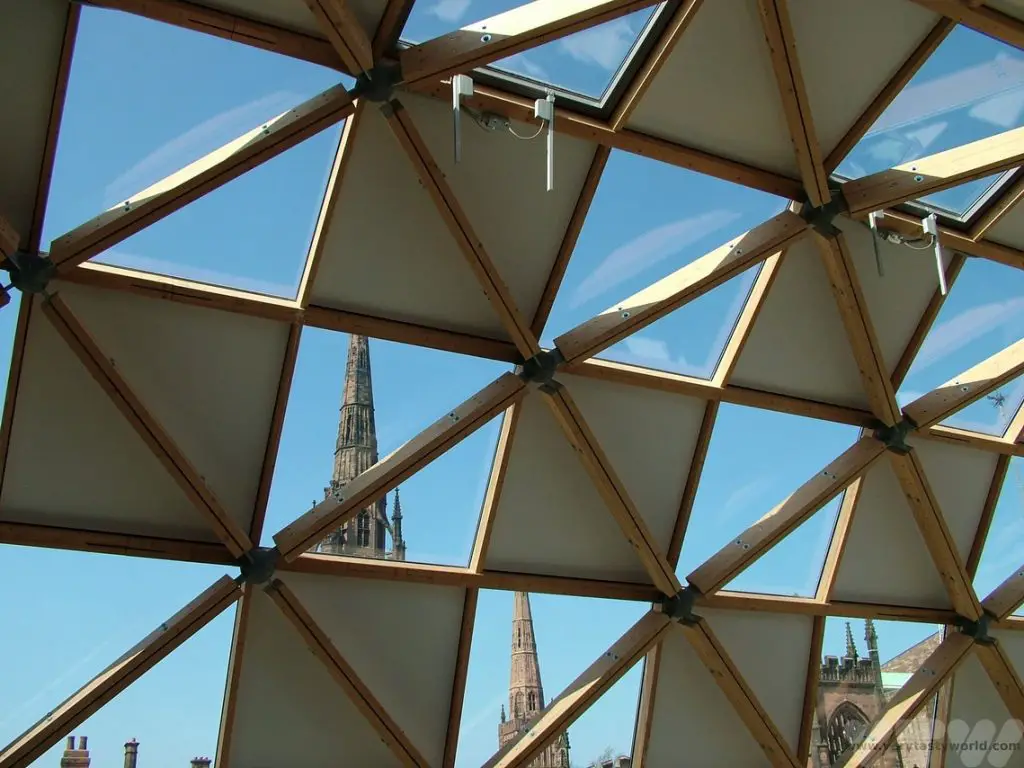
Fargo Village
Located to the east of the city, around a 15 minute walk from the city centre on Far Gosford Street, this is the Coventry’s creative quarter. With some quirky shops, great restaurants, venues and an on-site brewhouse it regularly hosts a variety of events.
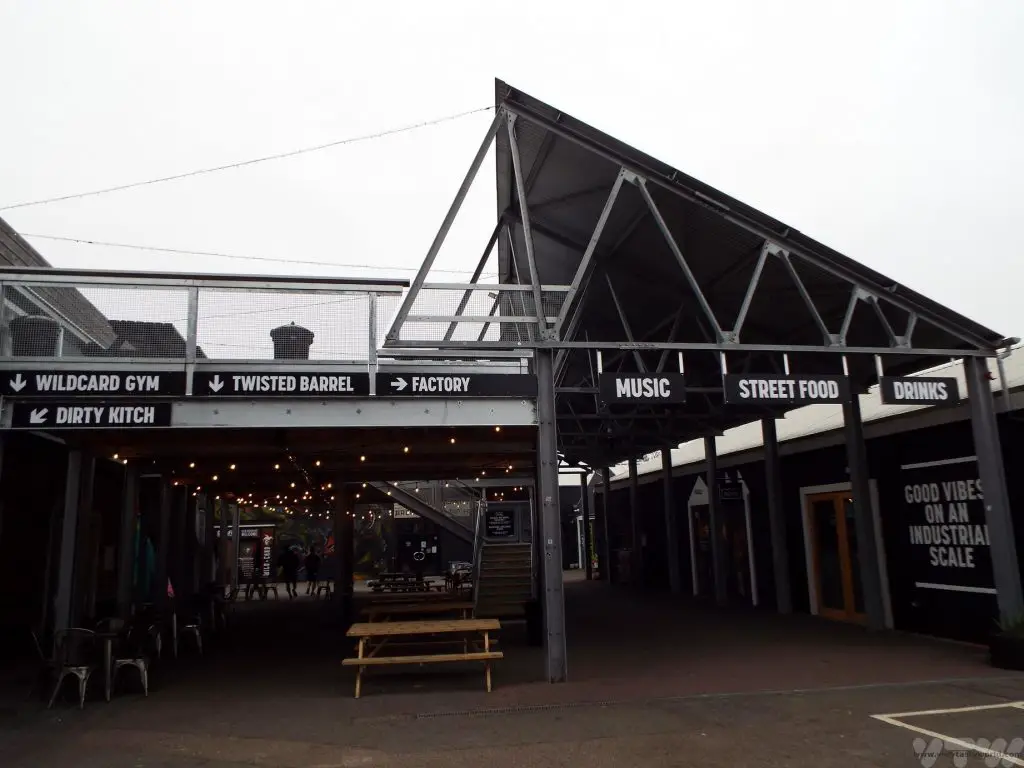
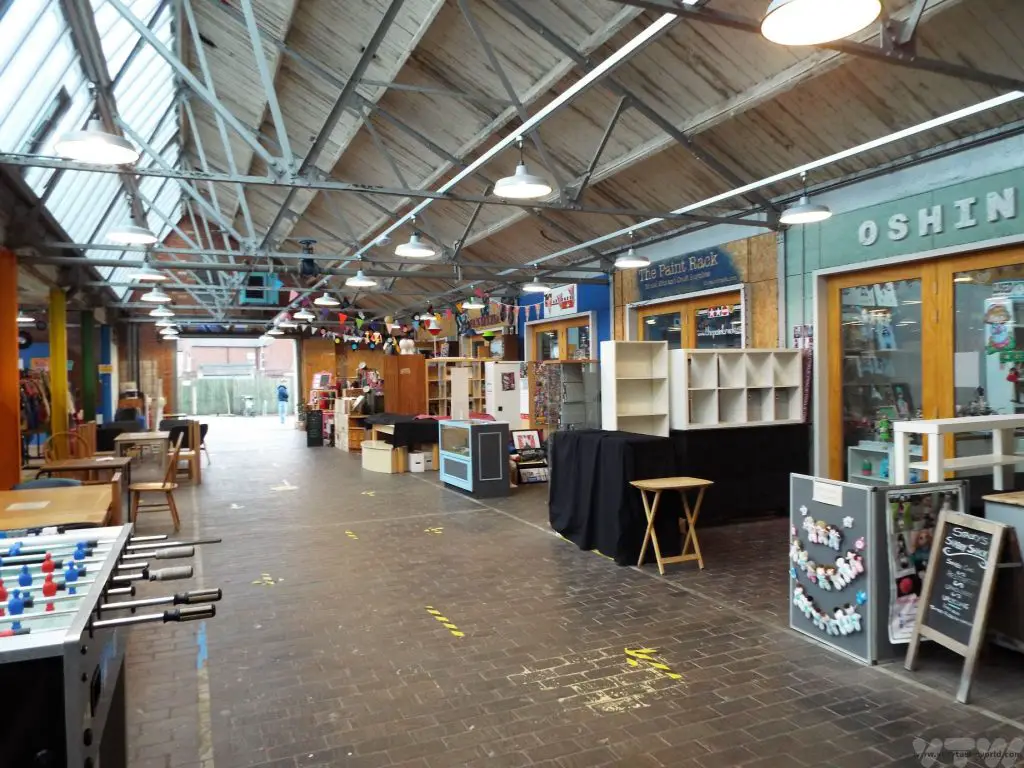
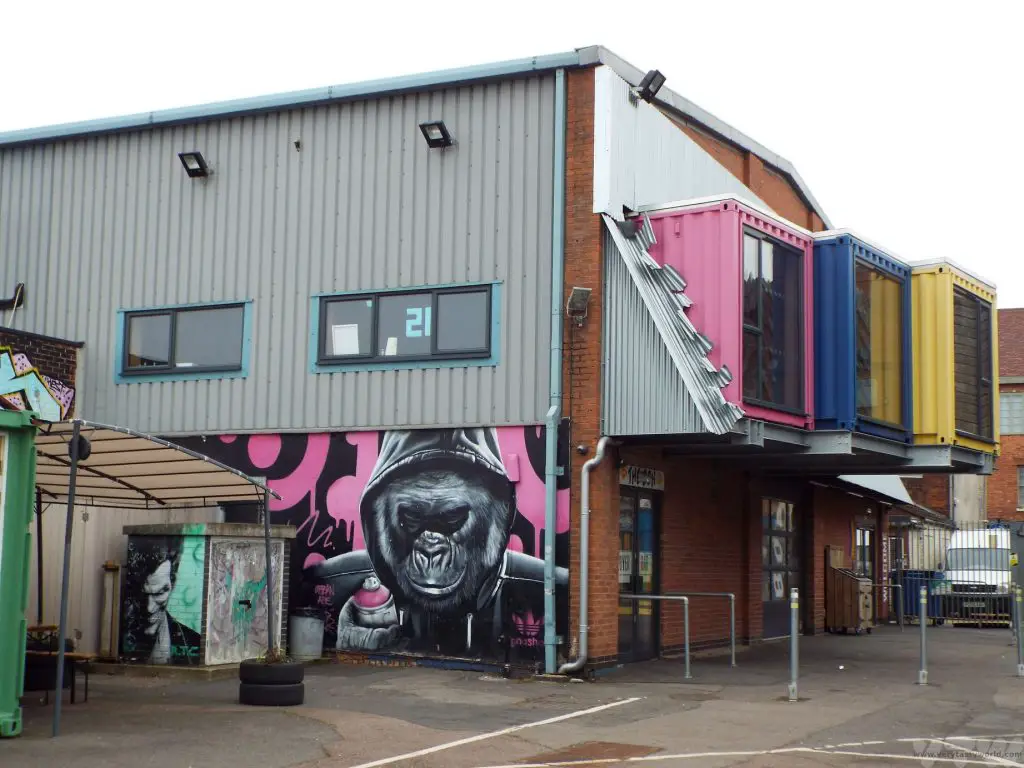
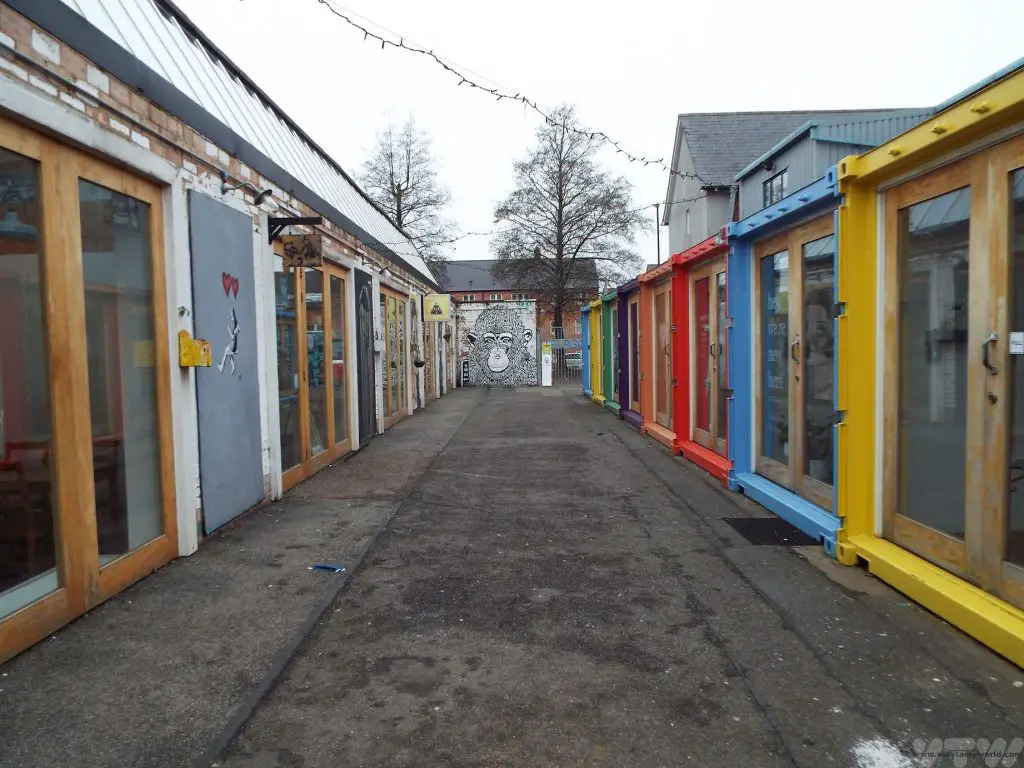
Theatre and Music The Belgrade Theatre and Albany Theatre have a great programme of theatrical productions. There are lots of venues for music gigs, including the tiny but excellent Tin Music and Arts venue in the coal vaults at Coventry’s canal basin. Warwick Arts Centre, located a few kilometres out of town at Warwick University, has a full programme of music, theatre, film and arts events.
Coventry Biennial This festival of art is held every two years. What’s great about it is that it uses multiple venues around the city and also in some of the surrounding towns.
Litten Tree Building (until late 20223). This is a pop-up art venue in a disused space above a pub. (Just enter the Litten Tree pub in the Bull Yard, on the way in from the railway station and climb the staircase). It’s totally shabby-chic inside but offers a variety of exhibitions and gigs – just feel free to explore the building discovering fabulous art along the way.
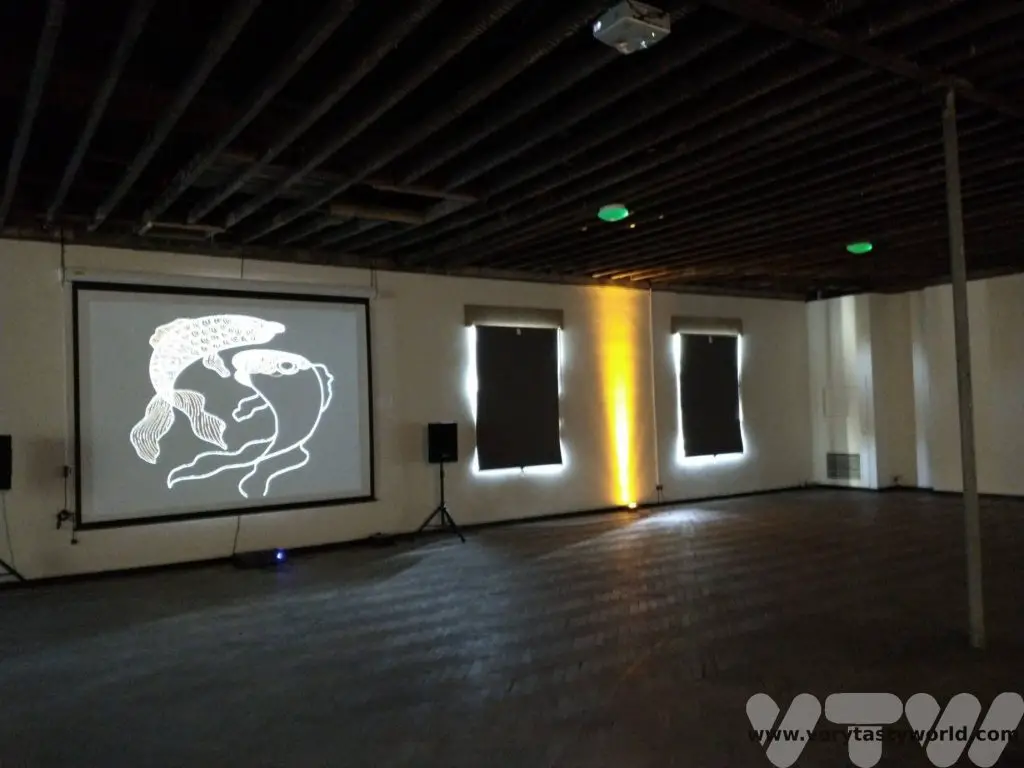
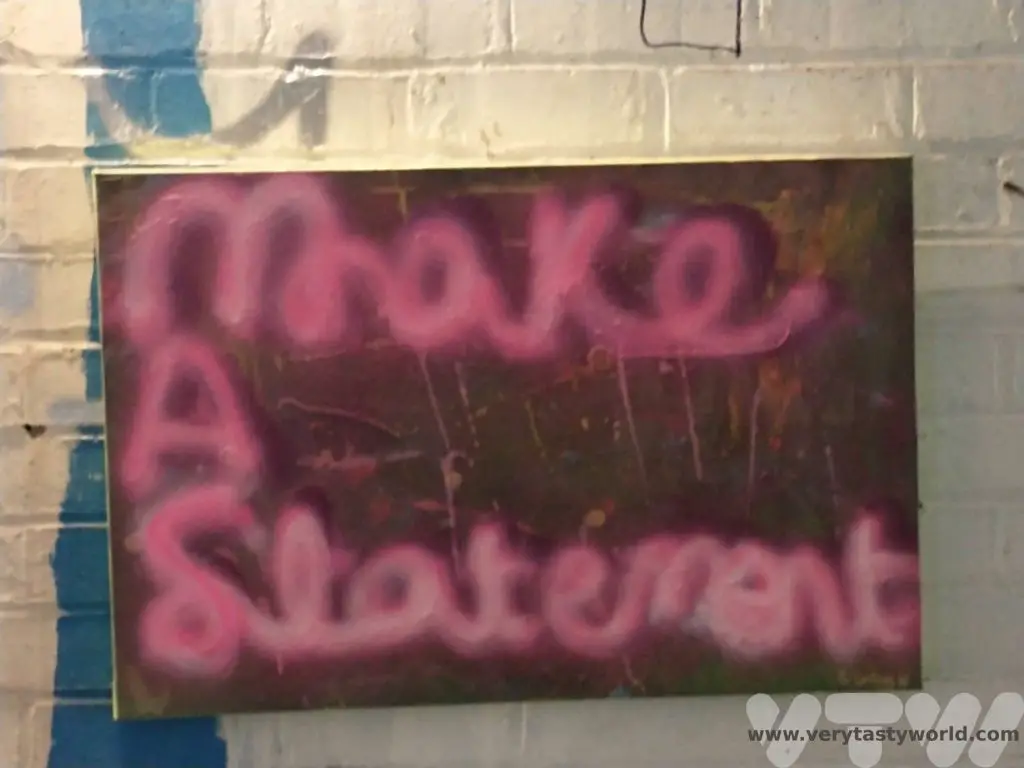
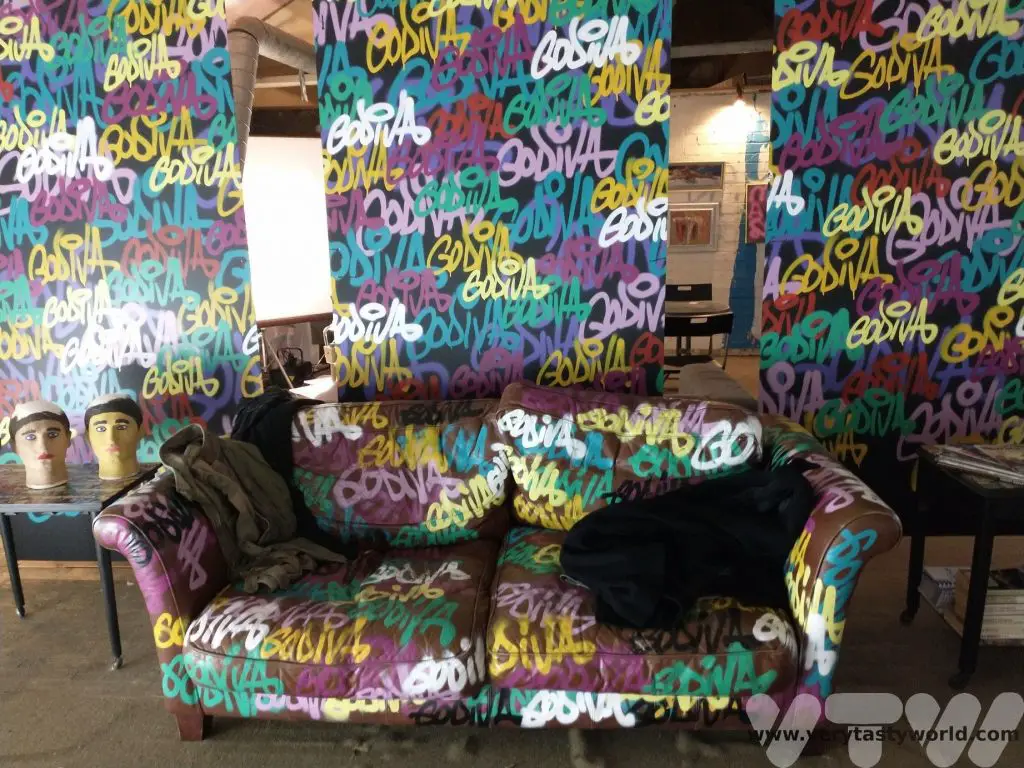
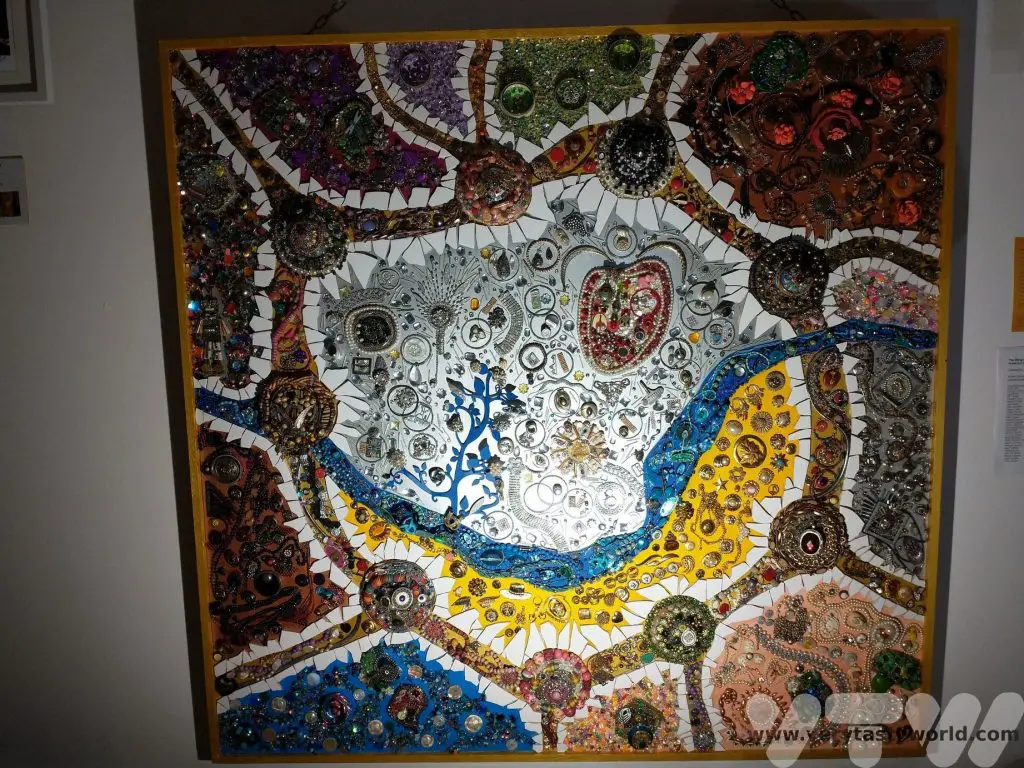
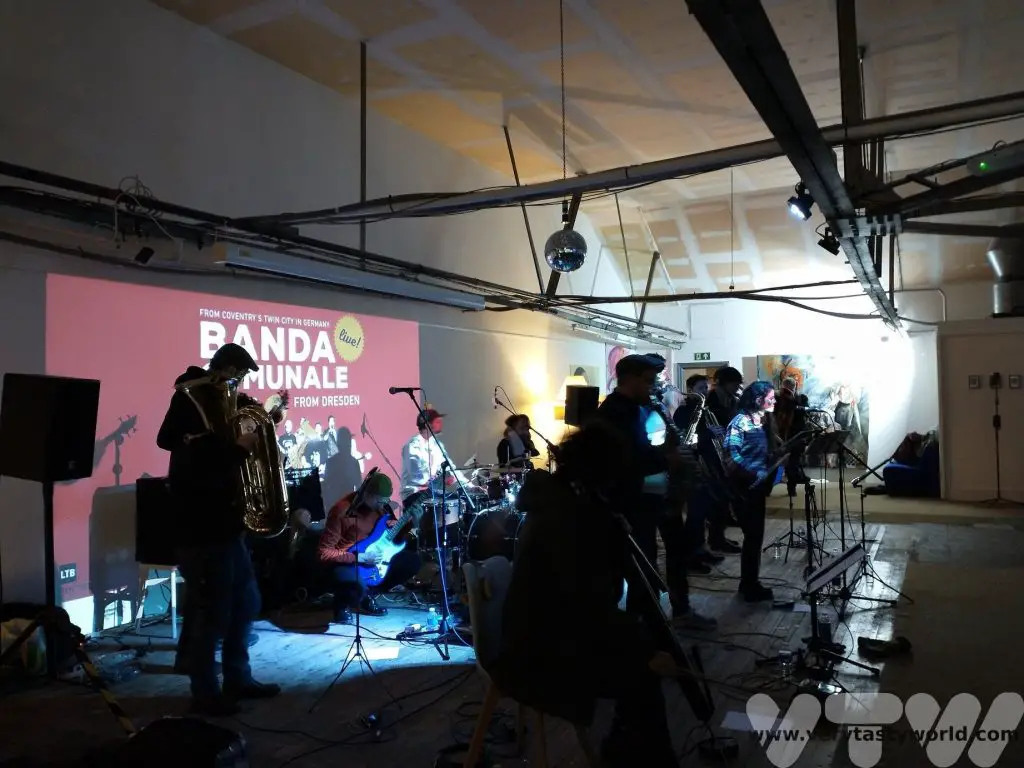
Eating -Where to Eat in Coventry
Coventry has its share of the usual chain restaurants but there are a number of excellent independent restaurants.
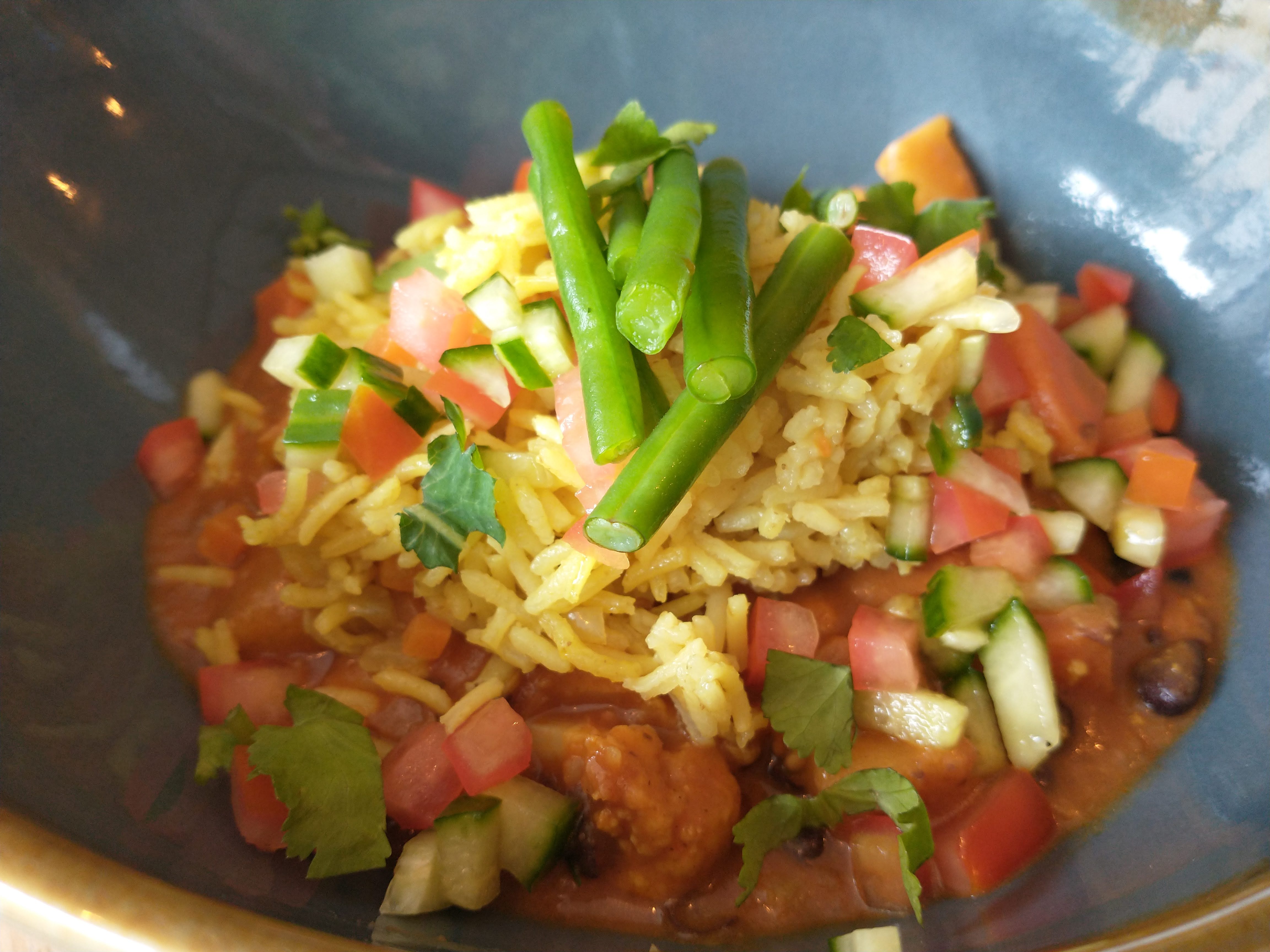
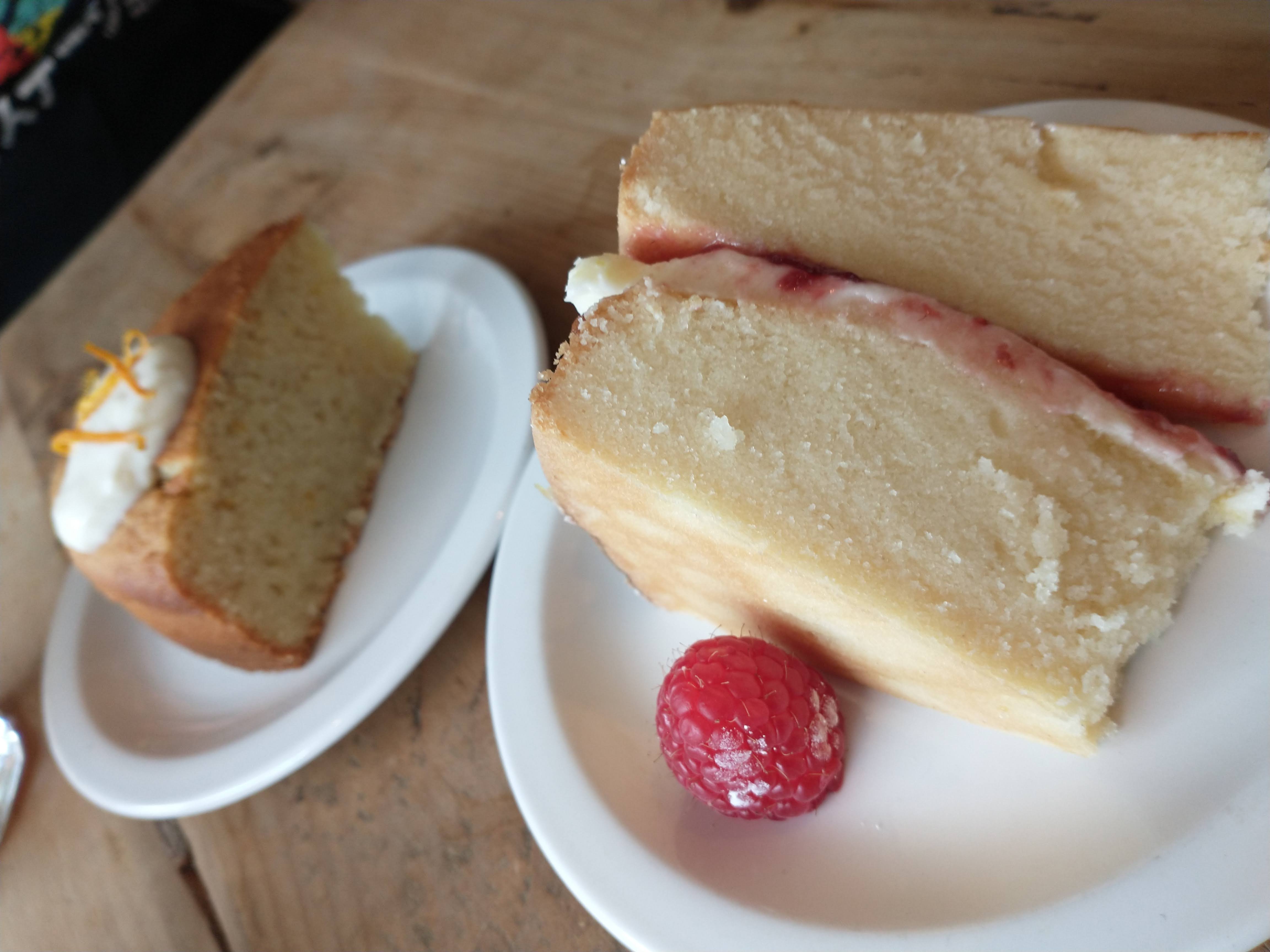
The Pod Café – this is located on Far Gosford street and is one of our favourites. A vegan café it sources local ingredients, 70% of which are grown on its Food Union (a social activism initiative run by the local council) allotment on the other side of the city (and one that we volunteer at, so we may even have helped grow your lunch). The café also runs evening supper clubs with live music. And, naturally, the food is absolutely delicious.
Gourmet Food Kitchen – one of the most difficult restaurants to get a table at for chef Tony’s monumentally delicious gourmet evenings (you have to get lucky when slots on the website are released) this teeny restaurant located in Fargo Village also offers the best cooked breakfast in the land (which you can usually just show up for). Everything is home-made and utterly scrumptious.
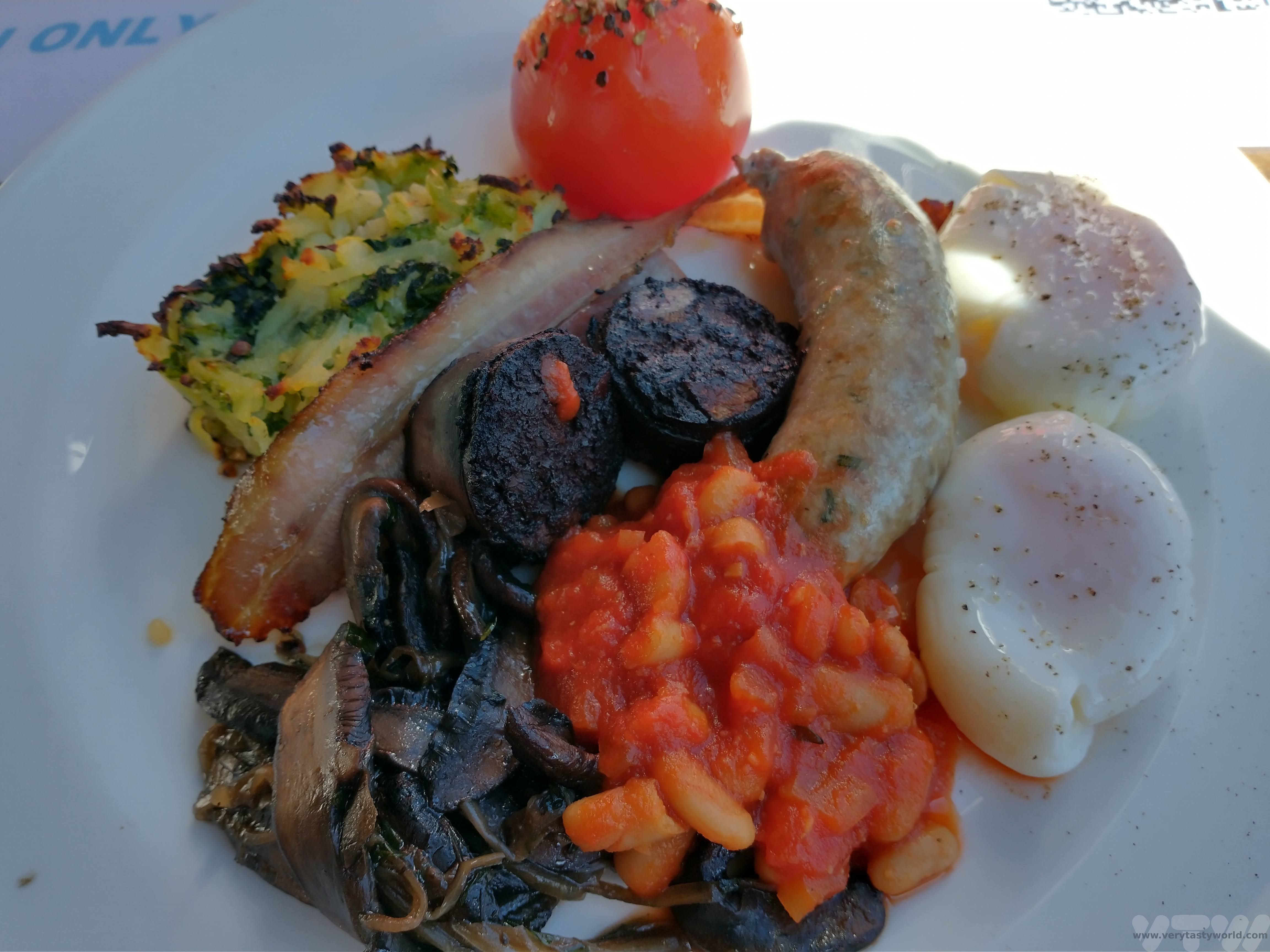
Earlsdon Supper Club (secret location in Earlsdon – you’ll find the location when you book). This is a supper club where you join chef Tobias who cooks you a delicious tasting menu and describes his inspiration behind each dish.
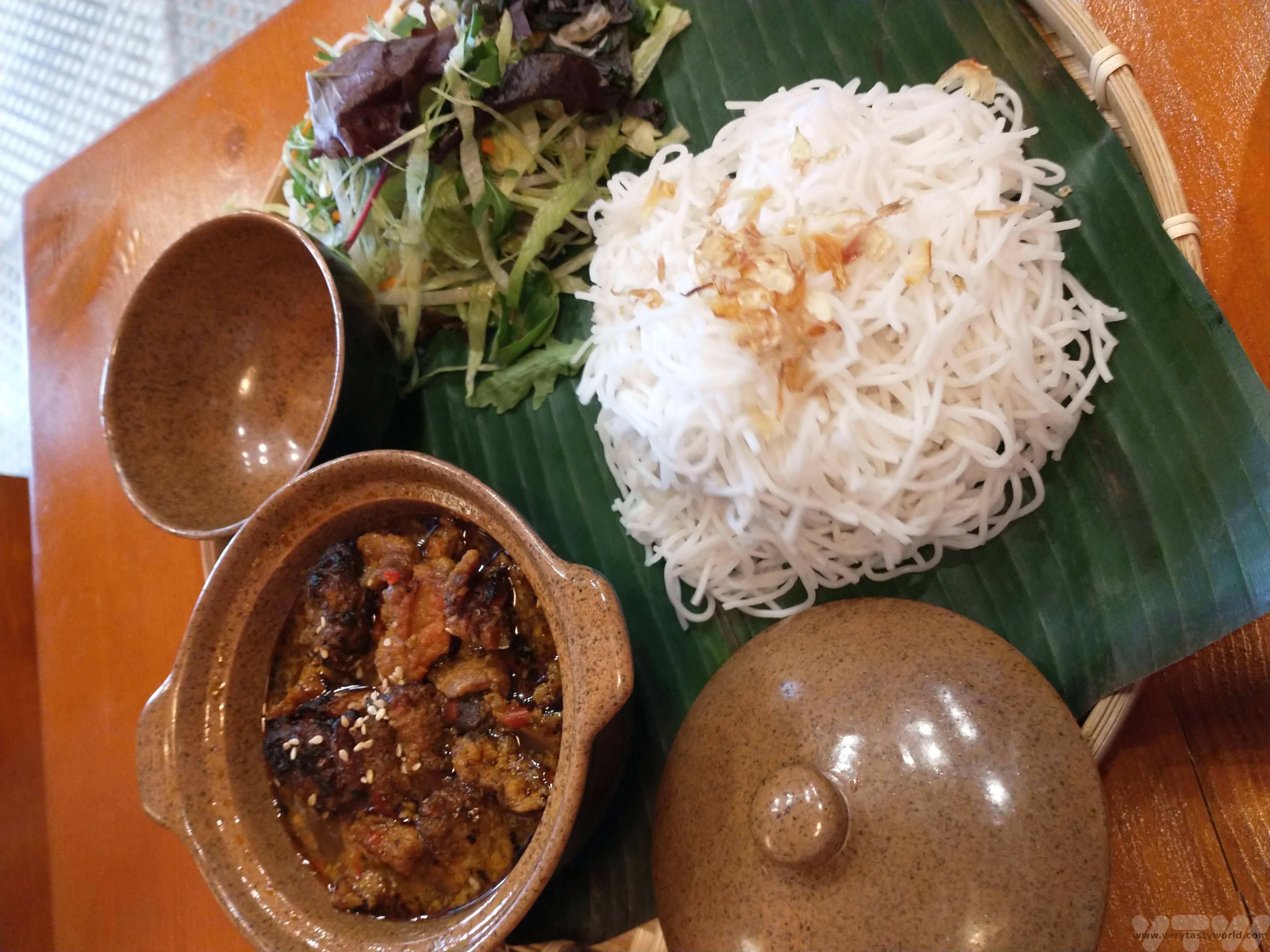
Hello Vietnam (Smithford Street) offers a wonderful array of Vietnamese dishes.
A-Sushi (Hertford Street) – best sushi in Coventry, this Korean restaurant also offers a variety of Japanese and Korean dishes.
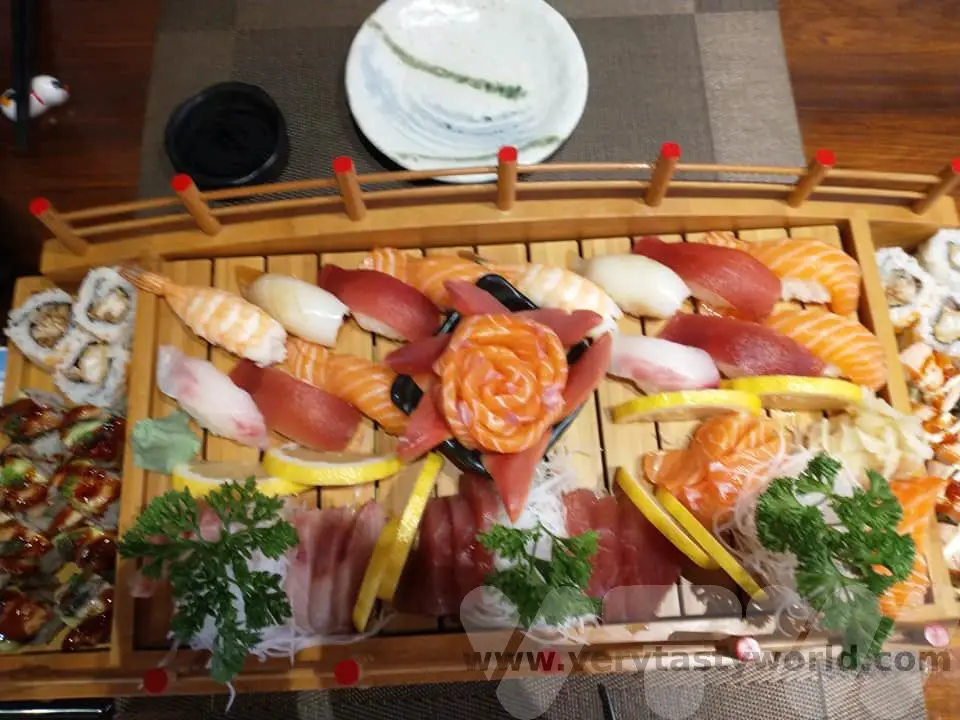
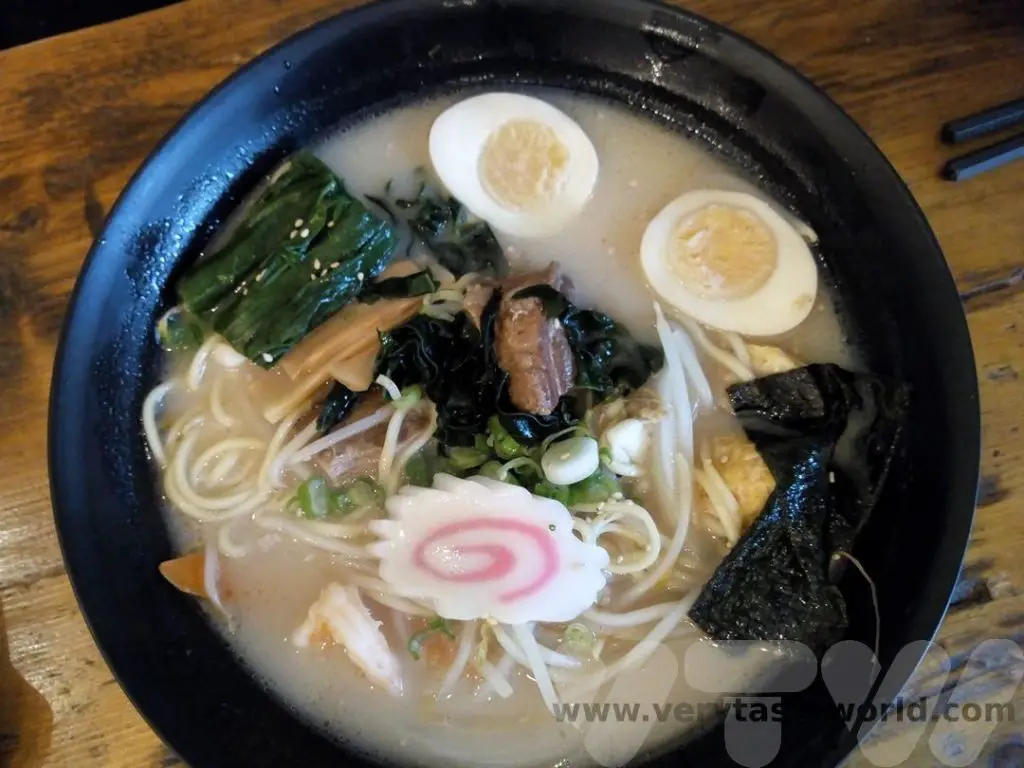
Shin Ramen (Priory Place) is a Japanese restaurant that serves izakaya style food, notably its authentic ramen noodles. The tonkotsu and champon ramen are particularly good.
Jinseong Korean BBQ (Priory Place) – meat eaters can enjoy Korean BBQ where you can cook a variety of meats over a charcoal fire. Their KFC (Korean Fried Chicken) is also delicious.
Pickles (Spon End). There are so many excellent Indian restaurants in Coventry (as there are all over the Midlands) but we’re big fans of Pickles where you get a warm welcome and delicious curries.
Tamils Taste of Asia (Foleshill Road) offers superb and authentic South Indian cuisine. Great if you are hankering after dosas, biryani and idli.
Anatolia (Earlsdon Street) offers amazing Turkish food with great mezze and succulent kebabs.
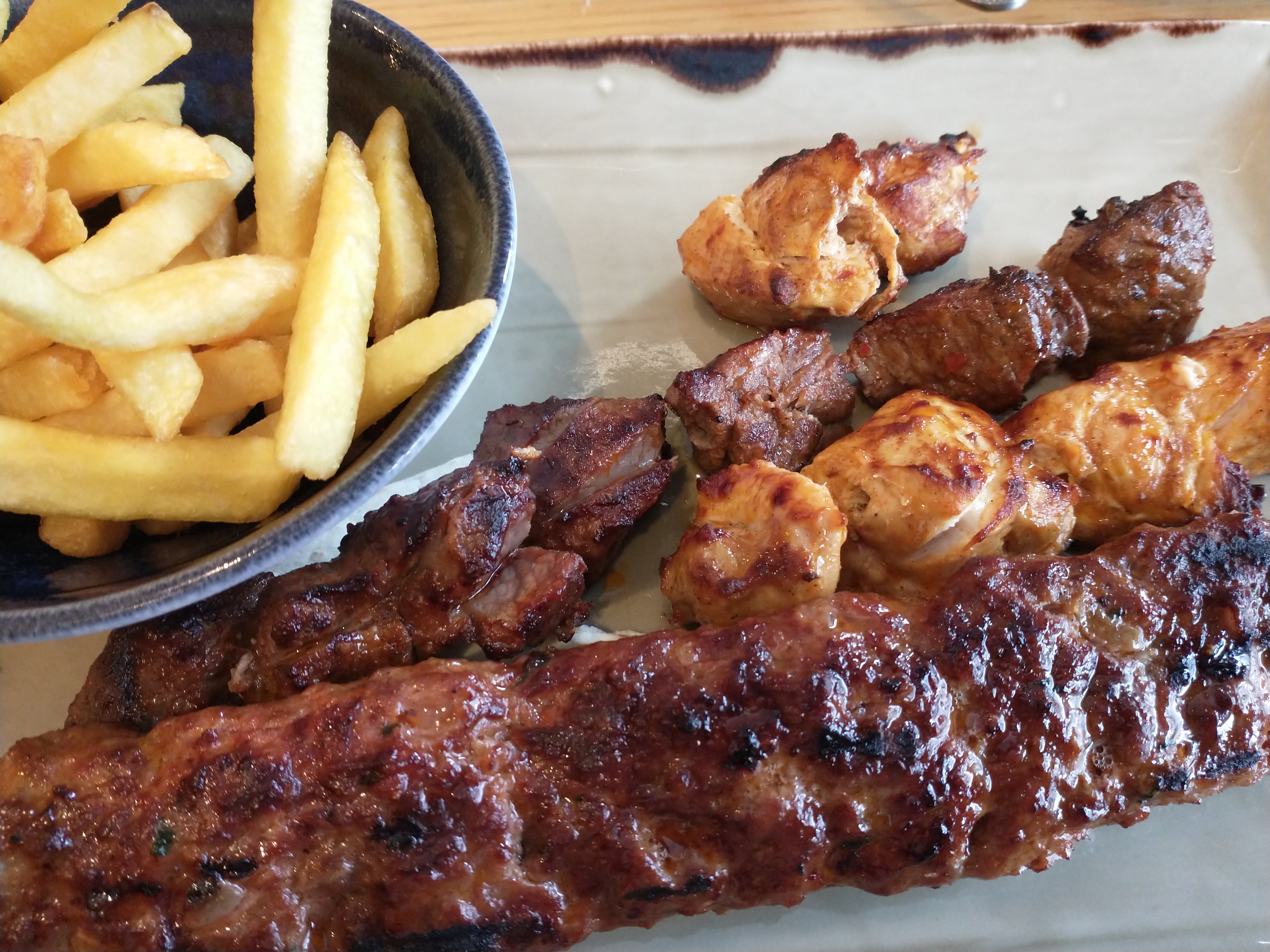
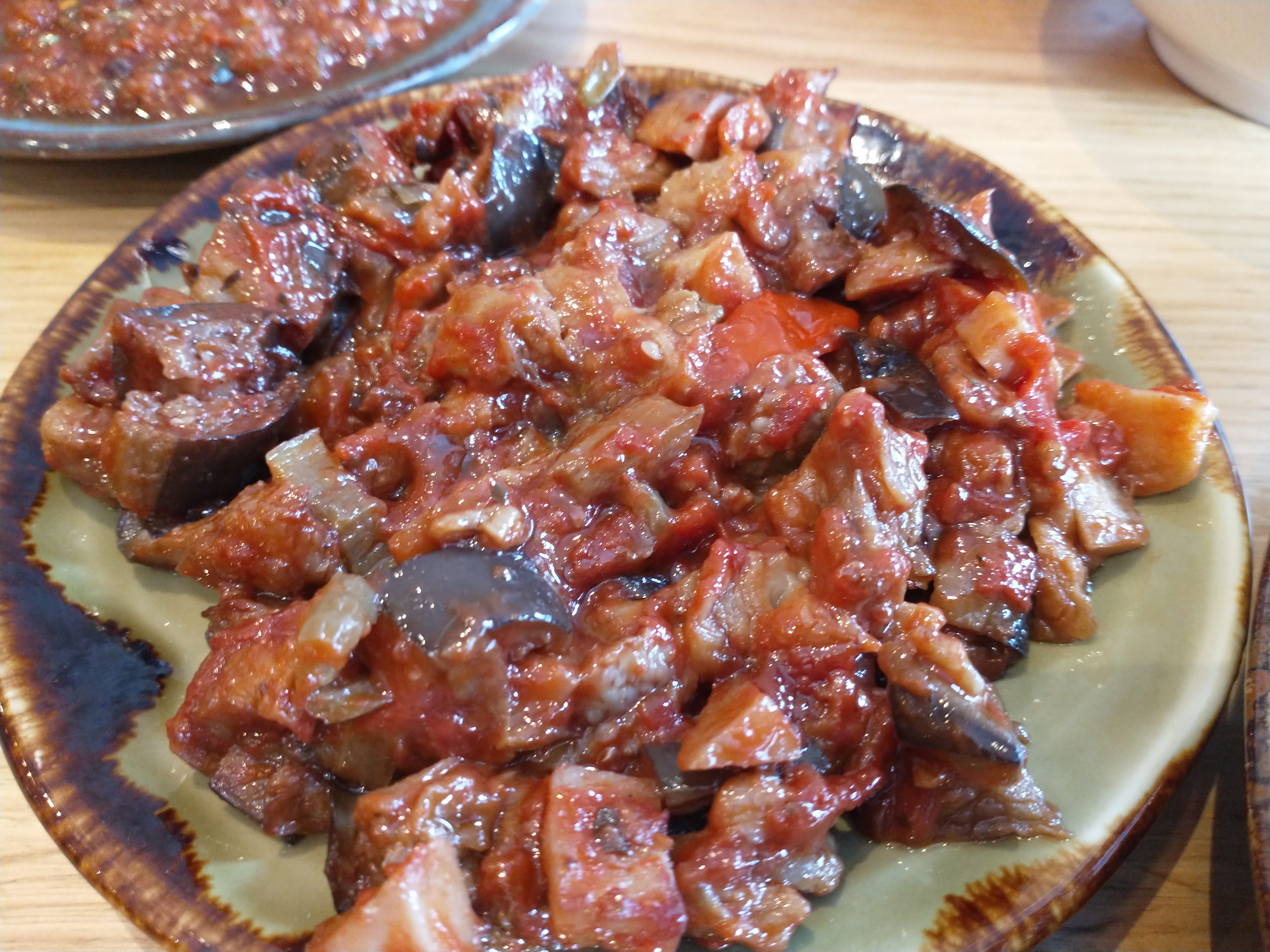
Drinking – Where to Drink in Coventry
Hops D’Amour – is a lovely micropub on Corporation Street serving craft beer, real ale and a variety of ciders. You can be sure of a friendly welcome and that you will have a different and interesting beer or cider experience every time you visit.
Broomfield Tavern – great beers and a huge variety of ciders are to be found in this small pub just outside the city centre, close to the Butts rugby ground. Teddy, the huge St Bernard dog, will offer a warm welcome, even if he sometimes pinches your seat.
Twisted Barrel – a brew-pub located in Fargo village. They offer a great variety of home-brewed and guest beers. They also have a mail order service so you can order their excellent beers online.
The Old Windmill – one of Coventry’s oldest pubs, located on Mediaeval Spon Street, this building has all sorts of nooks and crannies to sit in while enjoying your pint. It offers a great variety of beers and also locally sourced pork pies, ploughman’s platters and cheese boards.
Beer Gonzo (Earlsdon Street) – located in the suburb of Earlsdon this beer shop and tap room offers a wide variety of interesting beers from around the world. They regularly run “meet the brewer” events which result in a fun afternoon or evening enjoying a variety of beers. They too have an online shop.
Dhillons Spire Bar (next to the Bull Yard) is located within and around Christchurch spire, the third of Coventry’s three spires. You can sit in a personal booth (which has a heater when it’s cold) and drink locally brewed beer such as Ghost Town lager or Red Rebel IPA.
Green Spaces in Coventry
While Coventry has a reputation for being a dull concrete city, it actually has a huge number of green spaces, some close to the city centre and some a bit further out.
Lady Herbert’s Garden is located next to Swanswell Gate and the transport museum.
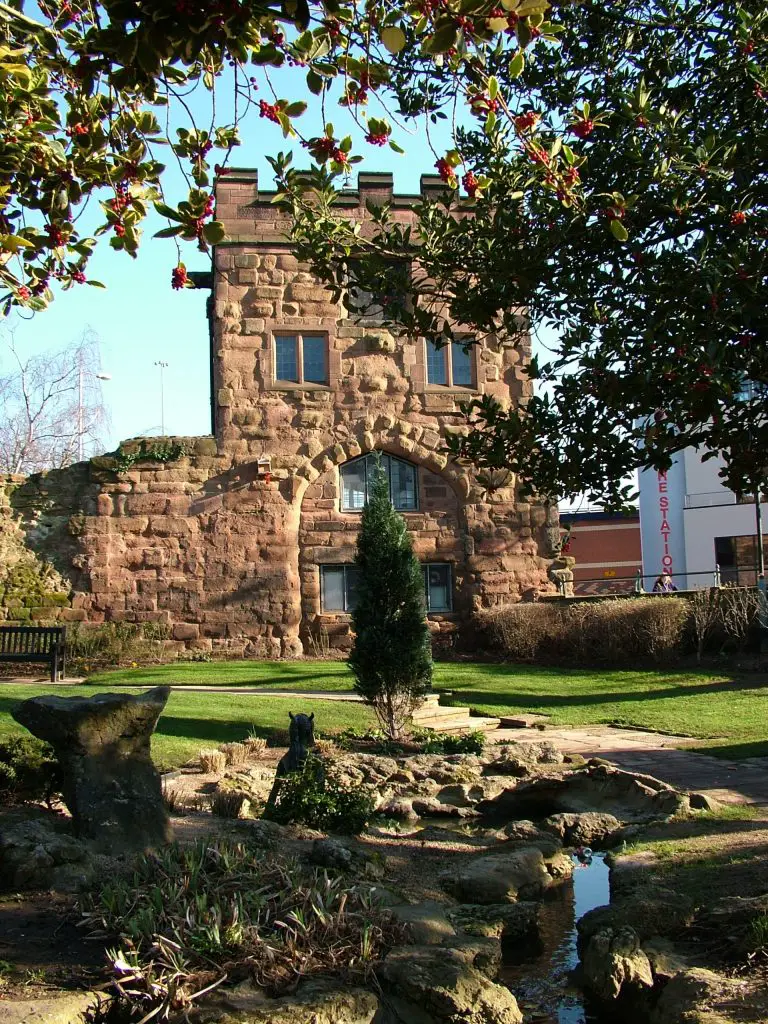
War Memorial Park is the city’s largest and best known park. Established in 1921 following World War I, it is absolutely huge and has tennis courts, football pitches, bowls green, footgolf course, an outdoor fitness trail and a cricket pitch. There are play facilities and skateboarding ramps too. It hosts the popular three day Godiva Festival every year.
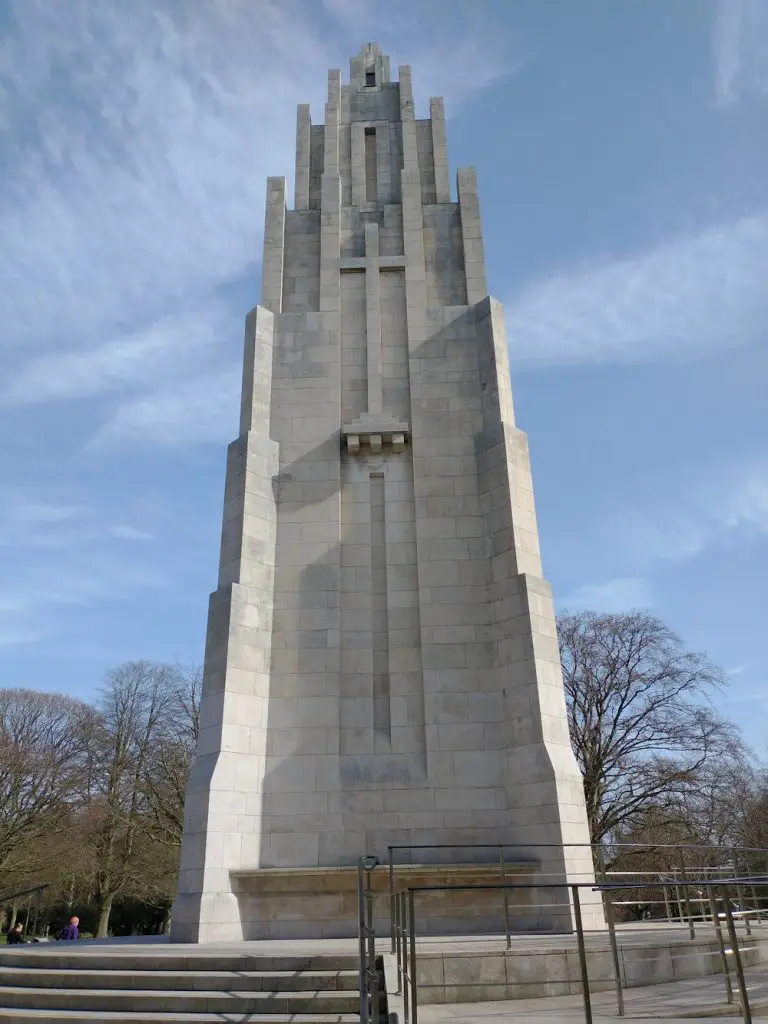
Coundon Wedge – about a mile down the Holyhead road leading out of the city towards the A45 and Birmingham, Coundon Wedge is a delightful slice of actual countryside. Coventry’s lovely little river Sherbourne flows through it.
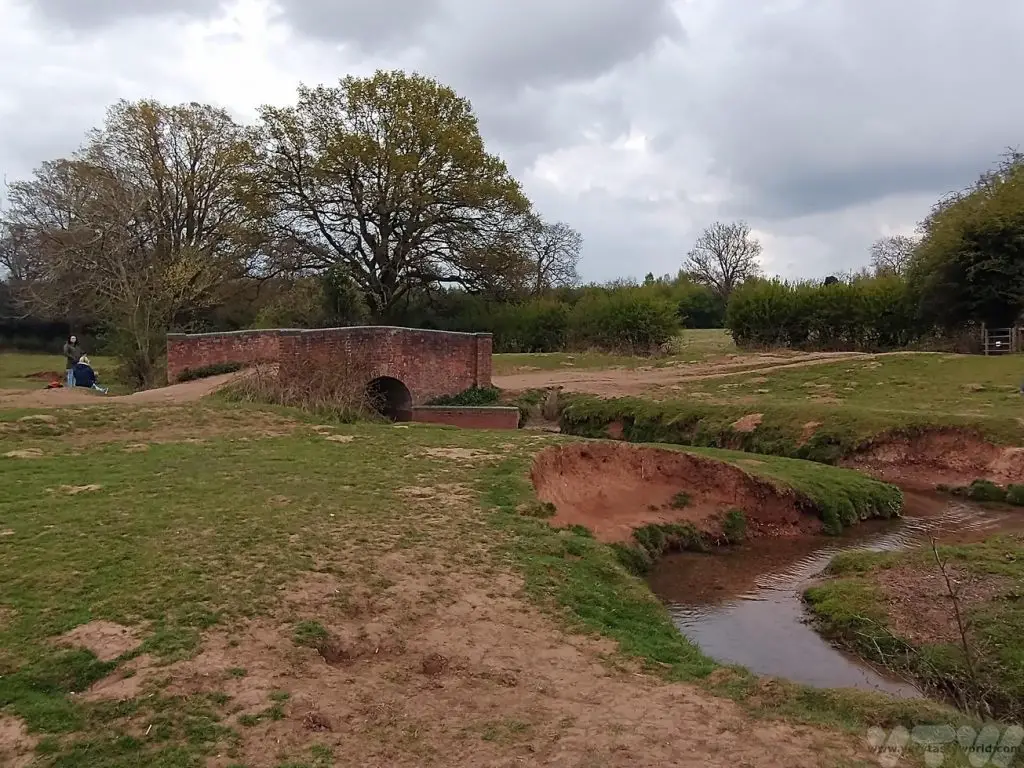
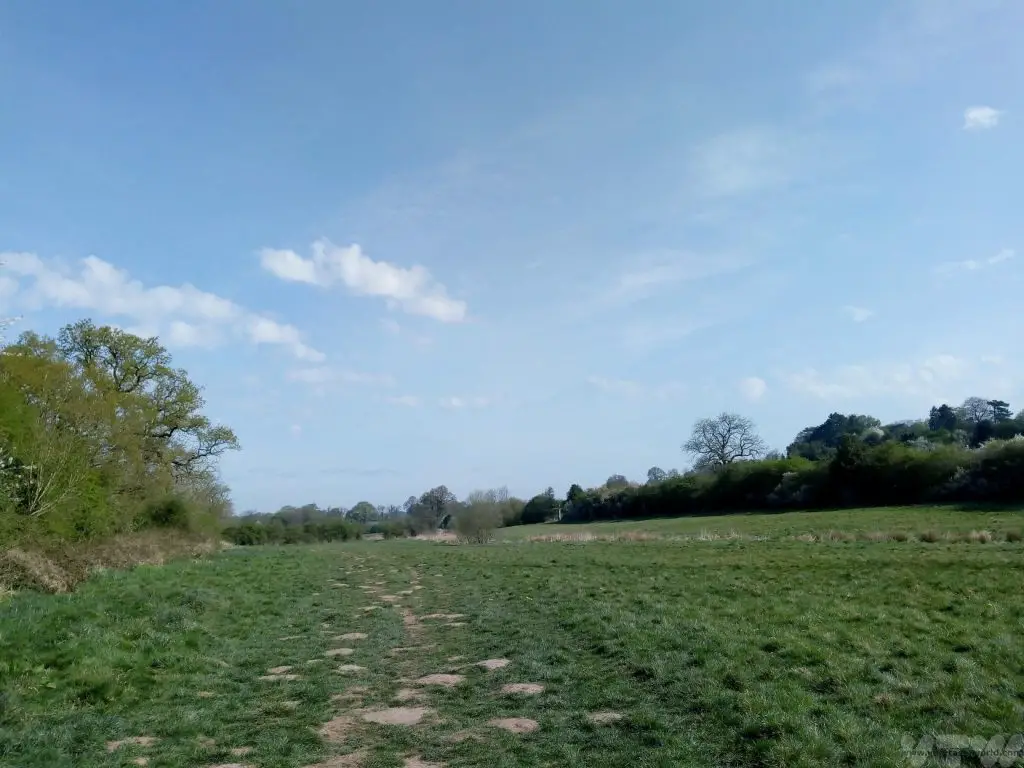
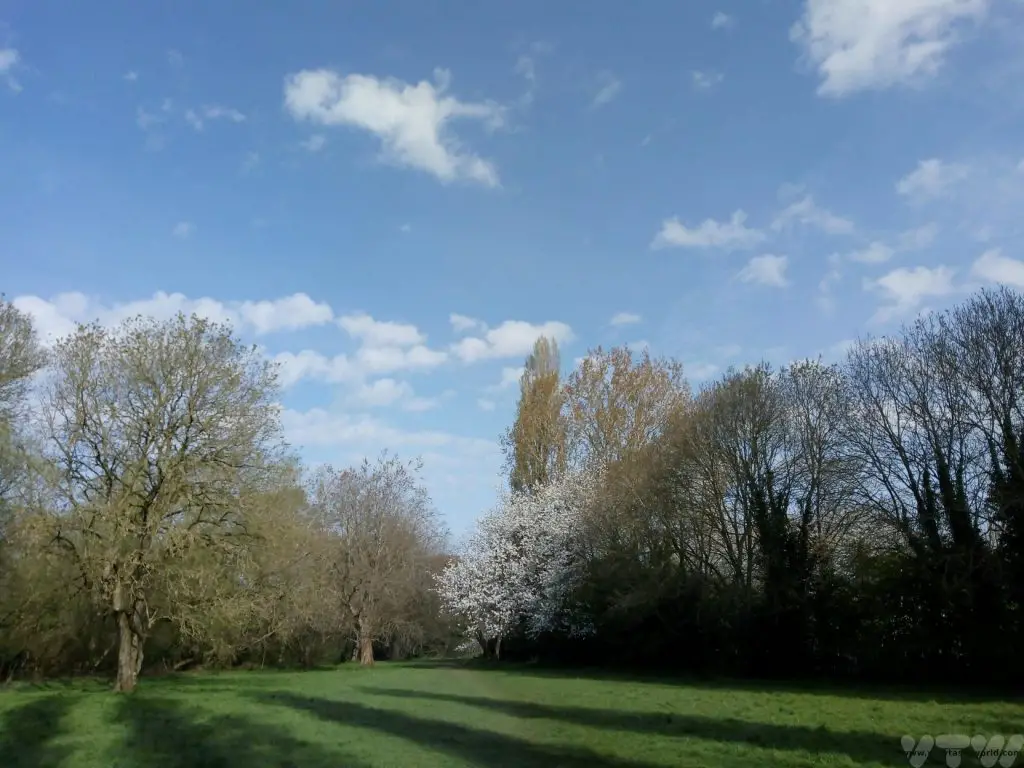
Charterhouse Fields – Opposite the cemetery on the London Road, the Charterhouse of St Anne is a Grade 1 listed building. It was founded in 1381 . It is surrounded by green fields which are located adjacent to the river Sherbourne after it has emerged from flowing under the city.
Coombe Abbey – a bit further out of the city on the way to Brinklow this is a former 12th century abbey that has been converted to a hotel set in around 500 acres of parkland.
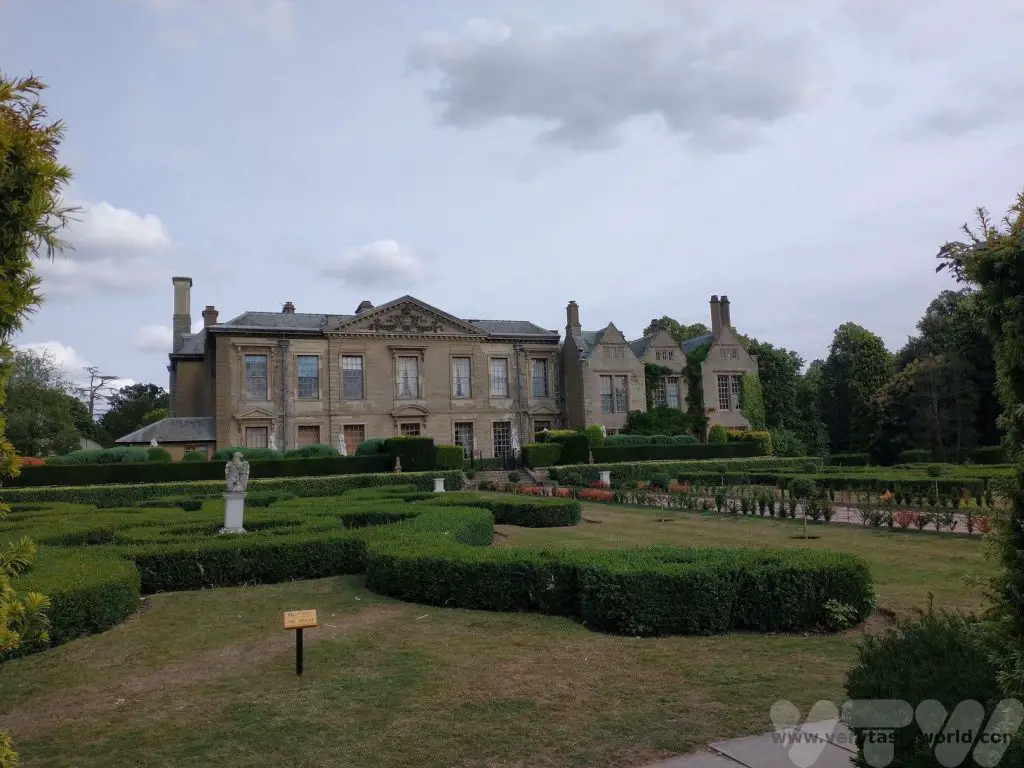
The park is lovely to walk around – with woods and a lakeside to explore and they have also recently opened up a Go Ape venue. The hotel itself offers popular afternoon teas and bawdy mediaeval banquets (the banquets are available for pre-booked groups only).
Shopping in Coventry
Coventry hosts all the major retailers that you would expect from a city. As foodies living in a multi-cultural city, we love that there are all sorts of supermarkets or mini-marts from Asia, Eastern Europe, the Caribbean and Africa. And we are pretty sure that you can buy anything at Coventry market. Located inside a circular building (it took us about 5 years to work out how to leave it at the exit we wanted and we still get a bit lost on occasion) there are stalls for fresh food at great prices and pretty much anything else you might want.
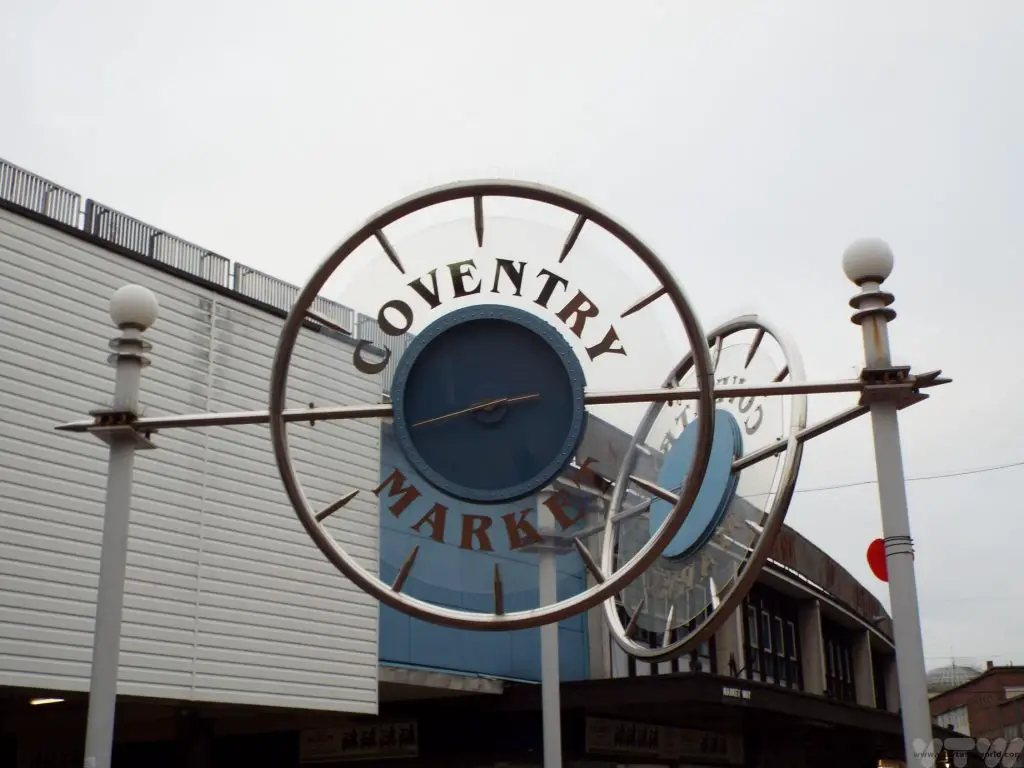
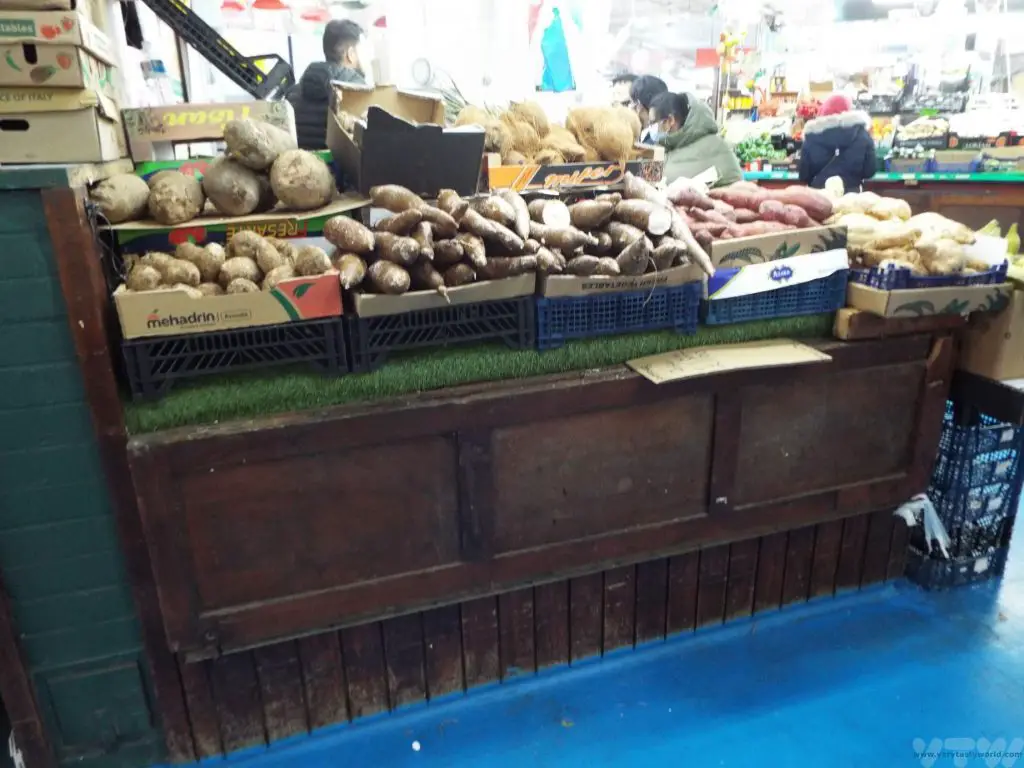
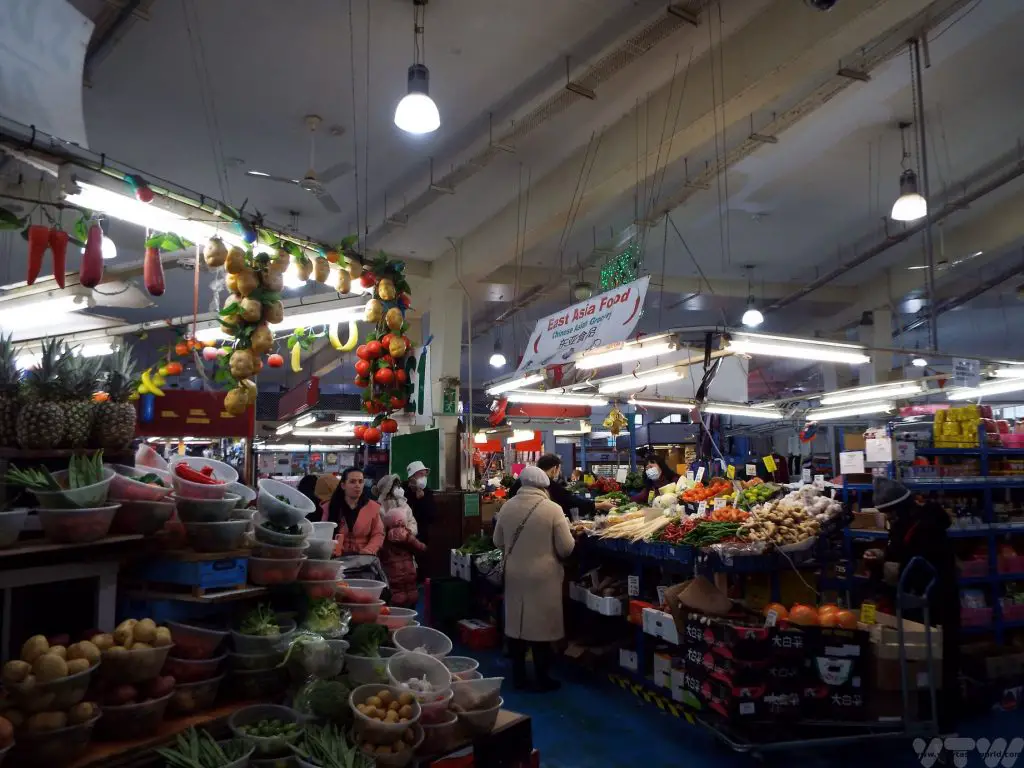
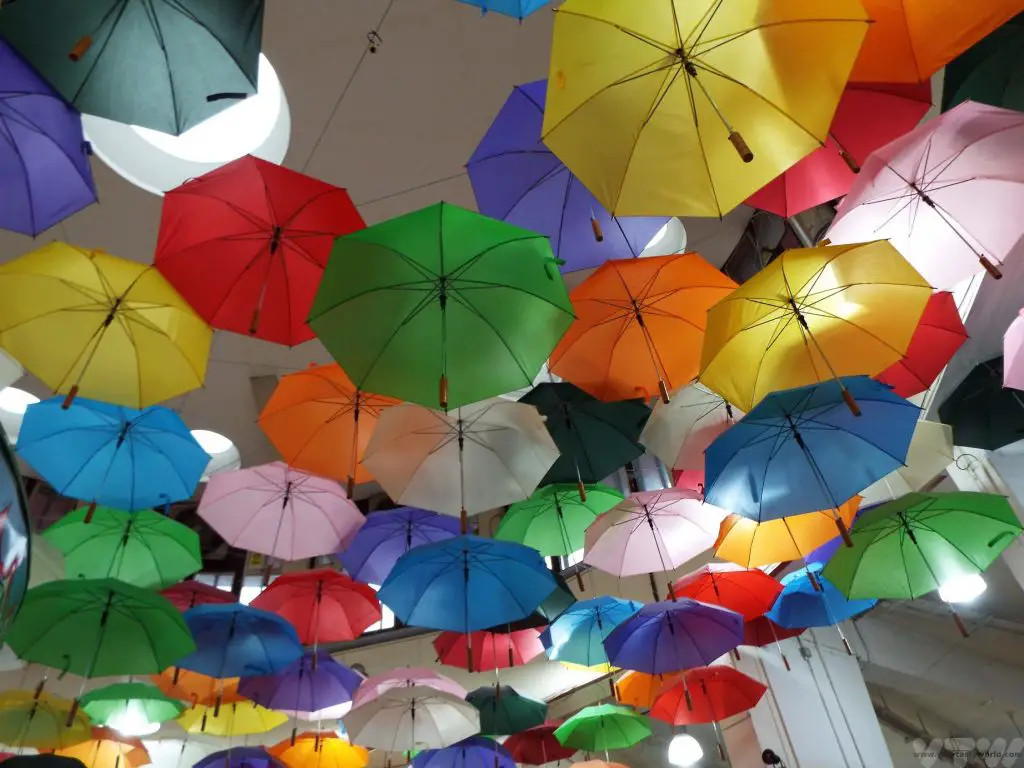
The Best – Or Worst – Road in the World?
Talking of circular things, Coventry’s ring road is one of the world’s smaller ring roads. Indeed it’s so tiny that you can circumnavigate the entire city in less than two minutes. Because the ring road is so teeny cars both enter and leave on the same section of junction, which is usually quite a short distance. This means that it’s something of a challenge for novices to drive on. In fact, we know several people who will drive several miles out of their way to avoid using it. (If you want to avoid it there is a Park and Ride service at War Memorial Park.) But it does work and is hugely convenient. There is a convention: Once on the ring road move to the outer lane unless you are planning to leave at the next exit. When planning to leave at the next junction, move across to the exit lane and exit. If you are about to exit and a car ahead of you is on the junction and planning to enter, slow down and let them enter. Conversely, if you are planning to exit and the car planning to enter is behind you, they should give way. And the same etiquette applies if you are joining the ring road. If you miss your junction you can just go round again – it won’t take long.
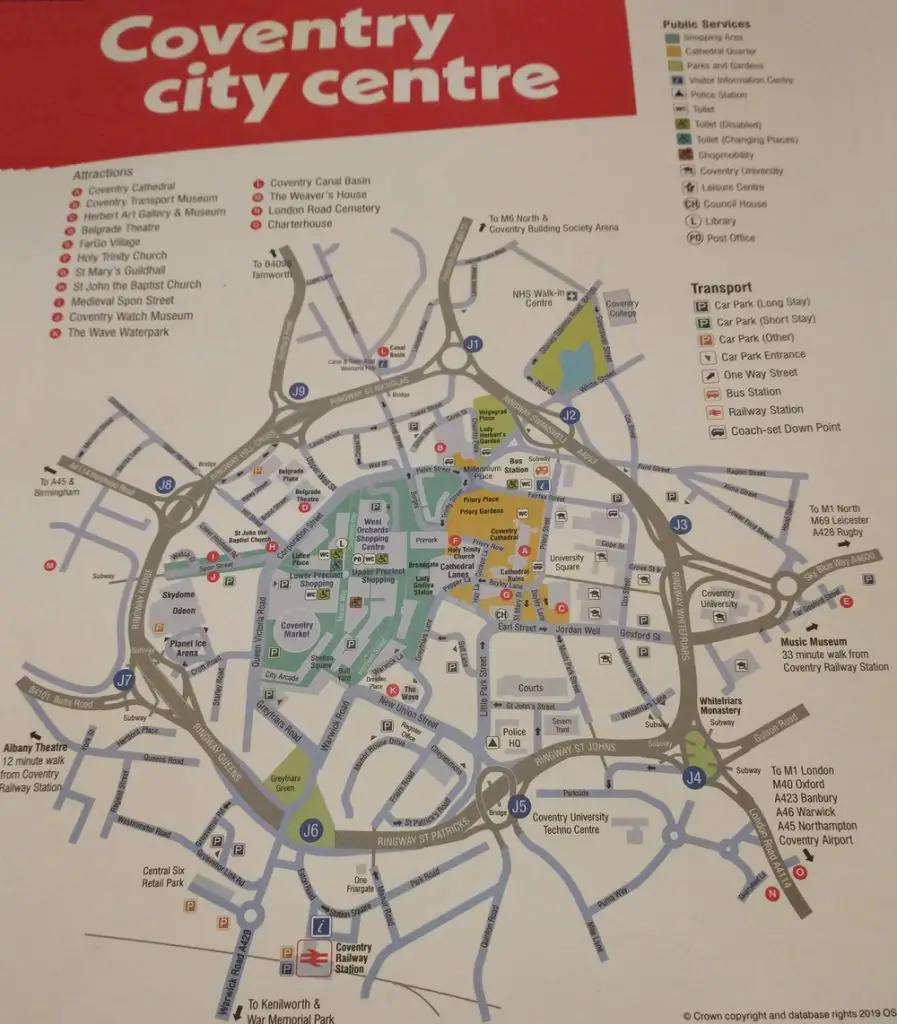

Japanese New Year Food and Traditions – New Year in Tokyo
Visiting in Tokyo in December is a great way of understanding Japanese New Year food and traditions, one of the country’s most important celebrations.
While Christmas Day is a normal working day in Japan (albeit one where it has become a custom to eat Kentucky Fried Chicken of all things – there’s a really interesting programme on the BBC World Service about this tradition), many businesses tend to close down for the new year period, usually from around the 28th December to the 4th January. Certainly most will be closed on the 1st to the 3rd January but some businesses may close for longer in order that proprietors and employees can spend time with their families. This means that if you are sightseeing, some ryokan may not be receiving guests and some museums and attractions will be closed.
We were in Japan around new year 2019-2020, our last trip before the world changed so dramatically.
See the Lights in Shibuya
Shibuya is a vibrant, bustling district in Tokyo which has loads of shops and restaurants. Its most famous features are found close to the station.
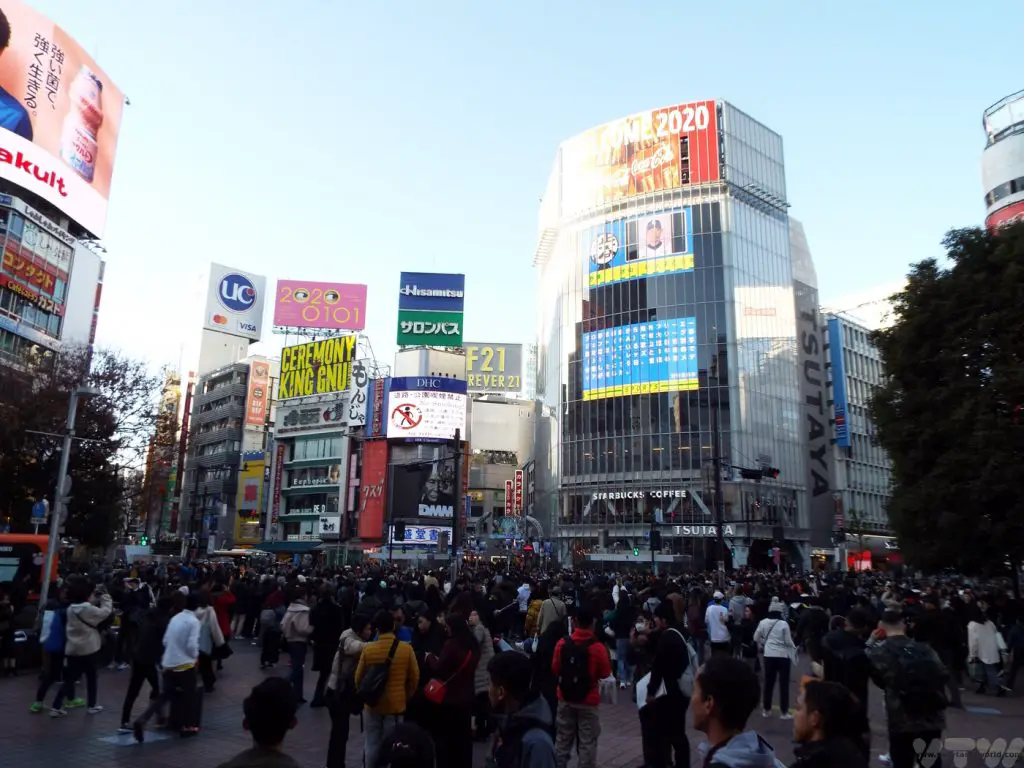
Its road crossing is possibly one of the best known in the world as it has featured in numerous films and adverts.
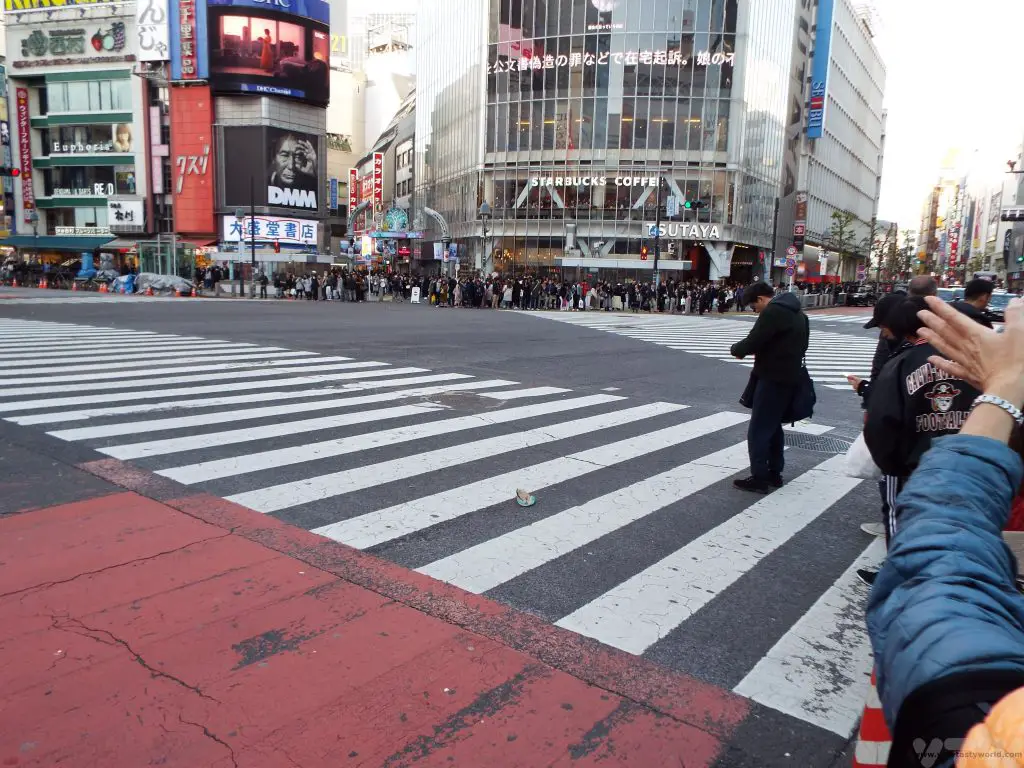
Apparently its nickname is ‘scramble’ because at its busiest time over 2,500 people can cross the road in the two minutes that the pedestrian lights allow.
As new year approaches, the crossing was the place to join the celebrations for those wanting a party. We visited in the afternoon as preparations were underway and also got to see some of the lights in the surrounding area.
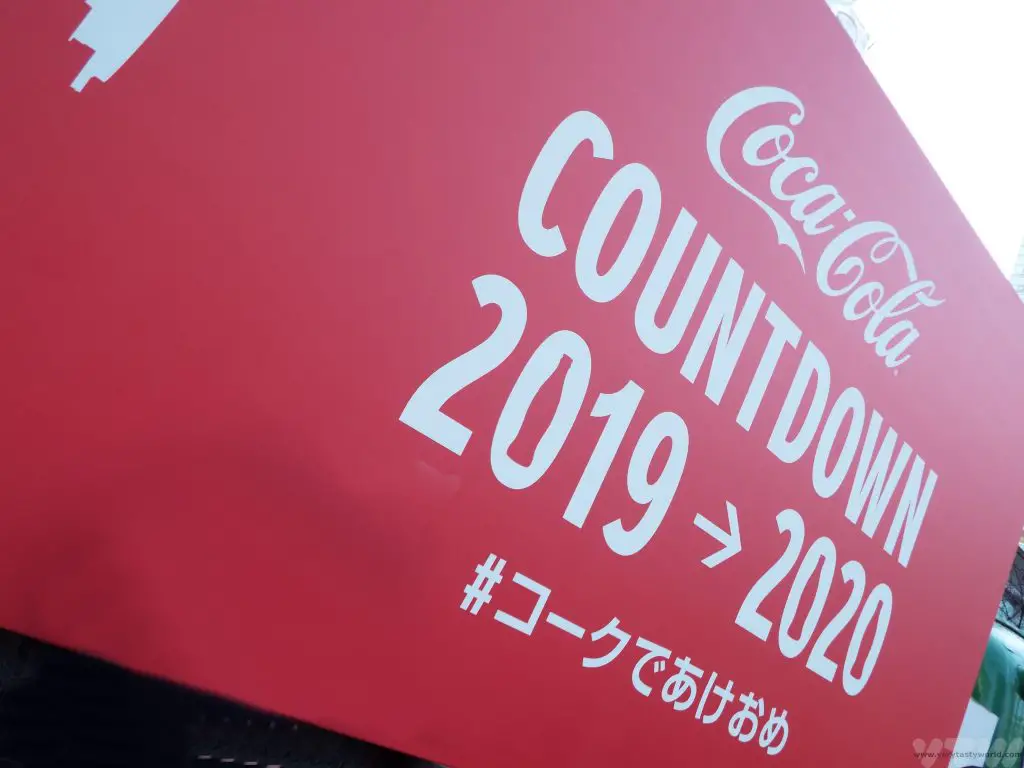
The statue of Hachiko is a famous Shibuya landmark. Hachiko was an Akito dog owned by a professor in the 1920s. The professor used to go to work and each day his dog would wait for him to return at the station in the evening. The professor died in 1925 but Hachiko would still wait for him every evening for a decade until his own death. It’s a very moving story of canine loyalty and a statue was erected to the dog outside the station in 1934. Of course, he is dressed for the occasion at this time of year.
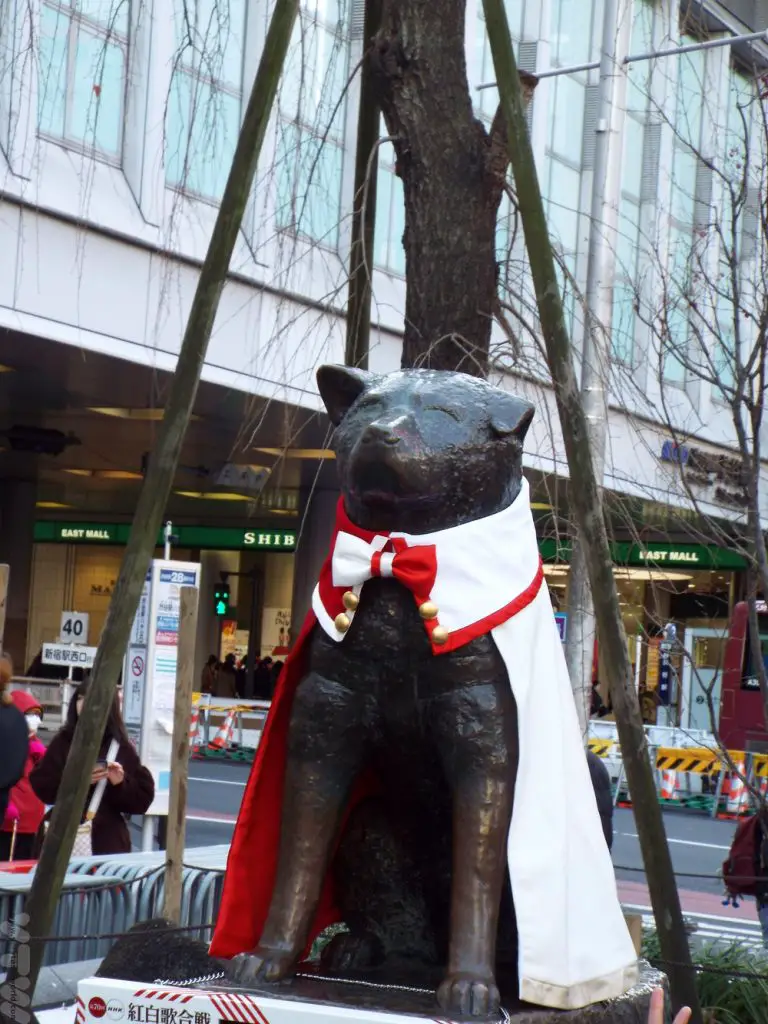
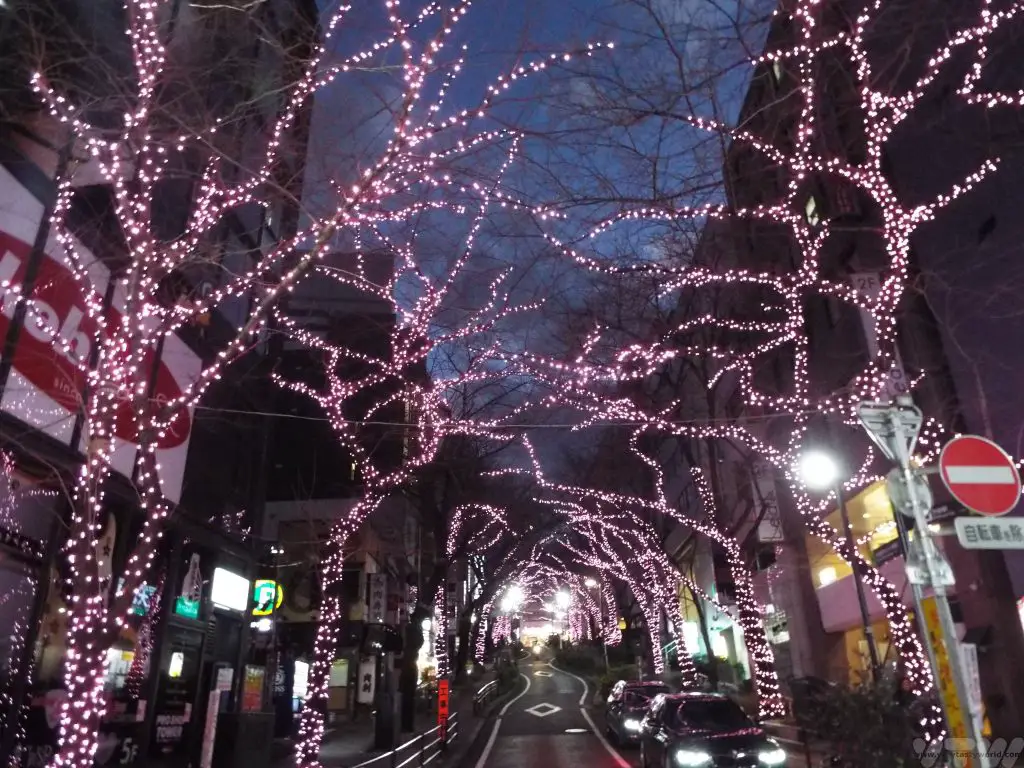
Japanese New Year Food –Noodles in Shinjuku
One of the traditional things to do on New Year’s Eve is to eat Toshikoshi Soba – year-end noodles. The principle is that long noodles equate to a long life, so they represent longevity and good luck. This is a popular tradition and soba shops are likely to be busy on New Year’s Eve. We had a wonderful meal with a dear friend at lunchtime at the food hall in Takashimaya Times Square, the vast department store just south of Shinjuku station, which has a variety of wonderful restaurants located on the top two floors. We chose the soba restaurant there. We had to queue for around 40 minutes which wasn’t a problem – it had such a nice atmosphere.
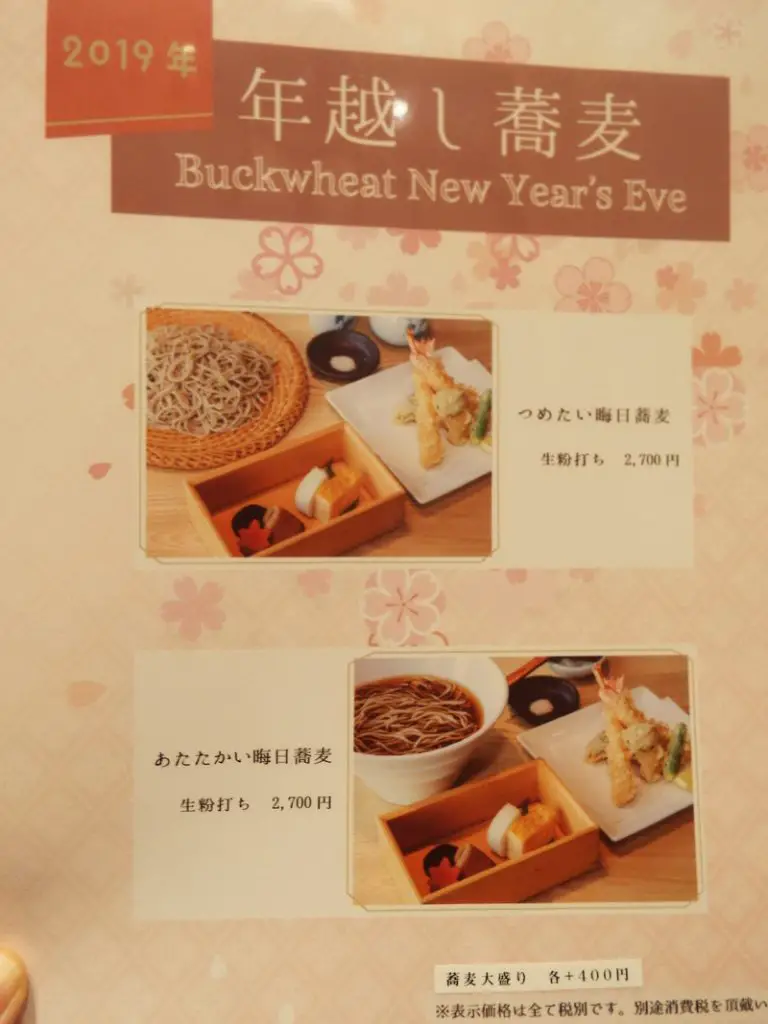
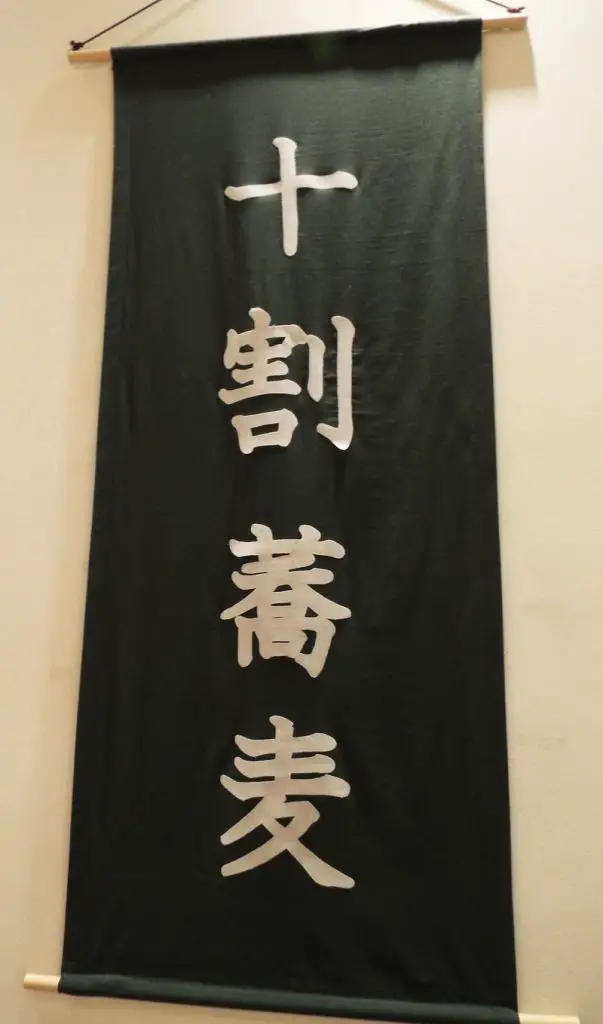
Once seated you are not rushed to finish your meal, even though there will be people waiting outside. If you want to dine on noodles in the evening your wait may be much longer – we saw very long queues in Shinjuku later that night.
We ordered the set menu which came with tempura and other treats. It wasn’t cheap but it wasn’t bank-breakingly expensive and the entire meal was simply divine.
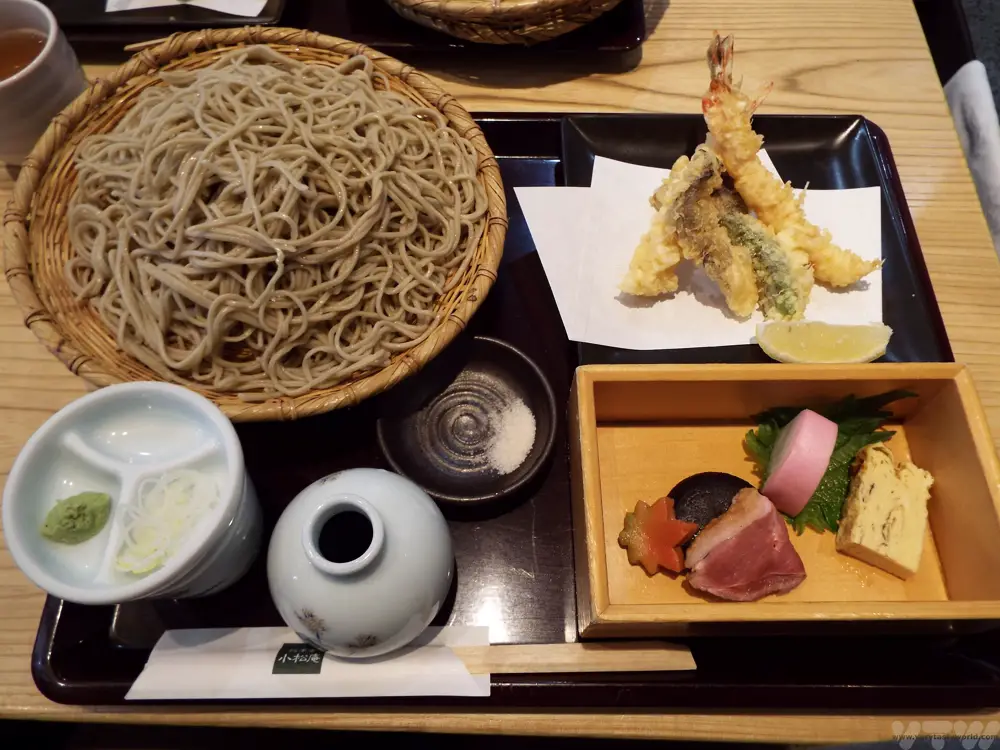
The noodles are presented on a traditional platter and appear to arrive in the most enormous mound but, on closer inspection, actually have been cleverly placed on a conical tray.
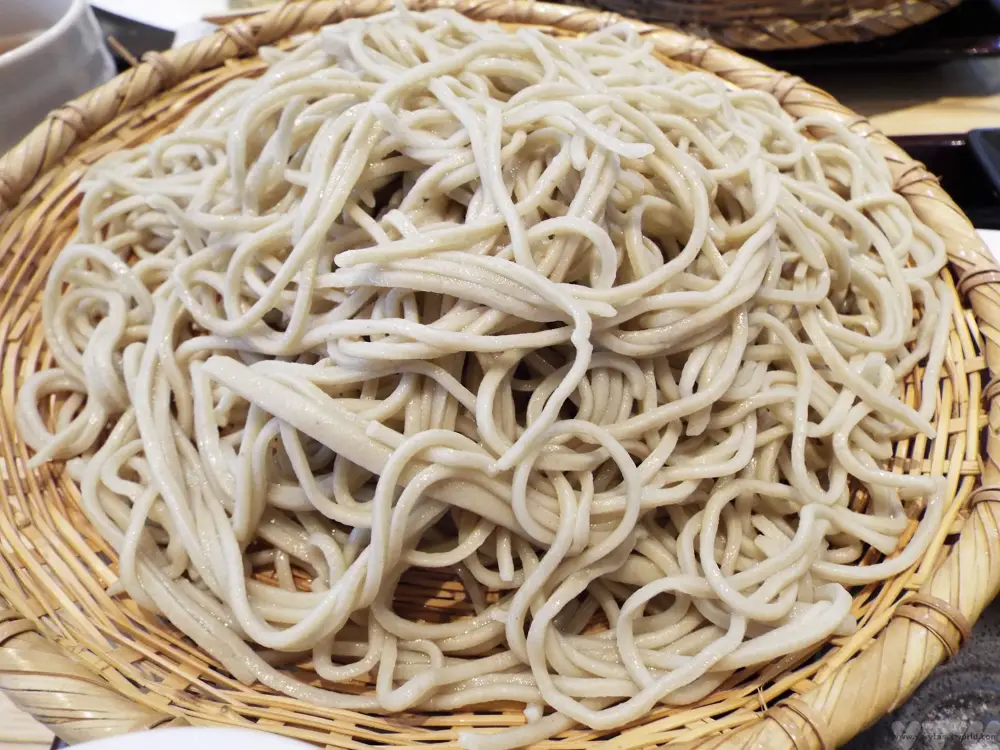
Soba are buckwheat noodles that can be served hot or cold – on a winter’s day, hot was definitely the best way to enjoy them.
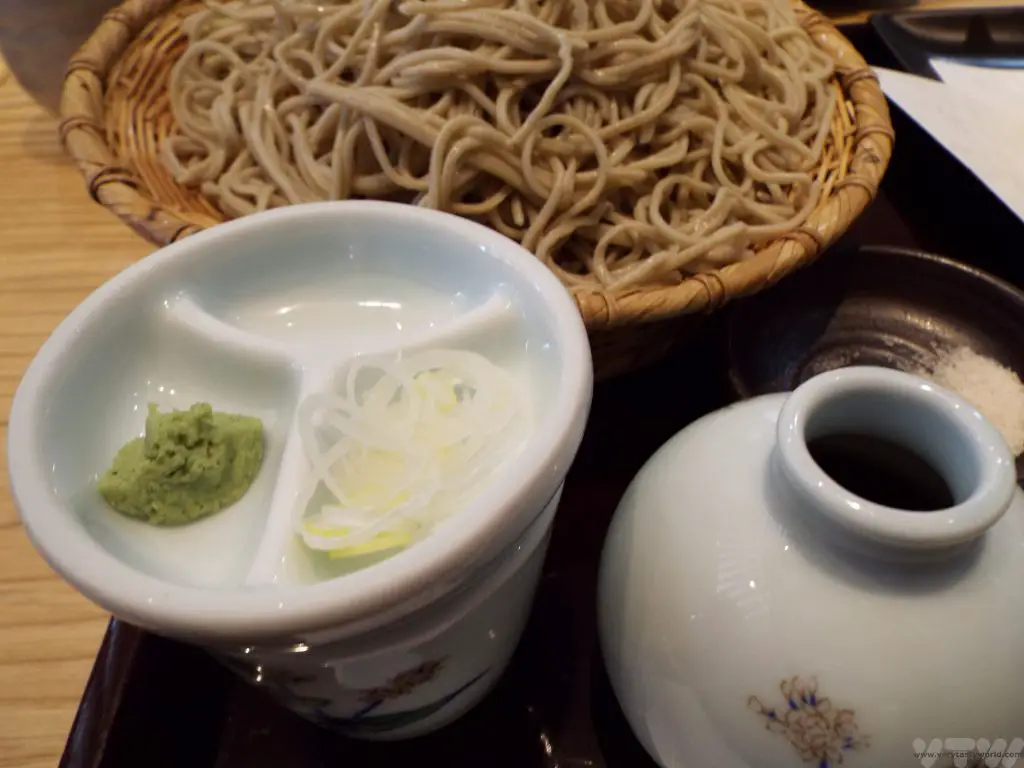
You are provided with a broth which you can season to your liking and then you dip the noodles in the broth. It is polite to slurp in Japan! (Which, when you’ve been brought up not to slurp your soup, is surprisingly difficult!)
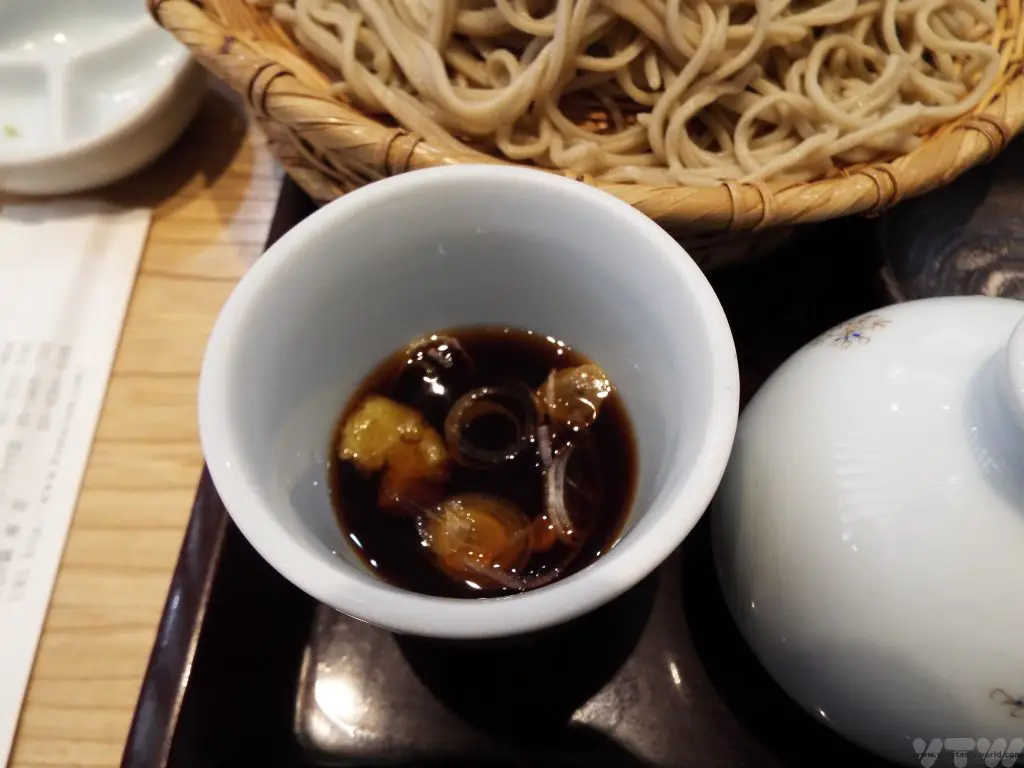
As we were finishing the restaurant staff came around with a small teapot filled with a hot, white opaque broth. This was sobayu, the water that that the noodles had been boiled in. We mixed it with our leftover sauce, added any further condiments and drank it – it’s a very satisfying way to finish off the meal.
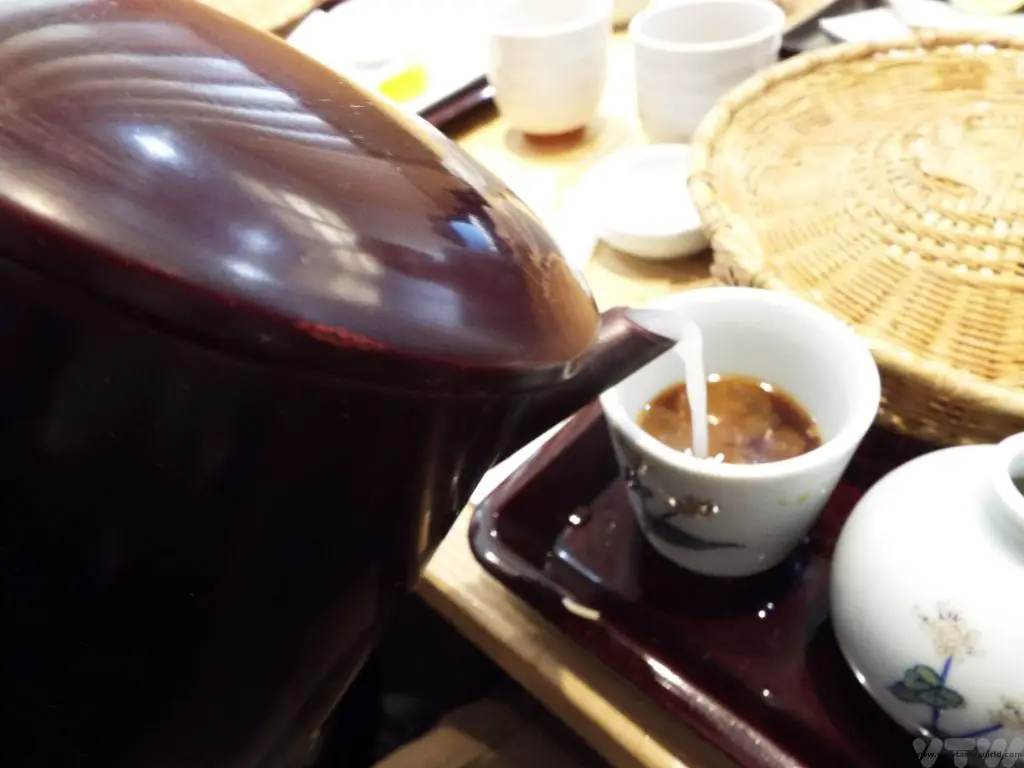
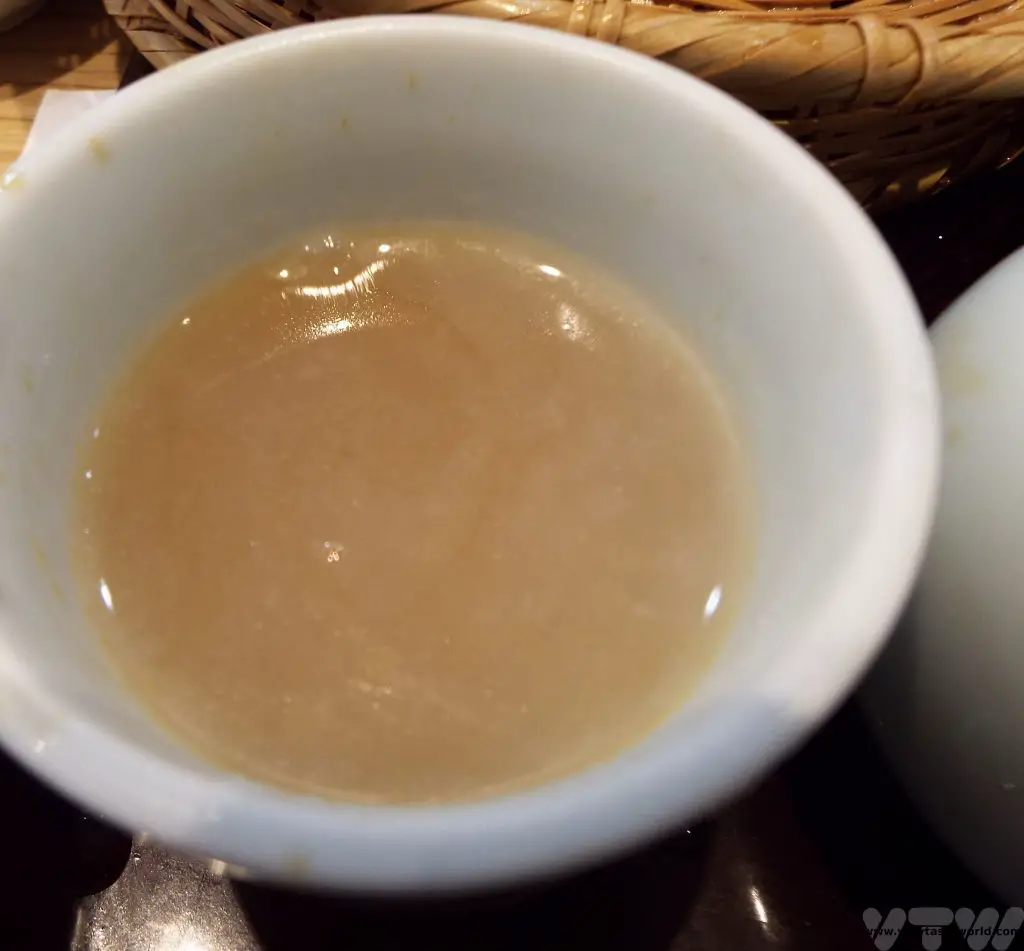
Back To The Hotel to Watch TV
New year is a family time and one particular Japanese new year tradition is that people stay home to see the new year in together. Kōhaku Uta Gassen is the NHK (the national broadcaster) TV channel’s new year show which has been running since the 1950s. It is a national custom to watch Kōhaku on New Year’s Eve. The format of the show is that popular singers, musicians and bands are invited to join and each are assigned to one of two teams – red and white. They each perform throughout the evening and the audience and judges decide which team was the best. Quite often western performers will take part as well. At the end of the show, just before midnight, everyone sings Hotaru no Hikari, a song similar to Auld Lang Syne. We spent some time in the early evening at our business hotel to catch some of the songs before heading out to see in the new year.
Seeing in the New Year
There are several choices depending on how you are feeling. Shibuya was the place to go for a party atmosphere. The famous road crossing was usually filled with people waiting to see the new year in and the atmosphere guaranteed to be lively. However, in recent years, the event in Shibuya has been cancelled (even post-Covid), so check the local news if you are planning on going out. Other locations include Tokyo Tower, which has a countdown to the New Year, and Tokyo Disney and Disney Sea has traditionally had fireworks displays on New Year’s Eve. There will also be celebratory parties and countdown events in hotels and izakaya across the city.
We chose to visit the Meiji Jingū. It’s one of Japan’s most important shrines, a Shinto shrine, just a couple of stops from Shinjuku, where we were staying. Meiji Jingū is a lovely place to visit at any time. It is set in a large, forested park which is very pleasant to wander through and is a completely serene contrast to the hustle and bustle of neon urban Tokyo. There are several JR stops that you can use to reach the shrine. We disembarked at Harajuku, the district where the cool kids hang out, and followed the crowds heading towards the shrine. We arrived at around 11:30 pm and were by no means the first people there. It’s a pleasant stroll from the beautiful wooden Torii at the entrance.
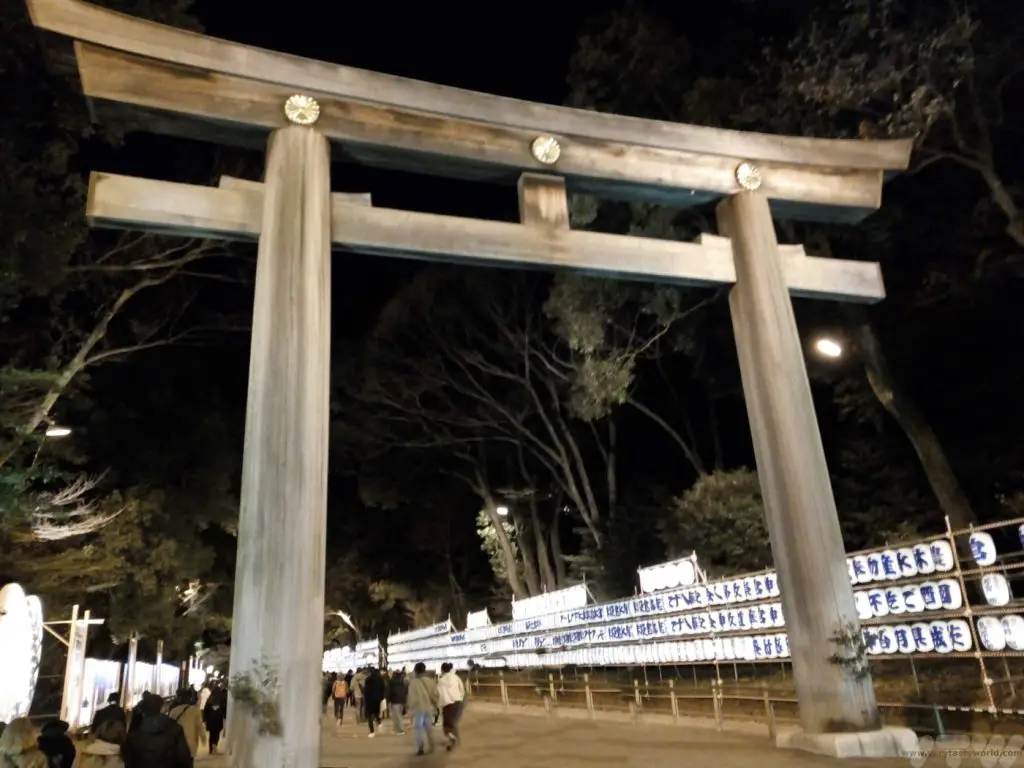
You need to bear in mind that it’s a one-way system as you walk through. You will see traditional lanterns and rows of sake barrels along the way.
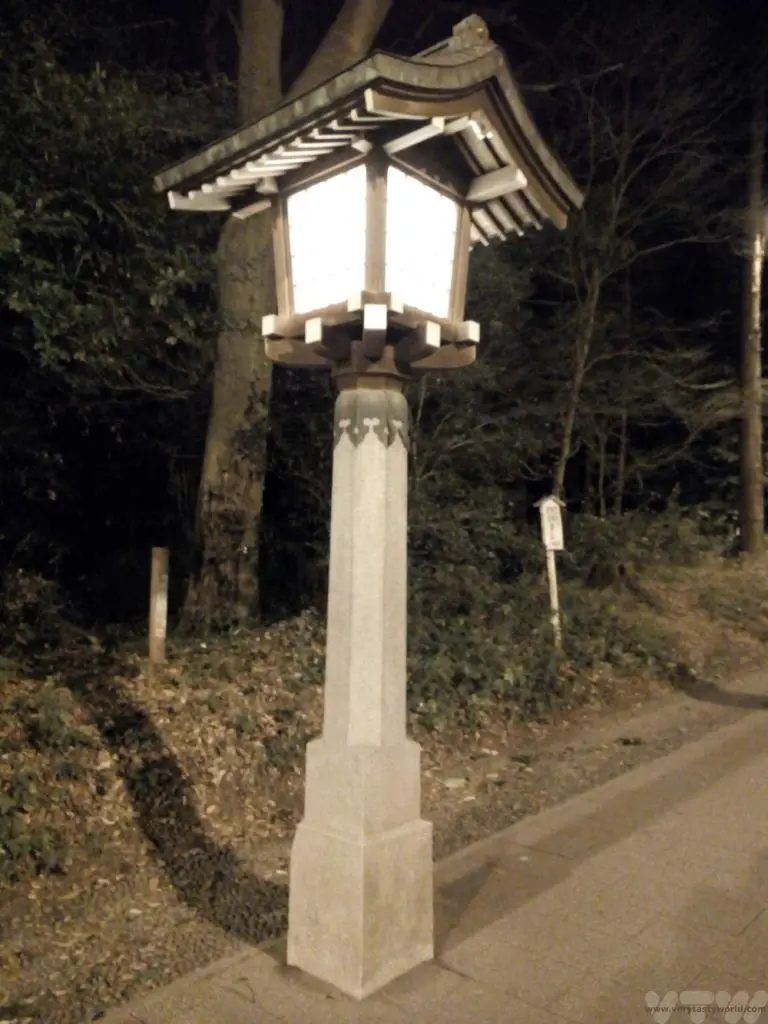
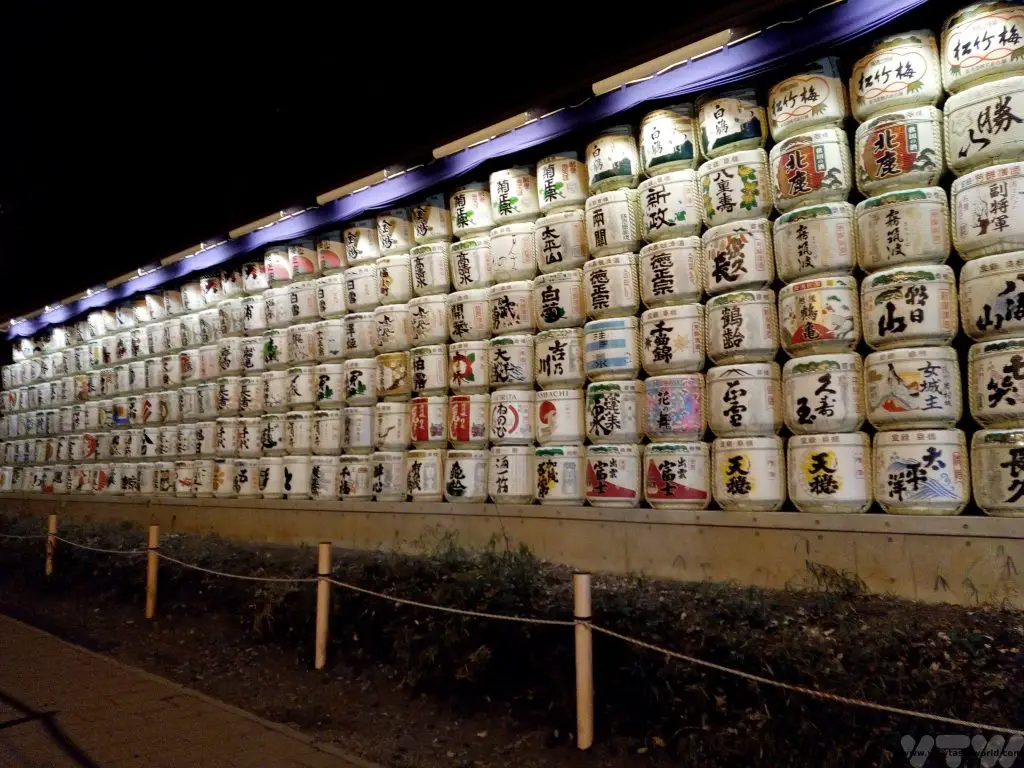
Then we stopped at the barrier which had TV screens showing pictures of the crowd as it assembled and the shrine itself. We weren’t too far from the front but were still some way from the shrine. Even though the area was very crowded, everything was typically well-organised and there was a quiet buzz of excitement.
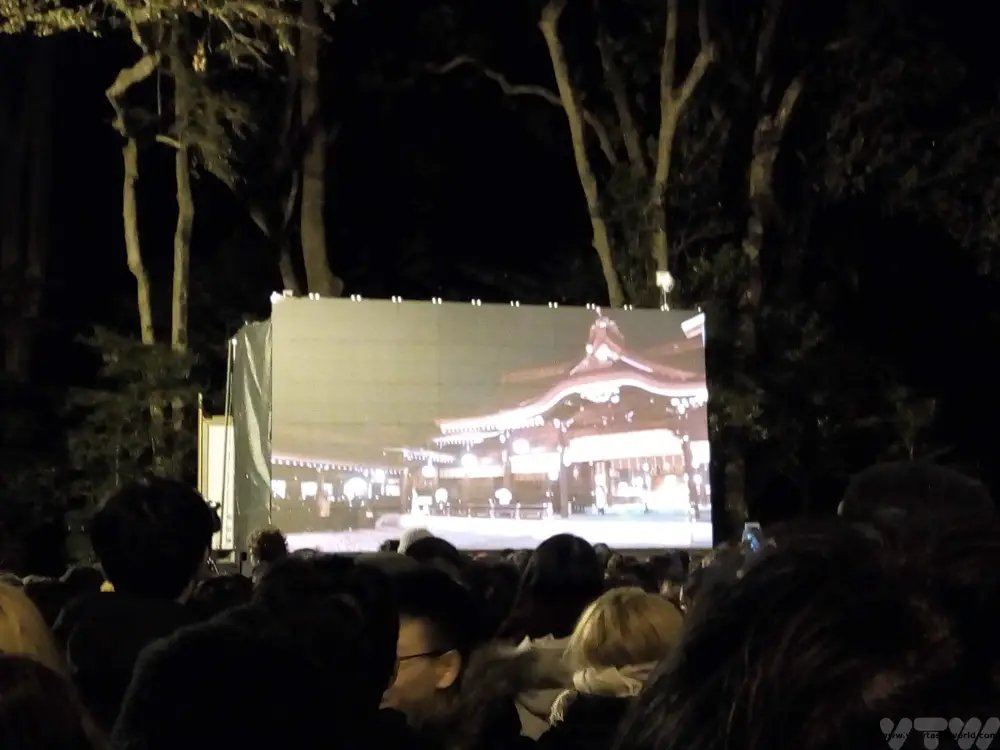
As the new year dawned 108 bells rang out. This is actually a Buddhist (Japan’s other main religion) custom, the number represents 108 temptations and the bell ringing is to reject 108 worldly desires. The bell is actually rung 107 times on the last day of the old year and just once after midnight. The bell rings aren’t uniform in length – some of the bells are rung in quicker succession than others.
We were reasonably close to the front at the Meiji shrine but it still took us around 45 minutes to reach the Naien, the inner area, which contains the shrine buildings. Marshalls were present wielding signs in both Japanese and English and beckoned visitors either to approach, or to ‘wait a short while, please’ before coming forward. This means that smaller groups of visitors were able to visit the shrine and offer prayers without it becoming over-crowded. It was an excellent system, especially as everyone co-operated beautifully.
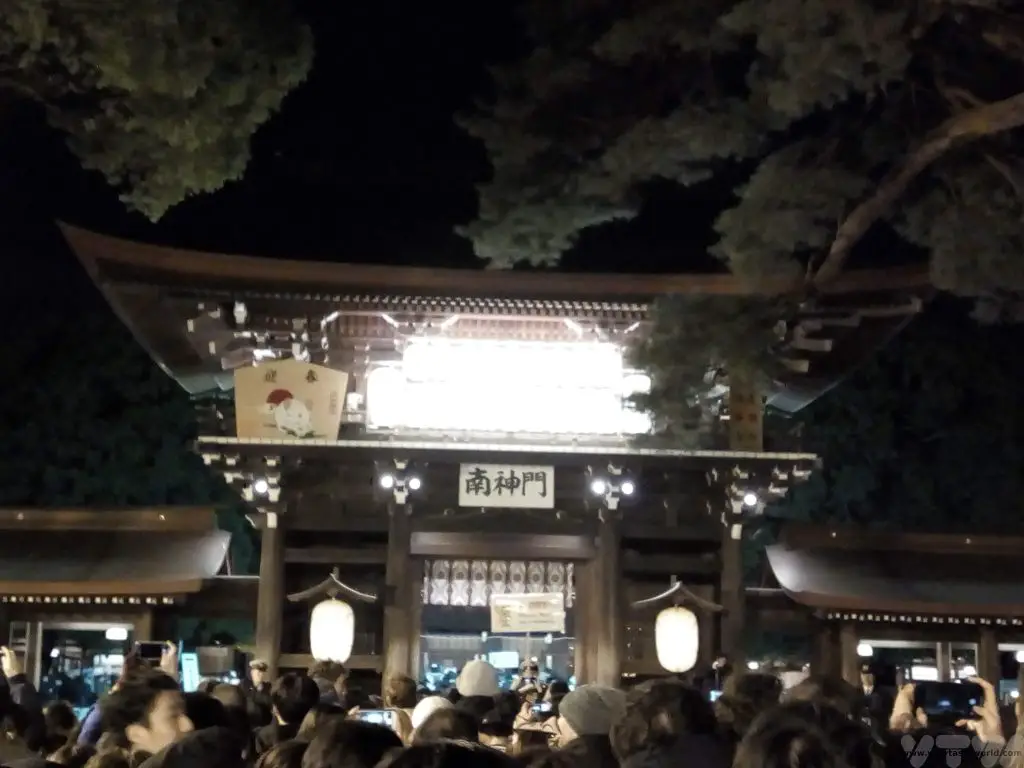
When it was our turn, it wasn’t really possible to undertake the full Hatsumōde but we threw our coins, bowed, clapped and made our wishes and prayers for the new year. The Meiji shrine is the most famous shrine to visit and apparently attracts over three million visitors in the first three days of each year. A lot of people don’t quite make it to the very front of the queue.
Outside the main temple area there are stalls with refreshments and it’s possible to hang out and enjoy the atmosphere. We then walked back to Yoyogi station, where we knew the platforms were likely to be less crowded than Harajuku, and we hopped onto a very full, but joyous, train on the Yamanote line, just one stop back to Shinjuku. As we arrived back at our hotel, a barrel of sake had been opened in the lobby and we were invited to partake of a cup. We greeted the hotel staff, ‘Akemashita, omedetou gozaimasu!’ – meaning: the new year has dawned, congratulations!
Hatsumōde – Visiting a Temple
Another Japanese new year tradition is visiting a temple within the first three days of the year. Although we had been amongst the first to undertake Hatsumōde at the Meiji shrine the night before, we met up with our friend in Kichijoji. (Also, because we were out at the shrine to see in the new year, we hadn’t found out whether the red or the white team had won Kōhaku, so she was able to update us with this important information.)
Hatsumōde is considered to be a very important part of welcoming the new year and there will be queues at temples. We met quite early and had to queue for around 30 minutes. It was all very organised and the atmosphere lively.
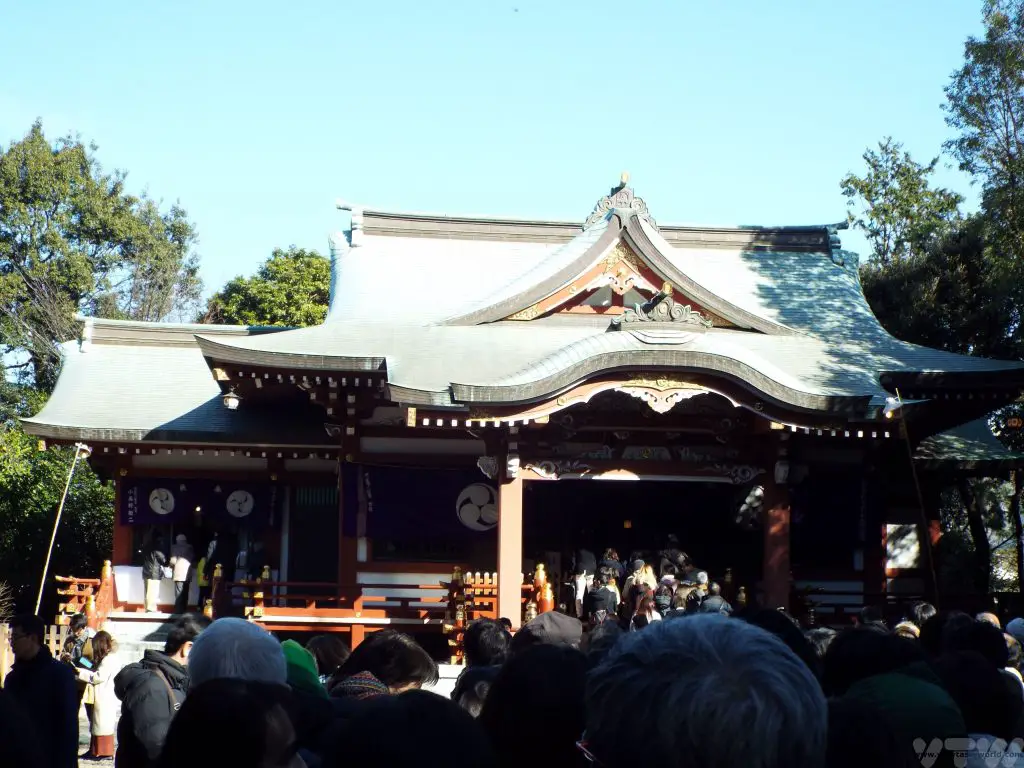
There is a certain ritual that one undertakes when visiting a Shinto shrine. It is absolutely fine for anyone from any religion, or none, to visit a shrine and make an offering. First of all, it is important to purify oneself before entering the shrine. This is called ‘temizu’.
Approach the chozuya, which is a small pavilion which contains a purification font filled with water. There are multiple ladles laid next to the basin. Holding the ladle in your right hand, pour water over your left. Change hands and repeat. Change hands and then pour a little water into your left hand and take it into your mouth. You aren’t supposed to swallow the water but to spit it delicately into the drain.
Then walk up to the shrine itself and make an offering by throwing a coin. The monetary value isn’t important but 5 yen and 50 yen coins are considered to be lucky. Go-en (5 yen) sounds like ‘goen’ which means ‘good luck’ in Japanese.
Then you should bow deeply, from the waist, twice, then clap your hands twice, to show reverence to the kami-sama (the god; kami can also be interpreted as a spirit). Keep your hands together for a silent prayer.
We were delighted to be invited to our friend’s family home to enjoy osechi-ryōri, traditional new year foods.
Japanese New Year Food
New year is a time for feasting and there are some dishes that are particularly associated with celebrations. Osechi-ryōri comprises lots of little dishes beautifully presented. Much of the food is prepared in advance so that the whole family can eat together rather than spending loads of time in the kitchen.
The quintessential Japanese new year food is mochi. These are rice balls made by pounding steamed sticky rice with a big mallet in a large wooden container to achieve a stretchy and slightly sticky consistency. This is then formed into little rice dumplings. They have an unusual texture – very soft and delightfully squidgy. New year mochi is called kagami mochi and comprises two mochi balls one set on top of the other, with a tangerine on top.
Mochi may be flavoured and/or filled with all sorts of ingredients. Matcha green tea, milk flavouring and azuki bean paste are popular fillings. Sometimes the mochi will have a sesame coating.
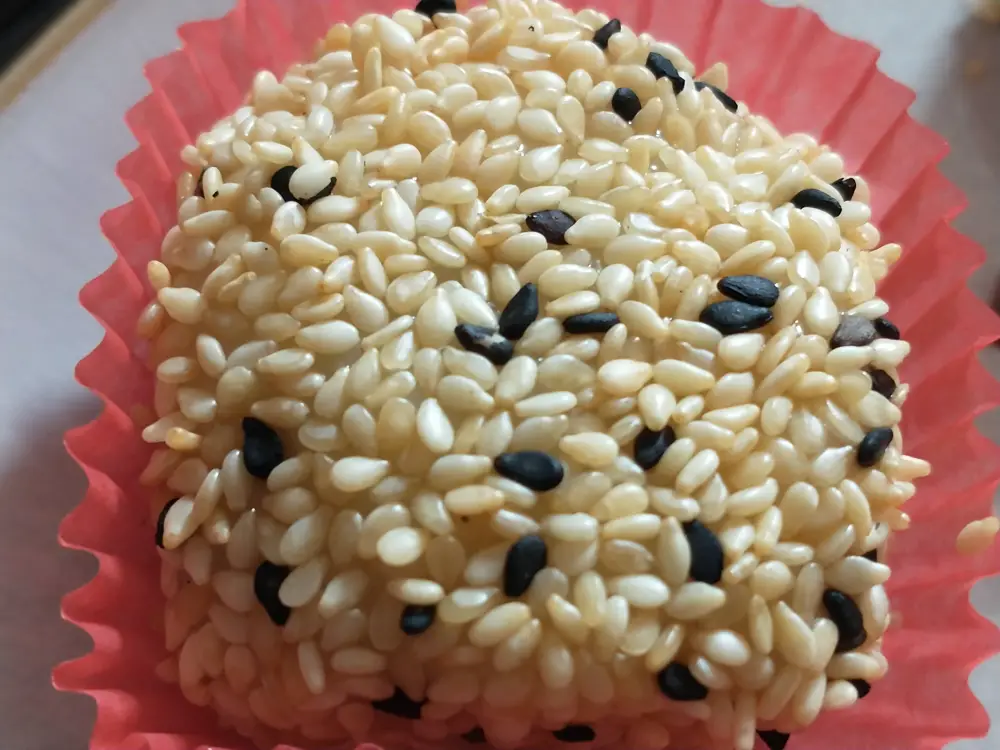
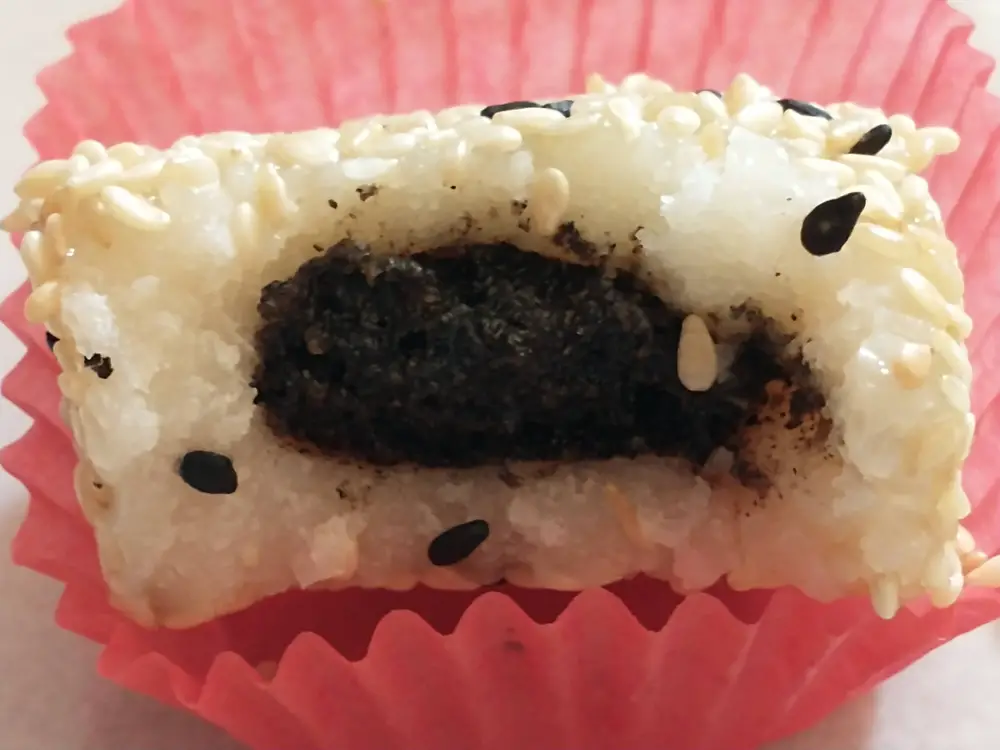
Matcha mochi with azuki bean filling is delicious:
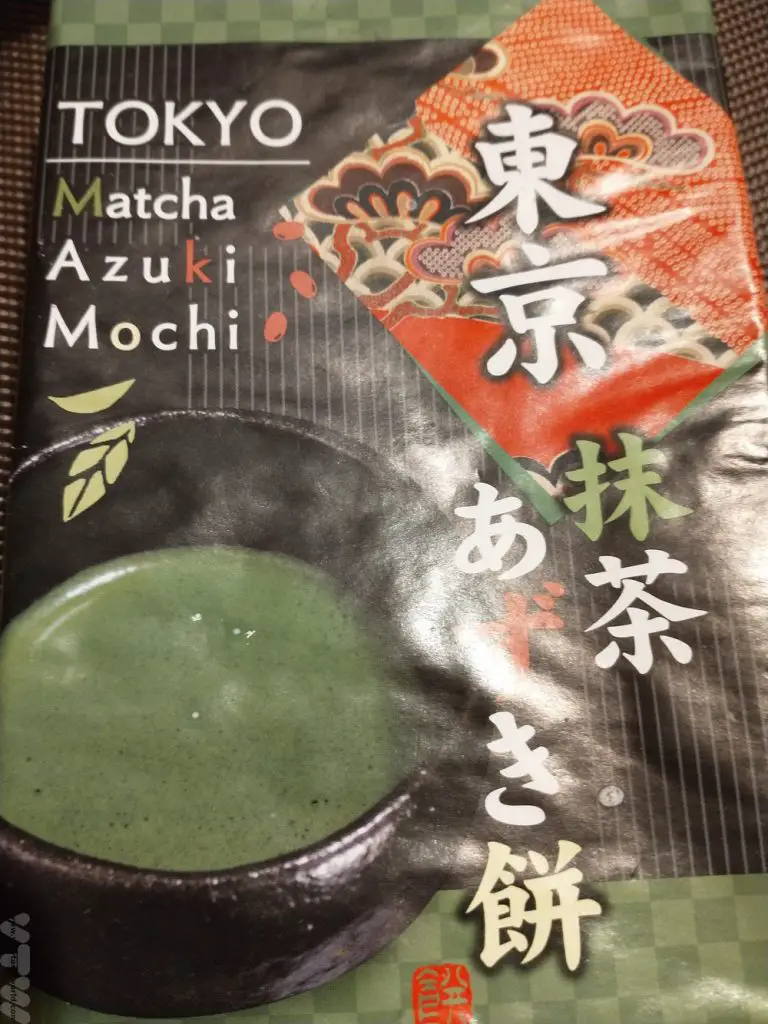
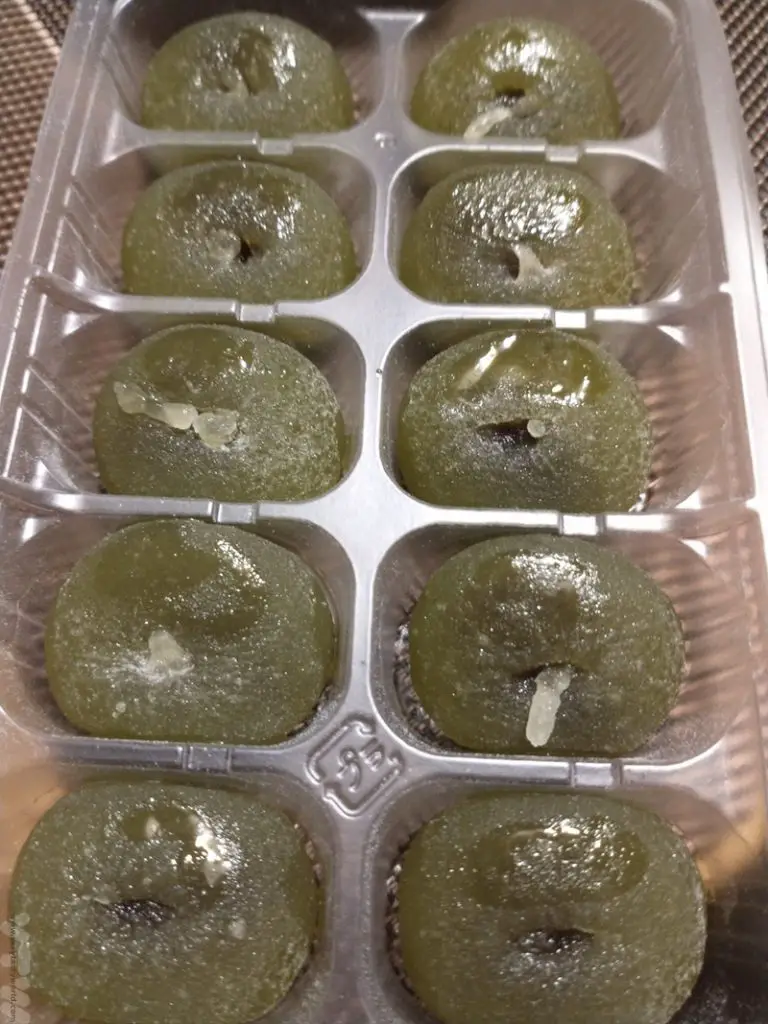
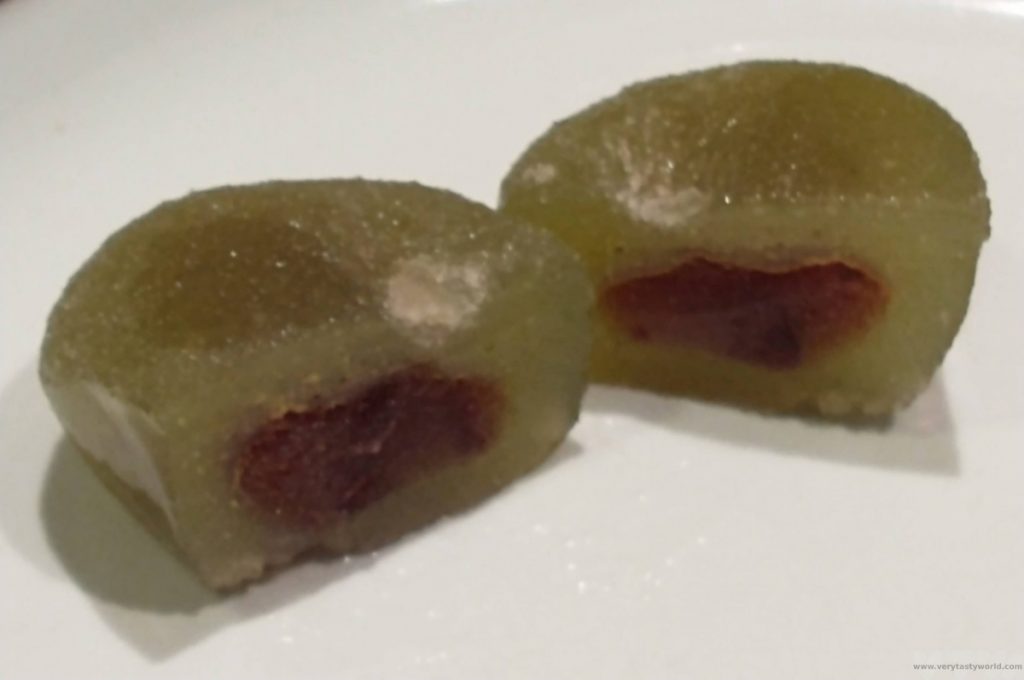
Kazunoko is a popular new year dish. It is marinated seasoned herring roe. The roe is yellow in colour and comprises hundreds of eggs all bound together. The texture is surprisingly crunchy and the flavour slightly salty. It is usually marinated overnight in ingredients such as dashi (Japanese stock), soy sauce and sake. We were lucky to enjoy home-made kazunoko marinated in sake lees and it was delicious. The multiple eggs in the roe are symbolic of a large family. The kuzunoko can be served on its own or with other delicious ingredients, in this case, with prawns and a scallop on top of cucumber.
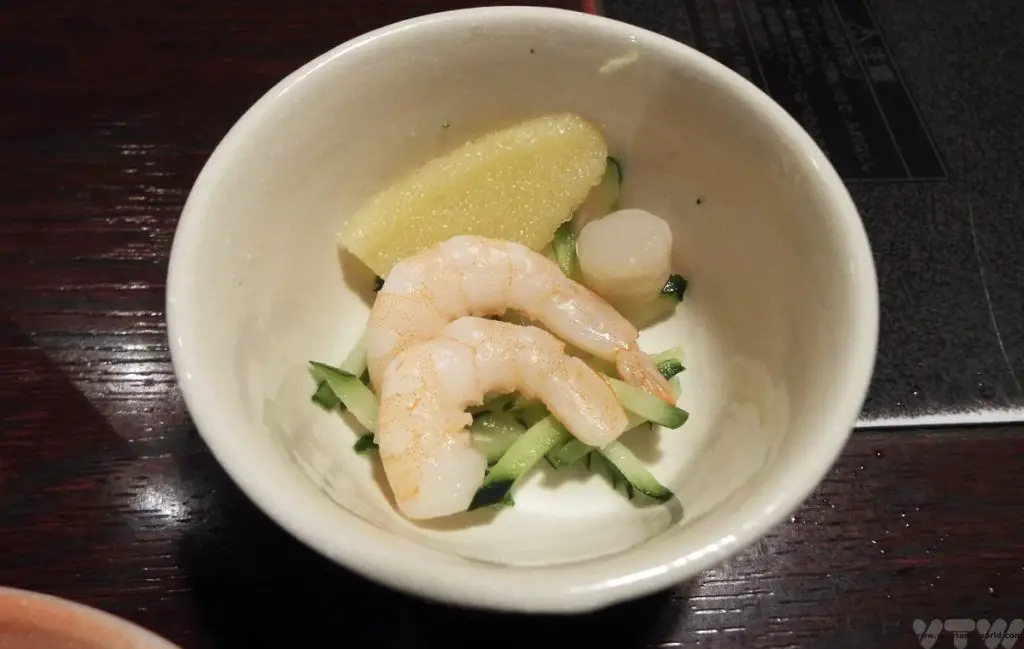
Kobumaki is a piece of kelp seaweed. It will have been simmered for a while to soften and is one of the Japanese new year food traditions is to present it in the shape of a bow. An alternative serving is a roll of kombu tied with a strip of dried daikon (a white radish); this is called hoshi daikon. Further variations include wrapping the kombu around a piece of meat or fish. The word ‘kombu’ also means ‘joy’ in celebration of a joyous day.
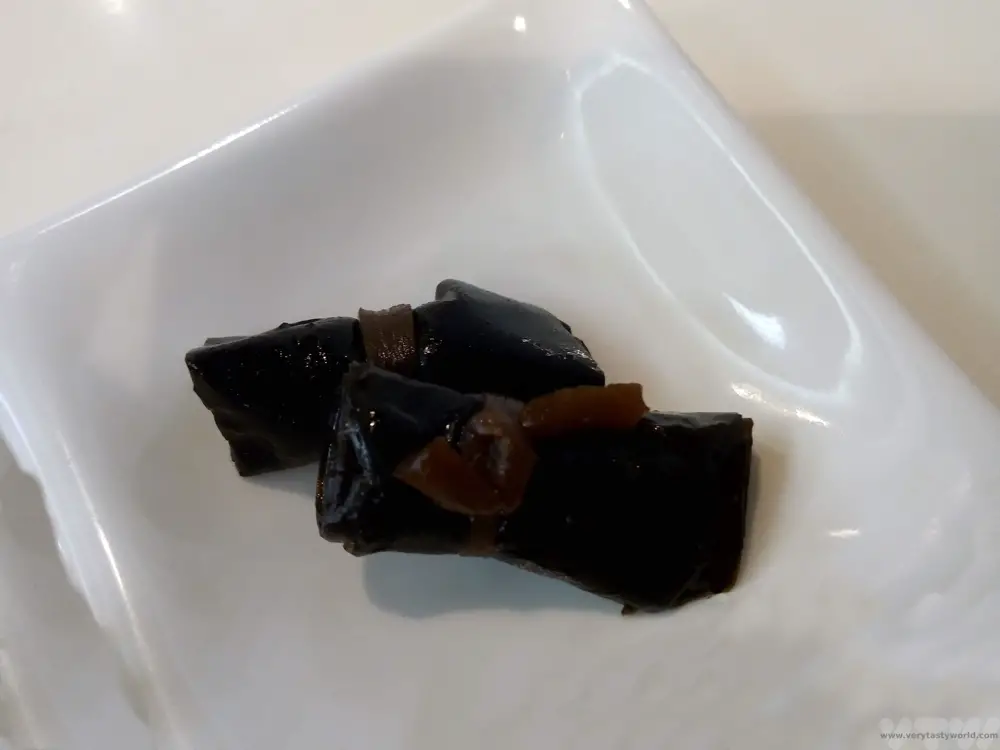
Sushi is not usually part of osechi-ryōri but it is a celebratory food and is often eaten on special occasions. It would be unusual for Japanese families to make their own sushi – they would leave it to the experts and buy some in.
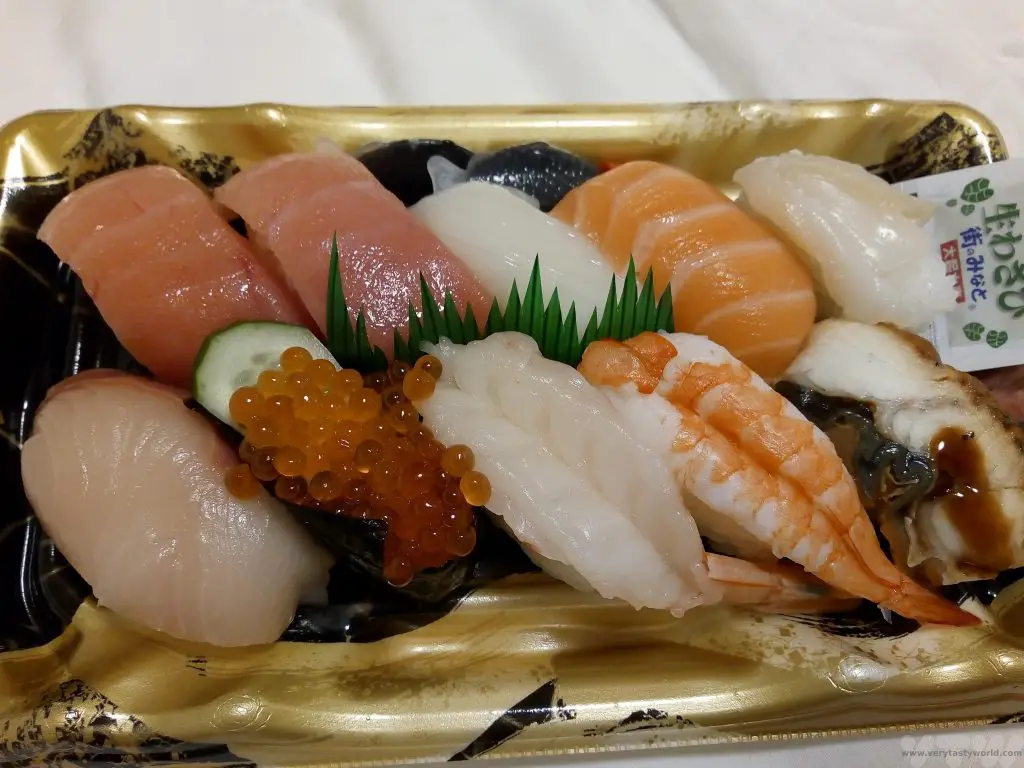
Retail Therapy
Another Japanese new year tradition is Fukubukuro. When the shops reopen many will offer lucky bags – sealed bags or boxes – containing random merchandise. The value of the goods inside are greater than the price you would normally pay and sometimes you may – by sheer luck – end up with some very cool products. We met up with a dear friend in Nakano Broadway the following day and found a Lucky Box stall. At just 300 Yen we didn’t have high expectations but it was fun seeing what was in the box.
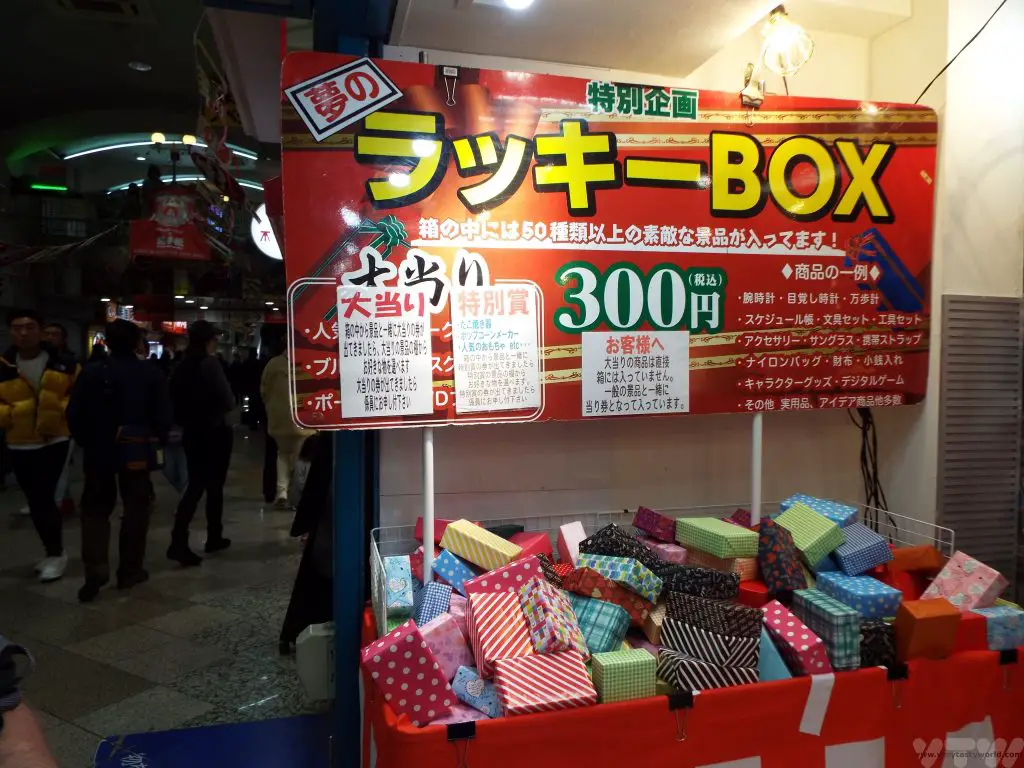
Related Posts You May Enjoy

- Recipe: Simmered Shiitake Mushrooms

- How to Use Public Transport in Japan

- RECIPE Oyakodon Donburi

- Planning a Trip to Japan

- The Makanai: Cooking for the Maiko House

- Setsubun Food – Bean Throwing Day

- The Gassho Farmhouses of Rural Japan

- Recipe: Japanese Simmered Pork Belly – Buta no Kakuni

- RECIPE: How to Make Umeboshi

The Lalibela Ethiopia Churches
Hewn From the Living Rock
When planning our visit to Ethiopia it was Lalibela’s rock churches that were top of the ‘must-see’ list. Lalibela is located in northern Ethiopia and you can fly direct from Addis Ababa, although we had spent some time exploring Gondar and the wonderful Simien mountains beforehand, so flew in from Gondar.
The town is named after the late-12th and early-13th century King Gebre Mesqel Lalibela of the Zagwe Dynasty, who was highly revered and was reputed to have commissioned the construction of the churches, but it is more likely that they were built over several centuries. Although the devout claim that holy angels played a part as well.
The churches, which were designated a UNESCO world heritage site in 1978, date from the 7th to the 13th centuries. They are remarkable because rather than being constructed from the ground up, they have been hewn from within the rock, using basic tools such as chisels and hammers, and were built from the top down and then carved from within. There are three main groups: northern, eastern and western. It will take more than a day to explore them thoroughly so make sure you factor in enough time.
You need to purchase a ticket at the main office – this is valid for five days. It’s not cheap but is definitely worth the price. You need to make sure that you keep your ticket as you may need to produce it when you enter each church. It’s generally okay to take photos (keep an eye out for signs indicating if photography is prohibited) but if you are taking photos of someone (and we found that many of the priests encouraged us to do so) it is polite to tip them.
We also recommend getting a guide as they will be able to tell you the history of each of the churches as well as point out some of the more interesting features. The churches are open from 8am-5.30pm, but are closed for two hours at lunchtime, around midday.
These are very much living churches, highly revered by Ethiopian Orthodox Christians, and a place for pilgrims to visit. We were welcome to join the services.
We explored each cluster of churches in turn. The churches within each group are linked by subterranean passages.
The Northern Group Of The Lalibela Ethiopia Churches
Biete Medhane Alem, believed to be the largest monolithic church in the world, at approx 33 metres long, 23 metres wide, and 10 metres deep, is home to the Lalibela Cross. It has five aisles and its name means ‘Saviour of the World’.
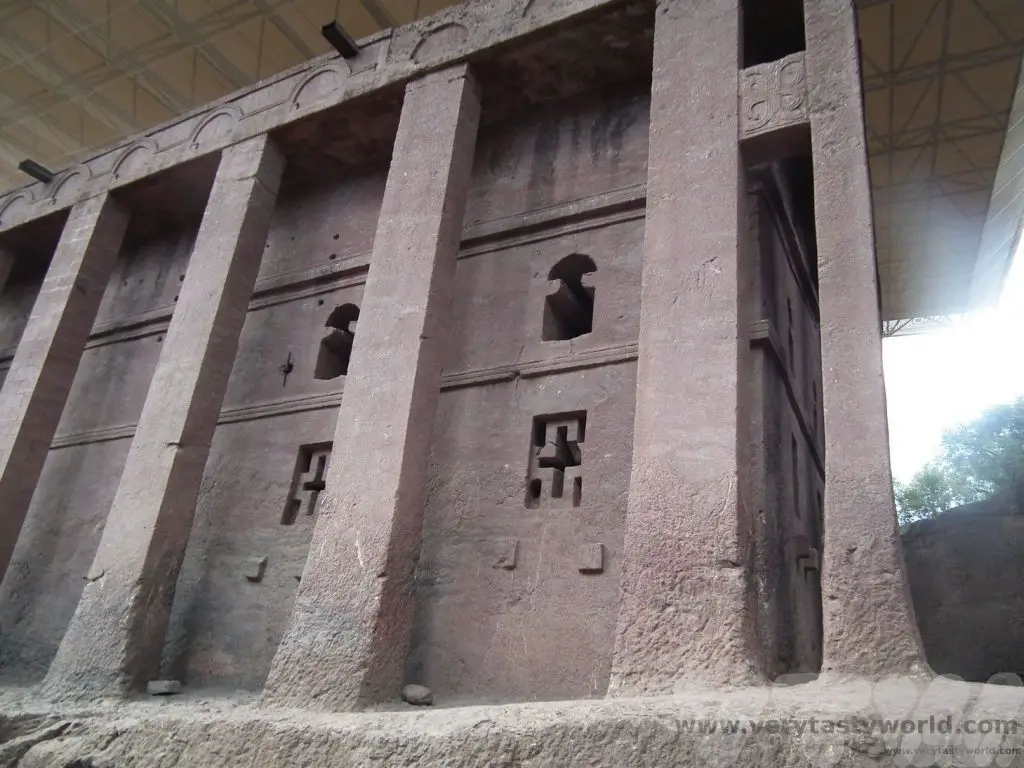
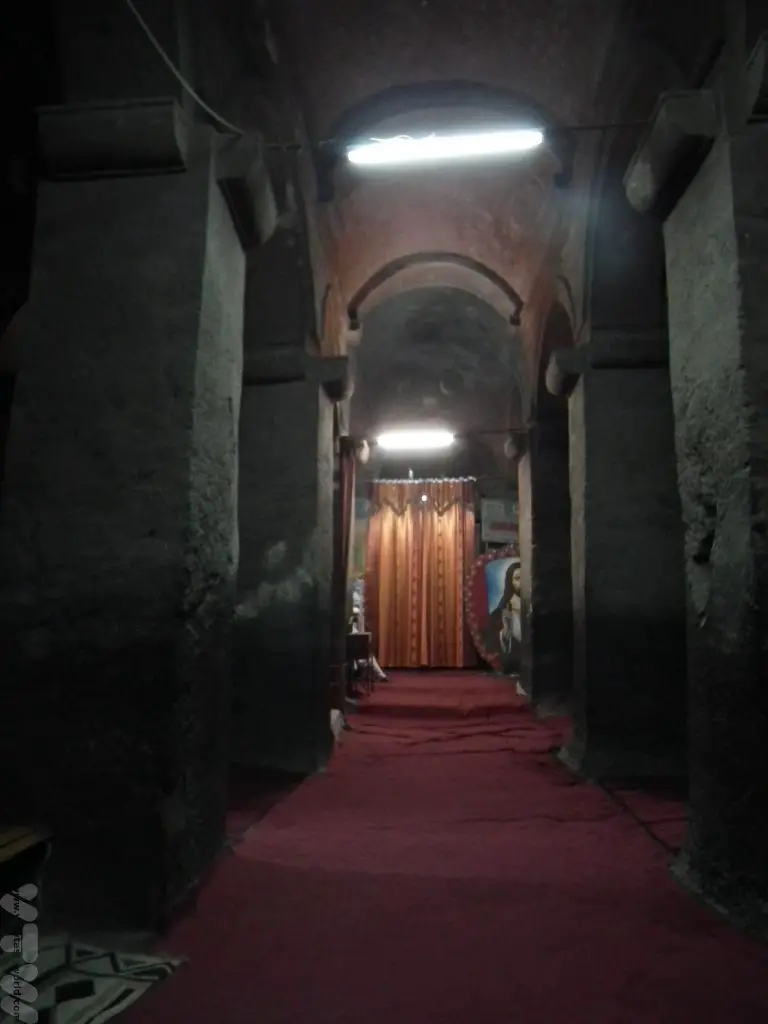
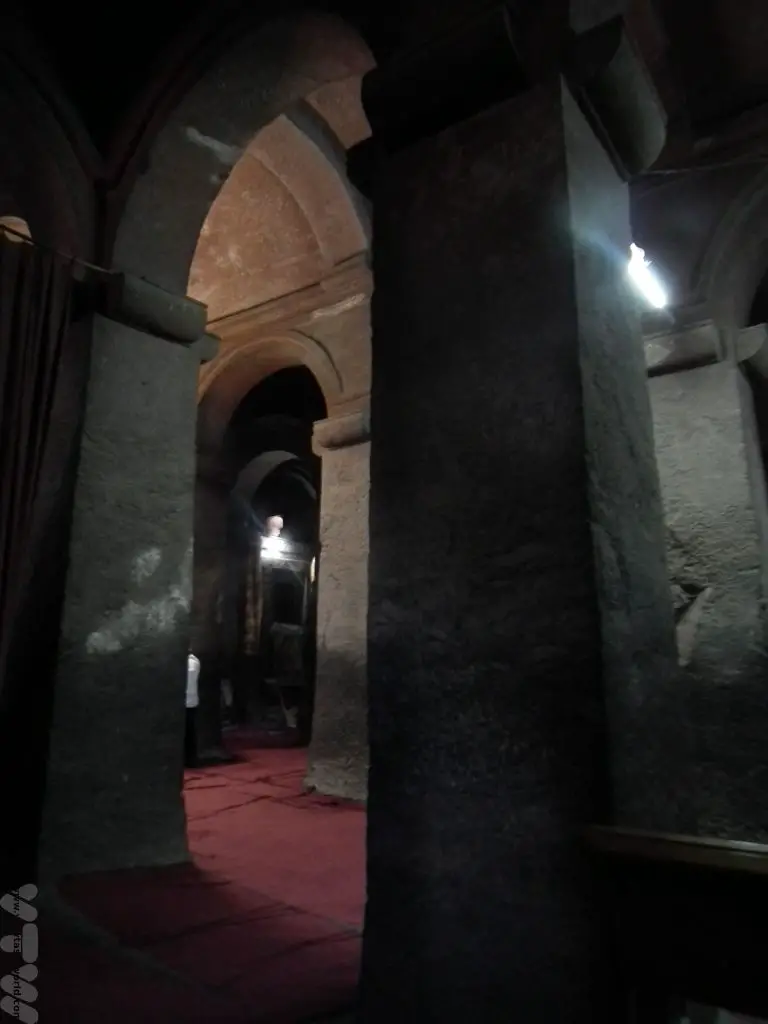
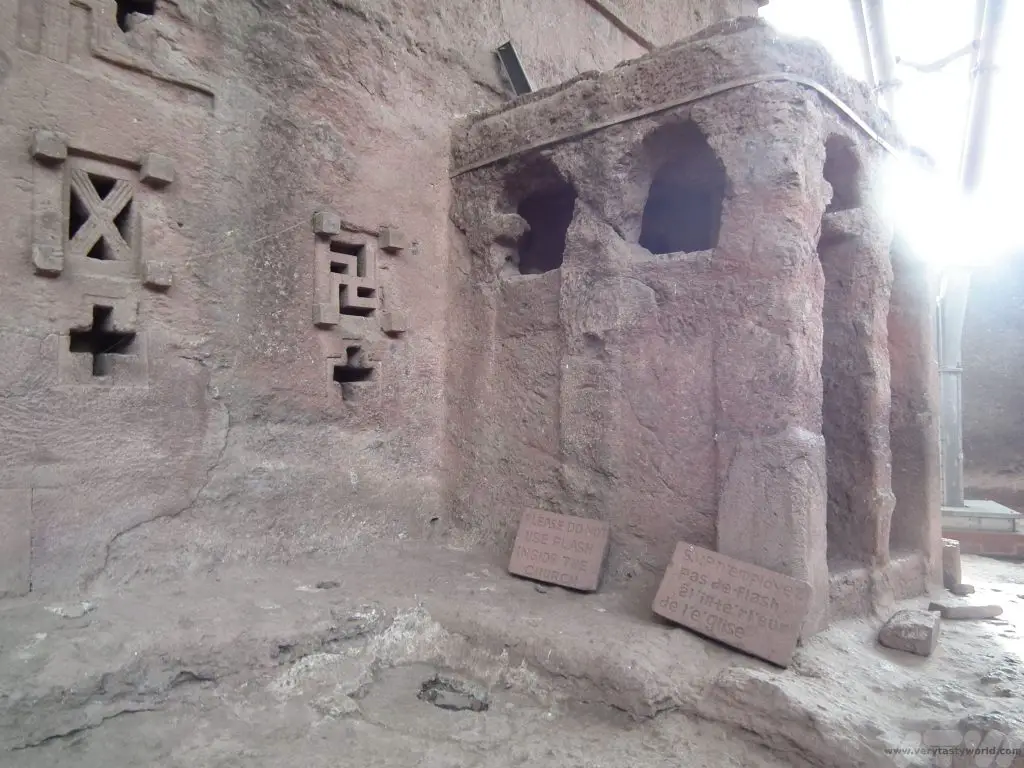
Biete Maryam may be the oldest of the churches, named for Mary.
It has an incredibly deep pool outside which is believed to grant fertility to any woman who bathes in it.
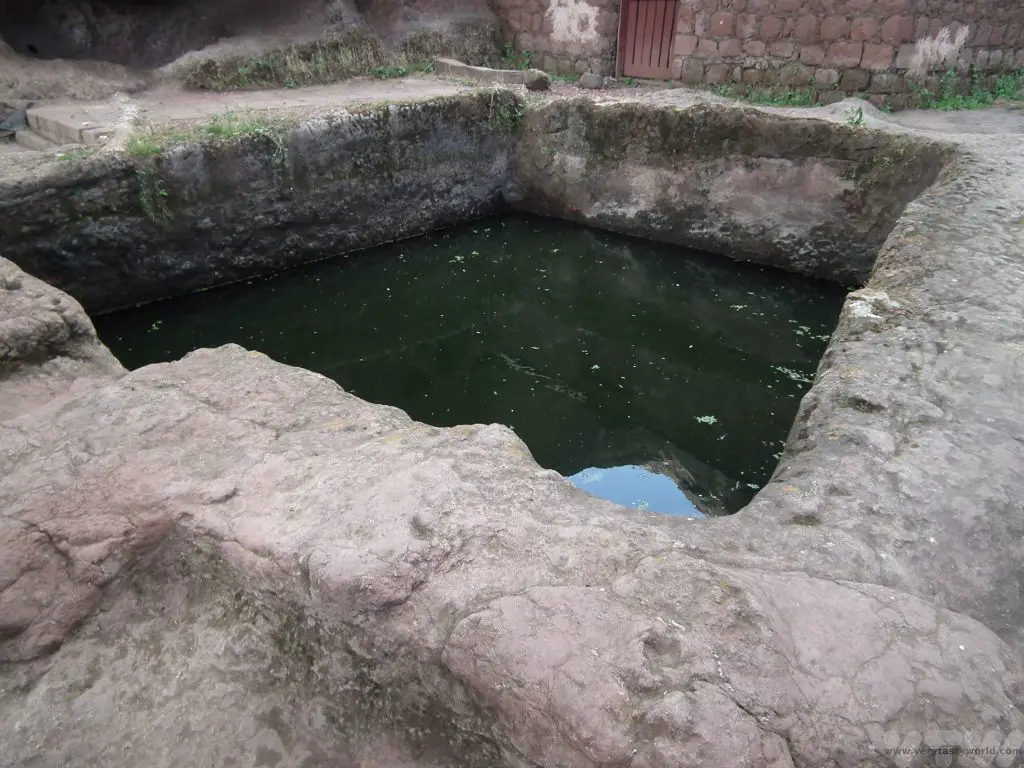
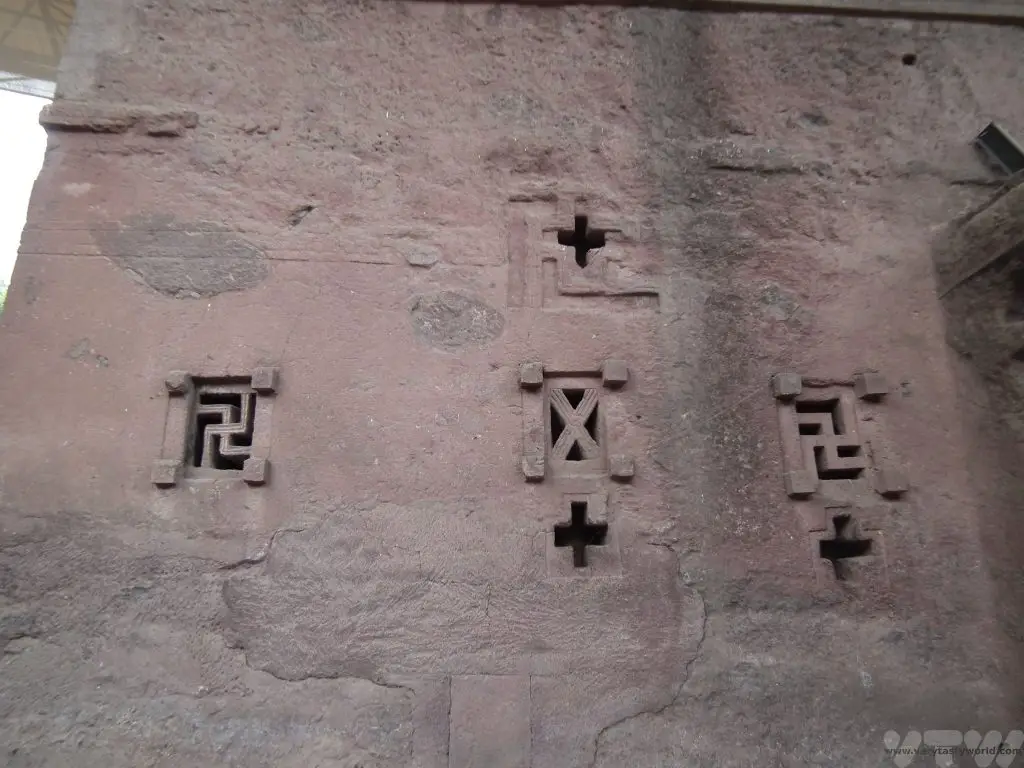
Biete Golgotha Mikael is said to contain the tomb of King Lalibela himself.
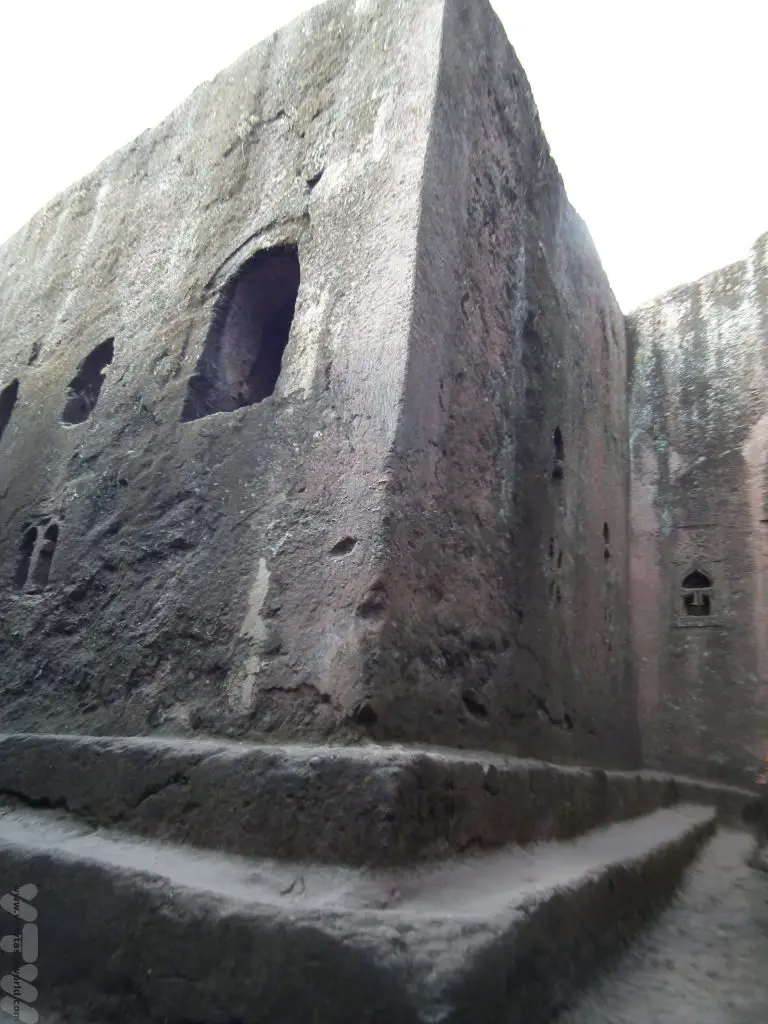
The Eastern Group Of The Lalibela Ethiopia Churches
It is thought that some The Eastern Group may have been used as royal chapels or palaces.
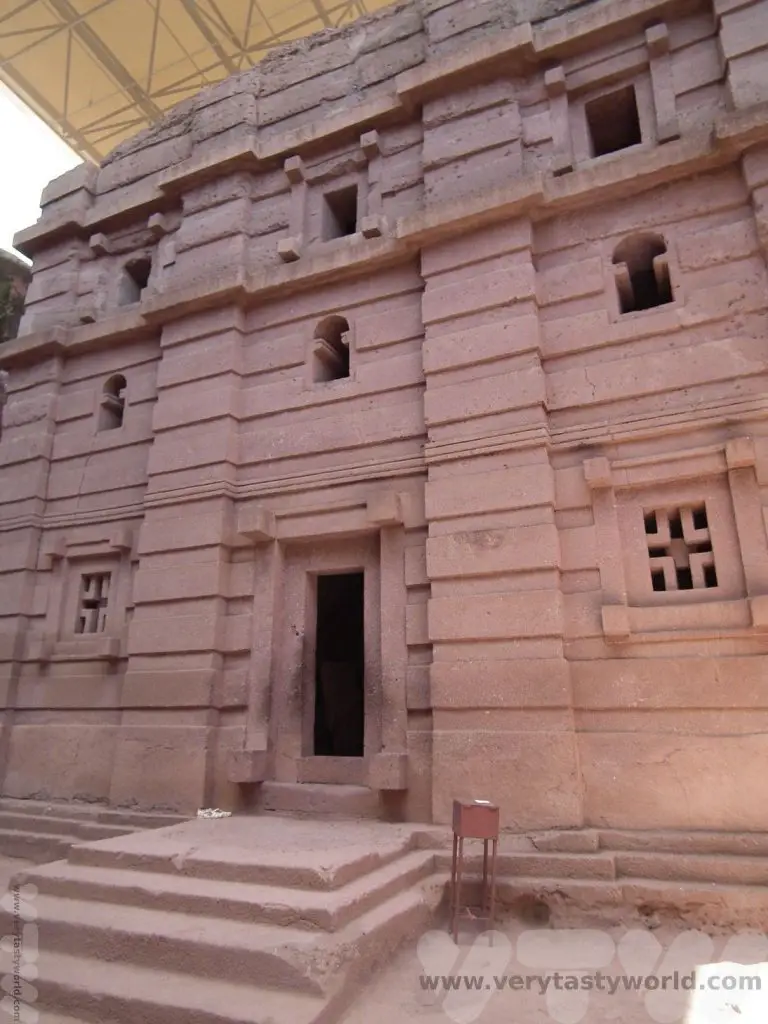
Biete Amanuel (House of Immanuel), possibly the former royal chapel.
At Biete Abba Libanos you can see how the church was carved downwards from inside the rock.
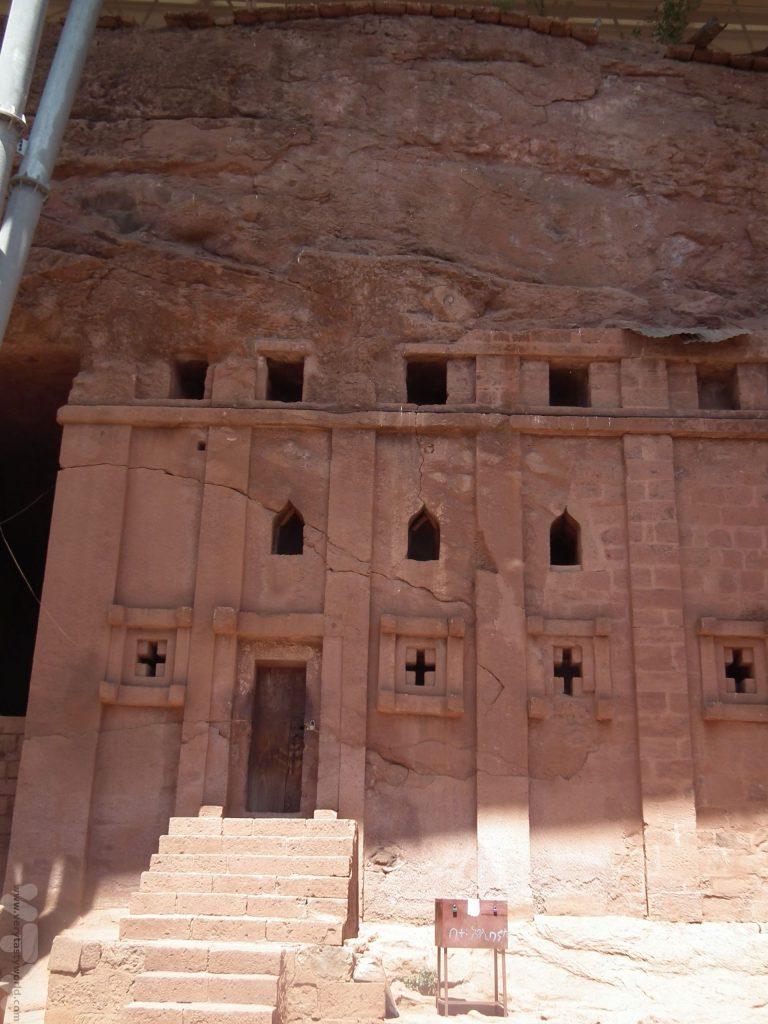
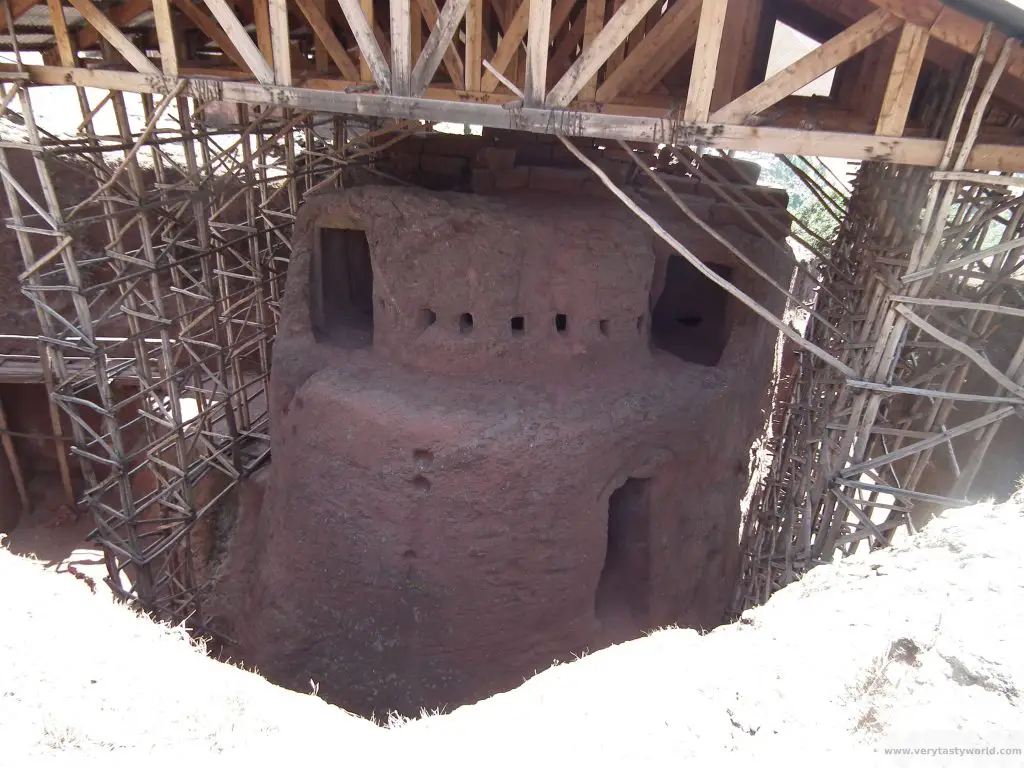
Biete Lehem is the house of bread.
The Western Group Of The Lalibela Ethiopia Churches
Last, but by no means least, Biete Ghiorgis, the church of St George, which takes a cruciform shape, and is the most beautiful of the churches.
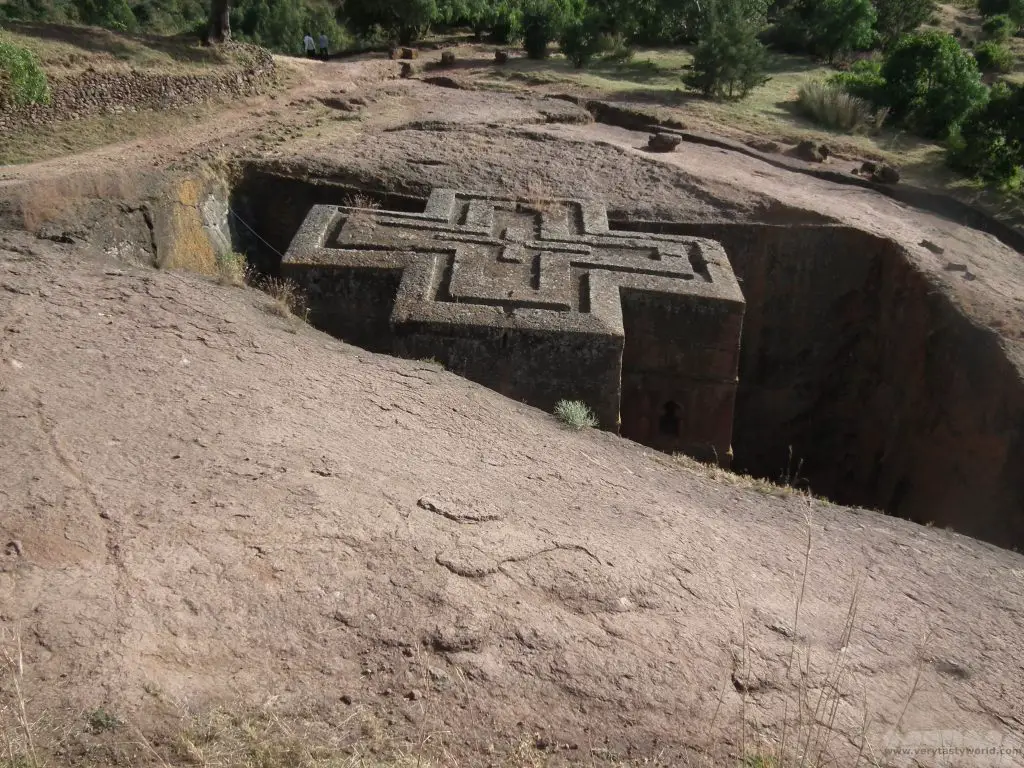
You cannot see it on your approach, so well is it hidden. (Actually you have to be careful not to fall into the courtyard.)
It also appears to be totally inaccessible but there is a passageway carved into the rock behind the church and you walk through a tunnel to arrive at the main entrance.
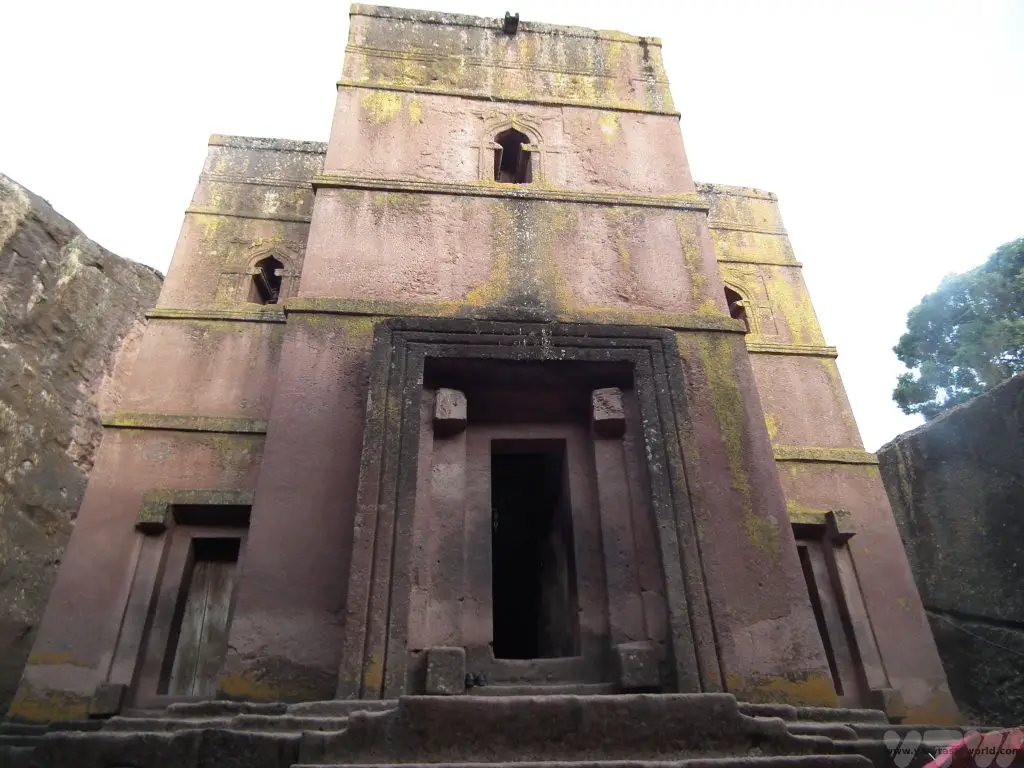
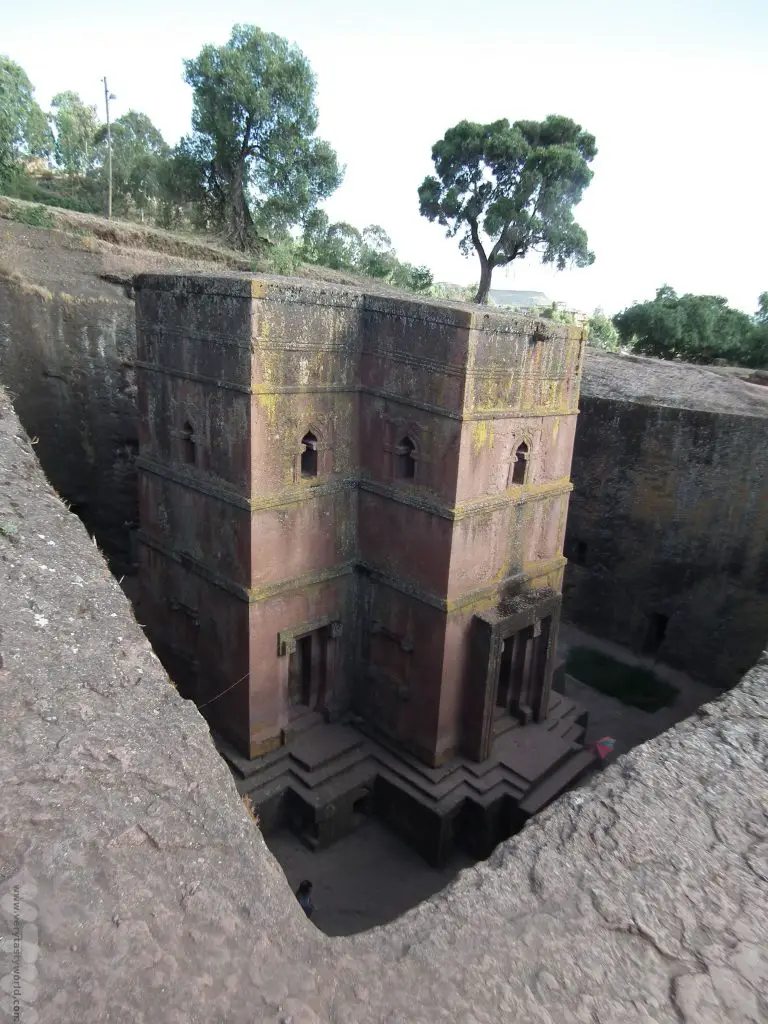
Day Trip from Lalibela
While you’re in the area, it’s also possible to visit Yemrehanna Kristos which is located around 20km from Lalibela. This would make for a pleasant morning or afternoon trip.
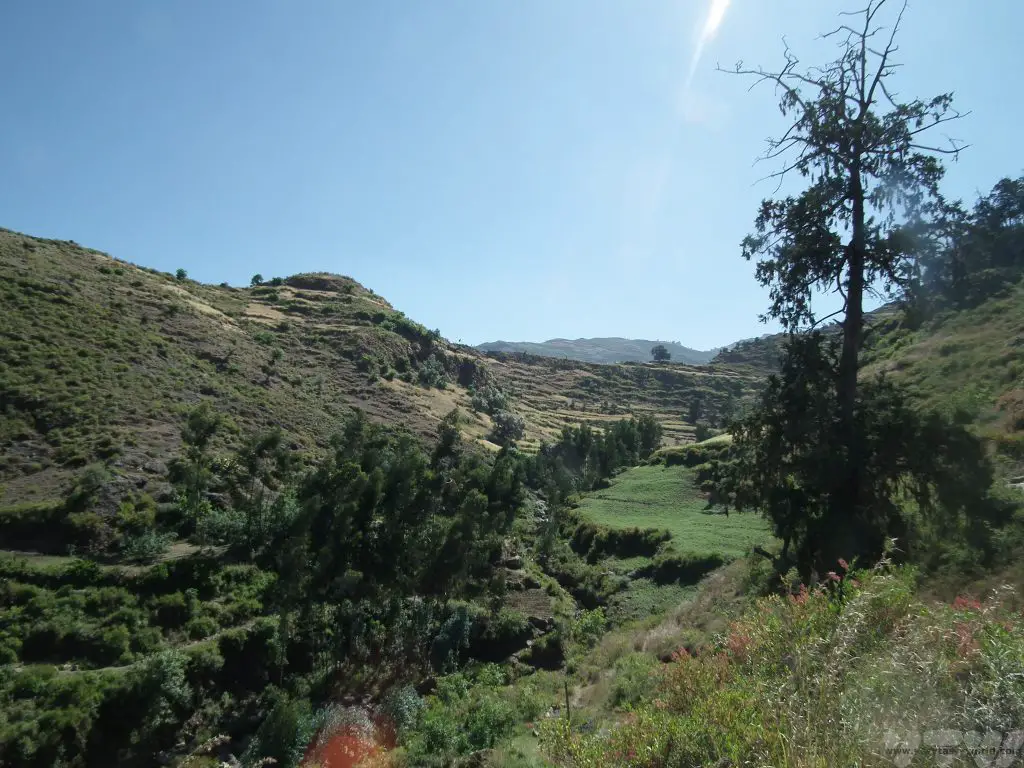
The church here is built inside a large cave on Mount Abuna Yosef. The church is named for Ethiopian king Yemrehana Krestos who reigned in the 11th Century.
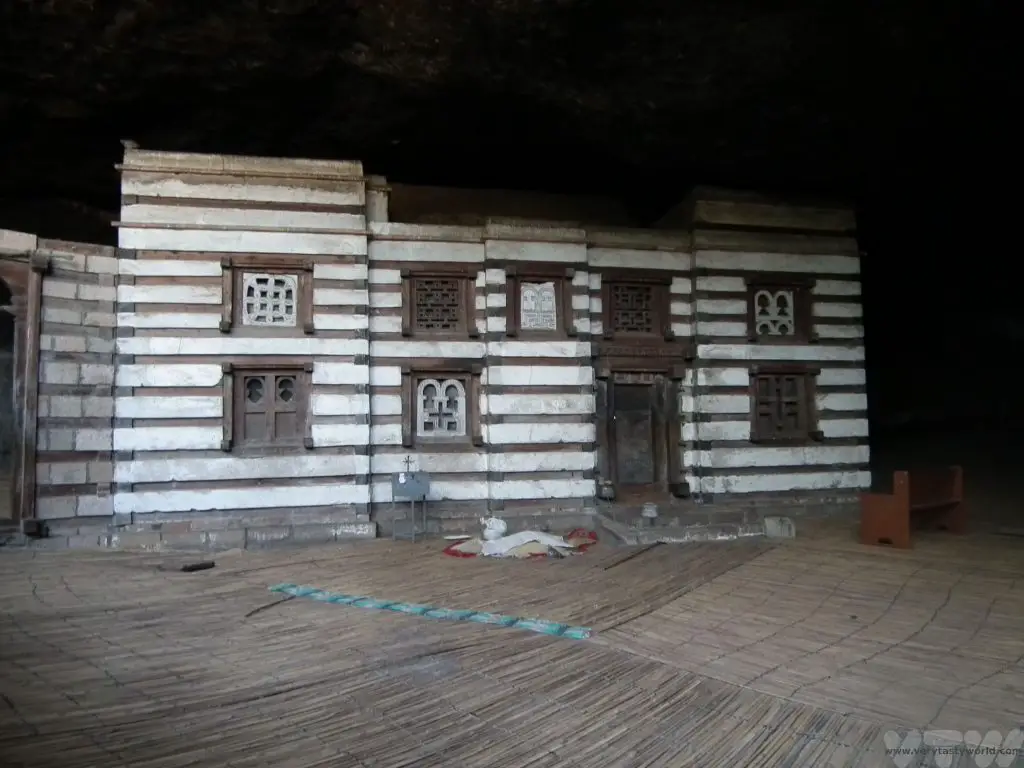
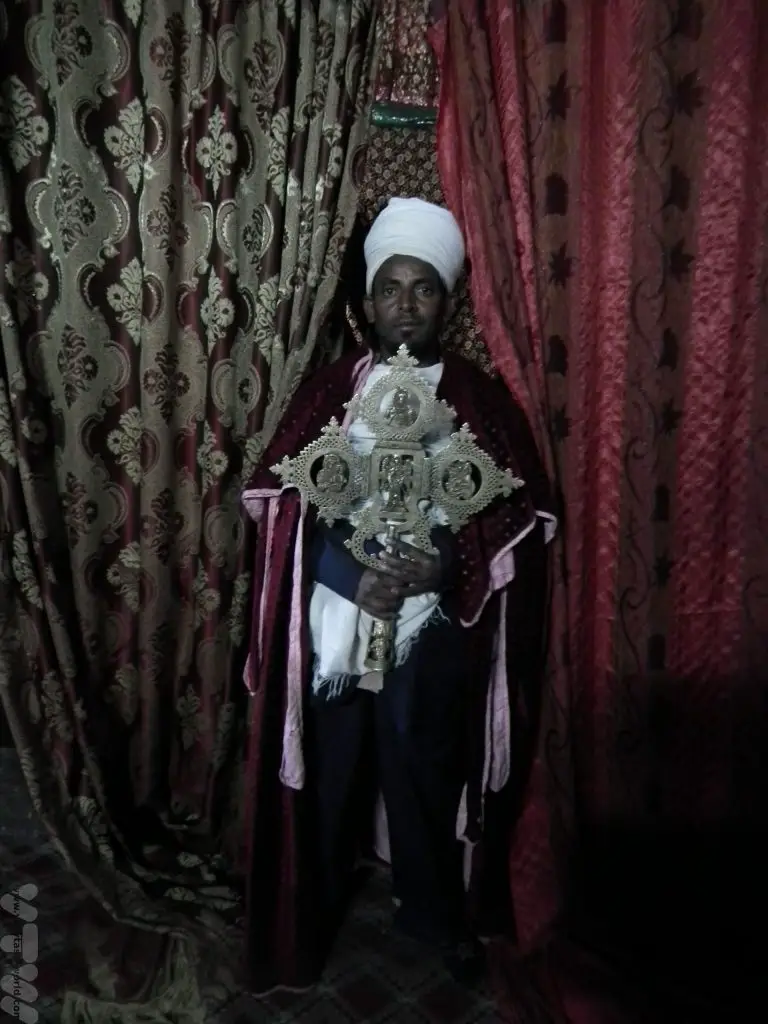
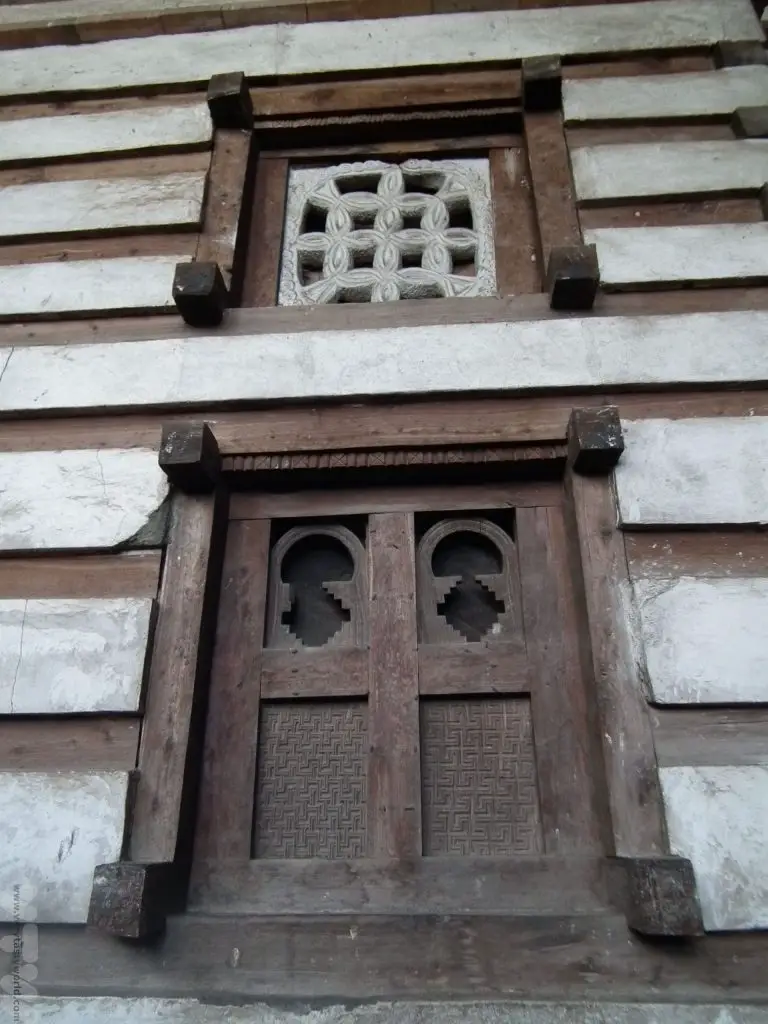
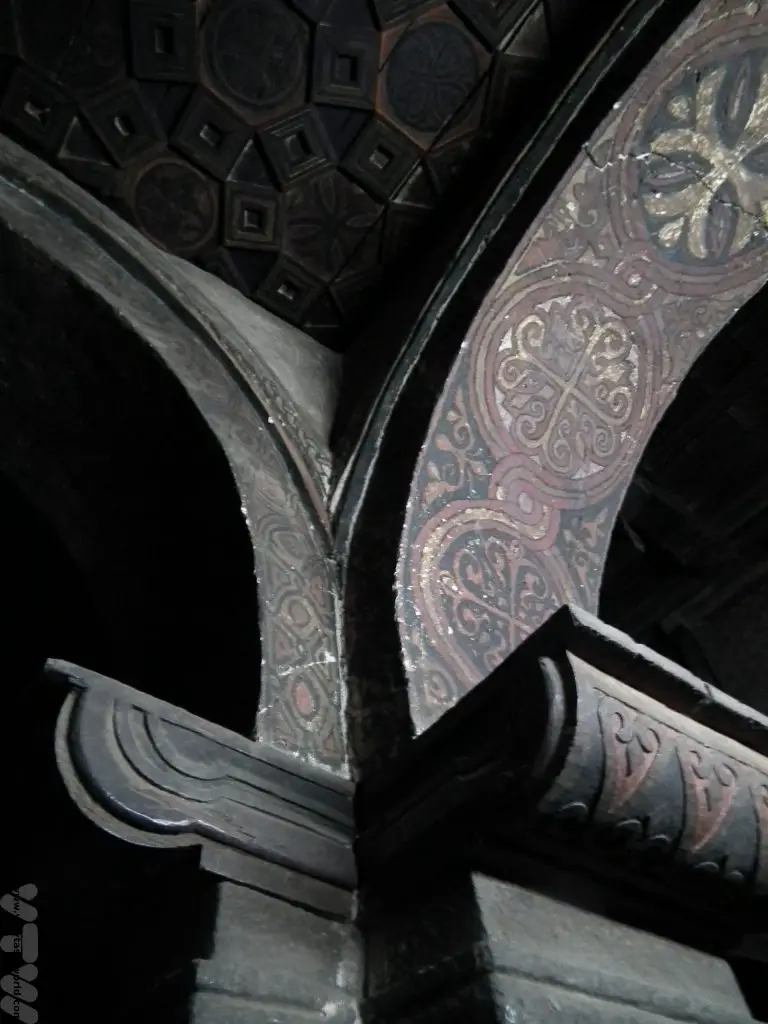
The area is known for its honey. There is a legend that Gebre Mesqel Lalibela was surrounded by a swarm of bees shortly after his birth. Apparently his mother believed it to be a sign of his future greatness. Whether the legend is true or not, make sure you get to taste the local honey, it is absolutely delicious.
And if you want a tip for a good restaurant at the end of the day’s sightseeing you can’t go wrong with Ben Abeba. The building has a highly unusual design and you can either sit indoors or outside – we recommend the latter as there are some splendid views, especially if you time your visit for sunset. The food on offer is slightly unusual – of course, you can have Ethiopian food, but somewhat surprisingly there are a number of Scottish dishes on the menu! The restaurant is run by a very friendly Scots lady who now lives in Lalibela.
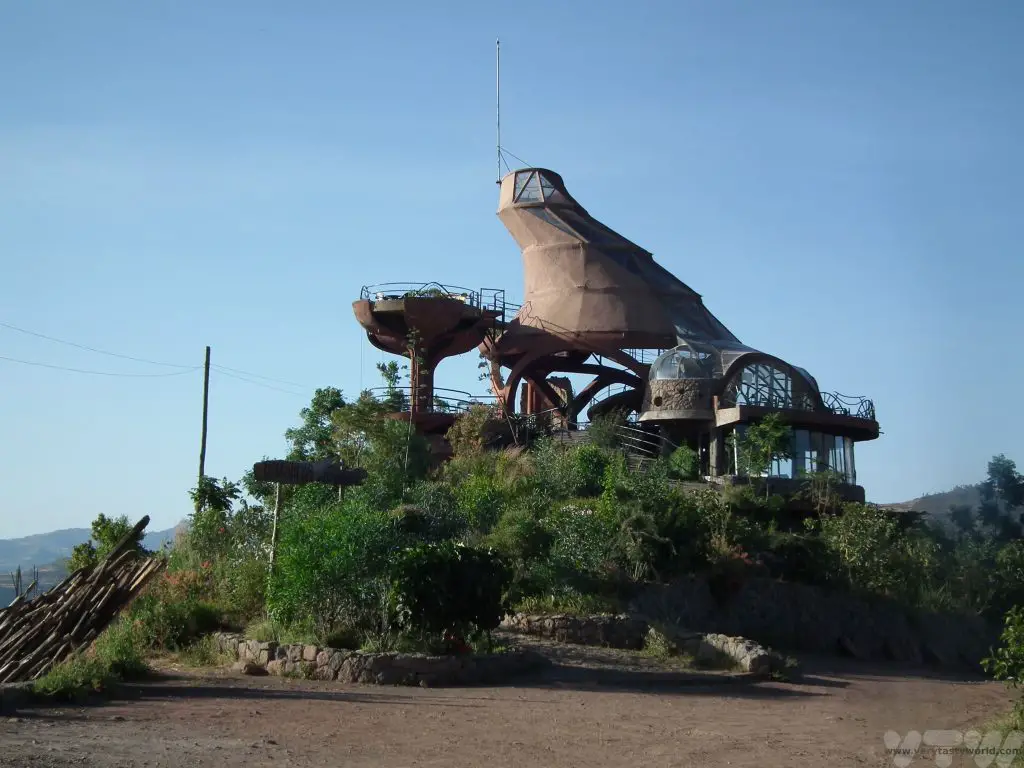
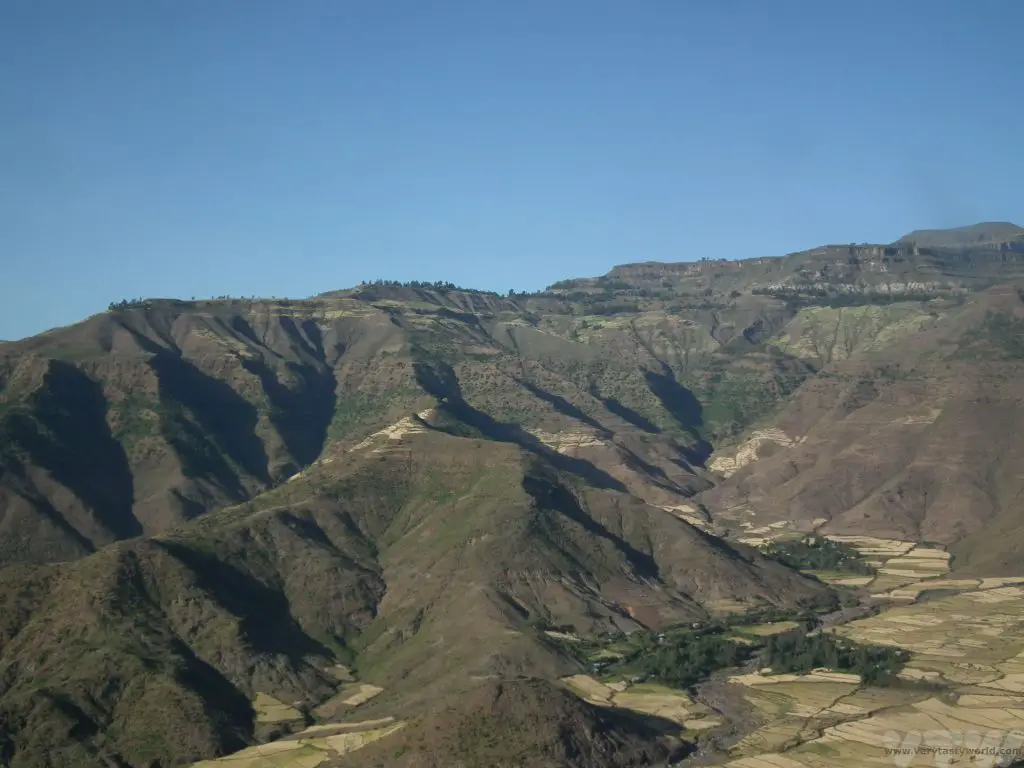
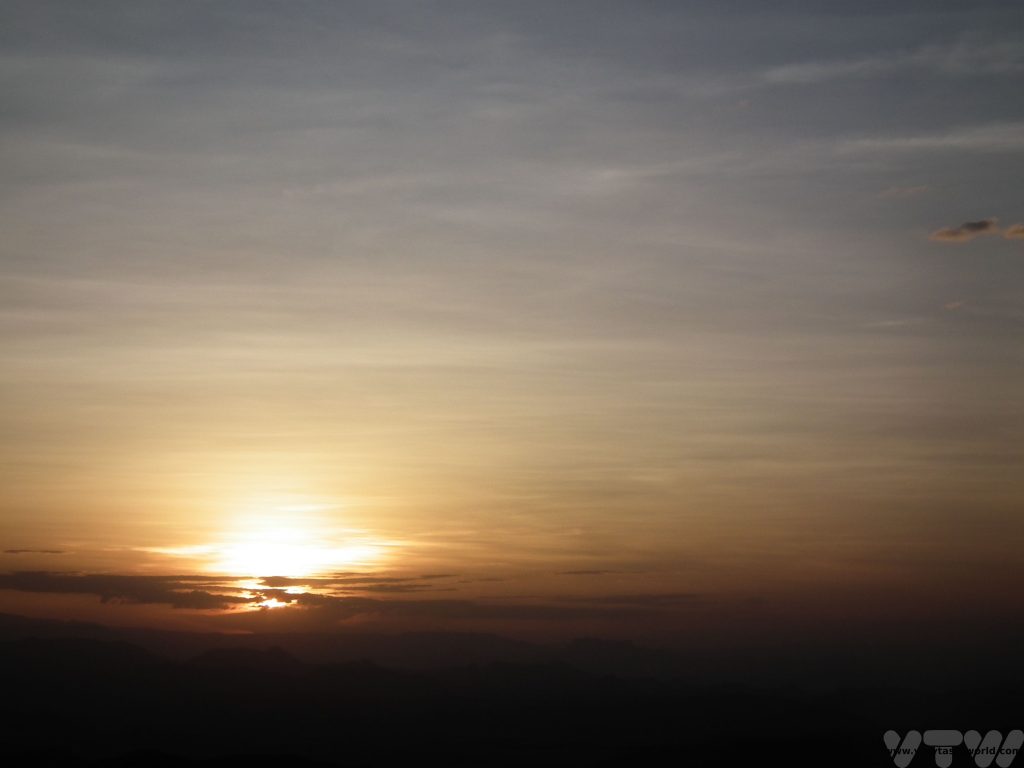
You can explore the Lalibela churches online via The Zamani Project who can offer several digital tours, including maps, photos, panoramas and 3D models of the site.

Luang Prabang Lao PDR (Please Don’t Rush)
There’s a general assumption that the cuisines of many countries in South East Asia – Thailand, Lao, Cambodia and Vietnam – are pretty much the same but that would be doing them a great disservice. While they may share many ingredients and seasonings, each cuisine is different and it is a joy to be able to discover the nuances of the foods from each country. Lao, for example, being landlocked, relies on the river for its piscine bounties rather than the sea. Hence most of the fish served will be river fish. River weed, dried in in the sun and flavoured with seasonings, makes for a tasty snack. Luang Prabang, Lao’s former capital, located in the north of the country, lies on the Mekong river at its confluence with the Nam Khan.
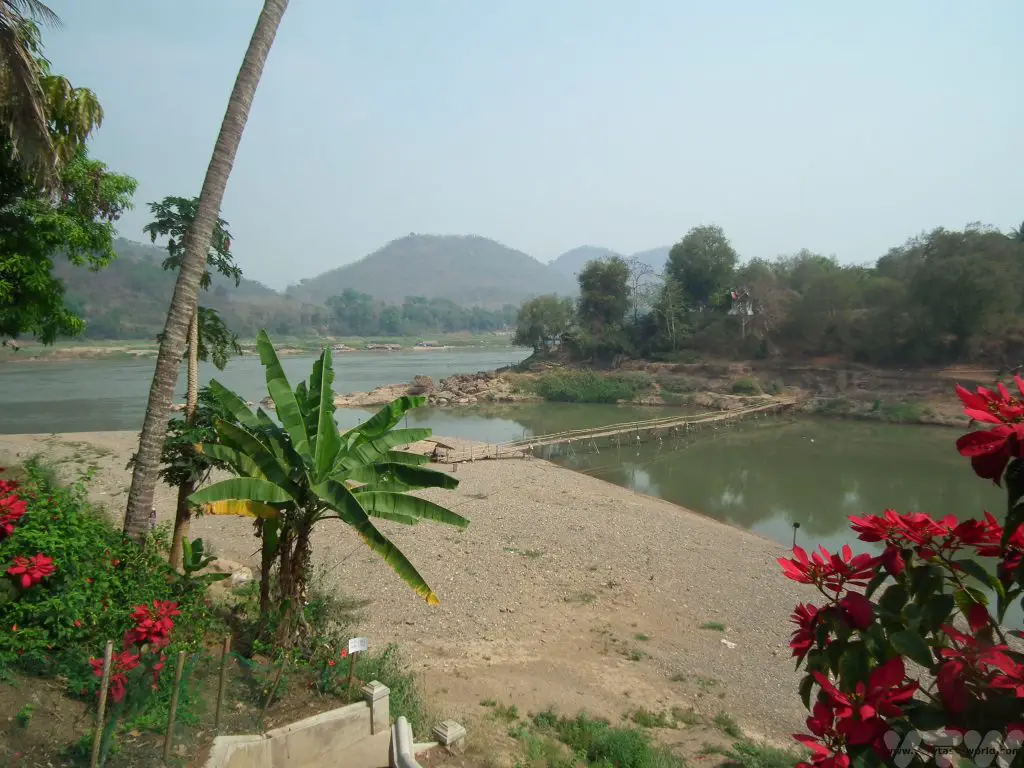
It’s a lovely, laid back town with plenty of temples and palaces to explore, which are largely within easy walking distance.
Wat Xieng Thong is the best known of the temples, located a short walk from the confluence. The main Wat has an intricate design and a beautiful tree of life mural.
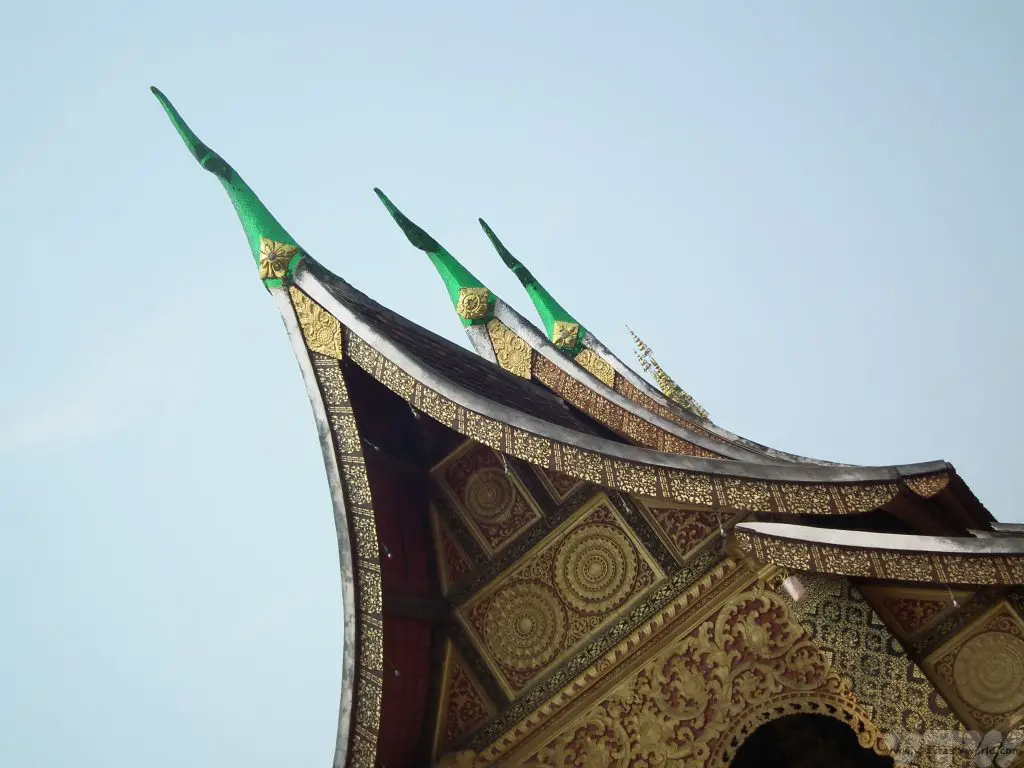
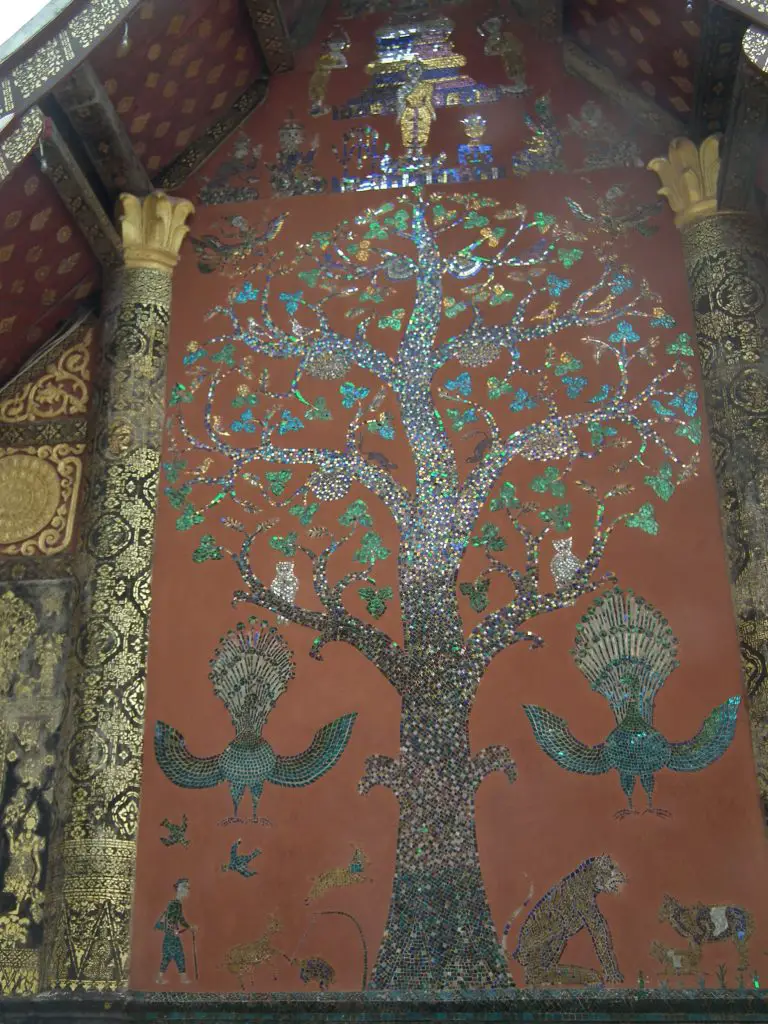
The Royal Palace was built in 1904 when Lao was under French occupation. The monarchy was overthrown by the communists in 1975 and the building converted into a museum.
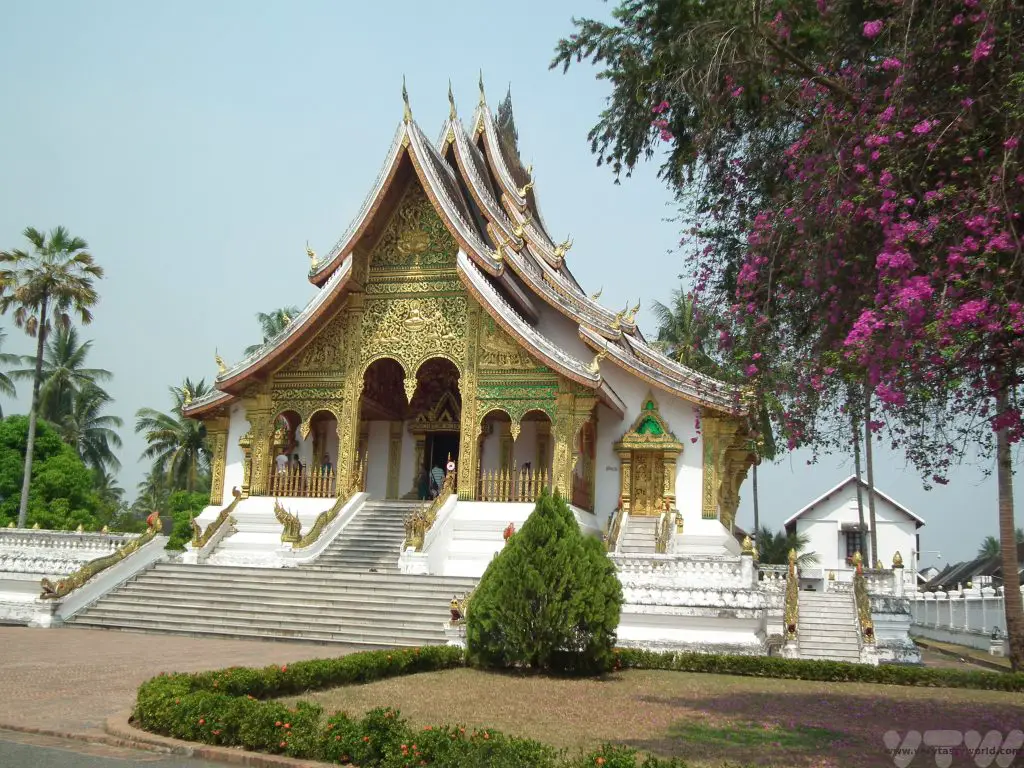
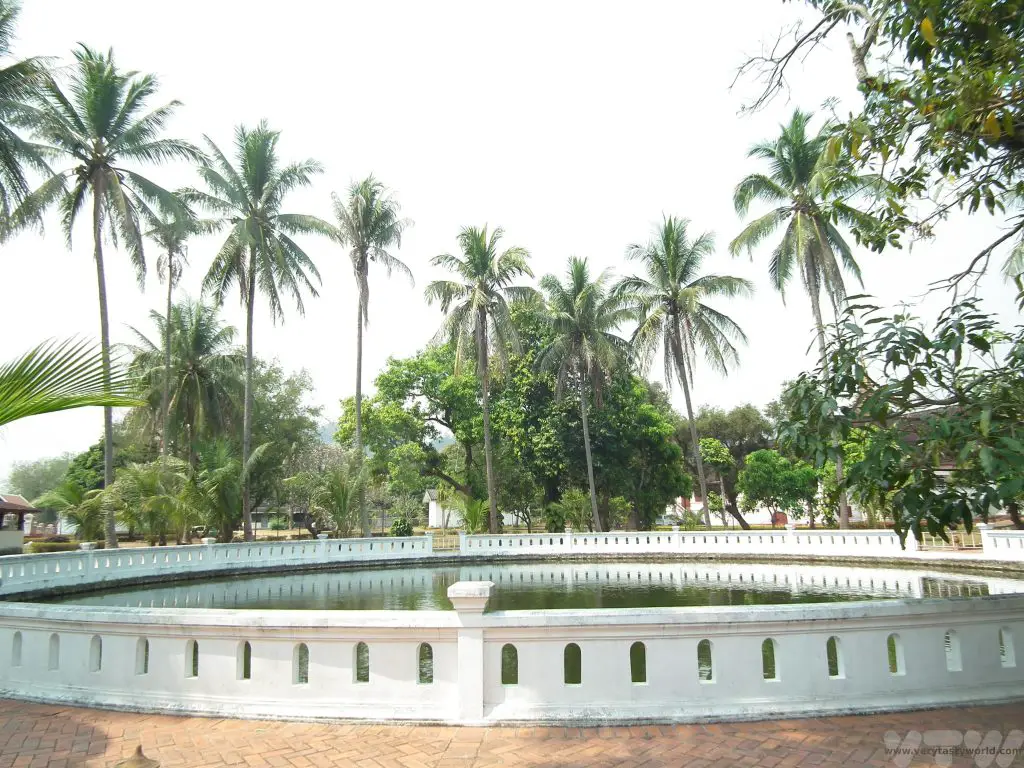
Crossing the Mekong and following a short hike up a hill you can reach the small temple of Wat Chomphet with its old stupa and Wat Long Khone. It’s more peaceful and less touristy on this side of the river.
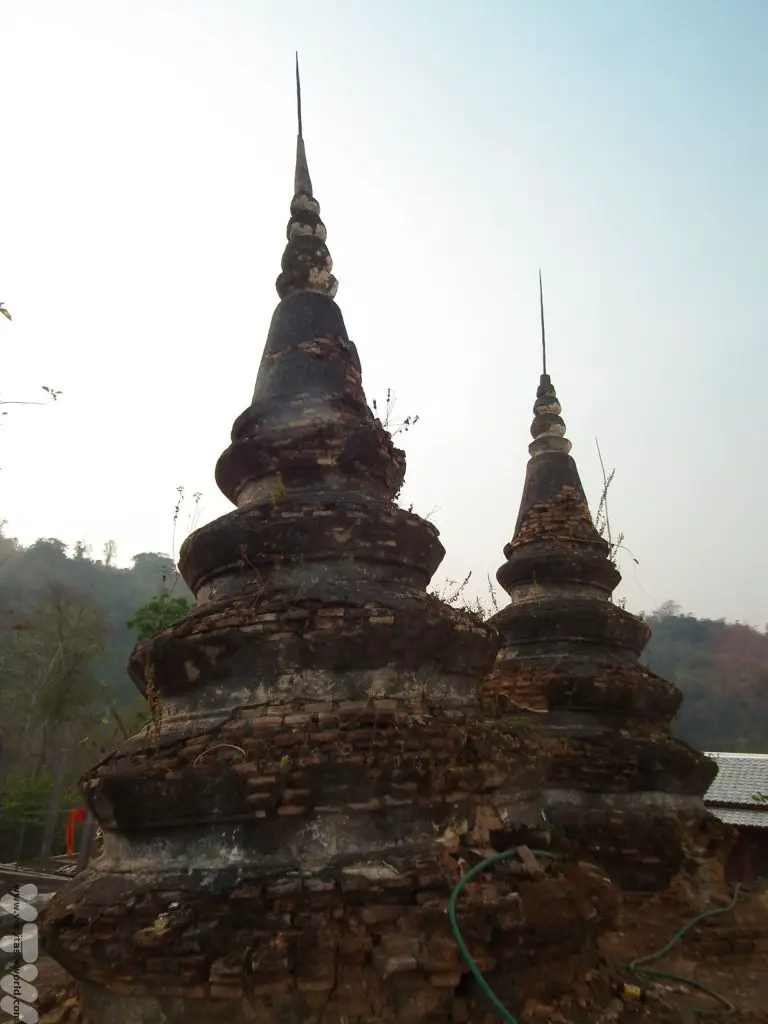
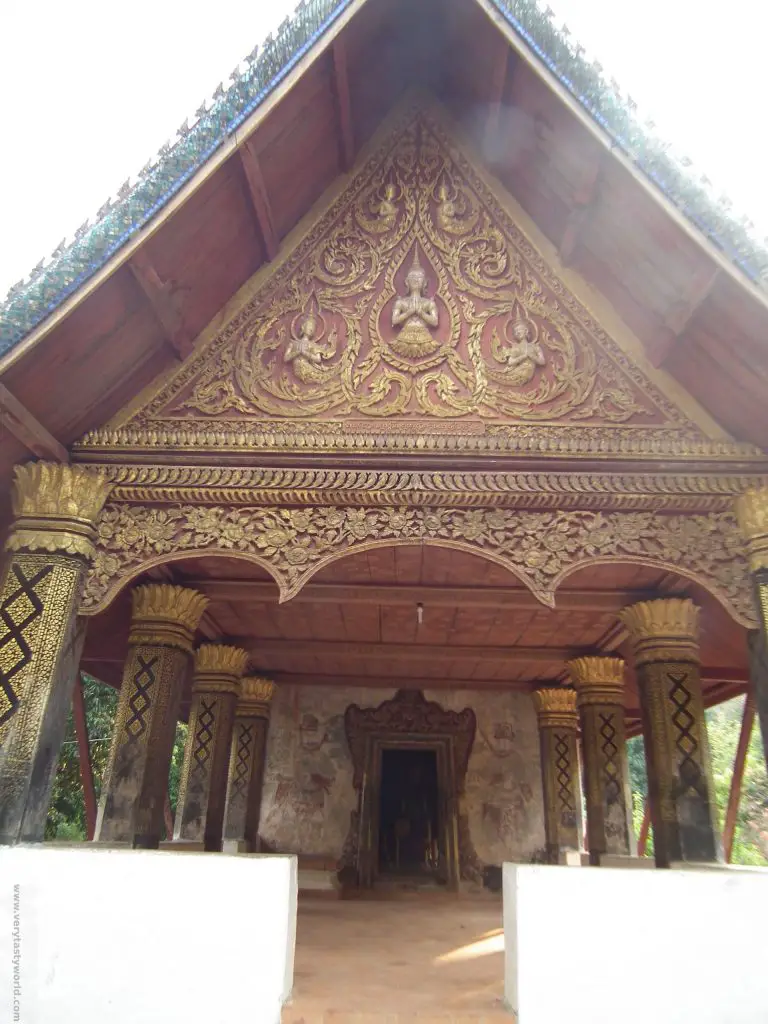
It’s also possible to hire a longboat and drift downriver at sunset, cool glass of beer in hand, enjoying the colours of the evening.
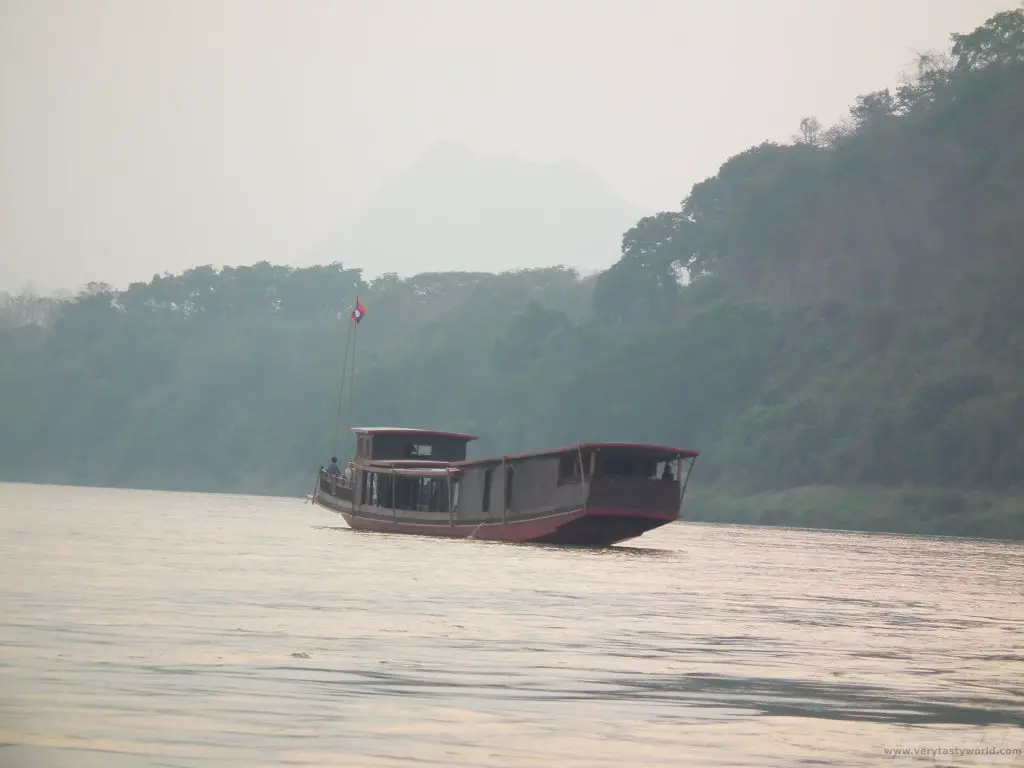
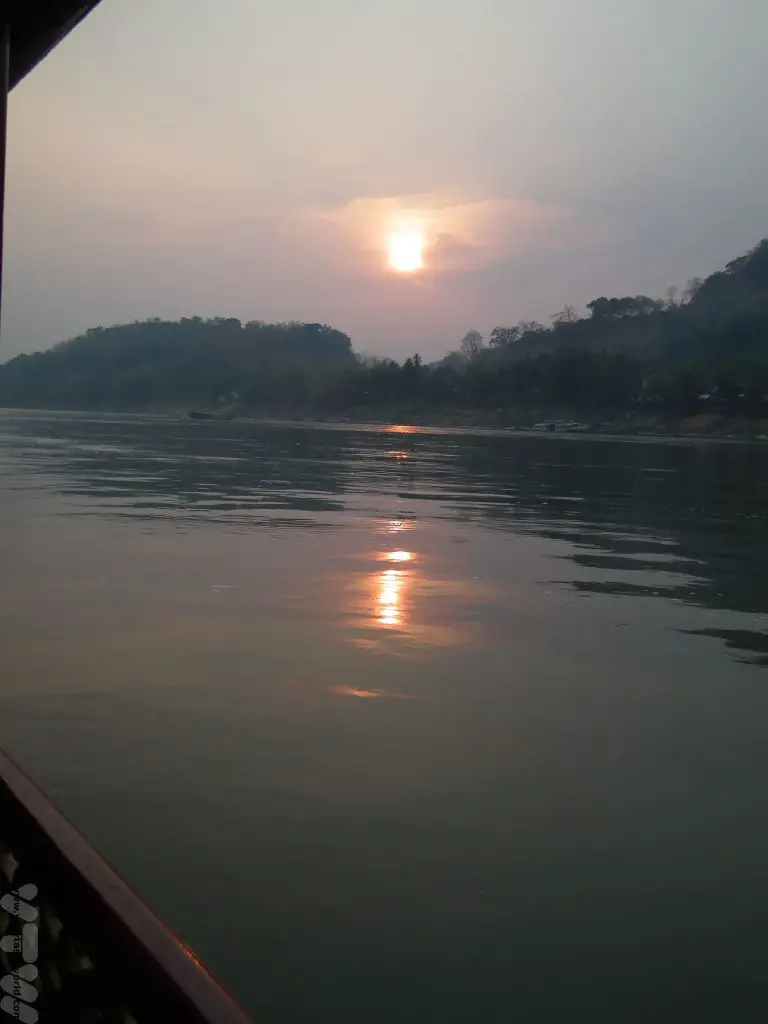
Lao’s formal name is Lao PDR – People’s Democratic Republic. Informally, locals will let you know that PDR stands for Please Don’t Rush – a wise philosophy which also means that you shouldn’t worry if service at restaurants is slow. (Actually, we didn’t notice particularly slow service anywhere we went.) But it’s a good reminder to relax and enjoy your time in this friendly country.
Luang Prabang Lao has a number of bars and restaurants which range from cheap eats to higher end offerings. Utopia is a short walk away from the town, set atop a cliff which overlooks the river. It’s a very laid-back place with a cool vibe and is located in a quirky garden setting.
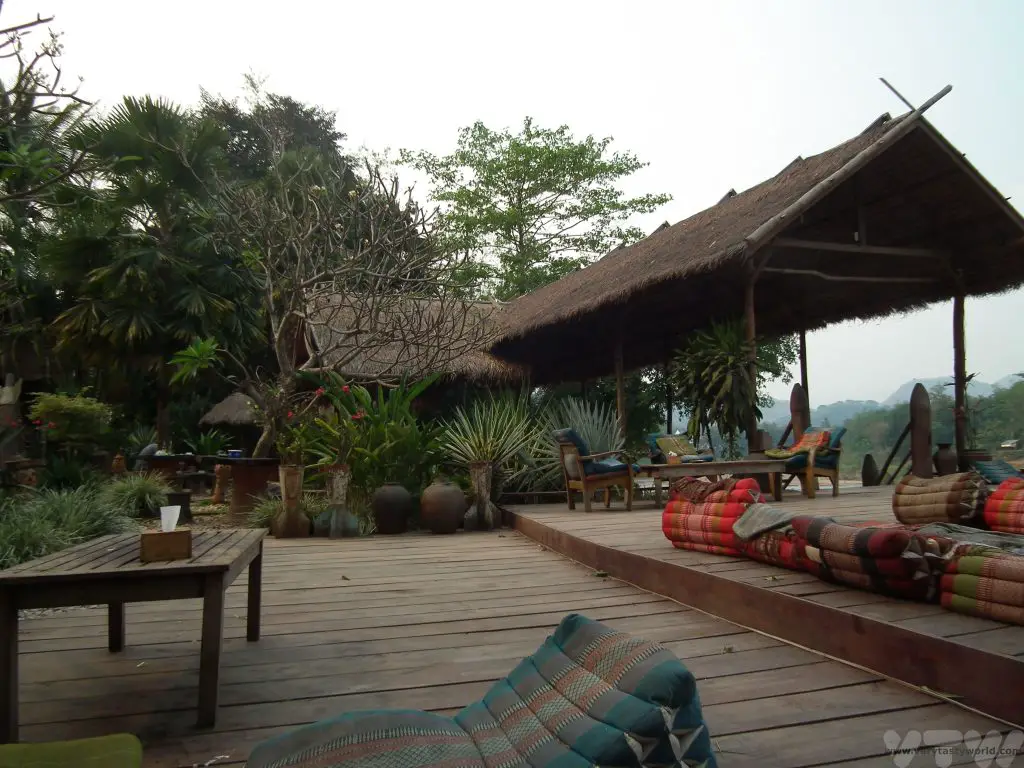
There is a sorrowful side to the garden design though. Many of the flower pots are actually bomb shells from the time of the Vietnam War when, over the course of nine years, the US dropped roughly two million tonnes of bombs on Lao in a secret attempt to support the royal Lao government against the communists led by Pathet Lao, as well as impact the Ho Chi Minh trail. The country remains the most bombed per head of the population in history. Worse still, a significant amount of the ordnance – about a third of the devices dropped – failed to detonate and, more than forty years later, there is still a huge problem with unexploded bombs that remain embedded in the ground, despite some international efforts to clear them.
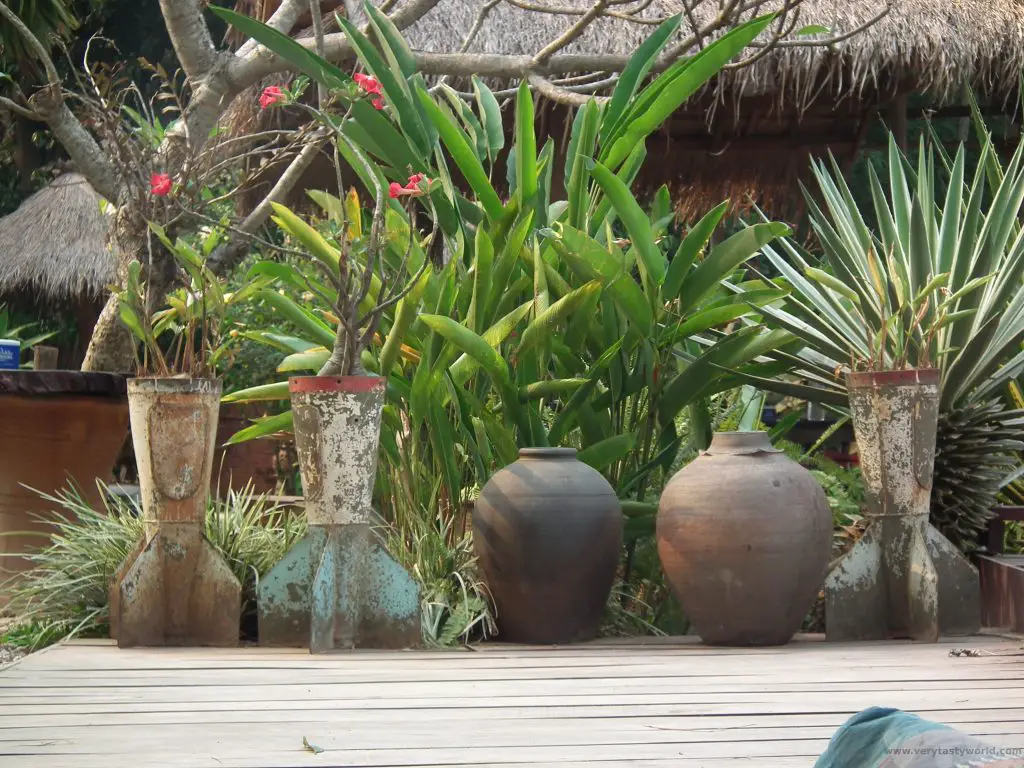
Utopia is popular amongst backpackers for its chilled atmosphere during the day (it has activities such as yoga lessons available) and livens up a lot at night, and it offers local and western food.
One of the best restaurants in Luang Prabang Lao for local food is Tamarind, on the Kingkitsarath Rd, and they specialise in local cuisine. They offer tasting menus which give visitors the chance to try various specialities. It’s a fantastic introduction to local fare. It’s a popular restaurant so it’s worth booking ahead if you can, although we got lucky with a walk-in for lunch.
We started with Lao-Lao shots as an aperitif. Lao-Lao is rice whiskey. Its name isn’t a cute term of endearment – the two words have different tones in pronunciation and hence different meanings. The first Lao means “alcohol” and the second means “from Lao”. The whiskey has a mild flavour but is pretty potent at round 40-45% alcohol.
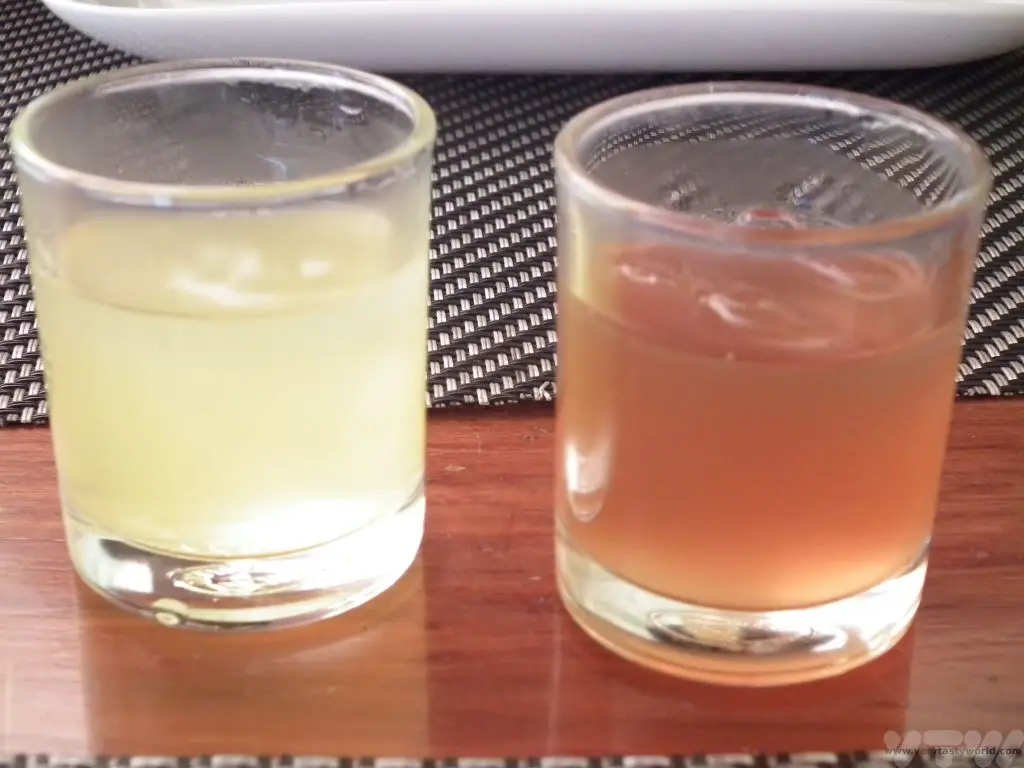
The starter was chunky bamboo and vegetable soup. A lot of Lao food can be searingly hot, with chilli often providing the heat, but this wasn’t; whilst still spicy, it had a piquancy in the seasoning that allowed the flavour of the vegetables and herbs to shine through.
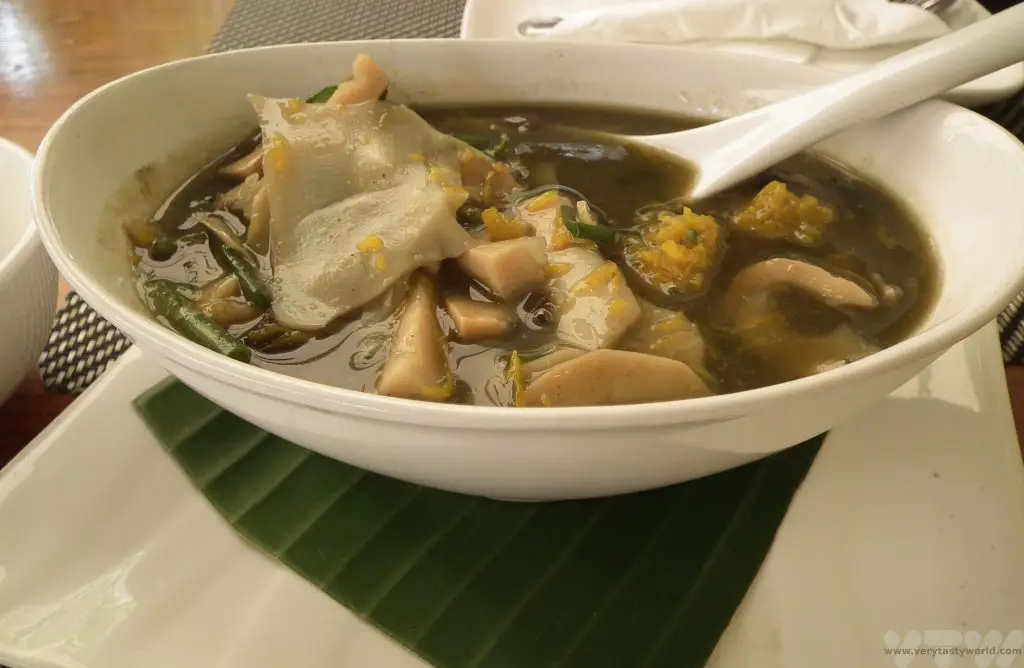
Then came a platter of Lao specialities. These included dinky little sausages with a variety of relishes, which varied in the amount of spice they delivered, as well as kaipen – crispy sun-dried river weed coated with sesame seeds.
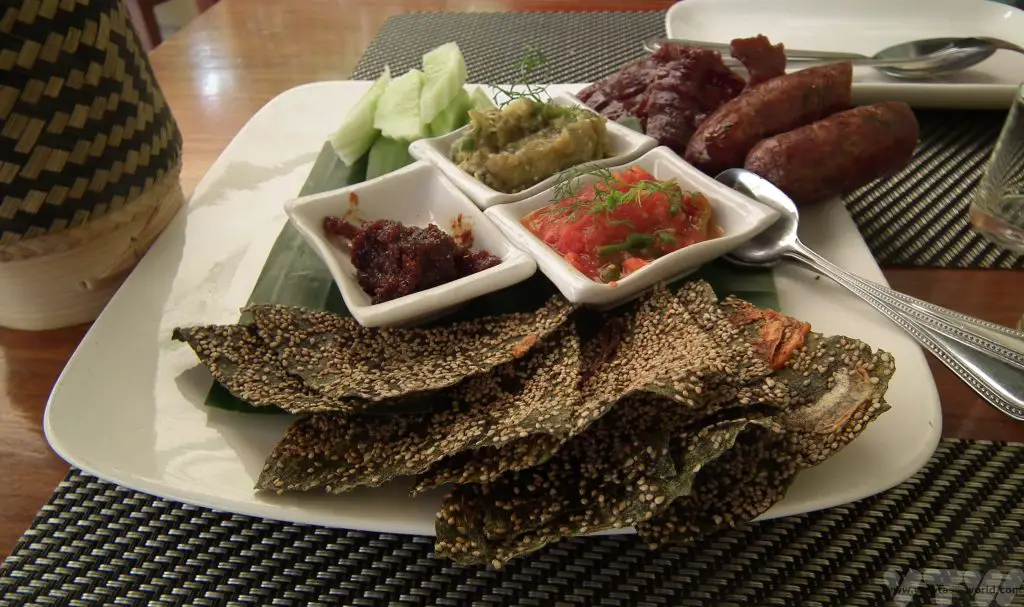
The next dish was fragrant lemongrass stuffed with chicken which felt like a bit of a contradiction. Usually you would expect lemongrass to flavour the meat but this was soft minced chicken, delicately spiced, placed into the bulbous part of the lemongrass stalk, then steamed and fried. The gentle scent of the lemongrass imparted a delicate citrus flavour. It was accompanied by herbed river fish steamed in a banana leaf along with local vegetables.
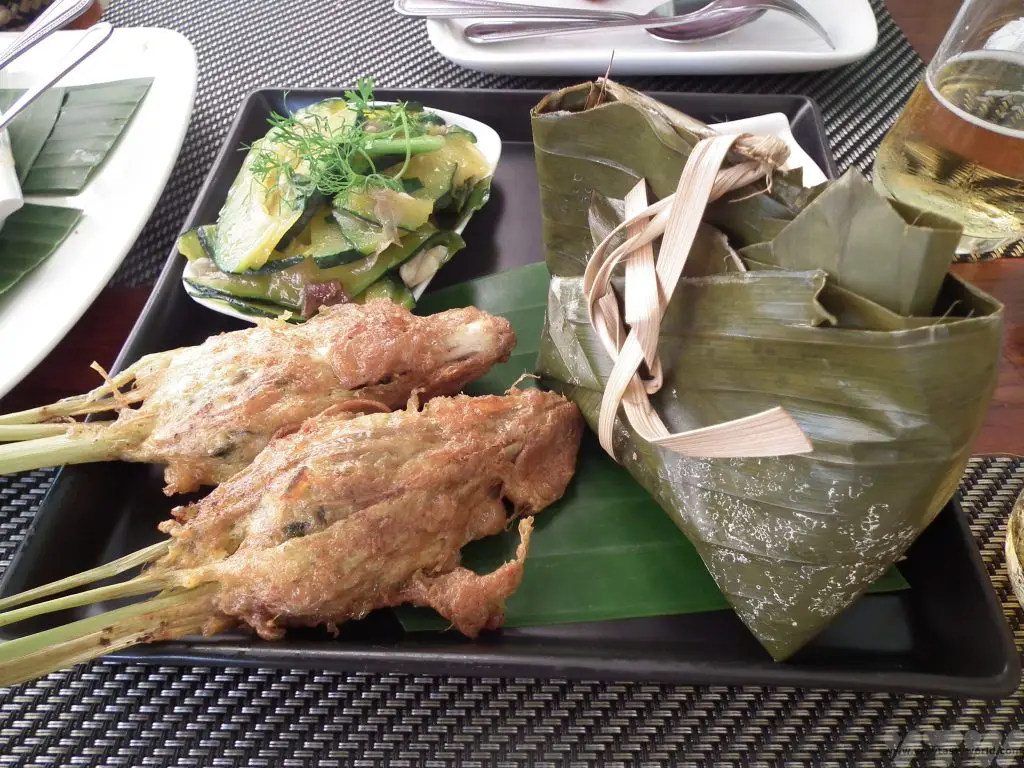
Finally, purple sticky rice cooked in coconut milk with tamarind sauce – which was sweet and slightly sour as well as delightfully sticky – rounded off a splendid meal.
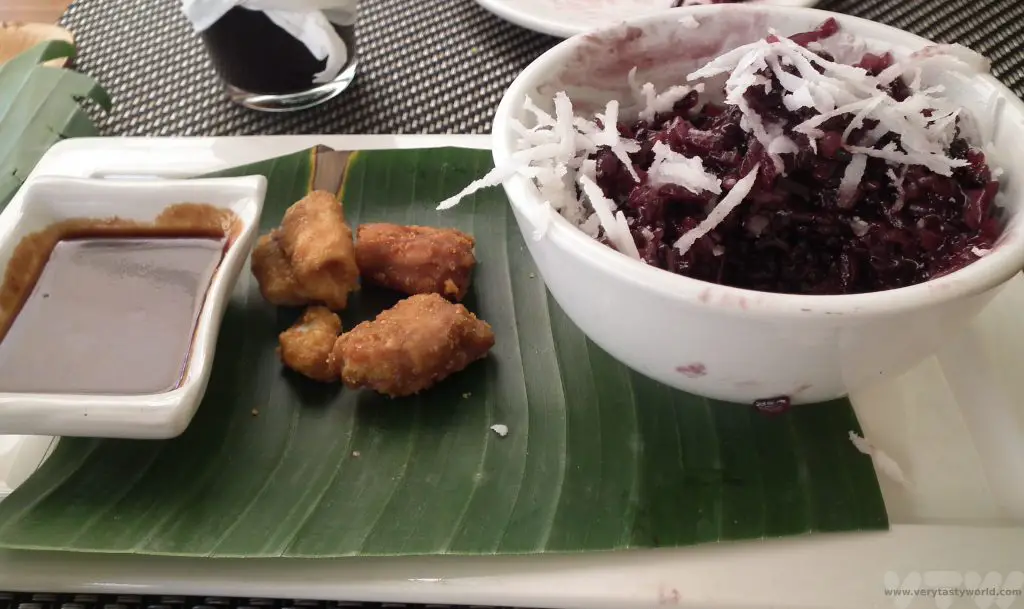

VTW Go Finland and Meet Leningrad Cowboys
They’ve been to America (Leningrad Cowboys Go America (1989)) and they’ve met Moses (Leningrad Cowboys Meet Moses (1994)) so VTW Go Finland is perhaps an appropriate foodie film excursion. Those curious about the Leningrad Cowboys band and their work with legendary low-key Finnish filmmaker Aki Kaurismäki should check out the review here before purchasing their cinematic output, including videos, for your education and pleasure.
While the band, instantly identifiable by their outrageously long and pointy quiff hairstyles and black winkle-picker shoes, have played gigs all over the world, one of their enterprises in Helsinki involves food and it is totally in tune (or out of tune depending on the gig in play!) with their unique musical style. Among their musical and lyrical thematic tendencies there are influences of vodka and tractors, both of which are also intrinsic their food.
Many years ago there used to be a Leningrad Cowboys Restaurant which had bonkers décor and a confusion of fusion menu that clashed cuisines from all over the world – where American assimilated with Asian, Mexican merged with Moroccan and Indian integrated with Italian – a broad range of flavours that shouldn’t have worked in so many ways but really, really did. It was there that we also discovered the joys of vanilla vodka straight out of the freezer. Quaffing Finnish spirits while sitting next to quiffing statues, who needs a pudding when you can combine your dessert and digestif in a scrumptious shot? We just had to make sure we could find our way back to the hotel at the end of the evening…
Sadly, it no longer seems to be there – we looked out for it on a recent trip to Helsinki – which is a shame.
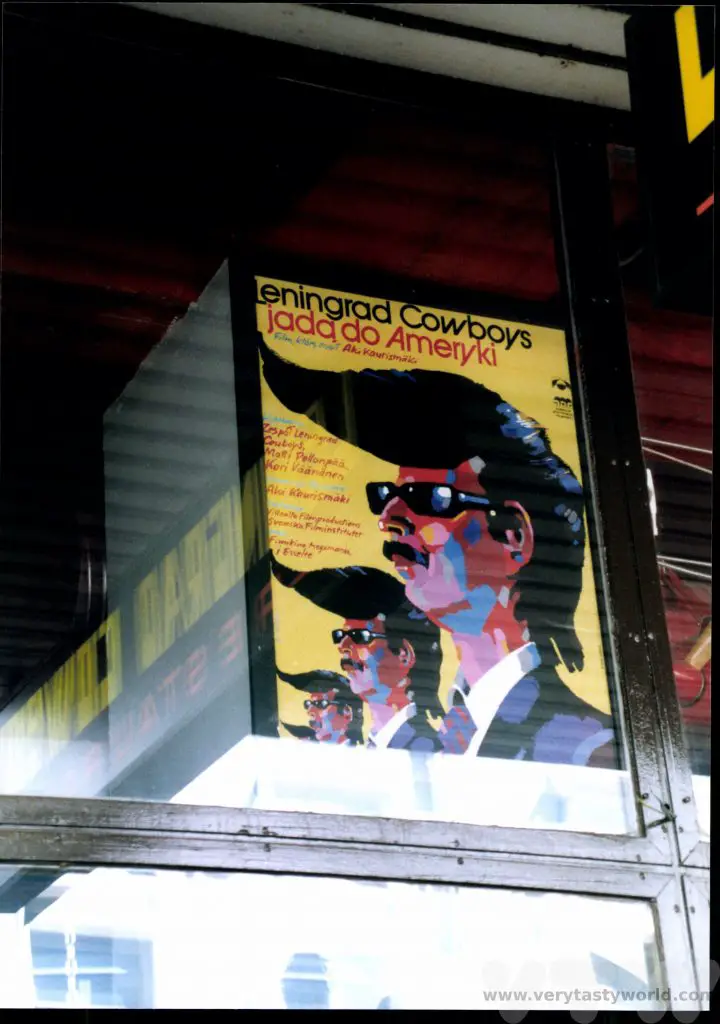
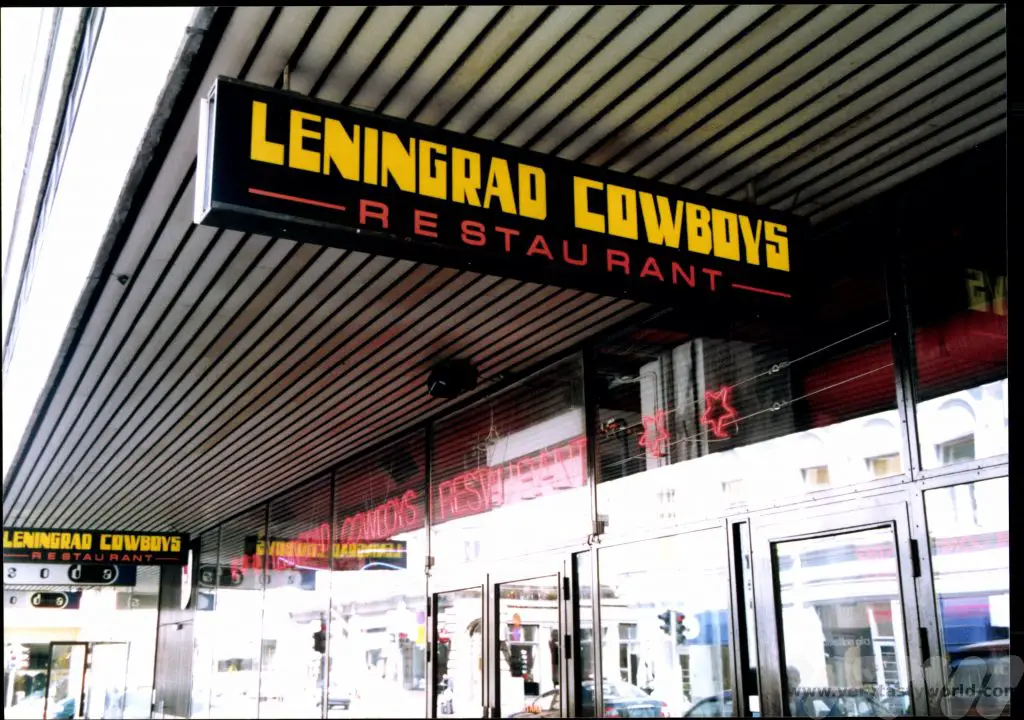
However, the Zetor Restaurant in Helsinki has been around for many years and continues to thrive. It takes its name from the leading Czech tractor brand – “The first zetor tractor, the Z25, was ‘baptised’ on 15 March 1946,” according to the official website – and takes the tractor-restaurant concept to a wonderful and surreal zenith. Yes, you eat your meal…. on a tractor or sitting around a tractor.
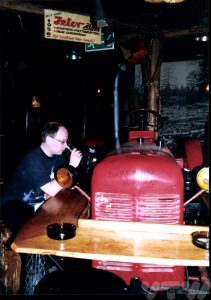
Zetor Restaurant is owned by Aki Kaurismäki and designed by one of the Leningrad Cowboys. Rural kitsch bliss. Zetor declares itself to be a “110% Finnish restaurant,” and who are we to argue? Also, as is befitting a classy restaurant, the fare on offer comprises signature dishes from their very own recipes and these are described in a highly distinctive manner: perhaps Oula’s sautéed reindeer, The Cackle of Kaivopiha, The weather may change but the vendace stays the same or Karelian glory, which they claim is ‘close to deserving a place on UNESCO’s heritage list.’
It’s worth noting that Crazy reindeer from Levi, Lapland, Mummy’s boy’s meatballs and Grilled liver all contain alcohol. The essential on offer is the drool-worthy Tractor Man’s steak: ‘Tender sirloin of beef, bacon baked on the bonnet of a Zetor tractor with honest garlic butter as fuel. As well as country potatoes with smoked garlic mayonnaise, mousse of smoked reindeer and vegetables as eye candy. That smoked reindeer is welcome as more than eye candy.’
Don’t forget the drinks, which include a wide variety of strong Finnish berry wines: Lingonberry 21 %, Cranberry 21 %, Blueberry 21 %, Blackcurrant 21 %, Sea Buckthorn 21 %, Cloudberry 15 %.
Something to take a shot at. Or two.
